a
Scholars and Soldiers:
history of alumni of St Paul’s School and the 1st World War
Volume 2: the Ypres Salient and OPs
Graham E Seel



Graham E Seel has taught History since 1987. He was Head of History and Head of Faculty Humanities at St Paul’s School, 2012 2021. The author may be contacted on spsworldwarone@btinternet.com
Cover image: The Menin Road by Paul Nash (SPS 1903 1906). IWM ART 2242
List of Illustrations
Introduction
Chapter 16. ‘wherever we go, it cannot be to a worse place than the Ypres Salient’
16.1 Ypres and the Salient i) Ypres: the death of a city ii) Ypres: the Salient 16.2 the ‘93’: an overview i) in which they served: armies and regiments / corps ii) in which they served: infantry battalions iii) age at death iv) the deadliest day in the Salient v) where they fell vi) graves / memorials vii) the ‘93’ Roll of Honour
Chapter 17. the ‘93’ and their stories
When Graham Seel speaks directly about his research into the 511 fallen Paulines and others of the 2,500 OPs who volunteered for service in the 1st World War, his passion for understanding and recording accurately the history of both the school and its pupils is evident. His work narrates much fascinating hitherto unknown detail about the generations of OPs who fought and as such it will become a key reference work for those interested in St Paul’s School and the 1st World War. I am proud to be part of an institution that facilitated such work and acknowledge its importance. I also feel privileged to have overlapped with Graham during my time as High Master and to have had the chance to discuss its progress with him and to see this project reach its completion. That it did so during a global pandemic, when another group of young Paulines had their lives impacted by factors beyond their control, only served to emphasise further the need to record our unique experiences for those who will follow us.
Whilst Graham’s work seeks to emphasise the numbers of Paulines who survived the 1st World War and had purposeful lives beyond it, it remains the case that it’s difficult for those of us alive today to imagine what life at the front must have been like for them. However, united as we are by our school, we can feel connected to them and to the past in a special way. Therefore, I am hugely grateful to Graham and to all who supported him in this venture.
Sally-Anne Huang, High Master, St Paul’s School 2020 -
One of the highlights of my time as President of the Old Pauline Club has been the honour of laying a wreath at the St Paul’s School War Memorial on Remembrance Day last year. The sky was the clearest blue and there seemed to be no sound of road, air or river traffic just the silence of over a thousand current Paulines remembering and honouring the 511 Paulines from over a century ago who made the ultimate sacrifice. There was such a sense of unity across generations in the silence.
In these wonderful volumes, Graham Seel chronicles the stories of the 511 OPs who fell and others who survived. It is so important that these tales of gallantry and sacrifice are being told. There is nobody better to do that than Graham given the incredible extent of his research and the quality of his writing. The Old Pauline Club extends its congratulations and enormous thanks to him. Scholars and Soldiers is a hugely important addition to the Pauline Community’s knowledge of OP bravery in the First World War.
Graham describes Pauline sacrifice in what was “the war to end all wars” at a time when there is war in Europe again. His book is timely and poignant.
Ed, Lord Vaizey of Didcot, OPC President
One of the great privileges of being a Pauline is the sense of being part of a great continuum of learning and endeavour that has continued over many centuries. As governors and Old Paulines our task is to encourage and enable the new generations to share in the great history and the bright future of the school. So while supporting the future development of the school it is vital that we are alive to its past.
Graham Seel has undertaken a massive research project investigating and chronicling the contribution of so many Old Paulines to the First World War and illustrating for us the great diversity of talent that poured into the trenches. In so doing he helps to slay the myth that the soldiers were all fresh from school and heading directly to a muddy grave. Many of them were in their 20s and 30s, the majority of them survived and they participated in a variety of ways and displayed a range of talents. Many continued to have distinguished careers after the war.
It is important, as we look back over the history of the school, to recognise that the First World War dominated the lives of more than a single generation of Paulines and provided a focus for the school life and work that extended beyond the memorials to the fallen. Any study of the history of the first part of the twentieth century must reflect this as well as recognising the contributions of those Paulines who gave their lives willingly and bravely in the service of their country. Graham Seel’s work provides an invaluable record of this period and continues in the great tradition of St Paul’s history by providing a well written and discursive analysis to enlighten the treasure trove of individual stories. This is a great and invaluable resource for historians and for anyone wishing to understand the school of a century ago.
Richard Cassell, Chair of Governors, St Paul’s SchoolWhen I arrived at St Paul’s in 2011 there was no unifying memorial to the Old Pauline fallen and no annual remembrance service. My son had just started at Bishop’s Stortford College, and he rang me on the evening of 11 November to relate how they had heard in their remembrance service of the sacrifice of nearly five hundred Old Paulines in the Great War. Over the next couple of years, a disjuncture between Pauline sacrifice and commemoration was rectified: a small group of staff (notably Richard Girvan, Eugene du Toit and Patrick Allsopp), pupils (notably Joshua Greenberg) and the Old Pauline Association rallied energetically, and soon a whole school service of remembrance was introduced and an inscribed memorial stone unveiled.
But something was still missing. Whenever I looked at those stilted sepia pre war photographs of Paulines, dressed in ceremonial blazers and caps, and whenever I read about their athletic proficiency (and their years in this XI or that XV) in the stiff language of The Pauline magazine, they appeared detached, almost fictional, characters. I related to them as Paulines, but not as human beings.
Not any more. Graham Seel’s painstaking and passionate research rescues 511 Paulines from the anonymity of mass mortality. It replaces sepia with colour. His biographies reveal how various Paulines some irascible, some dubious, some sensitive, some formidable, many courageous wrestled with their conscience and died as a consequence. Graham Seel interweaves their lives with detailed reconstructions of their deaths: in many cases, he can identify where and how they fell, details which were seldom known to their loved ones.
Read in these pages about the Pauline who could throw a cricket ball further than any other, who could hurl grenades clean across no man’s land, who crawled through human detritus in the Hooge crater on a hot August morning, and who died with quiet dignity despite appalling abdominal wounds in a crowded dressing station: in so doing, the fallen are restored as human beings for posterity.
Mark Bailey, Professor of Later Medieval History, University of East Anglia, High Master, St Paul’s School, 2011 - 2020
The origins of these three volumes lie in a project undertaken by a group of pupils working under the auspices of the History Department in 2014, culminating in the production of the commemorative booklet ‘St Paul’s School and the First World War’. It was clear from this exercise that the school magazine The Pauline was simultaneously an astonishingly rich and remarkably underused repository of many of the stories of OPs who fell in the war. Thus, during the years 2014 to 2018, encouraged by the various national centenary commemorations, periodic further use was made of The Pauline, along with other materials in the St Paul’s School Archive, in order to reconstruct the experiences of some of the OPs who lost their lives. Over the same period the school Act of Remembrance evolved to become a whole school occasion, including St Paul’s Junior School, and several commemorative events took place, notably the planting of 490 crosses at the base of the War Memorial in 2018.1 From all of this it became increasingly clear that there was a requirement for a robust, comprehensive history of OPs who served in the war, for more of their stories to be uncovered and for others to be yet more thoroughly researched, and for their graves / memorials to be identified. What follows is an attempt to fulfil these requirements.
Many colleagues have helped in the production of this work, and I hope that I have duly acknowledged their various contributions in a relevant footnote. During the Summer Term of 2020 my colleagues in the History Department, already squaring up to the peculiar challenges posed by the pandemic, gracefully shouldered most of my teaching timetable to allow me to undertake sabbatical leave. I am particularly grateful to Hilary Cummings and her team in the St Paul’s School Library. Ginny Dawe Woodings, the School Archivist, has been unfailingly helpful. Valerie Nolk has been supportive throughout. Owen Toller, Mike Howat and Simon May read either parts or all of the manuscript and drew my attention to infelicities. Michael Grant and Matthew Smith provided indelible good cheer during visits to Ypres. John Knopp has shown endless patience in dealing with my questions military. I am grateful to my family for giving me the space to research and to write and for coining the new verb: ‘to trench’. Finally I wish to thank the Governors, Mark Bailey and Richard Girvan for accommodating my request for sabbatical leave, thereby presenting me with time and resources for the laying of the groundwork for what follows. I appreciate that sabbaticals are increasingly difficult for school authorities to finance and to justify and I hope that the present work goes at least some little way to recompense their faith in me.
1
The figure of 490 is obtained from the number of names of OPs listed as fallen in the first part of the War List. This work revises this number to 511. (See Chapter 6.)
Volume 2: the Ypres Salient and the ‘93’. Images, charts and tables
Part F: Ypres, the Salient and Old Paulines
Chapter 16 ‘wherever we go, it cannot be to a worse place than the Ypres Salient’.
N.1 The Cloth Hall and the main tower of St Martin’s Cathedral
N.2 The Cloth Hall and the main tower of St Martin’s Cathedral in a considerably damaged state, January 1916
N.3 Eglise St Pierre, Ypres. March 1917. Painted by Harold Drummond Hillier (SPS 1906 1910)
N.4 Map showing the Ypres Salient and the various positions of the front lines, 1914 1918
N.5 Number of OPs who fell and their average age by year 1914 1918
N.6 The proportions of OPs who fell in the Salient with a grave or remembered on a memorial
Chapter 17 The ‘93’ and their stories
L.7 Roll of Honour the Ypres ‘93’
The overall ambition of this work is to provide an accessible record of alumni of St Paul’s School who enlisted during the 1st World War. This material is presented in two volumes, with a supplementary third volume containing maps and photographs of many of the places mentioned. The purpose of Volume 1 (‘Service and Commemoration’) is threefold: 1) to recognise the number of OPs who fought in the 1st World War and to comprehend their reasons for so doing; 2) to identify, quantify and reveal the stories of OPs who served in the war, 511 of whom fell; and 3) to provide a record of the activities and enterprises undertaken by the School to ensure that these OPs are not forgotten. Volume 2 (‘The Ypres Salient and OPs) identifies OPs who fell in the Ypres Salient and uncovers their stories.
The material assumes a broad knowledge of the context of the war the reader who wishes to engage with the historiography of the War will have to look elsewhere.2
Volume 1 is composed of five parts, A E. Part A identifies the total number of OPs who served in the war, the units in which they fought and the ranks and awards they achieved. Of this number 2,914 many were volunteers, encouraged to enlist by the culture of their public school and equipped early with martial prowess by means of a vigorous Officers’ Training Corps (OTC), an institution that became such a feature of many Paulines’ lives that some considered it was ‘Too Much With Us’.3 With the introduction of conscription in January 1916, volunteering ended. Thereafter, everyone who fulfilled certain criteria was obliged to go to war and from this date onwards it becomes impossible to perceive distinctly the extent to which OPs willingly undertook service.4 All that can be said is that the records and the data offer very little indication of recalcitrance and it thus seems likely that most OPs maintained a desire to participate in the war. Harry Waldo Yoxall (SPS 1908 1915, see Chapter 11, Section 11.7) Captain of School in 1915, admitted his discomfort after deciding to stay on to take the Balliol Scholarship before joining up. A keen member of the OTC, he confessed that:
2 Sheffield, G Forgotten Victory The First World War Myths and Realities provides an accessible overview (Headline, 2002)
3 One lunch break a week was given up to an OTC drill parade and part of the margin of the school grounds was grimly decorated with gallows from which hung straw filled sacks into which the novice would be trained to plunge his steel. Wednesday afternoons and sometimes Saturdays were taken up with OTC. See Chapter 2, Section 2.5.
4 See Appendix 1
The Officers’ Training Corps was a partial salve to conscience, and the cadet uniform at least a protection against white feathers. It was difficult to lead a school affected by impermanence, with the elder boys slipping away each week into the HAC [Honourable Artillery Corps] or the Public Schools’ battalion of the Royal Fusiliers.5
Harry’s example is unusual. In numerous cases boys left school earlier than they would normally have done. Most felt that it was their duty to do so; for most, all roads led to France.
Part B revises the generally accepted figure of 490 OPs killed in the war and replaces it with that of 511. This figure represents 17.5 percent of the total number who served, slightly lower than the death rate across all 185 public home and overseas schools.6 After a century of exposure to the ‘pity of war’ poetry of Wilfrid Owen and its associated narrative that the 1st World War begot only death, it comes as something of a shock to learn that for every OP who fell, four survived. The data also encourages a revision of the generally accepted notion that those who fell were by and large very young males composed of a tightly knit cohort who only recently had sat in the school classroom and run on the school playing field. Instances of OPs dying at a very young age exist, but they are few and far between. Their examples evoke a noisy, melancholic sentimentality frequently amplified by the pens of the war poets. In fact, the average age of death of all 511 OPs who fell was 27 years. In 1914 it was as high as 30 years, and never lower than 26 years (in 1917). The data also shows that OPs volunteered from multiple cohorts of leavers stretching back for decades prior to 1914. St Paul’s endured a loss, but it did not suffer a ‘Lost Generation’. Finally, as the stories of the OPs presented here show, there is almost no evidence to support the popular notion that OPs generally fought and fell shoulder to shoulder. Mostly of officer rank and of differing ages, OPs were deployed as leaders across multiple units, a diaspora that thwarted any possibility of a Pauline ‘band of brothers’ stalking the trenches. Indeed, it is of note that OPs often took care to mention in their letters those occasions when they encountered a fellow Pauline at the front, thereby perhaps suggesting the infrequency of such an event.7 The final chapter in Part B identifies the cemeteries / memorials in which the 511 OPs are buried / remembered. The 511 are to be found in all parts of the world, though their greatest concentration is in France and Belgium. It is chilling testimony to the character of the war that 35 percent of OPs who fell have no known grave.
5 Quoted in Mead, A H A Miraculous Draft of Fishes: the history of St Paul’s School (James and James, 1990), p 102
6 See Seldon, A and Walsh, D Public Schools and The Great War The Generation Lost (Pen and Sword, 2013) pp 255 261
Part C narrates the stories of some of the 2,403 OPs who survived the war. Many of these not only had extraordinary wartime experiences but went on to equally extraordinary achievements in their later lives.
Part D details the various projects and activities undertaken by the School to memorialise and to commemorate the 511, and latterly, others who have fallen in later conflicts, from the end of the war in 1918 to the present day. High Master Hillard (1905 1927) reflected upon the process of memorialisation as early as 1916. In his Apposition address of that year he read from a letter of Denis Oliver Barnett (SPS 1907 1914, see Volume 2), Captain of School in 1913 and 1914, killed by a sniper’s bullet at Hooge (in the Ypres Salient) on 16 August 1915, age 20. Denis had written that ‘It is only the selfish part of us that goes on mourning. The soul in us says Sursum Gorda.’8 (Translated as ‘Lift up your hearts’.) Hillard told his audience that he intended to have these words inscribed on the memorial to Old Paulines after the war, an ambition that for whatever reason remained unfulfilled. The reader may consider that this noble sentiment has been achieved nonetheless by the projects and activities herein described, and no doubt by ones yet to be conceived. Part D concludes with the Roll of Honour.
Part E contains ten appendices. Appendices 2 and 3 consist of letters composed by OPs serving in various theatres of the war and published in The Pauline. Together they provide a compelling, if eclectic, insight into OPs’ experiences of the war.
Volume 2 is composed of two Chapters. Chapter 16 provides a description of the character of the Salient and presents an overview of the 93 OPs who fell in this place. It includes a Roll of Honour of the ‘93’. Chapter 17 narrates in detail the stories of each of these 93 OPs, thereby presenting a compelling case study of the experiences of those of junior officer rank who fought and fell in the Ypres Salient 1914 1918.9 The stories of the 93 OPs are presented in the sequence in which they fell rather than alphabetically by surname. This arrangement means that if the reader chooses to read the material en bloc they will thus gain an outline chronological narrative of the pattern of the war in the Salient.
8 The Pauline, Vol 34 14 Nov 1916 No. 228 p 157. High Master Hillard’s Apposition Address, 26 July 1916.
9 The number of OPs with no known grave in the Salient is appreciably higher (48 percent) than for all who 511 OPs who fell (35 percent), testimony to the particularly grim conditions that prevailed in the Salient.
This volume contains a series of photographs and maps relevant to the stories of the 93 OPs who fell in the Ypres Salient.
All sources are identified in footnotes. Inter alia, extensive use has been made of the school magazine, The Pauline, and the WO95 war diary material at The National Archives (TNA). I am grateful to the families Hansell and Hillier for allowing me to use material from their respective family archives.
Every effort has been made to identify holders of copyright material. The author would be grateful to hear from any such holder not hitherto contacted.
Chapter 16. Old Paulines and the Ypres Salient: ‘wherever we go, it cannot be to a worse place than the Ypres Salient’.
i)
Shortly before the advent of the 20th century Robert Laurence Binyon (SPS 1881 1888, see Vol 1, Chapter 11, Section 11.5) undertook a sojourn through western Flanders. The result was a book titled ‘Western Flanders: A Medley of Things Seen, Considered and Imagined’, published in 1899. In this work Binyon pronounced the buildings in Ypres, an ancient Belgian city in the province of West Flanders, as ‘the architectural glories of the Middle Ages’. At the city’s centre stood the cathedral and the Cloth Hall, the latter the largest secular building of Gothic Europe, boasting a belfry 230 feet high. For centuries these buildings, protected from the violence of invaders by the great moated walls thrown up by Marshal Vauban in the seventeenth century, had witnessed the ebb and flow of conflict in the landscape they surveyed. Yet, in the hostilities that began in August 1914 they were quickly razed, casualties of an industrial war in which heavy shelling was a defining characteristic. In 1917, when Binyon next wrote about Ypres, he thus described it as broken, a place possessed by the spirits of martial ghosts:
Shattered are the towers into potsherds Jumbled stones.
Underneath the ashes that were rafters Whiten bones.
Blood is in the cellar where the wine was, On the floor.
Rats run on the pavement where the wives met At the door.
But in Ypres there’s an army that is biding, Seen of none.
You’d never hear their tramp nor see their shadow In the sun.
Thousands of the dead men there are waiting Through the night,
16. Old Paulines and the Ypres Salient
Waiting for a bugle in the cold dawn Blown for fight.10
N.1 The Cloth Hall and the main tower of St Martin’s Cathedral (shown on the right half of the photograph) showing some damage as early as October November 1914.11 N.2 The Cloth Hall and the main tower of St Martin’s Cathedral in a considerably damaged state, January 1916.12 10 Binyon, Laurence. Published in Canadian War Records Office, Canada in Khaki:
16. Old Paulines and the Ypres Salient
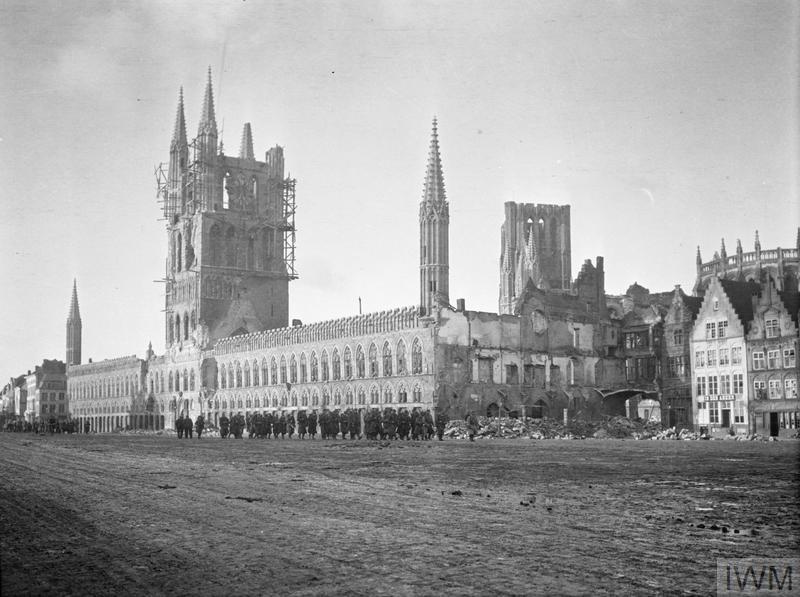
Emptied of civilians and with its fabric rent asunder, the city had in fact died some time before 1917, attested by photographs such as L.1 and L.2 and in numerous private accounts A particularly rich example of the latter flowed from the pen of George Francis Hansell (known as Francis) (SPS 1908 1909 )
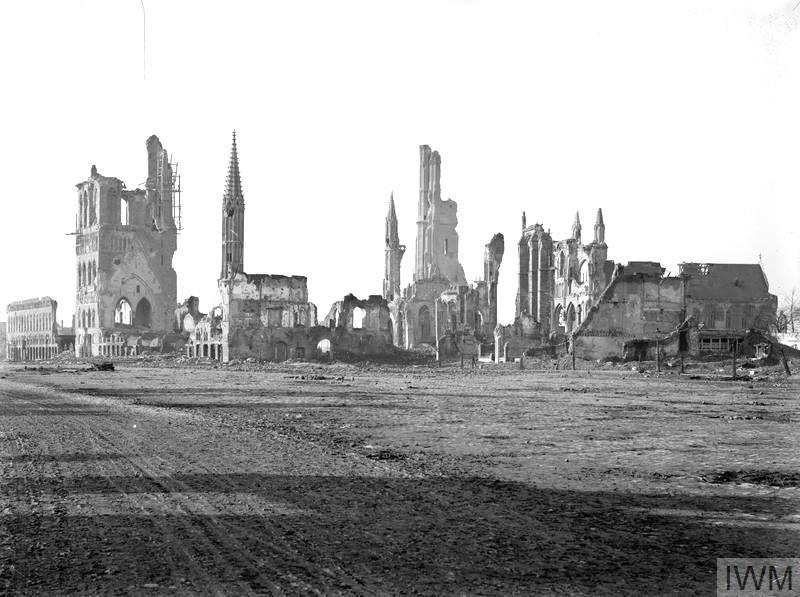
Francis enlisted with the 17th (Service) Bn. Royal Fusiliers on 2nd September 1914, thereby interrupting his studies at Christ’s College, Cambridge.1 Age 22, he crossed to France on 6 October 1915 in the 7th (Service) Bn. East Yorkshire Regiment. After five months at the front, Francis was invalided with shell shock and returned to England in February 1916. In November 1917 he returned to the front fulfilling an administrative role in the Labour Bn. King’s Own Yorkshire Light Infantry, in which unit he rose to the rank of Acting Captain. After the war Francis became an assistant Master at Cheltenham Grammar School, teaching Geography. He died age 29 on 19 September 1922, the result of what his Death Certificate describes as ‘the accidental discharge of an automatic pistol’. He left a wife and two sons.
13
13 Hansell, Francis, Letters Home 1915 1919. 23 October 1915 pp 18 19. Courtesy of the Hansell family.
16. Old Paulines and the Ypres Salient
Francis composed 94 letters home, spanning with few lapses the period from June 1915 to February 1919. On 21 October 1915 Francis’ unit took over a canvas camp near Ouderdom, south east of Poperinghe. It was from here that he set forth on 23 October, instructed to deliver a message to another unit. The journey involved passing though Ypres, the condition of which he described thus:

I shall never forget the appalling sight as long as I live. It seems almost as if we were in another world riding through a city of the dead. In the whole place (and I travelled down many streets) I never saw a single house that was not in ruins. Of course there are no civilians allowed anywhere in the town and the only people we saw in the deserted streets were a few sentries pacing solemnly to and fro and an occasional despatch rider. There were a few other signs of life such as half starved dogs and cats but that was all. The havoc is absolutely indescribable. No description could ever have brought home to me the terrible desolation of the place if I had not seen it with my own eyes. Every article of furniture you can think of lay strewn about the streets, everywhere we came across great craters made in the ground by the heavy shells which the Germans continue to hurl into the town. The railway lines and other metal work were in many cases twisted into the most extraordinary shapes. Once we passed a large cemetery and the smell of dead bodies nearly made me sick for the shells had brought many of them up to the surface. I saw one or two coffins in the gutter. At another place, we passed a little orchard with rows and rows of rude wooden crosses under the apple trees. Here and there an Officer’s cap hung on the top of the cross showed the rank of the “poor inhabitant below”. I think I could fill a book with all the
Old Paulines and the Ypres Salient
wonderful sights I saw in that city of ruins. Yet after all it is only one of many! We passed close by the celebrated Cathedral and Cloth Hall, the ruins of which I dare say you have seen in the illustrated papers. I think if anything had been wanting to rouse my hate for the ‘Bosche’ the sight of these magnificent old buildings in ruins would have done so. What horrible madness this war is!14
Upon leaving the sector on 6 January 1916, Francis wrote to his mother, telling her that: It will be with a light heart that I shall say good bye to the gloomy ruins of Ypres for I hope we shall not be coming back to this part of the line wherever we go it cannot be to a worse place than the YPRES salient.15
Harold Drummond Hillier (SPS 1906 1910, see Vol 1, Chapter 8, Section 8.10, i), another OP who had experience of Ypres, composed a number of sketches and watercolours of the broken city.
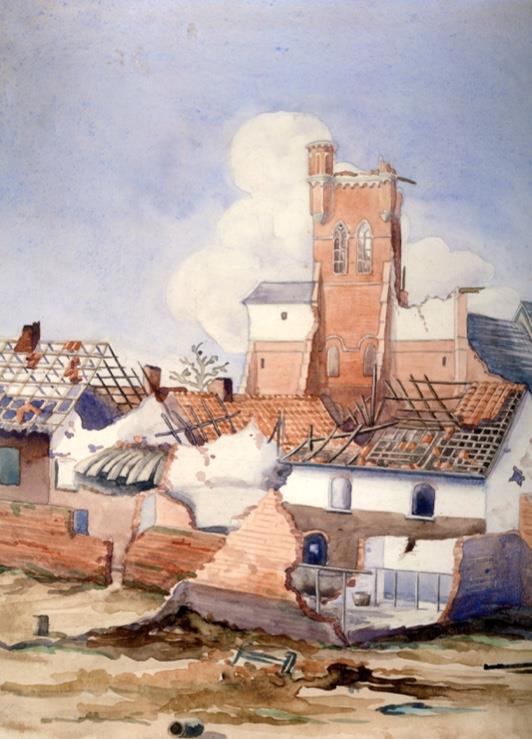
N.3 Eglise St Pierre, Ypres. March 1917. Painted by Harold Drummond Hillier (SPS 1906 1910)16
14 Hansell, Francis, Letters Home 1915 1919. 23 October 1915 pp 18 19. Courtesy of the Hansell family.
15 Hansell, Francis, Letters Home 1915 1919. 6 January 1916 p 43. Courtesy of the Hansell family.
16 Harold Drummond Hillier MC, WW1 Sketches and Watercolours. I am grateful to the family for allowing me to use this material.
16. Old Paulines and the Ypres Salient
Throughout the duration of the 1st World War the city of Ypres was strategically significant, standing in the path of Germany’s planned sweep to the Channel ports. The Germans briefly occupied the city in 1914 before moving back a short distance to the east, thereby effecting a calculated withdrawal in order to occupy the higher ground that existed in that vicinity and to the south. By the end of the same year both sides were digging in and establishing lines of connected trenches.
The German withdrawal had the effect of creating a bulge in the line known as a ‘salient’. The resulting salient ran from roughly Boesinghe, four miles to the north of the city, to Ploegsteert, some nine miles to the south. Overlooked by the Germans from three sides, Ypres thus became one of the most dangerous of all sectors along the four hundred mile long Western Front; and in this most perilous sector, there existed the most dangerous place of all: Hellfire Corner a crossroads and a railway crossing on the Menin Road, about one mile to the east of Ypres, that had to be navigated in order to access much of the battlezone. It was thus surely known by many an OP who served in the Salient.
Five large scale battles took place in the Ypres Salient, of which only the Third Battle of Ypres (known as the Battle of Passchendaele, 31 July 10 November 1917) and Fifth Battle of Ypres (28 September 2 October 1918) were fought offensively by the Allies. The in between times were often relatively quiet, the principal activity during these periods being that of trench raiding. Nevertheless, from time to time the Allies undertook operations, notably a series of mining actions at St Eloi (27 March 16 April 1916) and prior to the Battle of Messines Ridge (7 June 14 June 1917), and operations at and around Hooge and Hill 60. For most of the period 1914 1918 the front line around the Ypres Salient remained fairly static, but on occasion it moved several miles, most particularly in the great German offensives of 22 April 15 May 1915 and 9 29 April 1918 (the Second and Fourth Battles of Ypres respectively.)
N.4 Map showing the Ypres Salient and the various positions of the front lines, 1914 1918.17
17 Map courtesy of CWGC
16. Old Paulines and the Ypres Salient
By the time the guns fell silent, the Salient had claimed 185,000 Commonwealth lives, of whom 93 are OPs. Among this number, evident in the stories that follow (see Chapter 17) are those who fell victim to one (or more) of machine gun fire, shelling, a sniper’s well aimed bullet and the notorious Flanders mud; others succumbed when their aircraft fell from the sky, when their lungs filled with asphyxiating gas or in the terrifying hand to hand combat that took place underground. Their stories collectively show the multifarious ways in which men sought to kill each other during the years 1914 1914
The biographies of the 93 OPs are presented here in chronological form according to the date they were killed. In this way they narrate the history of the Ypres Salient, substantially from the viewpoint of a subaltern.
16.2 the ‘93’: an overview
i) in which they served: armies and regiments / corps
Of the 93 Old Paulines who fell in the Ypres Salient 1914 1918 a majority 81 were soldiers in the British Expeditionary Force (BEF), the overseas force furnished by Britain. Of
16. Old Paulines and the Ypres Salient

the remaining 12, nine were soldiers in the Canadian Expeditionary Force, two fought in the Australian Imperial Force and one in the Indian Army 18
The 81 who served in the BEF did so across a variety of regiments / corps: 59 served in infantry Regiments 9 served the Royal Artillery 5 served in the Royal Engineers 4 served in the Royal Army Medical Corps 2 served in the Royal Flying Corps 1 served in the Royal Army Chaplain’s Department 1 served in the Tank Corps
Most OPs (76 of the 93) who fell were of officer rank and as such were deployed in units that met the requirements of the army rather than any personal choice. Thus, the 59 OPs who served in infantry regiments were distributed across 54 different battalions in 34 different regiments. (The most popular regiments were the London and Middlesex, in which eight and seven of the 93 OPs served respectively.) In only five instances did OPs serve in the same battalion of the same regiment: Challoner and Hyman (6th (Service) Bn. Duke of Cornwall’s Light Infantry); Paull and Bunnett (No. 1 Coy. HAC); Goodale and Johnston (1st Bn. King’s Shropshire Light Infantry); Knight and White (1/5th Bn. London Regiment) and Shoobert and Gulbenkian (23rd (Service) Bn. Middlesex Regiment). In none of these five instances did OPs fall on the same date. Frequently of substantially different ages and rank, there is every likelihood that even these OPs may not have been aware of their common alma mater. The logistics of war thus militated against any capacity for the existence of a Pauline ‘band of brothers’, and where any such existed it was ephemeral and necessarily small in scale.
The average age of all OPs who fell in the Salient was 27 years, the same average that exists for the remaining 418 OPs who fell elsewhere. Variations from this average in 1916 and 1918 are most probably a manifestation of the small number of OPs who fell in the Salient in each of these years. Meanwhile, the higher than average age of death in 1914 is best
18 Those who fought in the C.E.F were: Merrit, C M; Jennings F S W; Fraser, A P; Fince, H A I; Mack Jost N R; Dobson W J. Marshall, K E D fought in the A.I.F. Scott, T H fought in the Indian Corps.
16. Old Paulines and the Ypres Salient
explained by this cohort of OPs consisting mostly of established, regular soldiers. (See Chart N.5.)
N.5 Number of OPs who fell in the Salient and their average age by year 1914 1918
No. Who Fell and Average Age Vs Year 1914 1918
No. Fall Av. Age
iv)
The most perilous day to be an OP in the Salient was 31 July 1917 the opening day of the Battle of Passchendaele on which occasion seven OPs fell.
v)
OPs fell in all sectors of the Salient. The greatest number nine fell at or near Hooge, three of whom fell on the same day (9 August 1915); eight fell in Ypres itself and seven fell at or near Passchendaele.
vi)
It is testimony to the industrial nature of the war fought in the Salient that almost half of OPs who fell in the Salient (45) have no known grave, their bodies lost in the Flanders mud. The majority of these (32) are remembered on the Ypres (Menin Gate) Memorial.
Forty eight OPs are buried in 30 different cemeteries established throughout the Salient and behind the lines. The largest concentration of OP graves in any one cemetery is seven These lie in Lijssenthoek Military Cemetery, a burial site used by a significant Casualty Clearing Station dealing for wounded extracted from the front.
16. Old Paulines and the Ypres Salient 9
N.6 The proportions of OPs who fell in the Salient with a grave or remembered on a memorial
vii) the ‘93’ Roll of Honour
Proportion: Graves Vs Memorial Grave Memorial
48%52%
The Roll of Honour of the 93 OPs who fell in the Ypres Salient is presented in N.7. The names of the fallen are listed in chronological order, consistent with the order in which their stories are told in Chapter 17.
N.7 Roll of Honour the Ypres ‘93’
Surname Initials At SPS Regiment
Died Age
Fairlie F 1892 93 Royal Scots Fusiliers 22 Oct 14 36
Miller F W J M 1907 08 Grenadier Guards 23 Oct 14 22
Watson G 1894 96 London Regiment 01 Nov 14 34
Farmer J D H 1906 11 RFA 04 Nov 14 21
Barton A T L 1907 10 Royal Inniskilling Fusiliers 07 Nov 14 20
Crowe W M C 1885 89 Royal Warwickshire 11 Nov 14 42
Paull A D 1908 12 HAC 12 Dec 14 20
Knight H M 1908 09 London Regiment 11 Jan 15 21
Richards F G 1885 90 Royal Army Medical Corps 05 Mar 15 40
Johnson P J Viner 1889 90 Wiltshire Regiment 12 Mar 15 39
James E S P K 1901 06 King's Royal Rifle Corps 17 Mar 15 27
Child G J 1906 10 Yorkshire Light Infantry 18 Apr 15 23
16. Old Paulines and the Ypres Salient 10
Southgate L M 1906 07 Canadian Expeditionary Force 22 Apr 15 22
Merritt C M 1890 95 Canadian Expeditionary Force 23 Apr 15 37
Scott T H 1897 1900 Indian Army 26 Apr 15 31
Nash F O C 1891 96 Northumberland Fusiliers 27 Apr 15 37
Butcher C G 1907 09 Dorsetshire Regiment 02 May 15 23
Maurice S 1902 05 Royal Engineers 11 May 15 28
Jennings F S W 1895 1900 Canadian Expeditionary Force 06 Jul 15 33
Challoner A C 1904 11 Duke of Cornwall's Light Infantry 30 Jul 15 23
Long Innes S 1891 94 Royal Lancaster 04 Aug 15 37
Goodale A W 1908 13 King’s Shropshire Light Infantry 09 Aug 15 20
Hall V 1903 07 London Regiment 09 Aug 15 26
Walsh G P 1907 11 Sherwood Foresters 09 Aug 15 22
Barnett D O 1907 14 Leinster Regiment 16 Aug 15 20
Bunnett W G 1913 14 HAC 20 Sep 15 16
Bullock A E 1901 08 Royal Army Medical Corps 26 Sep 15 26
Goldsworth D W 1907 11 South Lancashire Regiment 26 Sep 15 21
Fraser A P 1906 07 Canadian Expeditionary Force 15 Oct 15 24
Graham A F 1908 10 RGA 11 Nov 15 22
Calthrop E F 1889 93 RFA 19 Dec 15 39
Sifton W A 1908 12 South Staffordshire Regiment 25 Dec 15 20
Haigh A G 1899 1900 Royal Engineers 15 Feb 16 30
Boddy G G D 1904 07 Royal Fusiliers 27 Mar 16 26
Johnston A L 1901 08
King’s Shropshire Light Infantry 22 Apr 16 26
Finch H A I 1891 97 Canadian Expeditionary Force 28 Apr 16 37
Mack Jost N R 1909 11 Canadian Expeditionary Force 03 Jun 16 20
Mitton R H 1892 95 Canadian Expeditionary Force 03 Jun 16 36
Dobson W J 1890 97 Canadian Expeditionary Force 09 Jul 16 38
Haldane J O 1891 92 Rifle Brigade 09 Aug 16 37
16. Old Paulines and the Ypres Salient 11
Brown I M 1902 04 Royal Army Medical Corps 15 Nov 16 28
Frankland J C 1914 15 Loyal North Lancashire Regiment 10 Jan 17 19
Misquith J C 1905 09 RFA 04 Feb 17 26
Moses V S 1911 16 RFA 04 Jun 17 19
Allard P H 1908 11 RFA 23 Jun 17 23
Foulsham A P 1911 16 RGA 20 Jul 17 19
Beit R O 1902 07 London Divisional Engineers 28 Jul 17 27
Belfield E 1905 06 Middlesex Regiment 31 Jul 17 26
Chibnall R S 1909 13 Suffolk Regiment 31 Jul 17 20
Coburn C I 1896 03 King's Royal Rifle Corps 31 Jul 17 32
Johnstone J D 1913 15 Royal Lancaster 31 Jul 17 19
Ley G A H 1905 08 Devonshire Regiment 31 Jul 17 26
Shoobert N 1903 06 Middlesex Regiment 31 Jul 17 27
Wickham J N(S) D 1907 10 King's Own Royal Lancaster Regiment 31 Jul 17 25
Scratton G E H 1908 11 Argyll and Sutherland Highlanders, attd Black Watch
01 Aug 17 24
Winckler von M W 1907 12 Middlesex Regiment 01 Aug 17 23
Solomon E J 1906 12 South Lancashire Regiment 02 Aug 17 23
Johnson H G 1912 15 Grenadier Guards 07 Aug 17 20
Martin S S 1907 12 Middlesex Regiment 11 Aug 17 24
Bowman C H 1910 16 Oxford and Bucks Light Infantry 16 Aug 17 20
Buckworth A B 1913 15 Royal Inniskilling Fusiliers 16 Aug 17 19
Rinder C H B 1911 13 London Regiment 16 Aug 17 20
White A B 1901 04 London Regiment 17 Aug 17 29
Hyman R L 1905 06 Duke of Cornwall’s Light Infantry 22 Aug 17 25
Manson G P 1912 13 Somerset Light Infantry 24 Aug 17 20
Royal Dawson O S 1896 1903 Oxford and Bucks Light Infantry 25 Aug 17 32
Sandys W E 1908 09 Royal Flying Corps 05 Sep 17 24
Williams M H 1914 15 London Regiment 19 Sep 17 33
Chown F J 1912 16 Royal Flying Corps 20 Sep 17 19
Gulbenkian K 1905 08 Middlesex Regiment 20 Sep 17 22
16. Old Paulines and the Ypres Salient 12
Reynolds G G 1910 13 London Regiment 20 Sep 17 21
Manning G A 1904 09 Royal Engineers 26 Sep 17 26
Chester G F G 1887 93 London Regiment 29 Sep 17 40
Chetham Strode E R 1906 09 Border Regiment 01 Oct 17 26
Langworthy W S 1910 12 Devonshire Regiment 04 Oct 17 22
Samuel C V 1903 05 Royal Warwickshire 04 Oct 17 28
Fink L A L 1905 06 Bedfordshire Regiment 05 Oct 17 26
Beamish E D 1902 03 Australian Expeditionary Force 11 Oct 17 30
Marshall K E D 1905 07 Australian Expeditionary Force 12 Oct 17 26
Davies F C 1898 1903 Royal Army Medical Corps 17 Oct 17 33
Aldridge D J 1899 1901 Royal Marine Light Infantry 26 Oct 17 33
Harding W J 1899 1900 Army Chaplain's Department 31 Oct 17 31
Riddle G J 1907 10 Canadian Expeditionary Force 06 Nov 17 25
Bennett W Sterndale 1907 08 Royal Naval Volunteer Reserve 07 Nov 17 24
Whiteman O C 1899 1903 Royal Fusiliers 22 Nov 17 31
Sowinski J L 1905 06 RFA 28 Nov 17 27
Troup S H 1906 11 Royal Berkshire Regiment 02 Dec 17 25
Chambers R S B 1898 02 King's Royal Rifle Corps 24 Dec 17 31
Smalley R F 1890 95 South Staffordshire Regiment 14 Apr 18 41
Tovey Harry T 1892 96 RFA 22 Apr 18 37
Symons C L 1912 17 Royal Engineers 23 Apr 18 19
Lane S B 1896 97 Royal Dublin Fusiliers 20 Sep 18 35
Beaty Pownall G E 1890 95 Border Regiment 10 Oct 18 41
16. Old Paulines and the Ypres Salient 13
1914: OPs who fell in the Ypres Salient
Fairlie, Captain Frank 22 October 1914, Poezelhoek SPS 1892 1893
2nd Bn. Royal Scots Fusiliers, D Company Ypres (Menin Gate) Memorial Panel 19 and 33 Age 36
Frank Fairlie19
Frank Fairlie (SPS 1892 1893) was a regular with considerable experience by the time war broke out in 1914. He obtained his commission in the Royal Scots Fusiliers in 1901 and served in the South African War, 1899 1901, being present at operation in the Orange Free State; in the Transvaal, west of Pretoria, including actions at Frederickstad; and in Cape Colony, south of the Orange River, receiving the Queen’s medal with four clasps. Frank was promoted Lieutenant in June 1905 and from 1911 to 1913 was employed with the West African Frontier Force. He was promoted to the rank of Captain in 1912. In 1914 The Pauline reported that he was restored to the Royal Scots Fusiliers as a Supernumerary Captain.20 He fell at Poezelhoek.
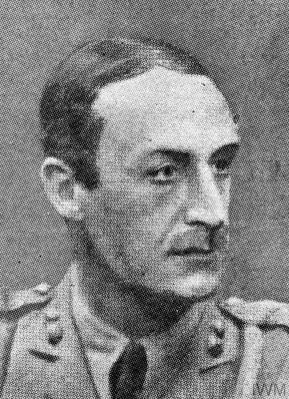
On 11 October the 2nd battalion Royal Scots Fusiliers (21 Brigade, 7th Division) had been in Bruges awaiting final orders for the relief of Antwerp. However, when news was received that Antwerp had fallen and that enemy forces were of significant scale, the unit had marched in a south westerly direction via Roulers to Ypres, arriving on 14 October and on that night had billeted close to the railway station. The next day 21st Brigade occupied 19
20
© IWM HU 121877
The Pauline 1914, Vol 32, no. 208 p 42
17. the ‘93’ and their stories
outposts in the line Zillebeke Wieltje. Then, very early in the morning of 17th October, the Fusiliers marched eastward and occupied a line north of the Menin Road, roughly Poezelhoek Reutal. From here they advanced as far as Terhand, the 2nd Royal Scots Fusiliers entrenching on a spur running south west from that place. In this location the battalion came under heavy fire and was thus ordered to withdrew on 19 October and establish a line a line between Reutal and Poezelhoek, about a mile in length. After the enemy had broken through this line, A Coy led a counter attack at 5 pm on 22 October down the line of houses at Poezelhoek, ‘clearing the houses of snipers who had caused some loss and considerable annoyance, as they went’.21 This counter attack progressed as far as the Poezelhoek Reutal road, before having to turn back in the face of enemy attack. This was the action in which Frank was killed.
Map showing the line held by 7th Division 21 24 October 1914.22
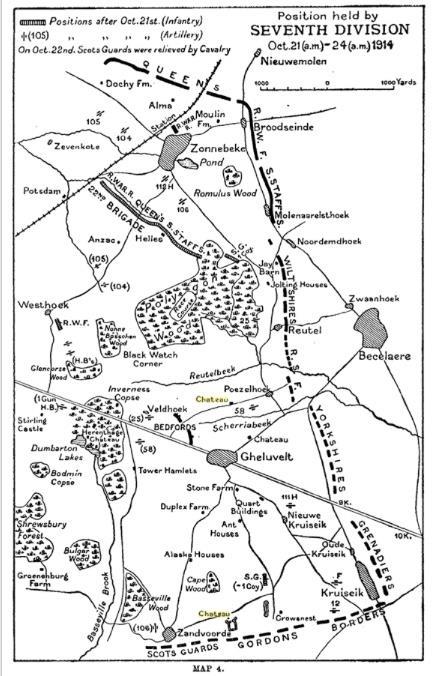
21 TNA WO 95 1659 2
22 Atkinson, C T The Seventh Division (Eastbourne, 1926) p 5
17. the ‘93’ and their stories 2
The Seventh Division official history asserts that:
Towards the evening [of 22 October] the Fusiliers attempted to recover the trenches evacuated on the previous day, and A company and part of D [Company] counter attacked down the Poezelhoek road, clearing the houses of snipers. One big house in the centre of the village was stubbornly defended and Captain Fairlie of D Company was killed heading an attack on it, but the house was quickly surrounded, whereupon its occupants surrendered.23
A slightly different version of events is given by John Buchan. He states that:
In the evening of 22 October Major Ian Forbes of A Company, with parties from C and D [Companies], attacked in order to retake D’s position, and cleared the houses in Poezelhoek, but the enemy proved too strong to permit the task to be completed. Captain Frank Fairlie fell while receiving the surrender of some thirty Germans he was shot by one of them.24
The Glasgow Daily Record and Mail provides a yet different narrative:
Several brilliant charges had taken place against the enemy, who attempted to occupy some buildings [at Poezelhoek] which would give them a big advantage. At dusk about twenty Germans managed to get into one house, from the shadows of which they opened a galling fire into “A” Company’s trenches. Major Forbes undertook to surround the house and capture them. On being called on to surrender they offered to do so, and Major Forbes walked up to one man who held out his rifle to take it, when the hound suddenly drew his rifle back and fired at the Major in the stomach. Fortunately the bullet went low between his legs, causing no damage. It was in the skirmishes which took place among these buildings that Captain F. Fairlie was killed.25
Major Ian R.I.F. Forbes recalled the death of Frank and noted that for days he could see the bodies of his men lying in front of the trenches, one of whom was Frank. At 1 pm on 25 October a party went out into No Man’s Land to collect and bury the dead. Carrying only shovels, it managed to lay a number of men in a trench for burial but, when the enemy opened fire, Frank’s body had to be left where it lay.
List of 7th Division casualties on 23 October, showing ‘Captain F. Fairley’ [sic].26
23 Atkinson, C T The Seventh Division (Eastbourne, 1926) p 44 24 Buchan, J The History of the Royal Scots Fusiliers (Edinburgh, 1925) p 301 25 From an article in the Glasgow Daily Record & Mail, Nov 1914 26 TNA WO 95 720 1
17. the ‘93’ and their stories
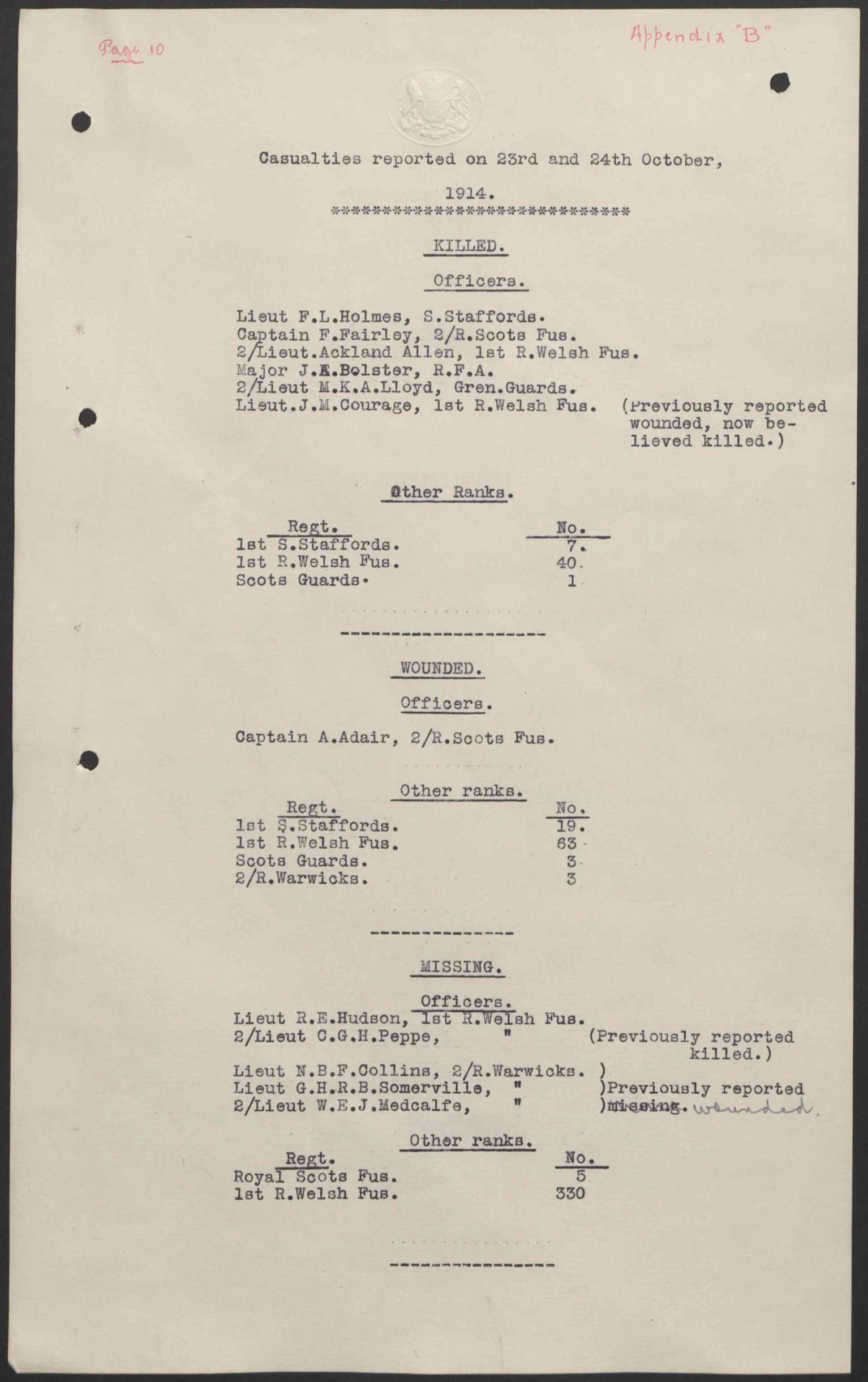
Miller, Lt Frederick William Joseph Macdonald 23 October 1914, Zonnebeke SPS 1907 - 1908
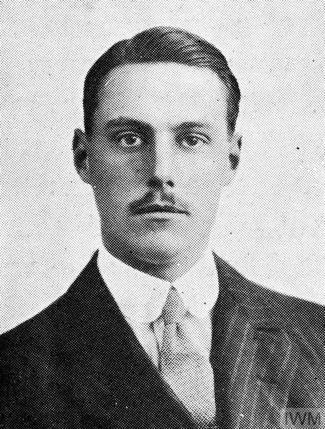
2nd Bn. Grenadier Guards, No. 2 Company Ypres (Menin Gate) Memorial Panel 9 and 11 Age 22
Frederick William Joseph Macdonald Miller28
After leaving SPS, Frederick appears to have attended Royal Military College, Sandhurst. He was gazetted to the Grenadier Guards in February 1912 and was given his lieutenancy in August, to date from 30th June 1914. He fell a short distance to the north of Zonnebeke.
On the afternoon of 19 October General Monro, commanding 2nd Division, was duly ordered to move north east of Ypres on the following day. Accordingly, on 20 October the 2nd Grenadier Guards (4th Guards Brigade, 2nd Division) marched at 5 am in the bitter cold from Boeschepe to St Jean, a distance of some 18 km, arriving at around 3.30 pm. From St Jean they were instructed to march via Wieltje towards St Julian where they were held in readiness to support the left of the 7th Division around Zonnebeke. By the evening of 20th October, 2nd Division had thus established a line running from Zonnebeke to just east of Langemarck in anticipation of an advance planned for 7.30 am on 21 October at which time they were ‘to cross the Zonnebeke Langemarck road … and attack in the direction of Passchendaele.’29
28 IWM HU 125656
29
TNA 2nd Division Operation Order No. 26, 21 October 1914
17. the ‘93’ and their stories
In the early morning of 21 October the 4th (Guards) Brigade moved into position immediately to the west of Zonnebeke where it was concealed behind Point / Hill 37. The 2nd battalion Grenadier Guards diary states that the unit:
Marched at 6 am to a position of assembly near Hannebeck Brook [sic] about 2 miles west of Zonnebeke. Then advanced about 1&1/2 miles towards Paschenbael [sic], meeting with some opposition. Eventually entrenched a line … Counter attack at dusk beaten off. Germans came on saying “We are the Coldstream”.30
The historian of the Regiment records the incident thus:
Before long the sky was lit up in all directions by the farms which the enemy was burning. By this illumination the Germans attempted a counter attack, and came on shouting, "Don't fire, we are the Coldstream." It was characteristic of the German thoroughness of method to master this regimental idiosyncrasy, and say Coldstream and not Coldstreams. But the [2nd] Battalion had not fought for two months without learning the enemy's tricks, and as spiked helmets could be distinctly seen against the glow of the burning farms, they fired right into the middle of the Germans, who hastily retired.31
Over the course of 22 23 October the 2nd battalion entrenched its position as best it could: The trenches, composed of isolated holes which held two or three men apiece, were exposed from the left to enfilade fire, but there the battalion had to remain for two days, shelled intermittently.32
The Divisional History describes how:
The night of the 22nd had for the 4th Brigade been one of comparative quietude, but the 23rd opened with a terrific hostile shell fire along the whole line, which continued with great vigour throughout the day.33
The 2nd battalion diary records that Frederick was killed on 23 October, the author adding a little detail:
30 TNA WO 95 1342 1
31 Ponsonby F, The Grenadier Guards in the Great War, Vol 1 (Macmillan, 1920) p 145
32 Ponsonby F, The Grenadier Guards in the Great War, Vol 1 (Macmillan, 1920) p 146
33 Wyrall E, History of 2nd Division (Thomas Nelson, 1916) p 119
17. the ‘93’ and their stories 6
In the evening, Lieutenant Donald [i.e.Macdonald] Miller, who had come out originally with the battalion, and had fought all through the retreat, was killed by a high explosive shell.’34 Frederick’s body was lost in the ground on which he fell.
34 Ponsonby, The Grenadier Guards in the Great War, Vol 1 (Macmillan, 1920) p 146
17. the ‘93’ and their stories
Watson, Private George Watson, 1112 1 November 1914, Messines SPS 1894 - 1896
1/14th Bn. London Regiment (London Scottish), B Company 35 Ypres (Menin Gate) Memorial Panel 54 Age 34
After leaving SPS, George joined the staff of the Secretary’s Office at the Great Western Railway and was employed in that capacity when war broke out. He joined the 1/14th battalion London Regiment (London Scottish) in 1908, soon to become famous as the first Territorial unit to be bloodied in the War. George fell in the vicinity of the windmill, just to the north of Messines.
Having failed to retain and develop their success at Gheluvelt on 31 October the Germans re focussed their attack onto the southern part of the Salient, between Messines and Wytschaete. After some confusion, the 1/14th battalion London Regiment (1st Guards Brigade, 1st Division) was moved to this part of the line.
Even before George engaged with the enemy in the period 31 October 1 November he must have been exhausted, for on each of the previous few days the unit had been on the move. Having arrived at St Omer at midnight on 27 October the battalion of 750 strong was moved by motorbuses overnight 29 30 October to Ypres, arriving in that place at 3 am. This was a nine hour journey, undertaken in a fleet of about thirty four London buses. The experience was a wretched one, especially for those riding on the open top deck. One member of the battalion later recalled:
The road was abominable. Our particular bus was ditched four times which meant that we all got out and pushed the other buses did not fare much better.36
This image shows the 2nd Royal Warwickshire Regiment being transported through Dickebusch on their way to Ypres on 6 November, but this is the same as the transport experienced by Watson.37
35 This battalion was the first Territorial Force to experience action. 36 Baxter Milne. Quoted in Lloyd, M, The London Scottish in the Great War (Barnsley, 2001) p 34
37 © IWM Q 57328
17. the ‘93’ and their stories 8
At Ypres, some men slept in the Cloth Hall, though any meaningful rest was thwarted by the Germans releasing at first light a cannonade of intense and rapid fire upon the town. In the morning of 30 October, having breakfasted at 6 am and then paraded two hours later, the battalion marched up the Menin Road to a reserve position near Hooge later known as Sanctuary Wood passing a continuous stream of wounded men making their way back to Ypres. However, at 4 pm it was ordered to march back to Ypres, from where it travelled by motorbus to St Eloi, south of Ypres, arriving at 7.50 pm. Here the unit was provided with a hot meal and those lucky enough to find shelter grabbed some sleep. At this moment it seems that the original intention was to send the battalion into action shortly after midnight, the men having been roused to parade at about that time. However, representations were made as to their collective exhaustion and this plan was altered. Sandy Innes, a signaller with the battalion described the experience thus:
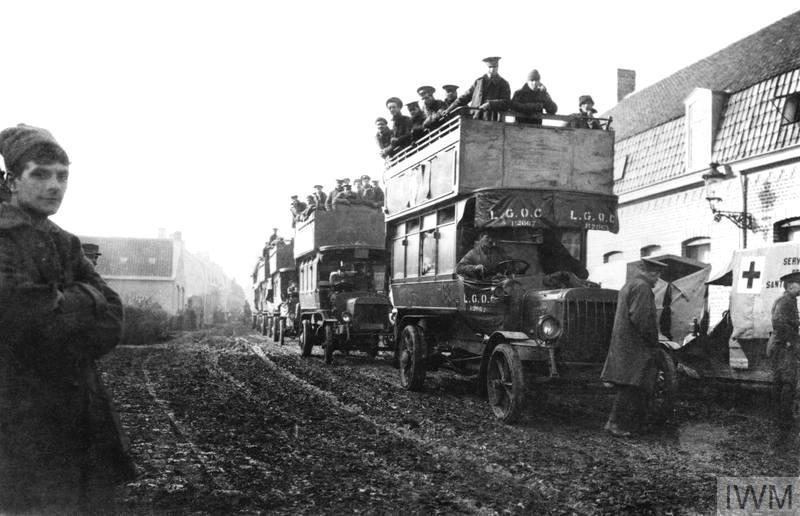
Spent ten hours of last night on bus in rain and finally at Ypres and slept in the Town Hall. At 10 am we parade and march out to north east to within 400 yards of firing line. Lie there for four hours and after seeing lots of wounded return, we march back to Ypres and mount our buses again. Ride to St Eloi and finally bunk down in a house only to be called out at 11 pm and sent back to bed.38
At 6 am on 31 October the unit marched south east from St Eloi for about a mile, at which point it began to prepare a reserve trench. However, at 8 am further orders were received 38 Baxter Milne.
17. the ‘93’ and their stories
to march to the ridge area just north of Messines to participate in a counter attack from the trenches established by the 2nd Cavalry Division. Private J O Robson of B Company recalled:
We marched up the road into Wytschaete. Gendarmes were turning inhabitants out of the town, and we met a pitiful procession of refugees mothers with babies in their arms, little boys carrying huge loads, old grannies pushing dilapidated perambulators full of clothes, sheets and all sorts of odds and ends. At the door of a convent on the right stood a group of nuns all, I believe, killed by a shell shortly afterwards.39
Moving under heavy shell fire, the troops first traversed the Wytschaete Wulverghem road and then, by following the course of the Steenebeek, arrived at about 10 am at L’Enfer Wood. From this position the battalion was deployed to consolidate a gap in the line marked by two farms adjacent to the Messines Wytschaete road, later known as Hun’s Farm and Middle Farm. To the north of the latter stood a windmill, already severely damaged.
From L’Enfer Wood elements of the 1/14th London Regiment (London Scottish) were ordered up the slope to the line of trenches a little to the east of the Messines Wytschaete road. The unit diary records that the:
The cavalry trenches were reached under heavy shrapnel and big gun fire about 10.30 am, but as there was no room in the cavalry trenches the best cover obtainable had to be searched for, it being impossible to advance further unsupported. The battalion lay under heavy fire until dusk when the firing ceased.40
The Report on Operations by GOC 2nd Cavalry Division tells a rather different story. It states that the London Scottish:
Although exposed to a very heavy shell fire, and an enfilade fire on their left from a maxim [gun], attacked most successfully and re took all the trenches, and stopped any further German advance on Messines, although some of the enemy remained in the village. The battalion retained its position for the rest of the day although exposed to heavy shell fire.41
Any reprieve, however, was only temporary. Beginning from about 10 pm on 31 October, there was desperate fighting for the next eight hours. Sir Hubert Gough, GOC 2nd Cavalry Division, reported that: 39 Ibid pp 37 38 40 TNA WO 95 1266 2 41 TNA WO 95 1117 1 Report on Operations of 2nd Cavalry Division 30th, 31st Oct and 1 Nov
17. the ‘93’ and their stories 10
Our men firing steadily inflicted enormous losses but our line was too feebly held to be continuous and gradually between the gaps the enemy got through and began surrounding our various detachments. Constant counter attacks with the bayonet were made by our cavalry and the London Scottish and the trenches constantly re taken. …. About 2 pm [sic: this must be 2 am] most of our troops had fallen back from the trenches …. The London Scottish were still in their trenches at 5.45 am, which they held by repeated bayonet charges … ‘A’ Company of London Scottish in reserve took up a position in rear of the trenches … which protected the rear of the companies in the trenches and prevented them being surrounded for some time and they then maintained their position until daylight, when they retired fighting through the Germans, although practically surrounded…. There was great confusion owing to the darkness, the noise, the extent of the front, and it was impossible for officers and men to know where to go and what the situation was.42
The Messines Wytschaete Ridge had thus been lost.43 Of their total number of 750 before the encounter, 1/14th London Regiment (London Scottish) endured casualties of 9 officers and 312 Other Ranks.44 George’s body was not retrieved and was lost. During 1 November the remainder went into billets at La Clytte. The scale of loss was in part because some 50% of the Mark I rifles proved useless for rapid firing owing to faulty magazines, as well as being outdated and rounds having to be inserted singly by hand. Treating some of the wounded, Captain Henry Owens of the RAMC was told by one combatant that ‘it was quite alright but [they] were surprised that volunteer troops were sent actually into the fighting line they hadn’t expected it.’45
The Official Regimental History concludes thus its chapter on the events of 31 October 1 Nov:
So ended the Battle of Messines. The London Scottish, hastily assembled from detached duties a few days before, with no preparatory training, with defective rifles and without their machine guns, had been flung into one of the most desperate fights of the War. At a most critical moment they had held back the rush of overwhelming numbers long enough to prevent a break through that would have imperilled the whole position about Ypres.46
42
TNA WO 95 1117 1 7. Report on Operations of 2nd Cavalry Division 30th, 31st Oct and 1 Nov
43 In fact Wytschaete was re gained by the French, though lost again to the Germans on 13 November. The Germans dug in on the higher ground and were not dislodged until June 1917.
44 The 2nd Cav Division suffered a total loss of 1,455 men in 48 hours. TNA WO 95 1117 1 Report on Operations of 2nd Cavalry Division 30th, 31st Oct and 1 Nov
45 IWM, Owens Mss, 80/23/1, memoir.
46 Lindsay, J H (ed) The London Scottish in the Great War (1926) p 42
17. the ‘93’ and their stories 11
Farmer, 2nd Lt James Douglas Herbert 4th November 1914, Westhoek SPS 1906-1911
9th Battery, XLI Bde, Royal Field Artillery Ypres (Menin Gate) Memorial Panel 5 and 9 Age 21
After leaving St Paul’s James attended the Army College, Farnham and the Royal Military Academy, Woolwich. He was gazetted as second lieutenant to the Royal Field Artillery in 1913 and went to the front with the BEF in August 1914, initially with the 17th battery of the XLI Brigade before being transferred a few days before his death to the 9th battery. He fell at Westhoek.

In the opening days of November 1914 the three batteries of XLI Brigade (2nd Division) were to give cover to infantry units of 2nd Division north of the Menin Road. All three batteries were located in close proximity to each other on top of the ridge at Westhoek.
Map showing the location of, and areas covered by, the Royal Artillery Batteries of 2nd Division in November 1914. The three batteries of XLI Brigade (9th, 16th and 17th) are located in the bottom left hand square.48
47 © IWM (HU 121895) 48 TNA WO 95 1313 1 4
17. the ‘93’ and their stories 12
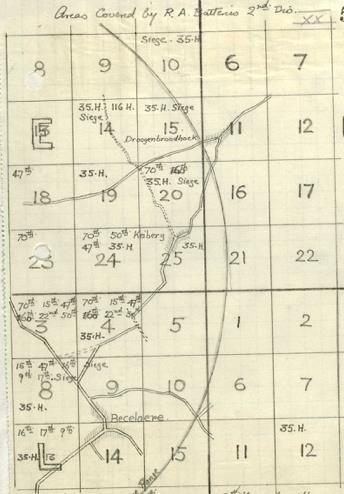
Map showing the disposition at Westhoek in November 1914 of the three batteries 9th, 16th and 17th of XLI Brigade.49

A F Becke provides a detailed description of the arrangement of the batteries of XLI Brigade at Westhoek: [The] HQ [of XLI Brigade] and all 3 btys [i.e. batteries, 9th, 16th and 17th] were all situated in the vicinity of Westhoek. The Brigade headquarters itself was in a splinter proof dug out at the side of the Chapel to the south of the cross roads. …. The Brigade dressing station was situated at the corner of the cross roads in Westhoek … The 9th battery’s position was along a fence that formed the southern boundary of the garden of a small two roomed cottage. To screen the guns, big branches of trees had been cut down and planted vertically along the fence, thus giving to it the appearance of a small belt of saplings. From the front only the
49 TNA WO 95 1326. This map is dated 11 November, but the batteries had not moved their location since the death of Farmer on 4 November.
17. the ‘93’ and their stories 14
gun muzzles were visible, and even they could only be seen with difficulty. To permit, however, of extreme traverse it sometimes became necessary to uproot one or two of the branches. In order to give protection to the detachments, narrow slits had been dug behind the wagons, and an extra slit served as a command post. 50
A diagram showing the arrangement of a gun pit with which James will have been familiar.51
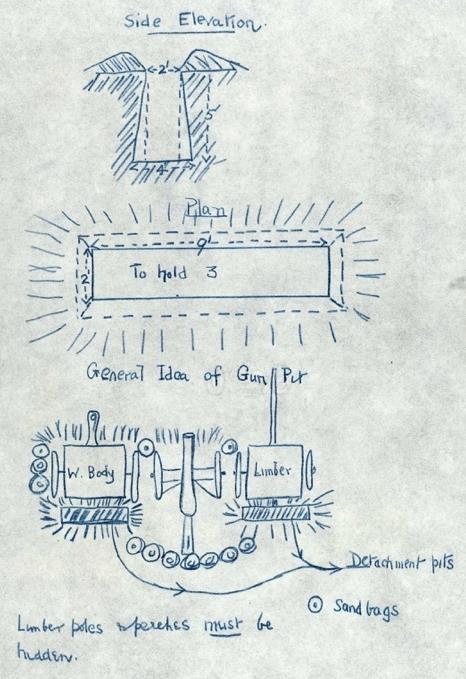
50 Becke, A F XLI R.F.A p. 153. This article is hosted in XLI unit diary December 1914 TNA WO 95 1326 1. This final sentence actually applies to 16th battery, but is equally applicable to all three of the 41st Brigade batteries. 51 TNA WO 95 1313 1 4
17. the ‘93’ and their stories 15
The unit diary of 9th battery reports that on 4 November ‘2nd Lieut J. D. H. Farmer was killed by a heavy howitzer shell which burst in the battery’, suggesting that he was the unfortunate victim of a local accident rather than any enemy action.52 The diary does not indicate the fate of James’ body, but in documentation presented to the Imperial War Museum by his father, it is stated that James was ‘buried at Westhoek’. 53 When 17th battery incurred two casualties on 3 November the diary of this unit states that ‘gunners [George] Cottrell and [Joseph] Blackshaw were buried in the rear of the officers’ billet in the evening’ the billet most probably being equivalent with XLI Brigade HQ, shown on the map above.54 It seems likely, therefore, that this too is the final resting place of James, his remains thereafter lost like those of Cottrell and Blackshaw no doubt pulverised to oblivion in the heavy enemy shelling that occurred during the battle of Nonne Boschen on 11 November.55 52 TNA WO 95 1326 1 53 © IWM HU 121895. This detail was submitted for the Bond of Sacrifice publication. 54
Battery https://www.ancestry.co.uk/interactive/60779/43112_1326_0 00000?backurl=&ssrc=&backlabel=Return#?imageId=43112_1326_0 00041 55 In the text accompanying an image of Farmer presented by his father and in the possession of the IWM, it is stated that Farmer was buried at Westhoek. There is a memorial panel to him in Mundesley Church, Norfolk. https://www.flickr.com/photos/43688219@N00/9531373106/in/photolist fDetLb fwfMa5
17. the ‘93’ and their stories 16
Barton, 2nd Lt Albert Thomas Lionel 7 November 1914, Ploegsteert Wood SPS 1907-10
2nd Bn. Royal Inniskilling Fusiliers Ploegsteert Memorial Panel 5 Age 20
The Pauline is silent about the schoolboy career of Albert. His one and only mention is on the list of those noted as ‘Missing’ in the December 1914 edition.56 The record is similarly silent about his activities after having left SPS in 1910, though clearly at some point he signed up to fight with the 2nd battalion Royal Inniskilling Fusiliers (12th Brigade, 4th Division).
On 7 November the line in the southern part of the Salient between Le Touquet and St Yves was held by 4th Division. On this day, from 2.30 am onwards, the Germans focussed their attack against Ploegsteert Wood, described by a soldier in the Seaforth Regiment as being ‘very similar to an English pheasant covert with dense undergrowth which made it very difficult to get through and impossible to see any distance.’57 By all accounts the assault was unusually severe, the Germans employing six infantry and two Jager battalions. Towards 7.30 am, under the cover of a thick mist, a large group of Germans had breached the front line trenches and penetrated the wood, at which point the 2nd Inniskilling Fusiliers were employed in counter attacks.
The unit diarist recorded that the battalion:
Went out in the morning to recover trenches on the edge of Ploegsteert Wood. Two desperate assaults were made, led by Captain G R V Steward, on the trenches which the Germans had taken from the Worcester Regiment. We were unfortunately repulsed with many casualties … 2nd Lieutenant A T L Barton, wounded and missing.58
Albert’s obituary, published in The Pauline, provides a little more detail:
On 7th November [Albert] volunteered off the sick list to lead the attack on a Saxon trench, but fell wounded on the parapet [towards the eastern edge of Ploegsteert Wood] and has not been heard of since.59
56
57
58
59
The Pauline, 32 214, December 1914, p 218
TNA WO 95 14831 7
TNA WO 95 1505 2
The Pauline, 34 224 April 1916 p 41
17. the ‘93’ and their stories 17
At 5.30 pm on 8th November the 2nd battalion Argyll and Sutherland Highlanders moved into Ploegsteert Wood to relieve the 2nd Royal Inniskilling Fusiliers, a process described as ‘a very muddy walk’ and not completed until 11 pm.60 Their unit diary includes a particularly clear map, showing the piecemeal nature of the trenches that the 2nd Royal Inniskilling Fusiliers had established in rather desperate circumstances.61 60 TNA WO 95 1365 1 61 TNA WO 95 1365 1
17. the ‘93’ and their stories 18

Crowe, Captain William Maynard Carlisle 11 November 1914, Glencourse Wood / Nonne Bosschen
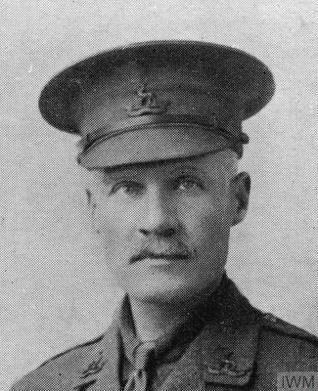
SPS 1885 - 1889
Royal Warwickshire Regiment; attached 1st Bn. Northamptonshire Regiment Ypres (Menin Gate) Memorial Panel 8 Age 42
Aged 17 years and 10 months in July 1888, William was described by his schoolmaster at St Paul’s as ‘painstaking and industrious but has not great strength in any subject’.63 Upon leaving SPS William attended the Royal Army Medical Corps at Sandhurst, obtaining his commission as 2nd Lieutenant in the Royal Warwickshire Regiment in July 1891. He was promoted Lieutenant in 1893, became Captain in September 1898, and retired in August 1907, joining the Reserve of Officers. William was a member of the United Service Club and of the Swiss Alpine and Swiss Ski Clubs. He married Elizabeth Hannah Stanley, a widow ten years his senior, at Trinity Church, Upper Chelsea on 5 November 1904. William was attached to the 1st battalion Northamptonshire Regiment (2nd Brigade, 1st Division) at the time he was killed. He fell in the vicinity of Glencourse Wood / Nonne Bosschen.
An early winter’s mist hung in the air in the morning of 11 November, the day on which the Germans launched an attack all along the front from Messines in the south to Polygon Wood in the north. Along this nine mile front fewer than 7,800 men faced twenty five German battalions totalling some 17,500 infantry. The massive German infantry attack began at around 9 am, preceded by a three hour long bombardment which, all accounts agree, was unprecedented in its intensity. Just north of the Menin road, the 900 yards of front between Veldhoek and Polygon Road was held by 1st Guards Brigade (1st Division) and was composed of some 800 officers and men. Trying to determine a route around the 62 IWM HU 120648 63 School Reports, with the permission of St Paul’s School Archive
17. the ‘93’ and their stories 19
resistance with which they met, the Germans found their way into Nonne Bosschen (Nun’s Copse) by 10.15 am on 11 November. The situation was indeed grave for the British, for not only was the line thin but on the western side of Nonne Bosschen the Germans would not have met with any organised resistance they would have penetrated and broken the British line. In these desperate circumstances, 1st Guards Brigade (1st Division):
Asked for the 1st battalion Northamptonshire Regiment to restore the situation as the Germans had broken the line. The Northants arrived at 1st Bde HQ and were ordered to clear Nonne Bosschen Wood [and the south east corner of Glencourse Wood].64
Unfortunately, the unit diary for 1st Northamptonshire for November 1914 is mostly missing, and what has survived offers little illumination.65 For the period 26 October to 15 November it simply states that ‘the regiment was heavily engaged most of the time. In fact, on 14 November there were only two officers left and about 300 men’.66 The narrative for this period for 1st Northamptonshire can only be reconstructed by a complex process of cross referencing with multiple other unit diaries, personal accounts, a close study of maps and visits to the locations as they exist today.
The 1st battalion Northamptonshire Regiment had been in and out of the front line in the woods surrounding Veldhoek chateau just north of the Menin Road for several days prior to 11 November. At 2.30 am on that day they had once again arrived in reserve in the north eastern corner of Sanctuary Wood and were looking forward to being sent out of the fighting area for a rest. However, from 6.30 am the line they had only recently vacated was subject to the ‘the most terrific [shell] fire that the British had yet experienced.’67 Infantry at the front crouched for cover in the bottom of ill formed trenches and holes in the ground, the survivors then enduring an onslaught by Prussian Guards brought up especially for the purpose. As the Official British History puts it:
When at 9 am after two and a half hours’ bombardment, the German artillery lifted its fire, twenty five battalions of the most famous regiments of the Prussian Army at least 17,500 infantry moved forward on either side of the Menin road, from the shelter of the woods
64
TNA WO 95 1267 1 4 and TNA WO 95 1227 1
65 Quite possibly it suffered the same fate as that of the unit diary of 1st Guards Bde. An inserted note dated March 1922 in TNA WO 95 1261 1 reads: The diary of the 1st Guards Brigade for November 1914 is not available as it was lost when the Headquarters of that Brigade was destroyed by shell fire during the first battle of Ypres.
66 TNA WO 95 1271 1
67 Edmonds, J E Official History 1914 Vol 2 (Macmillan, 1925) p 421 and TNA WO 95 1376 1
17. the ‘93’ and their stories 20
facing the British centre. Opposed to them, counting all the reserve, were nineteen battalions and three cavalry regiments, totalling no more than 7,850.68
Upon their arrival at 1st Brigade HQ at 11.20 am on the southern edge of Glencourse Wood, one Company of 1st Northamptonshires was ordered to clear the southern edge of Nonne Bosschen; another to do the same at the south east corner of Glencourse Wood, whilst the other remained in reserve. By 3.30 pm the Germans were pushed back, the extent of their retreat checked by the unfortunate eventuality of the French guns some four thousand yards to the northwest, near Frezenberg, shelling the line occupied by the Northamptons.69
There is a dramatic eye witness account of the progress of the 1st battalion Northamptonshire by Lt Col H R Davies, 2nd Oxford and Bucks Light Infantry, who, located at Westhoek, was well placed to observe events. He recalled that:
About 10 am [on 11 November] we were turned out as there had been a German attack on the 1st Brigade who held the ground a little north of the Ypres Menin road. I was ordered to take the regiment up to Westhoek …. [From here] I could see the Northamptonshire Regt (1st Division) advancing on our right into the southern part of the wood Glencourse Wood, in later maps lying south of Westhoek. I also found Col Lushington commanding a brigade of artillery here in a dugout near a shrine just beyond the village. He told me that the Germans were in the Nonne Bosschen Wood and that he had some of his gunners, cooks etc and anyone he could collect under his adjutant with rifles facing the Germans in front of us. …. It was obvious that the Germans must be cleared out of Nonne Bosschen as they were here in dangerous proximity to some of our guns and to some French guns … I [therefore] sent A and B Companies to clear the Nonne Bosschen, advancing from north west to south east. … When A and B came out on the south eastern edge of the wood they were joined by the [1st battalion] Northamptonshire on the right and by some Connaught Rangers (sappers) on the left. Led by Dillon they charged the Germans out of the trenches, some of the enemy turning and running when the attack was 30 or 40 yards off, and others surrendering. Most of those who ran were shot. There was still another trench held by the Germans in front and there is no doubt that this would have been taken too, but unfortunately the French artillery, not realising that our attack had progressed so quickly, began firing shrapnel into our front line so that the attack could not get on. It took some time to get the French artillery stopped and by that time it was dark.70
68
Edmonds, J E Official History 1914 Vol 2 (Macmillan, 1925) p 427 69 See TNA WO 95 1227 1 70 TNA WO 95 1348 1
17. the ‘93’ and their stories 21
Without further evidence it is impossible to determine precisely the final moments of Captain Crowe but it seems that he was killed either during his unit’s participation in the clearing of Glencourse and Nonne Bosschen Woods or, having survived the close combat fighting, that he was a victim of the misplaced French shell fire. Even if in the first instance he had suffered injury rather than instant death, continuous enemy rifle fire made the collection of wounded impossible. In addition, a storm had turned the ground into a water logged, muddy quagmire so much so that the Official British History asserts that:
The general condition, including the bitter cold, made the night of 11 12 November 1914 one of the most miserable ever experienced by the troops in Flanders.71
71 Edmonds J E, Official History 1914, Vol 2 (Macmillan, 1925) p 444
17. the ‘93’ and their stories 22
Paull, Private Alan Drysdale, 721 11 December 1914, Spanbroekmolen SPS 1908 - 1912
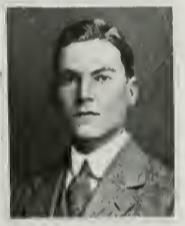
1/1st Bn. Honourable Artillery Company, Number 1 Company72 Wulverghem Lindenhoek Road Military Cemetery III. C. 9. Grave epitaph: He Being Dead Yet Speaketh Age 20
Alan Drysdale Paull73
Alan was the eldest son of Alan Paull and his wife Catherine. During his time at SPS between 1908 and 1911 Alan was a Corporal in the OTC. Upon leaving SPS, he joined his father’s business as a quantity surveyor. He joined the Honourable Artillery Company on 14 October 1912. Something of an athlete, Alan played rugby football for the HAC and represented them in boxing against Cambridge University in 1913. He went to France with the HAC (7th Brigade, 3rd Division) from 18 September 1914. Alan fell just to the south of Spanbroekmolen on the Wytschaete Messines Ridge.
By December 1914 the increasingly wet and cold weather had led to a stalemate, each side rotating their units in and out of the trenches as best they could. The 3rd Division held the line at the southern end of Messines Ridge, overlooked by the Germans who now possessed the higher ground having taken both Messines and Wytschaete. At 1.30 pm on 9 December the 1st HAC left their billets at Westoutre and marched to Kemmel via La Clytte; at 10.30 pm they took up position in ‘F’ trenches immediately south of Spanbroeckmolen.
72 The Honourable Artillery Company was a unique regiment in that it included both infantry and artillery units. Alan was in the former
73 De Ruvigny’s Roll of Honour
17. the ‘93’ and their stories 23
By all accounts the weather was awful, frost and snow at intervals, but chiefly heavy rain rendering the trenches more or less unserviceable. During the night of 9 10 December the unit diary describes how:
The men were chiefly employed in baling out mud and water from the trenches which in places was 3 or 4 feet deep. Most of the communication trenches had become impassable and some men who had got stuck in the mud had to be dug out, this taking some hours to do.
The following night, 10 11 December:
Endeavours were made to improve the trenches and to minimise if possible the discomforts of the men in them by putting in fascines, planks, barrels etc for the men to stand on. These however soon sank in the mud and were of little use. 74
The commander of 9th Brigade noted that:
The sanitary condition of the trenches is bad. It is reported that insufficiently interred corpses are to be found in some trenches and no latrines appear to exist in any of them … The trenches on the right of the line [i.e. those occupied by the HAC] appear to be flooded in wet weather. 75
The official regimental history of the HAC provides a particularly vivid description:
Our trenches had been made by the French, and were nothing but ditches full of liquid mud; there was no wire in front, and no material of any kind, nor were there any communication trenches. The only way the front line could be approached was over the open through a sea of mud, and across a bullet swept area. Bullets came through the parapets as though they had been butter. In some of the trenches the parapet was only breast high, and in order to get cover during the daytime the men had to sit in the mud on the floor of the trench, and very often a man would find himself sitting on the chest of a mutely protesting Frenchman who had been lying there for a month or six weeks.76
The German trenches were on considerably higher ground, and their position at Spanbroekmolen was one of the strongest centres of resistance of the German line on the entire Wytschaete Messines Ridge. Thus placed, and at an average distance of 100 yards
74
75
TNA WO 95 1413 1 4
TNA WO 95 1425 1 2 Notes by A P Wavell, Bde Major, 9th Bde dated 29th Nov 1914
76 Goold Walker, G (ed) The Honourable Artillery Company in the Great War 1914 1919 (London, 1930) pp 24 25
17. the ‘93’ and their stories 24
from the line occupied 1st battalion HAC, sniping was constant and deadly; and it counted Private Paull as one of its victims. The unit diary records that Alan was shot on 11 December and the following day notes that ‘Pte Paul [sic] was buried by a party under Sgt Major Atkins and that he [had been] hit while taking up rations.’77 Alan’s entry in De Rugvigny’s Roll of Honour states that he was buried ‘at Kemmel by a cottage known as “Paull’s Cottage”.78 In fact, Alan was initially buried at location SW 28. N.35.a.5.4, about 1 and ½ miles south west from where he fell and some distance from Kemmel.79 His body was removed from here to Lindenhoek Road Military Cemetery as part of the grave concentration process in 1919. (The maps show no evidence of there having been a cottage at the original site of his burial. 77 TNA WO 95 1415 1 78 De Ruvigny Roll of Honour 79 See CWGC B.R 57
17. the ‘93’ and their stories 25
Knight, Rifleman Henry Manning 9860 11 January 1915, Ploegsteert SPS 1909 1909
1/5th (City of London) Bn. (London Rifle Brigade) London Rifle Brigade Cemetery III.A.6 Age 21
Upon leaving SPS in 1909 Henry became an insurance clerk. He enlisted with the 1/5th London Regiment (London Rifle Brigade) on 6th August 1914.
At the time of his death, Henry’s battalion (11th Brigade, 4th Division) had been at Ploegsteert, at the very southern end of the Ypres Salient, since 23 November. On 7 January 1915 it had taken over the line south of Ploegsteert Wood, running from the River Warneve to a point about 300 yards south.
On 10 January conditions were described as ‘very wet’ by the battalion diarist.80 The stormy and wet weather meant that the northern section of trench was inundated with 3 feet of water. Indeed, as stated in the III Corps diary:
Almost the whole area occupied by the Corps is waterlogged and the efforts all brigades have been directed towards combatting the elements … The water prevents any excavations being made … The River Lys is flooded and is 1 and ½ yards above the normal at present.81
Although not recorded in the unit diary it seems likely that Henry was in No. 3 Company, that Company was in the front line at the time of his death. In all probability he was killed by a sniper, the 4th Division diarist stating that at 6.58 pm on 11 January a report was received from 11th Brigade describing the ‘situation normal but brisk sniping.’82 Henry’s body was extracted from the line and is buried in London Rifle Brigade Cemetery in Ploegsteert.
A diagram in 1/5th (City of London) Battalion (London Rifle Brigade) diary showing in detail the trenches in which Henry was serving.83
80
TNA WO 95 1498 2
81
TNA WO 95 669 1, 3rd Corps Summary of Operations 8 14 Jan 1915 82
TNA WO 95 1441 1 2 83
TNA WO 95 1498 2
17. the ‘93’ and their stories 26
A map showing the line held by 11th Brigade in front of Ploegsteert Wood.84
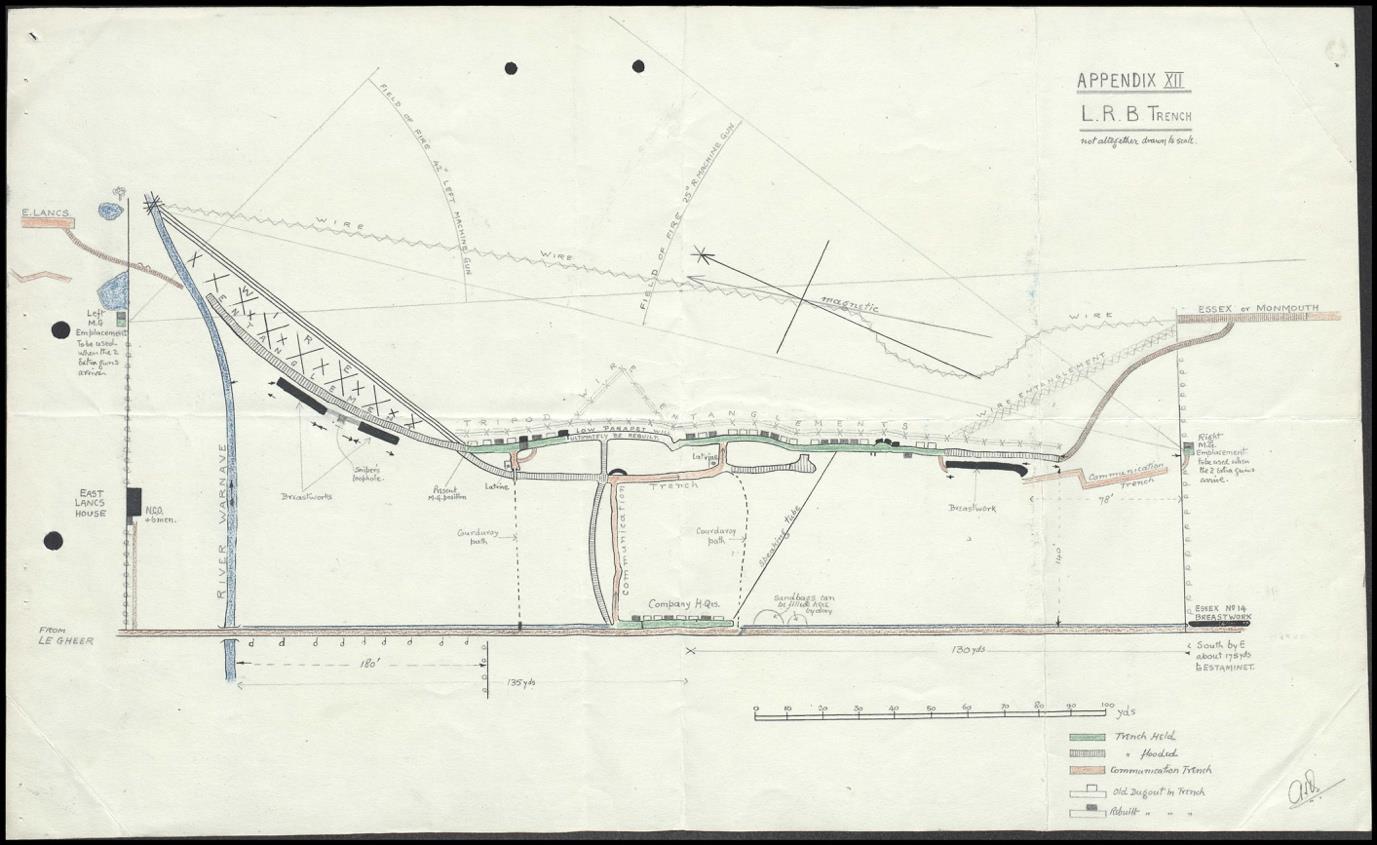
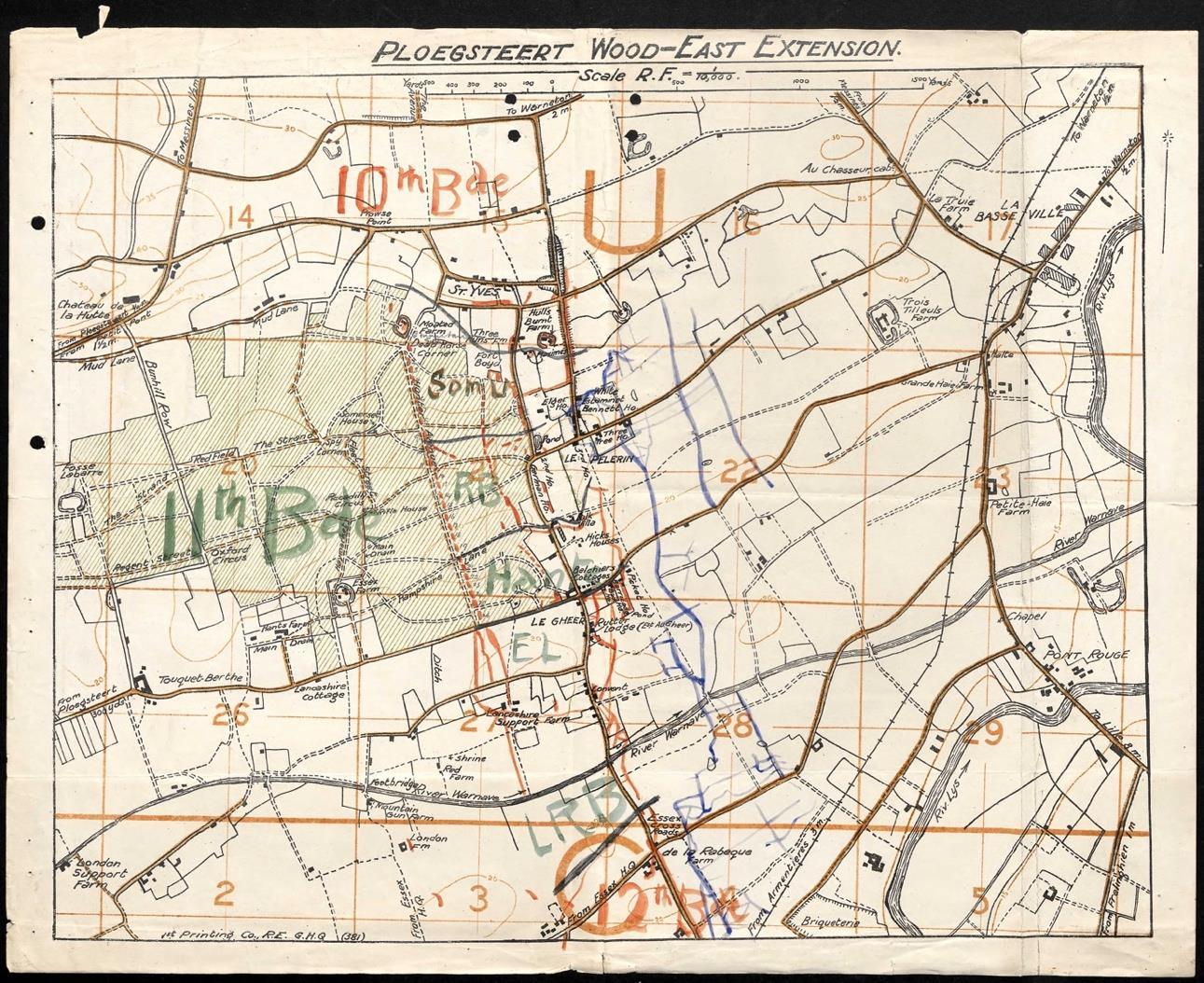
Richards, Captain Francis Graham 5 March 1915, Neuve Eglise
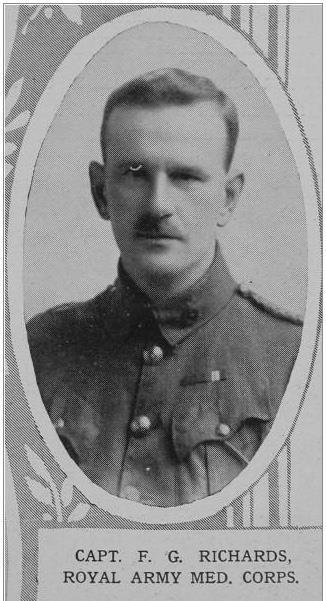
SPS 1885 - 1890
14th Field Ambulance, Royal Army Medical Corps Nieuwkerke (Neuve-Eglise) Churchyard Q.1
Grave epitaph: Killed In Action To Life Everlasting His Wife Age 40
Captain F. G. Richards. The Illustrated London News, 20 March 1915
After leaving SPS (1885 1890) Francis Graham Richards proceeded to St. Bartholomew's Hospital, entering as a student in 1893 and qualified as M.R.C.S (Eng), L.R.C.P (Lond) in 1899. He gained a commission within the Medical Services at the rank of Lieutenant, R.A.M.C. on 17 November 1899. He then served in South Africa from 1899 1902, taking part in the relief of Ladysmith, the action of Spion Kop, and other operations. On 17 November 1902 he was promoted to Captain and served in India until 1905. He went to Jamaica from 1908 to 1912 and was appointed Major in 1911. Francis was stationed at Queenstown in Ireland at the outbreak of the war. He joined the 14th Field Ambulance, a divisional unit in 5th Division.
Francis was killed at Neuve Eglise, most probably by a German shell, though the official medical records record him having suffered from ‘gunshot [to the] head and chest’.85 The
17. the ‘93’ and their stories 28
location of the 14th Field Ambulance at this time appears to have been the convent at Neuve Eglise.86 On 5 March it received a direct hit with significant loss of life, as recorded by the unit diary.
5 March At noon the ambulance was heavily shelled. Major F. G Richards was killed [along with ten others and two officers wounded; three patients were killed and eight wounded. Two Belgian soldiers were also wounded]87
The Official History of the 5th Division describes the shelling of 5 March and places it in its broader context:
The line taken over by 5th Division from December 1914 ran from La Petite Douve in a north westerly direction up the slope to the Wulverghem Messines road, and thence along the crest of the ridge east of Wulverghem to Hill 75 a frontage of about 3,500 yards. The German line was roughly parallel to ours, at a distance varying from 30 yards on the left to about 800 yards on the Messines road … Dressing stations were established at Neuve Eglise and Dranoutre, the three Field Ambulances [i.e. 13, 14 and 15] relieving one another in turn … Most of our casualties were caused by [sniper fire, the enemy having the advantage of height], though the shelling of Neuve Eglise contributed to the toll, the 14th Field Ambulance being particularly unfortunate in having a shell fall into their dressing station.88
86 TNA WO 95 1540. 31 Dec 1914 the Field Ambulance left for Neuve Eglise today and took over the Convent as a dressing station.
87 WO 95 1540 3
88 Hussey, A. H and Inman, D. S, The Fifth Division In the Great War, pp 50 51 and pp 54
17. the ‘93’ and their stories 29
Johnson, Captain Percy Joseph (Viner) Viner 12 March 1915, Spanbroekmolen
Wiltshire Regiment Special Reserve, 3rd Bn. attached 1st Bn. The Duke of Edinburgh’s (Wiltshire Regiment), A Company Ypres (Menin Gate) Memorial Panel 53 SPS 1889-1890 Age 39
Captain P. J. Viner Johnson89
Percy Joseph (Viner) Viner Johnson was the son of Joseph Viner Viner Johnson of Beech House, Market Lavington, Wiltshire and his wife Clara. After leaving St Paul’s in 1890 Percy served in the 1st Volunteer Battalion King’s Royal Rifle Corps from 1898 to 1902, when he went to South Africa and acted for some time as A.R.M at Harrismith and afterwards as Relief Magistrate at various places in the Orange Free State. At home on leave when war broke out, Percy was gazetted Captain, 3rd Wiltshires on 18 September 1914. He left for France on Christmas Eve, when he was attached to the 1st battalion Wiltshires (7th Brigade, 3rd Division) in which he commanded A Company.
The Wiltshire Times and Trowbridge Advertiser recorded that:
Prior to the war he held a lucrative government appointment in South Africa. … When the war broke out he surrendered his civil post in Africa and was one of the earliest applications for a commission in the Wiltshire Regiment. … In his earlier years, before he left England, he belonged to the 1st Volunteer Battalion, King’s Royal Rifle Corps, and the training he received with that body stood him in good stead. It was not long before he was given his second star

89 Image of Viner Johnson in The Sphere, 24 April 1915 https://www.britishnewspaperarchive.co.uk/viewer/bl/0001861/19150424/019/0023
17. the ‘93’ and their stories 30
with the Wilts Regiment, and went out with a draft to join the Regiment at the front. He was eventually promoted to Captain.90
Percy was killed in the trenches at Spanbroekmolen on 12 March.
In rather tortured language the II Corps unit diary recorded that during the week in which Percy was killed ‘the II Corps has been engaged … in demonstrating [activity] with a view to preventing the enemy weakening the force opposed to it’.91 On 12 March 1st Wiltshires left their billets at Locre at 2.45 am and marched via Kemmel to the section of the trenches known as ‘F’ in front of Spanbroekmolen. (See image below.) The battalion arrived in position at dawn about 5.30 am and occupied front lines of trenches on the reverse side of the hill, the Worcestershire regiment being in similar trenches on their right. The battalion HQ were in the trench known as F2, about 50 yards in front of the front trench in which the battalion was situated.92 These trenches were about 25 yards apart.
A map in II Corps HQ dairy for February and March 1915 shows in detail the location of these trenches. (Red shows the British trenches; blue, the German trenches.) From the accounts that follow it is clear that Captain Viner Johnson was killed in close proximity to F2.93
90 Wiltshire Time and Trowbridge Advertiser, 20 March 1915
91 TNA WO 95 631 5 Report on events, week 7th March 13 March 92 It is highly unusual to have the battalion HQ in line ahead of the battalion. 93 TNA WO 95 631 6
17. the ‘93’ and their stories 31

12 March During last night 3rd Worcesters and 1st Wilts moved up to the newly dug assembly trenches opposite Spanbroek Hill and which were situated a little behind our E and F Trenches and were supposed to be hidden from view from the Germans. Here the two regiments were to lie while the bombardment was taking place, and then at a given moment to get up and rush forward to the assault. As our fire trenches which have been occupied all the winter are now much too broad to jump across, and as it would have checked the impetus of the assault very much if the men had to get in and then climb out of our trenches, little wooden bridges were brought up during the night. These were to be put up just as the moment of the assault arrived by the battalions of the 85th Infantry Bde who were holding the trenches. Any wire entanglements also in front of our trenches were also removed during the night and everything done to enable the assaulting columns to get a clear rush from the assembly trenches to the German position which was about 200 yards in front of our trenches. The men of the 85th Infantry Bde were to stay in their position while the 3rd Worcesters and 1st Wilts went through them …. The artillery of this Division and also of the 5th Division were to prepare for the assault. First of all they were to carefully register all their guns onto their several objectives i.e. the 18 pdrs on to various portions of the wire entanglements in front of the German trenches, the 4.5” howitzers on to the trenches themselves, the 6” howitzers likewise and also on to Spanbroek Molen and the ruins of Spanbroek Cabinet which the Germans have put into a state of defences and made into a supporting point, and ‘Granny’ our 15” howitzer on to the redoubt which the Germans have built on the rear slopes of Spanbroek Hill (point 76) and which has been located and photographed by our aviators. [There was then to be a bombardment for half an hour.] In the assault the 1 Wilts were on the left and the [Worcester] regiment on the right.94
The 1st Wiltshire unit diary contains a detailed account of the attack, including references to A Company, of which Viner Johnson was Captain:
The morning [of 12 March] was dull and very misty so that the artillery bombardment which was to precede the assault on Spanbroek Molen had to be delayed. The whole morning remained misty and except for a certain amount of sniping and desultory gun fire was quiet. At 1 pm the mist began to clear and by 2.30 pm it was clear and the artillery bombardment began and continued with a slight pause till 4.10 pm. It consisted of field guns firing shrapnell [sic] to cut the hostile wire and large quantities of high explosive to break down the enemy’s parapets and blow in his trenches. In this it appeared to be fairly successful but it was afterwards observed that the enemy’s front line trenches were almost intact. At 4.10
94 TNA WO 95 1376 1 5, War Diary of Captain A. C. Johnston, C. O 3rd Signal Coy, 3rd Division
17. the ‘93’ and their stories 32
The War Diary of Captain A. C. Johnston, C. O 3rd Signal Coy, 3rd Division describes the preparations for the attack in which Viner Johnson was killed:pm the infantry assault was launched by 2 Coys of the 1st Wiltshire and 2 Coys of the Worcestershire Regiment [on the right] accompanied by a party of RE. The remaining two companies being detailed as working parties. The front Coy (A Coy) rushed forward crossing the trench known as F2 by means of flying bridges which had been placed in position early in the morning and passing through our barbed wire by means of gaps which had been made opposite the bridges; as soon as A Company was clear of the bridges B Company followed, then C and D (the working party [ies?]) remaining in the trenches. As soon as A Company had got across the bridges the enemy opened a very heavy rifle and machine gun fire on them, and only a few small isolated parties succeeded in getting up to the enemy’s wire, a distance of about 200 yards. B Company also came under a very heavy fire and were unable with the remainder of A Company to get more than 50 yards from F2, at the same time most of the Worcestershire regiment on our right appeared to be also unable to get on. B Company endeavoured to crawl forward but were unable to get very far and gradually starting about 5 pm began to fall back into F2, suffering considerably in doing so. Most of the survivors of A Company who were in advance of B Company got back under the cover of darkness. At about 7 pm the battalion withdrew. It was observed that the enemy was holding the position very strongly and did not seem unduly shaken by our artillery fire. The 2nd South Lancashire regiment were in support and Royal Irish Rifles in reserve at Kemmel, but neither played too an active part in the action. A Company was commanded by P. J. V. Viner Johnson and B by Capt R. H. Broome. Throughout the day the trench known as F2 was held by the East Surrey Regiment. The battalion returned to billets at Locre. 3 officers killed 3 officers wounded 29 OR killed; 12 missing; 45 wounded.95
A Report in II Corps unit diary describes the futility of the British artillery fire:
Judging by the rapidity and accuracy of the enemy’s fire, their morale could have been but little affected [by our bombardment], and had it not been for a fold in the ground which was taken advantage of, no Wilts would probably have returned. Our artillery seem to be making very good practice; one would have thought none could have held the [enemy] trenches, yet directly the [infantry] assault was launched the German trenches were manned and a rapid and accurate fire instantly opened.96
The 7th Brigade HQ diary makes clear the devastating effect of the German machine guns: 12 March at 4.10 pm the assault started, the 3rd Worcesters being on the right and the 1st Wilts on the left. Every man in the two leading companies sprang up and went forward but 95 TNA WO 95 1415 2 96 TNA WO 95 631 6, March 1915 Statement of OC F2 trench
17. the ‘93’ and their stories 33
they were immediately met by a very heavy fire and many were shot down whilst crossing the flying bridges. At 4.23 pm the O C 1st Wilts reported that his attack was held up. About a dozen officers and men reached the German wire where they were killed. The German front line was strongly occupied and a machine gun posted in a redoubt near Peckham on the north inflicted severe loss on the left of the attack. At 4.52 pm the O C Wilts reported that his assaulting Coys were held up near their own wire and that they were unable to advance. At 5 pm he again reported to the effect that his leading Coys were falling back and finally at 5.25 pm that the attack had entirely failed. ….. The casualties were heavy and confined to the 2 leading Companies of the Worcesters and Wilts. 50% of these 4 Coys were killed or wounded.97
Percy’s body lies undetected in the location described. He is commemorated on the Menin Gate. (He fell in the same trench system as fellow OP Private Alan Drysdale Paull, killed on 11 December 1914.)
17. the ‘93’ and their stories 34
James, Captain Ernest Samuel Pennant Kingsbury 17 March 1915, St Eloi SPS 1901-1906
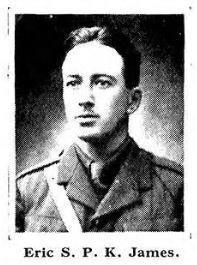
4th Bn. King’s Royal Rifle Corps Dickebusch New Military Cemetery B.41
Grave epitaph: May The Lord Of His Mercy Grant To Him Peace And Rest Amen Age 27
Captain E. S. P. K. James 98
Ernest was the only son of Edward Lewis James, F. C. S and his wife Sarah of 79 Larkhall Rise, Clapham, London. He was a scholar of St. Paul's and an exhibitioner of Corpus Christi College, Cambridge. He rowed in his college boat at Henley. After taking the classical tripos in 1909, he took a post as a master at Oundle School, and from 1913 was at Merchant Taylors' School. He got his commission in the 0.T.C. in 1910 and was promoted captain in 4th battalion King’s Royal Rifle Corps in 1914 (80th Brigade, 27th Division). Ernest was killed in the trenches immediately to the east of St Eloi, a small settlement south of Ypres. His Company was involved in desperate resistance, the enemy having taken The Mound a pile of waste material produced by a brickworks on the south side of the village. Any such earthly protrusion offered its possessor the advantage of height and, as such, was a topographical feature that provoked contest.
Diagram from 2nd (Wessex) Field Company showing The Mound (the circle at the top of the diagram).99 98 © IWM https://livesofthefirstworldwar.iwm.org.uk/lifestory/2087521 99
17. the ‘93’ and their stories 35
When it became clear that the counter attack of the 82nd Brigade had failed, the 4th K.R.R.C was moved forward from Voormezeele and ordered to attack The Mound at 3 am on 15 March from the direction St Eloi.
The 80th Bde HQ diary records that about 5 pm on 14 March:
A heavy artillery bombardment from the direction of St Eloi was heard. The [80th] Bde was ordered to march to Dickebusch. The 4th K.R.R.C marched [from its billets in Zevecoten] at 7 pm …. On arrival at Dickebusch information was received that trenches 15 16 17 18 and 19 and The Mound, which had been held by the 82nd Bde, had been captured by the enemy. The 4th K.R.R.C was sent forward to Voormezeele to support the 82nd Bde in a counter attack 100
The 4th K.R.R.C successfully retook the ‘RB’ trench and rushed two barricades in St Eloi village, but owing to the difficulty of deploying on the road were unable to reach the Mound.101
A sketch in 27th Division diary, showing the barricades and ‘RB’ trench. (Note: image inverted to so as to maintain the same orientation as the previous diagram).102
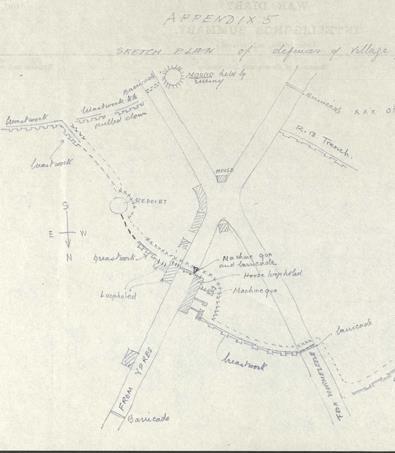
100
TNA WO 95 2260 2
101 Details taken from 8th Bde HQ TNA WO 95 2260 2 102 TNA WO 95 2254
17. the ‘93’ and their stories 36
The situation thus remained critical. In an effort to resist the enemy, energy was expended on completing the breastworks to the east of St Eloi, and it was while working on these, in the vicinity of redoubt R3 (the circle shown on the middle left in the first of the above diagrams), that Ernest was killed on 17 March, presumably by a sniper’s bullet the 27 Division HQ diary recording that on that day there was ‘a good deal of rifle fire, particularly during night.’103 Indeed, obituary accounts reference that Ernest was shot in the head at midnight on 17 18 March at St Eloi while superintending his men. His commanding officer wrote: ‘I cannot tell you what a great loss he is. I was with him last Sunday night, the 14th, when we had a very nasty time; he was very cool and did admirably.’ Lieutenant Colonel Brownlow wrote: ‘He did excellent work for me at Sheerness; I can only tell you your son will be very much missed in the regiment. He was most popular; looked up to by everybody, and was a very smart and efficient soldier.’104
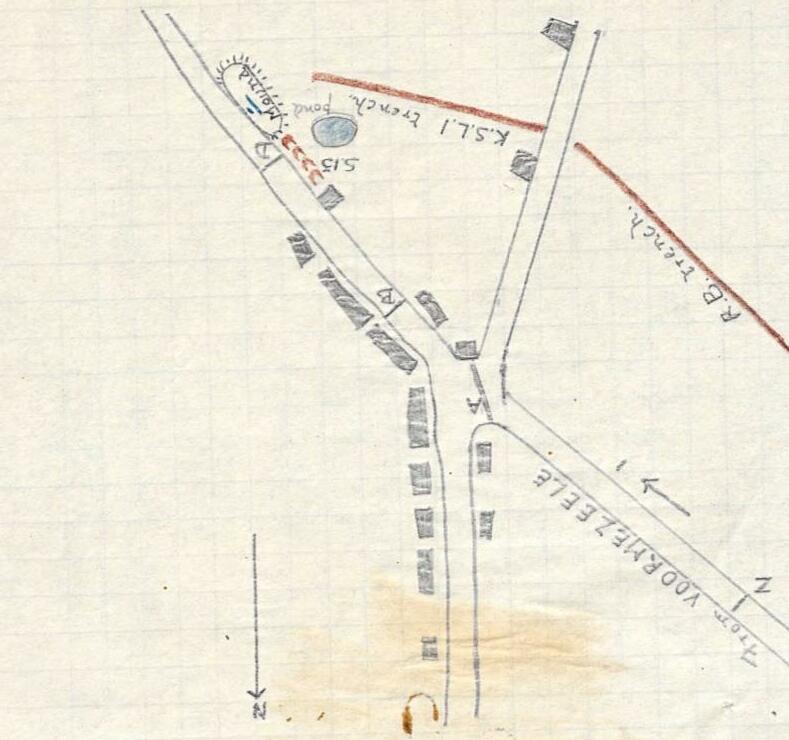
Ernest’s body was retrieved and buried the next day at Dickebush in what is now known as Dickebusch New Military Cemetery. 103 TNA WO 95 2254 104 The Pauline 33 217 June 1915 pp 73 4
17. the ‘93’ and their stories
Child, Lt Gerald Julius 18 April 1915, Hill 60 SPS 1906 1910
2nd Bn. King’s Own Yorkshire Light Infantry Ypres (Menin Gate) Memorial Panel 47 Age 23
Gerald Julius Child105
Gerald was the youngest of three brothers who were all boarders at Colet House, under Messrs. Armitage and Loane.106 According to The Pauline, he was a ‘plucky footballer’, and played for the XV in 1908 9 10.107 The Pauline of December 1910 is brimful of references to Gerald, frequently describing his prowess as a cross kicker. He appears to have concluded his time at SPS as Captain of the 1st XV. One particular experience he endured as Captain of the ‘Houses’ Vs ‘D’ perhaps went some little way to preparing him for the mud he was to encounter in Flanders fields.

105 St Paul’s School archive
106
One brother, John Albert Child, attended SPS 1902 1907. He became a 2nd Lieutenant in the Royal Engineers and survived the war. It is not clear as to the pathway Gerald’s other brother trod.
107
The Pauline, 33 217 June 1915 p 73
17. the ‘93’ and their stories 38
This match was played under deplorable conditions. It rained hard throughout, and the ground was a sea of mud. Child opened the scoring for ‘Houses’, running through when ‘D’ Club were under the impression that the referee had blown his whistle.108
Gerald proceeded from SPS to Gonville and Caius, Cambridge where he read History and continued his career as a footballer. He went directly into the army after graduating in 1914 and joined the King’s Own Light Infantry Regiment. He arrived in France on 4 December 1914 and, already of the rank of 2nd Lieutenant, on 29 December 1914 joined 2nd battalion K.O.Y.L.I (13th Brigade, 5th Division), at which time that unit was in the line at Neuve Eglise.
Following the period at Neuve Eglise, 2nd battalion K.O.Y.L.I moved to billets in Reninghelst on 11 April, where it remained for five days. On 17 April day it moved to Ypres as part of the forthcoming action against Hill 60, a strategic point in the line held by the Germans since 11 November 1914.
Located two miles south east of Ypres, Hill 60 so called because it is 60 metres above sea level is not really a hill in the conventional sense. It had been formed from the spoil extracted from the cutting formed during the building of the Ypres Comines railway line. In fact, the earth thus deposited formed not only Hill 60, but two other mounds also. Second in height to Hill 60, directly south of it on the opposite side of the cutting, was a long irregular mound which, owing to its shape, became known as ‘the Caterpillar’. The smallest mound, some 300 yards to the west of its siblings, sitting south of the railway cutting was ‘the Dump’, so called because of its conical shape. As described by the K.O.Y.L.I Regimental historian:
The importance of [Hill 60] lay in the fact that in its elevation of some 50 feet above the surrounding country it formed a most important post for the direction of artillery batteries. From its highest point the Germans could overlook our position and its approaches for some miles back to Ypres: occupied by us, movement for our troops in the area between the front line and Ypres would become comparatively safe in daylight. … It was very uncomfortable for the companies of the brigade who were immediately opposed to it to have this hillock dominating them, bristling with machine guns as it was and harbouring snipers who were always on the lookout for a snap shot.109
For several weeks prior to the attack on Hill 60, 171 Tunnelling Company Royal Engineers had been driving into the mound tunnels designed to accommodate six mines. At 7 pm on 17 April these mines were exploded in three series at ten seconds intervals, followed by an 108 The Pauline, 28 185 December 1910 p 222 109 Bond, R C King’s Own Yorkshire Light Infantry (1929) Kindle pp 1142 43
17. the ‘93’ and their stories 39
artillery bombardment lasting fifteen minutes. The diarist of one of the attacking battalions noted the impact of the blowing of the mines:
At 7 pm everyone was ready when the mines were exploded. There was not much noise [but] the whole ground [a]round shook as if there was an earthquake and a few minutes afterwards bricks, Germans and all kinds of debris were hurtling through the air in all directions.110
A rough sketch in the unit diary showing the position of the German trenches on Hill 60 and the expected locations of the craters after the blowing of the mines.111

‘Everyone was ready’, except of course the Germans, who, following the blowing of the mines, were in such disarray that they were quickly forced off the Hill. However, at dawn on 18 April the enemy launched a very strong counter attack and re took the summit. This was the context in which the British launched a fresh assault, during which Gerald fell.
A Report in 13th Brigade diary (unsigned but almost certainly authored by Brigadier General Robert Wanlesss O’Gowan, C.O 13th Brigade), described the involvement of 2nd battalion K.O.Y.L.I:
The German counter attack continued stubbornly till about 6.30 am [on 18 April]. By this time the Germans had regained considerable portions of the top of the hill and the Duke of Wellingtons were holding on to the edges of the craters. I then came to the conclusion that
110
TNA WO 95 1553 1 5 111 TNA WO 95 1553 1 5. Dated 16 April 1915
17. the ‘93’ and their stories 40
the only way to secure the position was by making a fresh assault. This was fixed for 5 pm, the earliest moment at which it seemed practicable to carry out an attack as until then sufficient fresh troops would not have arrived, nor tools, the original tools having been left in the portion of position which we had been driven out of. This was subsequently changed to 6 pm as the tools would not arrive in time to be issued to troops and the troops to get into position by 5.45 pm. I decided that the best method to attack was by marching up [from reserve] as many Duke of Wellingtons to the sheltered position just under Hill 60 as there was room for, and for 2 Companies of K.O.Y.L.I to be in trenches 39 and 40. The whole to advance precisely at 6 pm, at which hour the whole artillery would cooperate.112
A map of the trenches on the western side of Hill 60. The railway cutting is shown on the right. It seems that Gerald proceeded from Larchwood, via CT 38 into the front line trenches 39 and 40. The summit of the Hill is shown at the top (eastern) of the image. Only three of the six craters are shown.113
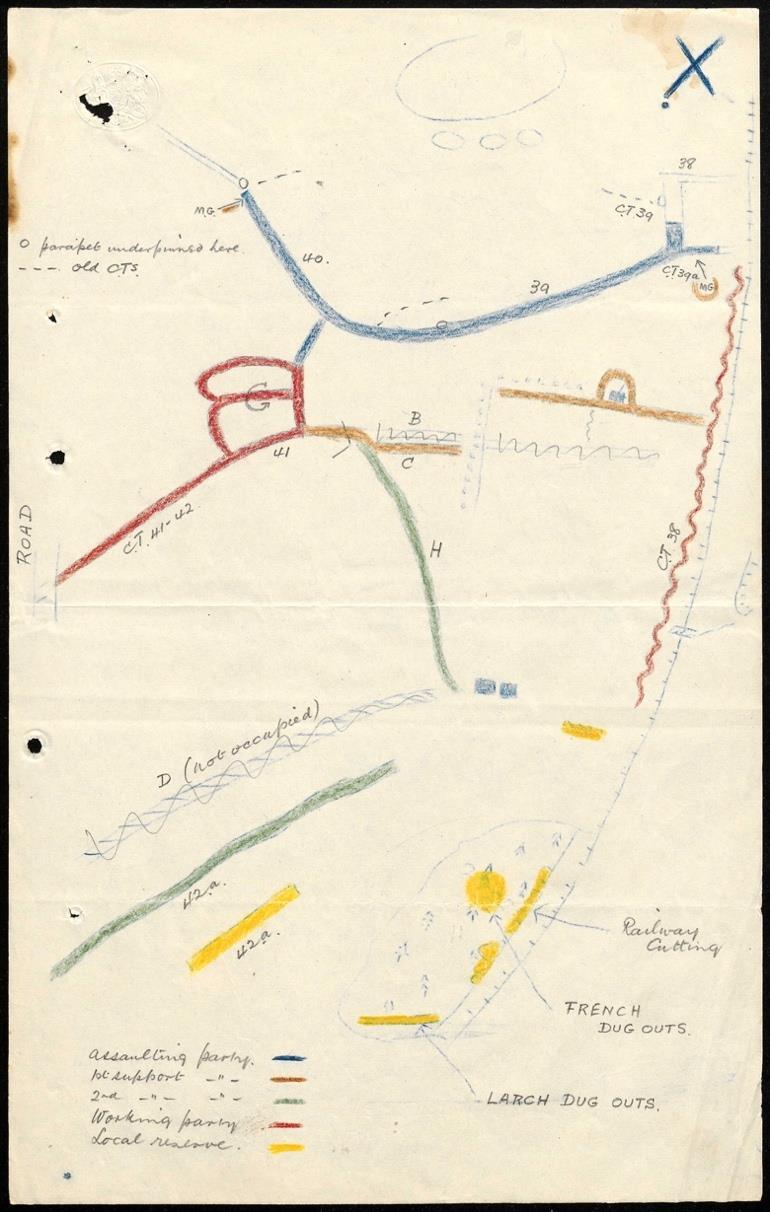
112 TNA WO 95 1548 4 1 Report on Operations near Zwarteleen on Hill 60 on 17, 18th and 19 April. Unsigned.
113 TNA WO 95 1548 1 7
17. the ‘93’ and their stories 41
The 2nd battalion K.O.Y.L.I moved forward from Ypres at 7 am on 18 April and took up an initial position in the railway embankment (shown in yellow on the map below.) At 12.30 pm the unit moved into Larchwood and, along with the Duke of Wellingtons (West Riding Regiment), readied themselves for the assault. The action that unfolded from 6 pm is narrated in a remarkably detailed account in 2nd battalion K.O.Y.L.I diary. In contradiction to the Report already quoted, the diary indicates that all Companies were involved in the attack.
The West Ridings were in position in dead ground at the bottom of the Hill and also held [trenches] 39 and 40 with the K.O.Y.L.I in the wood just in [the] rear. At 5 pm the West Ridings filtered their men into some communicating trenches leading to the base of the Hill where they massed. The K.O.Y.L.I at the same time moved forward from the Larchwood up the railway cutting and communicating trench [i.e. CT 38] into 39 and 40 trenches, about 80 yards in [the] rear of the bottom of Hill 60. At 6 pm, at which hour the assault was timed to take place, the West Ridings advanced up the slopes of the Hill and at the same moment B Coy with Capt Alt and C Coy under Capt Kent jumped forward from 39 and 40 trenches [and] dashed across the open space to the foot of the Hill and up the slopes, intermingling with the West Ridings in the assault. A Coy under Capt Yates followed close behind carrying spades[?] and hand grenades. D Coy under Capt Palmer, which was waiting behind in the communicating trench to 40 trench moved up to garrison trenches 39 and 40. The whole advance was covered by our our artillery who heavily bombarded the Hill and in rear of it to prevent the Germans reinforcing the Hill crest. B and C Coys, immediately they left the trenches, were met with a hail of artillery machine gun and rifle fire causing very heavy casualties. These Coys however reached the base of the Hill and dashing up the slopes carried the West Riding, who were by that time being hard pressed, forward and after a moments wavering which looked as if the attack would fail, the line crossed the German parapet and the crest of the Hill was retaken. The Germans, once we got to close quarters fled in a panic down their communicating trenches leaving equipment, rifles and ammunition behind them. They could not however get away as their trenches became blocked with their own killed and wounded and most of them were either captured or killed by our rifle fire, bayonets and hand grenades. After the capture of [the] Hill, A Coy who had come up with spades, transferred the parapet of the trench [i.e. reversed the trench so that it could be used against the enemy.] The Hill, though taken had now to be held, and throughout the night we were subjected to the concentrated fire of 44 German batteries of field and heavy artillery. (A German observing officer we captured on the Hill afterwards gave us this information.) The Germans also counter attacked continuously using hand grenades and bombs and furious combats took place in the craters made by the explosions of the mines which soon became a shambles and filled with killed and wounded. The crater on the left we were unable to hold so we entrenched ourselves a few yards behind it, our trench passing in front of the remaining craters. The German high explosive shells gave off
17. the ‘93’ and their stories 42
blinding, suffocating fumes which caused great distress amongst the men but they hung on. Rifles got jammed from the heat of firing and grenades and ammunition were difficult to get up owing to the stacks of German rifles and ammunition left behind which our men used instead of their own it would have been difficult to maintain our position on the Hill which however we did until relieved at dawn on 19 April by the Bedford Regt. After relief the battalion retired into the woods in rear of 35 trench. During 19 April the enemy again gained a footing on the left crest of the Hill but a counter attack by the 9th Q V Rifles (the last remaining battalion of the 13th Infantry Brigade) dislodged them again and the Hill was finally secured. The casualties incurred in the assault were heavy especially amongst officers and the proportion of officers killed and wounded was abnormal.
Casualties:
Officers
Killed Capts Alt, Leather Lieuts Childs [sic], Williams, Hodges, Oldham, Chubb
Died of wounds Capt Yates Wounded Capt Kent; Lts Wells, Dixon, Upton, Way, Webb. Rank and File killed 24; wounded 190; missing 10.114
Sketch found in the 2nd K.O.Y.L.I diary showing Hill 60. The six craters formed by the explosions on 17 April are shown by the small circles. The railway cutting is clearly visible on the right.115
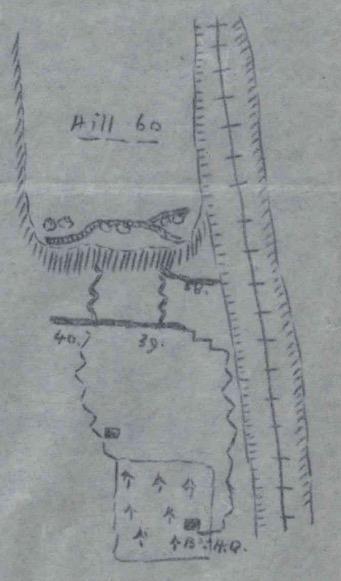
114
TNA WO 95 1558 1 2 115 TNA WO 95 1558 1 2
17. the ‘93’ and their stories 43
Unfortunately it is not known in which Company Gerald served and thus it is not possible to identify exactly where he fell, though it seems certain that it was in the vicinity of trenches 39 40 and the craters, around the western edge of the summit of Hill 60. The relatively confined area in which this action took place made it difficult to extract those who fell. 2nd Lieutenant Doe of RWK, writing with reference to the scene of battle at dawn on 18 April recorded that:
I never saw such as sight [as in] that left hand crater. Hardly a portion of ground could be seen for dead and seriously wounded men who could not be removed owing to the communication trench being blocked with wounded.116
Gerald was thus one of many whose bodies were not recovered. He is commemorated on the Ypres (Menin Gate) Memorial.
116 TNA WO 95 1553 1 5 Short Account by 2nd Lt Doe, A Company, Queen’s Own Royal West Kent
17. the ‘93’ and their stories 44
Southgate, Private Lewis Murray 24880 22 April 1915, nr. Vancouver Corner SPS 1906 1907
13th Bn. Canadian Royal Highlanders, Quebec Regiment Ypres (Menin Gate) Memorial Panel 24-26-28-30 Age 22
Lewis was was born on 21 April 1893, the son of Lewis Murray Southgate and Frances Elizabeth Southgate of 124 Holland Road, West Kensington, London. He has left no record in The Pauline, likely a consequence of having attended SPS for no more than two terms 1906 to 1907. At some point after leaving SPS Lewis emigrated to Canada where he was employed as a clerk. He attested in Valcartier on 23 September 1914 and was enlisted in the 13th battalion Canadian Royal Highlanders. Lewis’ unit sailed to England on 3 October 1914. On 22 April 1915 he was reported missing, ‘presumed for official purposes to have died on or since this date.’117
The 13th battalion (3rd Brigade, 1st Division) arrived in England on 15 October 1914. After a period of training at Westdown South on Salisbury Plain the battalion moved to France and on 19 February ‘arrived at Hazebrouck …. [where], stiff and sore after our long and cramped journey, [it] fell in and marched eight miles through pouring rain to Fletre.’118 On 23 February it ‘paraded at 8 am and marched to Armentieres, 17 miles, very hard on the feet, roads paved with cobble stone nearly all the way.’119 After a period in the trenches, the unit moved to Cassel on 7 April and a week later was in Steenvoord. On 16 April the unit was at St Jean, north west of Ypres, ‘ordered to hold themselves in readiness to move at a minutes notice’.120 Although the unit diary reported that it was ‘quiet’ in the vicinity of St Jean, rather ominously it also recorded on 17 April that there was ‘every evidence of severe fighting going on all around’.121 At midnight on 21 22 April, the 13th battalion replaced the 14th battalion on the extreme left of the Canadian line in front of the Stroombeek, a short
117 Service File. B9163 S039
118
RG9 III D 3, Volume number: 4921, Microfilm reel number: T 10714, T 10714, File number: 382, File part: 1
119
RG9 III D 3, Volume number: 4921, Microfilm reel number: T 10714, T 10714, File number: 382, File part: 1
120 RG9 III D 3, Volume number: 4921, Microfilm reel number: T 10714, T 10714, File number: 382, File part: 1
121 RG9 III D 3, Volume number: 4921, Microfilm reel number: T 10714, T 10714, File number: 382, File part: 1
17. the ‘93’ and their stories 45
distance south west of Poelcappelle, where the trenches were described as ‘in poor shape [with] many unburied dead between the lines.’122
In line in this position Lewis was exposed to one of the great crises of the entire war: the German gas attack of 22 April. The diary records that it was ‘quiet all day until about 5 pm, when [the] enemy commenced a terrific bombardment and also sent over a great cloud of gas on the frontage held by the Turcos [French] on our immediate left. The Turcos had to retire and this left our left flank open to the enemy. …’ On 23 April, the battalion was ‘shelled and “gassed” all day’. Numerous accounts provide a sense of the melee and confusion the fog of war that ensued at this moment and during which Lewis was killed, and his body lost, likely somewhere in the vicinity of Vancouver Corner.
About 5 pm [on 22 April], the French 45th Division, holding the line on our immediate left, was heavily attacked, and a cloud of green vapour, several hundred yards in length, was seen by the left section of the 3rd Canadian Infantry Bde to extend between the French and German lines. (It so happened that at this time I was with my C. R. A [Commander Royal Artillery] inspecting the position of the 12th Canadian Battery N.E of St Julien. We suddenly heard heavy rifle fire on the right of the French line. Directly afterwards, two clouds of yellowish green smoke appeared; as far as I could judge, one about square U.24 and the other about U.14 or 15. These clouds spread rapidly, laterally, until they appeared to merge into each other. It was evident from the nearing sound of their rifle fire, that the Germans were advancing rapidly behind these clouds. …. By the time we reached our horses [which we had left at Wieltje] our Allies on the Sector from the Polecappelle road to the canal were retreating before the gas, and before we reached No. 4 bridge Sq.C.19.c many of them were sought of a line between it and Wieltje. … The French troops on our left continued to retire, and by 8.45 pm appeared to have no formed body east of the canal. At 6.45 pm, G.O.C 3rd Canadian Inf Bde reported that his newly formed improvised left (then facing westward) had been driven back towards St Julien. …. Still holding his original front … at 7.10 pm, G.O.C 3rd Canadian Inf Bde, reported that the troops were being forced back towards St
122 An observer in 10th battalion (2nd Brigade, in line immediately to the right of 3rd Brigade) described ‘The front line was merely a name, being little more than a shallow ditch without, parapet. There were no dugouts or other shelters, and parts of the ditch was literally paved with German dead of an early vintage. Of barbed wire entanglements there was not even a vestige, and the only protective device consisted of smooth trip wire, thinly strung, some distance in front of the place where the parapet should have been. Some of the men in making their way into the trench had come through this wire without being aware of its existence’. (Holland, J. A. The Story of the Tenth Canadian Battalion 1914 1917, London: Charles & Son for Canadian War Records Office, 1918.)
17. the ‘93’ and their stories 46
Julien; that no other troops were available, that ammunition was badly needed, and that he had asked 2nd Canadian Inf Bde for support.123
Another account states that:
[Upon receiving an order at 5.20 pm on 22 April] to proceed to the trenches the [10th] battalion paraded at the junction of the Ypres St. Jean Road, but was at once swallowed up in the terrible confusion of men and transport which prevailed. Masses of wildly fleeing French Colonial troops surged on the roads and over the fields making towards Ypres and Vlamertinghe, many of them exhausted and gasping for breath, their faces twisted and distorted with pain. Asphyxiating gas of great intensity had been projected into their trenches, and thousands had been overcome before they abandoned the line. To add to the terror and confusion, the German guns had the range of the Cross Roads outside Ypres, and their thickly falling shells were snatching numerous victims from among the horror stricken refugees. … Darkness had fallen. A waning moon was faintly illumining the murderous melee of the battlefield. The stabbing flashes of bursting German shells marked the Canadian position. German guns were trying to blast a pathway through for their infantry. Machine gun and rifle flashes flickered like a million fireflys in the gloom, and the swishing bullets flew literally in sheets over the broken ground and battered trenches where the 3rd Brigade was hanging on indomitably.124
Lewis is commemorated on the Ypres (Menin Gate) Memorial.
Map showing the line held by 1st Canadian Division at 4 pm on 22 April 1915. The section of line held by 13th battalion is on the extreme left, at the junction with the French 45th Division (visible in the northern section of the map, to the south west of Poelcappelle.)125
123 1st Canadian Division. Report on Operations from 5 pm 22 April to 10 am 4 May by Lieut General E. A H. Alderson, 13 May 1915. RG9 III D 3. Volume/box number: 4823. File number: 36 37
124 Holland, J. A. The Story of the Tenth Canadian Battalion 1914 1917, London: Charles & Son for Canadian War Records Office, 1918 125 RG9 III D 3. Volume/box number: 4823. File number: 36 37
17. the ‘93’ and their stories 47
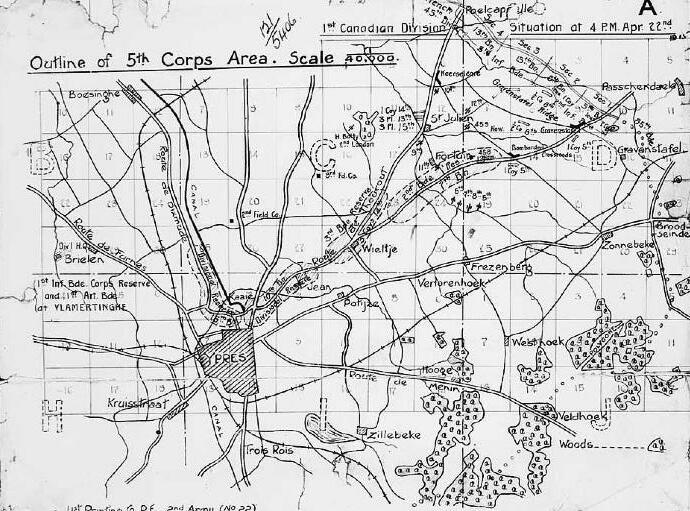
Merritt, Captain Cecil Mack 23 April 1915, Kitchener’s Wood SPS 1890 1895
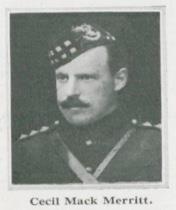
16th battalion Canadian Infantry (Manitoba Regiment) Ypres (Menin Gate) Memorial Age 38
Cecil Mack Merritt126
Cecil was the son of Lieutenant Colonel Ingersoll Merritt and his wife Mary Beatrice. Although the family home was 6 Sumner Place, South Kensington, London, Cecil was born in St Catharine’s, Ontario, Canada on 6 January 1877. During his time at St Paul’s (1890 1895) he played a leading part in school life, The Pauline revealing his contribution to events such as Union Debates and a variety of sports. Cecil was an accomplished athlete. Amongst other of his successes in the various sports events of 6 April 1895, he came second in the 100 yards (losing by four yards to a new school record of 10.5 seconds and won the hurdles races, apparently ‘flying the hurdles beautifully’.127 An accomplished lacrosse player, his most significant achievements appear to have been on the rugby field: he was Captain of the 1st XV in 1893 and 1894 and went on to represent Canada, winning an international cap.
An anonymous contribution to Cecil’s obituary recorded that:
Not many Paulines have won so much admiration from so many of their schoolfellows as C. M. Merritt. A circle of close friends knew his high qualities from within; the majority knew them from the distinction they brought to the School [rugby] football. His last year was the
126
127
De Ruvigny Roll of Honour
The Pauline, 13 74 April 1895 pp 66 67
17. the ‘93’ and their stories 49
high water mark of our game; his teams included four blues, and some others who were as good: and it did not lose a match through the season. He was one of the two finest half backs of our history, and afterwards became a Canadian international; and his captaincy was greater than his [rugby] football. The writer well remembers a presentation by his team in token of their appreciation; also high praise in an apposition speech from our late High Master, one who recognized power, and perhaps never so singled out another athlete for his approval. He combined a charm of fellowship with an authority so complete that he never had call to exercise it “a veray parfit gentil knighte.”128
Following his time at St Paul’s, Cecil proceeded to Canada in 1895 and joined the 10th battalion Royal Grenadier (Militia) Regiment in 1896. He participated in the Klondike Gold Rush in 1898, the journey to Dawson City along one of the Edmonton trails taking him two years. After leaving Dawson City it is not known to what degree he was successful as a gold digger Cecil returned to London and worked for a short time as a clerk on the Stock Exchange. In 1904 he relocated to Vancover where in the first instance he worked for Boyd, Burns and Company (a firm of metal merchants and ship chandlers) and latterly as a real estate broker. When the 72nd Regiment Seaforth Highlanders of Canada was formed in November 1910, Cecil was appointed one of its Captains. On the outbreak of war he volunteered on 23 September 1914 and was given command of a Company in the 16th battalion Canadian Scottish (3rd Canadian Brigade, 1st Canadian Division). Cecil travelled to France with this unit in February 1915 and participated in the Battle of Neuve Chapelle.
The 16th battalion diary records its activity in the days before it took up position in the trenches in front of St Julien:
15 April. Regiment left [from Steenvoorde] at 9 am in 25 motor buses. Arrived at Vlamertinge at 11.45 am. Men had lunch and marched off at 2.30 pm. Met at Ypres by officers. Skirted the town on the west and north side and marched to Weiltje. There till 8.30 pm. Left by Companies under guides [and passed] through St Julien to the trenches. No. 1 Coy right post; no. 2 Coy, centre; no. 3 Coy. Left; no. 4 Coy in support about 800 yards in rear. 3 platoons of A Coy in reserve at St Julien.129
After three days of reasonably uneventful existence in the trenches, the 16th battalion was relieved and proceeded to billets on the west side of the Yser Canal, north of Ypres. The unit’s time out of the line was then disturbed by the German gas attack of 22 April and the
128
The Pauline, 33 217 June 1915 pp 75 76
129 RG9 III D 3. Volume/box number: 4925. File number: 396. Container: T 10720. File Part 1=1914/12/01 1915/08/31; 2=1915/09/01 1916/08/31
17. the ‘93’ and their stories 50
subsequent collapse of the line north east of Ypres held by the French. The flight of the French meant that the Second Army’s left flank lay open for 8,000 yards a successful German attack through this gap would not only threaten Ypres but would take in the rear the three divisions still holding the Salient. The GOC 16th battalion described events thus:
22 April. Afternoon heavy shelling of Ypres. Windows smashed. Everyone belonging to Regiment ordered to go along Canal. Panic among inhabitants! Many casualties. Orders to hold ourselves in readiness to move at once to arms. …. French [Flemish?] refugees pouring in and French soldiers principally Souaves in flight. Looked as if French had been routed. … Moved off [c. 8 pm]. Learned that French had been driven out of their trenches joining our line to the left and had fled. Canadians still holding the line. We were to check the German advance. On arrival at Brigade HQ near St Julien [I was] informed that my task was to support closely the 10th battalion which had already arrived and attack the enemy at 10.30 pm so as to clear the wood [i.e. Kitchener’s Wood] north west of St Julien. Attack delayed until 11.30. Joined up in the moonlight about 100 yards from the enemy and close to St Julien road. Formation adopted: 10th bn in front on two Company width … 16th battalion formed up in 4 lines single rank, 30 yards behind 10th battalion and lines 30 yards apart. No 4 Coy on right and No 2 Coy on left of front line; no 1 and 3 in rear of 4 and 2 respectively. Advance made about midnight when about 300 yards from enemy he opened rapid fire with rifles and machine guns. We then doubled and when flares went up lay down. When we made the charge the enemy fled. Many were bayoneted [sic] while others surrendered.130
The initial success did not last long. During the night 22 23 April fierce fighting took place in the Wood, the Germans aided by having a machine gun emplacement in the south west corner. By the morning of 23 April the 16th battalion had retreated to the captured enemy trenches on the south side of the Wood having sustained significant losses. The unit diarist recorded:
23 April. Many wounded and dead about. Very arduous time at dressing station.131
The Circumstances of Death Register states that:
130 RG9 III D 3. Volume/box number: 4925. File number: 396. Container: T 10720. File Part 1=1914/12/01 1915/08/31; 2=1915/09/01 1916/08/31
NB: Kitchener’s Wood was not so named after Lord Kitchener, but from the French Bois des Cuisiniers. The French, who had occupied this sector before the Canadians, may have found the wood a good hideout for unit cooks.
131 RG9 III D 3. Volume/box number: 4925. File number: 396. Container: T 10720. File Part 1=1914/12/01 1915/08/31; 2=1915/09/01 1916/08/31
17. the ‘93’ and their stories 51
[Cecil] was killed while taking part in the attack at St Julien. No further information as to the actual circumstances under which he met his death is available. Buried in a trench near St Julien.132
Accounts of Cecil’s death printed in De Ruvigny’s Roll of Honour add some detail:
On 22 April, 1915, during the Second Battle of Ypres [Cecil] was leading his Company in the charge made by the Canadian Scottish near St. Julien, to check the first rush of the Germans after their gas attack, when he was wounded in the leg. He refused to leave his men, and with them occupied the German trenches. Next morning he was killed while encouraging his men during a counter attack. He was mentioned In F.M. Sir John (now Lord) French’s Despatch of 31 May, 1915, for gallant and distinguished service in the field. His commanding officer, Col. R. E. Edwards Leckey, wrote: “Cecil Merritt was one of the finest officers I ever knew. . . . He was wounded in the charge, but not severely, and still continued to lead his men on. He remained in the trenches we had captured, and when a counter attack was threatened he got up to shoot over the parapet with his revolver. It was then he received his fatal wound. No one could have been braver and no one could have led his men better than he did. His name has been submitted for the Military Cross”. Brother officers speak of his “personal bravery and spirit of dash and tenacity,” and of the admiration which his men had for him. A Private wrote: “He was wounded twice but would not expose his men to be carried back to the dressing station, and after some hours in the captured trenches heard there was a counter charge from the Germans, and it was then he received the fatal shot in his head.”133
The following account is in the official history of the 16th battalion: Captain Cecil M. Merritt, commanding Number 3 Company, a keen soldier, ever anxious where the well being of his men was concerned, had with regard to his own safety an unconcern bordering on fatalism. Living close to his brother officers and his men, known by them in an affectionate way as “the skipper”, he was unrelenting in personal attention to detail and all matters of duty. … He was killed in action on the night of 22nd 23rd April 1917. After he had been desperately wounded in the charge, Merritt was brought into the captured trench. Two of his men immediately volunteered to carry him over the open country to the rear, but he refused to allow them to take the risk of so doing. When, some little time before dawn, it was thought the enemy was preparing to attack, he raised himself up, with a dying effort, to control the situation, and, receiving a further wound in the head, expired a short time afterwards.134
132 Circumstances of Death Register, 46246, 31829_B016772 133 De Ruvigny Roll of Honour 134 Urquhart, H M, 16th Battalion, C.E.F in the Great War p 84
17. the ‘93’ and their stories 52
From the above it seems certain that Cecil was killed in the fighting in Kitchener’s Wood and that his body lies undiscovered in the German trench that had been established on the south side of that Wood.
17. the ‘93’ and their stories
Scott, Captain Templer Henry 26 April 1915, Turco Farm SPS 1897 1900
87th Punjabis, attd. 47th Sikhs Bedford House Cemetery Enclosure No. 4 III. K Grave epitaph: Faithful Unto Death Age 31
Captain T. H. Scott135
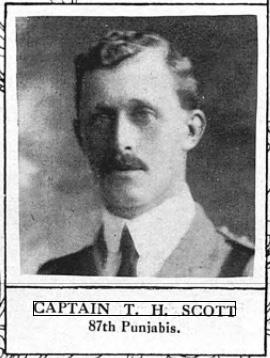
Templer was the son of B. C. Scott and Ada E Scott of 74, Madeley Road, Ealing. London. He entered the R.M.C Sandhurst direct from SPS in 1901. Templer gained his first appointment in the South Staffordshire Regiment in January 1902. He joined 87th Punjabis in 1904, commissioned Lieutenant in April 1904 and Captain in January 1911. The Pauline asserts that ‘at school he never shirked responsibility, and his energy was of great service to B Club. He was a particularly keen member of the School Corps. He was a life member of the Old Pauline Club.’136
Templer went to France from India in November 1914 and was attached to the 2/8th Gurkhas. He was severely wounded at Festubert in December 1914. He returned to the front in April 1915, attached to the 47th Sikhs battalion from 14 April.
On 24 April 47th Sikhs battalion (8th (Jullunder) Brigade, 3rd Indian (Lahore) Division), located at that time not far from Neuve Chapelle, received orders to move to Ypres in preparation for a counter attack to be made on the German line north east of Ypres on 26
135
The Graphic, 5 June 1915
136 The Pauline 33 217 June 1915 p 75
17. the ‘93’ and their stories 54
April.137 The situation on this front was now critical, the Germans having used gas to devastating effect for the first time on 22 April. Indeed, the northern segment of the salient had collapsed to such an extent that the Germans were henceforth two miles closer to the centre of Ypres and were thus more capable of directing accurate shell fire not only upon Ypres but also upon the crucial allied supply lines that ran into the town from the west.
Map showing the collapse of the line 22 28 April in the northern half of the Salient following the German use of gas.138
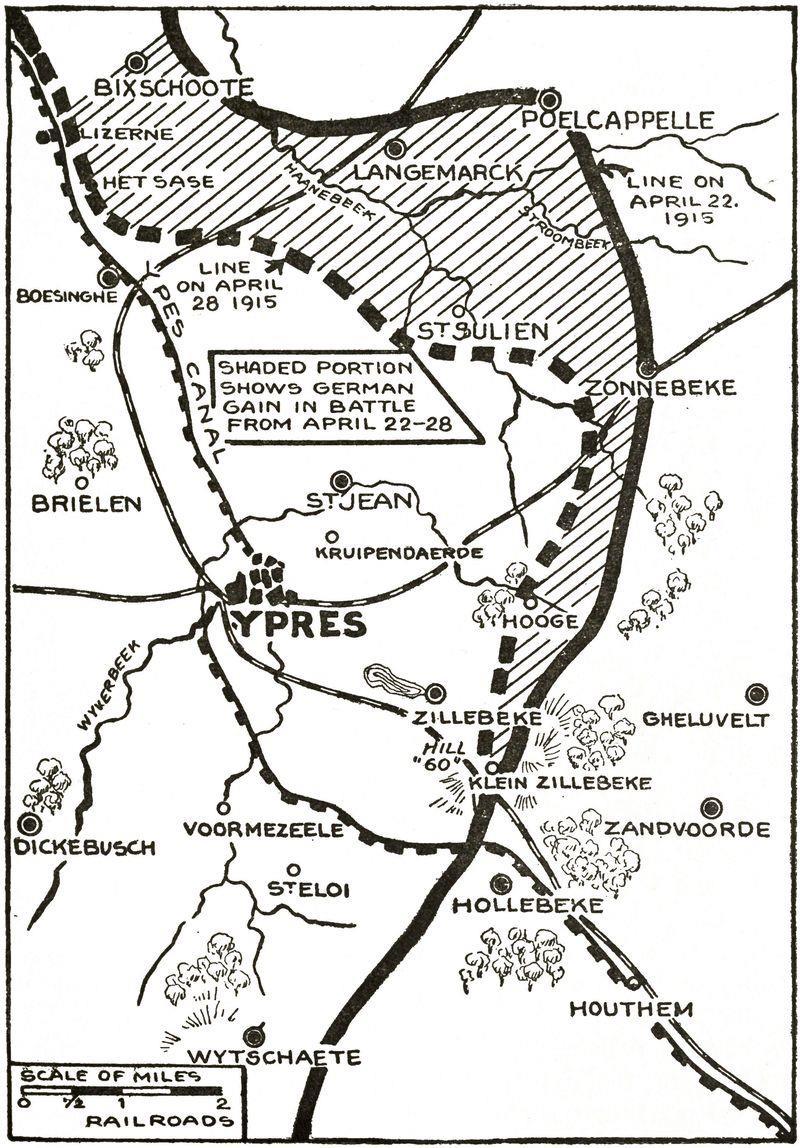
The official History of the Indian Corps makes clear that Scott’s journey to Ypres from Neuve Chapelle was a wearying ordeal:
137 The exact position of the German line was not known at the time of the attack on 26 April, but a reconnaissance made by the Sirhind Bde, relieving the Jullundur brigade on 27 April, described it as running from ‘about Point 29 (C.15.A) to the Ypres Langemarck road, then it ran along the west edge of that road to the road junction in C.15.d.2.5, and then in the direction of the Farm in C.17.a via the moated Farm in C.16.a.[b?] Strong points were located at: house at bend in road in C.15.b.2.5; farm at road junction in C.15.b; farm in C.15.a; farm in C.16.b. See TNA WO 95 3928 Sirhind Bde HQ diary, April 1915
138 https://www.gutenberg.org/files/29265/29265 h/images/img010.jpg
17. the ‘93’ and their stories 55
After a very trying march, the Division arrived at its halting place, Boeschepe, during the evening and night. The Transport had an especially harassing time, becoming involved in the hilly country round the Mont des Cats, and only arriving at dawn at Boeschepe, whence it had again to push on after a very short rest. The head of the Division arrived at the hutments near Ouderdom, about four miles south west of Ypres, at 10 a.m. on the 25th [April], the men footsore and tired after a plodding march of about thirty miles over the unyielding surface of cobble paved roads, slippery with the rain which fell during the march. It was evident to all that the Division was about to take part in a great battle, for the booming of guns was continuous, and heavy shells could be seen bursting in and around Ypres.139
Leaving their billets at Ouderdom at 7.30 am on 26 April, and enduring some shelling as they skirted south and east of Ypres, 47th Sikhs shortly after midday went into trenches two hundred yards south of the St Jean Wieltje road. The day was clear and bright with the wind blowing from the north east.
A particularly clear map in 2nd battalion Duke of Cornwall’s Light Infantry diary. This unit had been deployed on 23 April in attempts to resist the German assault. 47th Sikhs took over this area on 26 April.140
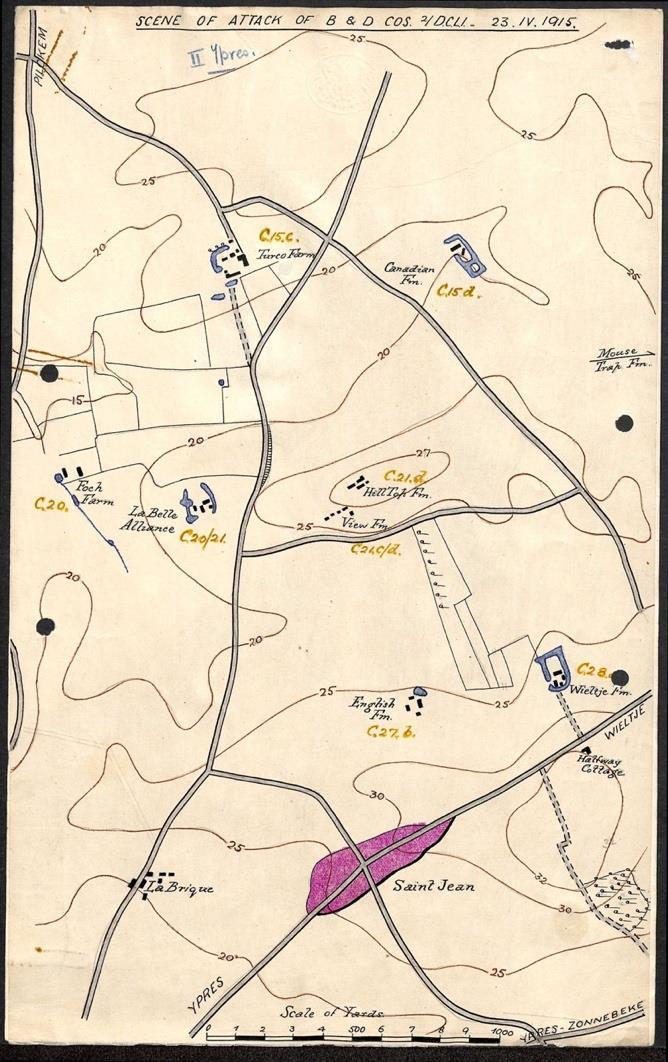
139 Merewether, J W B and Smith, F Indian Corps in France pp 280 281 140 TNA WO 95 2266
17. the ‘93’ and their stories 56
Map from 2nd battalion Duke of Cornwall’s Light Infantry. The evidence suggests that the route to the front taken by Scott was not dissimilar to that of B Coy in 2nd D.C.L.I, shown on this map.141
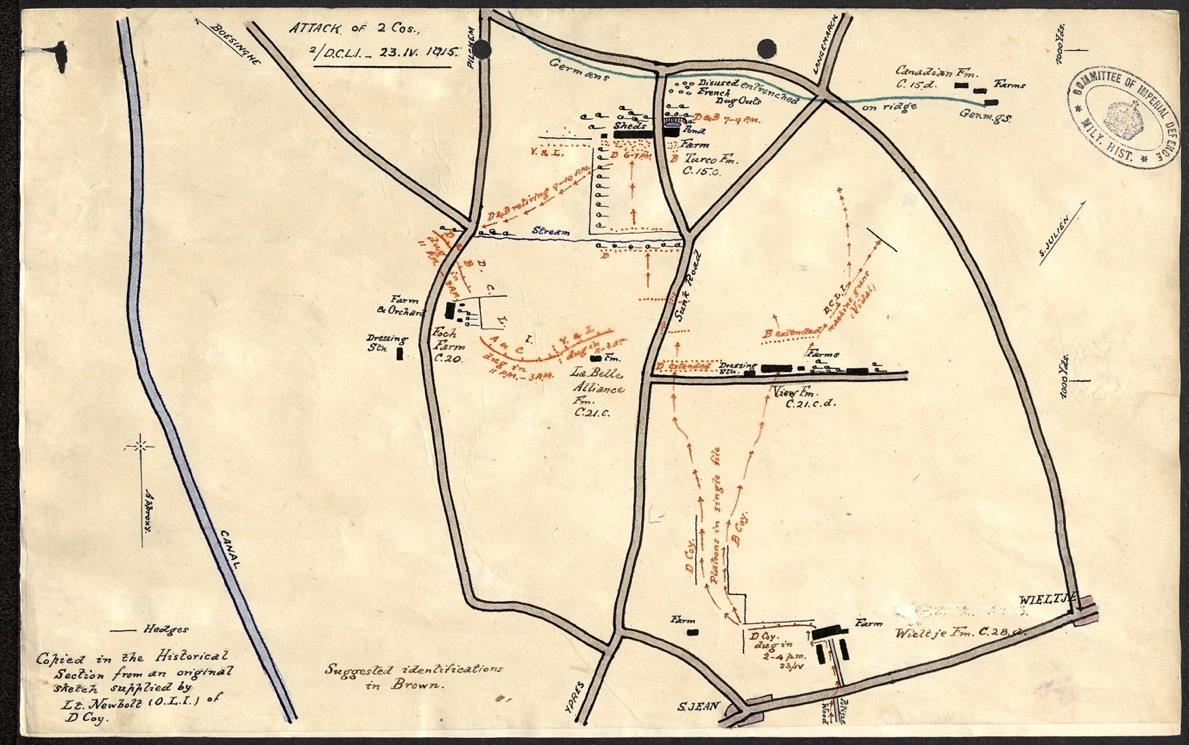
The 47 Sikhs’ unit diary provides some detail of the attack that now occurred: A bombardment of the enemy’s trenches was to take place from 1.20 pm to 2 pm, infantry in the meantime advancing as close as possible to the enemy’s trenches after crossing our own. 2 pm to 2.50 pm rapid artillery fire, after which, the assault. The new line to be established as far beyond the German line as possible. Direction due north. Front of the [Jullundur] Bde, the 2 farms in C.27.b [i.e. English Farm] and [C].28.a [i.e. Wieltje Farm both are shown on the map above but incorrectly located] inclusive two officers per unit out go out and reconnoitre to the front no information was available as to the distance to the German position which was along the crest of the ridge 29 in C.15 [i.e. just north of No Man’s Cot, close to Turco Farm, shown on the map above]. The attack had commenced before reconnoitering officers had time to report on the ground. There was hardly any artillery support at all. The Bde came under shell and rifle fire immediately it crossed the St Jean road, 2,500 yards from the enemy’s position. Partly owing to the directing regiment bearing too much to the left, and also to the attractive cover afforded by the large farm in C.14.c [i.e. Fusilier Farm], the two Brigades [i.e. Ferozepore, on the left, and Jullunder] became very
17. the ‘93’ and their stories 57
mixed. Beyond this point, parties of different regiments worked their way up to the ditches North and East of the farm [i.e. Turco Farm], where the attack came to a stand still.142
All accounts agree that the counter offensive failed spectacularly and that the loss of life was very high.143 In part this was because the Germans again used gas. The impact of this was greater on the units to the left of 47th Sikhs (i.e. the Ferozepore Brigade and French units), though it also impacted 47th Sikhs, inducing watery eyes that made it impossible for the infantry to fire rifles. The effect of the gas is described by Merewether and Smith, authors of the Official History of the Indian Corps:
At about 2.20 p.m. the ominous signs of gas were seen proceeding from the German trenches, and in a few minutes dense volumes of yellowish vapour were borne by the wind across the front of the line from right to left. The effect of the gas in such volume and at such a short distance was more than even the oft tried resisting power of the men of whom the Indian Corps was composed could support. The troops were quite unprovided with any means of warding off the effect of the fumes. The most they could do was to cover their noses and mouths with wet handkerchiefs or pagris, and, in default of such a poor resource, to keep their faces pressed against their scanty parapet. It was of little avail, for in a few minutes the ground was strewn with the bodies of men writhing in unspeakable torture, while the enemy seized the opportunity to pour in a redoubled fire.144
Lack of success was also a result of an absence of effective support by the artillery and because ‘the front line carried little yellow flags to show its progress to its own and equally
142
143
TNA WO 95 3927
TNA WO 95 3913 Report dated 2 May 1915 by Brig General E P Strickland, commanding Jullundur Bde on Jullunder Bde 26 April 1 May The casualties had been very heavy. The artillery had very little effect in stopping machine gun and rifle fire … By 4.15 the casualties in the front line had been very severe, being between 60 and 70% of the front line. During night 26 27 the Jullundur Bde was relieved: 47 Sikhs now consisted of 1 British Officer and 43 men. Casualties for 47 Sikhs was: 10 British Officers; 8 Indian Officers; 239 OR and 100 missing. It is worthy of note that Edmonds offers some rare criticism of the character of the deployment of the Lahore Division. Possibly, in theory, the best tactical use that could have been made of the Division would have been to have sent it to give direct support to the French, or, better still, to the Belgians, so as to smash and capture by a flank attack the strip of bridgehead held by the XXIII Reserve Corps on the west side of the canal. Edmonds, Official History, 1915 Vol 1 pp 253 4 144 Merewether, J W B and Smith, F Indian Corps in France, p 304
17. the ‘93’ and their stories 58
to the enemy’s artillery’.145 In addition, failure was met with because of the nature of the ground over which the attack took place, as described by the G.O.C the Jullundur Brigade, Brigadier General Strickland:
The enemy’s line was about 1,700 yards from the position of deployment. The ground was perfectly open and devoid of cover. For the first 500 or 600 yards the ground rose slightly, then there was a gentle decline for another 600 yards then again the ground gently rose up to the line of the German front trench. From the top of the first crest [i.e. Hill Top Ridge] … the enemy’s front line of trench could be seen. Owing to the orders for the attack being received so late there was not sufficient time for the Bde to be completely formed up before the advance began. The general direction of the attack was due North. The Bde moved off slightly NNW, thus crowding in on the right of the Ferozepore Bde which caused the Lahore Div to slightly overlap the Ypres Langemarck road which was the dividing line between the French and Lahore Div.146
The open nature of the ground exposed the men to pummelling enemy fire, as described in a report in the 57th Rifles’ battalion diary, Ferozepore brigade:
After crossing the ridge [i.e. Hill Top Ridge] just north of the road in C.21.c d we came under a perfect hail of fire machine gun rifle, shrapnel and high explosive filled with asphyxiating gas. From here onwards we began to drop at a great rate and we began to lose formation owing chiefly to the men bunching together behind each scrap of cover after every forward rush, and partly to the closing in of the Bde [i.e. Jullundur] on our right.147
Unusually for an officer killed in action, the 47th Sikhs diary does not mention the death of Templer, though his fate is described thus by Merewether and Smith:
In common with the rest of the Brigade, the loss of direction led to chaotic confusion in the ranks [of 47th Sikhs]. Casualties began to occur as soon as the regiment advanced, and on crossing the ridge [i.e Hill Top Ridge], Major Talbot and Captains Cook and Scott were killed, as was also Lieutenant Allardice … In addition to these, by the time the regiment began its upward course towards the German trenches, all the other British officers, except Lieutenant Drysdale, had been put out of action, while the men were falling in swathes.148
145 Edmonds J. E, Official History 1915 Vol 1 p 259. Yellow was the colour of the Lahore Division standard
146
TNA WO 95 3913 Report dated 2 May 1915 by Brig General E P Strickland, commanding Jullundur Bde on Jullunder Bde 26 April 1 May
147
TNA WO 95 3923 5 Report in 57th Rifles Brigade, April diary, App III
148 Merewether, J W B and Smith, F Indian Corps in France p 297. Interestingly, the deaths of neither Talbot or Cook are mentioned in the unit diary.
17. the ‘93’ and their stories 59
The Bond of Sacrifice states that:
When leading his Company in the open [Templer] was killed instantaneously on 26 April 1915 near St Jean, Ypres.149
The relevant unit diaries describe 47th Sikhs as being the left unit in the Jullunder Brigade, holding a front of only 125 yards. This places 47 Sikhs deployed for attack in the immediate vicinity of English Farm. Considering the character of the ground as described by Strickland, and the nature of the German response to the attack, it seems upon first examination highly likely that Templer was killed some 500 600 yards from the place of deployment i.e. close to Hill Top Farm. However, in February 1921 Templer’s body was discovered at 28.C.15.c.5.5, directly to the east of Turco Farm.150 It was then re buried in Bedford House Cemetery Enclosure No. 4, a concentration cemetery on the south side of Ypres.
View of the line of advance of 47 Sikhs looking north west, taken from the terminal mound of the motorway.151
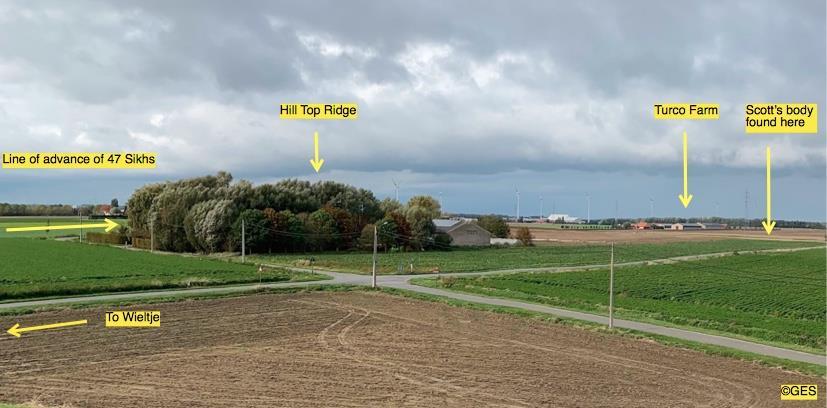
The discovery of Templer’s body at C.15.c.5.5, a distance of perhaps only 500 yards short of the enemy’s trenches, suggests an inaccuracy in the accounts presented in the Bond of Sacrifice and Merewether and Smith. A clue as to what occurred is offered in a Report authored by Brigadier General R. G. Egerton, C.O Ferozepore Bde:
149
Bond of Sacrifice
150 See Exhumation Record, CWGC https://www.cwgc.org/find war dead/casualty/484786/scott, templer henry/#&gid=null&pid=1
151
Author’s photo.
17. the ‘93’ and their stories 60
It appears to me that the troops of the Jullunder Bde on my right bore down towards the left during the advance, and the result was that my line was compressed…. Eventually, portions (of the leading companies) of all these of my battalions, together with portions of the units of the Jullundur Bde, were intermingled on a line roughly corresponding to the farm road running NW to SE in C.15.c d’.152
The reference to the ‘farm road’ is very close to the where Templer’s body was found. The available evidence thus proves that Templer was much closer to the enemy line at the moment he was killed than was previously accepted. As such, those who pay their respects at his grave in Bedford House Cemetery should be aware that this OP’s final resting place betrays almost no clue as to the action in which he fought and fell.
152 TNA WO 95 3922 1 7 App 12. Report by Brig General R. G. Egerton, dated 1 May 1915.
17. the ‘93’ and their stories 61
Nash, Major Fountain Okey Colborne 27 April 1915, St Julien SPS 1891 - 1896
1/5th Bn. Northumberland Fusiliers, D Company Birr Cross Roads Cemetery III.B.20
Grave epitaph: He Giveth My Beloved Sleep Age 37
Fountain attended SPS between 1891 1896, though The Pauline is silent about any contribution he made as a schoolboy. He was the son of an artist, Joseph Nash and his wife Ella H. Nash of 35, Wheeley’s Road, Edgbaston, Birmingham; and the grandson of Joseph Nash, author of the Mansions of England in the Olden Time (1839 49). Fountain’s first remunerative position was as the assistant surveyor to the Borough Engineer at Newcastle on Tyne; in November 1913 he was appointed Chief Planning Assistant in the City Surveyor’s Office to Birmingham City Council. Meanwhile, he obtained his commission in 1906 and transferred in 1908 to the 1/5th battalion Northumberland Fusiliers, to which he was called up and crossed to France in April 1915. The 1/5th Bn Northumberland Fusiliers was a unit in the 149th (Northumbrian Brigade), 50th Northumbrian Division. At 7.30 pm on 25 April 149th Brigade was placed under orders of 1st Canadian Division as reserve.
It was customary for any unit upon first crossing to France to spend a period of time in further training and general acclimatisation. However, such was the intensity of the crisis following the German gas attack of 22 April that the 1/5th Bn. Northumberland Fusiliers were rushed straight into the front line. Indeed, Fountain had been in line only a matter of days before he was killed, the battalion having departed from Blyth in north east England as recently as 20 April. By 23 April it had reached Poperinghe, from where it marched to a field S. E. of the town and bivouacked for the night. Instructed to move up to Potijze, the following night the battalion endured heavy shelling, rain and cold as it passed through a battered and dilapidated Ypres. Having snatched some rest by ‘laying in a field just beyond Ypres for two hours under heavy shell fire’, at 2 am in the morning of 25 April orders were received to move to Wieltje. However, coming under heavy shell fire meant that the unit had to dig itself in ‘about 400 yards south of Wieljte’.153
At about 2.05 pm on 26 April three battalions (1/4th, 1/6th and 1/7th) of the Northumberland Fusiliers, 149th (Northumberland) Brigade advanced in a north easterly direction astride the Wieljte St Julien road, their objective to retake the latter place from the Germans, it having fallen to the enemy on 24 April. Undertaken in broad daylight, vulnerable to enfilading fire and with the attack of the Lahore Division on their left floundering, it was an impossible task. (Indeed, in the action of 26 April 149th Brigade lost a staggering 42 officers
17. the ‘93’ and their stories 62
and 1,912 other ranks, over two thirds of its strength.)154 Meanwhile, upon reports that the Germans had penetrated the line in the vicinity of Fortuin, the 1/5th battalion had been ordered to reconnoitre and effect a counter attack if required.155
The absence of the 1/5th battalion from the assault upon St Julien is noted in a Report in the 149th Brigade diary:
Report that enemy were breaking through first line trenches in D.13.c d [i.e. in the area immediately to the south east of Fortuin]….. [O.C] 1/5th bn North Fusiliers was directed at 10.45 am to send forward an officers’ patrol to verify the report and to proceed with his battalion to Fortuin with a view to counter attacking if the enemy were discovered breaking though. By 12 noon the officer commanding the battalion was satisfied that no attempt was being made by the enemy to break through at the place indicated and as his battalion was being heavily shelled he proceeded to dig in and remained in the position he had reached and consequently took no part in the subsequent operations.156
The 1/5th battalion diary entry for 26 April states:
About 10 am [it was] reported that the enemy were breaking though our line [in the vicinity of Fortuin]. [1/5th] Battalion ordered out to verify this and if correct to make a counter attack. Arrived at position [in the vicinity D.13.c d i.e. in the area immediately to the south east of Fortuin]. 11.40 am and ascertained that report was not correct. Sent in message to Bde Major to that effect. Received answer to retire or if inadvisable to entrench. Sent message: “battalion was being heavily shelled. Would entrench. Returned at dusk to bivouvac [near Wieljte].” The [other units of the] Bde had made an attack on St Julien during the afternoon, successful up to a point but not being supported had to retire. Very heavy losses. (Brigadier Gen Riddell killed, Captain Nash (D Coy) and Lieut Bainbridge attached R. E Signal boy were also killed in this action).157
This evidence thus indicates that Fountain fell somewhere in the vicinity of Fortuin on 26 April. However, details on Fountain’s Medal Rolls Index Card state that he was killed in action on 27 April. According to the unit diary, the 1/5th battalion was certainly exposed to the most grave danger throughout that day ‘the bn. remaining in dugouts [in the area
154
TNA WO 95 2826 1. These figures are found in Report on the action at St Julien on Monday 26 April 1915 App V
155 Just south east of St Julien was Fortuin a curious place which no one has ever defined as a village, locality or geographical feature; it existed on maps and that was all. Wyrall E, Fiftieth Division 1914 1919 p 20
156
TNA WO 95 2826. The Report had been composed by 10th Bde, 26th Division.
157 TNA WO 95 2828 2
17. the ‘93’ and their stories 63
south of Wieljte] all day under a heavy shell fire’ though it is significant that the diary does not mention Fountain as having been a casualty on that day.158 This disagreement in the sources about the date upon which Fountain met his death may perhaps be reconciled by the suggestion that he died of wounds during the night 26 27 April and that the author of the diary, writing his entry on the latter date, by which time Fountain had succumbed, chose to narrate Fountain’s death as having occurred on 26 April.
The location of Fountain’s initial burial place near Hell Fire Corner, it being some considerable distance from where he fell, also demands some explanation. First, it needs to be recognised that during the night of 29 30 April all four battalions of the Northumberland Fusiliers moved to reserve trenches in close proximity to Hell Fire Corner, thus making sense of the location of internment. Second, during this move it seems that Fountain’s body had been removed from where it originally fell. Whenever possible units would collect from the battlefield those who had fallen. Indeed, an entry in the diary of 1/5 Northumberland Fusiliers for 28 April asserts that ‘A party of men were detailed to collect bodies of men of the Brigade killed in action on 26th’, one of whom we might reasonably conjecture was Nash. It was not unusual for those killed to be buried some distance from where they fell. For instance, during the action of 26 April Brigadier General Riddell, G.O.C 149th Brigade, was killed: ‘At 3.30 pm Brig Gen Riddell left his H.Q in C. 23.a and proceeded towards the Farm Vanheule in C.17.d for the purpose of getting into closer touch with his bn commanders and was shot through the head 150 yards south of the farm at 3.45 pm.’159 Riddell’s body now lies in Tyne Cot cemetery, but it was originally interned half way along Cambridge Road (map 28 I.5.c.5.8), some distance from where he was fatally shot.
Exhumation and re internment data indicates that Fountain was initially buried in exactly the same location as a fellow officer, Lt. T. Lindsey Bainbridge, attached to 1/5th battalion Northumberland and whose death was recorded by the unit diarist as having occurred in the same action in which Nash fell.160 An extract from a letter read at the Newcastle Wesleyan Synod on 13 May 1915 relating to Lieut Bainbridge is published in De Ruvigny Roll of Honour and gives a sense of the atmosphere at the time of the original burial of Bainbridge, and thus, most likely, Fountain too:
Last night, after dark, we buried Lieut. Bainbridge and others. It was the most impressive ceremony I have ever attended. It was a beautiful moonlight night as we carried the bodies down the lines wrapped in blankets and lying on stretchers. As we passed each entrenched battalion, the men stood to ‘Attention’. At about a quarter of a mile from the trenches, on a
158
159
TNA WO 95 2828 2
TNA WO 95 2826 1. Report on the action at St Julien on Monday 26 April 1915 App V 160 The exact location for the burial of both men is 28.I.10.d.5.4 An image of Bainbridge can be viewed here https://www.iwm.org.uk/collections/item/object/205289930
17. the ‘93’ and their stories 64
piece of ground where about six other officers lie buried, we laid them to rest. The guns were roaring on every side, and huge fire balls the Germans threw into the air illuminated the sky.161
The photograph below shows the bodies of men killed in fighting near Guillemont Farm awaiting burial on 3 October 1918. It indicates how, when possible, the fallen were collected together for burial in one place. The scene prior to the original burial of Nash will not have been significantly dissimilar, although on a much smaller scale. (Note the stacked stretchers.)162
17. the ‘93’ and their stories 65
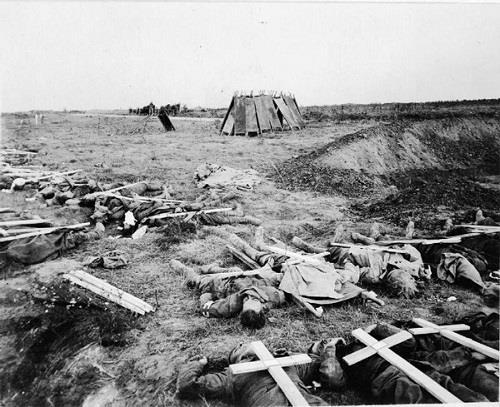 Fountain’s body was exhumed in June 1919 during the process of concentrating the graves of the fallen and removed the short distance to Birr Cross Roads Cemetery.
Fountain’s body was exhumed in June 1919 during the process of concentrating the graves of the fallen and removed the short distance to Birr Cross Roads Cemetery.
Butcher, 2nd Lt Charles Geoffrey 2 May 1915, Hill 60 SPS 1907 - 1909
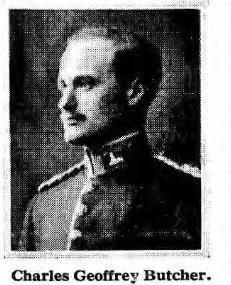
1st Bn. Dorsetshire Regiment Reninghelst Churchyard Age 23 C. G. Butcher163
Charles was the son of G. W. J and Mary Butcher of York Cottage, Totland Bay, Isle of Wight. Having attended SPS 1907 1909 he was gazetted to the Special Reserve in August 1912. On 10 June 1914 he year joined the 2nd battalion Dorsetshire Regiment and on the outbreak of war was transferred to the 1st battalion of that regiment. Charles was wounded in the leg by a bullet at La Bassee on the 22nd of October, his life being saved by Sergeant H. Cox of the Dorsetshire Regiment, who carried him from the trenches into cover under very heavy fire. Geoffrey was mentioned in Sir John French’s dispatches, and promoted to Lieutenant on 15 November 1914. He returned to his battalion on 25 March 1915, by which time the 1st Dorsets had been on the western front for around eight months as a unit in 15th Infantry Brigade, 5th Division. Towards the end of April the battalion moved to Zillebeke, south east of Ypres, and at 8.30 pm on 29 April, having endured enemy shelling en route, it took up position in dugouts in Larch Wood in close support to 1st battalion Devonshire Regiment who were holding Hill 60 and trenches on either flank of it. On 1 May A and C Companies took over the front line trenches on the crest of the Hill with the Devons now in support at Larch Wood.164
163
De Ruvigny’s Roll of Honour
164 Details in this paragraph taken from De Ruvigny’s Roll of Honour and The Pauline 33 217 June 1915 p 75
17. the ‘93’ and their stories 66
Map showing Hill 60 and its immediate environs. 165
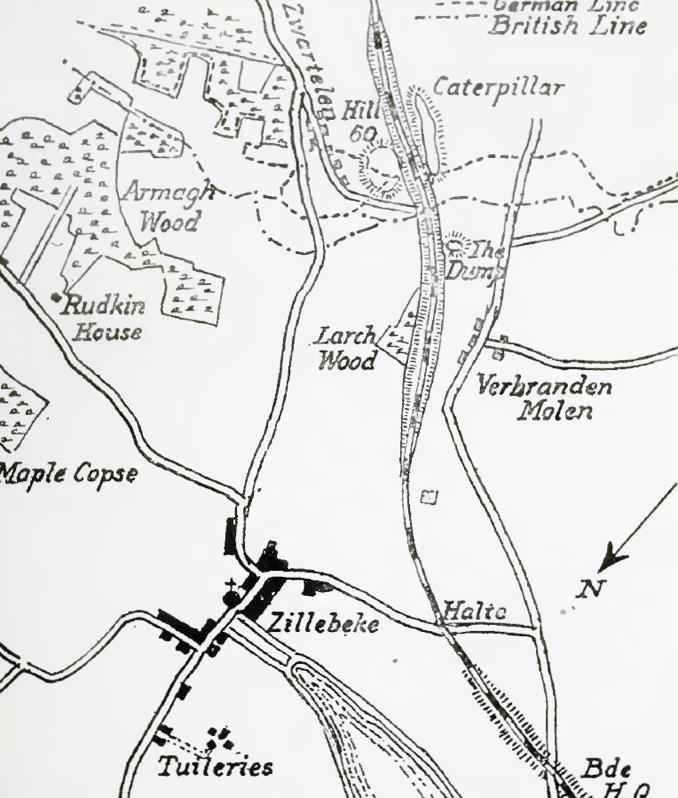
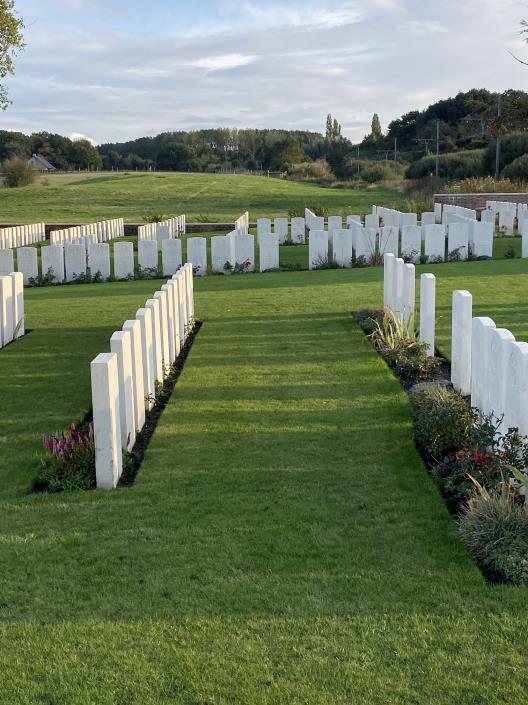
Photograph taken looking in a south easterly direction showing (the now wooded) skyline as it appears from Larch Wood Cemetery. Butcher crossed this ground to enter the frontline trench.166
165 Hussey, A. H and Inman, D. S, The Fifth Division In the Great War, p 60 166 Author’s photo
17. the ‘93’ and their stories 67
Hill 60 is so called because its height in metres is exactly of that number as shown on the contour line on all maps of the area. It is an artificial construct resulting from the spoil excavated in the 1850s from the adjacent cutting required to accommodate the Ypres Comines railway line. The hillocks just to the south of the railway, known as the ‘Caterpillar’ (because of its shape) and the ‘the Dump’, are also man made from excavated spoil. Although by no means a hill in the eyes of many, in the context of the terrain of the Salient any troops who held Hill 60 were provided with panoramic views over Ypres. For this reason, therefore, the hill had already been fiercely fought over to the extent that by the time the Dorsets took up position it was ‘a mere rubbish heap of shell and mine torn earth, timber and dead bodies, and the fighting of [recent] days had churned up and pulverised this scene of desolation. The British trenches were shapeless cavities; there was no other kind of shelter, and the enemy was less than a hundred yards away’.167
From the spring of 1915 there were significant efforts by both sides to undermine the enemy position by the digging of tunnels and the blowing of mines. On 17 April the British successfully captured Hill 60 after the blowing of five mines. As the entry in the battalion diary of the unit then in the front line puts it: ‘there was not much noise [but] the whole ground shook as if there was an earthquake and a few minutes afterwards bricks, Germans and all kinds of debris were hurtling through the air in all directions.’168
Intent upon regaining the Hill, from 7 pm on the evening of 1 May the Germans launched an attack involving the use of gas. The V Corps diary contains a diagram and a report describing how the gas was deployed:
A square plug (c) at the top of the bottle works the apparatus and allows the gases to escape. These leave the bottle by a tap (r) to which a rubber pipe is screwed. The pipes, which are carried by the men, are 50 metres in length, and can be screwed on to each other in order that the gases may be emitted at the desired distance from the operator. When an attack accompanied by asphyxiating gases is going to take place, the receptacles are carried to the trenches and placed in groups of three or four at irregular distances apart. The night before the attack patrols place these pipes on the ground in front of the trenches. The first is screwed to the tap of the bottle, the second is screwed to the first, and so on, until they extend to a distance of 50 100 metres from the enemy’s trench. 169 167 Edmonds J E, Official History, 1915 Vol 1 p 304 168 TNA WO 95 1553 1 169 TNA WO 95 744 4 Notes on the Employment of Asphyxiating Gases by the Germans
17. the ‘93’ and their stories 68
The 1st Bn. Dorsets were in trenches 40 46 at this time, a number of which are referenced in the diagram below, found in the 5th Division diary.170 The precise location of Charles is not known, but it seems likely that he was in C Company, stationed at the top of the Hill and were thus fully exposed to the attack.
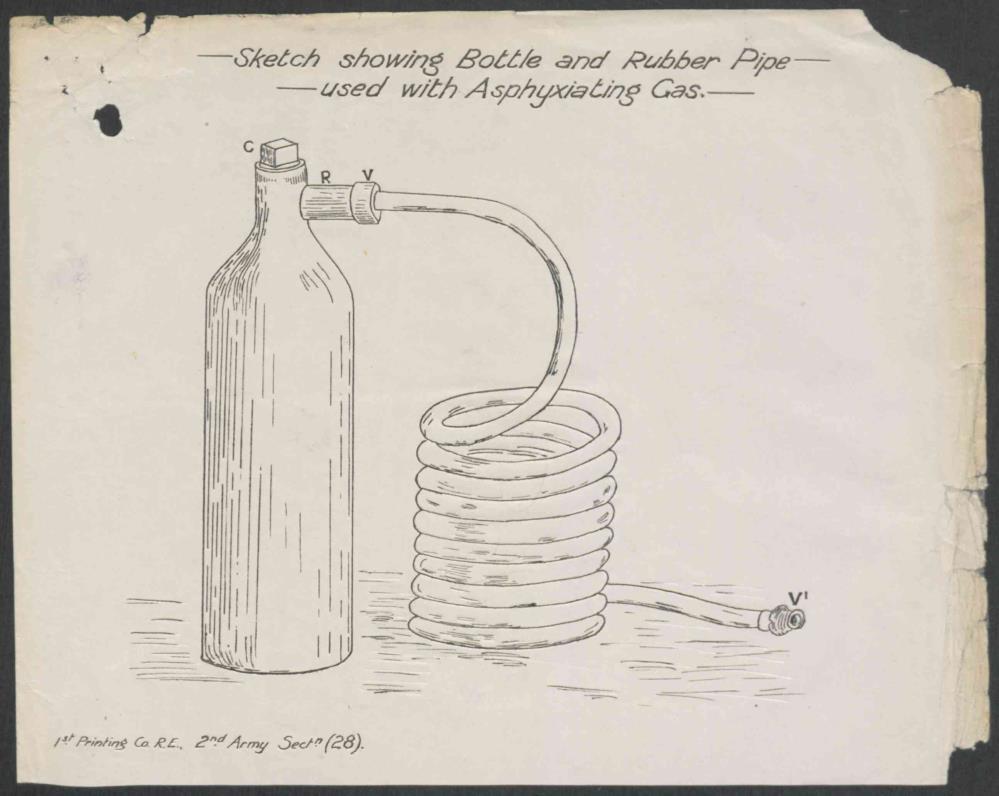
The battalion diary of 1st Dorsets provides the following details of the attack in which Butcher fell:
1 May. 7 pm. The enemy commenced bombardment of supporting areas of Hill 60. 7.15 pm. Enemy turned on asphyxiating gas from 3 nozzles in front of 38 trench and from 2 [nozzles] in front of 43 to 45 trenches; and also probably from others in front of 60. The direction of
17. the ‘93’ and their stories

the wind saved the garrison of 38, but the garrisons of 60, 43, 45 and 46 got the full benefit of the gas. … Trenches 43, 45 and 46 were suffering severely from the gas. The enemy in addition to using gas and shelling supporting areas heavily with different types of gas, opened heavy rifle fire and machine gun fire on Hill 60.171
A report in the 15th Brigade diary provides some further detail:
At about 7pm on 1 May the enemy began a very severe bombardment of Hill 60 and the trenches right and left and the railway cutting behind our trenches. The enemy let loose gas of white and yellow thick substance by opening nozzles opposite 38, 40, 43, 45 and 46 trenches; this gas was shot, in thick volumes, very suddenly on to our trenches taking many men too quickly to admit of their getting their mouth protectors on, the asphyxiating effect being practically instantaneous. The men in trench 30 were hardly affected, but the gas from in front of 36 was driven by the west wind on to Hill 60, where nearly the whole of three platoons were affected. In all, about 300 of all ranks of the Dorset Regiment were completely knocked out, many of whom are dead or unlikely to recover.172
The impact of the gas was horrific, as described by Sergant Major Ernerst Shepard of the Dorsets:
The gas, we were under the impression, was to stupefy only. We soon found out at a terrible price that these gases were deadly poison. … Men were caught by fumes and in dreadful agony, coughing and vomiting, rolling on the ground in agony. … Hell could find no worse. … A lot of our men are missing, having crawled over the back of the trench when gassed and the enemy shelled them as they crawled away. We spent a morning looking for these, a few were just living, majority dead. We found our dead everywhere where they had crawled to get out of the way. Hill 60 apart from our losses is a terrible sight. Hundreds of bodies all over the place terribly mutilated a large number of our own men, and larger numbers of Hun. Stench is awful as they cannot be buried……..So they lie as they fell, silent spectators to modern warfare.173
A history of 1st battalion Dorsets states that:
An examination of the casualty returns brought to light the terrible ravages caused by the gas. They showed Second Lieutenant Butcher and fifty other ranks dead; and in addition six officers and two hundred other ranks were admitted to the Field Ambulance. In addition
171
TNA WO 95 1572 2 2 172
TNA WO1566 1 5 Report on attack on Hill 60 on 1 May 173 Shephard E, A Sergeant Major’s War, p 40
17. the ‘93’ and their stories 71
thirty two other ranks were missing, men who had crawled away to die, and whose bodies were located afterwards. Only one man was killed and one wounded by shell or rifle fire.174
The losses of the 15th Brigade from 1 May to 7 May were 33 officers and 1,553 other ranks. Of this number the 1st Dorsets suffered the most heavily: from the German attack of 1 May 90 men died from gas poisoning in the trenches or before they could be removed to a dressing station; and of the 207 brought to the nearest stations, 46 died almost immediately and 12 after long suffering.175 Charles was one of these latter. He is buried in the churchyard at Reninghelst. Some distance from the front line, this small village was the location of the Field Ambulances attached to 5th Division. It is thus clear that Charles was not one of those who died in the trenches, but instead was extracted from the battlefield by a medical unit to the Dressing Station whilst still alive, only to die of the effects of gas the following day.
Charles’ grave (the farthest of the three commonwealth headstones), in the graveyard of the church at Reninghelst.176

174
175 Edmonds J E, Official History 1915 Vol 1 p 306 and p 289 176 Author’s photos
17. the ‘93’ and their stories 72
Ransome A L, The 1st Battalion Dorsetshire Regiment in France and Belgium, August 1914 to June 1915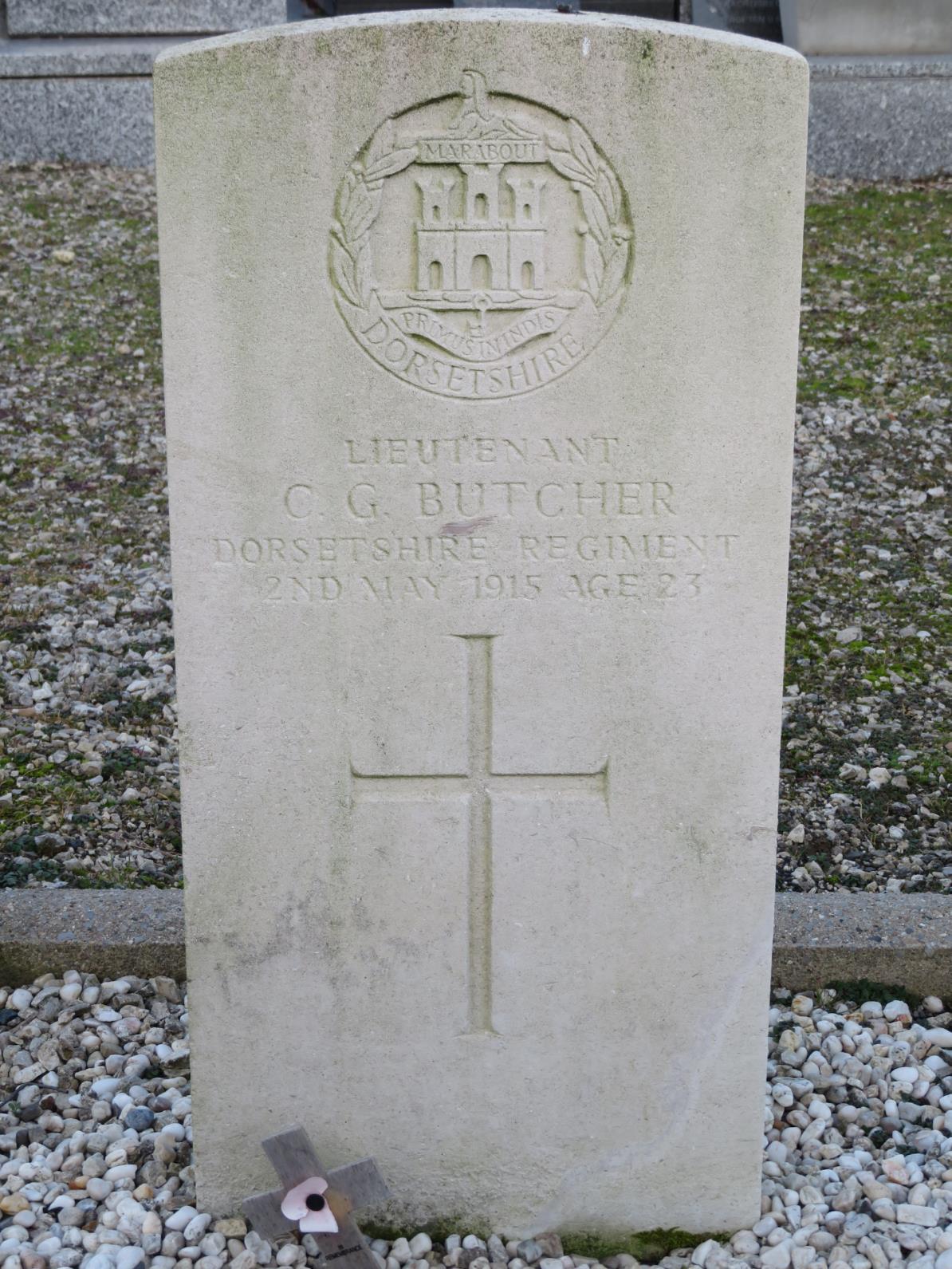
Maurice, Lt Stirling 11 May 1915, Hooge SPS 1902 1905
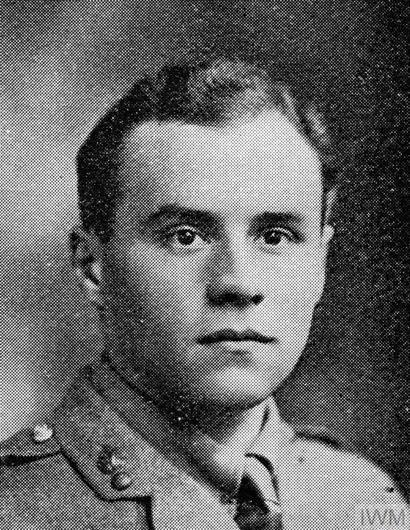
1st Wessex Field Company, Royal Engineers Lijssenthoek Military Cemetery XXXI.D.4 Age 28
Sterling Maurice177
Stirling was born on 12 November 1886, the sixth son of Major General Sir John Frederick Maurice and his wife, Lady Annie Maurice of Highland View, Camberley, Surrey. He was a younger brother of Frederick Barton Maurice (SPS 1884 1889, see Vol 1.) After leaving St Paul’s (1902 1905) Stirling went to King’s College, London, where he studied engineering, obtaining his B.Sc. and becoming a student member of the Institute of Civil Engineers, later qualifying as A.M.I.C.E. He worked as an engineer with various companies in England and abroad in West Africa, being at the outbreak of war assistant to Mr Fearnside Irvine, 1 London Wall Buildings. Stirling belonged for eight years to the Inns of Court OTC, and on the declaration of war he obtained his commission and joined the Wessex Engineers, going to France with his unit in December. He was wounded on 19 April, but remained at his post.178 A fellow officer wrote of him that ‘he worked with me in many a difficult and dangerous situation, and I learnt to appreciate most fully his capacity and gallantry in helping us to improve and render tenable positions that had become difficult. We were always glad when he came on duty: we knew he would give us good and practical advice and assistance. His death is indeed a dreadful loss to the service.’ He was one of six brothers all educated at St
177
178 The unit diary entry for that day locates the Company at Potijze. It states that at 9 am the Officers billet and office blown in by a shell. Look for fresh billets. 2nd Lieut Maurice slightly wounded. TNA WO 95 2258 2
17. the ‘93’ and their stories 74
Paul’s, ‘where his charming character, high spirit, and fine intelligence are still vividly remembered’.179
The 1st Wessex Field Company, Royal Engineers was attached to 27th Division. In early May, in the aftermath of the German advance in the north of the Salient following the gas attack of 22 April, it had been decided to establish a new line closer to Ypres. After this withdrawal the line held by 27th Division ran from near Hill 60 to half a mile short of the Roulers railway. A close study of the relevant unit diaries shows that Stirling was wounded in the vicinity of Hooge in the section of line held by 4th King’s Royal Rifle Corps, 80th Brigade.
The development of a new line required much work. It is thus not surprising that the diaries of the RE units attached to 27th Division (1st Wessex Field Company; 2nd Wessex Field Company and 17th Field Company) describe each unit engaged at this time in establishing the new position and undertaking works associated with that process: developing strong points, constructing new trenches, and evolving the G.H.Q line in particular. The C.R.E 27th Division, writing after the war to Edmonds, the Official Historian, provided this description of the situation:
The trench work was not difficult until we had to draw back and dig a third line through Hooge Frezenburg. Then the difficulty was time and time only. I mean time as compared with the men available for work, for we were in a tight place from a fighting point of view.180
Extensive damage to the newly occupied trench by heavy enemy shelling on 10 May necessitated emergency repairs. The Official History describes the role of 1st Wessex in this activity and its association with 4th K.R.R.C::
[At some point after 6pm on 10 May] the 1st and 2nd Wessex and 17th Coy RE were brought up to construct a new line as close as possible to the old 4th K.R.R.C front, so as to avoid having to give up any trenches south of the [Menin] road in the readjustment of the line. But this plan had to be abandoned … [because] the state of the ground made it impossible to complete the necessary digging before dawn. It was therefore decided to occupy the second line behind Bellewarde Lake, as far south as Sanctuary Wood, and thence to a communication trench south of and parallel to the Menin Road, to connect with the Cameron front trench. This alteration was carried out without interference.181
The 1st Wessex diary provides some detail on its activity at the time of Maurice’s death:
179 The Pauline, 33 218 June 1915 p 106
180 TNA WO 95 2256
181 Edmonds J.E Official History 1915 Vol 1 p 329. (The reference to Sanctuary Wood is confused.)
17. the ‘93’ and their stories 75
10 May Whole company working on a reserve trench
11 May Lt S Maurice killed in action about 2.30 am on Menin Road
12 May All sections on night work at Hooge. Constructing new trenches, improving communications182
The C.R.E 27th Division diary is similarly thin on detail, though Stirling is also mentioned:
11 May [Units] clearing roadway at Menin Gate …2nd Lieutenant S Maurice seriously wounded and died of wounds.183
It is not clear from this second entry whether the unit to which Stirling belonged was one of those involved in ‘clearing the roadway at Menin Gate’. However, this seems improbable because of 1st Wessex’ association on 10 11 May with 4th K.R.R.C and their presence at this time at Hooge. The evidence thus suggests that Stirling was killed in the vicinity of the Menin Road at Hooge while undertaking work at that place designed to address the damage effected by extraordinarily heavy enemy shelling of this location throughout much of 10 May. Moreover, the relevant entry in the Bond of Sacrifice asserts that Stirling was ‘wounded by a sniper at Hooge and died a few hours later at the Clearing Hospital, Poperinghe’.184 Especially since the Germans held the higher ground along this front, death from a sniper’s bullet was by no means uncommon, as evidenced by various unit diaries. In all probability, since Stirling was wounded at 2.30 am, it seems likely that he received the fatal sniper’s bullet as 1st Wessex fell back to position (b) before the onset of dawn.
An undated photograph looking north east across Bellewaarde Lake from the trenches held by the battalion (3rd K.R.R.C) on the left of the 4th K.R.R.C.185 It shows clearly the terrain in which 1st Wessex were charged with digging lines of trenches. By midday on 10 May the Bellewaarde Wood was described by the 1st Bn. Wessex diary as ‘an almost impenetrable abattis’. 186
182
TNA WO 95 2258 2
183 TNA WO 95 2258 2
184
Bond of Sacrifice IWM HU 118101. The Clearing Hospitals in Poperinghe at this time were numbers 3 and 5.
185 12 Section panorama. Taken from: Hooge, Sheet 28 I. 18b. 20. 75. Direction: N. W. to N. E. Bellewaarde Lake. © IWM Q 41917
186 TNA WO 95 2262 1
17. the ‘93’ and their stories 76
Stirling was removed from the line and taken to the Clearing Hospital at Poperinghe, where he died. He was originally buried in a chapel graveyard near Lijssenthoek, some two miles south west of Poperinghe.187 In 1919 his body was exhumed and moved the short distance to Lijssenthoek Military Cemetery.
View of Lijssenthoek Military Cemetery.188
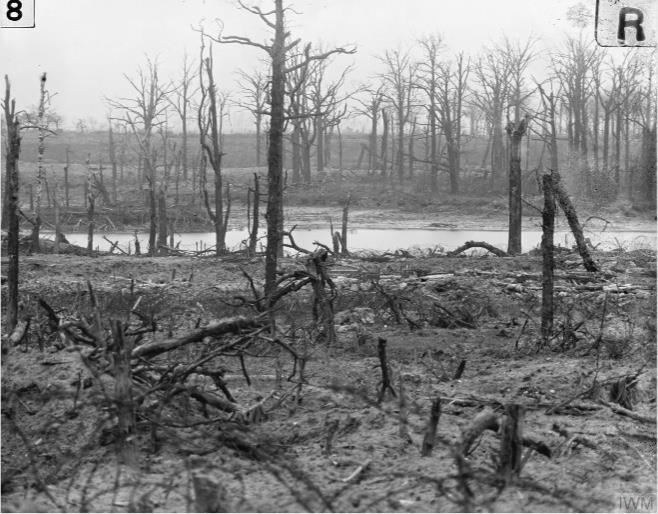
187 The location is 27.L.24.c.3.7
188 Author’s photo
17. the ‘93’ and their stories 77

Jennings, Private Frederick Sinclair Wills, No. 63495 6 July 1915, Ploegsteert SPS 1895 - 1900

14th Bn. Canadian Royal Montreal Regiment Ploegsteert Wood Military Cemetery III. B. 5 Grave epitaph: Born Nov 11. 1881 Resurgam Age 33 F. S. W. Jennings189
Frederick was the eldest son of Frederick Wills Jennings of 8, Selborne Place, Hove, formerly of Ealing and Streatham, B.A., retired H.C.S. He was born at Wandsworth Common, Co. Surrey on 11 Nov. 1881. He was a Foundation Scholar at SPS (1895 1900). Frederick played in the 1st XV in 1900 and was apparently a really fine forward. While at SPS he joined the Cadet Corps during the South African War. Upon leaving school he proceeded to Wren’s and then to Edinburgh University and Bangor University (Agricultural Department). After finishing his course at Bangor University, he went to Canada and took up land in British Columbia. (He describes himself on his attestation paper as a ‘homesteader’.)190 On the outbreak of war he volunteered on 3 November for active service overseas with the West Mounted Rifles, at Calgary, and when he arrived at Quebec he was posted to the 23rd Battalion on 4 Nov 1914. After training in Quebec, he went over with the Reserve Battalion of the 1st Contingent to Shorncliffe in March 1915, and proceeded to the Front in May.
14th battalion was a unit in 3rd Canadian Infantry Brigade, 1st Canadian Division. At the end of June 1st Canadian Division moved from the vicinity of Givenchy to the Ploegsteert sector
189 De Ruvigny Roll of Honour 190 Service File B4822 S048
17. the ‘93’ and their stories 79
at the southern end of the Salient where it was responsible for 4,400 yards of front stretching roughly between Ploegsteert to Messines.191
The 14th battalion history describes the unit’s journey to their new location:
On the way forward to the ‘Plug Street’ trenches the men of the Battalion, passing through Ploegsteert Wood, were much interested in the board walks bearing the names of London streets; in field batteries hidden in attractive surroundings; and in Headquarters huts, which reminded them of log cabins in the sugar bushes at home. On taking over the trenches from the 4th Battalion, Nos. 1, 2, and 4 Companies of the 14th moved into the front line, with No.3 Coy in support. The positions occupied by all companies were clean and comfortable, except for the presence in dugouts of an abnormal number of huge rats. The right of the front was not entirely a pleasant spot, however, as underneath a knoll, held by No. 4 Company, the Germans were supposed to have dug a mine. Some compensation for the tension of living over a potential volcano was supplied at this point by the presence of a great catapult, similar to those used in the days when Caesar's legions were over running Gaul. Bombs were fired at intervals from this dangerous contraption, also a few tins of bully beef. Probably the enemy regarded the beef as some particularly obnoxious Canadian poison.192
The front line consisted of connected lengths of fire trench, numbered from 121 on the right at Ploegsteert Wood to 142 on the Wulverghem Messines road. These trenches were not of the first order, dug from two to four feet deep with a sandbag parapet and rarely possessing any parados. There was no support line, and the communication trenches were such that safe access to the front line, except through the woods, was only possible under cover of darkness. The new occupants set about improving these defences and establishing them in depth according to instructions issued by the Commander in Chief 3rd Corps, who had prescribed the construction of a defensive zone immediately behind the front line. During the early stages of this programme some 2,000 men from the 1st Canadian Division were employed nightly on this task.
The report of one observer summed up the conditions: ‘All quiet on this front. Enemy as elsewhere hard at work digging and strengthening defences’.193 Although multiple sources confirm that this section of the front at this time was ‘quiet’, many also reference the steady
191
1st Canadian Divison came into line on 28 June; 3rd Bde was in Divisional reserve billeted in wooden huts on the lower slopes of the ridge a mile south of Neuve Eglise
192 Fetherstonhaugh, R. C The Royal Montreal Regiment, 14th Battalion CEF 1914 1925 p 63
193 Quoted in Duguid F, Official History of the Canadian Forces in the Great War 1914 1919, General Series Vol 1, p 504
17. the ‘93’ and their stories 80
danger posed by snipers. The 1st Canadian Situation Report for the week ending 5 pm 9 July stated that:
The general situation throughout the week has been normal. Everything has been comparatively quiet and working parties have been very little molested. Enemy snipers have been fairly active. Hostile machine guns have been rather active also every night between 9 10.30 pm, evidently with the intention of interfering with our working and ration parties.194
Another authority relates that:
July was a sniper’s month. True, every month is a sniper’s month; the great game of sniping never wanes, but the inactivity in other methods of fighting left the field entirely free for the sharpshooter in July.195
Similarly, the 14th battalion history describes how:
Snipers were active throughout the tour, four men of the 14th being hit and many others escaping by narrow margins.196
Frederick’s battalion came into line at 11 pm on 5 July, 3rd brigade taking over the trenches in the right of the sector numbered 121 to 130 inclusive, relieving 4th battalion, 1st brigade. None of these units’ diaries provide sufficient detail further to narrow the location of Frederick at the time of his death. However, it seems likely that the location of his grave in Ploegsteert Military Cemetery (originally called Strand Canadian Cemetery, after the nearby trench of that name manned by 1st and 3rd Brigades) is more or less the location in which he fell.
On 6 July Frederick was shot through the head by a sniper while on duty in the trenches at Ploegsteert Wood. His Platoon Commander wrote:
Jennings joined my platoon from the 23rd Regt early in May, after the Battle of Ypres, and I was struck from the first by his cheerfulness, quiet obedience, and a striking devotion to duty in face of the many obstacles we have to contend with. He received his baptism of fire
194 RG9 III D 3. Volume/box number: 4825. File number: 42. Appendix 9
195 Aitkin, M Canada in Flanders, The Official Story of the Canadian Expeditionary Force, Vol 1 p 318
196 Fetherstonhaugh, R. C The Royal Montreal Regiment, 14th Battalion CEF 1914 1925 p 63
17. the ‘93’ and their stories 81
shortly after coming to this country at the Battle of Festubert, and was with us at Givenchy, coming successfully through these ordeals.197
An engraving by Geoffrey K. Rose, showing graves in Ploegsteert Wood, 1915. Frederick’s grave will have looked like those shown here. (Notice the raised plank walkway in the background.)198
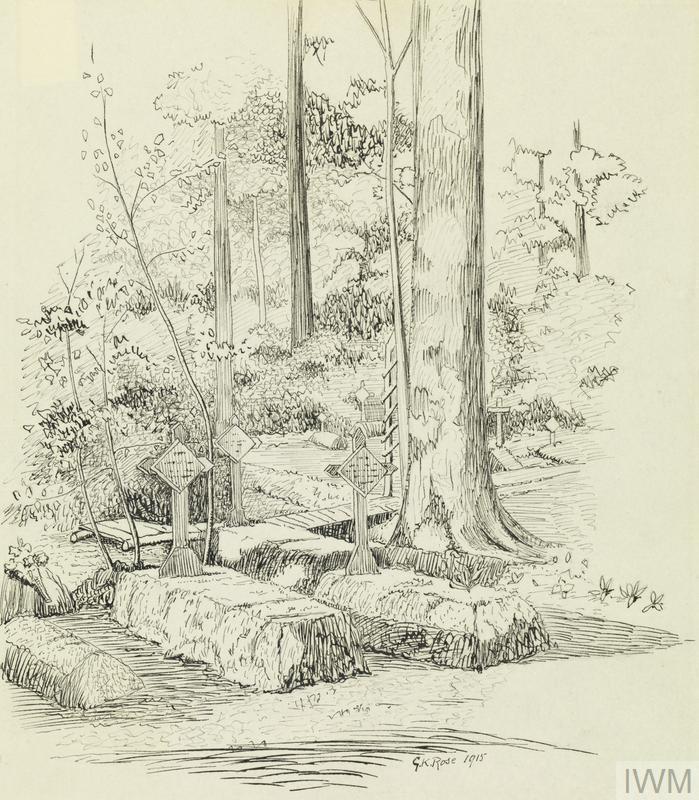
197
De Ruvigny Roll of Honour 198 Art. IWM ART 4780
17. the ‘93’ and their stories 82
Challoner, 2nd Lt Alan Crawhall 30 July 1915, Hooge199 SPS 1904 1911
6th (Service) Bn. Duke of Cornwall’s Light Infantry, C Company Sanctuary Wood Cemetery I.C.9 Age 23
Alan Crawhall Challoner200
Alan was born on 18 December 1892, only son of Frederick C. T. Challoner and Elspeth Challoner of 15, Mount Park Rd, Ealing, London. He attended SPS 1904 1911. A sportsman, he represented SPS as middle weight boxer at Aldershot in 1911 and got his colours for the 1st XV which was captained by Middleton and included other OPs who had already fallen in the war: Child, Jackson, Merriam, and Norman, the first of whom also fell in the Salient, at Hill 60. Alan also won the first Smee Prize two years in succession with natural history exhibits. From SPS he proceeded to Gonville and Caius College, Cambridge where he studied Zoology. At Cambridge he played football for his college and then travelled through Canada, Spain, and Russia, returning from Petrograd through the Kiel Canal not long before the war. At its outbreak he joined the Inns of Court OTC and went to France in May 1915 with the first division of Kitchener’s Army. He obtained his commission in the Duke of Cornwall’s Light Infantry on 31 August 1914 and served in 6th (Service) battalion, C Company.
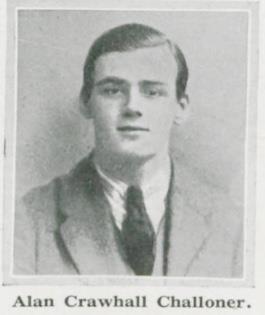
199 Alan’s Graves Registration Report Form states that he died on 31 July. https://www.cwgc.org/find war dead/casualty/477597/challoner, alan crawhall/#&gid=null&pid=1 Accessed 1 August 2020. This is contradicted by the unit diary though it is possible that Challoner died from his wounds in the early hours of 31 July.
200 De Ruvigny Roll of Honour
17. the ‘93’ and their stories 83
Shortly before his death Alan had sent the following lines home, suggesting a preparedness to make the greatest sacrifice:
If I were killed today, my chief regret In this, the greatest worst of all the wars, Would surely be that I my fate had met Without a chance of furthering the cause.
If I could put one bullet in a foe, Put just one German helmet in my kit, Then, if I have to, I’m prepared to go, For, after all, I’ve done my little bit.201
Between 27 28 July the 6th battalion D.C.L.I was in billets in Vlamertinghe, a short distance to the west of Ypres. The battalion diarist describes the unit during this time as ‘resting and re equipping’, though the battalion had also enjoyed an even longer period at ‘rest in bivouacs’ from 1 July to 9 July, and it seems likely that it was during one of these periods that Alan penned the verse printed above.202 Alan was nonetheless about to be presented with an opportunity to ‘put a bullet in a foe’ when, on 30 July, the Germans launched a massive assault involving the use of ‘liquid fire’ and successfully pushed the 41st Brigade back to the south side of the Menin Road.
The 6th D.C.L.I was thus duly attached to 41st Brigade (14th (Light) Division) and sent up to Hooge as reserve on 30 July. At 1.40 pm the unit had reached Zouave Wood in which two companies took up position and the two other companies did the same in Sanctuary Wood.
After 41st Brigade failed to regain the lost trenches in a counter attack launched at 2.45 pm the C.O of that unit tool the decision to:
Withdrew the battalions of the 41st Brigade, replacing them by the 10th Durham Light Infantry and the 6th Duke of Cornwall Light Infantry along the north edge of Zouave Wood. I directed these battalions to dig themselves in along the northern edge of the woods, but finding that the edges of the woods were being so heavily shelled that no work could be done on them, and heavy casualties were being incurred, I decided to [order them to] dig a fire trench about 50 yards in and to hold the edge with a line of posts.203
The 6th battalion D.C.L.I diary confirms that:
201 Published in Belfast News Letter, 7 August 1915
202 TNA WO 95 1908 2
203 TNA WO 95 1864 2 1. Report by Brig General, C O 41st Bde on action of 29 30 July, 6 August 1915
17. the ‘93’ and their stories 84
At 3.40 pm the Bn moved to advance through Zouave Wood through the remnants of the 41st Bde (which had failed in their counter attack) and [set up] to hold the two sides of Zouave Wood [in trenches] known as S3 and S4. We suffered very heavily in going through the wood but got into position alright and held on. [Later in the evening, at 6.10 pm, the two companies in reserve in Sanctuary Wood were ordered to occupy the line along the northern edge of Sanctuary Wood, right flank resting on trench B.7]204
Map found in 7th battalion Sherwood Forester’s diary August 1915 showing the position that battalion adopted on the northern edges of Zouave and Sanctuary Woods, having relieved the 6th D.C.L.I in the trenches shown.205
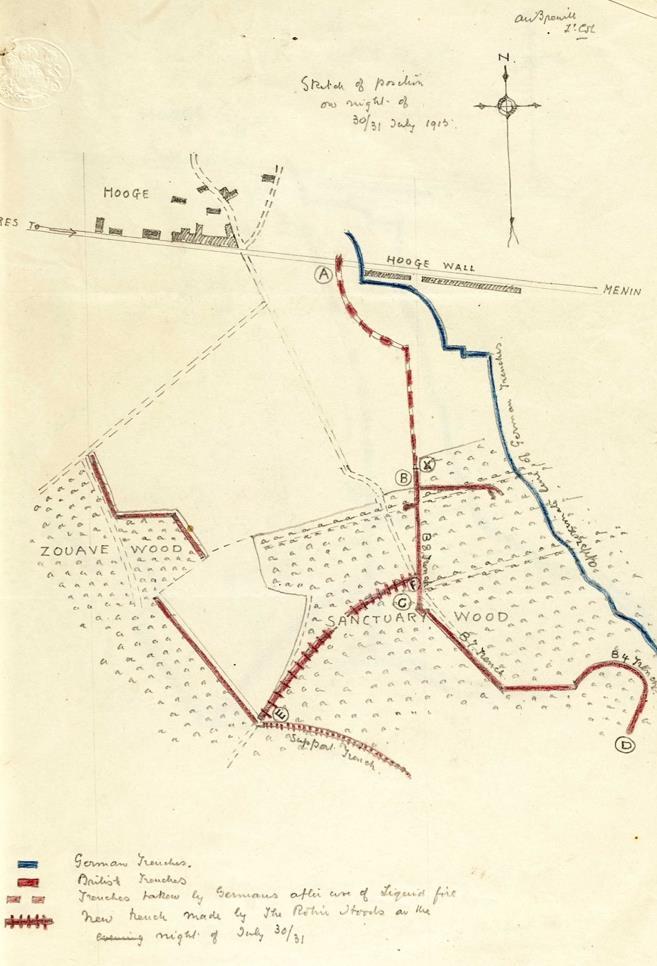
204
TNA WO 95 1908 2 with further details from TNA WO 95 1894 1 6
205 TNA WO 95 2694 2
17. the ‘93’ and their stories 85
By the early evening of 30 July it thus seems that 6th D.C.L.I was arranged in part along the edge of Zouave Wood facing north east and in part along the northern edge of Sanctuary Wood. The disposition of the Companies along the line is unfortunately not recorded and so the precise location of C Company remains unknown. However, the battalion diary references the death of Alan:
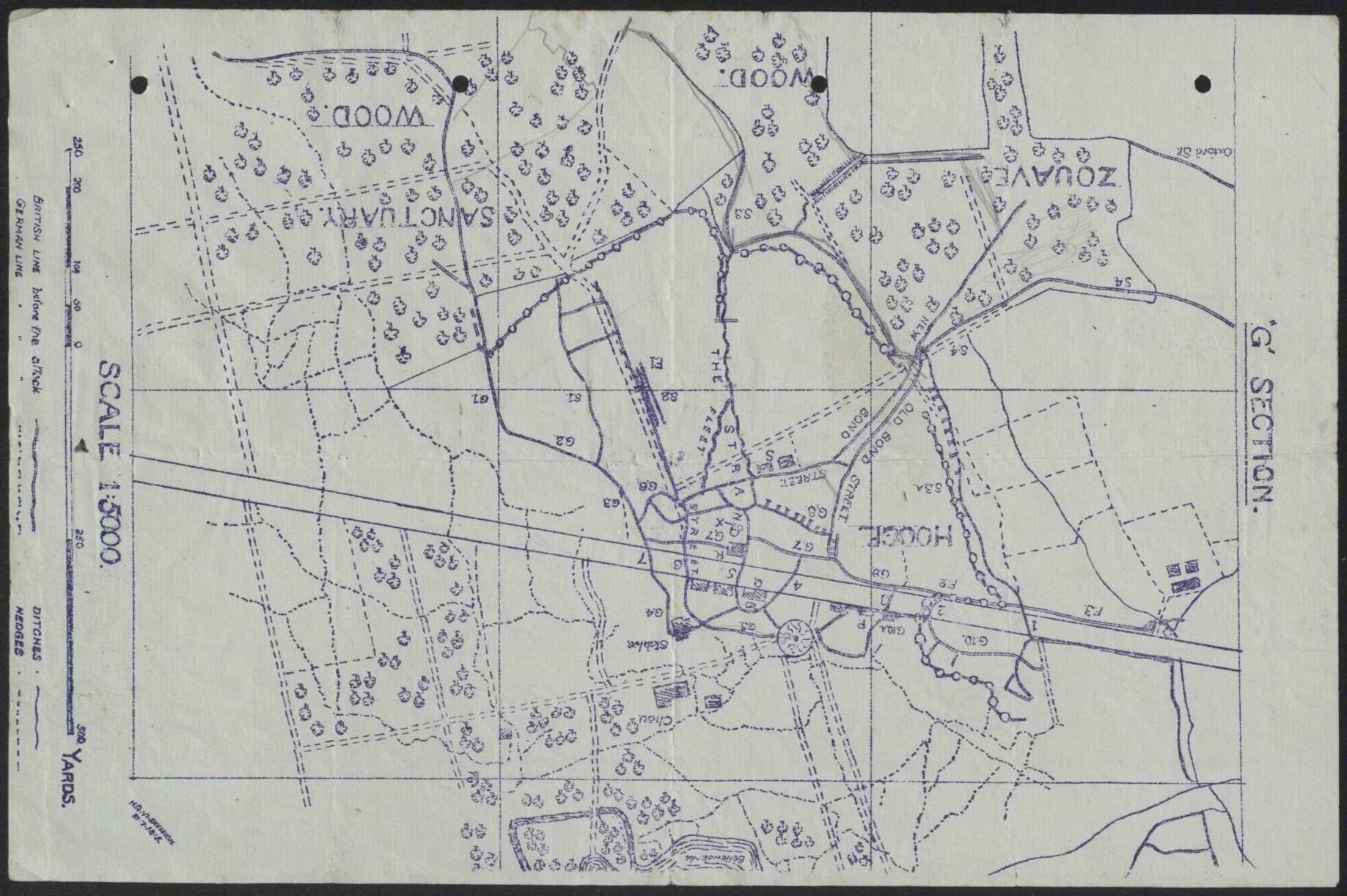
[At] 7 pm the Germans delivered an attack on our position. The [10 battalion] Durham Light Infantry had at this hour reinforced our left in S3. The enemy used liquid fire and bombs ... By daybreak we were still in the same position but had lost Lt Paddison, 2nd Lt Challoner and our MO, Lt Mc Cullum RAMC killed, and 2 officers wounded.207 Other ranks killed and wounded about 100.208
Some further detail is added in Alan’s obituary account published in The Pauline:
206
TNA WO 95 1618 3
207 Paddison, George Mitford. K.I.A aged 21, is also commemorated in Sanctuary Wood Cemetery.
208 TNA WO 95 1908 2
17. the ‘93’ and their stories 86
In the severe fighting round Hooge Chateau [Challoner’s] company was ordered up, with another, to take some trenches lost by liquid fire. The other company led, and took the trenches but lost all its officers and N.C.O's. Challoner was then detailed by the C.O. to command it, but in crossing the 250 yards of open ground he was mortally wounded and died two hours later.209
Major Carew Barnett reported that Alan ‘was doing splendidly, and at the time of being wounded was in command of a company, all the officers of which had been killed or wounded’.210
Buried in Sanctuary Wood cemetery, Alan thus lies today no great distance from where he fell on 30 July 1915, probably in No Man’s Land between trench S3 and the Menin Road.
At 1 am on 1 August 6th D.C.L.I were taken out of the line and marched back into reserve at the Ramparts in Ypres. The diarist records that ‘We had had no food or water since marching from Vlamertinghe and relief was imperative.’211
It is also worth noticing the following curious anecdote published in De Ruvigny, referencing Alan and adding texture to his character and demeanour:
A few days before he was killed, Lieut Challoner got permission to do a little reconnoitring on his own account in a wood to the north of the Menin Road, and was warned not to show himself, as it was shelled by the enemy on the least suspicion of the presence of the English. [This is most probably “Y Wood”. It stood at this time in No Man’s Land. See below.] Going up with one of his men he came upon a number of dead British and German soldiers, a large number of accoutrements, and in a dug out about 100 rounds of trench mortar shells etc., also the body of and English officer of the rank of Capt, Royal Fusilier badge and ribbon of the Military Cross, which he took steps to have buried. Subsequent enquiry proved the identity of the officer who had been killed by a shell five weeks earlier evidently by concussion as the body was found lying close to a shell hole but unwounded by a doctor and party who removed it to a place of safety for burial, but on returning later it had disappeared and was not found until Lieut Challoner came upon it in the wood. Its presence and the bodies of the British and German soldiers etc., remain a mystery. Returning to camp
209 The Pauline, 33 220 Oct1915 pp 180 81
210 De Ruvigny Roll of Honour. Barnett served with 6th Bn Duke of Cornwall’s Light Infantry and was temporarily in command of the battalion for a few weeks up to the time of his death on 12 August 1915.
211 TNA WO 95 1908 2
17. the ‘93’ and their stories 87
with as many of the mortar shells as he and his man could carry, Lieut Challoner’s attention was drawn to the fact that the wood was being heavily shelled. When he observed. ‘Yes, I know. Before leaving I showed myself at the edge of the wood to draw the enemy’s fire, which they are wasting quite satisfactorily’.212
Provided by an unnamed authority and published as part of Alan’s obituary in The Pauline, it is impossible to trace the provenance of this source. Nevertheless, sufficient of its detail can be corroborated to pronounce it credible. The Hooge sector of the line had been held by 3rd Division in June, and, as described by the historian of the Royal Fusiliers, 4th battalion Royal Fusiliers were involved in a key action on 16 June:
At the end of May the Germans were left in possession of Bellewaarde Lake, and they established positions which made an uncomfortable sag in the Ypres salient. The 3rd Division was given the task of effecting a local straightening of the line in this area … the 4th Royal Fusiliers were in position, east of Cambridge Road trench at 1.30 am on 16 June. Immediately in front of them lay the wood [most probably, Y Wood, north of the Menin Road] with a trench guarding its western edge …. Two supporting companies of the 4th battalion pushed through the wood to the trench on the west bank of Bellewaarde Lake but they advanced too quickly for our artillery and suffered very heavily … The battle was full of heroic deeds, but at the end of the day only a handful of ground remained in the hands of the battalion of all that had been taken in that first eager rush, and the losses had been all too heavy. Of the 22 officers and 820 men who entered battle some 15 officers and 376 men became casualties. Captain and Adjutant George O'Donel, who had been with the battalion from their arrival in France, was killed. Lieutenants Thornton, Harter, Warde and Rogers, with Second Lieutenants Dudley and Hutchinson Banister, were also killed.213
The diary of 4th Battalion Royal Fusiliers records that on 16 June Adjutant Captain G Thomas O’Donell was killed with his orderlies and operators by a high explosive shell.214
George O’Donel was twice mentioned in despatches and was awarded the Military Cross The account presented by the unnamed authority in The Pauline thus appears accurate, the body of the Captain found by Alan ‘with the ribbon of the Military Cross’ almost certainly that of George O’Donel. The ‘mystery’ would thus seem to be solved. (O’Donel has no known grave and is commemorated on the Menin Gate; there is a memorial window in his name in St George’s Memorial Church, Ypres.)
212 De Ruvigny Roll of Honour
213 O’Neill, H. C, The Royal Fusiliers in the Great War, pp 64 65 214 TNA WO 95 1431 1 3
17. the ‘93’ and their stories 88
Map showing the ‘uncomfortable sag’ in the line around Hooge, described by O’Neill.215
17. the ‘93’ and their stories 89

Long-Innes, Lt Selwyn 4 August 1915, Messines SPS 1891 1894

2nd Bn. the King’s Own (Royal Lancaster Regiment) Dranoutre Military Cemetery I.A.18
Grave epitaph: My Son He Is God’s Soldier Let Him Be I Would Not Wish Him To Be A Fairer216 Death, R.I.P. Age 37
Selwyn Long Innes.217
Selwyn was the second son of Rev Reginald Gipps Long Innes and Emma Grace. According to The Pauline, ‘On leaving St. Paul's School at the age of 16, Selwyn studied for the Royal Military Academy Woolwich examination, but failed in some subjects at the first time of going up but was good in mathematics and geometry; therefore it was intended he should go up for a second try, when his family lost all their income for a time, making this impossible. A friend, returning to his indigo plantation in Bengal, [therefore] took Selwyn back with him to work on it.’218 In 1898 he joined the Behar Light Horse and on the outbreak of the South African War in 1899 he volunteered as a Trooper in Lumsden’s Horse, with
216
The unusually long epitaph was relatively expensive: 17s and 9d, the equivalent of £52.36 in 2017. It was priced per letter.
217 Courtesy of The King’s Own Royal Regiment Museum KO2400/10
218 The Pauline, 33 222 Dec 1915 pp 251 53 and De Ruvigny Roll of Honour
17. the ‘93’ and their stories 90
whom he served until they were disbanded. He returned to England but after three weeks went back to South Africa with a commission in the Yeomanry and served there until peace was declared. After returning to England for a short period of time he went to Canada and worked for a year on a large farm on the prairies before proceeding to British Columbia, where he purchased a small fruit ranch at Willow Point on Lake Kootenay. Whilst in this location he worked in two Government Survey Expeditions exploring new forest country. In 1910 Selwyn came home for a few months but was back in British Columbia by 1914, participating in another survey expedition far north. At this point:
A chance traveller told him he had heard a rumour of a European War, and Selwyn could not rest; he threw up his work, and got down by river and pack pony to Fort George, found the rumour to be a fact, and started for England at once, arriving on 16 September, at home in London at 11.45, and he went straight off to the War Office to report himself. He was not given an interview, but told to send in his papers; he did so, and getting no reply by the end of the first week he enlisted in the Public School Corps, to fill in his time.219
On 24 December Selwyn was gazetted 2nd Lieutenant 3rd battalion King’s Own (Royal Lancaster Regiment), latterly promoted Lieutenant and proceeded to France in May 1915 to join 2nd battalion King’s Own (Royal Lancaster Regiment), 83rd Brigade, 28th Division.
Following a period of rest in huts at Scherpenberg from 24 July, 2nd King’s Own battalion took over the ‘C’ trenches in front of Wulverghem on 29 July, relieving 2nd East Yorkshire Regiment.220 The sector was mostly quiet, the 2nd East Yorks battalion diary reporting only the presence of snipers and occasional heavy shelling. Casualties were few.
Map showing the location of ‘C’ trenches at the southern end of 28th Division sector.221
219 The Pauline, 33 222 Dec 1915 pp 251 53
220 2nd King’s Own were ordinarily a unit in 83rd Brigade but at this time were attached to 85th Brigade, 28th Division.
221 TNA WO 95 2268 1 4
17. the ‘93’ and their stories 91
Map showing the main communication trenches leading to the front line in which Selwyn served.222

On 29 July 2nd King’s Own battalion marched from Scherpenberg at 1 pm to proceed to the trenches, having halted en route in a field near Dranoutre for their evening meal. From here the battalion continued via Bus Farm, where each Company was provided with a guide to
the ‘93’ and their stories
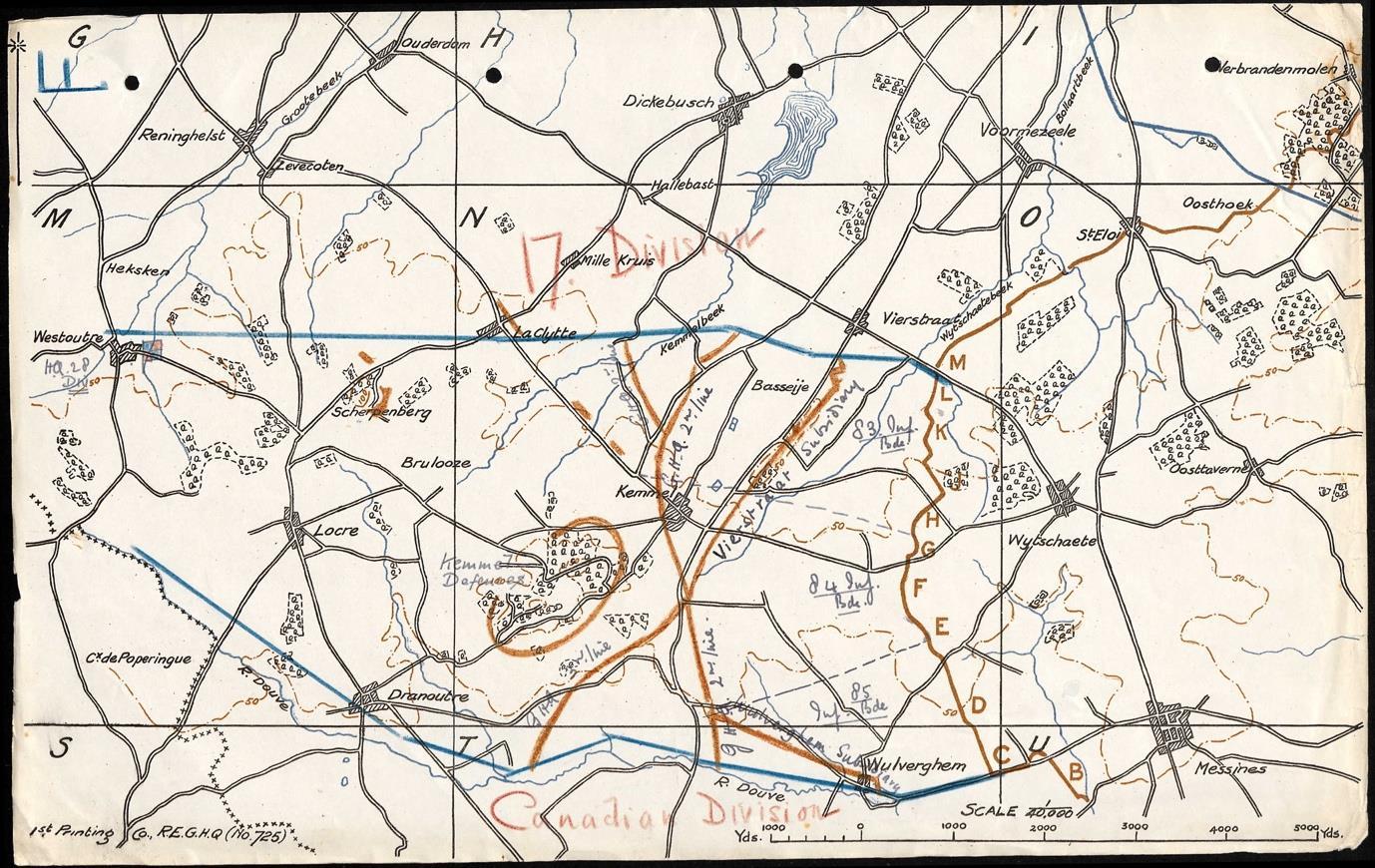
take it to battalion headquarters at St Quinten Farm whereupon another guide took each Company to the trenches allocated as follows:
A Coy: C1 and C2
B Coy: Diagonal Trench
C Coy: C3
D Coy: C4 with 15 men at SP 4
2nd Lt Chesney’s party will be the bn support at Souvenir Farm and North Midland Farm
Map showing the location of the ‘C’ trenches.223
Unfortunately it is not known to which Company Selwyn belonged and so it is not possible to locate where he fell any more precisely than asserting that he was somewhere in the line of ‘C’ trenches, for which unusually detailed maps have been produced by unit diarists. The unit diarist provides no details as to how Selwyn met his death, though an unnamed source published as part of Long Innes’ obituary in The Pauline states that:
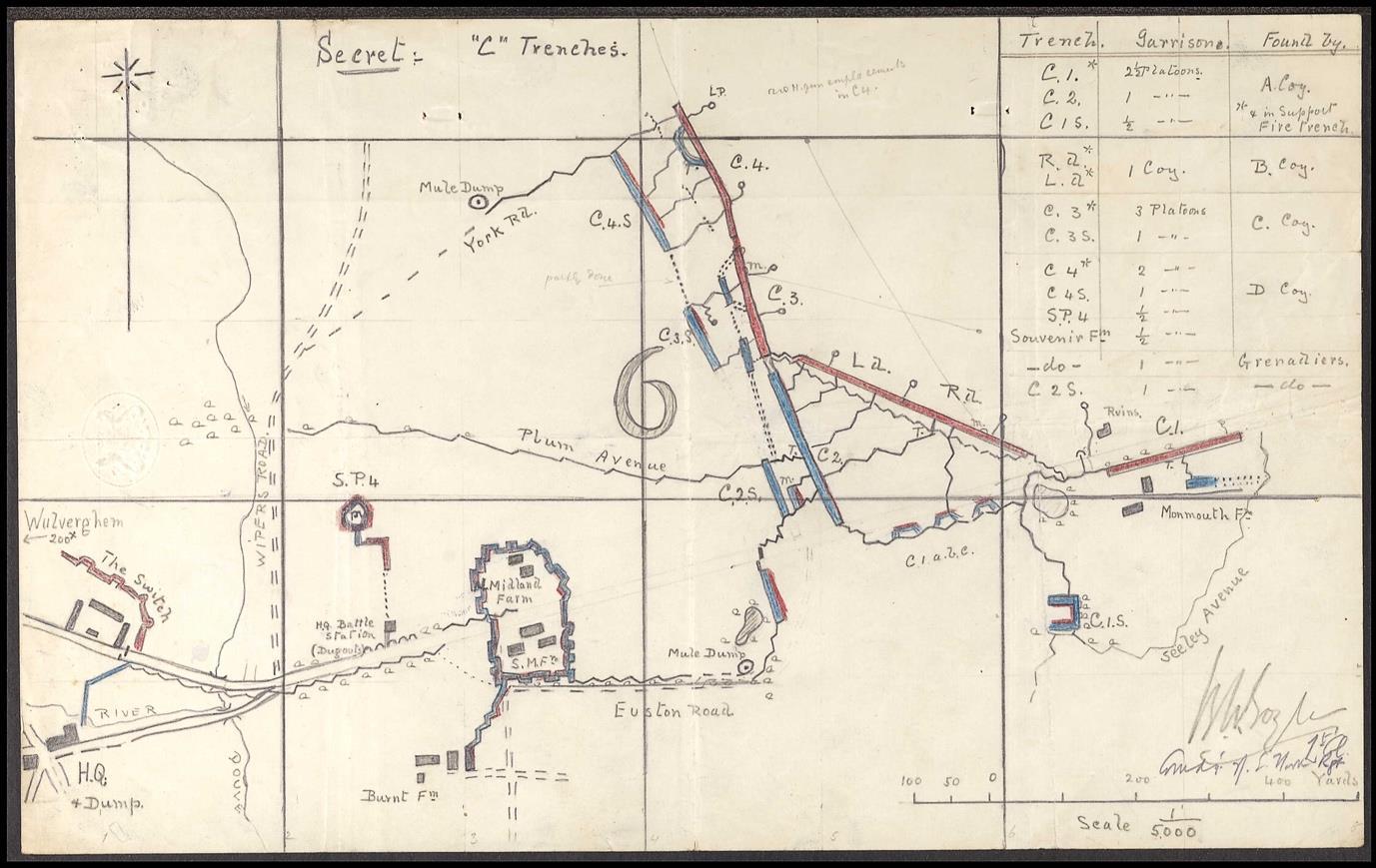
On August 4th, while showing two Artillery officers where to attack the German lines, [Selwyn] was shot through the head, to the deep regret of his battalion, whose Colonel said he was one of their best and most trusted officers, a true gentleman, and a gallant soldier, beloved by all ranks.224
223
TNA WO 95 2275 1
224 The Pauline, 33 22 Dec 1915 pp 251 53
17. the ‘93’ and their stories 93
Goodale, 2nd Lt Arthur William 9 August 1915, Hooge SPS 1908 1913
1st battalion King’s Shropshire Light Infantry Ypres (Menin Gate) Memorial Panel 47 and 49 Age 20
Arthur was the son of Mr. W. H. Goodale and Mrs Elizabeth Goodale. Having attended SPS (1908 1913), he joined the Artists' Rifles in 1914. At some point he transferred to 1st battalion King’s Shropshire Light Infantry (K.S.L.I) with whom he went to France in February 1915; he was commissioned in July of that year, shortly before he was killed at Hooge on 9 August.
In August 1915 1st battalion K.S.L.I was a unit in 16th infantry Brigade, 6th Division. From 1 5 August the battalion was in billets in Poperinghe. Meanwhile, on 1 August, the Division had received orders to carry out an attack to regain the Hooge position lost to the Germans on 30 July. Thus, on 6 August the Brigade moved up to Hooge and, at 3 am, took over the line running from Y Wood to the trench called Bond Street. The battalion suffered heavy shelling between 2 am and 3 am on both 7 and 8 August.
The map below shows ‘Y’ Wood in the top left hand corner and Bond Street centre, bottom. The positions from which the 2nd York and Lancaster and 1st K.S.L.I attacked on 9 August are indicated. Key: red shows the British line before the action; the solid green line shows German trenches; the dotted green lines show old British trenches that were either evacuated or captured by the Germans in the attack on 30 July; the dotted blue lines show hedges and the thick blue line, a ditch.225
17. the ‘93’ and their stories 94
The first objective of 16th Brigade in the forthcoming attack August but now delayed to 9 August the Crater in a north K.S.L.I were to attack on the right; the 2nd battalion York and Lancaster Regiment, the left. The character of the attack is detailed in diary. Between 2.45 am and 3.15 am on 9 August the artillery was ordered to bombard the enemy’s defences. Then, according to the Order:
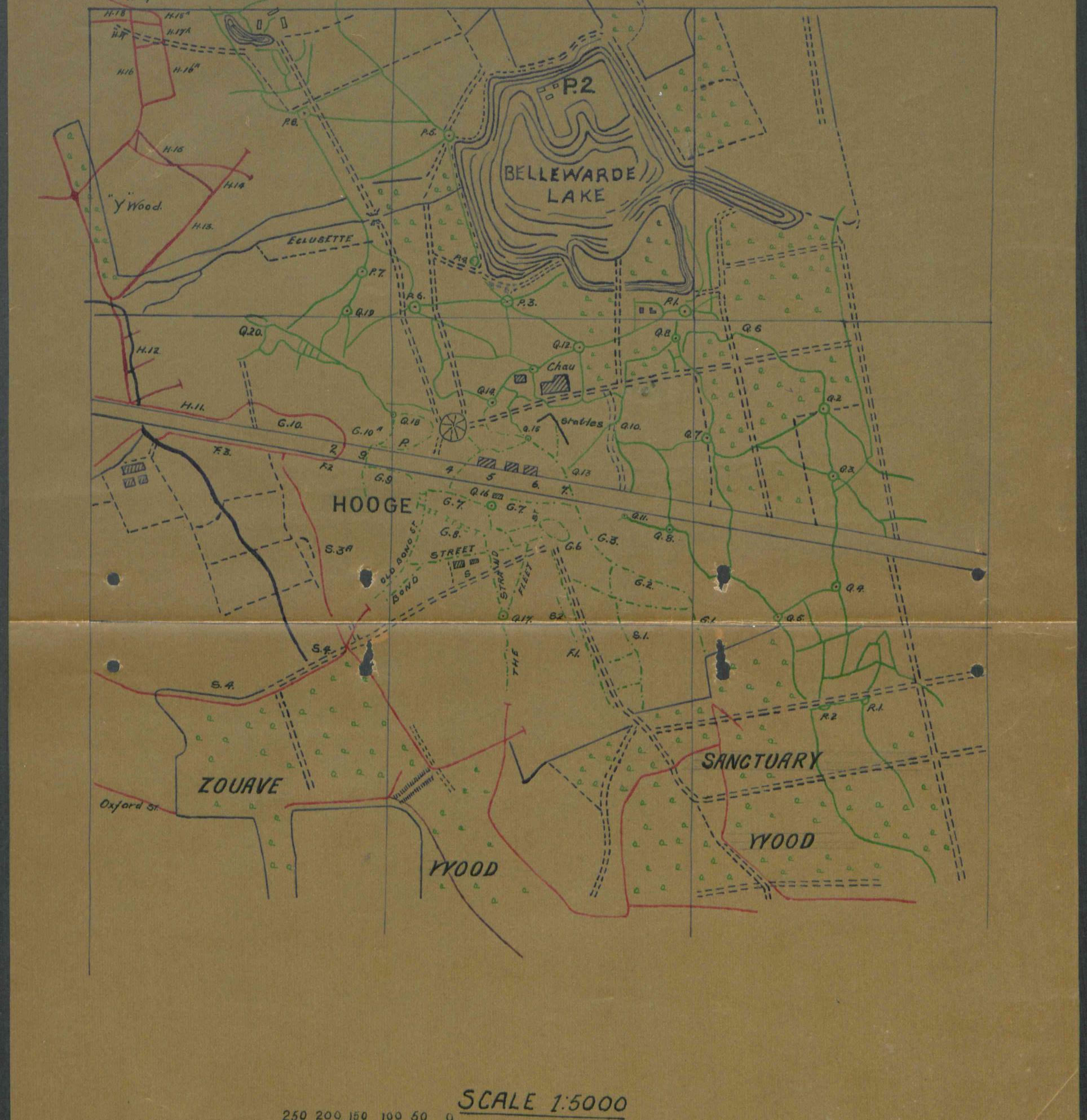
During the last ten minutes of this bombardment the leading Companies of the 1st K.S.L.I and 2 trenches H.12 lie down. Any wire in front of our line is to be removed during the night. At 3.15 am pre the guns will lift and the infantry will assault and push on as quickly as possible. … The advance must be made exactly at the time ordered regardless of what the artillery are doing. … During the attack the 1st K.S.L.I will despatch parties headed Bond Street and G.8 …
the ‘93’ and their stories
The Brigade diary contains a heart pounding account of the implementation of the Order:
5 6 Aug K.S.L.I and York and Lancaster took over a portion of the line held by parts of 42nd and 43rd Bde [14th Division]
6 Aug the trenches were found in a somewhat battered condition. During the night work was commenced on [the] assembling trenches between H.11 and H.12 in a hollow which was out of view from German lines
7 Aug our bombardment continued
8 Aug an unfortunate shell pitched among some officers of the 1 K.S.L.I … During the night a party of 1 Leicester Regt dug assembly trenches behind S3 to accommodate 1 Coy K.S.L.I
9 Aug
2.15 am all troops in position
2.45 am the bombardment commenced
3.10 am a K.S.L.I bombers, under Lieut Woodland began working up Bond Street. They were temporarily held up by the German Bombers but Lieut Woodland reorganised his party and succeeded in driving the enemy back.
3.15 am [our] artillery ‘lifted’ and the assault took place. Both battalions [i.e. 1 K.S.L.I and 2 York and Lanc Regt] had already begun creeping forward before this hour and were by now close to the German lines. By now there was so much dust and smoke that nothing could be seen of the operations from the Brigade Battle Station. Telephone wires to both battalions had been cut to pieces although laid the whole way along the trenches. Messages began arriving by runners at 4.37 am: the first line of German trenches was captured during the next few minutes; the right of the 1 K.S.L.I advanced very rapidly and got to the Crater where there was a considerable amount of hand to hand fighting with bayonets and bombs … There was a large number of dead and wounded Germans lying about. 1 trench mortar was captured.
3.50 am situation was satisfactory but enemy’s artillery and mortars were very active
4.20 am O.C. 2 York and Lanc Regt [on the left] sent up another platoon to his right and got in close touch with 1 K.S.L.I
5 am the approximate line aimed at had now been reached. The 1 K.S.L.I dug a trench on the north side of the Crater, but later this had to be evacuated owing to heavy shelling. During the remainder of the day there was no change in the situation. During the night of 9 10 August the 1 K.S.L.I and 2 York and Lanc Regt were withdrawn.227
A report written by the C.O of 1st K.S.L.I, Major Luard, provides some corroborating detail:
At 3.15 am A and B Coys assaulted the right [part of the line] and pushing forward very rapidly were the first to get into the Crater, where much hand to hand fighting with bayonet
227 TNA WO 95 1605 2. Appendix 1. Report on operations of 9 August by C.O 16 Brigade, 12 August
17. the ‘93’ and their stories 96
and bombs took place. The north side of the Crater was taken and the new trenches dug about 30 yards to the north of the Crater. Connection with the 2nd York and Lancaster Regt [on our left] was easily maintained, but that with the Durham Light Infantry [on our right] was difficult owing to the very severe shelling at the junction of the two battalions. I, after visiting the new trenches, sent forward another half Company when the whole new line was consolidated’.228
The diary of the 1st battalion KSLI describes the attack as having been ‘most successful’, though it was achieved at a high cost: 3 officers killed; 9 officers wounded; 3 officers missing; 35 NCOs and ORs killed; 156 wounded and 21 missing.229
Arthur is listed as one of the missing. Since it is not known to which Company he belonged it is not possible to locate his position any more narrowly than the narrative above. Nevertheless, it is not beyond reason that he perhaps fell in the Crater and thus even now lies in that place. If so, his was perhaps one of the bloodied and mangled corpses that a fellow OP, Denis Oliver Barnett (SPS 1907 1914), cast his eyes on a few days later.
228
TNA WO 95 1609 1 5 Report by Major Luard, C.O 1st K.S.L.I
229 TNA WO 95 1609 1 5
17. the ‘93’ and their stories 97
Hall, Rifleman Vernon, 1424 9 August 1915, Hooge SPS 1903 1907
1/16th (County of London) Bn. (Queen’s Westminster Rifles), C Company Ypres (Menin Gate) Memorial Panel 54 Age 26
Vernon was the son of Alfred Davidson Hall and Elizabeth Hall, of 30 Gunterstone Rd, West Kensington, London. Nothing is known about Vernon’s activity after leaving SPS in 1907 and his non officer status means that he has left no discernible footprint in the war diaries. He fought and fell in the same action as fellow OP, Arthur William Goodale (SPS 1908 1913.)
Between 2 and 5 August 1/16th battalion (Queen’s Westminster Rifles) was in billets at Poperinghe. As a unit in 18th infantry Brigade, 6th Division it was duly mobilised to take part in the attack on Hooge planned for 9 August. Thus, on 5 August it moved to the Ramparts in Ypres before proceeding on the night of 8 9 August into dugouts in Maple Copse, disposed as immediate support to the front line battalions (2nd East Yorks and 10th Durham Light Infantry) of 18th Brigade arranged along the northern edges of Zouave Wood and Sanctuary Wood.
Map showing the extent of the 18th Brigade front at Hooge.230
17. the ‘93’ and their stories 98
The Westminsters’ battalion diary records that at 4.45 am on 9 Aug:
17. the ‘93’ and their stories
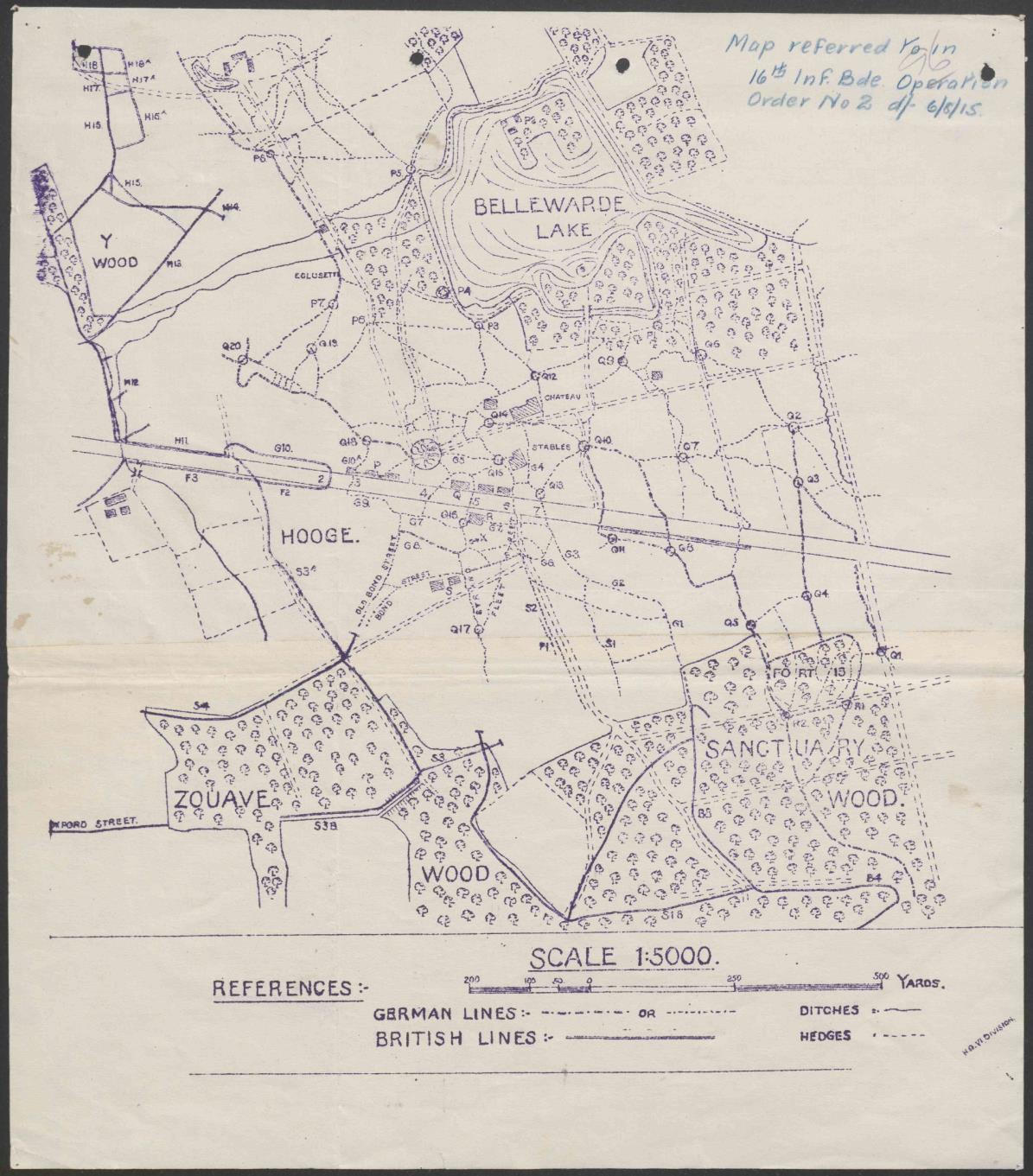
Orders were received to have two companies in readiness to move they were sent up to Sanctuary Wood at 5.05 am in support to OC D.L.I. They were sent up to reinforce the firing line [i.e. trenches G1, G2 and G3] but withdrew again to the support trenches on the north of Sanctuary Wood, being used during the remainder of the day to carry bombs, ammunition and sandbags to the captured trenches.231
This was a wretched task, all accounts describing heavy enemy shelling of this area and enfilading fire from Fort 13 throughout the day. At night (9 August) the battalion was ordered to relieve the D.L.I and Sherwood Foresters in the Sanctuary Wood trenches as far east as G1 and up G1 as far as the point where it broke through the northern perimeter of the wood.
A report in 18th Brigade HQ diary describes events thus:
The attack was entirely successful and carried through exactly as arranged, but the heavy bombardment by guns from the south and the very accurate fire of trench howitzers and machine guns from Fort 13 and other places on the right flank, rendered the position untenable. …. The enemy concentrated his fire on G1, G2 and G3 and the communication trenches, blowing them to pieces, especially G2 and G3. [These trenches were not reoccupied but] the Westminsters were ordered to place small posts on the line G1 2 3 and occupy the Stables, but in the dark they failed to find and place a post at the Stables.232
After working on this position throughout another day of fierce enemy shelling the battalion was relieved on the night of 10 August and withdrew to the huts in about three quarters of a mile north of Brandhoek, getting in about 4 am on 11 August.
Vernon’s body was lost in this action and most probably lies today on the slope running between the northern periphery of Sanctuary Wood and the Menin Road, in the area shown by the blue dotted line on the map above.
231 TNA WO 95 1616 2 2. By the end of the day it seems that the whole battalion had been moved up to help with the securing of trenches G1, G2 and G3.
232
TNA WO 95 1605 2. Appendix 1. Report on Operations of 9 August. Calculations of success / failure did not necessarily weigh casualty numbers. Total casualties for 18th Bde 9 10 August were 45 officers and 1,253 ORs.
17. the ‘93’ and their stories 100
Walsh, Lt Geoffrey Pennell 9 August 1915, Hooge SPS 1907 - 1911
3rd (Reserve) battalion Sherwood Foresters (Notts and Derby Regiment), attached 2nd battalion
Ypres (Menin Gate) Memorial Panel 39 and 41 Age 22
Geoffrey Pennell Walsh233
Geoffrey was the son of James Joseph Walsh, M.B, Fleet Surgeon (lost at sea on H.M.S Good Hope in the battle off Coronel on 1 November 1914) and his wife Mary. The Pauline describes Geoffrey’s career at SPS thus:
He was at first a member of C club, but came to Colet House in September, 1909, and spent the rest of his time there, being a House Prefect and an efficient and popular one in his last year. He got second colours in both cricket and football, and his great height and reach made him an excellent point and very useful out of touch. His best performance was in an Inter House match in which he (96) and Wainwright (203) put on 199 for the first wicket. In his last year he won the Gainer Scholarship at Pembroke, Oxford.234

233 Pembroke College Archive, PMB/N/21/1/2 College Eight, 1914 (rowing)
234
The Pauline, 33 20 Oct 1915, pp 182 83
17. the ‘93’ and their stories 101
After St Paul’s, Geoffrey proceeded to Pembroke College, Oxford where his tutor reported that ‘he took his full share of college life, his energies mostly given to the river’, where he was a member of the VII as well as the XI and XV.235 He was gazetted 2nd Lieutenant, 3rd (Reserve) battalion Sherwood Foresters on 15 August 1914 and promoted to Lieutenant on 16 May 1915. Attached to the 2nd battalion Sherwood Foresters, he proceeded to France on 16 May.
A week before his death on 9 August, Geoffrey had sent a correspondent ‘a very cheerful and interesting letter in which he said that he was in the gas area but found the plague of flies much more trying than either gas or shells.’236 The unit diary makes it clear that this is a reference to Potijze, part of the Salient that had experienced the gas attack of 22 April. After a few days (3 4 August) in billets by the Railway Station in Poperinghe, 2nd battalion Sherwood Foresters (18th Brigade, 6th Division) was sent to the Hooge sector in preparation for the attack on that place in which fellow OPs Arthur William Goodale (SPS 1908 1913), and Vernon Hall (SPS 1903 1907) were also to fight and fall. At 2.30 am on 5 August the battalion arrived at Maple Copse, where it spent a few days preparing for the attack on 9 August, the unit diary recording rare sentiment: ‘Arrangements for the attack tomorrow now complete hope it will be successful.’237 The Sherwoods’ orders were:
1) to support [2nd battalion] D.L.I in frontal assault, especially providing for protection of their right flank by occupying and holding, G1, G2 and G8 up to and including the Menin Road; and 2) to open up and improve communications by S1 and S2.238
Map showing Hooge crater and Stables, and most of the trenches referenced in Major Hobb’s Report (see below).239
235
De Ruvigny Roll of Honour 236 The Pauline, 33 220 Oct 1915, pp 182 83 237
TNA WO 95 1616 3 2 238 TNA WO 95 1616 3 2 Report on attack on Hooge trenches 9 August 1915 by Major Hobbs (11 August) 239 TNA WO 95 1614
17. the ‘93’ and their stories 102
Aerial photograph of Hooge, clearly showing the crater, the Menin Road, Zouave Wood and most of the trenches referenced on the above map. (The photograph was taken immediately after the explosion of the mine, 20 July 1915, clearly visible the centre of the image.)240
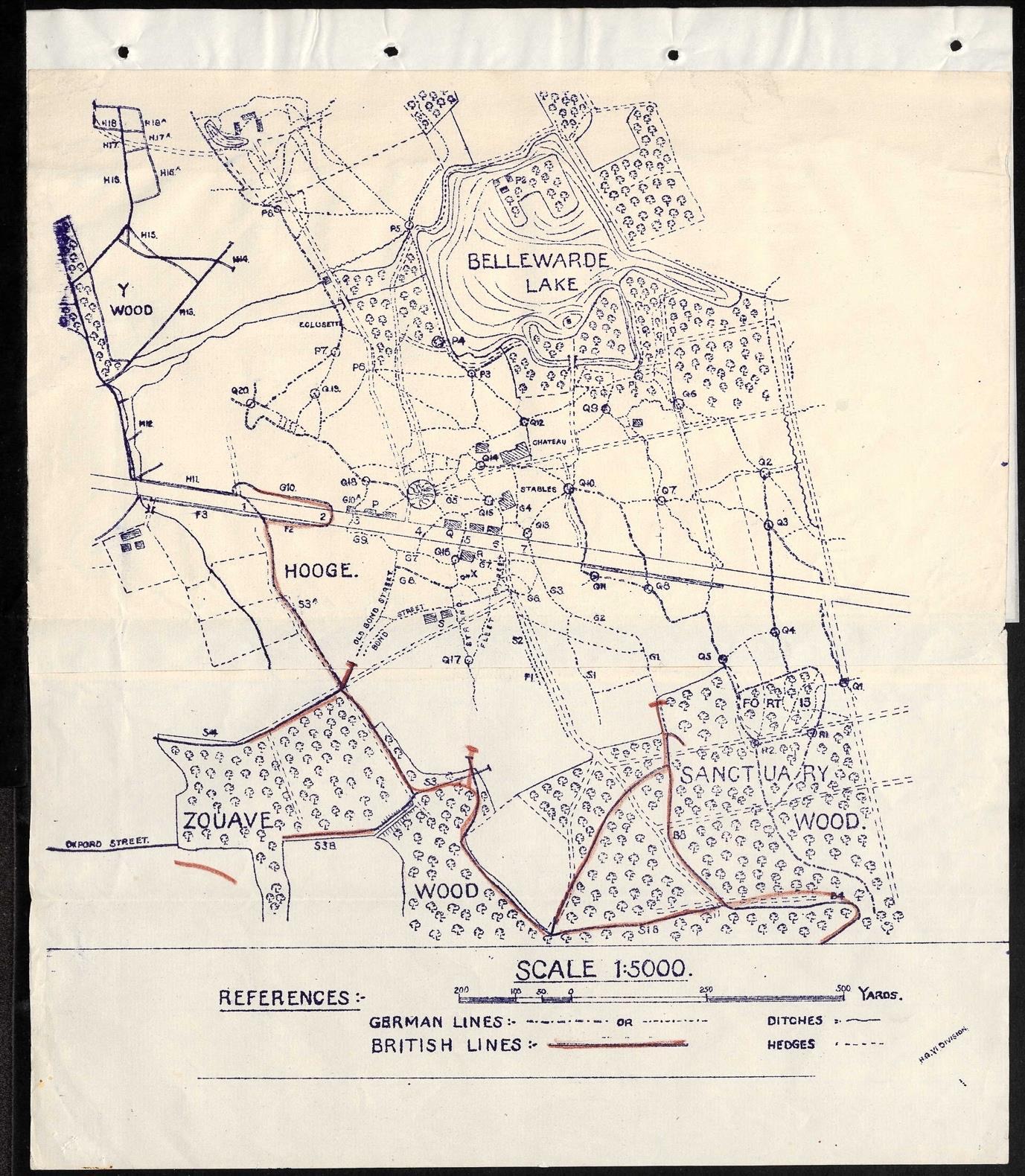
9 August
2.30 am 2 companies in [trenches] G1 and B8. Head of leading coy about 50 yards north of saphead.
©CrownCopyright
1 coy in trench orginally occupied by D.L.I [2nd battalion, Durham Light Infantry] as their front trench.
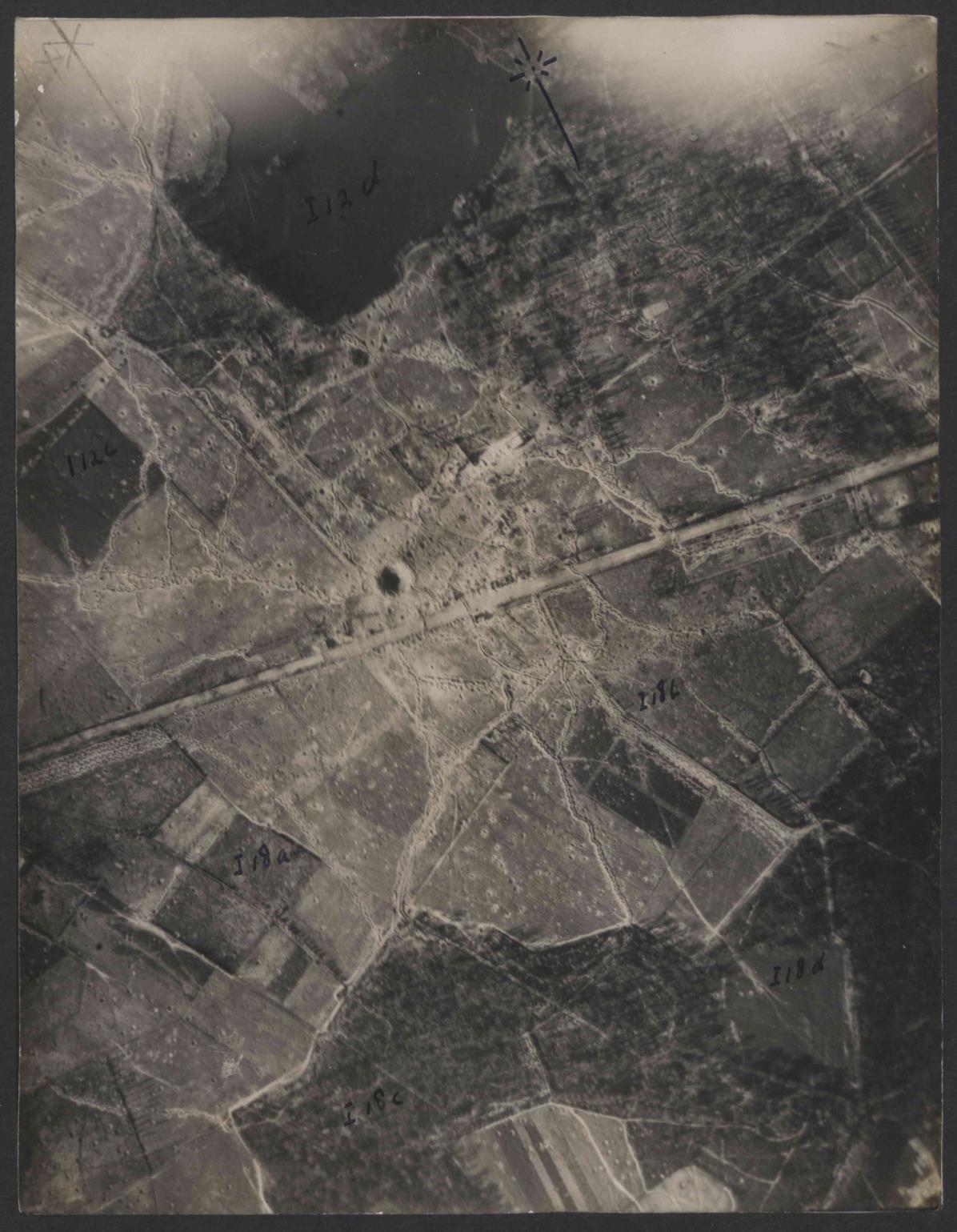
½ coy in DLI original left support trench.
½ coy told off as wiring and carrying parties distributed at 3 dumps at South ends of G1, S1 and S2 respectively.
2.45 am our bombardment started.
2.55 am German retaliation started, shells dropping in and around D.L.I original front trench and G1 and B8.
the ‘93’ and their stories
3.10 am Bn started to advance. The two companies up G1, G2 proceeded by strong bombing party, apparently met first opposition about 50 yards east of junction G2 S1 which was quickly overcome by bombers. At the same time 2 platoons pushed up S1 and S2 S1 being found practically useless as a communication trench, affording no cover, half full of water and dead men and impossible to dig. German shelling all these trenches.
3.35 am slight lull in German shelling.
3.45 am wounded Sgt of D.L.I reported that the front trenches had been taken and prisoners captured.
4 am one platoon of my support ½ company pushed up G1 to join up with near of the two companies on right flank.
7.55 am received report from OC my leading company on right that the line was established from the Crater via the Stables.
Heavy enemy fire from Direction of Fort 13.
…
11.05 am Intense German bombardment started principally on G1, G2 and G3.
11.10 am MG opened fire from direction of Q5
11.30 am Rough estimate of casualties up to this [point], 8 officers and 300 Rank and File.
…
1 pm Message from G6 only 20 men left in that Company which was still being heavily shelled …
2.30 pm The whole of G2 and G3 and most of G6 appeared to have been completely flattened out.
9.45 pm … About 30 men rejoined the battalion after dark the sole survivors of the original garrison.241
The attack was disastrous. The battalion suffered casualties killed, wounded and missing of 463.
Geoffrey’s entry in De Ruvigny asserts that he was ‘buried in Sanctuary Wood, Hooge.’242 However, the sustained enemy shelling and later fighting destroyed his grave and thus he is commemorated on the Ypres (Menin Gate) Memorial.
241 TNA WO 95 1616 3 2 Report on attack on Hooge trenches 9 August 1915 by Major Hobbs (11 August)
242 De Ruvigny Roll of Honour
17. the ‘93’ and their stories 105
Barnett, Lt Denis Oliver (known as ‘Dobbin’) 16 August 1915, Hooge SPS 1907 1914
2nd Bn. The Prince of Wales’ Leinster Regiment (Royal Canadians), A Company Poperinghe New Military Cemetery I.E.16
Grave epitaph: Captain of St Paul’s School, Scholar-Elect of Balliol College, Oxford Age 20
Denis Oliver Barnett243
Denis or ‘Dobbin’ to use the nickname presumably derived from his initials was born in 1895. For most of his first twelve years he was educated at home. In 1907 he entered SPS, of which he became a Junior Scholar in 1908 and a Senior Scholar in 1910. He was Captain of School for two years and played for three years as wing three quarter in the 1st XV. By all accounts he was a first class scholar of Classics. He won a Balliol Exhibition aged 17 & ½ years of age and the Balliol Scholarship at 18 & ½. He left SPS in the summer of 1914 and was about to go to Oxford when war broke out. He also had a full taste for the outdoor life and for sport he was ‘easily first in the school Sports at putting the weight’.244 ‘He learned early to ride and swim and became an excellent shot. He enjoyed thoroughly a long tramp with his gun at [his childhood home] Burnt Hill, or a day’s wild duck shooting in the Essex marshes with his schoolmaster Mr L. H. S. Matthews, between whom and his pupil existed one of those friendships which are the peculiar privilege of public school life.’245
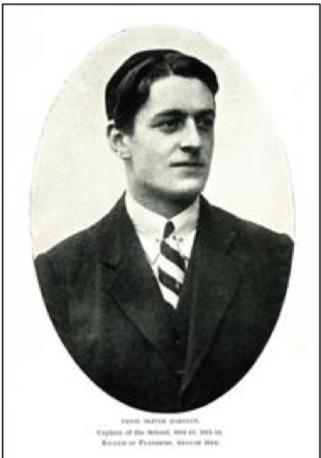
243
The Pauline, 33 20 October 1915 p. 178
244 Barnett’s throwing prowess was recognised in the trenches, as recorded by the 2nd battalion Leinster diarist. TNA W0 95 1612 2 16 April: Sent one officer (2nd Lieut Barnett) to B.H.Q for instruction in use of ‘Tonite’ hand grenades. (Tonite was a type of explosive.)
245 F.H.D in the Preface in Denis Oliver Barnett, In Happy Memory, His Letters from France and Flanders, October 1914 August 1915, p viii
17. the ‘93’ and their stories 106
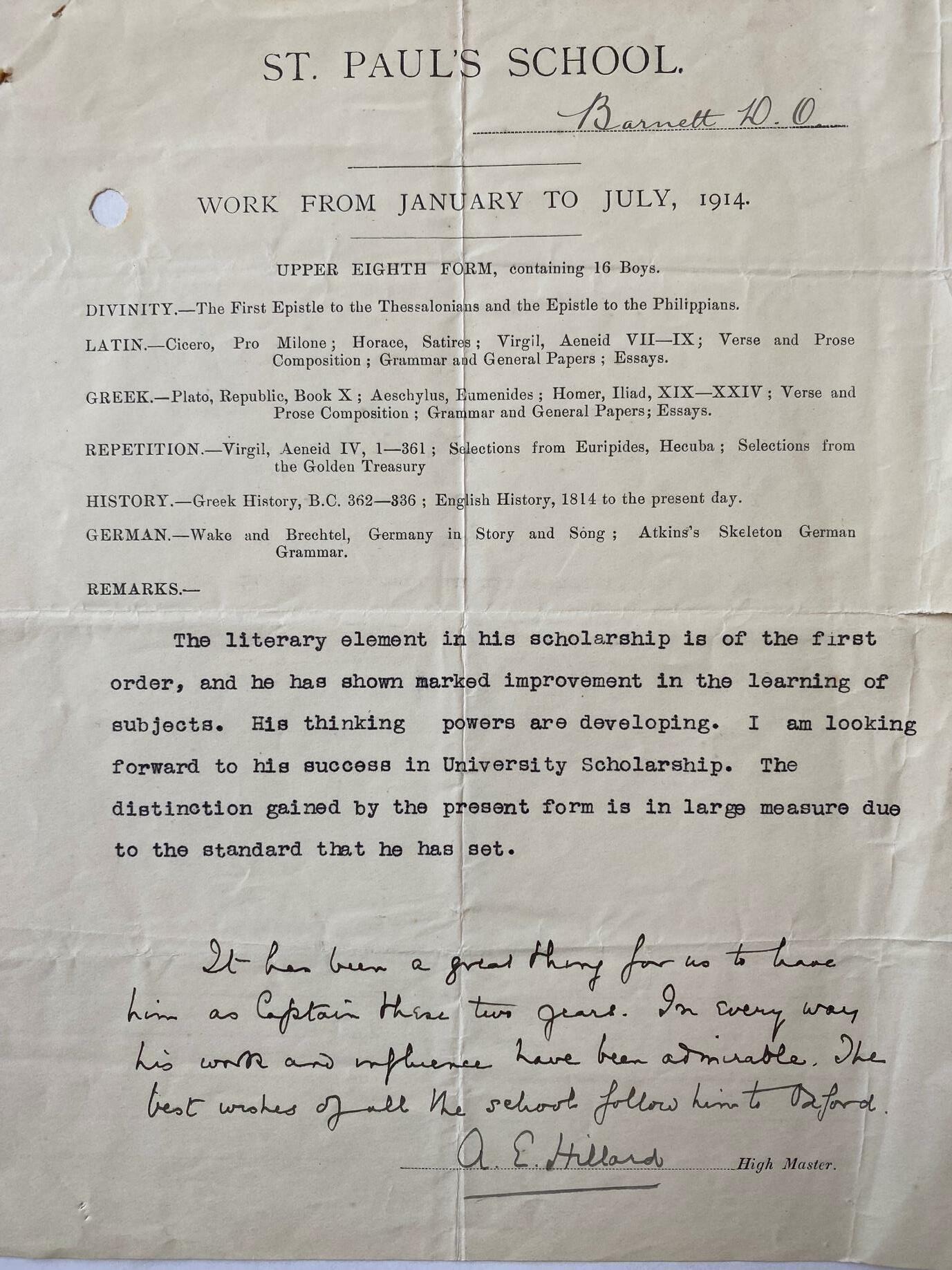
In August 1914 Dobbin enlisted in the Artists’ Rifles and by 27 October of that year he was in France. He was gazetted 2nd Lieutenant in the 2nd battalion Leinster Regiment on 1 January 1915 and on 10 June of that year was promoted to Lieutenant.
In addition to the various war diaries, there exist three particular sources from which much detail about Dobbin’s experience as a soldier can be gleamed. The first of these is an account written by Captain F. C. Hitchcock, Stand To, A Diary Of The Trenches 1915 1918. 247 Before his transfer to C Company 2nd Leinster Regiment, Hitchcock had been in command in No. 3 platoon, A Company. As an officer in the same Company as Dobbin, it is likely that the two men got to know each other well certainly, Hitchcock mentions Dobbin by name on several occasions in ‘Stand To’. The second source is Dobbin’s collection of letters, to which he added almost daily. These letters were privately printed in book form in 1915, presumably by his family. Collectively they provide a compelling description of his experiences.248 Brilliantly contrived, Dobbin’s correspondence assumes a tone that is sufficient to blind the censor’s pen. For instance, in a letter dated 8 June and written when located in ‘Support Trenches’, Dobbin informed his reader that:
It is very hot and nice [here]. We have been working all night at the trench, and have got it very good. … We’ve got a parapet here about ten feet thick, which is about the best I’ve seen, and it would take a healthy shell to make much difference to it. … To return to general topics, I don’t want any more shirts thank you. What I really want is things like sardines, tongue, or any interesting explosive in a metal case. The cream cheese you sent died on the journey. … You wis askin’ about my Iron Cross all I know is that I was recommended for something, don’t know which of them. It was for carrying some wounded machine gunners out of a farm that was being shelled. It think they all died, so it was a wash out. By Jove, this is splendid. It is hotter than most English summers, and the larks are singing away. I’ve heard the nightingale, the he was not in awfully good form, not going as strong as I am. I’m most amazin’ fit and happy.249
The third source is the remarkable correspondence between Dobbin and his sister, Charis. Some of this material differs distinctly in tone and content from the letters written to his parents. For instance, while in ‘Support Trench’ at 5.15 pm on 9th June, Dobbin complained to Charis that:
247 Hitchcock, F. C, Stand To, A Diary Of The Trenches 1915 1918
248 These letters were privately published in book form in 1915. One hundred and fifty copies were printed. Denis Oliver Barnett, In Happy Memory, His Letters from France and Flanders, October 1914 August 1915
249 Barnett D. O, Letters, pp 163 165
17. the ‘93’ and their stories 108
Things are bloody just at the moment. We’ve been badly shelled with Jack Johnson’s and Will has been hit pretty badly, besides a Sergeant and 5 men. I’m getting fed up with this Captain of ours whom I liked at first. He is a silly old woman and quite incapable. It is rotten losing old Will. He was such a nice cheerful boy. … Thank goodness the enthusiasm has got me entirely or this would be rotten.250
In early August 1915 the 2nd battalion Leinster Regiment (17th Brigade, 6th Division) was in divisional reserve in billets in Poperinghe, set to move on 10 August via Vlamertinghe to dug outs in ramparts south of the Menin Gate in Ypres prior to occupying front line trenches at Hooge.251 Upon his arrival in Ypres on 10 August, Dobbin was put in charge of a working party and immediately sent up to Hooge to work on the trenches newly taken, but badly damaged in the recent fighting. He described events in his letter dated 10 August:
It was my fate to go and dig as soon as we arrived. We went to the scene of the last show [i.e. the attack at Hooge on 9 August], and the place is beyond description. It’s where there’s been more business than anywhere else, and looks every bit of it. There were droves of R.A.M.C people and stretcher bearers carrying wounded back, and the shell fire was terrific. The Allymans [i.e. Germans] smothered the road [i.e. Menin Road] and communications with shrapnel all night, and I tell you there have been times when I’ve been less afraid. … I had to take thirty men on to an advanced place, and jumped out of the trench onto the road. We ran right through three shrapnel bursts, and arrived finally at our destination with only one casualty. It was more like an attack than a respectable digging party. I got buried by a six inch crump [i.e high explosive shell] at one stage of the proceedings, and those big fellows combined with shrapnel aren’t much fun … My party were working for a long time in the crater, which is a good sized Chaos by itself, and not too salubrious.252
The map below, located in 2nd Durham Light Infantry battalion diary, clearly shows Hooge, the crater (represented by the hatched circle) and the network of associated trenches.253 (The red dotted line, inserted by the 2nd D.L.I battalion diarist, shows the furthest extent of the line taken by 2nd D.L.I on 9 August.) The yellow line in this image shows the trench occupied by A and B Companies 2nd Leinster at the time of Dobbin’s death. 1 and 2 show the two most plausible locations where he was shot, with number 1 the most likely. (See text below.)
250 SPS Archives. Exhibition Material SPS BARNETT/7. The Barnett Family, St Paul’s and the First World War, Letter from the Support Trenches, 5.15 pm, 9 June 1915 p 19
251 Barnett describes them as ‘very decent burrows’. 10 August, Letters p 219
252 Barnett, Letters p. 219. 13 August Herewith shoulder strap from Hooge crater. Don’t tell the policeman. All O.K. Barnett, Letters, p 220
253 TNA WO 95 1617 1
17. the ‘93’ and their stories 109
The map below, discovered in 1st battalion Buffs (East Kent Regiment) the unit that 2nd Leinsters relieved on 10 August shows the main trenches running up to the front at Hooge.254

An unnamed fellow officer in B Company, writing after Dobbin’s death, reported to the dead officer’s brother that:
Your brother's company and mine went into the front line for the 14th and 15th [August]; I held the crater, and he the trench on the left of it. 'Twas pretty exciting work, as they shelled us continuously and attacked us with bombs each evening. Your brother was bomb officer and was in his element, leading all the bomb counter attacks successfully, and never getting a scratch. As you know, he can throw extraordinarily well, and he used to frighten the Germans by getting Tonite bombs right into their trenches 150 yards away.255
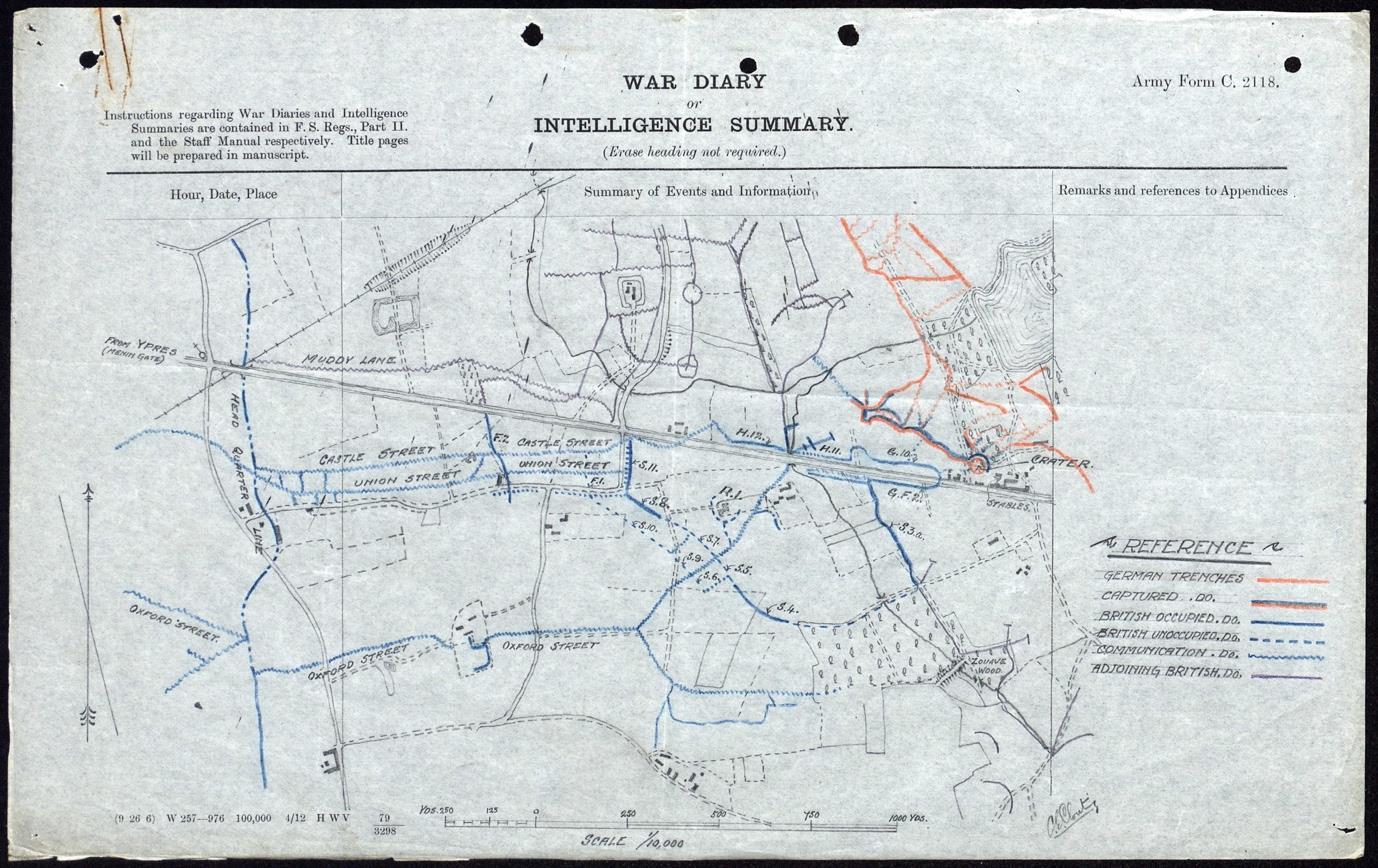
All sources agree that the landscape in which Dobbin found himself was hellish. Hitchcock described it thus:
Here and there, where portions of the trench had been obliterated by the shells, legs and arms in the German field grey uniform stuck out between piles of sand bags. Thousands of rounds of fired and unexpended cartridges lay about the parapets, and grounded into the bottom of the trench. German Mausers, equipment, helmets, and their peculiar skin covered packs lay everywhere. The ground was littered with portions of the enemy uniforms saturated in blood. Serving the Ypres salient one was not unaccustomed to seeing men
255 Barnett, Letters p. 223. In his letter dated 19 July Barnett stated that ‘I’ve been made Battalion Bomb Officer with a command of some 140 dangerous criminals besides by own platoon’. Barnett, Letters p 214
17. the ‘93’ and their stories 111
blown to pieces and, therefore, I expected to see bad sights on a battlefield but I had never anticipated such a dreadful and desolate sight as Hooge presented, and I never saw anything like it again during my service at the front.256
In the late evening of 15 August, as recorded by the 2nd Leinster diarist, after ‘considerable shelling all day, ending with a severe bombardment of trenches near [the] crater about 6.30pm’, Dobbin was ‘severely wounded whilst superintending the relief of Companies’ [i.e. A and B Coys, having been in the front line since 13 August, were in the process of being relieved by C and D Coys.]257
The same unnamed officer of B Coy who had described Dobbin’s bomb throwing prowess, writing to Dobbin’s brother, also gives details as to the circumstances of his death:
At 9 p.m. [on 15 August] working parties came up to bury the dead, improve the existing trenches, and dig new ones, and we had to start them working ourselves.258 Your brother had to start one at a place where our trench touches the German trench with only 20 yards of unoccupied trench in between. He was warned to be careful, as the Germans had a machine gun and several rifles trained on the spot, but with his usual courage he got up on the parapet, and from there directed the working party. A flare showed him up, and he was fired at immediately, and one bullet hit him in the body. He was carried in and bound up at once, and in half an hour was back at the dressing station, where they made him as comfortable as possible, and gave him sufficient morphia to deaden the pain. When I had got my company [i.e. B] and my dead and wounded out, I went to the dressing station [most likely the Regimental Aid Post at Birr Crossroads] to see how he was, and found him lying on a stretcher looking very white, but as calm and peaceful as a statue. I bent over him, and he recognised me at once, and said that I could do nothing for him. … I stayed with him for half an hour, and then had to go away with my company. He made no complaints and wanted nothing, and he died very shortly afterwards, when they had taken him to the Field Ambulance [at Poperinghe].259
Hitchcock also references Dobbin’s wound and death:
15 August. Barnett got a bullet through the stomach when he was guiding a working party of the 1st North Staffords along the Menin Road. … C and D Companies took over the front line [from A and B Companies] again at 9 p.m.
256 Hitchcock, 12 August. Hitchcock, F. C, Stand To, A Diary Of The Trenches 1915 1918. Hitchcock served throughout the war and his account was published in the 1930s.
257 TNA W0 95 1612 2
258 These ‘working parties’ were composed of troops from 1st battalion North Staffs
259 Barnett, Letters pp 223 224
17. the ‘93’ and their stories 112
16th August. Barnett died of his wounds. The Doctor told us that he stuck his wound splendidly, and that men who were only hit in the arms and legs were groaning all round him in the dressing station. Barnett had a presentiment that he would get killed, and told us so when we got orders for Hooge.260
Map showing the Regimental Aid Post at Birr Crossroads (shown on the extreme right), though which Olvier was probably evacuated.261 The inserted image top left shows the aid posts to the west of Ypres; Poperinghe is off the map to the left.

The sources do not provide definitive evidence as to the exact location in which Dobbin received his fatal wound. On the one hand, the reference by Hitchcock to Dobbin having been struck while guiding a working party ‘along the Menin Road’ is entirely plausible and significantly references the experience that Dobbin himself describes in his letter of 10 August, quoted earlier. Scrutiny of the map evidence suggests that at the location indicated by ‘2’ (see earlier maps) there was neither a tunnel under the Menin Road nor a trench
260 Hitchcock, F. C, Stand To, A Diary Of The Trenches 1915 1918 261 TNA WO 95 1592 1
17. the ‘93’ and their stories 113
across. Perhaps this was the place in which Dobbin describes how, on 10 August, he had ‘jumped out of the trench onto the road’ and perhaps he was now only doing the same. On the other hand, the account by the unnamed officer of B Company, asserting that Dobbin fell at ‘a place where our trench touches the German trench with only 20 yards of unoccupied trench in between’ (shown as ‘1’ on the maps) is perhaps more convincing.
Although written to accompany Dobbin’s Letters and therefore eulogistic in tone, a fellow officer who was at that time in the same line as Dobbin (though on the right of the line, whereas Dobbin was on the left), quite possibly witnessed the events he describes whereas Hitchcock was in a support trench with C Company some distance in the rear.
Dobbin is buried in Poperinghe New Military Cemetery, some 10.5 kms west of Ypres town centre. In light of the above evidence, and because there existed at this time a functioning cemetery at Birr Crossroads where surely Dobbin would have been buried if he had died quickly from his wounds it seems certain that he died in the Advanced Dressing Station in Poperinghe on 16 August from the complications of a bullet wound received at Hooge in the late evening on the previous day.
17. the ‘93’ and their stories 114
Bunnett, Private William George, No. 3 (or C) Company 20 September 1915, Hooge SPS 1913 - 1914
1/1st Bn. Honourable Artillery Company Brandhoek Military Cemetery I.E.4 Age 16262
William was enrolled at SPS between 1913 and 1914. The Pauline provides no details on William’s school career, though his attestation documentation makes it clear that he had participated in the school’s O.T.C. He enlisted in the Honourable Artillery Company on 19 April 1915 and was enrolled in 1st battalion H.A.C (7th Brigade, 3rd Division), aged 16 years, 3 months and 29 days. William was thus underage by almost two years, though it was by no means unusual for underage recruits to present and to be recruited.
After training William was sent overseas on 18 August. Unfortunately the battalion unit diary for September 1915 appears not to have survived and therefore details relating to the fate of William have to be gleamed as far as possible from alternative sources, such as the diaries of other units that were in the line at Hooge at this time and the official history of the H.A.C in the war.263 These sources collectively suggest that William was fatally wounded when he was in the front line at Hooge, probably on 19 September, having moved up to that position the day before.
William’s H.A.C Record Card264
262 On his attestation form, signed on 19 April 1915, William’s age is stated as 19 years and 4 months. Census data shows that in 1901 his mother was a 29 year old widow and likely remarried by the time of the 1911 census, making it difficult to locate the family in that census. William’s effects were sent to 54 Radcliffe Square, South Kensington.
263 Walker, G. Goold, The Honourable Artillery Company 1914 1919 (1930)
264 © Image reproduced by courtesy of the Trustees of the Honourable Artillery Company, Armoury House, City Road, London EC1Y 2BQ
17. the ‘93’ and their stories 115
The great attack at Loos took place on 25 September and was preceded by a six days’ continuous bombardment along the whole of the British line. It was arranged that a “holding” attack on a much smaller scale should be made simultaneously in the salient, and, although the H.A.C. took no active part in this attack, we were assigned the unenviable task of occupying the trenches during the previous six days. We moved up to Hooge on the night of 18 September and found ourselves in occupation of the trenches in front of Bellewarde Lake, including the famous “Crater.” The whole area resembled something between a ploughed field and a miniature reproduction of the Alps, full of large holes and hillocks thrown up by shells. Strictly speaking, the bombardment was not actually continuous, but many times each day the enemy trenches were treated to a regular tornado of shells which provoked a retaliation equally fierce. Only during the few hours between midnight and 3 a.m. was there any definite respite, and, as many of the trenches were regarded as unsafe and almost useless, their occupants were ordered to retire to narrow communication trenches, where they lay all day, leaving only a few guards in the line itself. The new Medical Officer, Capt. R. S. Morshead, brought up the Battalion First Aid Station to a culvert under the Menin Road in the support line, where he did gallant work attending to the many casualties. No. 4 Company H.Q. dug out was situated on the rim of the crater itself, and a high explosive shell fired by the Boche from our right rear burst in the entrance, killing instantaneously Capt. W. C. Hayden, Lieut. G. M. Bazin, the Acting Adjutant, Lieut. H.
the ‘93’ and their stories

Ommundsen (the King’s Prizeman) and Lieut. S. Leeds. Three of the bodies were found at once, but it was not until after Battalion H.Q. had rung up the front line to enquire for the Adjutant that it was found that he too had been in the dug out at the time. It was a great blow to the Battalion to lose so fine a Company Commander and three such excellent subalterns at one blow. During these six days the Battalion suffered over 100 casualties, though having no active work to do. On the night of September 24th we cut the wire in front, put up the scaling ladders, and handed over to the 2nd Royal Irish Rifles, the 2nd South Lancs and the 4th South Lancs. The remaining 140 men then left the line and went into reserve in a field near Dickebusch. The attack took place the following morning, but only resulted in enormous casualties, any temporary gains being lost almost at once.265
The 7th Brigade diary confirms the regular shelling and indicates that the H.A.C were in a particularly exposed part of the line:
[The 19 24 September] was a period of daily and nightly bombardments by our own and the enemy’s artillery … A trying time for the H.A.C and Worcesters, whose defences were more or less demolished every day, trenches had constantly to be cleared for close registration or bombardment of certain points by day which interfered considerably with rest by day in fact, between work by night and artillery fire by day, sleep was hard to come by. The cheerfulness of the troops under these conditions was remarkable, particularly noticeable in this respect were the H.A.C grenadiers, who were on duty for six continuous days and nights in advanced posts in front of the crater [at Hooge]. These posts were not withdrawn for bombardments or registering, and were in places not more than 15 yards from the enemy’s front line. Frequent reconnaissances were carried out at night to try and discover the state of the enemy’s wire and special officers detailed to make daily observations. … On the night of 24 25 Sept, the 2nd South LLancs on the right between the Menin road and the Crater and the Irish Rifles stretching from the Crater to the left of C7, where they joined up with the K.O.S.L.I of the 42nd Bde 14th Division, relieved the H.A.C.266
Map showing the front line north of the Menin Road occupied by 1/1st H.A.C during the period 18 23 September, extending from where it touches the road on the right to C7 on the left.267
265 Walker, G Goold, The Honourable Artillery Company 1914 1919 (1930)
266
267
TNA WO 95 1413 1
TNA WO 95 1421 1
17. the ‘93’ and their stories 117
Map from V Corps diary showing the trenches occupied by William and the advanced posts in front of the crater.268

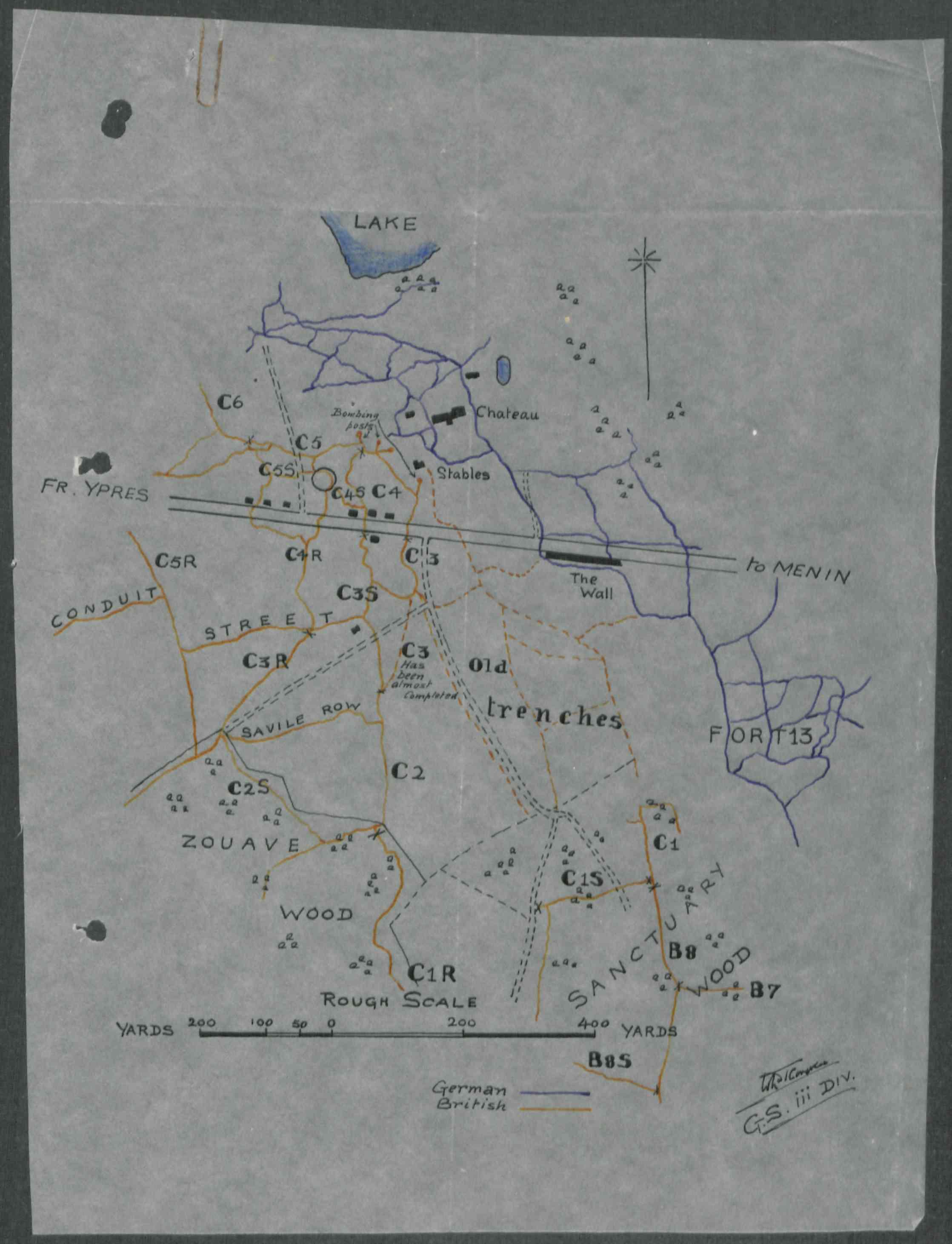
Grave Registration Report Form showing the entry for William.271
the ‘93’ and their stories 120

Bullock, Captain Arthur Ernest 26 September 1915, Sanctuary Wood SPS 1901 1908

Royal Army Medical Corps attd. 4th Bn. The Duke of Cambridge’s Own (Middlesex Regiment)
Brandhoek Military Cemetery, I.A.25
Grave epitaph: E’en As He Trod That Day To God So Walked He From His Birth Age 26
A. E. Bullock272
Arthur was the elder son of Joseph Ernest Bullock and his wife, Ada. He was educated at Colet Court and St Paul’s School. At the time he left School from the Science VIIIth to enter St. Mary's Hospital, Arthur was a School prefect, Captain of D Club, and Captain of Swimming and Gymnastics. In 1907, with W. G. Hull, he won the Inter Public School Challenge Shield for Gymnastics at the Aldershot competition. In the same year he became Captain of Swimming. ‘It was a critical time in the history of the club; the material was all untried, but from it he produced a most successful team.’273 While at St Paul’s he gained both the Junior and Senior Scholarships and the leaving Exhibition.
While at St Mary’s Hospital, Arthur contributed to the Mission at King’s Cross that was then associated with SPS. He ‘attracted [young men] by his skill in athletics and the lessons he gave them in gymnastics so that many of them still practice the exercise he taught them in order to increase their chest measurement and thus pass the test and get into Khaki’.274
Honour 274 Obituary, A. E. Bullock, St Mary’s Hospital Gazette, 21/8 (October 1915)
17. the ‘93’ and their stories 121
After qualifying, Arthur held various house appointments at St Mary’s, and for some years represented the Hospital at football and swimming. Arthur also became an undergraduate at the University of London and was about to go up for his M.B. when war broke out. On 10 August 1914 he was given a commission as Lieutenant in the R. A. M. C, and after a few weeks in France, volunteered for service with a regiment. In early September he was duly appointed Medical Officer to the 4th Bn.Middlesex Regiment, promoted to Captain in the same month. He was present at several of the engagements round Hill 60, Ypres, and Hooge and was twice mentioned in Despatches (17 February 1915 and 1 January 1916).
For the two weeks preceding the death of Arthur, 4th battalion Middlesex (8th Brigade, 3rd Division) had supplied substantial working parties in Sanctuary Wood employed upon building dugouts, salvaging equipment, carrying up materials, digging trenches and generally trying to restore the sector to something of the condition it had been in before the fighting of 9 August. All of this effort was in order to make ready the trenches for an attack on the German positions scheduled for 25 September, a strategy designed to commit the Germans to this part of the front while a larger operation undertaken by the British and the French took place at Loos.
On 25 September 8th Brigade had assumed position in the line at Sanctuary Wood, with three battalions in the firing lines and 4th Middlesex in reserve in the vicinity of Maple Copse. At 3.50 am the final bombardment of the enemy’s trenches began; then, at 4.19 am, two mines were exploded under the enemy lines opposite ‘the Nose’, a dangerously exposed salient in the British line occupied by 2nd Bn. Royal Scots. The shock effected by the firing of the mines, combined with some effective shelling, meant that in the first instance all frontline units of the 8th Brigade achieved some notable success, some reaching the German lines. However, in places the wire remained uncut and all units eventually suffered from a shortage of bombs (i.e. hand grenades) and endured intense enemy shell fire.
Having enjoyed significant early success, by 6.55 pm ‘[all units] were therefore [back] in their original trenches, having [at one point] taken both lines of German trenches except at Hooge and on the Menin Road and having lost them all again.’275 In a series of unusually critical remarks referencing in particular a shortage of bombs, the 8th Brigade unit diarist concluded his remarks on the attack by recording that ‘the net result of the operations were that we did not gain a yard of ground anywhere but lost close on 1,000 officers and men in the 8th Bde alone.’276
17. the ‘93’ and their stories 122
Map
showing the most forward position reached by the attacking units.
Clearly, Arthur had been lucky to survive the events of 25 September. Within twenty four hours, however, he was dead, apparently killed by a stray bullet. There exist a number of accounts that reference the death of Arthur.
In the entry for 26 September the 4th Bn. Middlesex diary states that:
[The unit] worked all day on the firing line and communication trenches and at night on the end of the B4 salient which had been too badly damaged by the previous days bombardment to be occupied. At about 11 pm our bombers saw some Germans just in front of them and bombed them back to their lines. Lieut. Farr and Sgt. Remnant, the bombing office and Sgt. reaching the German and trench in the enterprise. Lieut. Farr was badly wounded in the leg by a shell splinter just after getting back to our line. This enterprise started a large artillery duel as news reached the Brigade that we were being attacked and they sent the SOS signal around the field batteries who immediately opened rapid fire which spread to the heavy artillery. A great deal of confusion started amongst the working parties in the rear of the firing line and the ration parties at the dump but all was quiet again in about three quarters of an hour. Another working party was out at the time making an old sap into a firing trench; this work had to cease temporarily. The firing line was blown in in several places again but was repaired by dawn. Casualties chiefly owing to this bombardment: Capt. A. E. Bullock
17. the ‘93’ and their stories 123

R.A.M.C and second Lieut. H. P. Oche and two men killed. Lieut. Farr P.W. and 22 men wounded. Second Lieut. G. C. Redpath slightly wounded. The medical officer [i.e. Bullock] who had been continuously with the battalion since 14 September, 1914 was killed by a stray bullet on the dumping grounds.
The reference to ‘dumping grounds’ is not entirely clear, though the context suggests that Arthur was shot while in the ration dump. The location of the ‘dump’ is likely referenced in this account referring to the period 20 June 1 October 1915, produced in 1920 by W. C. C. Weetman:
There was a good deal of liveliness on both sides, and things were anything but pleasant in the region of a wood [i.e. Sanctuary Wood], whose title was something of a misnomer. The Transport too, had many good runs for their money when bringing up rations and stores. … We were not particularly envious of their job here on many occasions, though never once did they fail to get supplies up to the dump. This was at the South West corner of ‘Sanctuary Wood’, and a very unhealthy spot, where we were lucky indeed in not getting very heavy casualties.277
A ration dump in Sanctuary Wood. The notice board reads, ‘No road by daylight’278

277
278 (IWM). Image also in MacDonald L, 1915, The Death of Innocence (1994)
17. the ‘93’ and their stories 124
Weetman, W.C.C. The Sherwood Foresters in the Great War 1914 1919 / History of the 1/8th Battalion (Kindle Locations 811 813). 1920Some further details appertaining to the death of Arthur are provided by the following accounts:
There has been an attack made by our brigade lately, and while Arthur was going to attend to a wounded man he was shot through the head and killed instantly. … We were boys at camp together at Studland before he left St Paul’s School and several times since then. … I buried him at 2.15 yesterday at Brandhoek, and though the battalion was in the trenches, there was a large attendance of transport men, and also doctors and orderlies from the Field Ambulance. It was a most impressive service. He was carried from the dressing station to the cemetery on the shoulders of Middlesex sergeants, led by the drum and fife band playing the ‘Dead March’ from Saul. Colonel Whaite, Assistant Director of Medical Services said … “it was most unfortunate that [Captain Bullock] should have been killed by a stray bullet after he had passed unscathed through the big fight of the day before.”’279
This account is from an anonymous source published in The Pauline:
To day I came across the stretcher bearer who was actually with [Captain Bullock] when he was called to the higher service. It appears he was going to an advanced dressing station in Sanctuary Wood at Ypres when he was struck by a glancing bullet from a tree, death being instantaneous, the unfortunate man being hit in the head. He was buried alongside one of his stretcher bearers who had been killed the day previous. I think the last letter he wrote was to this fellow's people as a mark of sympathy. The glowing tributes these fellows pay to him show that he was as popular and as highly esteemed out here as he was with the boys at the Mission. They are all time serving soldiers, and you may be sure that what they say they mean. “Tommy is always plain and outspoken. Admiration is the keynote of their conversation. They cannot say too much in his praise. His heart and soul was in his work, they say, and he would never send anybody where he would not go himself and there was nowhere where he would not go. He never knew what fear was, but was always ready wherever and whenever he was wanted.” These are the actual words of one who worked with him.280
Weetman’s account locates the ‘dump’ at no great distance from Maple Copse, at the north eastern corner of which was situated ‘medical collecting posts’.281 It seems plausible to suggest, therefore, that either Arthur was killed whilst seeking fresh medical supplies
279
De Ruvigny Roll of Honour. Rev. R. Crisford, Chaplain 8th Brigade, 3rd Division, 27 September 1915
280 The Pauline 35 232 June 1917 p 68
281 TNA WO 95 745 3
17. the ‘93’ and their stories 125
from the dump or alternatively or perhaps additionally that he was shot whilst assisting a wounded man, likely in the vicinity of the dump. The last of the accounts presented above seems highly reliable and indicates most likely of all that Arthur was moving forward, probably from the collecting post in Maple Copse to the firing trenches in order to assist men injured in the ‘large artillery duel’ that had commenced from 11 pm. Arthur’s body was removed from this place and taken for burial at Brandhoek, an established Dressing Station mid way between Ypres and Poperinghe.
17. the ‘93’ and their stories 126
Goldsworth, Lt Duncan William 26 September 1915, Hooge SPS 1907 1911

2nd Bn. The Prince of Wales’s Volunteers (South Lancashire Regiment) Ypres (Menin Gate) Memorial, Panel 37 Age 21
Duncan was born in Brentford in 1894, the eldest son of David Goldsworth, a bank worker, and his wife Catherine. The parental home was 36 Marlborough Rd, Southport, Lancashire.
At age fifteen Duncan was a boarder at St Paul’s, residing at The High House, Brooke Green, Hammersmith presided over by his Housemaster, Henry Barrington Tristram. The Pauline is mostly silent as to any of Duncan’s activities or achievements whilst at SPS but it is known that after leaving St Paul’s he went in January 1912 to work as an apprentice at the Bootle Branch of Parr's Bank (in Wigan) where his father was a manager. His familial ties to the north west, and his return there after St Paul’s, explain his choice of regiment: The Prince of Wales’s Volunteers (South Lancashire Regiment). He initially attested for 3rd (Reserve) battalion, and at some point transferred to 2nd battalion in that regiment.
282 Reproduced by kind permission of NatWest Group © 2020
17. the ‘93’ and their stories 127
Duncan William Goldsworth282On 23 September 2nd Bn. South Lancs (7th brigade, 3rd Division) set about fulfilling orders to participate in the attack planned for 25 September in the Hooge sector. The unit thus marched at 9.30pm from their bivouacs just west of Brandhoek and relocated some three miles to the east, in the vicinity of Kruisstraat, establishing bivouacs not far from Belgian Chateau. It rained until midnight. On the following day the battalion diarist recorded that:
[There was] considerable activity amongst the artillery, both ours and the enemy’s, throughout the whole day. Many shells passed over the battalion bivouac. The battalion left the bivouac about 6.30 pm and marched to a position in the vicinity of Hooge, arriving about 9 pm and at once proceeded to occupy various trenches allotted … Very heavy rain during the night and this hampered movement considerably.283
The 7th Brigade diarist also noted the shelling:
19 24 Sept. This was a period of daily and nightly bombardments by our own and the enemy’s artillery. We had one regular fixed programme for each 24 hours of from half an hour to 50 minutes. The enemy made it his business to institute the same. Sometimes these hours coincided; when they did not the infantry [who were] bombarded at once asked for retaliation. It followed that some portion of the line usually underwent two very considerable bombardments in each 24 hours, while no one got off without one. … Trying as the week unquestionably was, the sound of our own guns firing behind, and the sweep of the shells over the heads of the troops going in the right direction made up for many discomforts.284
By midnight on 24 September the 2nd Bn. South Lancs was deployed in position in the front line between the Menin Road and the vicinity of the crater, ready to undertake the attack against the German trenches opposite in the early hours of the following day. The unit was assembled for the assault with two Companies in the front line (Company A on the right; Company B on the left) and the other two in reserve. (Unfortunately, it is not known in which Company Duncan served.)
Map showing the British and German front lines in the Hooge sector and the section of line attacked by 2nd battalion South Lancashire on 25 September.285
283
284
TNA WO 95 1414 2
TNA WO 95 1413 1 4
285 TNA WO 95 745 6
17. the ‘93’ and their stories 128
Map in V Corps diary showing the frontline trenches from which the 2nd battalion South Lancs advanced.286
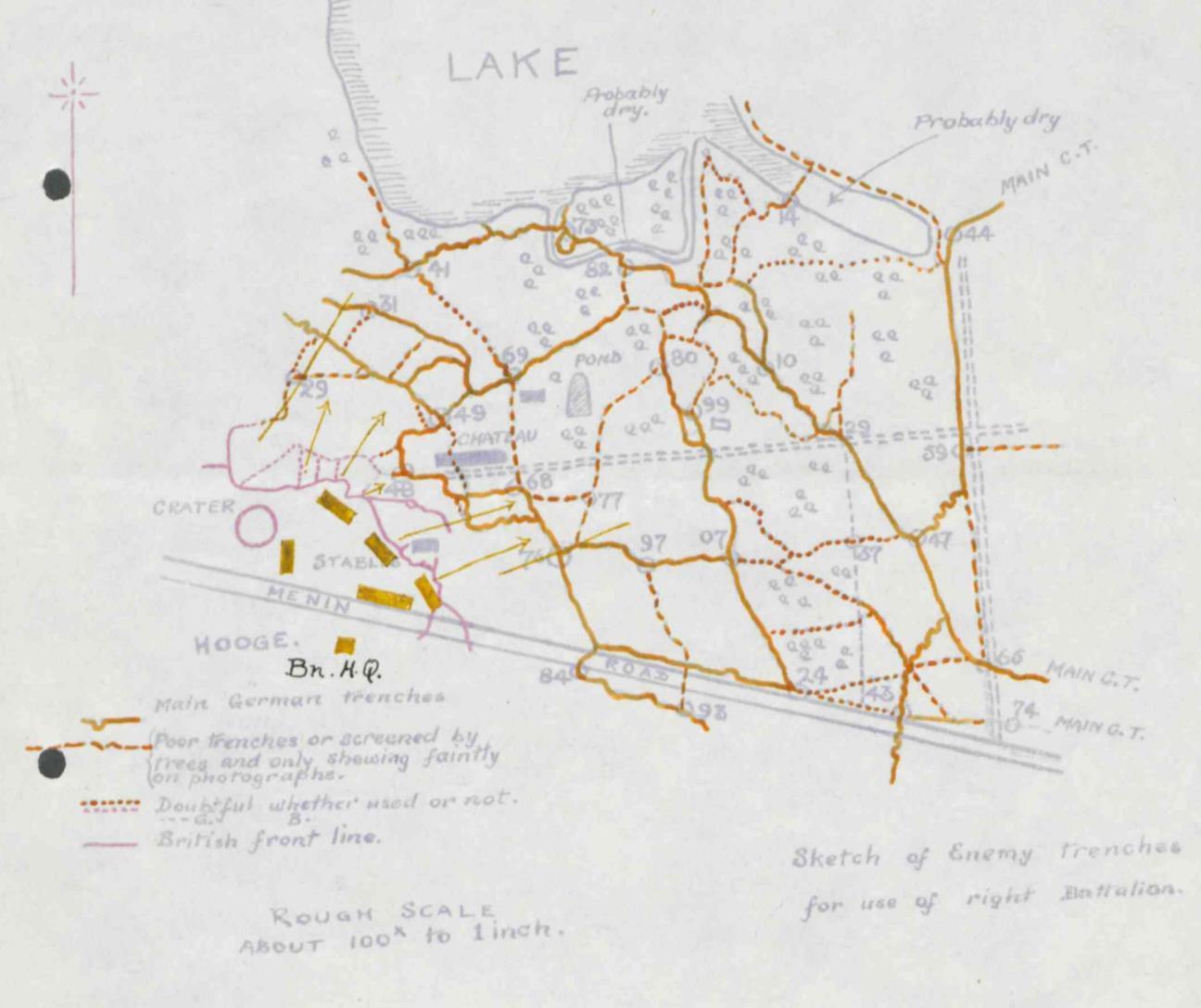
On 25 September the British guns commenced a bombardment at 3.50 am all along the Hooge sector front and continued until 4.20 am, at which hour the infantry of all units along the entire line left their trenches. The 7th Brigade diarist noted that:
The 2nd South Lancs had to advance from a cramped and difficult piece of ground … and to cross from 20 yards on the left to about 120 [yards] on the right to gain the enemy’s front line trench. … The 2nd South Lancs advance twice gained the enemy’s front trench on the left, but was driven back by shell fire. The right of the 2nd South Lancs, advancing east of the Stables, was held up by wire. Several fresh attempts to get forward by officers and men were made at this point, but without success and the unit fell back to the original line.287
17. the ‘93’ and their stories 129
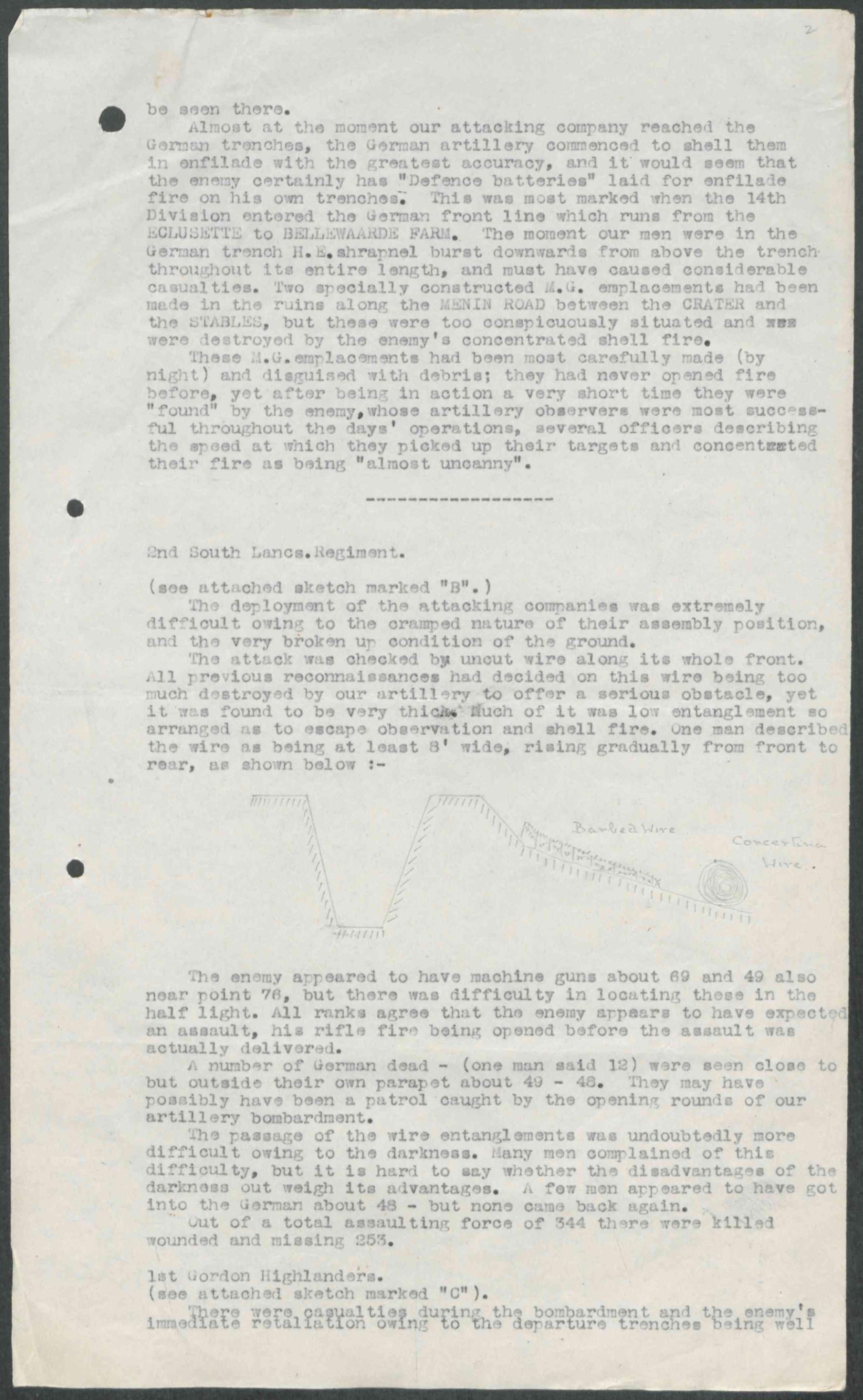
few men appeared to have got into the German trench around point 48 but none came back again. Out of a total assaulting force of 344 there were killed wounded and missing 253.290
Duncan was listed as ‘missing’ in this action by the battalion diarist.291 From the details of the above accounts it seems certain that his body lies in the vicinity of Hooge crater and thus in close proximity to those of Goodale, Hall and Walsh who fell on 9 August 1915.
290
TNA WO 95 745 8 Summary of Information received from individuals and units engaged in the Operations of 25 September.
291 TNA WO 95 1414 2
17. the ‘93’ and their stories 131
Fraser, Corporal Alexander Paul 79227 15 October 1915, Spanbroekmolen SPS 1906 1907
31st Bn. Canadian Infantry, C Company Kemmel Chateau Military Cemetery K.49 Age 24
Little is know about Alexander’s early years. Son of John Fraser and his wife Louie, he was born in London on 12 February 1891 and at some point after leaving SPS emigrated to Calgary, Canada. He joined up in that place on 17 November 1914, his attestation papers describing him as a ‘farmer’.292 Allocated 31st battalion, he departed Calgary on in May 1915 on SS Northland and arrived at Shorncliffe station on 29 May. After a period of training the unit departed for France on 1 September, attached to 6th Brigade, 2nd Canadian Division. From mid September the newly formed Canadian corps took over the line running north from Ploegsteert Wood to just south of St Eloi. The enemy was in line opposite at distances varying from 500 yards down to only a few yards.
After 25 September major operations had ceased for the winter and this part of the line was at times especially quiet. Indeed, on the day that Alexander was killed the 6th Brigade diary commented tersely: ‘all quiet. Foggy and warm.’293 The 2nd Division diary recorded that ‘peaceful calm seems to be the one aim of the Bosch on this front.’294 In fact, such comments are rather misleading, for only a few days before Alexander had come into this part of the line the Germans had successfully exploded mines under the Canadian trenches with resulting casualties numbering more than twenty. Nonetheless, it is clear that Alexander was unlucky to have been killed whilst he was serving in this sector.
Having rested in billets at Locre since 6 October, on 11 October 31st battalion Canadian infantry received orders to relieve 28th battalion in the front line trenches in the Kemmel Sector, left sector. C Company was instructed to rendezvous with B Company at Lindenhoek and make their way to the front line via the trenches named Regent Street and The Mall. The Operation Order stipulated that the C Company occupy the ‘right centre’ of the sector of trenches held by 6th Brigade.295 This suggests that Alexander was in the F4 section of line shown in the map below, more or less opposite Spanbroekmolen and no great distance
292 Attestation Papers https://central.bac lac.gc.ca/.item//?op=pdf&app=CEF&id=B3274A S062
293 RG9 III D 3. Volume/box number: 4887. File number: 259. Container: T 10684. File Part 2
294 Can 2 Div GS Oct 1915 RG9 III D 3. Volume/box number: 4842. File number: 99. Container: T 1924.
295 RG9 III D 3. Volume/box number: 4936. File number: 429. Container: T 10741.
17. the ‘93’ and their stories 132
from where another OP, P J Viner Johnson (SPS 1889 1890), had fought and fallen earlier in the year.
Map showing ‘F’ trenches in front of Spanbroekmolen.296
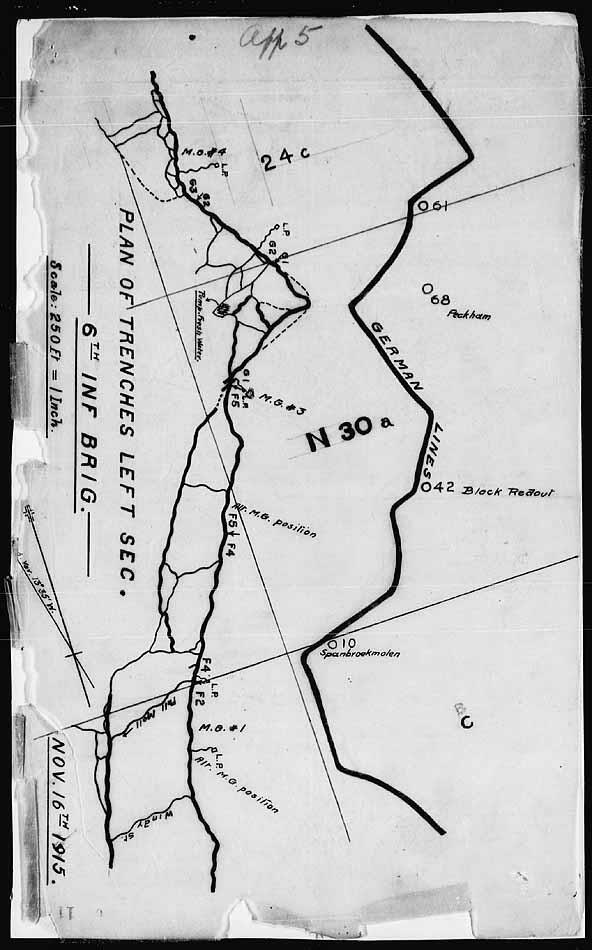
Two detailed sketches of the characteristics of the No Man’s land that lay between Alexander and the enemy are hosted in the 28th battalion unit diary and reveal remarkable reconnaissance activity.297
296 RG9 III D 3. Volume/box number: 4935. File number: 425. Container: T 10739< >T 10740. File Part 1=1915/07/01 1916/07/31; 2=1916/08/01 1917/12/31
297 RG9 III D 3. Volume/box number: 4935. File number: 425. Container: T 10739< >T 10740. File Part 1=1915/07/01 1916/07/31; 2=1916/08/01 1917/12/31
17. the ‘93’ and their stories 133

Although the unit diary is devoid of detail relating to the death of Alexander, Captain McGill, the Medical Officer serving with 31st battalion, states that:
[On 15 October] at 6.16 in the evening Corporal Fraser of C Company was killed, and three machine gun men wounded, all with one rifle grenade.298 Alexander’s body was brought back to Kemmel and interred in the cemetery in Kemmel Chateau.
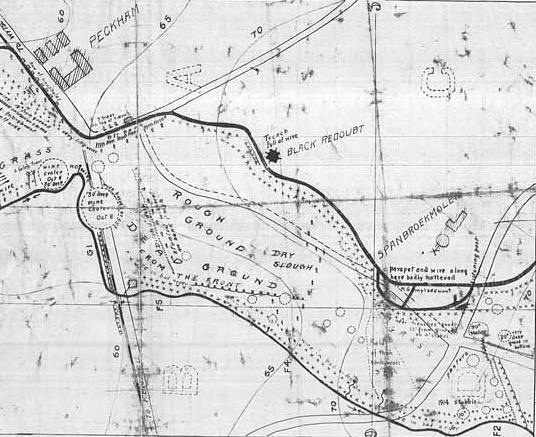
298 Mc Gill, H. E, Medicine and Duty. The World War 1 Memoir of Captain Harold E Mc Gill, Medical Officer 31st Battalion CEF p 102
17. the ‘93’ and their stories 135
Graham, 2nd Lt Archibald Foster 11 November 1915, Ypres SPS 1908 1910
RGA, 6th Siege Battery, XL Brigade, attd. 81st Brigade Ypres Reservoir Cemetery I.B.11
Grave epitaph: Surely For Him High Service Waits Though Earth’s Last Fight Is Fought Age 22
Archibald was the son of Archibald Graham and his wife Mabel of 48, High Street, Oxford. After leaving SPS in 1910 Archibald had become an apprentice at Vickers Ltd, Barrow. In September 1914 he gained a commission in the Special Reserve of Officers, and in due course joined the 6th Siege Battery, Royal Garrison Artillery. At the time of his death his name had been forwarded by his commanding officer for recognition of conspicuous gallantry and devotion to duty.
The 6th Siege Battery operated a total of four 6” Howitzers and was a unit in XL Brigade. Ordinarily, under the command of 3rd Division, at the time of Archibald’s death it was attached to 81st Field Artillery Brigade under the command of 17th Division. It had been in the Ypres sector since June 1915. The unit diary mentions the death of 2nd Lieutenant Foster in its entry for 11 November:
5 am: Owing to report of imminent hostile attack, [our] battery fires 8 rounds on the line of wood north of Bellewarde Lake.
1 pm 2.30 pm battery is heavily shelled with 8” H.E x 4.1” shrapnel. Lieut A. F. Graham is killed and Gunner Darlington wounded.
3.35 pm Fire 14 rounds on hostile trenches in retaliation.299
The Brigade diary confirms the heavy shelling, stating that on 11 November ‘between 1 2 pm: 6th Siege Battery could not fire as their battery position was being heavily shelled’.300
At the time of Archibald’s death his battery was located about 300m south west of the Infantry Barracks in Ypres, either in the corner of the grounds of the barracks or between the two moats that existed in that vicinity at the time.301 In the first instance Archibald was
299
TNA WO 95 472 8
300
301
TNA WO 95 1991 6
TNA WO 95 1991 6 gives coordinates of 28. I.13.b.2.8
17. the ‘93’ and their stories 136
buried in a small cemetery at the south west corner of the Infantry Barracks; as part of the concentration of graves after the war he was reburied in Ypres Reservoir Cemetery.302
302 CWGC. Concentration of Graves 878/14 states that, along with three others of 6th siege battery, Archibald was ‘exhumed from S.W. Corner of Caserne. D’Infanterie. Sheet 28.I.7.d.80.00.’
17. the ‘93’ and their stories 137
Calthrop, Lt Everard Ferguson 19th December 1915, Ypres SPS 1889 1893

38th Brigade Royal Field Artillery Ypres Reservoir Cemetery I.B.11
Grave epitaph: Greatly Loved Age 39
Grave of Everard Ferguson Calthrop303
Everard Calthrop was the son of the late Mr Claude Calthrop, a Royal Academician, and his wife, Louisa. Everard joined the army in 1895, was promoted lieutenant in 1898, captain in 1901 and major in 1912. He was a keen soldier and fought in South Africa (1899 1902) where he took part in the relief of Ladysmith, including the action at Vaal Kranz. He was also present at Tugela Heights, Pieters Hill and Laing’s Nek, winning seven clasps and two medals. Following the Boer War he went to Japan to study the language, and remained there for three years, returning to England in 1908. After passing through the Staff College, 303
Author’s photo.
17. the ‘93’ and their stories 138
© GESEverard thereafter worked in the War Office from 1911 to 1914, serving in the department of the General Staff. In July 1914 he was appointed to Tokyo as Military Attache.
As had been reported in several newspapers: Calthrop was one of the first of the small batch of Army Officers who were selected by the War Office to proceed to Japan for the purpose of studying the Japanese language and the inner life of the Japanese Army. It was the original intention that these officers should remain in Japan for two years, but at the end of that period Calthrop had made such marked progress in the difficult language that he was granted the special privilege of continuing his studies for a further period of two years, at the end of which he had acquired a command of both the written and spoken languages of Japan, the extent and accuracy of which placed him on a level with the best graduates of H. M. Consular Service, and eminently qualified him as an official interpreter of the first class.304
Nonetheless, when war broke out Everard asked to be relieved of his duties and to resume the role of an active soldier. He was given permission to return to England and started his journey in April 1915, in a cargo boat. He was kept in England by the War Office until the end of September, at which point he left for Flanders with 38th Brigade R.F.A.
38th Brigade R.F.A comprised ‘Captain Harvey’s’ siege battery, along with 24th and 34th batteries, with 110th battery attached. These units were at this time elements of the divisional artillery of 6th Division. All batteries had 4” guns and all were located on 17th December on the northern outskirts of Ypres.305 Unfortunately, the diaries for these siege batteries were either not composed or appear not to have survived for this period and the 38th brigade diarist was not disposed to include the names of casualties in their record, even the names of officers killed and wounded.
In mid December the 6th Division had taken over the sector extending just north of the Roulers Railway to just short of the Wieltje Salient. From 5.15 am on 19th December the Germans delivered a gas attack on the infantry holding the front line.306 On the day that Everard was killed, 38th brigade diarist recorded the attack along the length of the line held by the division which in turn elicited retaliatory shelling. He noted:
304 1 January 1916. Ealing Gazette and West Middlesex Observer. Calthrop was the translator of the celebrated Chinese Book of War the Sunzi Bingfa the ‘Military Classic of the Far East’, written in the 5th century BC by the ‘Masters’ Sun and Wu.
305 Their precise locations are as follows: 24th at I.1.a.6.1; 34th at I.7.b.1.5; Captain Harvey’s at I.1.d.3.0 and 110th at I.2.d.6.5
306 The two battalions were the 14th D.L.I and 2nd D.L.I
17. the ‘93’ and their stories 139
19 December. The Germans commenced a gas attack at 5.30 am. All batteries fixed on their front line trench[es] throughout most of the morning and retaliated occasionally during the afternoon.307
Following the attack ‘the enemy then commenced a violent bombardment of our support line and communications. … Our barrage was very successful and was turned on quickly.’308 In contemplating why the Germans did not follow up the gas attack with an infantry assault, the 6th Division diarist confirms that the siege batteries were busy that day, stating that ‘the Field Artillery barrage was too much for them.’309 The British shelling of the enemy resulted in the inevitable shelling duel, referenced by several of the diaries of units in this Division which record that Ypres was ‘subjected to very heavy bombardment’ throughout the day.310 Since Ypres Reservoir Cemetery in which Everard lies is no great distance from any of the siege batteries of 38th brigade on 19 December, it seems very likely that he was a casualty of this ‘very heavy bombardment’ whilst supervising the retaliatory fire of the batteries.
307
308
TNA WO 95 1598 1 4
TNA WO 95 1581 1 2 309
TNA WO 95 1581 1 2 310 TNA WO 95 1614 1 4
17. the ‘93’ and their stories 140
Sifton, 2nd Lt William Alfred 25 December 1915, Railway Wood SPS 1908 - 1912

8th (Service) Bn. South Staffordshire Regiment Lijssenthoek Military Cemetery II.A.22
Grave epitaph: Pro Deo Domo Rege Mortuus Age 20
William Alfred Sifton311
William was the only son of Alfred Sifton and his wife Alice of Ealing, London. He proceeded from SPS in 1912 to King’s College with the ultimate intention of joining his father in the publishing world. When war broke out he had just passed the London University Intermediate Examination in Arts. Having been connected with the Officers’ Training Corps at St Paul’s, he quickly passed through a special course of the London University Senior O.T.C and was gazetted to a commission in the 8th (Service) battalion South Staffordshires. He crossed to France with the regiment at the beginning of July 1915. At the time he received his mortal wound on 24 December he was battalion Signalling Officer.
The 8th (Service) battalion South Staffordshire Regiment in December 1915 was a unit in 51st brigade, 17th Division. By Christmas 1915 this Division had been holding the line in the Hooge and Railway Wood sectors for just over two months. The 51st brigade was allotted the Railway Wood sector and was operating according to the normal rotation of two battalions in the front and support lines with one battalion in reserve in Zillebeke Lake dugouts, while the fourth was in rest billets. At the time of his death, William had been in line in the vicinity of Cambridge Road since 18 December. The Germans had shelled this area heavily for much of December with shells of every calibre, including those containing 311
https://kingscollections.org/warmemorials/kings college/memorials/sifton william alfred
17. the ‘93’ and their stories 141
lachrymose and gas agents. The unit diary relates that 21 23 December had been mostly quiet. However, on 24 December:
24 Dec. [Although] the early morning was quiet, about 10.30 am [trench] A1 was heavily trench mortared and 2nd Lt W. A. Sifton very severely wounded. Remainder of day very uneventful. The bn was relieved by the 7th Border Regt. A very slow relief was completed at 8.25 pm. The bn marched back to rest camp at G.17.b.4.5. Casualties: 1 officer and 1 man wounded.
25 Dec. Christmas Day was celebrated as well as the circumstances would permit. The men were given a good dinner and sing songs encouraged. 2nd Lt A. W. Sifton died of wounds received 24th December.312
An unnamed account published in The Pauline confirms these details:
At 11 a.m. on 24 December whilst doing duty in the front trenches, [Lieutenant Sifton] was hit by pieces of a trench mortar bomb, during a short but intense bombardment by the Germans. It was at first thought that his wounds would not prove fatal. While in the dug out waiting for darkness when they could carry him back, he was conscious and very cheerful. Despite his pain and suffering, he wished the men about him a Merry Christmas, showing all through the brave spirit of a Christian soldier.313
William is buried in Lijssenthoek Military Cemetery, suggesting that his body was extracted from the trenches by the 51st Field Ambulance and removed to the main dressing station at 65 Rue de Boeschepe in Poperinghe, where he died.
Map in 16th Infantry Brigade HQ diary showing the location of trench A1 (left of the ‘R’ in Roulers.) The German trenches are shown in red; the British in black.314
312 Meanwhile, the diary of 7th bn Border Regt, having relieved the 8th (Service) South Staffs, records a different activity: TNA WO 95 2008 1, 25 Dec. Enemy attempted to fix Xmas tree in his parapet [the] party was fired on and one man seen to drop.
313 The Pauline 33 223 Feb 1916 p 12 and KCL War Memorial Collection
314 TNA WO 95 1605 1 4
17. the ‘93’ and their stories 142

Haigh, 2nd Lt Arthur Gordon 15 February 1916, The Bluff 172nd Tunnelling Company Ypres (Menin Gate) Memorial SPS 1899 – 1900 Age 30
Arthur was the only son of Arthur Harry Haigh of St Catherine’s Ontario, Canada and his wife Mary Browne. He was born in Natal, South Africa on 29 June 1885. He was educated at SPS and University College School, London. Thereafter Arthur attended Aberystwyth University College and graduated at Christ’s College, Cambridge. After completing his practical training under his father he became a civil engineer, A.M.I.C.E and was employed by Messrs J. Mowlem and Co. on a section of the London main drainage contract. Subsequently Arthur obtained appointments as an Assistant Engineer on the Rajputana Malwa Railway and the National Transcontinental Railway of Canada. He obtained a commission on 12 June 1915 in 172nd Tunnelling Company.
Arthur was killed in the vicinity of The Bluff, a prominent knoll located just north of the Ypres Comines canal some 5 kms to the south east of Ypres. At the time of his death 172nd Tunnelling Company was attached to 17th Division in a sector held by 51st Brigade. The Bluff was at the southern end of the section of line in which Arthur was serving.
The author of A History of the 17th (Northern) Division provides a description of the topography of the Bluff:
There is a steep rise which gave the hill at this point the name of the Bluff on the British war maps. For some distance along the north bank of the canal the debris dug out to make the cutting through the ridge had been piled up into a long bank, 20 to 30 feet high, extending to the lower slopes of the Bluff. This had consolidated long ago into solid ground, and when the fighting about Ypres began was fringed with trees. On the Bluff and the high ground north of it were clumps of wood, fairly thick and moderately well grown. The enemy had won the crest of the ridge in the fighting of the winter in 1914, and the Bluff being the dominant feature of the ground near the canal the Germans looked down on the British trenches on the slopes below.315
A report in 76th Brigade diary offers this description:
315
17. the ‘93’ and their stories 144
Atteridge, A. H, A History of the 17th (Northern) Division © A. Hilliard Atteridge, 1929The canal forms a very formidable obstacle, being full of water, and is in a deep cutting. The spoil from the cutting has been built up in terraces into high banks, the bank on the north side of the Canal ending abruptly in a high knoll which is known as the Bluff. … Its possession being of great importance to both sides owing to the fact that it overlooks all the surrounding ground.316
A cross sectional diagram of the Bluff in 76th Brigade diary.317 (The British front line ran around the base of the Bluff with No Man’s Land about 220 yards wide at the foot of its forward face.)

Image of the Bluff painted by Paul Nash (SPS 1903 1906, see Vol 1.). An officer in the Hampshire Regiment, Nash was in the Salient in 1917 and perhaps painted this image during a period of convalescence in London.318
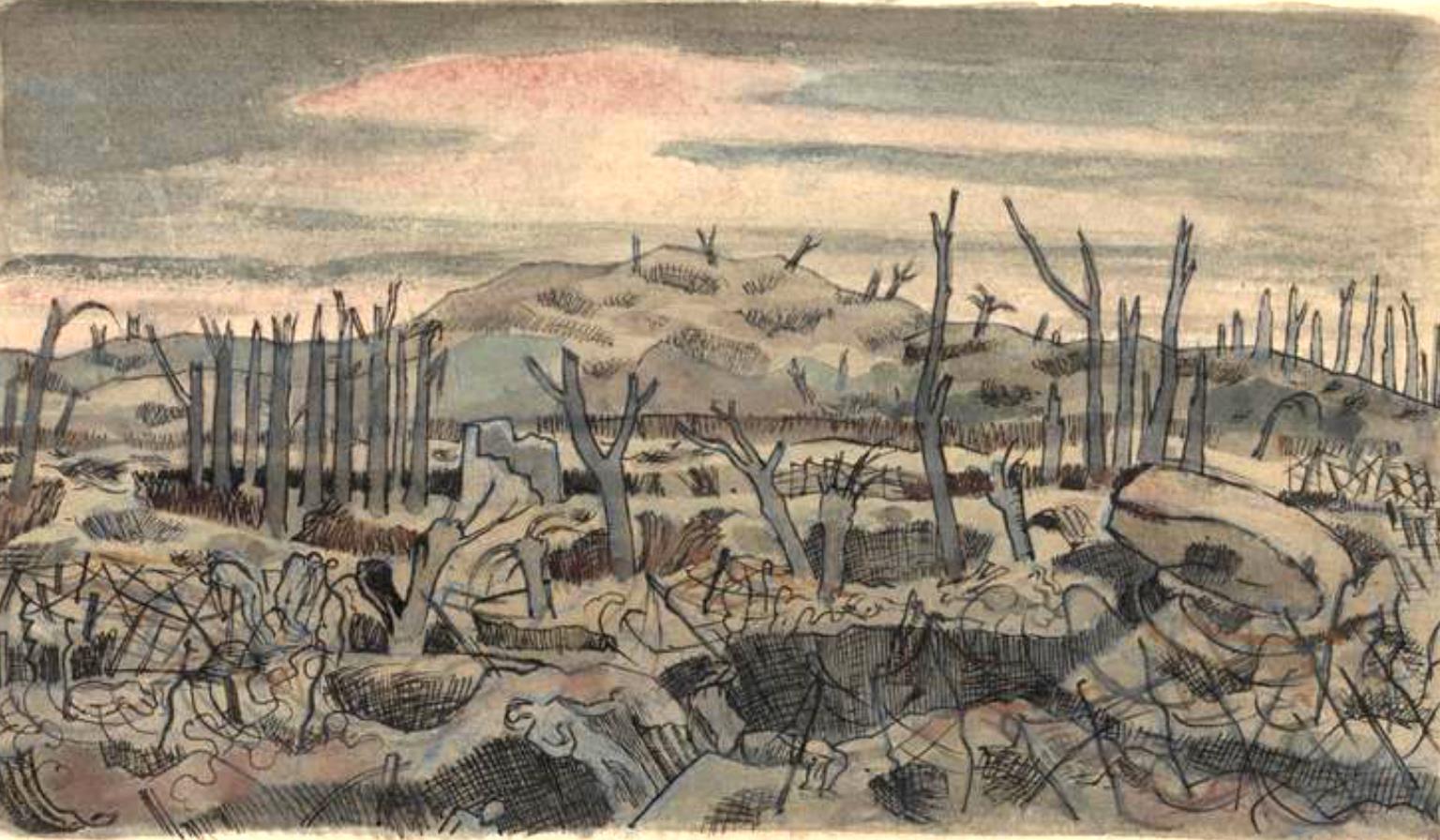
Offering the advantage of height to its possessor, the British had managed to maintain possession of the Bluff since the start of the war though its ownership was keenly contested. Just as mining and counter mining had become a characteristic of the fighting at elevated territory such as St Eloi and Hill 60, so too had it become a feature of the fighting at the Bluff. (The Germans had blown two mines in front of the Bluff in 1915 the first, and smaller, in June and the second in October though the British had been able to occupy the nearest lips of these craters and thus strengthen their defensive position.)
Map showing the location of the two craters resulting from German mines in June and October 1915 and the associated trench system.319
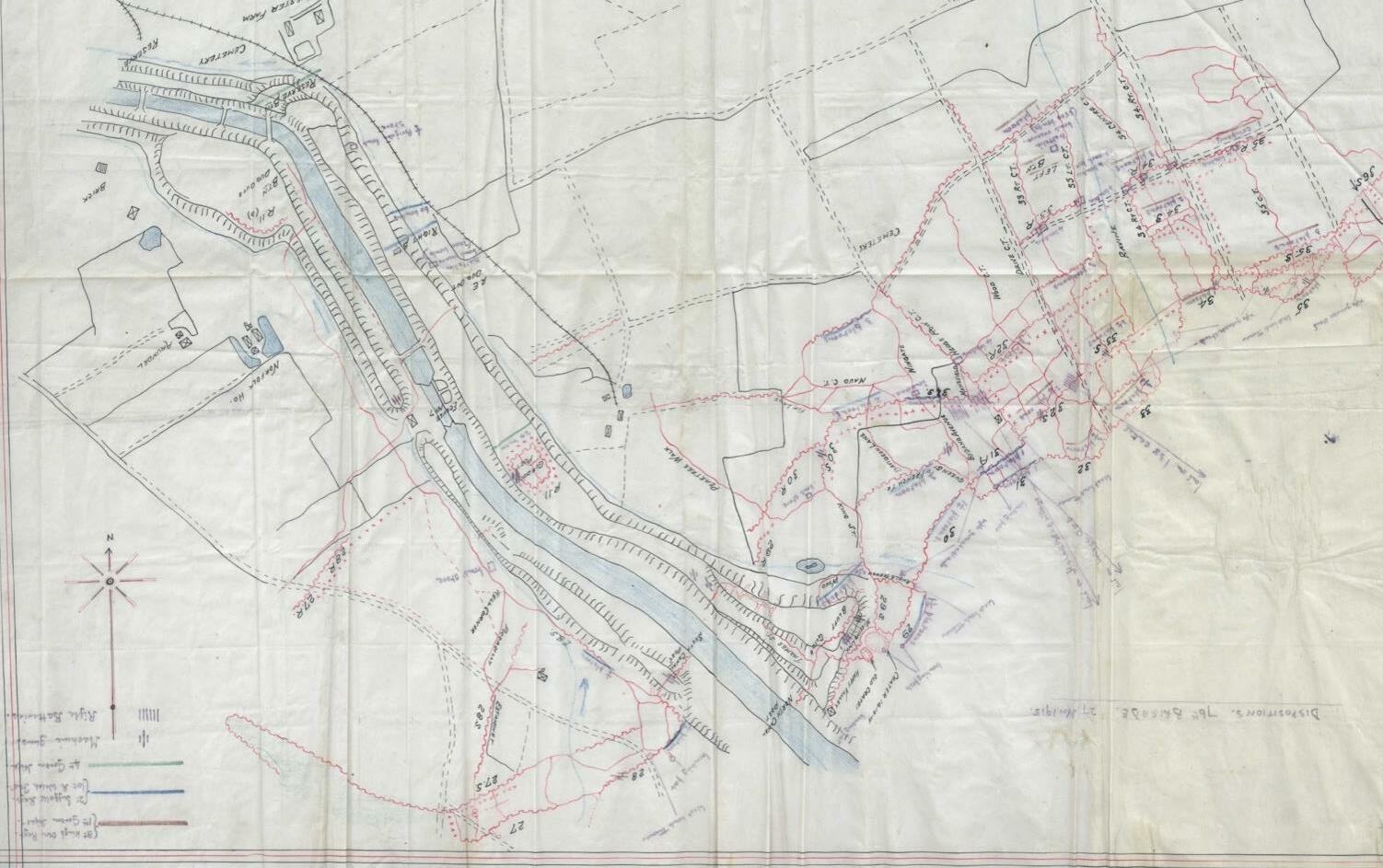
An aerial photograph dated 23 December 1915 showing the extent of the Bluff east west and the two craters from German mines.320 The canal is at the top of the photograph. 319 TNA WO 95 1433 13 320 TNA WO 95 746 1 2
17. the ‘93’ and their stories 146
From Spring 1915 the 172nd Tunnelling Company had been employed upon works at the Bluff (and also St Eloi), charged with defensive mining: thwarting any enemy endeavour to mine below the Bluff. Billy Congreve referred to the progress of these works in his diary entry of 10 January 1916:

The work of the Bluff is now really going ahead and I am getting very proud of it. It is by no means finished yet, but as compared with what it used to be, it is now beautiful. The new tunnel out to be through in a few days.321
A few days later Billy was distraught when the Germans successfully exploded (22 January) a substantial mine close to the Bluff. He described the effect of the explosion in a letter to his father:
The mine destroyed the pride of my heart: the Bluff defences which we had just completed. It’s the hugest thing in the mine line I have ever seen about four Hooge’s rolled into one.322 It blew up 3,500 tons of earth. The crater is 60 feet deep (from the top of the Bluff) and 50 yards by 40 yards across. The actual depth from ground level is about 30 feet, and it blew off the end of the Bluff. … I cannot describe it all, but no volcano or earthquake will have fears for me in the future. [In any case] we have no remade the whole place and, I think, it is stronger than ever before.323
The resultant crater, though causing many casualties, did not in fact advantage the Germans (who curiously did not take possession of it) but it did alert the British to the fact that the Germans were intent upon driving their galleries into the Bluff. Thus, 172 Tunnelling Company was ordered to undertake counter mining activity at the Bluff. On 10 February this resulted in a close encounter with the Germans:
In the new crater in front of the Bluff the entrance to the German gallery was discovered. On commencing to move the sandbags at [the mouth] lights were seen inside and the enemy heard talking. A listening tube was placed in the entrance and pumping was heard. … We immediately started a new tunnel from the SW corner of crater, at a slightly lower level than the enemy’s, [thereby] wishing to try and interrupt them. New tunnel through Bluff also started.324
Work on this tunnel proceeded over the next few days until it was brought to a halt by a very heavy German attack on 14 February. The 172nd Tunnelling Company diary relates that after heavy trench mortaring all day until 3 pm, the enemy from that time unleashed a very heavy shelling of trenches numbered 28 34. This was followed at 5.30 pm by their blowing of a large mine in front of the Bluff, followed by an infantry attack. The diarist states that :
321
Congreve, B Armageddon Road (Ed. Terry Norman) p. 180
322 A reference to the substantial crater at Hooge created by the British on 19 July 1915.
323 Congreve, B Letter to his father, printed in Congreve, B Armageddon Road p 186
324 TNA WO 95 224 3. The mines lost were: A, B, B1, B2, C, D, E, F
17. the ‘93’ and their stories 148
The position of the mine was on the south east side of the previous large crater [i.e. that blown by the Germans on 22 January], directly in front of our new tunnel from the crater … The result of the attack was that [a number of our] mines were all captured by the enemy and all men working in the trenches were either killed or taken prisoner.325
The 172nd Tunnelling Company diary clearly references Arthur as ‘missing’ following the action on 14 February. In all probability it seems likely that Arthur was killed in very close proximity to the Bluff; perhaps, given his skill set as a civil engineer, he was below its surface whilst directing a party of miners. Equally, he may lie in that vicinity, a casualty of the heavy shelling that the combatants endured throughout the day. Thus, it is no surprise to learn that Arthur is commemorated on the Ypres (Menin Gate) Memorial. However, on 31 March 1916 the War Office Military Secretary wrote to Mrs Atherton of Liverpool, an aunt of Arthur’s noted as next of kin, informing her that a report had been received that his body had been recovered and that it had been buried on 29 March; and in the entry for Arthur in De Ruvigny it is asserted that Arthur ‘was buried in Gordon Terrace Military Cemetery near where he fell.’326 (Gordon Terrace Military Cemetery is generally better known as Spoilbank Cemetery.) Yet, according to the CWGC Arthur does not have a grave in Spoilbank Cemetery and is thus instead commemorated on the Menin Gate.
What to make of these competing narratives? One the one hand, it is possible that Arthur was in the first instance buried in Spoilbank Cemetery, and that his grave was at some point destroyed by shelling. However, by the date of 29 March 1916 Spoilbank Cemetery was already well established as such 224 men were buried in this place by that time suggesting that records of burials will have been kept. If a grave was destroyed it was ordinary practice to use these records to commemorate that soldier with a Special Memorial located in the cemetery. On the other hand, the information sent to Mrs Atherton may in some ways have been erroneous. Whatever, although the fate of Arthur’s body may forever remain something of a mystery, no such concern relates to the location of his death.
325 TNA WO 95 224 3
326
The letter to Mrs Atherton is referenced in the Yorkshire Post and Leeds Intelligencer, 7 April 1916. Ancestry.com. UK, De Ruvigny's Roll of Honour, 1914 1919 [database on line]. Provo, UT, USA: Ancestry.com Operations, Inc., 2014
17. the ‘93’ and their stories 149
Boddy, 2nd Lt Guy Gerald Dalrymele 27 March 1916, St Eloi SPS 1904 1907
4th Bn. Royal Fusiliers (City of London Regiment) Ypres (Menin Gate) Memorial Age 26
Guy was the son of Colonel O V Boddy (RE) and Mrs C F D Sewell (formerly Boddy). After a year at Rugby School (1903 1904), Guy became a student at SPS, leaving in 1907. While at SPS he was a member of Armitage and Loane’s House, and was apparently deservedly popular for his genial, helpful disposition. He gained his 1st XV colours in his last year at school. Upon leaving SPS he proceeded to Canada. On the day that he heard that war had been declared he left his ranch, enlisted as a trooper in Strathcona's Horse, and travelled with it in the First Canadian Contingent to England. In January, 1915, he obtained a Commission in the 9th Battalion of the Royal Fusiliers, but this was over strength when ordered abroad and he was transferred to 4th Battalion, which he joined in Flanders, in the salient at Ypres, in June 1915. Guy was killed at St Eloi on 27 March 1916.
The attack at St Eloi in March 1916 designed to regain the relatively high ground of this place, possessed by the Germans since March 1915 was ordered by General Plumer (C.O Vth Corps), partly in retaliation for the German capture of the Bluff in February and partly because it was feared that the Germans were poised to discover the British mining operations. Mining and counter mining had for some time been feature of this part of the front, a total of 33 mines and 31 camouflets had been blow in a space of ten acres.327 In August 1915 172nd Tunnelling Company (see Haigh, A G) had begun sinking three shafts at St Eloi, 30 to 60 feet deep, penetrating through a layer of sand, from which galleries were driven towards the German lines. By early March these galleries had been pushed under German positions and, on a front of 600 yards, six mines numbered from left to right, 1 6 with charges ranging from 600 to 31,000 pounds of ammonal, were in readiness. The mines were blown at 4.15 am on 27 March, commencing the attack.
The blowing of the mines was terrific, sufficiently powerful that the blast was heard at Folkestone, in Kent, England. One account describes it thus:
The explosion of the great mine [number 3; beneath the Mound] had leapt to heaven in a colossal shower of yellow smoke and débris; it could be seen from miles away and shook the earth like the sudden outburst of a volcano. The effects of the eruption on a narrow space of 600 yards were tremendous. Trenches on both sides collapsed like packs of cards under the
17. the ‘93’ and their stories 150
shock; old landmarks were blotted out, and [there fell from the sky] a huge tumbled débris.328
Map showing the location of the six craters.329
Aerial view of St Eloi, taken shortly after the blowing if the mines.330
328 Beaverbrook, Canada in Flanders, Vol 2 p 94
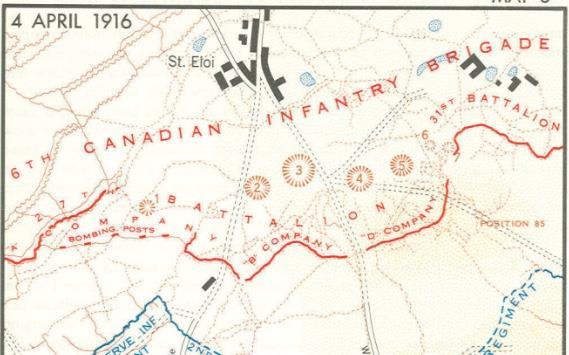
329 Nicholson, G W L Official History CEF between pp 140 141
330 1 April Gustav Stoffleth: Geschichte des Reserve Jäger Bataillons Nr.18; Berlin 1937, Verlag Bernard & Graefe, 525 Seiten
17. the ‘93’ and their stories 151
Between 19 25 March 4th battalion Royal Fusiliers (9th Brigade, 3rd Division) had been at Reninghelst resting, refitting and practicing assaulting replica trenches of those fashioned by the Germans at St Eloi. The battalion diarist considered the unit ‘very fit and confident of success’.331 It was a false hope, thwarted for the reasons presented by these accounts: The trenches, as the result of the mine explosion[s], the subsequent heavy bombardment and the torrential downpour, became very dilapidated and the infantry held on under considerable stress.332 331 TNA 95 1431 1 3 332 TNA WO 95 746 3. A report on operations by Lieut Gen commanding V Corps 31 March
17. the ‘93’ and their stories 152
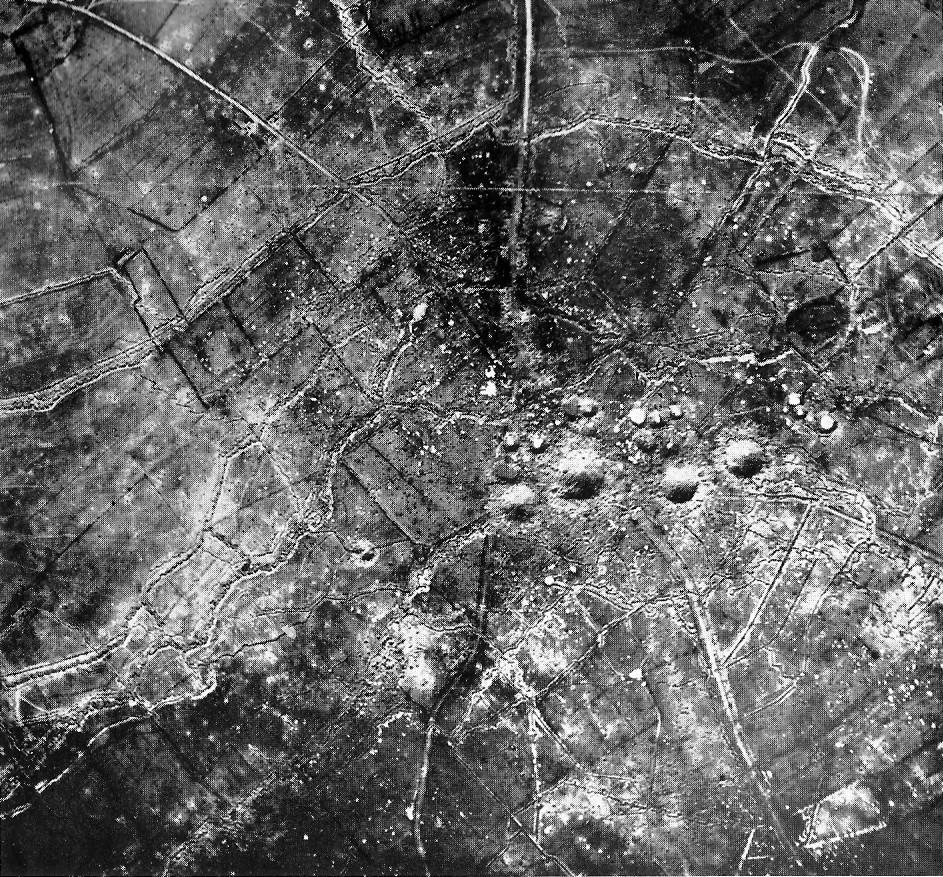
Part of the 4th Royal Fusiliers was held up by wire and hostile machine guns…. The ground in this area is sodden with water and men in the captured trenches are up to their waists in mud and water.333
As the attack depended for success on surprise, it was impossible to undertake the previous destruction of the enemy’s wire or deal with his strong points, or suspected machine gun emplacements. In consequence of this, the left battalion of the attack (4th Bn Royal Fusiliers) which, from the nature of the ground, was more exposed to enfilade fire than the right battalion, (1st Northumberland Fusiliers) came under heavy machine gun fire, as well as the fire of artillery, immediately the troops began to scale the parapet of our front trenches. Unfortunately, too, Mine No. 6, presumably owing to its being undercharged, proved ineffective, and did not facilitate the advance of the 4th Bn Royal Fusiliers. Eleven out of fourteen company officers of that battalion fell, killed or wounded, and the battalion did not succeed in reaching the objective allotted to it.334
Map showing the line of advance of 4th battalion Royal Fusiliers from in front of Shelley Farm. The red lines represent German trenches; the blue line was the line reached by 1st battalion Northumberland Fusiliers. Notice point 85 from which the enemy perpetrated devastating enfilading machine gun fire, and point 76 where, in all likelihood, Guy fell.335 (The map is dated 2 March 1916 and therefore does not show the craters formed by the explosions on 27 March.)
333 TNA WO 95 1377 1 7 3rd Division Summary of Operation 22 31 March 1916 334 TNA WO 95 1377 1 7 Report on Operations carried out Near St Eloi 335 Map in TNA WO 95 1430 1 4
17. the ‘93’ and their stories 153
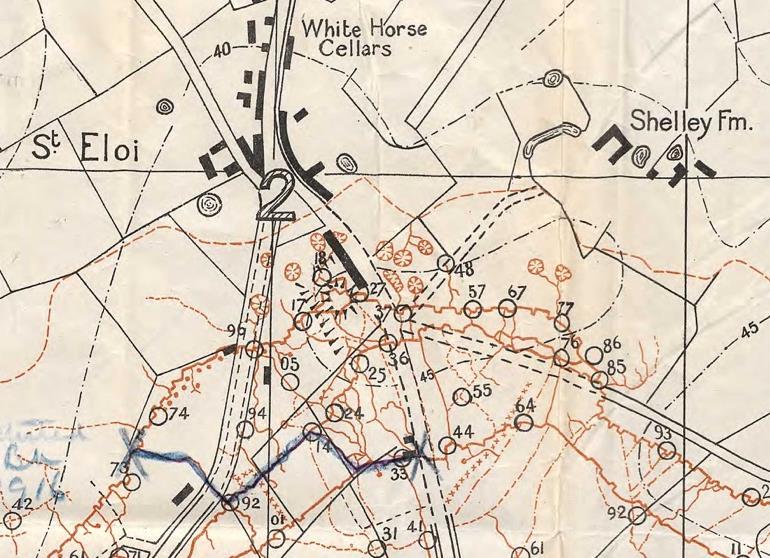
In his Report, the commanding officer of 4th battalion Royal Fusiliers references the death of 2nd Lt Boddy:
Left camp at Reninghelst at 5 pm [on 26 March] and was transported to H.16.a [a muster point south east of Vlamertinghe] in motor vehicles. Proceeded from here by Companies at five minute intervals to trenches R5 and T7 [in front of Shelley Farm]. The whole battalion was in these trenches by 10.30 pm. By 2.30 am all wire had been cut and at 3.30 am all Companies were in their jumping off places: W and X companies were in front of Shelly Farm; Y and Z Companies fairly close to the parados of trench R1. At 4.15 am the first explosion took place, followed after a short interval by a 2nd one and after a further and longer interval the 3rd and last explosive [NB: this is erroneous there were six explosions]. My instructions were to wait 30 seconds after the explosion before advancing and I understood that there would be practically only one and that all the six mines would be fired simultaneously. The officers and men, however, appear to have been too eager and apparently moved directly after the 1st explosion with the result that quite a large number of Y company were over our own parapet when number 5 mine exploded in front of them. Directly the mines went up an enemy machine gun somewhere near point 85 opened on the parapet where W, X and Y companies were crossing. The fire from the gun was very accurate and caused a large number of casualties among these 3 companies … being nearly 40% of their strength. Captains Moxon and Foster [nevertheless] continued to lead their men towards the enemy’s trench. The enemy by that time were firing shrapnel, making a barrage in front of the advance. .. Lt Boddy, Bombing Officer with live squads of bombers and 2nd Lt Howard, however, pushed forward and dropped into the trench leading towards point 76 which was held by an enemy machine gun and a party of snipers. Lt Boddy and 2nd Lt Howard with the squad of bombers … were all killed.336
Losses were substantial: listed as killed, wounded or missing were 10 of the battalion’s 17 officers and 251 of the 646 Other Ranks. When the Canadians took over the line on 4 April, one soldier described the scene thus:
When day broke, the sights that met our gaze were so horrible and ghastly that they beggar description. Heads, arms and legs were protruding from the mud at every yard and dear knows how many bodies the earth swallowed. Thirty corpses were at least showing [in] the crater and beneath its clayey waters other victims must be lying killed and drowned.337
336
TNA WO 95 1431 1 3 Report by Lieutenant Colonel G.G. Ottley [ O C 4th bn R.F]
337 Roy, Reginald H, The Journal of Private Fraser (Victoria: Sono Nis Press, 1985), p 113
17. the ‘93’ and their stories 154
Guy’s body was never recovered, ‘swallowed’ by the mud and presumably lying this day in close proximity to ‘point 76’ no great distance from where fellow OP E.S.P.K. James fell almost a year to the day, on 17 March 1915.
17. the ‘93’ and their stories 155
Johnston, Lt Alec Leith 22 April 1916, Turco Farm SPS 1901 - 1908
1st Bn. Shropshire Light Infantry, A Company338 Essex Farm Cemetery II.Q.19
Grave epitaph: Above And Stronger Than His Wish To Live His Wish To Do His Duty Age 26 Alec Leith Johnston339
Alec was the son of Dr and Mrs George Johnston. At school he had already distinguished himself with the pen, and was joint editor with G. D. H. Cole of The Octopus. He went to Exeter College, Oxford, with an Open Scholarship, played football for his college, took a first class in Moderations, and a diploma in Archaeology. He returned to St. Paul's as a master in September 1912, and left a year later. Journalism seemed his vocation, and he was soon a frequent contributor to Punch, to which magazine he contributed regularly from the trenches. This extract is typical of his writing:
Once upon a time billets were billets. You came into such, and thereafter for a spell of days forgot about the war unless you got an odd shell into the kitchen. But now well, about noon on the first day’s rest, seventy odd batteries of our 12, 16, and 24 inch guns set about their daily task of touching up a selected target, say a sap head or something new from Unter den Linden in spring barbed wirings which has been puzzling a patrol. This is all right in its way; but the Hun still owns one or two guns opposite us. And by 12.5 all is unquiet on the Western Front. This is all right in its way; but about 3 P.M. the Hun is roused to the
338 From 2 17 April Johnston was Acting Captain of A Company 339 Image in Johnston, Letters from the Front (1916)
17. the ‘93’ and their stories 156
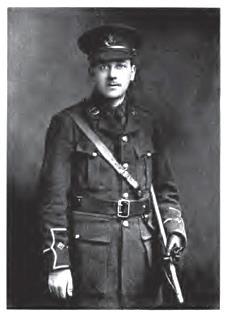
depths of his savage nature, and one wakes up to find Hildebrand and Hoffelbuster, the two guns told off to attend to our liberty area, scattering missiles far and wide, but mostly wide, and a covey of aeroplanes bombing the local cabbageries. This again is all right in its way, but in the meantime the mutual noise further up the line has become so loud that Someone very far back and high up catches the echo of it, and a bare hour later we receive the order to stand to at once, ready to move off twenty minutes ago.340
In the first instance Alec enlisted in the Artists’ Rifles and went out to France with their first draft in October 1914. In February 1915 he obtained a commission in the 1st battalion King’s Shropshire Light Infantry. The following month he was promoted Lieutenant. In August 1915 he was wounded in both legs during an attack at Hooge this was the attack of 9 August in which fellow OP Goodale, in the same unit as Johnson, was killed. Captain Ingram, RAMC officer attached to Johnston’s battalion, offered this description of Alec’s role in the events of 9 August:
Owing to the dust and smoke Johnston’s platoon lost direction and passed their objective in the darkness. He made his men lie down while he sat in a shell hole and worked out a compass bearing to the crater [at Hooge] that they were attacking and all this under such a shell fire that you could not hear the next man when he shouted in your ear. He was the only officer left with his company at the end of that day, and, although himself wounded in both legs, he led his men out, and stayed with them until ordered to the ambulance. Next day he escaped from the casualty clearing station and returned to the battalion in order to write up the list of his men especially recommended for distinguished gallantry. That done he returned to hospital and was not fit to rejoin the battalion for many weeks.341
Alec was shot through the heart by a German sniper at dawn on 22 April. A friend contributed the following to Alec’s obituary in The Pauline:
Johnston was a boy who added to the life of an Upper Eighth of some mark. He had a distinguished form career; he won composition prizes, wrote most graceful Latin verse, and had a passion for editing papers; he was the author of occasional verse, sometimes grave, more often gay, but almost always of very considerable merit. There was something of a dreamer in him, but his seriousness was crossed by an ever ready sparkle of fun. As he grew up, some people may have noticed in him a carelessness of public opinion; those that did so probably also noticed an equal carelessness of hard knocks in the football field. He played for popularity less than most people, and was, I believe, rather shy in his ordinary meetings with his fellows; but those who knew him well, knew also that he had in reality none of the egotism of the intellectual, and that what counted most with him was individuals. He was,
340 Johnston, Lieutenant Alec. At The Front Lucknow Books. Kindle Edition, p 120 341 Ingram, published in Editor’s Preface to Johnston, A At the Front
17. the ‘93’ and their stories 157
indeed, of a very loyal and a very manly nature; and he was only true to his type in dying somewhere in the front of a battle.342
During the first few days of April 1st battalion King’s Shropshire Light Infantry (16th Brigade, 6th Division) was billeted at Herzeele, a short distance east of Wormhout. On 6 April the battalion moved to ‘Camp M’, about two miles north west of Poperinghe.343 Between 10 14 April the unit supplied working parties for various works, including on a new railway crossing of the Poperinghe Crossbeke Road, about 2 and ½ miles north west of Poperinghe. On 15 April the battalion moved via Camp E (in the wood in 28. NW.A.30) to Chateaux des Trois Tours, about 700 yards west of Brielen. At 9 pm A and D Companies moved from here to billet on the east bank of the Canal, near bridges 2A and 4 close to Essex Farm. On 21 April the battalion received instructions to recapture the trenches recently occupied by the enemy in the vicinity of Turco Farm:
Operation Order No. Z [Trenches] S18. A, Willow Walk, D20 and the right end of D27 are in the hands of the enemy. The battalion has been detailed to retake the area tonight and consolidate the line Algerian Cottage S18A Willow Walk D20 D21.
Order No. Z detailed the task of A Company: Centre attack: A Coy will establish a post in the Duck’s Bill, consisting of 25 men and a Lewis Gun; 75 men will also occupy Willow Walk in support of this post. The left of the line from which the above 100 men will assault will be the junction from by S20 and the communication trench running to the ‘U’ in the Pump Room. The right of the line will be about the letter ‘R’ in the Pump Room. Rought to be followed to point of assault: Boundary Road The Willows Knaresboro Castle The Pump Room.344
Detailed trench map from 16th Brigade diary showing most of the trenches mentioned in the instructions for the attack. (The numbers refer to descriptive details in the diary.)345
342 The Pauline, 34 225 June 1916 p 73
343 Camp M was situated in the angle formed by the Poperinghe Proven and Poperinghe Watou Roads.
344 TNA WO 95 1609 1 5
345 TNA WO 95 1609 1 5
17. the ‘93’ and their stories 158
A detailed account of the attack undertaken by A Company is found in the unit diary: A Company under Captain T. C. N. Hall formed up for the assault on Willow Walk in two lines behind the hedge running N.E from Turco Farm. Owing to the state of the ground, continuous rain and black darkness this Company did not take up its position for the assault until about 1 am.346 [The attack] was launched at about 2 am and came under fairly heavy rifle fire on leaving Turco Farm. Captain Hall was wounded at this stage, and several men fell and were suffocated in the mud during the advance. … Willow Walk was occupied with little
346 C Company, attacking on the left appear to have had the worst ground to cross. Very great difficulty was experienced by C Company in covering the ground up to D.20 owing to the great depth of mud. To prevent themselves sinking in, it was found necessary in places for the men to lie flat on the ground and push themselves along with their hands and knees, throwing their rifles in front of them as they progressed. TNA WO 95 1609 1 5
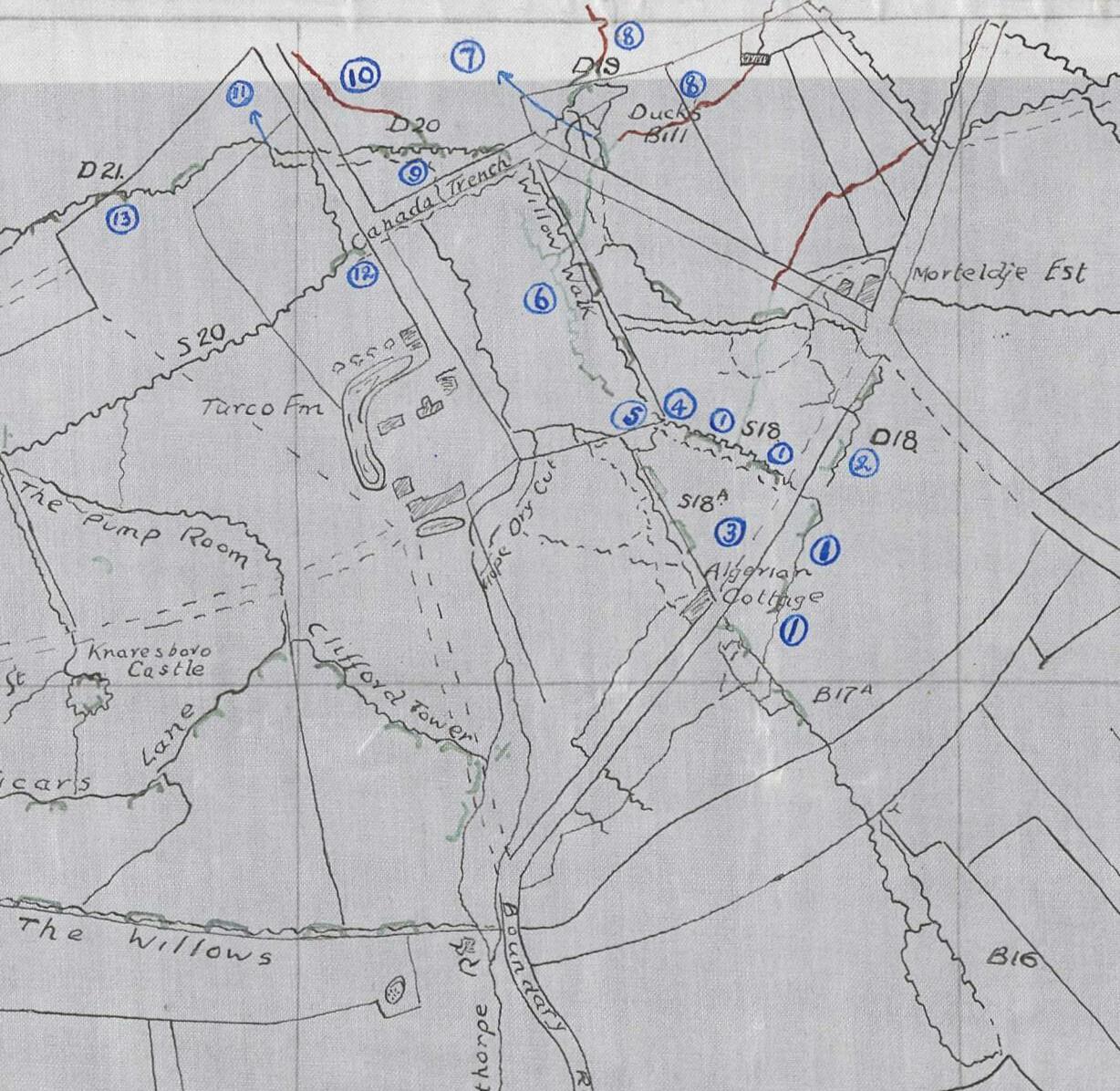
opposition. The few Germans found in the trench were bayonetted, and several others were shot as they retired. … Willow Walk had been shelled out of all resemblance to a trench, but A Company at once began to consolidate the remains of the old trench and shell holes and succeeded in establishing small posts along the front before dawn. Lieutenant A. L. Johnston and 25 men with one Lewis Gun were sent to attack Duck’s Bill, which they succeeded in capturing without loss about 2.30 am, having killed all the Germans found therein. About 3 am the enemy were seen to be massing men near No Man’s Cottage [a short distance to the north of Duck’s Bill] for a counter attack, and as the fire from our own guns was falling short on the Duck Bill’s salient, Lieutenant Johnston decided to withdraw his men to the north end of Willow Walk. He reported the contemplated counter attack by the enemy, and when they advanced about 15 minutes later their attack was easily driven off by Lewis Gun and rifle fire. … Lieutenant Johnston was shortly afterwards killed by a sniper while he was directing the consolidation of the trench.347
Ingram informs us that Alec’s ‘personal preparations for his last attack consisted of an extra supply of revolver ammunition in one pocket and a tin of bully beef and a small book of Russian fairy tales in the other.’348
View looking north from Divisional Collecting Post Cemetery and Extension showing the terrain over which 1st battalion Shropshire Light Infantry traversed (from left to right) on 21 22 April. Essex Farm is out of view to the left.349
347 TNA WO 95 1609 1 5 Report on Operations Night of 21 22 April 1916 by Major B E Murray 348 Ingram, published in Editor’s Preface to Johnston, At the Front 349 Author’s photo.
17. the ‘93’ and their stories 160
From these details it appears that Alec fell at more or less exactly the same place as Captain Templer Henry Scott (SPS 1897 1900) almost a year to the day, and whose body still lay in the mud at that location. Alec’s body was recovered and he is buried in Essex Farm Cemetery.
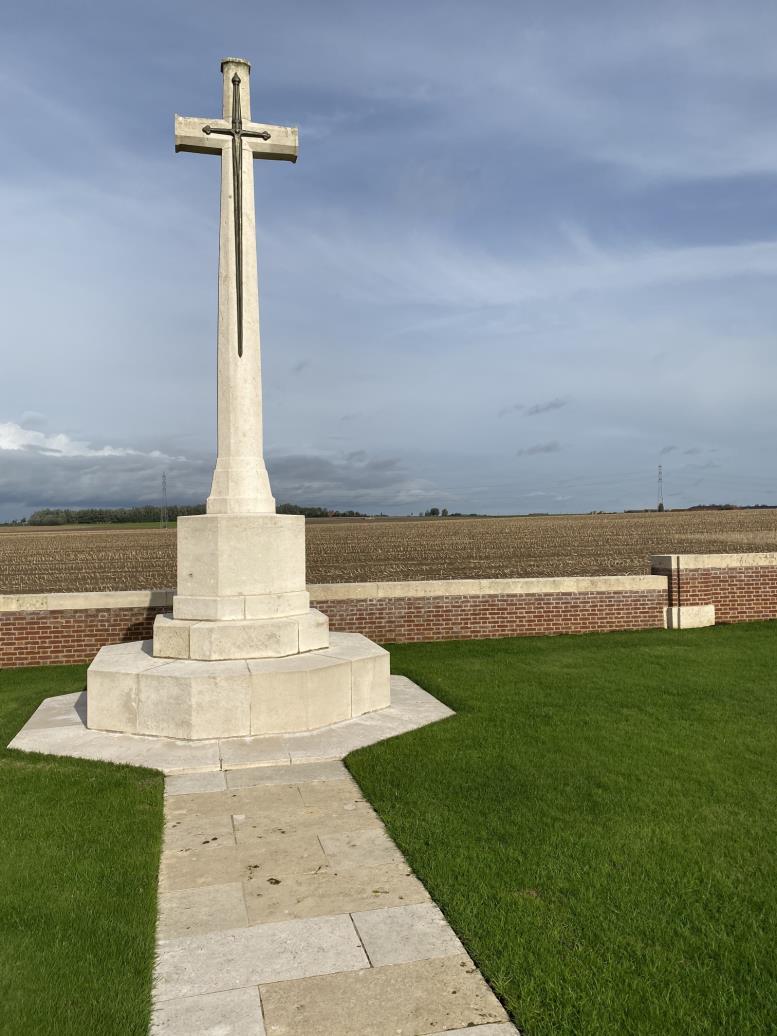
Finch, Private Henry Alfred Ingle 401227 28 April 1916, Hill 60 SPS 1891 1897
2nd Bn. Canadian Infantry Lijssenthoek Military Cemetery VI.B.23A
Grave epitaph: The Lord Bless Thee And Keep Thee Age 37
Henry was the son of George and Bessie Finch. He left SPS in 1897 and proceeded to Trinity College, Cambridge University. While a student there he offered for the Boer War but was rejected, according to The Pauline because ‘he was not strong’.350 At some point he emigrated to America where he set forth making a living as a farmer. He then moved to Canada, where he successfully enlisted in London, Ontario on 11 January 1915, at this point listing his occupation as ‘bookkeeper’, and joined the 33rd battalion Canadian Expeditionary Force. On 17 August 1915 he sailed from Montreal to Britain on the SS Hesperian. 351 Henry transferred to the 9th Reserve battalion Canadian Training Depot on 27 August 1915 and then, on 19 January 1916, to 2nd battalion Canadian Expeditionary Force (1st Infantry Brigade, 1st Canadian Division). He joined this unit in the field on 3 February and was with a trench mortar battery at the time he was mortally wounded on 26th April.
As a soldier whose status was that of a Private, Henry is not mentioned by name in the unit diary. Nevertheless, the diary provides sufficient detail to reveal that he was in line in the trenches in front of Hill 60 on 26 April. At the start of the month 2nd battalion Canadian Infantry had moved to trenches in the vicinity of the Bluff, where it enjoyed a mostly quiet time, though suffered from the ‘enemy’s snipers [who] were very active and their shooting very accurate.’352 Time was spent working on the trenches and building a new cemetery.353 After a few days (12 16 April) in reserve spent just south of Shrapnel Corner (south of Lille Gate), the unit moved into Divisional Reserve not far from Busseboom, near Poperinghe. Henry had thus had a reasonably tolerable existence prior to being sent back into the line on 24 April. The unit diary provides the following details:
24 April. Relieved 5th bn [CEF] in trenches 38 44 inclusive apposite Hill 60. Relief complete at 2 am. Trenches were in very bad condition. Railway cutting runs through our lines with ‘Dump’ on left [right?] flank.
25 April. Day fairly quiet. Enemy intermittently shelled the ‘Dump’ and the railway cutting. Entire bn worked all night repairing trenches.
350
The Pauline, 34 226 July 1916 p 104
351 The Hesperian was torpedoed and sunk by German U boats in September 1915.
352 RG9 III D 3. Volume/box number: 4913. File number: 353. Container: T 10705
353 This was located at 28.NW.I.34.a.8.6 at the head of a feature called ‘The Ravine’.
17. the ‘93’ and their stories 162
26 April. Morning quiet. In the afternoon the enemy shelled the ‘Dump’, the railway cutting and battalion HQ. At 6.25 pm the enemy blew a mine in our lines and opened a heavy bombardment followed by an attack.354
Further detail is presented in a report on the events of 26 April, written by Lieutenant Colonel, A. E. Swift, commanding officer 2nd battalion:
On the afternoon of 26 April the German artillery bombarded the Dump, Bn HQ, Railway Cutting, Jackson Street, Larch Wood and open ground in rear of trenches 43 and 44. The bombardment was steadily increased during the late afternoon, and about 6.30 pm a mine was exploded in trench 42, under bays 6, 7 and 8. This particular part of the line was held by 14 men belonging to No 13 platoon. … Immediately after the mine exploded the Germans opened up a heavy bombardment on our support and communication trenches, also along our font line trenches, from trenches 38 44 and as far east as the Fosse. The crater formed by the mine measures about 130 feet long by 35 feet wide, by 30 feet deep. … We manned our parapet and opened rapid fire on the enemy who were advancing and coming over the parapet in groups opposite trench 39, trench 42 and the sap on the left of trench 44. … Seeing our men closing in, the enemy beat a hasty retreat into the crater in front of trench 39 and made off under cover the heavy smoke that had settled down on No Man’s Land. … I regret to report the following casualties: 44 killed; 10 missing .. and 116 wounded.355
One of the 116 wounded, Henry was removed to Casualty Clearing Station No. 17 at Remy Siding. It is recorded that was admitted with wounds to his head and leg and that he died at 2 am on 28 April.356 He is buried in the cemetery that was established adjacent to Remy Siding and is now known as Lijssenthoek Military Cemetery.
Image of Lijssenthoek Military Cemetery and the buildings used as Casualty Clearing Station No 17.357
354 RG9 III D 3. Volume/box number: 4913. File number: 353. Container: T 10705. See entry for Butcher, C G 1915 for maps and images of Hill 60.
355 RG9 III D 3. Volume/box number: 4913. File number: 353. Container: T 10705
356 TNA WO 95 343 4
357 Author’s photo
17. the ‘93’ and their stories 163

Mack Jost, Lt Norman Roy 3 June 1916, Sanctuary Wood SPS 1909 1911
9th reserve Bn., attached 49th Bn. Canadian Infantry Ypres (Menin Gate) Memorial Panel 24-28-30 Age 20
Norman was the son of Clarence Mack Jost and his wife, Edith. On leaving SPS in 1911 Norman joined the staff of the Union Bank of Canada. After working fifteen months in London, he was transferred to Edmonton, Canada, where he earned promotion just before the war. An accomplished cricketer, he was a member of the Wanderers C. C of Edmunton. He was an enthusiast for military training in time of peace, and when war came he joined as a private, was made sergeant at once, and got his commission a few months later. In 1915 he was serving with the 51st battalion, Canadian Expeditionary Force. At some point he transferred to 49th battalion. Norman was killed on 3 June in Sanctuary Wood, during the opening stages of The Battle of Mount Sorrel.
Map showing the movement of the line in the opening stages of the Battle of Mount Sorrel358 358 George
17. the ‘93’ and their stories 165
Metcalf Archival Collection, Canadian War Museum: 19870027 018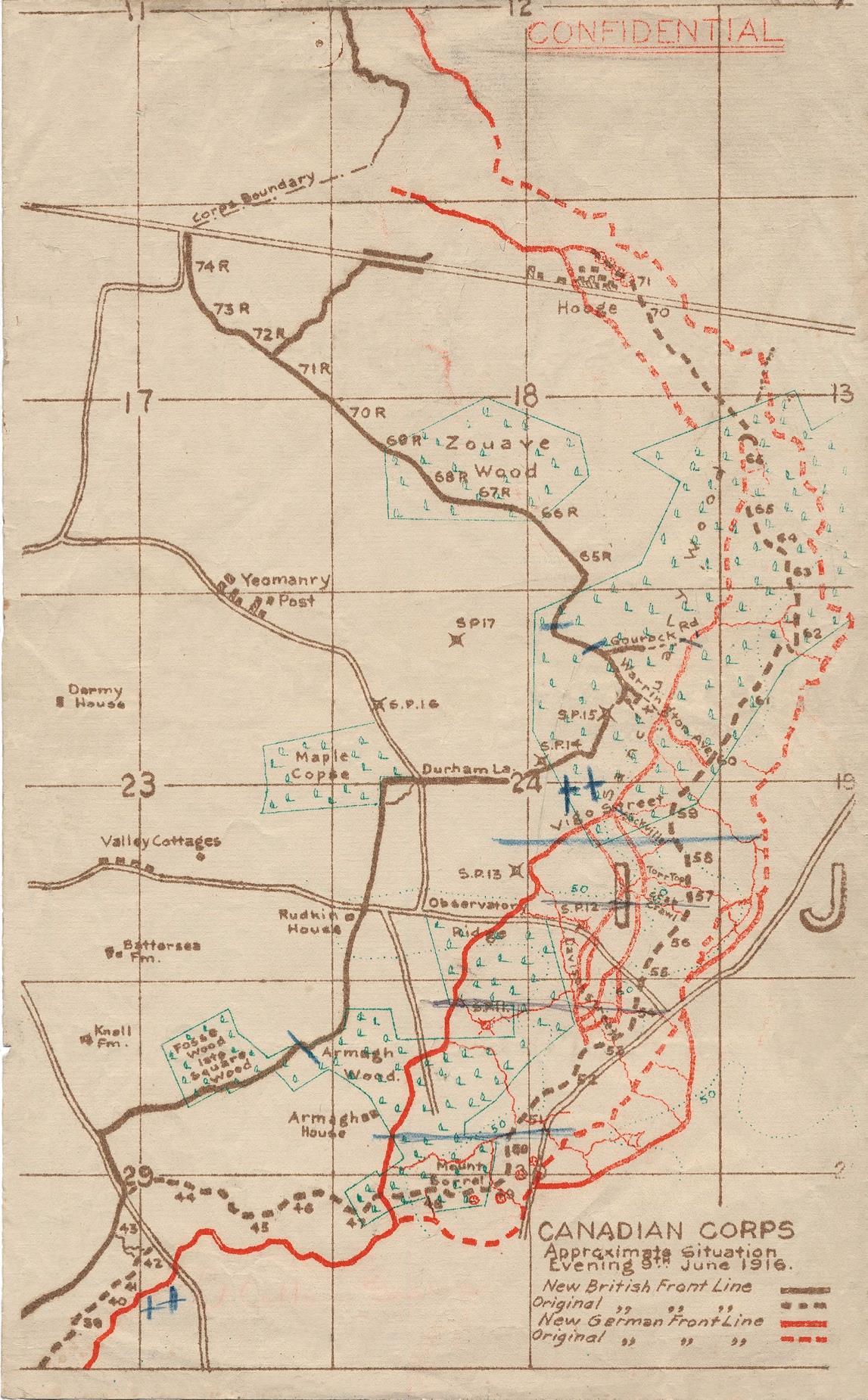
During the morning of 2 June the Germans opened up a severe bombardment along the front, support and communicating trenches extending north of Hill 60 to Hooge, preliminary to an attack designed to draw British troops away from their preparations for the Somme offensive and to complete their occupation of the only high points that still remained in Allied hands Mount Sorrel, Hill 61 (to the immediate south of Tor Top) and Hill 62. The artillery preparation had been so severe that the Germans succeeded in penetrating the Allied trenches and by the evening of that day they were in possession of a good deal of their objectives. Called out of Divisional Reserve on 1 June, 49th battalion (7th Brigade, 3rd Canadian Division) marched to Belgium Chateau at 2 pm on 2 June fronted by a brass band; but, coming under heavy shellfire they moved to the ramparts in Ypres where they received an order to proceed to Sanctuary Wood to participate in a counter attack. At 2.10 am the battalion was in position but since other attacking units had not yet reached the front the attack was delayed until 7 am. Lieut Col Colonel Griesbach of 7th Brigade reported that:
At 7 am on 3 June the 49th Bn did attack in accordance with Operation Orders, with its left on Gourack Road and its right on Warrington Avenue and succeeded in getting up Warrington Avenue within 60 yards of the German’s front line (our old front line). The attack moved forward everywhere about 200 yards across the open. It was broken down by the enemy’s rifle, Machine Gun and artillery rifle fire. The enemy’s M.G and rifle fire was opened from our old front line, from Vigo Street and from the Bird Cage and from the enemy’s former front line. … The attack along the trenches, Warrington, Bydand and Gourack Avenues was held up by reason of a shortage of bombs. … During this day this battalion had 5 officers killed and 8 wounded. [ORs killed 179; wounded and missing 70.]359
Sketch of the Birdcage, a German strongpoint opposite ‘62’.360
359 49th battalion diary, RG9 III D 3. Volume/box number: 4940. File number: 440. Container: T 10747; 7th Brigade diary, RG9 III D 3. Volume/box number: 4892. File number: 277. Container: T 10688 360 TNA WO 95 2838 1 5
17. the ‘93’ and their stories 167
By the end of the fighting on 14 June the Canadians had managed to restore the front line more or less to its position prior to 2 June. In the meantime, Norman’s body was lost and presumably lies today in that part of Sanctuary Wood which accommodated the attack of 49th battalion on 3 June, no great distance from fellow OPs A E Bullock and A C Challoner, who had fallen in 1915.
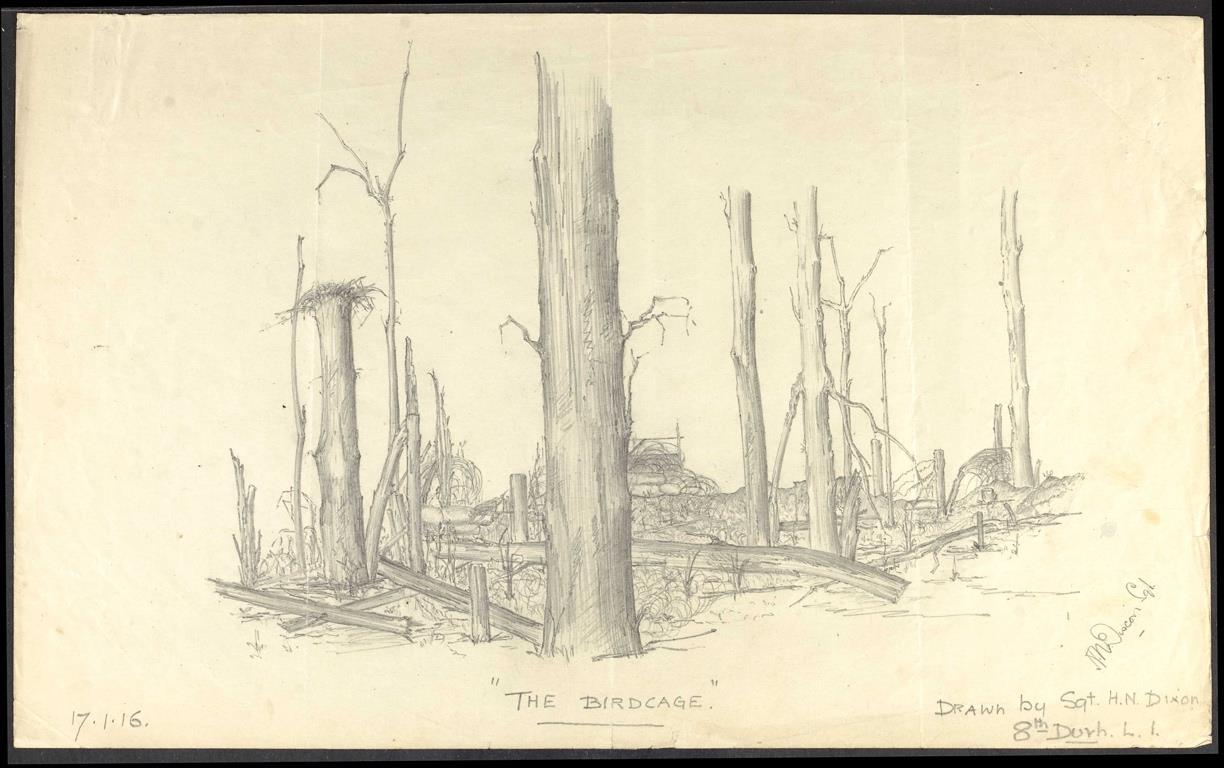
Mitton, Private Ralph Heslop, 429223 3 June 1916, Mount Sorrell SPS 1892 1895
7th Bn. British Columbia Regiment Ypres (Memorial Gate) Memorial Panel 18-28-30 Age 36
Ralph was born in London on 8 May 1878, the son of Edgar W Mitton and his wife Phoebe. He attended SPS from 1892 to 1895. The 1901 census shows that he lived with his parents at 34 Hamilton Road, Ealing. At some point he emigrated to Canada where he became a cattle rancher in Alberta. On 17 March 1915 he joined the Canadian Expeditionary Force, attesting in New Westminster. Ralph sailed from Montreal in S S Scandinavia on 1 October 1915, arriving in England on 10 October. After a period of training he embarked for France on 31 December and on 15 January 1916 proceeded to join the unit to which he was assigned, the 7th battalion (2nd Canadian Brigade, 1st Canadian Division).
On the night of 31 May 1 June the 2nd Canadian Brigade held the section of line running south west from just south of Mount Sorrell to The Ravine in the Verbrandermolen sub sector. The 7th battalion was in support. Its Headquarters were in Railway Dugouts and each of the four companies were distributed variously at Sunken Road / SPs 8 and 9, Battersea Farm, Blauwepoort Farm and Woodcote House (better known as Bedford House). By 11 am on 2 June a terrific bombardment occurred on the front to the left of 1st Division, in that section of line running north from Mount Sorrell to Hooge. By midday it was clear that an emergency situation had developed in this sector, resulting in 7th battalion being ordered to Stand To at 12.30pm. At 1 pm it was reported that a mine had been exploded in Trench 48 (i.e. at Mount Sorrell) and that the enemy had attacked, occupying the whole of the front line and support trenches in this vicinity. At this juncture 7th battalion was ordered to form a defensive flank running from Square Wood (better known as Fosse Wood) Battersea Farm Zillebeke. From 3.30 pm the 7th battalion was ordered to re distribute as follows: 2 platoons reinforcing 5th battalion at Square (Fosse) Wood; 2 platoons behind hedges on Observatory Ridge; 2 Companies in the neighbourhood of Battersea Farm and 1 Company dug in near Zillebeke Switch. At 10 pm the battalion reported that they were in position and organised for an counter attack.
At 10.40 pm on 2 June the 1st Canadian Division HQ issued an Operation Order that: Latest reports show the enemy to be in possession of Mount Sorrel and part of Armagh Wood, the eastern part of Observatory Ridge, including our front line trenches from Trench 53 to Trench 62 and to be consolidating. All ground lost today will be retaken tonight [in fact the operation occurred in the morning of 3 June] under the orders of Brig General Nairne,
17. the ‘93’ and their stories 169
Commanding 3rd Canadian Division … The 2nd Canadian Infantry Brigade will also receive orders from the 3rd Canadian Division for the retaking of Mount Sorrell …361
The counter attack took place on 3 June, the 7th battalion leading the assault on Mount Sorrell at about 6.40 am. The battalion diary tersely recorded that:
During morning 2 companies [A and D] make counter attack, successful but suffered severely in casualties. Intense bombardment all night and during this day. Bn consolidate positions gained. Beautiful weather. Battalion relieved at night [11 to 12 pm], during which enemy attacked on our front and [was] repulsed.362
A report in 2nd Brigade diary adds some detail:
[Our] intense artillery bombardment commenced about 6.40 am to 7.15 am. When the 3rd Division fired the rockets for the assault, the 7th battalion went over the parapet… Lt Elliott A Coy on the right, supported by C Coy under Lt Cairstairs. On the left Capt Holmes D.S.O in charge of Band D Coys of the 7th supported by C Coy of the 10th battalion under Capt L.W. Fisher. Capt Homes, whose companies were weak in number, found himself confronted by a trench which extended roughly from about Armagh House to SP 11 protected by wire entanglements. This trench had been reported by Lt Merstan of the 7th battalion, but it was very difficult to locate accurately as it was hidden by the thick wood. The going through the wood was very difficult on account of the shell holes, drains and thick undergrowth. It took sometime before Capt Holmes could close up his men for an assault, his officers all being wounded. The rest of this company on the left made a flanking movement and got past this new German trench in Armagh Wood towards [trench] 51 in our original front line, but seem to have been caught by machine gun fire from SP 11. On the right, Lt Elliot’s Company passing the south of Armagh House succeeded in reaching trench 47 but he was killed and most of his command became casualties by the machine guns from The Snout and German trenches in the vicinity. The supporting Company under Lt Carstairs moved over the open [ground] and then went into the machine gun trench which is immediately N.E of trench 47 to avoid the machine gun fire. Then they were held up most of the day and got out at dusk. … The 7th battalion was gradually withdrawn to permit of our Artillery coming into operation.363
361 1st Canadian Division Operation Order No. 73, 2 June 1916. RG9 III D 3, Volume number: 4828, Microfilm reel number: T 7188, T 7188, File number: 53
362 From 7th bn diary RG9 III D 3, Volume number: 4917, Microfilm reel number: T 10709, T 10709, File number: 365, File part: 1=1914/10/16 1915/12/31;2=1916/01/01 1916/11/30
363 RG9 III D 3. Volume/box number: 4871. File number: 203. Appendix A. 2nd Canadian Infantry Brigade. [Report] describing the operation in the Ypres Salient from 2 June to 14 June 1916 pp 6 7
17. the ‘93’ and their stories 170
With a rank no higher than that of Private, Ralph is not mentioned by name in the battalion diary; nor is it known in which Company he served and thus it is not possible to identify an exact location in which he fell. The evidence suggest that he was killed in Armagh Wood or its close environs. His body was lost and he is commemorated on the Ypres (Menin Gate) Memorial. A Circumstances of Casualty report record that: [Ralph] was wounded in the stomach by a machine gun bullet while taking part in an attack at Mount Sorrell, and, that shortly afterwards he was hit by a shell and killed.364
In an account published in 1930 by Captain T. V Scudamore, 7th Canadian battalion, experiences of the unit were described thus:
For the next four months [from April 1916], the 7th experienced the hardest period that they were ever to go through. Mud everywhere, the high ground controlled by the enemy; constant bombardment, sniping and local attacks took heavy toll … German and Allied dead lay unburied everywhere to add to the horror of the scene. Lice on the body and rats in the line were minor evils in this veritable corner of Hell… Between the 1st and 4th June, our casualties were particularly heavy … The morale of the regiment was by no means shaken, but the best felt depressed at the wastage without results and the loss of their friends… The battalion counter attacked on 3 June from Square [Fosse] Wood, with the object of recapturing Sorrel Hill. It was a case of necessity, as it was imperative to check the enemy’s advance. Our attack started late, at 6.30 am and was met by a withering fire from the enemy’s machine guns and shells, which confined us to our trenches, and in the late afternoon the survivors were withdrawn and taken out of the trenches to receive a few days rest and to reorganise… Without doubt, when the battalion was withdrawn on 11 August, the men had passed through the most trying experience that they were to have during the whole war.365
364 Circumstances of Casuality 649 M 13925
365 Scudamore, T. V, A Short History of the 7th Battalion C.E.F (1930)
17. the ‘93’ and their stories 171
Dobson, Captain Wilfrid James 9 July 1916, Hill 62 SPS 1890 - 1897

1st Bn. Canadian Infantry (Western Ontario Regiment) Hooge Crater Cemetery XVI.E.15 Age 38
Wilfrid James Dobson366
Wilfrid was the son of William Cleaver Dobson and his wife Charlotte. Wilfrid left SPS in 1897, from whence he proceeded to Exeter College, Oxford. (His elder brother was John F. Dobson, Captain of School in 1894, and, as reported in various entries in The Pauline, something of a glittering star.) In 1907 he took up a position teaching languages at Bancrofts. In September 1909 he arrived in Canada to work as an Assistant Schoolmaster at Upper Canada College in Toronto. In 1911 Wilfrid moved to Ridley College in St Catharines, Ontario where he taught commercial business; a year later he left to go into business. An accomplished cricketer, Wilfrid played for Cranleigh C.C (the location of the family home in England), Exeter College and Toronto C.C, the last of which he was secretary and led as captain in 1914.
Wilfrid’s service papers are somewhat confused. Nonetheless, it is apparent that he attested on 23 September 1914 in Valcartier in Canada and in the first instance was assigned as a private in the 3rd battalion (Queen’s Own Rifles Regiment). This unit sailed from Quebec on board the SS Laurentic on 4 October 1914, arriving in England ten days later with a strength of 45 officers and 1,121 men. Wilfrid trained with this unit in England before
366 Image in Young, Archibald Hope, (ed.), The War Book of Upper Canada College, Toronto, 1923. Printed with permission of Upper Canada College, Toronto.
17. the ‘93’ and their stories 172
transferring on 8 January 1915 to the 9th (Reserve) battalion, the Queen’s Royal Regiment. On 30 June 1915 he moved to the 1st battalion Canadian Expeditionary Force in which for a period of time from 23 August he was a temporary Captain and, from 10 October, Adjutant, responsible for signing off the war diary. At the time of his death he was acting Major in A Company.
On 1 July the 1st battalion Canadian Infantry (1st Brigade, 1st Canadian Division) was in corps reserve at Lijssenthoek, south west of Poperinghe. On the night of 4 5 July it moved into trenches 53 58 in front of Maple Copse, extending about 500 yards in length and sitting astride Observatory Ridge (see map in entry for N R Mack Jost). The battalion had been instructed to participate in an attack beginning midnight 8 9 July, but before this could commence the Germans unleased a heavy bombardment of Wilrid’s unit:
At 7.10 pm [on 9 July] the 1st Canadian Battalion and the 4th Canadian Battalion [in front of Mount Sorrell] reported heavy hostile shelling of their front and support lines. …. Throughout the entire period from 7.10pm to 10.20 pm a heavy fire had been maintained by the enemy on our front and support lines, and vigorous counter battery work had been carried out by these on our battery positions. The bombardment appears to have been carried out by field guns and howitzers, and an abnormally large proportion of trench mortars of various calibres. At one time bombs from eight different 50 kilo trench mortars were simultaneously visible. Our trenches suffered seriously all along the line, particularly trenches 53, 54, 55 and 56, front and support and trenches 57S, 58S and 59S. The casualties reported from noon 9 July to noon 10 July … may be taken as practically all having occurred during this bombardment.
Given Wilfrid’s rank of Acting Major it is most curious that the unit diary does not mention his death, a victim of the heavy bombardment just described:
9 Jul. Enemy’s guns ranged on our positions … Intense bombardment of our whole area, commenced and continued till 10.05 pm. Heavy trench mortars used by the enemy. Between 9 pm and 10 pm enemy fire was lifted onto our support lines, many shells landing around Battalion Headquarters. Our trenches were severely damaged. Trench mortars and one machine gun buried, several dugouts buried and about 100 men killed or wounded.367
367 RG9 III D 3. Volume/box number: 4912. File number: 350. Container: T 10704. File Part 1=1914/09/02 1915/12/31; 2=1916/01/01 1916/11/30. Report on Operations of 9 July by 1st Brigade commander, dated 11 July
17. the ‘93’ and their stories 173
In the aftermath of the war, during the clearing of the battlefields and the concentration of graves, Wilfrid’s body, along with those of two others, was found at 28.NW. I.24.c.6.6.368 All three were exhumed from this place (adjacent to 1st battalion HQ at 28. NW. I.24.c.6.4)and now lie adjacent to each other in Hooge Crater Cemetery.
The Circumstances of Death Register states that:
During the action in the vicinity of Zillebeke on 9 July 1916, [Wilfrid] was literally blown to pieces by an enemy high explosive shell.369 Wilfrid’s headstone in Hooge Crater Cemetery.370
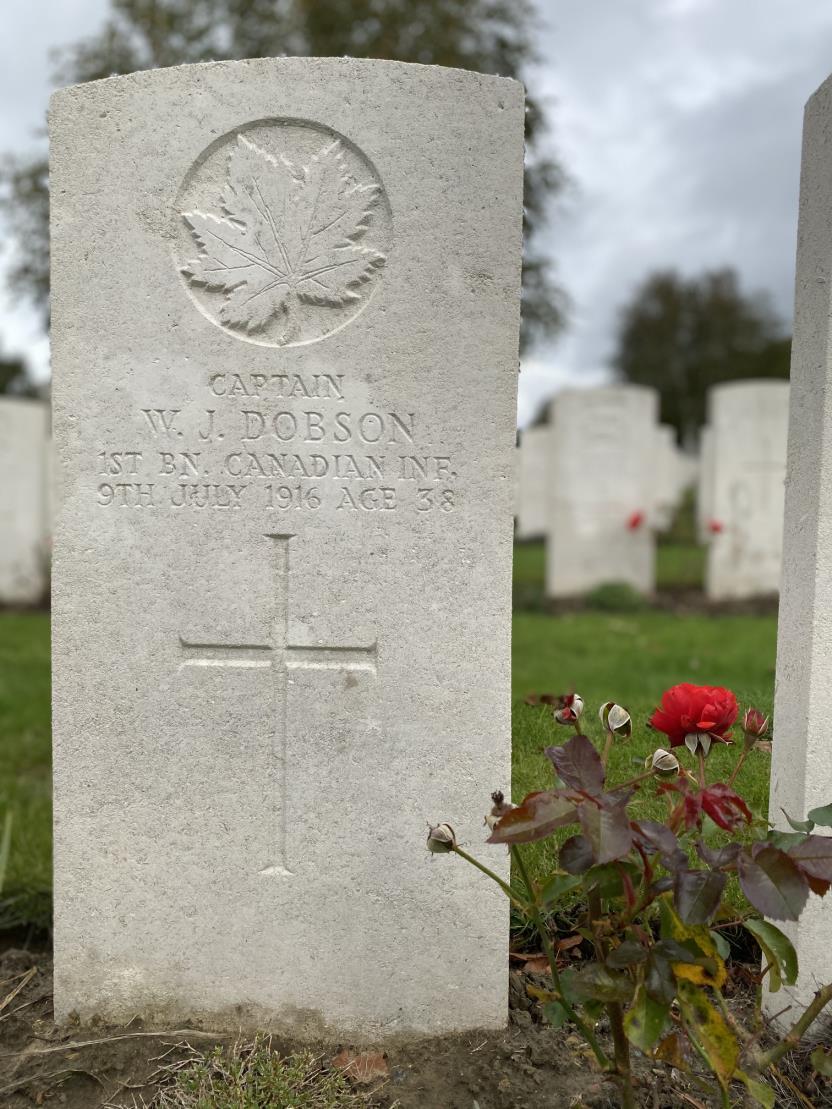
368 CWGC, Burial Return, Zillebeke 177/225E, 28 July 1919. The two others found in the same grave were Lt. A.V. Rimmer and Sgt R. Miller 400748.
369 Library and Archives Canada. Circumstances of Death Registers, First World War. Surnames: Deuel to Domoney. Microform Sequence 28; Volume Number 31829_B016737. Reference RG150, 1992 93/314, 172. Page 841 of 1084
370 Author’s photo
17. the ‘93’ and their stories 174
Haldane, 2nd Lt James Oswald 9 August 1916, Caesar’s Nose SPS 1891 – 1892
6th Bn, attached 1st Bn, Rifle Brigade Essex Farm Cemetery III.B.6 Age 37
James was the son of Robert Camperdown Haldane, J.P., and Emily Haldane (nee Anderson). He enjoyed only a short period of time at SPS before leaving aged 12 to join Loretto School near Edinburgh. From there he proceeded to Jesus College, Cambridge. He graduated in 1902 with a 2nd Class (2nd Division) degree in the Classical Tripos. James was a member of the Cambridge University Rifle Volunteer Corps (CURVC); as such, in 1900 he became a member of the Volunteer Service Company of the 1st Suffolk Regiment that fought in the Boer War. A friend contributed the following to his obituary in The Pauline:
When the South African War broke out he was an undergraduate of Jesus College, Cambridge, and was one of the contingent from the C.U.R.V. which formed part of the Volunteer Service Company of the 1st Batt. Suffolk Regt. He served as a private for fifteen months, chiefly in the Transvaal. After the war he obtained an appointment in the Uganda Civil Service, in which he became eventually District Commissioner of Toro. For the greater part of his eleven years service in Uganda he was stationed in the remotest parts of that Protectorate, near Albert Nyanza and the Congo border. He resigned his post, abandoning all pension rights as well, in order to return to England and join the Army. Shy and retiring in disposition, Haldane was the most utterly unselfish man the writer of these lines has ever met. He had a splendid reputation with his superiors in Uganda, who exerted all their influence with him to induce him to remain at his post there, but without success. To others
371 Image of James as an undergraduate at Jesus College, Cambridge. By kind permission of the Master and Fellows of Jesus College.
17. the ‘93’ and their stories 175
 James Oswald Haldane371
James Oswald Haldane371
it might seem that his duty lay in Uganda, but Haldane heard the call otherwise and has laid down his life in response to it.372
It is not known when James first joined the 1st battalion Rifle Brigade (11th Brigade, 4th Division). If he had been with the unit when it first crossed to France on 23 August 1914 he will have been considerably bloodied by the time he was commissioned 2nd Lieutenant on 17 February 1916, even moreso by the time he fell in the Salient because his unit experienced the rigours of the Somme in July 1916. In order to help its recuperation, the unit was relieved from the Somme sector and in August 1916 was inhabiting a relatively quiet part of the line in the northern sector of the Salient. During the evening of 8 August the unit had left their billets on the west bank of the Ypres Canal north of Ypres and were in the process of relieving the 1st battalion Somerset Light Infantry in the front line trenches in front of a German part of the line with a pronounced salient, shown on later maps as Caesar’s Nose.373 Perhaps aware of the timing of the relief, the Germans chose this moment to deliver a phosgene gas attack at 10.20 pm, followed by an intense hostile barrage of front line trenches, communication trenches and the canal from 10.35 to 11.30 pm.
All the reports make it clear that the impact of the gas attack was devastating, especially so for 1st Rifle Brigade and 1st Somerset Light Infantry because not only were the trenches very crowded but the process of relief diminished mens’ capacity to respond quickly to the arrival of gas:
In the vicinity of [trench] E.28 [i.e. a section of the front line trenches being relieved by 1st Rifle Brigade] there were at least 200 cases that were immediately fatal … It was pointed out that vermorel sprayers were no earthly use against Phosgene. They have no effect whatever on this gas.374
The enemy discharged gas on a frontage 28. NW.C.14.a.7.1 to 28. NW.C.13.b.8.8. The relief [of 1st Somerset Light Infantry by 1st battalion Rifle Brigade] was in progress at the time of the gas attack, meaning that there was a double garrison in the trenches of E.28 at the moment when the gas was discharged. It was here that most of the casualties occurred, abut 200 men being immediately gassed. Owing to the proximity of the Germany trenches,
372
373
The Pauline, 34 22 Nov 1916, p 144
TNA WO 95 1496 1 5. The unit diary states the locations of the billets as Canal Bank 28. NW. B.12.d.9.2 28. NW.C.19.c.2.5; the trenches extended between 28. NW.C.7.c.0.5 28. NW.C.13.b.7.4
374
TNA WO 95 1445 12. Notes on Report by 4th Division of the Gas Attack on the night of 8
17. the ‘93’ and their stories 176
the crowded state of the trenches and the men wearing full marching order, helmets were not put on quickly enough.375
11 officers and 194 ORs suffered from the immediate effect [of the gas], and the large majority of these exhibited the following common symptoms: very constricting pain in chest and throat, severe spasmodic cough, cyanosis, dyspnoea, nausea, vomiting, and later profuse watery, frothy and even blood stained expectoration. … It appears that most of the men affected had inhaled the gas for a few seconds before putting the helmet on; others inhaled it after taking it off.376
James most likely fell in either the frontline or communication trenches directly in front of Caesar’s Nose. A fellow officer stated that ‘while trying to bind up one of his men, [James] took off his gas mask in order to see better and died almost immediately’.377 His body was brought back to the Canal bank and buried at Essex Farm Cemetery along with 34 others from 1st Rifle Brigade and 38 Somerset Light Infantry who fell 8 9 August.
375
TNA WO 95 1445 12. Report on Gas Attack on the 11th Infantry Bde on 8 August by Brigadier General Rees, 11 Brigade, 12 August
376
TNA WO 95 1445 12. Report on Casualties in Gas Attack by ADMS, 4th Division
377 The Pauline, 34 227 Nov 1916 p 144
17. the ‘93’ and their stories 177
Brown, Captain Ian Macdonald 15 November 1916, Dickebusch SPS 1902 1904
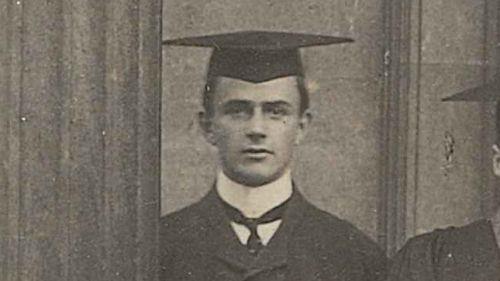
Royal Army Medical Corps, attd. 190th Brigade Royal Field Artillery Dickebusch New Military Cemetery L.14 Age 28
Ian Macdonald Brown378
Ian was the younger son of Dr. Macdonald Brown and Caroline Helen Macdonald Brown and the husband of Dora Macdonald Brown, with whom he had one infant son. He left SPS in 1904 and in 1907 proceeded to Downing College, Cambridge, where he took the Natural Science Tripos in 1910. After a year's study of medicine in Edinburgh, Ian entered the London Hospital, and qualified as M.R.C.S., L.R.C.P., in July 1914. He had intended to enter for his final examination in medicine at Cambridge in December but he volunteered his services to the military as soon as war was declared and was given a temporary commission in the Royal Army Medical Corps. After serving a while in Aldershot, Ian was sent to Gallipoli in June 1915, but was invalided home in August. From that time until the middle of September he held various regimental and hospital posts at Cosham, Winchester, and other centres of the Southern Command. At the end of September he was sent to Flanders, where he acted as Surgeon, first to the New Zealand Division, and subsequently to the 190th Brigade R.F.A.
378 Downing College Archive ref. DCPH/2/1/65
17. the ‘93’ and their stories 178
In November 1916 the 190th Brigade R.F.A was attached to the 41st Divisional Artillery. On 14 November it relieved the 4th Australian Divisional Artillery in the St Eloi Diependaal Sectors, with 190th Brigade in the latter part of the sector. The various unit diaries do not reveal the locations of the 190th Brigade batteries beyond referencing that they were distributed in the vicinity of Dickebusch and, newly located, were spending time registering enemy guns:
14 Nov. Relief complete. Batteries registering.
15 Nov. A fine cold day. Batteries registering. Some hostile shelling of Dickebusch379
14 Nov. The remaining sections came up with HQs and the relief was completed. Lt Col G. A. Garden took over command of the Diependaal (right) group consisting of 190th Bde batteries as well as C/187 and B/187 [batteries]. Registration carried out during the day. 15 Nov. Registration continued. Captain I. M. Brown, RAMC killed and 1 OR wounded.380
An anonymous contribution to Ian’s obituary suggests that he was killed whilst attending to the sick and wounded under shell fire. A gunner wrote to Ian’s family:
At the time he received his mortal wound he was returning from D Battery after visiting the sick men, to whom he devoted all his time. The loss of the captain is very deeply felt by all the boys of the brigade, with whom he was so very popular.381
Buried in Dickebusch New Military Cemetery, Ian lies no great distance from where he fell, though locating that position with any precision is not possible from the available evidence. There are no other gunners from 190th Brigade killed on the same day as Ian who are also buried in Dickebusch New Military Cemetery, perhaps suggesting that he was not killed by a direct hit on a battery that he was visiting. Instead, since there are infantry killed on 15 November by enemy shells fired upon Dickebusch, on balance it is likely that Ian was killed by the hostile shelling of that place.382
379
TNA WO 95 2620 3 1 380 TNA WO 95 2625 5 381 http://www.ramc ww1.com/profile.php?profile_id=9486 382
TNA WO 95 2638 5. ‘15 Nov. On our way through Dickebusch two shells fell among the men of C Doy who were having dinner. 5 men were killed [including officers Todd and Tugwell] and eleven men were wounded. 11th bn Queen’s (Royal West Surrey Regiment)’.
17. the ‘93’ and their stories 179
Frankland, 2nd Lt John Cecil 10 January 1917, Wieltje SPS 1914 1915
1/5th battalion Loyal North Lancashire Regiment, C Company Ypres (Menin Gate) Memorial Panel 41 and 43 Age 19
John was the son of John Frankland and his wife Elizabeth. Born in Chorley, Lancashire this no doubt explains his decision to serve in a northern regiment. John attended Chorley Municipal Secondary School before transferring to SPS in the Michaelmas Term of 1914, when he was a member of Mr Armitage’s house.383 John was in the Classical VIII. It was apparently his original intention ultimately to take Orders. He joined the Inns of Court O.T.C. in September 1915, and was gazetted to the Loyal North Lancashire Regiment in January 1916. He went to France in June.
In January 1917 1/5th battalion Loyal North Lancashire Regiment (166th Brigade, 55th Division) was rotating in and out of the line of trenches in front of Wieltje. On 7 January the unit had been relieved and was in billets on the west bank of the Yser Canal, north of Ypres. John was selected to lead a party on the right flank of what was described by the Operation Order issued on 2 January as:
A minor operation against the enemy’s trenches with the object of: i) killing and capturing the enemy ii) searching localities and obtaining information iii) destroying dugouts, machine gun and trench mortar emplacements.384
While the battalion was out of the line John, two other officers, and 140 ORs rehearsed the planned raid on open ground near the prison in Ypres.
On 10 January the raiding parties moved into position, the party led by John assembling at Prowse Farm at 3 pm, about one mile directly south of Wieltje. At 3.10 pm an artillery bombardment commenced on the enemy’s trenches; thirty minutes later the raiding parties left their assembly positions and crossed the front line at 5 pm, assuming a forward position
383 John’s name is listed on a memorial tablet at the school, now Parklands High School, Southport Rd, Chorley, Lancashire, PR7 1LL, England
384 TNA WO 95 2928 1 6, 166th Infantry Brigade Operation Order No. 41, issued by Brigade Major 166th Bde, 2 Jan 1917
17. the ‘93’ and their stories 180
in No Man’s Land in a forward ditch running south east from Argyll Farm. At 5.15 pm, under the cover of darkness, John’s party advanced on the positions it had been directed to attack the right section of Cambrai Trench and Cambrai Support Trench. As recorded by the battalion diarist, the party led by John encountered difficulties as soon as it left their forward position:
The party on the right, on reaching the enemy wire, found it uncut [by the artillery fire], and encountered heavy machine gun fire from Kaiser Bill on their right front. It was impossible for this party to enter the enemy trenches, and it sustained many casualties, 2nd Lieut Whitaker finally giving the order for the party to withdraw 2nd Lieut Frankland had been killed earlier in the engagement.385
Map showing the area of advance by the raiding party led by 2nd Lieutenant Frankland from Prowse Farm. Notice the prominent salient in the German line Kaiser Bill permitting deadly enfilading machine gun fire. The British trenches are shown in blue; those of the Germans, in red.386

385 TNA WO 95 2929 1
386 Reproduced with the permission of the National Library of Scotland https://maps.nls.uk/index.html The map is dated 1 April 1917, though the lines had not shifted for over a year.
17. the ‘93’ and their stories 181
An unsigned report in the battalion diary adds further details:
[The enemy] artillery was assisted by two aeroplanes which flew rather lower than usual over our lines … The raiding parties A [led by 2nd Lieutenant Frankland] and B advanced respectively from Prowse and Lone Farms … The right party A in its advance from the rendezvous lost its Bangalore Torpedo party by shell fire, and the wire being found insufficiently cut, no entry was possible. … Scouts had found the German parapet manned and were bombed by the enemy, thus preventing the wire being cut by hand.387
A contribution to John’s obituary published in The Pauline by an anonymous ‘brother officer’ states that:
Frankland was in a bit of a hole at the time [of his death], and in endeavouring to get out to give orders for the cutting [of the wire], he was hit through the head by a bullet and killed instantly.388
John’s body was never recovered. He is commemorated on the Ypres (Menin Gate) Memorial.
387 TNA WO 95 2929 1 Preliminary Report on Raid carried out by the 1/5th L.N.Lan Regt, 166th Infantry Brigade on the afternoon of 10th January 1917. A Bangalore Torpedo is an explosive charge placed within one or several connected tubes.
388 The Pauline, 35 230 March 1917 p 9
17. the ‘93’ and their stories 182
Misquith, Lt Juan Carlos 4 February 1917, Ypres SPS 1905 – 1909
CII Brigade Royal Field Artillery, A Battery Lijssenthoek Military Cemetery X.A.5 Age 26
Juan was the son of Walter Misquith and his wife, Minnie. He was born in South Africa. He attended SPS 1905 – 1909, but other than the details printed in his obituary, The Pauline records no details of his school career. After leaving SPS he went to Canada and joined the R.N.W. M.P., which he resigned to go to British East Africa, where he was engaged in coffee growing. On the declaration of war he joined the forces at Nairobi, and was wounded at the action of Longido. He returned to England and was granted his commission. At the time of his death, Juan had served at the front since August 1915, during which period he was wounded three times. One of these occasions is recorded in the Admission and Discharge Records, showing that a gunshot wound to his right hand meant that he was hospitalised in Queen Alexandra’s Military Hospital at Millbank between 7 27 September 1915.389 He was known as a boxer at school, and was for a short time a boarder with Messrs. Armitage and Loane. Juan died on 4 February from a wound received by enemy shelling on 1 February.
The unit diary describes the fate of Juan:
1 Feb. [Battery] A/102 was shelled with about 150 42s and 5.9s. 2nd Lts S A Dickinson and L L Kellie and two OR killed; Lieut J C Misquith severely injured. No damage to material.
An entry a few days later records his death:
4 Feb. Lieut J C Misquith died of wounds received on 1 Feb at 10th Casualty Clearing Station, [to the south west of Poperinghe].390
The 23rd Division General Staff diary describes the heavy shelling that occurred on the day that Juan was mortally injured:
1 Feb. Considerable activity of artillery all day long. Rosslyn St, Oxford Street and Leinster Street were shelled with 4.2”. Zillebeke and the Tuileries were also shelled during the morning with 4.2” and 77 mm. The Gordon House locality came in for the usual shelling in the early morning and Ypres was heavily shelled during the morning, the Ramparts and the
389 TNA MH 106/1660. Admission and Discharge Book 390 TNA WO 95 2175 3 1
17. the ‘93’ and their stories 183
cathedral receiving much attention. Our artillery was very active firing in retaliation. Bright frosty day.391
CII Brigade Royal Field Artillery was attached to 23 Division. By late October this Division had moved up from the Somme area to take up a section of the line between Hooge and Armagh Wood, just north of Hill 60. As ever with Royal Field Artillery records, it is only rarely that the locations of Batteries are described. Moreover, the task of tracking their location is made yet more challenging because of the fact that, like other units, they were constantly moved around to try and prevent their registration by the enemy. Unfortunately, a study of the various diaries associated with CII Brigade does not reveal its location. However, clues to its general position can be obtained from other data. First, the other officer casualties Kellie and Dickinson named by the CII Brigade diarist as casualties of the shelling are both buried on 1 February in Menin Road South Military Cemetery, to the east of Ypres, a short distance from the Menin Gate; the CWGC records also show that the two ORs of CII Brigade killed on that day Gunner F W Gosling and Driver S (Soloman) Hart are buried in the same cemetery (in adjacent plots).392 The location of their graves none of which were the result of an exhumation and reburial suggest that they fell no great distance from where they now lie. Second, Battery HQ of X Corps (to which CII Brigade was attached) was located in January February at Bedford House, to the south of Ypres. Combined with a knowledge of the section of front held by 23rd Division, it is thus certain that the location of Juan’s Battery at the time he was killed was either in Ypres, or in the close locality of the town.
391 TNA 23 WO 95 2168 1 4 392 CWGC. Hart and Gosling are in plots I.Q.20 and I.Q.21 respectively.
17. the ‘93’ and their stories 184
Moses, 2nd Lt Vivian Sylvester 4 June 1917, Vierstraat SPS 1911 – 1916

11th Divisional Ammunition Column, Royal Field Artillery attd. Y.11 Medium Trench Mortar Battery393
La Laiterie Military Cemetery II.AA.24
Grave epitaph: An Only Son Willingly Gave His Young Life For His Country Age 19
Vivian Sylvester Moses394
Vivian was the son of Samuel Moses, and his wife Beatrice. Prior to joining St Paul’s in 1911 Vivian had attended University College School. At Vivian’s memorial service on 15 June, the Rev A A Green remarked:
Inheriting all the talent of his father, [Vivian’s] educational career was one of unbroken progress of success. In 1910, he gained the Senior Entrance Scholarship at University College School. In 1911 he obtained an Entrance Scholarship at St Paul’s. There he passed easily up to the highest rank in that great school and obtained an open Classical Scholarship at Emmanuel College, Cambridge in 1916.395
393
Trench mortars were short range artillery weapons designed principally to destroy enemy machine gun placements, sniper posts and trench fabric; larger mortars were used for cutting wire. From March 1916 most Divisions had three Medium Batteries designated X, Y and Z, followed by the number of the Division in which the unit served e.g. Y. 11 (Division). Each Medium Battery was composed of four 2” mortars. A Medium Mortar had a range of up to 500 yards.
394 © London Jewish Cultural Centre 2018
395 In Memorium, from the Rev. A.A. Green, 15 June 1917. With grateful thanks to © London Jewish Cultural Centre 2018
17. the ‘93’ and their stories 185
Vivian was a sergeant in the School O.T.C, gained his commission in December 1916, and went to the front in January. Vivian did not assume residence at Emmanuel College because of the war.
From mid May 11th Divisional Ammunition Column was preparing for the forthcoming offensive on the Messines Ridge. By early June the unit had moved into line in front of Wytschaete; all Batteries were employed ‘making dug outs and carrying up ammunition (night and day parties)’.396 At this time Vivian was attached to Y.11 Medium Trench Mortar Battery, located in the frontline opposite Wytschaete.
In the entry for 4 June, the 11th Division Trench Mortar Brigade diarist recorded:
746 rounds fired by TMs on enemy’s front and second line wire and trenches. All visible wire demolished. Very heavy retaliation. Two [of our] emplacements wrecked, together with howitzers. Also, a large amount of ammunition blown up. Casualties: killed 2nd Lieut V S Moses and 5 ORs.
The following day he added: The body of 2nd Lieut V S Moses was brought down from the gun position to the Laiterie, York Road.397
Vivian’s obituary published in The Pauline states that:
While observing for trench mortar firing near a gun emplacement in the trenches, [2nd Lieut Moses] was killed instantaneously by the explosion of a heavy shell from the enemy.398
396
TNA WO 95 1802 6, 21 31 May 397
TNA WO 95 1802 6
398 The Pauline, 35 233 July 1917 p 95
17. the ‘93’ and their stories 186
Allard, Captain Philip Hayward 23 June 1917, Zillebeke SPS 1908 1911
3rd Battery XLV Brigade, Royal Field Artillery Birr Cross Roads Cemetery II.E.14
Grave epitaph: What I Say Unto You I Say Unto All, Watch Mark 13th Age 23
Philip was the son of John Hayward Allard and Clarissa Mary Allard. At SPS he was a keen cricketer and played for the Second XI. After leaving SPS he took a course of study in Germany, and then became a student at the School of Science, South Kensington, belonging also to the O.T.C. On the outbreak of war he joined the R.F.A as 2nd Lieutenant, went to France in February 1915, soon got his promotion, and became Captain shortly before his death.
At the time he was killed Philip was commanding 3rd Battery XLV Brigade, Royal Field Artillery. This unit was attached to 8th Division. In mid June 8th Division came into the section of line east of Ypres running south from roughly Railway Wood to Zouave Wood. Tasked with covering the right of the Divisional line, three of the batteries of XLV Brigade 1st, 5th and 57th batteries were dug in along the northern edge of Zillebeke Lake, while 3rd battery was a short distance in front, at the south west corner of Moated Grange.399
The appalling conditions endured by Philip throughout the course of the week before his death what a fellow officer called ‘a very trying time’ are made clear in the narrative provided by the diarist of II Corps Royal Artillery:
17 June. Hostile artillery was exceedingly active during the day and night, the neighbourhood of Zillebeke Lake and Ypres being shelled very heavily. Hostile aircraft was also very active.
18 June. Hostile artillery was again very active, Ypres and Zillebeke Lake neighbourhood receiving much attention, about 700 rounds were fired on one of our 4.5” batteries resulting in the loss of two pieces.
19 June. During the last twenty four hours enemy artillery has continued to be very active, the areas I.15, I.16, I.21 and I.22 [i.e. the area immediately surrounding Zilllebeke Lake] being heavily shelled with guns of all calibres … 900 rounds were fired at one of our battery positions during the night.
399 Locations of the Brigade batteries are given in TNA WO 95 1694 2 3: 1st battery I.21.b.98.90; 3rd battery I.16.c.2.4; 5th battery I.15.d.7.1; 57th battery I.15.d.26.23; HQ in Ramparts at Ypres I.14.b.1.6. All references on map 28.NW.
17. the ‘93’ and their stories 187
20 June. Hostile artillery has again been very active during the past twenty four hours … the tracks and railways in I.15 and I.16 [north of Zillebeke Lake] … all received attention.
21 June. Hostile artillery was again active …. Enemy fire coming principally from the East was directed against Zillebeke Lake, Zillebeke Village and Bedford House …. Hostile aircraft have shown great actively over our lines, one squadron of 14 planes reconnoitring our battery positions near Zillebeke Lake.
22 June. Hostile artillery has again shown considerable activity.
23 June. Hostile artillery was again active, considerable shelling being reported on our support and reserve lines in I.17.a and b [i.e in the vicinity of Birr Cross Roads].400
Testimony printed as contributions to Philip’s obituary published in The Pauline describe how he was killed:
His Colonel wrote: I write to say how very sorry every officer and man in this brigade is to lose him. I have only been with the brigade a few weeks, but in that short time I have learned to love him, as all who knew him did. He was a most gallant officer and a charming companion. He is buried just where he was killed, in the battery position. I think he was killed in his sleep, and therefore suffered no pain.
From his Adjutant: The following are briefly the facts of the case. Poor Allard was killed by a direct hit on the dugout while he slept in the gun line. His death without doubt was instantaneous, and he cannot have suffered. I think the Colonel wrote at the time to Mrs. Crickmay (his aunt) explaining how it occurred. Allard was commanding the battery at the time, and had, I know, been specially complimented by the Colonel on the work he had had carried out on the day before his death. He was exceedingly popular, and his loss will be very greatly felt both by officers and men. He was a great friend of mine, and I cannot tell you how grieved I was to hear the sad news which was telephoned to me in the middle of the night.401
Philip’s body was in the first instance buried some 800 feet to the east of where 3rd battery was established.402 During the concentration of graves process in 1919, his remains were exhumed from this location and removed to Birr Cross Roads Cemetery.
Philip’s grave in Birr Cross Roads Cemetery403
400
401
The Pauline, 36 241 Nov 1918 pp 128 29; TNA WO 95 652 5
The Pauline, 36 241 Nov 1918 pp 128 29
402 CWGC. Concentration of Graves Burial Return, Birr Cross Roads Cemetery provides the reference I.16.c.8.5
403 Author’s photo
17. the ‘93’ and their stories 188
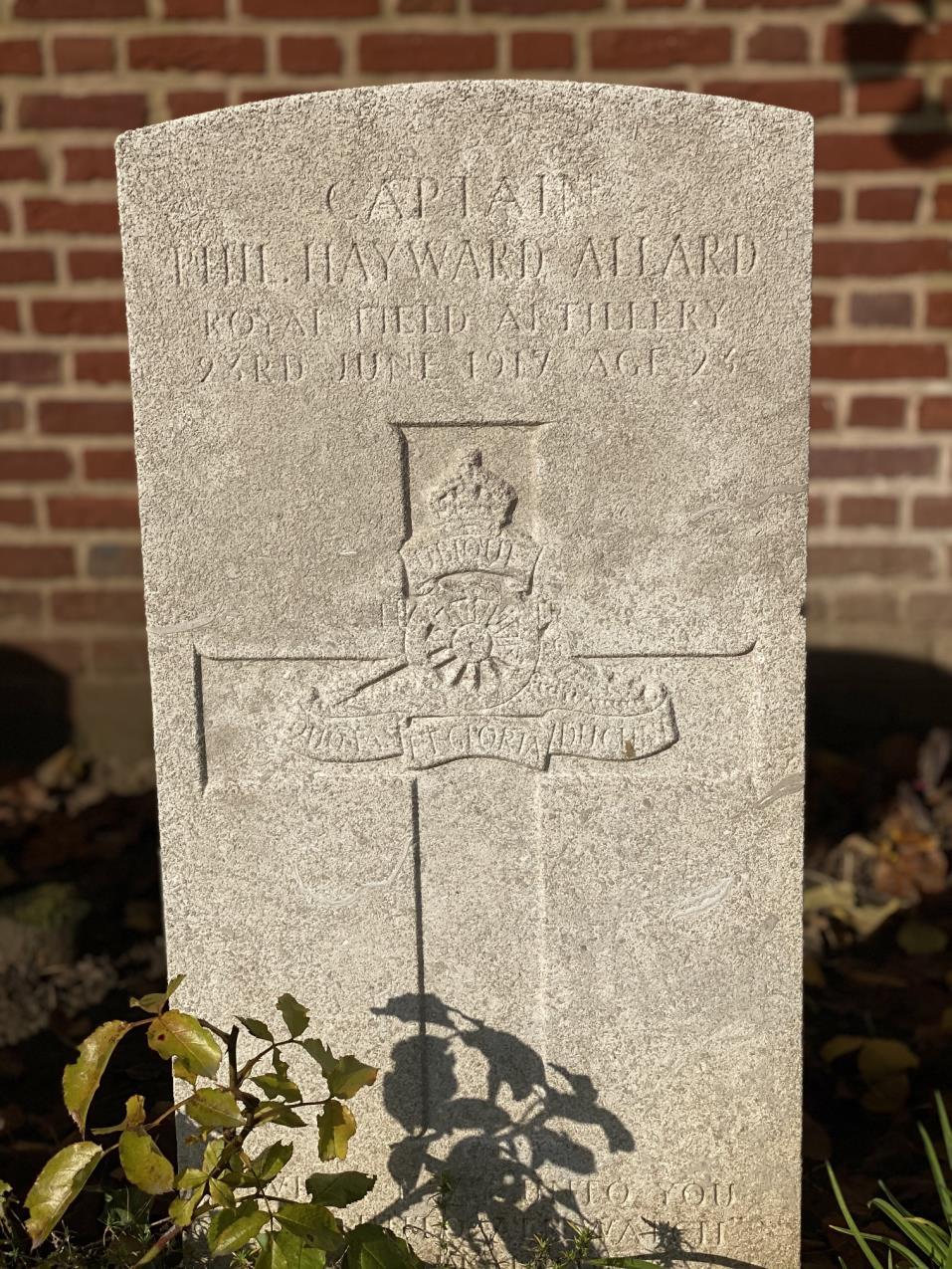
Foulsham, 2nd Lt Arthur Percy 20 July 1917, Dickebusch SPS 1911 1916
245th Siege battery, Royal Garrison Artillery Dickebusch New Military Cemetery Extension I. A.12 Age 19
404
Arthur was a Foundation Scholar at SPS. He appears to have made quite an impression during his time at the school, as reported in The Pauline: He was, among other things, a distinguished athlete, a member of the First XV 1916 17, and a good oar, though too tall to fit into the boat. But it was as a friend that he will be remembered, and for friendship he had a genius. Nicknames are sign of affection, and to all his friends Foulsham was "Dad," "Daddy," or " Knees". Those got to know him best, who knew him on the Brighton March or in the Timber Camp. During a wet day’s labour or at the tail end of a 20 mile march it was "Dad" who kept himself and others cheery, did the lion's share of work, and never failed in good humour. He was the best of kindly giants, the finest type of clean gentleman and Public Schoolboy, and those who were on terms of intimacy with him knew that his ideas were as healthy as his body. One wishes that, among his excellent photographs, he could have included snapshots of himself carrying tree trunks that no two of us could move or playfully throwing his fellow marchers about like toys during Brighton evenings. His friends, his School, his battery, and his country have lost one of the best that we can ever know.405
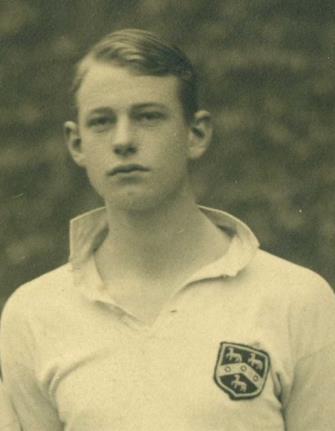
Important material to illuminate the wartime experiences of Arthur appears to be either sadly inadequate or, as in the instance of the diary of Arthur’s unit, 245th Siege battery Royal Garrison Artillery, missing altogether. Nonetheless, it is possible to establish some key details.
404 St Paul’s School Archive
405 The Pauline, 36, 237 Feb 1918 pp 8 9
17. the ‘93’ and their stories 190
Arthur Percy FoulshamIn June 1917 245th Siege battery had participated in the attack on Messines Ridge. By the start of July a huge number of guns was being concentrated under Fifth Army as a key part of the offensive planned for the end of the month, later to become known as the Battle of Passchendaele.406 As part of this concentration 245th Siege battery (composed of eight 6” howitzers) was transferred from 2nd Anzac Corps to the Fifth Army. The unit appears to have been placed under II Corps on the right flank and was almost certainly located in the vicinity of Dickebusch, a well established location for long range heavy guns. Some narrative in Fifth Army diary makes it clear that there was hostile enemy shelling of the Dickebusch sector on the day that Arthur was killed.407 The records of Dickebusch New Military Cemetery Extension show that, in addition to Arthur, ten other gunners seven of whom were members of D Battery, 277th Brigade (dug in around Dickebusch) were killed on 20 July, suggesting that the enemy shelling was accurate and devastating. It thus seems safe to assume that Arthur was killed either while attending to his duties in his Battery in Dickebusch, or perhaps while he was on an errand since no other soldiers from his unit appear to have been killed or, at least if they were, they are not buried in Dickebusch New Military Cemetery Extension suggesting that 245 Siege Battery did not receive a direct hit.
406 A total of 60% of the heavy howitzers were transferred from the Second Army to the Fifth Army.
407 TNA WO 95 520 1
17. the ‘93’ and their stories 191
Beit, Captain Rupert Owen 28 July 1917, Reninghelst SPS 1902 - 1907
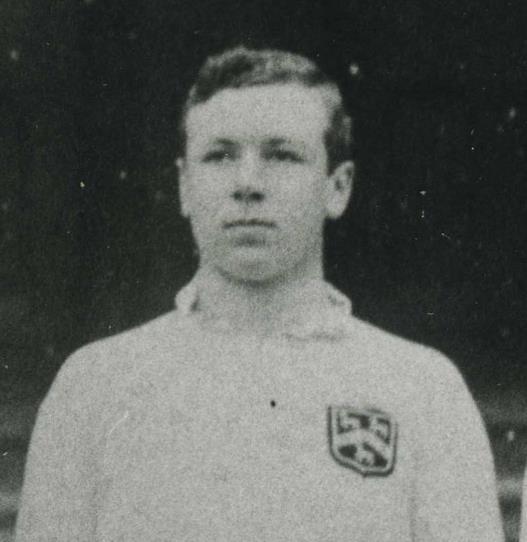
9th Labour Bn. (Army Troops) RE / 9th Artillery Tram Company Reninghelst New Military Cemetery III.D.23 Age 27
Rupert Owen Beit408
Rupert was born in Sydney, New South Wales in 1890. He was the only son of J H Owen Beit and his wife Elizabeth. After leaving SPS, London in 1907 Rupert attended Central Technical College where he completed a Civil and Mechanical Engineering Course, graduating in 1910. He spent part of the long vacation in 1909 working for Mssrs J Brown and Co.’s Works, Sheffield. In 1910 he was an Articled Pupil employed by Cleveland Bridge and Engineering Co. in Darlington. Rupert was in Brazil when war broke out. He returned from Buenos Aires on the Royal Mail Steam Packet, Demerara, arriving in Liverpool on 11 May 1915. He joined the Inns of Court OTC Royal Engineers and was commissioned on 24 July 1915; he proceeded to France on 22 February 1916.
At the time of his death Rupert was serving in the 9th Labour Battalion (Army Troops) RE. This unit seems to have been attached to various Corps with the Second and Fifth Armies during June July 1917 as needs required. On 1 June it had arrived in Poperinghe and was set to work on railway construction under 112 Railway Company RE. This was a dangerous endeavour, readily exposed to shell fire. On 8 June the battalion camp at International Corner (some 2 and ½ miles north east of Poperinghe) was shelled, with ‘one shell dropped amongst about 20 men’, though there were no casualties in this instance.409 At some point it seems that Rupert was instructed to undertake work for the 9th Artillery Tramway Company RE, no doubt as part of the preparations for 3rd Ypres. Unfortunately the war 408 St Paul’s School Archive 409 TNA WO 95 2035 3 3
17. the ‘93’ and their stories 192
diary for this unit does not appear to have survived but other sources make it clear that this unit was responsible for constructing feeder lines to battery positions before the batteries were ready to come into action, work that was frequently exposed to heavy shell fire.
In the absence of other evidence, it seems highly probable that Rupert was wounded in the field and brought to Reninghelst, a well established base for Field Ambulances and that he died in that place from his wounds. This is further supported by the fact that no other soldiers of either 9th Labour Battalion (Army Troops) RE or 9th Artillery Tramway Company RE are buried in the same cemetery as Rupert, suggesting that Rupert was the unlucky victim of everyday hostile fire.
17. the ‘93’ and their stories 193
Belfield, Captain Eric 31 July 1917, nr. Oosttaverne SPS 1905 1906
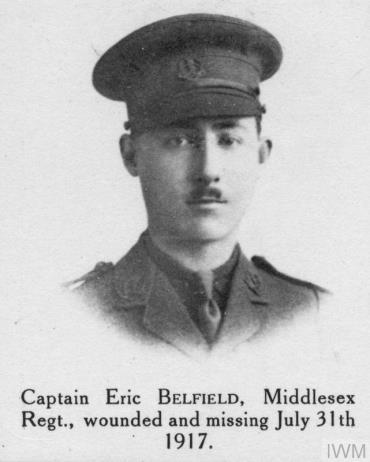
4th Bn. Duke of Cambridge’s Own (Middlesex) Ypres (Menin Gate) Memorial Panel 49 and 51 Age 26
410
Eric was born on 10 July 1891 in Moseley, Warwickshire, the son of Eric Belfield and his wife, Valerie Ermentrude. In 1901 the census records that he was a pupil at Walden House School, Beltinge Road, Herne Bay, Blean, Kent, England. Having attended SPS 1905 to 1906, he became an articled clerk to an architect in London. During this time he was boarding at Brightlands, Etchingham Park Road in Finchley. On 15 March 1909 Eric had joined the Honourable Artillery Company, attached to No. 4 Company. He resigned on 30 October 1911, most likely transferring to the Middlesex Regiment at this date and in which he joined 2nd battalion as a 2nd Lieutenant. On 7 November 1911 he embarked for France.
Upon joining the 4th battalion Middlesex (63rd Brigade, 37th Division) on 14 May 1917 Eric assumed command of D Company.411 In early July the unit was in Beaver Camp, located at the southwestern foothills of Mont Kemmel (SW 28 N.31.a.9.9), from whence it marched for periods in that part of the new front line in fact, a line of shell holes running a short distance to the west of Rifle Farm.412 On 28 July a fatigue party led by Eric was detailed to work on ‘the deepening and connecting of [this] “Shell Hole Line”’ in preparation for the offensive planned for 31 July.413
410
411
© IWM HU 113623
TNA WO 95 2528 1
412 This line ran from O.23.c.3.6 to O.23.a.8.4. TNA WO 95 2528 1
413 TNA WO 95 2528 1
17. the ‘93’ and their stories 194
Eric Belfield17. the ‘93’ and their stories 195© CrownCopyright
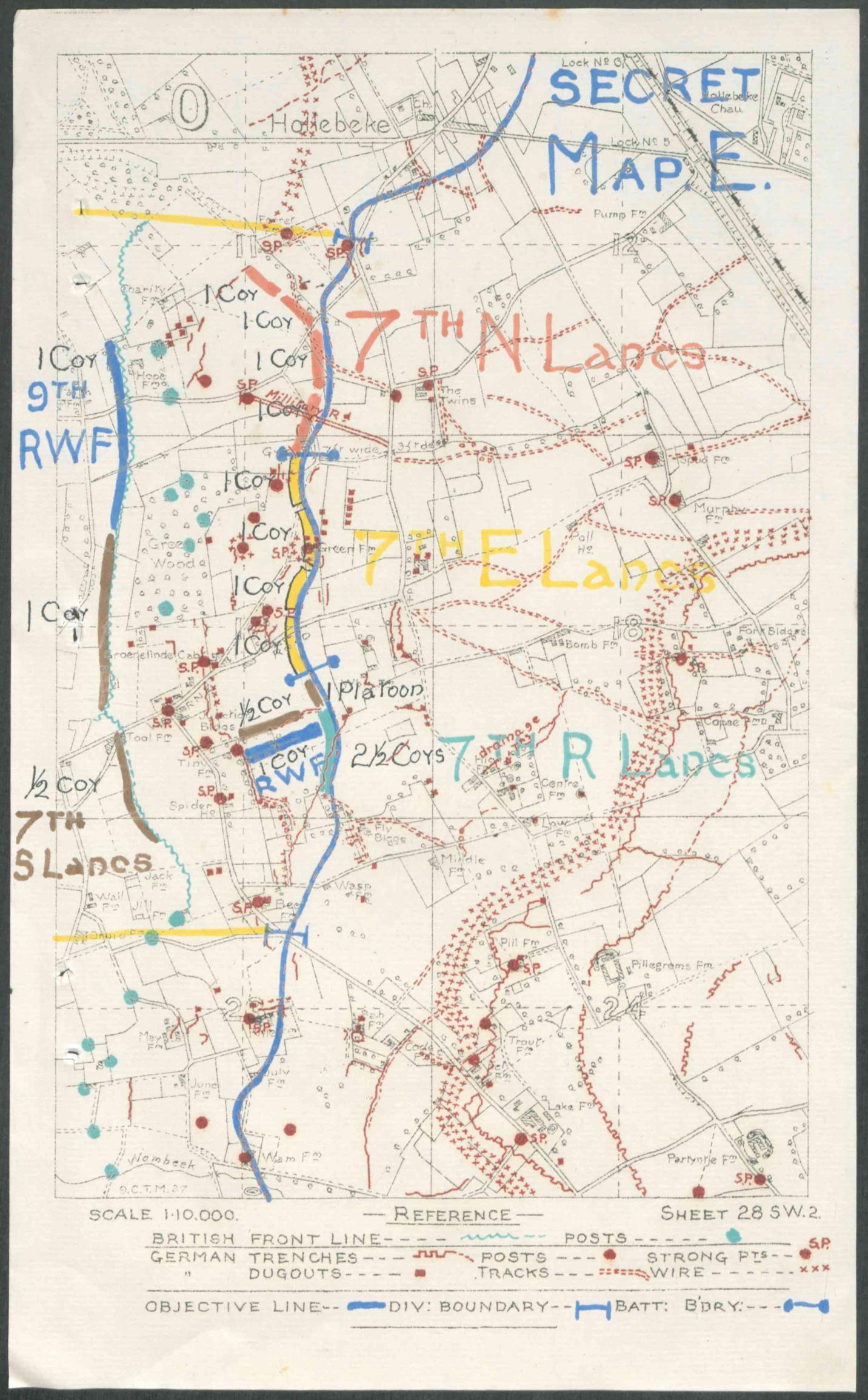
416
At 3.50 am, in conjunction with operations on a larger scale further north, 37th Division began its attack upon the line Beek Farm to the road junction at O.23.b.2.4. In accordance with orders, advancing under an artillery barrage, the 4th Middlesex battalion sought its objective, July Farm Rifle Farm. The battalion diary records Eric as ‘wounded and missing’417 in this attack:

31 July. The best evidence is still not available. The order of advance was: C Company on the Right; D Company on the Left; A Company supporting C and B Company in reserve. At Zero Hour the battalion left the trenches and formed up ‘as on parade’, parallel with the barrage. It was almost dark at this time. C Company had to form up on the east side of May Farm. As they passed over it, one German ran forward with hands up and surrendered. … At Z plus 40 [minutes i.e. 4.30 am], the battalion was on the objective: C Company Rifle Farm; D
416 McMaster University Website
417 Wyrall asserts that Belfield was taken prisoner. See Wyrall, Everard, Die Hards in the Great War Vol 2 p 365
17. the ‘93’ and their stories 196
Aerial view of Rifle Farm, 9 August 1917.Company after a gap to the left; A Company behind Rifle Farm. Its left platoon had its right on the northern enclosing hedge. … At about 1.15 pm a counter attack appeared …. [Our] position was considered untenable by the Officer in Command who ordered a retirement fighting on our front Shell Hole Line. … Enemy at May Farm commenced sniping about 5.30 am. The position was reconnoitred and it was estimated that it contained about 50 [Germans] in trenches. [B] Company moved out to attack them and cleared out half of the position. … Immediately after [May Farm] was cleared reinforcement of the East Lancashire Regiment began to arrive. … It is not apparent whether the enemy in May Farm were in trenches there when the leading Companies passed over in the dawn or whether they were hidden in shell holes. Captain E Belfield, wounded and missing.418
A Report in 37th Division diary records the attack thus:
The attacking troops reached their objective [i.e. the line July Farm Rifle Farm] in good order, but during the advance suffered some casualties from rifle and machine gun fire from the direction of Wam and Bee Farms and from the trench running south from Code Farm, and subsequently were heavily shelled as they came under direct observation from the Warneton Line. …. A pigeon message timed 5 am was received at 6.25 am stating that the left company [i.e. D Company, led by Captain Belfield] was in touch with and overlapping the right of the 19th Division just east of Bee Farm. … At 1.15 pm, owing to the line having been weakened by heavy casualties from shelling, the [enemy] counter attack succeeded in penetrating about, and north of, Bee Farm and with the exception of an officer and a weak platoon the whole of the left company became casualties. … At 2 pm it was realised at 63rd Infantry Bde HQ that the enemy had got in behind the left of the three companies of the 4th Middlesex and these companies [i.e. Companies A, C and D ] were practically wiped out …. [It was] reported that the fighting in front of Rifle Farm had been of a desperate character, and even hand to hand. … The 4th Middlesex suffered 214 casualties.419
It thus seems likely that Eric was lost somewhere in the vicinity of Rifle Farm Bee Farm. He is commemorated on the Ypres (Menin Gate) Memorial.
418
TNA WO 95 2528 1
419 TNA WO 95 2513 5 2. No. G. 2473. Report on Operations by 37th Division 31st July 1917 by Major General H. B. Williams, 6 August 1917
17. the ‘93’ and their stories 197
Chibnall, Lt Ronald Stanley 31 July 1917, Glencourse Wood SPS 1909 1913
8th (Service) Bn. Suffolk Regiment, B Company Ypres (Menin Gate) Memorial Panel 21 Age 20
Ronald was the son of George William Chibnall and his wife Kate. He attended SPS between 1909 1913, along with his elder brother George William Russell Chibnall, who also fell (killed in action 26 August 1918).420 Ronald had joined the Inns of Courts O.T.C. at the outbreak of war, and gained his commission in December 1914. At the time of his death he was a member of B Company, 8th (Service) battalion Suffolk Regiment (53rd Brigade, 18th (Eastern) Division).
Included in the 8th (Service) battalion Suffolk diary for July is a document headed Notes on Forthcoming Operations, presumably intended as a prep sheet for officers in the battalion to use when briefing the rank and file for the forthcoming attack. It states that:
The [forthcoming] operations are on a very large scale. They are expected to have very far reaching results, and are to [be] systematically continued. … The 2nd Corps is playing a very important role in the operations, similarly the 53rd Brigade, in which 8th Suffolk Regiment’s will have to deal with the most exposed and vulnerable flank and therefore our role may be considered a VERY important one which will produce for the Battalion a still higher record.421
The ‘Forthcoming Operations’ to which this document referred were the Fifth Army plans to assault the German lines along the large part of the Salient from Boesinghe to Klein Zillebeke at 3.50 am on 31 July. In the section of enemy line in front of Sanctuary Wood, 30th Division was tasked with taking the Blue (1st Objective) and Black (2nd Objective) Lines. (See map below.) As part of this attack, units in 18th Division were to act in the first instance as Reserve to 30th Division, fulfilling a second wave with orders to prosecute the advance beyond the Blue Line in two phases:
Phase 1: The 53rd Brigade will advance through the 90th Brigade [and] form up just in the rear of the Black Line and assault the Green Line at Zero plus 6 hours and 20 minutes, at which hour the creeping barrage will re open.
The 8th bn Suffolk Regiment will attack on the right [in the following formation]:
420 There is a singular memorial to Ronald and his brother George in St Paul’s Church, Queen Caroline Street, Hammersmith, London. George was 20 when he fell. His body was lost and he is commemorated on the Vis en Artois Memorial Panel 2. 421 TNA WO 95 2039 1 5, Notes on Forthcoming Operations
17. the ‘93’ and their stories 198
A Company on the right
B Company on the left [NB: this was the unit in which Ronald was a Lieutenant.]
D Company in Support
C Company in Reserve
Phase 2: a further advance to the Red Line will be made in the event of the situation developing so favourably as to admit of this.422
Map showing the sector in which 30th and 18th Divisions were to attack, 8th (Service) battalion Suffolk Regiment passing through the 90th Brigade. (The arrow straight road is the Ypres Menin road.)423
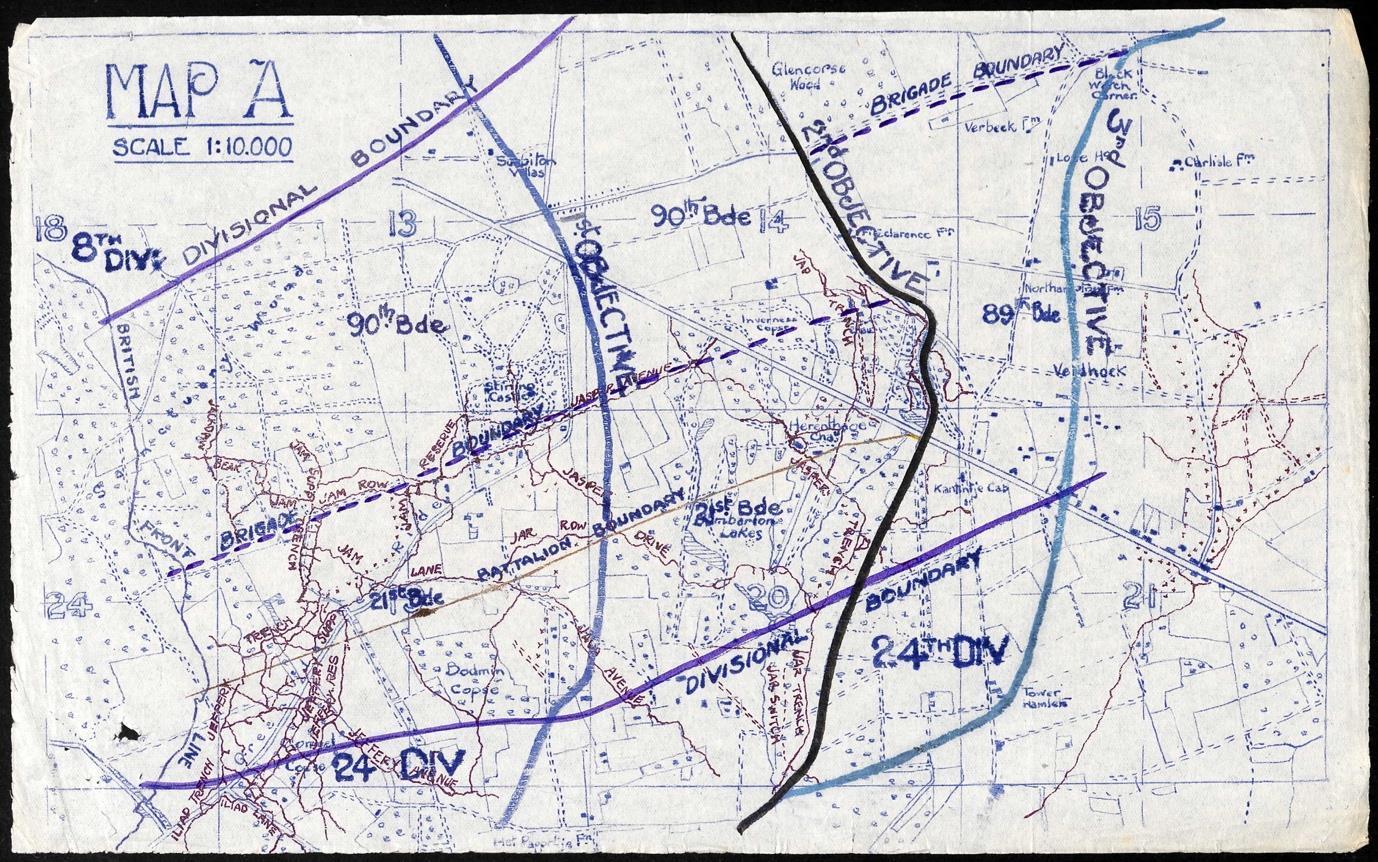
On 3 July 8th (Service) battalion Suffolk left the Arras Area and travelled by train to Cassel, arriving at 7.30 am on 4 July. From here it marched to billets and bivouacs in farms in the vicinity of Steenvoorde where, for the next three weeks, it undertook extensive training:
6 July to 24 July. Training of all sorts was carried out in areas and such places as were available and suitable. Brigade, Battalion and Company Conferences were continually being
422
TNA WO 95 2039 1 5 8th Battalion the Suffolk Regiment. Preliminary Instruction for Ypres Operations. Appendix III
423 TNA WO 95 2327 1 5
17. the ‘93’ and their stories 199
held. Parties of Officers, NCOs and men were daily visiting the forward area, and a model of the ground near Busseboom, and were conveyed to and from by Motor Lorries.424
On 28 July the battalion left their billets at 10 pm and marched to an overnight camp near Reninghelst, arriving at 1.30 am on 29 July.425 Having endured a heavy thunderstorm that lasted from 7 am until 12 noon, the battalion departed this camp at 7.30 pm and marched to a camp located at Dickebusch New Dickebusch Camp arriving at 10.30 pm.426
Documentation in the unit diary provides the following details about 8th (Service) battalion Suffolk’s advance to the forward area in trenches in the vicinity of Yeomanry Post, a short distance to the north east of Zillebeke:427
30 July. A nice fine morning early, but this soon turned into a steady drizzle which lasted till 11 am, when the rain ceased. The Battalion left [its camp at Dickebusch] by platoons for the forward Assembly Area [Yeomanry Post] in the following order, starting at 9.30 pm: A Company; B Company; HQ Company; D Company; Trench Mortar Battery (1 gun team); C Company; half section Machine Gun Company. The Blue track, which was picketed under 2nd Lieut N Bolingbroke by NCOs and men from the ‘Details’, was followed throughout. The night was comparatively quiet as regards enemy shelling. The Battalion only suffered when C Company reached Zillebeke Village.
31 July. The whole Battalion was located in the forward Assembly Area by 2 am. At this hour and up till ‘Zero Hour’ enemy shell fire appreciably increased. ‘Zero Hour’ was 3.50 am. At this hour the light was distinctly bad, visibility being only possible for a very short distance.428
Despite the fact that the 90th Brigade (30th Division) had encountered heavy German resistance as it proceeded through Sanctuary Wood, Ronald’s Company started its advance to the Blue Line 5 minutes ahead of schedule, at 7.45 am:
The Company started its advance in artillery formation from the Forward Assembly area at 7.45 am. Heavy enemy shell fire was encountered in Sanctuary Wood and at the eastern edge some machine gun fire. The line of Jackdaw Reserve was reached with very little loss. From here it was found quite necessary to deploy and move by sections, the section
424
TNA WO 95 2039 1 5, Appendix 1. Ypres Operations 3 July to 31 July
425
426
The location stated in the diary is 28. G.32.c. See TNA WO 95 2039 1 5
The precise location of this camp is stated in the diary as H.33.a.3.8. See TNA WO 95 2039 1 5
427
The diary lists the disposition of the battalion in trenches around Ritz Streee: A Coy Norman Trench; B Coy in Kite Trench; C Coy in Ritz Trench; D Coy in New Trench; Bn HQ in Wellington Crescent. See TNA WO 95 2039 1 5
428
TNA WO 95 2039 15, Appendix 1. Ypres Operations 3 July to 31 July
17. the ‘93’ and their stories 200
Commanders in every case took command and lead [sic] their sections with ability and confidence. On reaching the vicinity of Surbiton Villas fighting became particularly heavy, [incurring] casualties frequently from enemy Machine Gun and rifle fire. … The advance onwards was purely a matter of rushes, chiefly from shell hole to shell hole; touch was maintained right and left throughout and eventually the line was forced to halt about 200 yards east of Surbiton Villas. It was during this advance that Lieut R S Chibnall was killed. This line was held till about 2 pm when, through heavy enemy shelling, and our own heavies firing short, it was forced to withdraw with the left in touch with the 6th Royal Berkshire Regiment at about J.13.b.8.4.429
Trench map showing the location where Ronald was killed (Surbiton Villas is located near the centre of the map.).430 Ronald’s obituary in The Pauline states that ‘He was killed instantaneously by a bullet in the head, just as the objective was taken.’431 Detailed accounts in the battalion diary make it clear that the enemy had positioned 300 men and three machine guns in a strong point mid
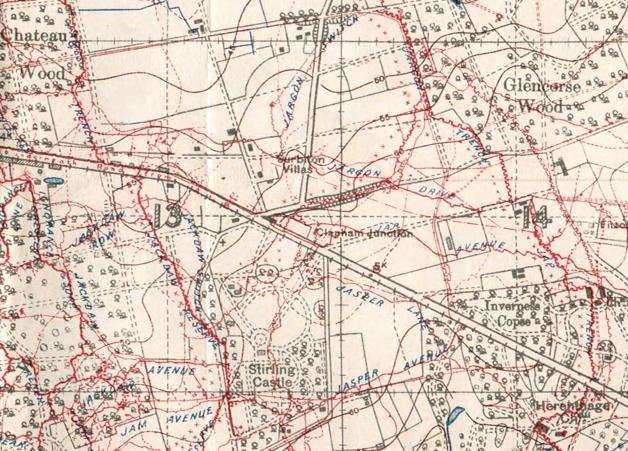
429
TNA WO 95 2039 15, Appendix 1. Ypres Operations 3 July to 31 July 430 TNA WO 95 2016 1 2 431 The Pauline, 35 236 Dec 1917 p 181
17. the ‘93’ and their stories 201
way along Jargon Drive trench, on the high ground above Surbiton Villas.432 This was likely the gun that killed Ronald. B Company was relieved at about 1 am on 1 August. Total casualties suffered by the battalion from the action of 31 July were estimated at 177.
Ronald’s body was never recovered. He is commemorated on the Ypres (Menin Gate) Memorial.
432 This gun was located at 28. 14.a.3.3. TNA WO 95 2039 15, Appendix 1. Ypres Operations 3 July to 31 July
17. the ‘93’ and their stories 202
Coburn, 2nd Lt Charles 31 July 1917, Hollebeke SPS 1896 1903
18th (Service) Bn. King’s Royal Rifle Corps Ypres (Menin Gate) Memorial Panel S1 and S3 Age 32
Charles was the son of Henry J. Coburn and his wife Adah. He was a Scholar of St. Paul's and later of Merton College, Oxford. At St. Paul’s he was in the School Cadet Corps, the 2nd cricket XI and the 1st Rugby football XV. At Oxford he was in his College Rugby XV and also played several times for the University in trial games. Afterwards he played Rugby for Rosslyn Park, the Inns of Court 0.T.C., and the Berkhamsted Cadets. At Oxford he obtained his B.A. (2nd Class Honours in Law) and B.C.L. He became a solicitor in 1909 and was subsequently appointed to the staff of the Royal National Pension Fund for Nurses. After the outbreak of war he served for some time in the Metropolitan Special Constabulary. Charles enlisted under the Derby scheme in December 1915, and was accepted for training by the Inns of Court 0.T.C. in October 1916. After passing through one of the Berkhamsted Cadet Schools he obtained a commission in the King’s Royal Rifle Company in April 1917 and was posted to the 18th (Service) battalion. He crossed to France on the 2nd July and was killed on 31 July, the opening day of the Third Battle of Ypres.
During the first three weeks of July 18th (Service) battalion (122nd Brigade, 41st Division) undertook training in preparation for the forthcoming offensive. On 21 and 22 July it participated in full blown practice attacks in the X Corps training area. The attack was to take place at 3.50 am on 31 July, preceded and accompanied by an almighty artillery barrage, as described by in several Operation Orders:
The intention of the Divisional Commander is as follows:
i) At Zero Hour the barrage will come down on the Red Line [i.e. the enemy’s front line]; the infantry will close up under it.
ii) Zero plus 4 minutes, barrage will advance and pile up on Blue Line and infantry will assault Red Line
iii) Zero plus 28 minutes, barrage will lift off Blue Line and Infantry will advance to Blue Line [i.e. Forret Farm Hollebeke cross roads Canal].
iv) Barrage will continue advance to final position 400 yards beyond final objective (Green Line)
v) Rate of advance of barrage will be 100 yards in 4 minutes.433
17. the ‘93’ and their stories 203
On 24 25 July Charles’ unit relieved the 1/15th battalion London Regiment in the sub sector south of the Ypres Canal, holding the line shown in black extending from just south of Hollebeke (at Forret Farm) to where it touched the line held by the battalion on its left, (the 11th battalion Royal West Kent Regiment.) The 18th (Service) battalion King’s Royal Rifle Corps was disposed in Optic and Oak Reserve trenches with the reserve Companies occupying the old German frontline in the vicinity of Oak Trench, a little to the west.434

Map showing the line held (on the right) by 18th (Service) battalion K.R.R.C 25 31st July and the Red, Blue and Green lines, objectives in the attack of 31 July.435
Details presented in the Infantry Brigade Order No 127 prescribed the formation and method to be employed in the forthcoming attack:
The leap frog method will be employed by each of the Assaulting Battalions, who will advance in two waves. Each battalion will be on a two Company front, with each Company on a four platoon front. 1st Wave: will capture Red Line, mop it up and construct and garrision Strong Points. Special parties will be instructed by 18th bn King’s Royal Rifle Corps for mopping up dugouts in Hollebeke Road between jumping off place, part of Optic Support
434 After a long period during which the lines in this sector remained static, the Battle of Messines Ridge (7 14 June 1917) had witnessed the British front move several miles to the east.
435 TNA WO 95 2617 1
17. the ‘93’ and their stories 204
included in Red Line, Oblique Row, Hollebeke Road between jumping off place and Red Line.436
Unusually for a soldier with officer status, Charles is not mentioned by name in either the main body of the unit diary nor the various Reports attached to it. Nonetheless, a highly detailed Report Operations from 24 July 13 August does much to illuminate the circumstances in which Charles was killed:
24 July. The Bn took over the font line from the 15th bn County of London Regiment and was disposed as follows:
B Company Optic Trench
A Company Oak Reserve
C and D Companies in vicinity of old German front line. Bn HQs in concrete dugout at junction of Oak Reserve and Dammstrasse
30 July. Bn HQ moved to in front of the White Chateau grounds. Tapes were laid out for the assembly [of the troops], A Company on the right and B Company on the left formed the first wave; and C Company on the right and D Company on the left the second wave. There was some shelling one killed and 6 wounded.
31 July. One hour before Zero, which was fixed for 3.50 am, A and B Companies took up their positions of assembly, and C and D Companies moved up to their positions in the rear. While C and D Companies were assembling, a heavy barrage was opened upon them by the enemy, making assembly difficult and causing several casualties. At Zero hour the troops moved. A Company on the right obtained their objective and dug in … B Company on the left encountered uncut wire, and as it was still dark, were unable to find any gaps, although some had been cut by the artillery. In consequence, D Company, in the second wave, overtook B Company at this wire, and a portion of C Company, who had also encountered the wire, and had been turned off to the left by it, became intermingled with these two Companies. After about a quarter of an hour’s delay the bulk of D Company, with some of C and C Companies … got through the wire and advanced towards Hollebeke under heavy fire. The dugouts in Hollebeke and between Hollebeke and Forret Farm were untouched by our artillery and were strongly held. … 2nd Lieut J H Deer [leading the bulk of D Company with some of B and C] collected a bombing party … to take a dugout in Hollebeke which was causing casualties. This attack was successful. During this time a Lance Corporal of D Company with a small party attacked another dugout in Hollebeke.437
Given the high quality of the description of events in the above account, it is unfortunate that it is not known in which Company Charles served. Nevertheless, In light of details presented in Charles’ obituary published in The Pauline, it does not seem unreasonable to 436
TNA WO 95 2635 3 122nd Infantry Brigade Order No 127 437
TNA WO 95 2635 3 Report on Operations from 24 July 13 August
17. the ‘93’ and their stories 205
suggest that because he appears to have progressed as far as Hollebeke he was not likely to have been in A Company:
[Charles] was reported missing after going into action for the first time on the 3Ist July, when he led two platoons against the village of HoIlebeke. He leaves a widow and two sons. His Adjutant, Captain H. W. Yoxall [SPS 1908 1915. See Vol 1) wrote: “He led his men most gallantly to the attack against a most strongly fortified village. Somehow in the fighting from cellar to cellar he got lost, and no one knows any more. During the short time he was with us he showed himself a gallant, reliable and devoted officer.”438
Although the attack was successful in attaining the Red Line it did not progress further. Charles’s body was never retrieved and lies to this day somewhere in the footings of Hollebeke. Charles is commemorated on the Ypres (Menin Gate) Memorial. 438 The Pauline, 36 238 April 1918 pp 40 41
17. the ‘93’ and their stories 206
Johnstone, Lt John Douglas 31 July 1917, Kansas Cross439
1/4th Bn. King’s Own (Royal Lancaster Regiment) Ypres (Menin Gate) Memorial Panel 12 SPS 1913 1915 Age 19
John was the son of Mr T Johnstone and Mrs Johnstone of Barrow in Furness. John came to St. Paul's from Barrow in Furness in the Michaelmas Term, 1913, and was a member of Mr. Phillips' and Mr. Picton's house. He was in the Science Villa form. He entered St. Bartholomew's Hospital in September, 1915, and had only been in residence about a month when he decided to join an Officers' Cadet Battalion.440 He was gazetted to a commission in the Royal Lancasters in January, 1916. In June, 1916, he was badly wounded when on patrol duty in No Man's Land.441 He was out again in December, and on December 23rd he was wounded a second time while conducting a bombing raid, which achieved important results. In July of this year he was gassed and was ordered to report sick, but he prevailed on his doctor to certify him fit for duty in order that he might take part in the great push which was pending.
By July 1917 the 1/4th battalion King’s Own (Royal Lancaster Regiment) (164th Brigade (West Lancashire) Division had been in the sector Wieljte Railway Wood for several months and was well acquainted with the ground. The attack in which it participated on 31 July (Third Ypres) was designed to capture the enemy’s Gheluvelt Langemarck system of trenches, the ridge of high ground that ran to the east of Ypres. The attack was to be made in three stages, each of which was delineated with a set objective, marked respectively on attack maps as the Black Line, Red Line and Green Line, preceded and accompanied by a barrage. The role that John’s unit was to play in the attack was described in Operational Order No. 44:
The 165th Infantry Brigade on the right and the 166th Infantry Brigade on the left will attack along the Divisional front at Zero [hour i.e. 3.50 am] and will occupy the Black Line. At Zero+
439 Kansas Cross is shown on trench maps as the cross roads located mid way along the St Julien Zonnebeke road. John fell in the vicinity of a farm called Gallipoli, located south of Kansas Cross.
440 This appears to have been in the University of London, OTC.
441 On 26 June a sizeable party from Johnstone’s unit raided the enemy trenches. TNA WO 95 2922 1 4 Trenches nr. Agny: 2nd Lt Johnstone and 2 ORs captured 2 prisoners off a German patrol. The diarist does not reference any wounds suffered by Johnstone, but an article in the Barrow News describes a bullet wound in the right shoulder and a damaged left foot.
17. the ‘93’ and their stories 207
[i.e. 1 hour 15 minutes] the 164th Infantry Brigade will pass through the two other Brigades of the Division and will gain its objective, the Green Line. The attacking battalions will be the 1/4th North Lancaster Regiment on the right, the 2/5th Lancashire Fusiliers on the left. This battalion [i.e. 1/4th King’s Own Royal Lancaster Regiment] will be in immediate support to the 1/4th North Lancaster Regiment; the 1/8th Liverpool Regiment to the 2/5th Lancashire Fusiliers. … As soon as the objectives are taken the battalion will become reserve battalion to the whole Brigade and will dig in in the area Gallipoli Somme Hindu Cot.442
A diagrammatic representation showing the position of 1/4th battalion King’s Own (Royal Lancaster Regiment) in line at the start of the attack on 31 July.
Black Line, 0 +6rs 20 mins
Blue Line, 0 +1hr 15 mins
GB frontline, 3.50 am
166th Bde 165th Bde
164th Bde
2/5th LF 1/4th NLR 1/8th LR 1/4th KORLR
The two maps below (portions of a single map) show all the points referenced in the accounts relating to John’s unit and repay close study.443
Map 1 showing 55th Divisional boundaries (the vertical blue lines) and the Assembly trenches (Congreve Walk) in which John’s unit mustered in the early hours of 31 July. 442
TNA WO 95 2922 1 4, Operation Orders No. 44 24 July 1917 443 TNA WO 95 2903 1 4
17. the ‘93’ and their stories 208
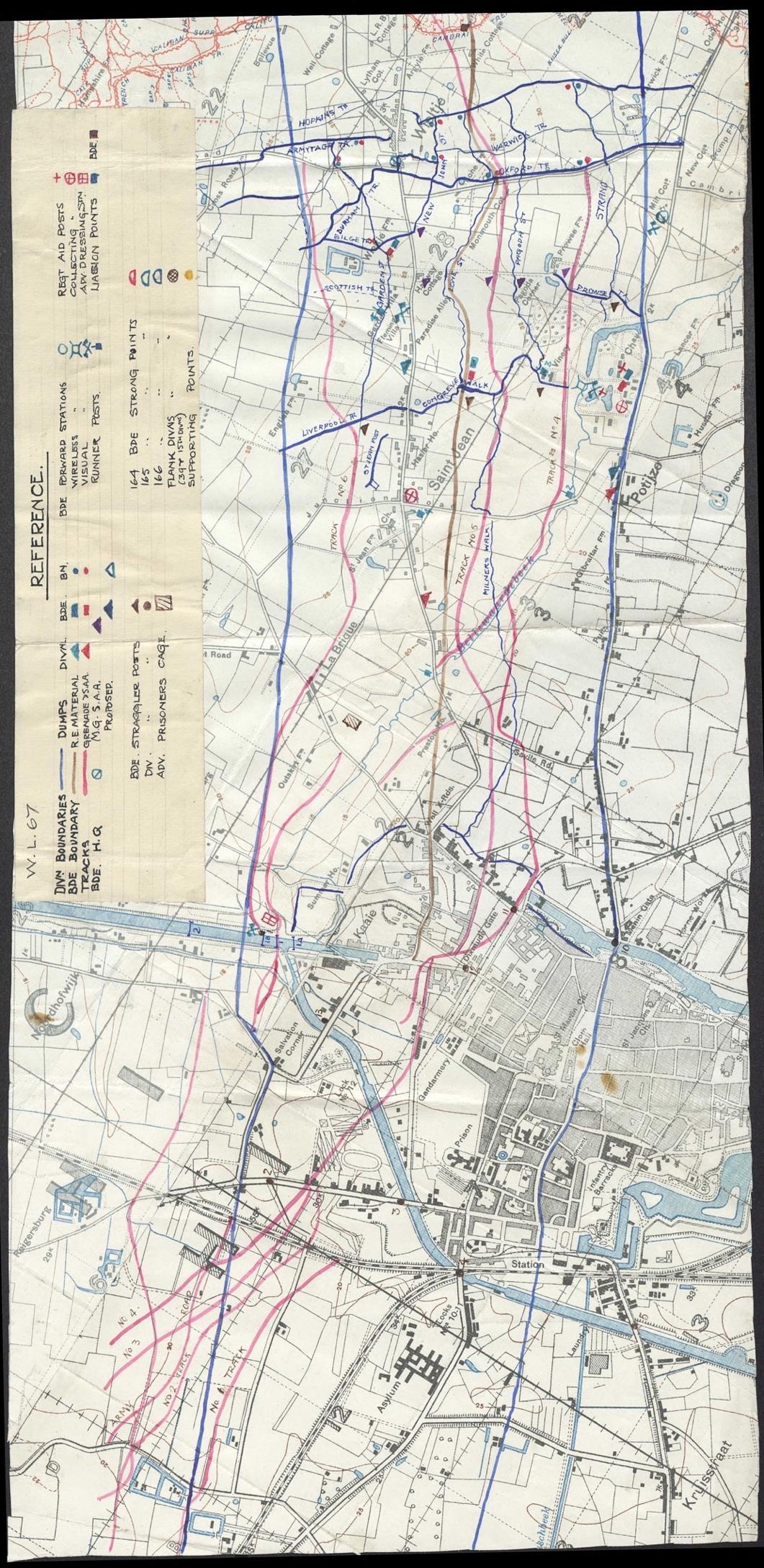
Map 2. Showing the Black, Blue and Green Lines. John’s unit advanced on the right and reached as far as the Outpost Line before retreating back to the Black Line.
the ‘93’ and their stories 210
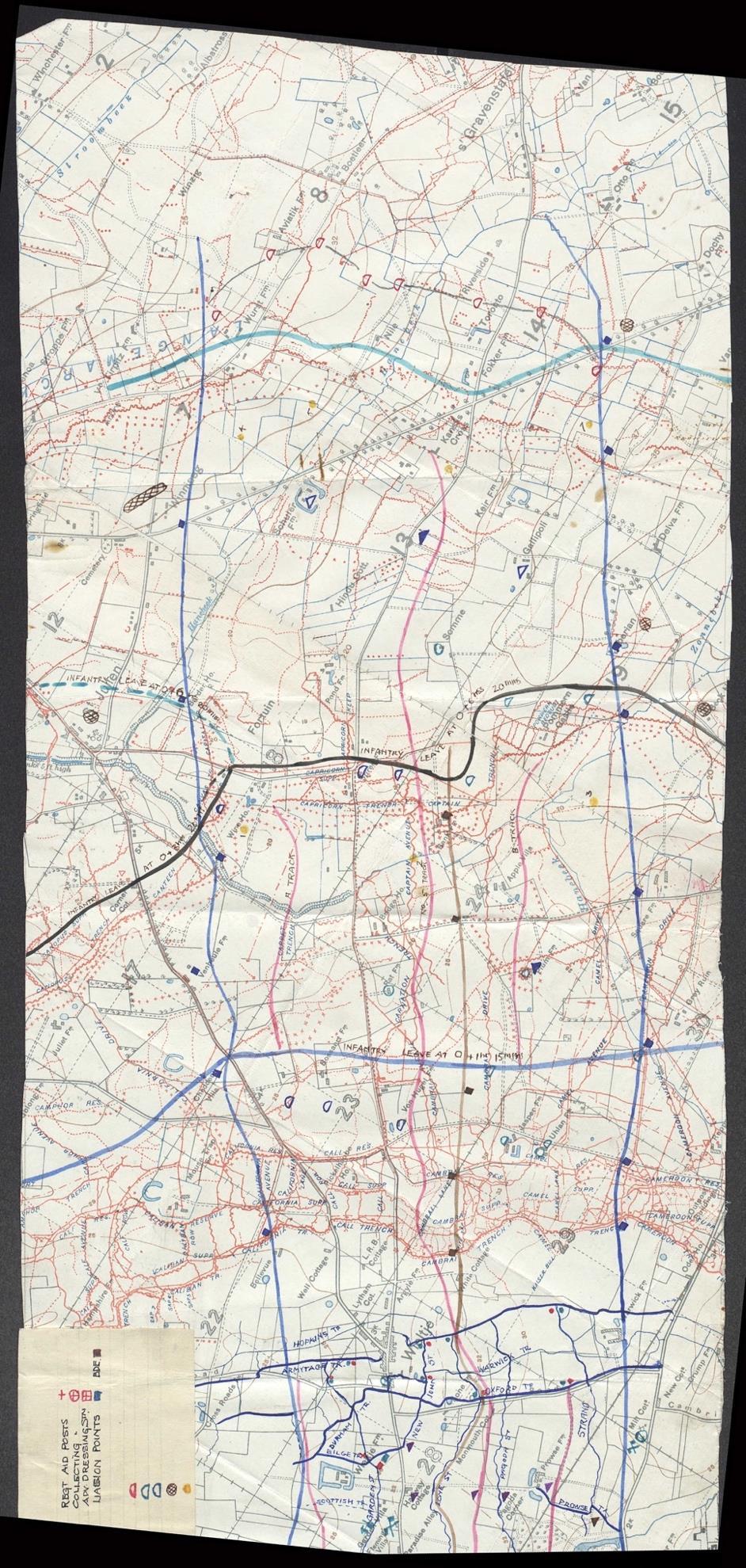
thus:
30 July. In the evening the battalion marched [from the concentration area at H.9 central] to the point of assembly in Congreve Walk taking up positions for the attack. 31 July. At 3.50 am the 165th and 166th Brigades assaulted and captured the enemy front and reserve system of trenches. At 8.20 am, this battalion, in conjunction with the remainder of the 164th Brigade, passed through these Brigades and successfully attacked and captured all strong points and reached the objective (Green Line). The battalion captured 500 prisoners and four machine guns. This line was held for three hours and then the battalion were compelled to withdraw to the Black Line owing to the Divisions on the right and left failing to reach their objectives. [After falling back] the battalion held the line (Pommern Redoubt) against the counter attacks. During these operations the battalion lost 15 officers and 200 Other Ranks, killed and wounded.444
By the end of the day, despite elements of John’s unit at one point having reached the Outpost Line (see Map 2), only the Black Line had been reached. The 55th Division diary stated that:
At 4.15 pm, owing to counter attack by the enemy on either flank, both of which were thrown open, 164th Brigade were forced to fall back fighting and eventually reached the Black Line where they remained in position with a few advanced posts.445
An anonymous contribution to John’s obituary in The Pauline asserts that ‘His death came instantaneously when leading his platoon into action’.446 Unfortunately it is not known to which Company John belonged and, since he is at no point named in the unit diary, it is not possible to locate with precision where he fell during this operation. All accounts agree that there was bitter fighting and sustained exposure to danger throughout the attack and subsequent retreat. Moreover, the 164th Brigade diarist alleges that ‘the barrage, although easy to follow, was not sufficiently dense to prevent enemy machine guns firing through it’ and that ‘hostile strong points had not been destroyed by our preparatory artillery fire.’447 In addition, a particularly heavy thunderstorm on 29 July had filled up shell holes and turned roads and tracks into an almost impassable quagmire. On balance, it seems likely that John fell no great distance from area marked ‘Somme Gallipoli’. His body was lost and he is commemorated on the Ypres (Menin Gate) Memorial.
444
TNA WO 95 2922 1 4 445
TNA WO 95 2903 1 4 446
The Pauline, 35 234 Nov 1917 pp 140 41 447
TNA WO 95 2920 1 4
17. the ‘93’ and their stories 211
The 1/4th battalion unit diarist describes events of 30 31 JulyLey, 2nd Lt Geoffrey Arthur Henry 31 July 1917, Zillebeke SPS 1904 1908
3rd Bn. Devonshire Regiment, attd. Tank Corps, B battalion448 Poelcapelle British Cemetery LVI.C.1 Age 26
Geoffrey was the son of Arthur Henry Ley and his wife Violet. He was born in Ireland on 8 August 1890. According to The Pauline:
Geoffrey was a prominent athlete at school. He kept wicket for the XI with great success in the two years of Sargent's captaincy, 1906 8, and in the latter year was “a diligent and efficient secretary.” An Old Pauline at the front writes to us: “Ley, who had been wounded some time in June and remained on duty, was going into action on the date of his death when he was killed instantaneously by a direct hit from a shell. . . . His never failing smile, and high spirits that would never let him see the gloomy side of things, made him the dearest of friends both at school and after. Kipling says the Ulstermen went to their death with a smile on their teeth. Had he known Geoffrey, he could not have expressed his end more graphically.”449
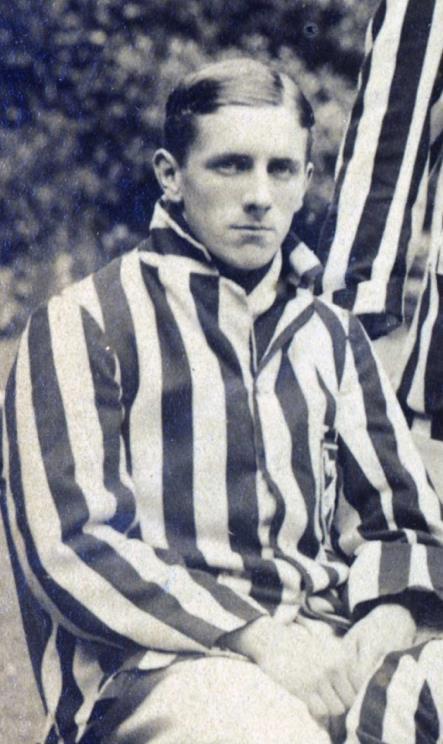
448 By 1917 a tank Brigade was composed of three battalions; tank battalion was composed of 3 companies, each of 12 tanks; in turn, each company was made up of three sections, each of 4 tanks.
449 The Pauline, 36 237 Feb 1918 p 9
17. the ‘93’ and their stories 212
Geoffrey Arthur Henry LeyAt the time of his death Geoffrey was attached to the Tank Corps, B Battalion (2nd Brigade Tank Corps, II Corps). 2nd Brigade was constituted with 72 tanks arranged into A and B Battalions, each with a total of 36 Mark IV tanks. A tank corps battalion consisted of three Companies, each commanding 12 tanks. Geoffrey was in No. 5 Company. In turn, each Company was composed of three Sections, each Section commanding 4 tanks. Geoffrey was in No. 5 Section.450

In early July B Battalion was recuperating and refitting after its successful participation in the operation on Messines Ridge in June. It put on a display of tanks in action in front of H M the King on 4 July that was deemed a great success:451
450 A Battalion was composed of Companies 1, 2 and 3; B Battalion was composed of Companies, 4, 5 and 6; each of these Companies was composed of three Sections Company 5 was composed of Sections 5, 6 and 7. 451 TNA WO 95 101 4
17. the ‘93’ and their stories 213
TheNationalArchives'referenceWO-95-101-4_082.jpg
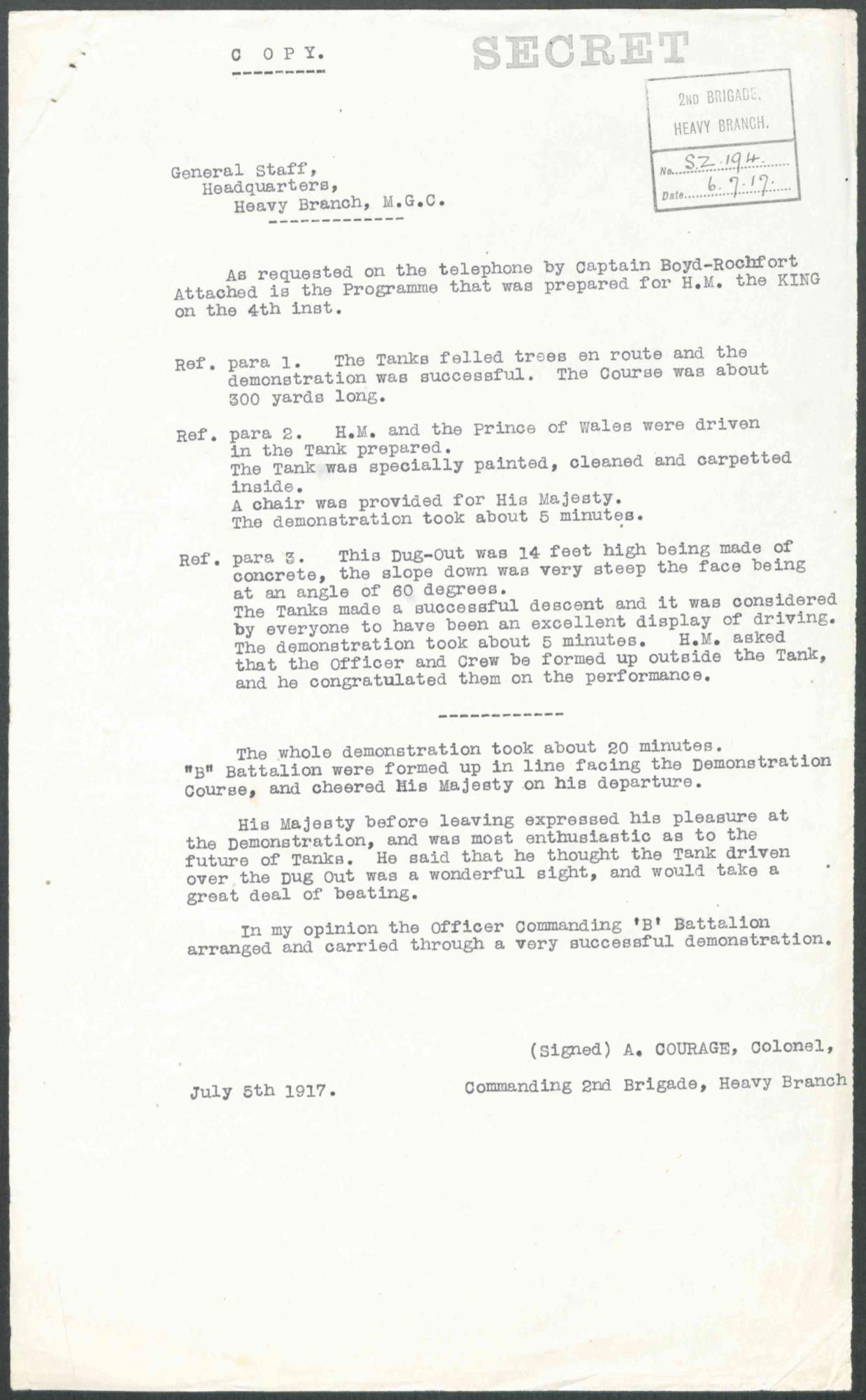
In an order issued on 16 July, B Battalion was detailed to cooperate with the 18 30 Blue, Black and Green Lines. If the attack was successful it was also hoped to establish posts beyond the Green Line, depriving the enemy of their possession of the high ground. Along this section of the front (II Corps)
17. the ‘93’ and their stories 214
The Stirling Castle Glencourse Wood ridge is very nearly as high as the Messines Wychaete [sic] Ridge, and in conjunction with the Westhoek Spur is of the greatest importance to the enemy since it provides close observation over the whole of our forward position in the Ypres Salient, from Yeomanry Post (I.17.d.5.0) on the South to Wieltje (C.28.b) on the North.452
No. 5 Section appears to have been detailed to support the attack of 21st Brigade (30th Division) against the Black Line.

Map showing the Blue, Black and Green Lines (left to right the Green Line not showing as particularly green).453
Having participated successfully in the operation on the Messines Ridges in June, B Battalion moved up across country from the Bailleul area to the railhead at Ouderdom. It was provided with seven limber wagons for moving materials, making ammunition dumps and establishing crossings. From Ouderdom, B Battalion moved to Lyonsberg Camp, just to the west of Vierstraat; from here the tanks moved up to their starting points via Voormeezele. Meanwhile 184th Tunnelling Company RE set about building five crossings over the Ypres Comines Canal, one north of Lock 8, the others to the south.
452 WO 95 101 4 Summary Of Our Present Information Concerning The Enemy Forces and Defences Opposite the II Corps Front, 26 June 1917
453 Map in 30th Division HQ. TNA WO 95 2327 1 5
17. the ‘93’ and their stories 215
184th Company also ensured the agreed routes to the various assembly positions were suitable for tanks, and shell holes were thus filled, trees felled, and their stumps, removed. Two ‘English’ shelters were built near Valley Cottages, Zillebeke, the agreed starting point for B Battalion in the forthcoming attack.454
Discovering and then establishing the starting point at Valley Cottages proved challenging, as described in the 2nd Brigade, Tank Corps Report on Tank Operations of 31 July:
There was great difficulty in obtaining suitable positions for tanks to lie up. All the area forward of the Ypres Commines Canal is very flat. There are few hedges, and Observatory Ridge formed the only protection from view. The enemy had direct observation from Hooge of the forward slopes of Observatory Ridge. There was a great concentration of guns, and they used up almost every concealed position. The whole area was regularly shelled, and the positions in the Zillebeke area selected for the tanks were the only ones available.455
Geoffrey was killed 30 31 July at Valley Cottages, while his Section prepared for Zero Hour. His death is mentioned in a Report on Operations in B Battalion diary:
10 tanks of No. 6 Company and 12 tanks of No. 5 Company were launched between Zero and Zero plus 2 hours. … Tanks of No. 5 Company experienced bad ground west of Dumbarton Lakes. 7 tanks report engaging the enemy and causing casualties, in some cases heavy casualties. Tanks found armoured concrete M G emplacements which they could not put out of action. … Enemy concentrated artillery fire on tanks and also used A P bullets, the latter causing considerable casualties from splashed, and in some cases reported to have pierced the sponsons. 4 tanks were knocked out by direct hits. Only 2 tanks got back to their starting point at Valley Cottages…. 2nd Lt G A H Ley killed.456
Geoffrey is mentioned again in a subsequent report, detailing the narrative of each of the four tanks in Geoffrey’s Section (Lieutenant Simpson assuming command of Geoffrey’s tank):
No. 5 Company; No. 5 Section. Captain E E Dudgeon was wounded at the starting point and Lieut Ley killed. Lieut Simpson took over Lieut Ley’s tank. Lieuts Vans Agnew, Brockwell, Crerar and Simpson [each commanding a tank] started at Zero plus 2 hrs 10 mins. Lieut Vans Agnew’s tank had radiator and engine trouble, and could not proceed beyond
454
TNA WO 95 101 4 Report by Captain D K F Machlachlan RE on work by No 2 Section, 184th Tunnelling Company RE for 2nd Brigade Tank Corps
455 TNA WO 95 101 4 2nd Brigade Tanks Corps. Summary of tank operations with II Corps on 31 July 1917
456 WO 95 113 2 Preliminary Report on B Battalion Operations 31 July 1917
17. the ‘93’ and their stories 216
Observatory Ridge. He got the tank back to the SP and then went up after the Section with pigeons to collect what information he could. Lieuts Crerar’s and Simpson’s tanks got ditched about J.19.c.4.6 [i.e. at the northern corner of Clonmel Copse, 1 mile east of the starting point.] Lieut Crerar’s unditching gear broke Lieut Simpson’s gear worked will till it brought him up against a tree which he could not knock down and Lieut Crerar’s tank prevented him reversing. Brockwell came up with infantry in J.19.b and proceeded on towards the west side of Dumbarton Woods where M Gs were reported. He got ditched and engine would not pull with unditching gear, so dug out and got on engaged enemy, inflicting casualties, and patrolled in front of infantry till crew exhausted. Then returned to starting point [at Valley Cottages]. Lieut Brockwell was wounded, but got dressed and caught up tank which he had sent on with Cpl Hilton.457
The 2nd Brigade Tank Corps diarist summarised the activity of No. 5 Company on 31 July:
No 5. Company went into action with only 11 tanks, one having received a direct hit at the Starting Point. One of these had mechanical trouble soon after starting while two became ditched beyond the German front line. The remainder (8 tanks), all came into action beyond the limit of the infantry advance but in spite of their efforts the line could not be pushed forward, the barrage having gone some distance ahead.458
Geoffrey is buried in Poelcapelle British Cemetery, some distance from where he fell. This is a concentration cemetery, made after the Armistice when graves were brought in from other cemeteries in the area and from the battlefields. Geoffrey was originally buried at Valley Cottages, the place where he fell.459 Since his tank was taken over by Lieutenant Simpson and thereafter participated in the attack, it seems likely that Geoffrey was killed by shellfire whilst he was preparing the tank at some point before Zero Hour i.e. 3.50 am on 31 July. He was exhumed and reburied at Poelcapelle British Cemetery in 1923.
457 WO 95 113 2 Further report on Operations of B Battalion, Tank Corps, 31 July 1917 dated 2 August 1917
458 TNA WO 95 101 4
459 The exact location is 28.I.23.c.85.60, CWGC Concentration of Graves Burial Return 1/12/98.E, 26 October 1923
17. the ‘93’ and their stories 217
Shoobert, 2nd Lt Neil 31 July 1917, Hollebeke SPS 1903 1906
23rd (Service) Bn. The Duke of Cambridge’s Own (Middlesex Regiment; the ‘Football Battalion’)
Ypres (Menin Gate) Memorial Panel 49 and 51 Age 27
Neil was the son of J C Shoobert. His obituary in The Pauline recalls that:
At school he did well in all ways, although his stay was not very long. On the Science side he had a well deserved reputation for sound, steady work and care for detail. He was a member of the O.T.C. for three years, but was best known as a forward. But for a weak heart, which stopped his athletics for some time, he might have got his First colours. As it was, he proved a very useful member of the Second XV, and was a member of D's historic team which in 1905 6 beat Houses, who had never before lost a game in the Shields competition. He kept up his [rugby] football after leaving, and captained Rosslyn Park A team with conspicuous success. At school, as afterwards, he impressed all who knew him with his soundness and straightness of character. You could rely on him implicitly to do what was right; the idea of anything not quite straight was abhorrent to him. He was deservedly liked and esteemed by all with whom he came in contact, and his influence was all for good.460
On the outbreak of war Neil joined the Inns of Court, and was posted to the 23rd battalion Middlesex Regiment (123rd Brigade, 41st Division) in February, 1915. The core of the battalion was a group of professional footballers, which was the reason for its most commonly used name the Football Battalion. (Among those who served in 23rd battalion was Walter Tull, who was likely the first black infantry officer in the British Army.) After taking the musketry course at Hythe and the Guards’ course at Chelsea, Neil served as musketry officer at several places. Early in 1917 he became lieutenant, and acted as assistant adjutant until he went to France in July. Neil was killed in the early hours of 31 July while undertaking the assault on the Red Line where it crossed the Ypres Comines canal, a short distance to the north of Hollebeke and no more than half a mile from where fellow OP, 2nd Lieutenant Charles Coburn, was also killed on this day.
Disposition map 30 31 July. (The Black Line is the new position of the British front after the success of the Battle of Messines Ridge in June.461)
460 The Pauline, 35 234 Nov 1917 p 144 461 TNA WO 95 2617 12
17. the ‘93’ and their stories 218
At the time of his death Neil was in one of the two Companies (either A or D, shown as ‘2 Coys’ in the above map), located just to the north of the pronounced dog leg in the Ypres Comines Canal.462 At 8.30 pm on 30 July, 23rd (Service) Bn. Middlesex Regiment (123rd Brigade, 41st Division) had departed their billets in Ridge Wood, a short distance to the south east of Dickebusch Lake and proceeded up to the assembly position north of the Ypres Comines canal, mid way between the Bluff and the right angled bend in the canal where it was crossed by the Red Line. (See disposition map, above.) At 2 am A and D Companies departed the assembly position to assume position immediately in front of Battle Wood, ready for the assault. All units had been briefed on the order of attack. In the instance of the Neil’s battalion, A Company formed the first two waves and D Company formed the 2nd two waves on a narrow front of roughly 120 yards. Two Vickers guns and teams assembled with A Coy; the remaining gun was missing.
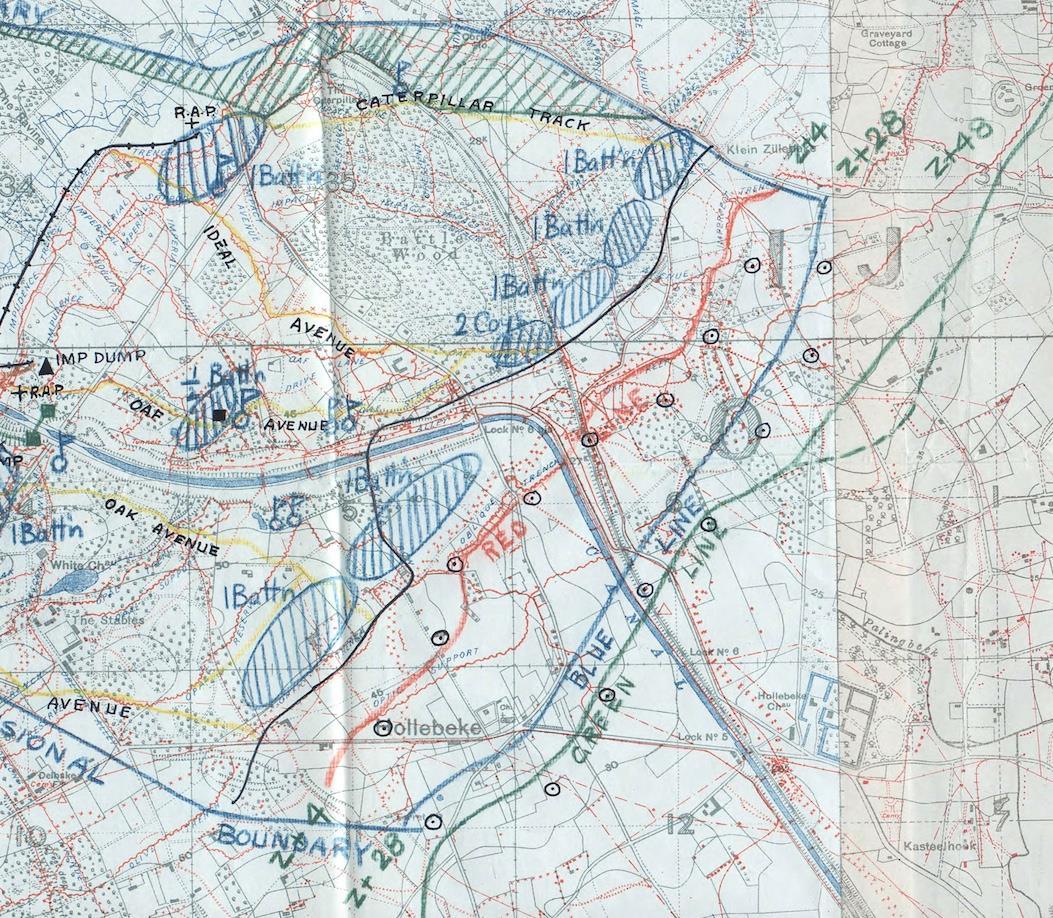
462 It is not known for certain to which Company Neil belonged, but the details in the battalion diary intimate that he was in one of the two frontline attacking Companies. See TNA WO 95 2639 2
17. the ‘93’ and their stories 219
Method of attack: attacking troops will line out their tapes on [the ground on the night of the attack], each battalion [attacking] on a two Company front, and each Company on a two Platoon front. Movement to be complete by Zero Hour minus 1 hour [i.e. 2.50 am]. … At Zero Hour [i.e. 3.50 am] the barrage will come down on the Red Line, where it will remain for 4 minutes during this time the infantry will advance such a distance and at such a pace as will ensure the leading line of the assault being within 75 yards of the enemy parapet at Zero plus 4 [minutes]. At this hour (Zero plus 4 minutes i.e. 3.54 am), the barrage will advance and pile up on the Blue Line, and the infantry will assault and mop up the Red Line. This will be done by the 2nd wave, the 1st wave carrying straight on behind the barrage, followed by the 3rd, 4th and 5th waves. At Zero plus 28 minutes, the barrage will lift off the Blue Line and the infantry will assault and mop up the objective. … The barrage will continue to creep forward until it reaches its final protective position, some 400 yards beyond the Green Line, which is the final objective.463

Diagram showing the attacking disposition of the two frontline Companies of 23rd Middlesex Regiment.464 463
given here do not quite correlate to those published on the 41 map, TNA WO 95 865 1.) 464 WO 95 2637 1 1 ©CrownCopyright
17. the ‘93’ and their stories 220
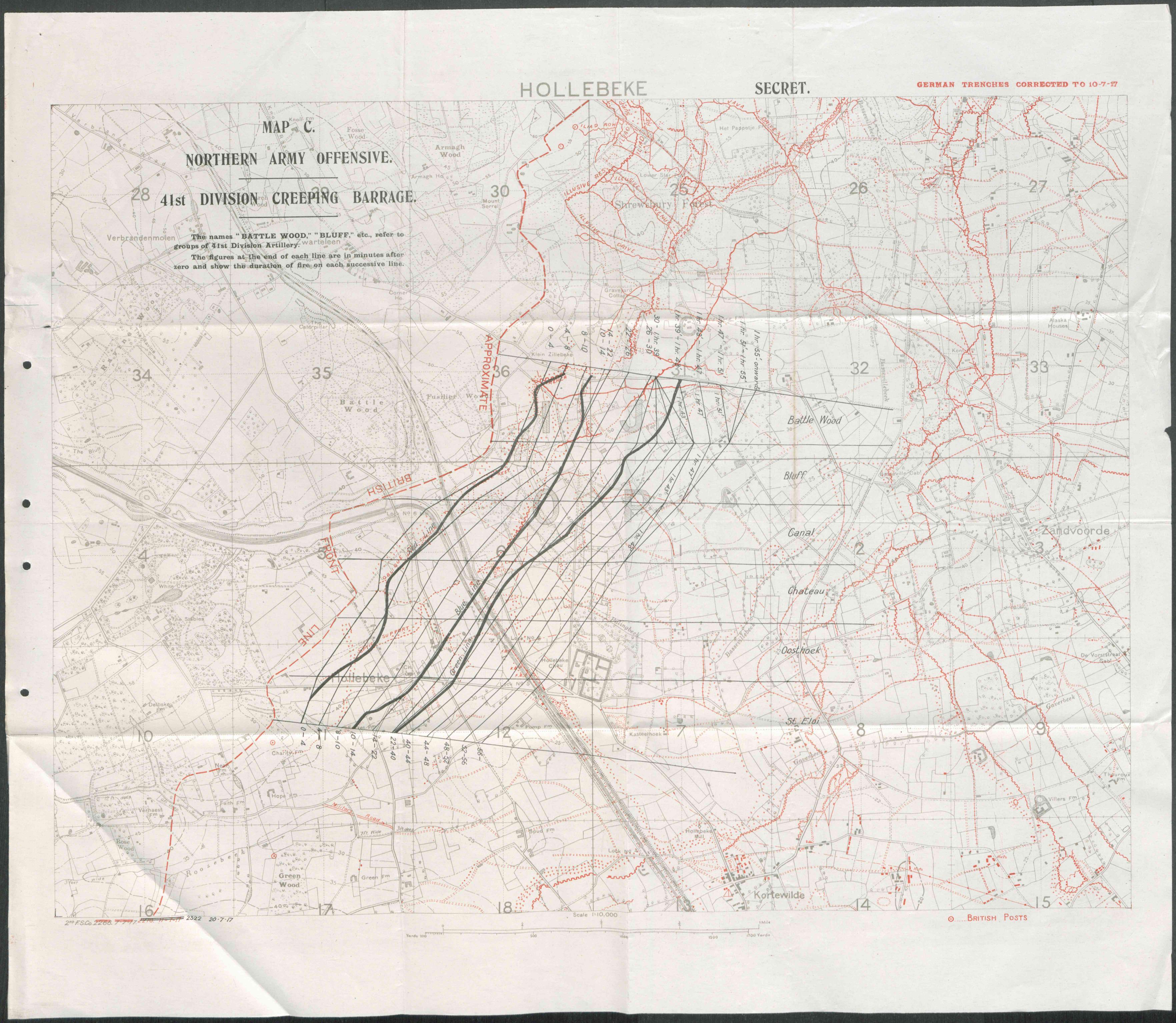
For the strategy of the creeping barrage to be effective it was important for the infantry to keep up with the barrage but frequently as Neil experienced this proved an impossible challenge, in part because the infantry had to navigate a newly cratered landscape and in part because the terrain was made yet more treacherous by recent heavy rain. According to the 23rd battalion Middlesex diarist:
31 July 3.50 am. Barrage opens on German front line and attack commenced. The ground between the canal and Railway Embankment was found to be impassable owing to the wide expanse of water. This compelled the majority of the troops to make their advance along the Railway Embankment itself. The Red Line was taken according to timetable at 3.54 am but owing to the bad state of ground and the darkness, the barrage was moving too fast for the troops to keep close under it. After passing the Red Line waves 1, 3 and 4 came under machine gun fire from dugouts on the Railway Embankment and the crest of the hill 500 yards from the left flank. Lieut Sutherland was killed and numerous casualties occurred at this juncture. Lieut Shoobert was killed on the Railway Embankment by a bomb thrown from one of these occupied dugouts. Most of the wire had been cut but sufficient remained around water logged shell holes near the Embankment to impede troops. Also, from the Red to the Blue Lines an expanse of ground varying in width from 10 to 35 yards was under water which made it impossible to rush the occupied dug outs from all sides. … A and D Companies remained in their positions [along the Railway Embankment between the Red and Blue Lines] throughout day and night of 31st and daytime of 1 August. When they were relieved by B Company, owing to rain which commenced to fall heavily on the afternoon of the 31st [July], newly dug trenches on both the Red and Blue Line became knee deep in water and the garrison of the Red Line [were] placed in dugouts in the Railway Embankment.466
The available evidence thus supports the description of Neil’s death presented in his obituary in The Pauline: [While] he was advancing along a railway embankment with a crowd of men in an attack, when they came across some dug outs where the Germans put up a fight, he was killed by a bomb. It was only at his own request that he took part in the attack, for it was originally intended that he should stay behind, but this did not suit him. His officers speak of him in terms of the warmest respect and liking. He leaves a wife and young children, to whom our sincerest sympathy goes out.467
Neil’s body was never retrieved. He is commemorated on the Ypres (Menin Gate) Memorial. 466 TNA WO 95 2639 2 467 The Pauline, 35 234 Nov 1917 p 144
17. the ‘93’ and their stories 222
Wickham, 2nd Lt John Seville Deacon468 31 July 1917, nr. Oostaverne SPS 1907 1910
7th (Service) Bn. King’s Own (Royal Lancaster) Ypres (Menin Gate) Memorial Panel 12 Age 25
John was born in Cape Town, South Africa in 1892, the son of John Harry Deacon Wickham and his wife Annie (Nina) Buck. At some point the family emigrated to London. Prior to attending SPS from 1907 to 1910, John was a pupil at Alpreton School in Wembley. In 1911 the census describes him as an ‘army student’, resident at 38 Sinclair Road, West Kensington. Prior to serving in the 7th service battalion the King’s Own (Royal Lancaster) Regiment, John is listed as a Private in the 5th battalion East Surrey Regiment. He was killed on 31 July, fighting in the front line around Junction Buildings, one mile east of Oosttaverne on the Messines Ridge.
On 11 July 1917 the 7th service battalion King’s Own (Royal Lancaster), (56th Brigade, 19th (Western) Division) moved to shelters at Kemmel and spent 12 17 July supplying working parties for cable laying in the forward area, assisted with making improvements to the Vierstraat Wytschaete road and undertook training for the forthcoming attack. After a period in the trenches in the environs of Onraet and Oostaverne Woods, on the dates 20 22 July the battalion made attempts to take a small group of building about one mile east of Oostaverne called Junction Buildings but these were found to be ‘strongly held and [the attacks] were driven off by heavy machine gun fire, [the battalion] suffering considerable casualties’.469 After a period of relief, the unit was back in the front line on 29 July, detailed to take an objective defined as the ‘Blue Line’ (shown as a green line in the map below) a short distance to the east of Junction Buildings. Following a creeping barrage, the unit was to attack at Zero Hour, 3.50 am.
Map showing the disposition of 7th battalion in the front line on 31 July 1917.470
468 Seville is shown in some records as ‘Neville’ 469 TNA WO 95 2078 1 2 470 TNA WO 95 835 5
17. the ‘93’ and their stories 223
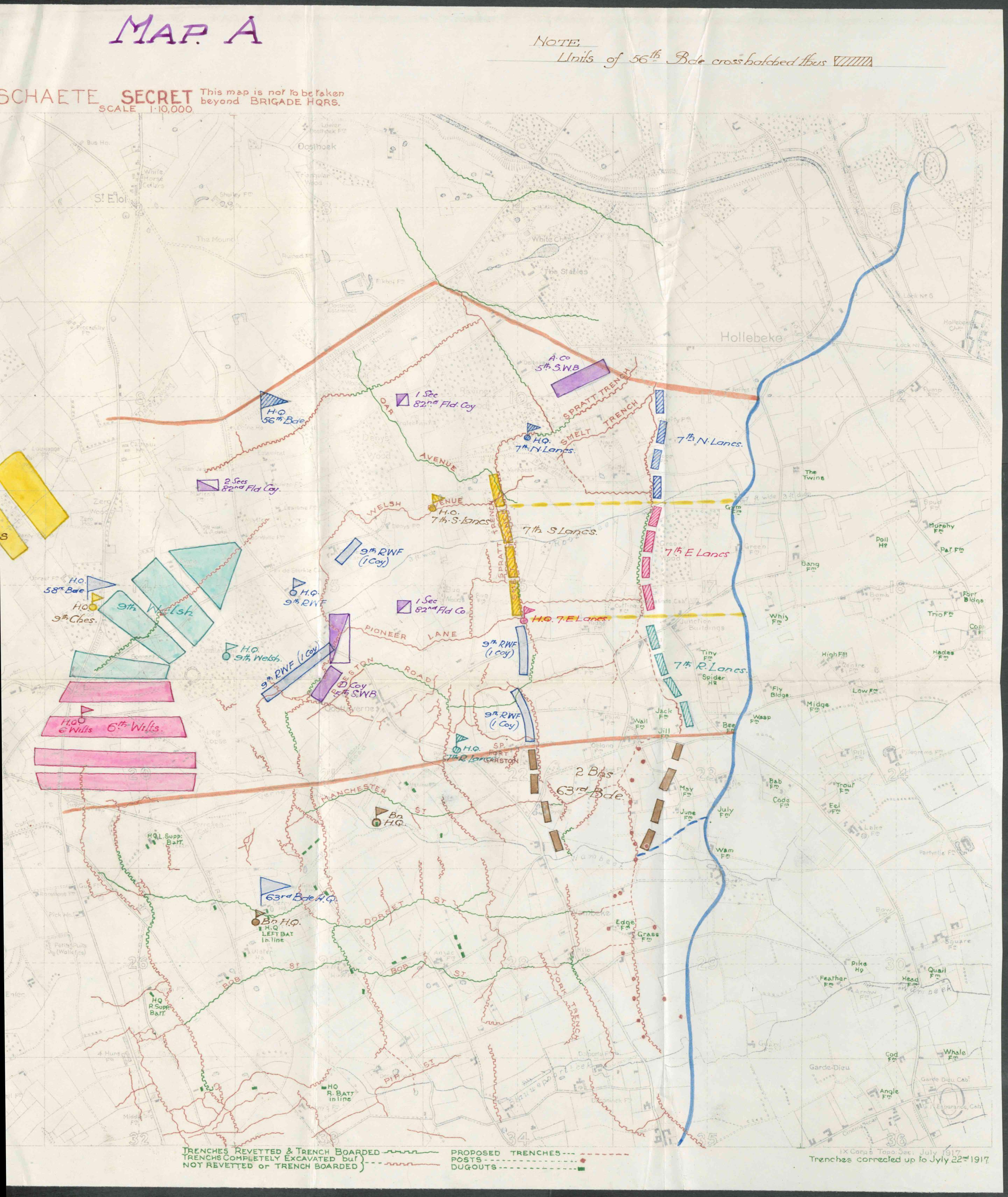
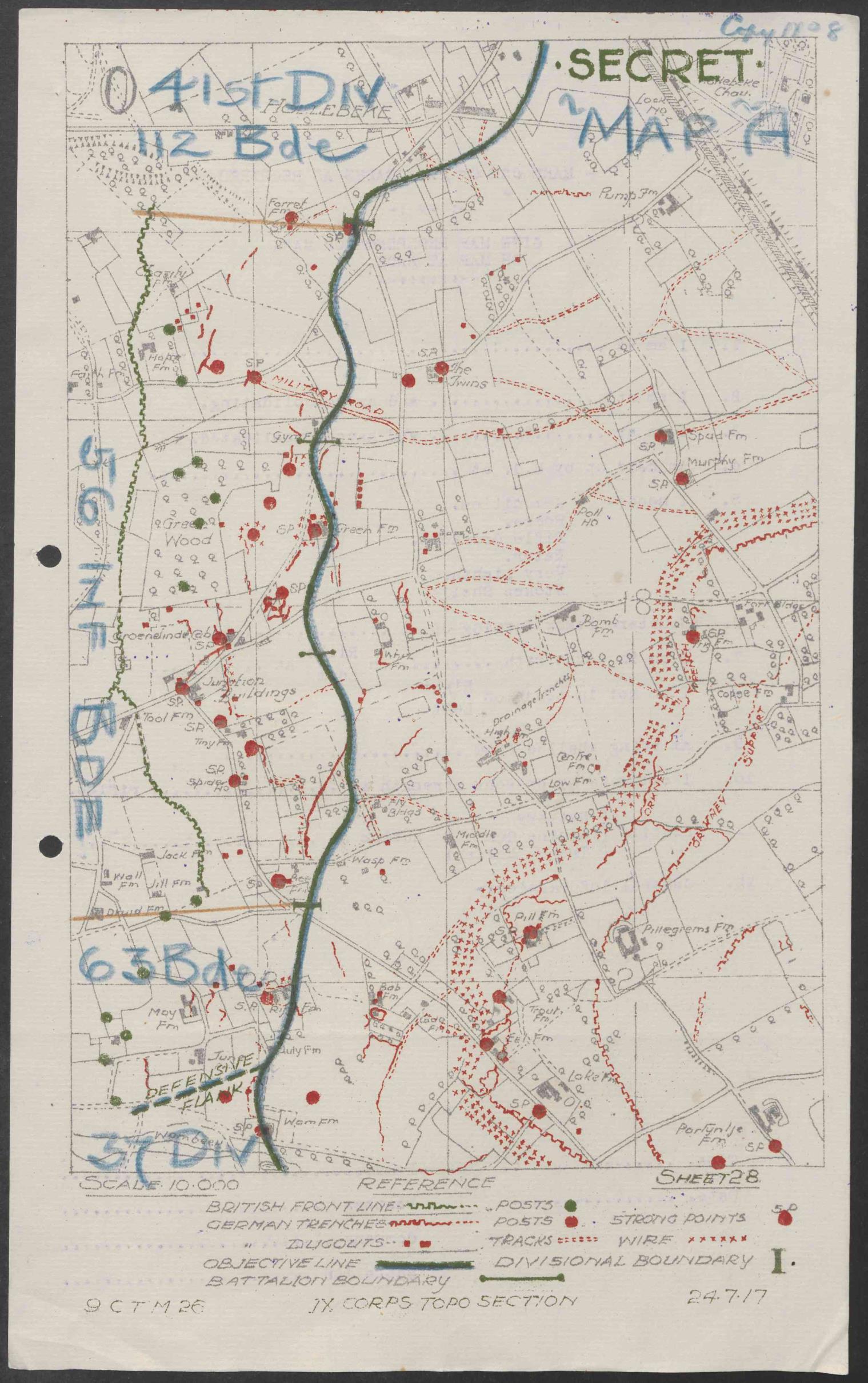

fighting alone a line Tiny Farm Bee Farm, no great distance from where Eric Belfield (SPS 1905 1906) lies. John’s body was lost, partly a result of the bad weather that set in at the end of the day, as recorded in the battalion diary:
It should be recorded that early in the evening it rained heavily and continued to do so almost incessantly until the morning of the 5th August. The whole of the battle area was covered with a sea of mud and water. The conditions under which the men continued to hold the advanced trenches were understandably bad and the evacuation of wounded men was rendered extraordinarily difficult.476
17. the ‘93’ and their stories 226
Scratton, Lt and Adjutant Geoffrey Edward Howel MC 1 August 1917, Kitchener’s Wood SPS 1908 1911
Princess Louise’s (Argyll and Sutherland Highlanders), attd. 4/5th Royal Highlanders (Black Watch), D Company477
Ypres (Menin Gate) Memorial Panel 49 and 51 Age 24
Geoffrey was the son of William Howel Scratton and his wife, Edith. He was born in Grahamstown, South Africa on 25 July 1893. After leaving St Paul’s in 1911 he was engaged in Rubber Planting in the Malay States. On the outbreak of war he joined the Malay States Contingent, and returned to England. In England he joined the Innes of Court OTC in January 1915. He obtained a commission as 2nd Lieutenant in the Argyll and Sutherland Highlanders in March and from November served with the British Expeditionary Force in France and Flanders. He was appointed Adjutant in January 1916 and was awarded the Military Cross, the citation recording that:
He displayed great courage and coolness during the attack. Later, he rendered very valuable assistance during the consolidation of the position under heavy fire.478
At the time of his death Geoffrey was attached to the 4/5th battalion The Black Watch.
On 9 July 4/5th Royal Highlanders (Black Watch) (118th Brigade, 39th Division) received orders that it was to participate in an attack against the enemy trench systems north east of Ypres, part of the assault that was to become known later as the battle of Third Ypres.479 After a quiet month, casualties from the period 31 July 6 August were significant, the 4/5th Black Watch diarist recording the scale of the battalion loss at 74.5%, and the loss of D Company at 63%.480
Chart showing the units in each of the three infantry battalions (116th, 117th and 118th), 39th Division and the periods of time each spent in Reserve and the Front line during the month of July and August (to 8 August).481
477 Known as the ‘4/5th Bn. After 1/4th Bn and 1/5th Bn amalgamated in March 1916. 478 The Pauline, 34 230 March 1917 p 3 479
TNA WO 95 2588 1 4, 118th Infantry Brigade Order No. 118
480 TNA WO 95 2591 3. There is a remarkable list, covering six pages, of named casualties in the July diary. 481 TNA WO 95 2566 1 6
17. the ‘93’ and their stories 227
Diagram showing the scale of casualties for 39th Division during the month of July and August (to 8 August).482

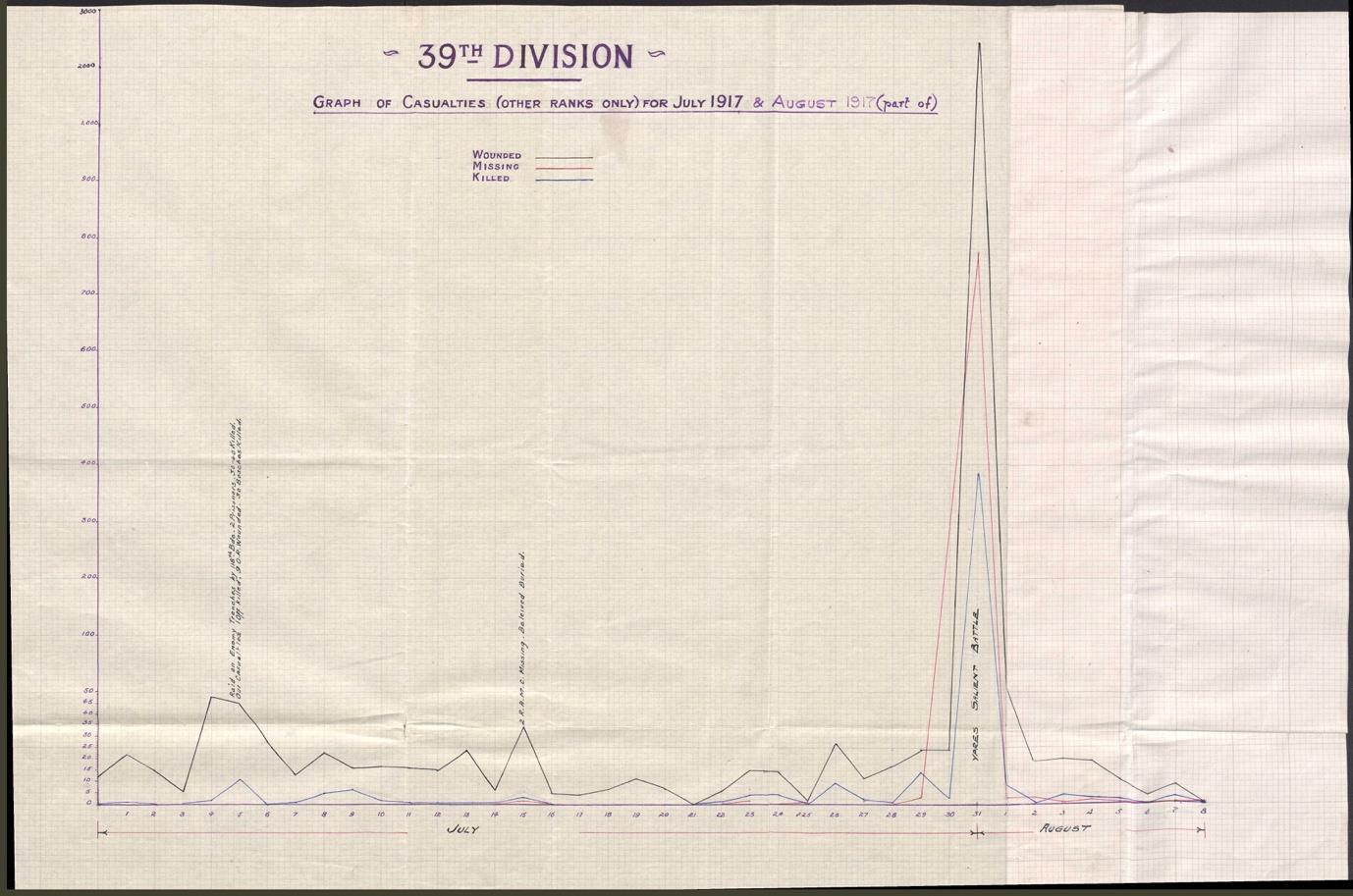
Map showing the 39th Division front and its objectives in the attack of 31 July. 4/5th Black Watch advanced on the left, passing through Kitchener’s Wood (in d segment of square number 10) and reaching as far as the Green Line before falling back to Kitchener’s Wood.483

From mid July 4/5th Black Watch was at Moulle, near St Omer, resting and training. On 22 July the battalion moved to St Jan Ter Biezen where its battle training was continued, all ranks being familiarised by means of lectures and models of the ground with representations of the intended method of advance. Administrative details were adjusted as far as possible based on the experience gained by the attacks at Vimy and Messines, these incorporated much more detailed planning and preparation than any previous attack made by the battalion. On 29 July the battalion moved by motor bus to D Camp at Ouderdom (about 2 and ½ miles south east of Poperinghe) before moving off again at 8.40 pm to billets in the bank of the Yser Canal just north of Ypres. The battalion diarist recorded that:
It was not until well after midnight [on 31 July] that all ranks were ensconced in dugouts on the eastern bank of the Canal. The enemy were shelling the bridges over the Canal heavily as the head of the battalion arrived, but fortunately stopped at that moment .. All together, we were fortunate to arrive without casualties.484
483
TNA WO 95 2588 1 4
484
TNA WO 95 2591 3 Report on the part played by the 4/5th Black Watch in the opening phase of the third battle of Ypres
17. the ‘93’ and their stories 229
As a unit in 118th Brigade, 4/5th Black Watch was in reserve to the two front line Brigades, 116th and 117th. Thus, at Zero Hour (i.e. 3.50 am on 31 July) Geoffrey, unlike the units in the frontline Brigades, did not experience the horrors of moving out into No Man’s Land and advancing under the creeping barrage that was to:
Open on the enemy’s front line at Zero [hour] and lift at Zero plus 8 minutes, advancing at the rate of 100 yards in 4 minutes. The barrage will lift off each successive objective (Blue, Black and Green Lines) at [specified] times. Every infantryman in the leading wave must be close up to the barrage at the times shown, ready to assault.485
One hour and forty minutes after Zero hour, Geoffrey’s unit commenced its march to the front line:
It was still very dark but by 5.30 am, when the battalion commenced its advance, it was a fine bright morning. The battalion advanced in line of Company columns, A, B and C in that order from the left with about 25 yards interval, D Company being some 200 yards in rear, in reserve. The initial difficulty was to get through our own [gun] batteries, which seemed to be everywhere on our immediate front, but this was successfully accomplished.486
In the first instance, the front line units enjoyed considerable success, taking the Blue and Black Lines as planned, though meeting with considerable resistance at the second of these. At this point the units in 118th Brigade were detailed to push through the two front line Brigades and advance to the Green Line. The 4/5th Black Watch diary contains a Report that provides a detailed narrative of its experience as it followed the leading units:
Near our original front line we encountered a considerable number of 5.9’s [i.e. guns] and there were some 15 casualties, mostly in D Company. As was prearranged, the battalion halted just south west of the Reserve Line of the German frontline system. The ground in our own front area and in the Bosche front system had been tremendously ploughed up by shell fire and combined with its soft state had made the advance slower than expected. …. I decided to push on at 8 am rather than 8.30 am. …. Long before this, immediately shell fire had been encountered, the battalion had broken into Artillery Formation. [C Coy on right; skirted Oblong Farm; B Company in the centre advanced on the centre of Kitchener’s Wood.] On the left, A Coy advanced up the Divisional left [boundary] so as to just clear the left of Kitchener’s Wood, followed by D Company under 2nd Lt J G G Stuart. A halt was made near the North West end of the Wood by both Companies about 8.45 am. … Considerable machine gun fire being in evidence in front, a patrol was sent forward to ascertain if the
485
TNA WO 95 2588 1 4, 118th Infantry Brigade Order No. 118 486
TNA WO 95 2591 3 Report on the part played by the 4/5th Black Watch in the opening phase of the third battle of Ypres
17. the ‘93’ and their stories 230
117th Brigade had captured the line of the Steenbeek and, this proving to be the case, the advance was resumed at 9.15 am. … The Steenbeek itself was crossed [by our unit] at 10.05 am. … At this point I must place on record that from 9 am onwards during my advance, I had looked in vain for the protective barrage which should have been coming down on a line about 300 yards beyond the Steenbeek.
Not only was the progress of 4/5th halted by the absence of any ‘protective barrage’ but also the enemy now unleashed a sustained artillery barrage and heavy machine gun fire. In addition, some wire was found not to have been cut. The units on the left and right of 4/5th Black Watch thus fell back exposing the flanks of the 4/5th Black Watch and forcing it too to retreat so that by mid afternoon on 1 August it was once again in the vicinity of Kitchener’s Wood. It was here that Geoffrey was killed, a victim of a shell attack:
At 3 pm on 1 August the Bosche commenced an intense 5.9 barrage mainly around battalion HQ and on all the ground back to Kitchener’s Wood. It was in this barrage that the Adjutant, Lieut Scratton and Sgt G Y MacFarlane of D Company were killed. … It is pleasing to record that the Adjutant’s body was brought in and buried at the edge of Kitchener’s Wood close to battalion HQ, and a cross made by the 7th Argylls on our left erected at this spot.487
The Report describes the location of the battalion HQ as ‘just south of Kitchener’s Wood, about C.10.d.6.5’, thus permitting the vicinity in which Geoffrey fell to be broadly identified, and the location of his initial burial to be located with a high degree of precision. As part of the Concentration of Graves process in the aftermath of the war, exhumation and re burial documentation indicates that Geoffrey’s body was located at map reference 28.C.10.Central and infers that he was reburied at New Irish Farm Cemetery, to the north east of Ypres, on 18 February 1920. However, his remains are not to be found in that cemetery, and it should be noted that the exhumation record also records that at 28.c.10. central ‘digging has taken place but no remains found’. This means that no bodies were found, only crosses placed in memory of the soldiers. Memorial crosses were not uncommon on the battlefields. Frequently they were erected by soldiers near to the location of where their comrades fell, particularly in situations where there was little chance of marking an actual grave. Geoffrey is thus commemorated on Ypres (Menin Gate) Memorial.
Concentration of Grave Certificate488 487 TNA WO 95 2591 3 Report on the part played by the 4/5th Black Watch in the opening phase of the third battle of Ypres 488 See CWGC. https://www.cwgc.org/find records/find war dead/casualty details/916093/GEOFFREY%20HOWELL%20SCRATTON/#&gid=2&pid=1
17. the ‘93’ and their stories 231

Winckler von, Lt Myles William (known as ‘Vonny’) 1 August 1917, Westhoek
2nd Bn. Duke of Cambridge’s Own (Middlesex Regiment) Ypres (Menin Gate) Memorial Panel 49 and S1 SPS 1907 - 1912 Age 23
489
Myles known as ‘Vonny’ was born in 1893 in Demerara, British Guiana (now Guyana), the son of Dr William J Winckler, employed in the colony’s Government Medical Service, and his wife, Aimable, who was born in the colony. He came to England in 1900. Myles’ obituary in The Pauline provides the following details on his school career:
[Vonny] entered St. Paul's from Colet Court, where he was in the cricket and football elevens, in September, 1907, and left at the Apposition of 1912. From January, 1909, onwards he was a member of Mr Wainwright's House, after a term in the same House under Mr Loane.490 … At school “Vonny” was best known as an athlete. He played several innings for the XI in
489 Myles as a member of Wadham College soccer team, 1912 1913. Courtesy of Wadham College Archives.
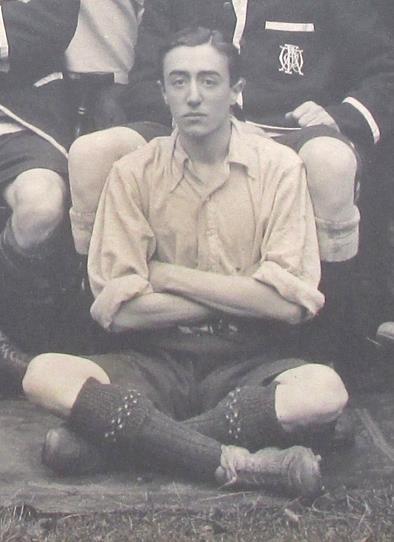
490 This was a school boarding house. The address was Colet House, 9 Gliddon Road, West Kensington. The 1911 census states that it had 30 rooms accommodating 33 persons.
17. the ‘93’ and their stories 233
1910, got his colours in 1911, and was the best bat on the side. In the 1912 team he was second in the averages, and played a fine 132 against Merton. He was a brilliant field in the slips, and, as a small boy, an effective bowler with a big break. He would have been even more successful if he had been less given to fancy shots. It was said of him that what he couldn't cut he could leg glide, but he might drive it. He was for two years in the Fives IV, captain in 1912. Above the average of players, he gave away points by trying shots of all sorts, but he was good enough to win the First XII competition in most years, and it was hard luck for him that he had to run up against Wainwright. He did not care much for football, but was a clever half back for Houses. All round he was one of the best of the many fine athletes who made Houses invincible from 1910 to 1914. He was also a House Prefect. Two features were prominent in his character, affection and lack of self confidence. He stuck very closely to his friends, and was grateful for the least interest or help. His lack of self confidence led him sometimes to underestimate himself. He knew he was not clever at books, and in consequence he thought and spoke too slightingly of his powers in every way. Those who knew him best always expected to find him more capable and resourceful than he made himself out and were seldom disappointed. … From school he went to Wadham, Oxford, where he spent two years before war broke out. Then he at once joined the Public Schools Battalion as a private, went on to Sandhurst for six months, was gazetted to the 5th Middlesex.491
Vonny continued to exhibit his sporting prowess at Oxford. He played for the Wadham Soccer team in his first and second years and in 1913 was Secretary of the Cricket Club. According to the Wadham Gazette, he was considered a mainstay of the batting:
von Winckler is one of the finest batsmen we have had at Wadham, and played consistently throughout the season. He made 105 v Exeter, 126 v Berkhampstead School, 84 not out v Thame, 56 v Keble, 47 v BNC and in some matches scored considerably more than half the total. We sympathise with him in not having been recognised by the University authorities.492
Vonny made up his mind to give up a university life perhaps because his contributions were seemingly unnoticed and took up a position in the West Indies, where he had family connexions. When the war broke out he enlisted in the Public Schools Battalion but later went to Sandhurst and adopted a military career. In 1914 he enlisted with the Royal Fusiliers, UPS (Universities and Public Schools Brigade) and was gazetted 2nd Lieutenant. At some point in 1915 he transferred to the Middlesex Regiment. 491 The Pauline, 35 234 Nov 1917 pp 144 46 492 Wadham Gazette
17. the ‘93’ and their stories 234
At the time of his death Vonny was attached to the 2nd battalion Middlesex (23rd Brigade, 8th Division.) In the same way as other units detailed to participate in the attack planned for 31 July, 2nd battalion Middlesex Regiment had spent much of July training: Since … 1 July the battalion has been continuously employed in preparing and training for the forthcoming offensive operations. This includes individual instruction in musketry, bombing, rifle bombing, Lewis gun, map reading, signalling etc as well as the actual rehearsals of the attack over ground specially laid out with spitlocked and flagged trenches.493
On 22 July the battalion entrained for Abeele and then marched to bivouacs in the Reninghelst area. Two days later it moved to Dominion Camp (28.G.24.a.3.5) and then on 28 July to the dugouts at Swan Chateau (28.I.19.c), where it remained for a period of 24 hours before moving forward about 9 pm on 29 July to Ypres, where B and C Companies were provided with accommodation in Lille Gate and Cavalry Barracks and A and D Companies in Hellfire Dugouts (I.16.a.6.8). Then, at 9 pm the following evening, it moved forward to assembly trenches in Railway Wood (28.I.11.b), ready to play its part in the assault at dawn on 31 July.
The 8th Divison was detailed to attack Bellewaarde Ridge and then proceed in a north easterly direction, taking the Black (i.e. Bellewaarde Ridge) and Green Lines (i.e. Westhoek Ridge) as they did so, moving forward behind a massive protective barrage in common with other units along the Ypres front at Zero Hour i.e. 3.50 am. The 2nd battalion Middlesex was on the left, just south of the Ypres Roulers railway. The battle order dictated that after the Blue Line had been taken by other units in the 23rd Brigade, 2nd battalion Middlesex was detailed to pass through the Blue Line and take the Black Line.494
Map showing 8th Division direction of attack on 31 July towards the Blue, Black and Green Lines. The 2nd battalion Middlesex can be seen proceeding forward, adjacent to the northern Divisional boundary i.e. Ypres Roulers railway and passing through the 2nd Devons to reach the Black Line.495
493
TNA WO 95 1713 1 2 494
TNA WO 95 1713 12. Blue Line to be attacked by 2nd Devons on left; 2nd West Yorks on right; Black Line to be attacked by 2nd Middlesex on left; 2nd Scottish Rifles on right 495 TNA WO 95 1677 1 4
17. the ‘93’ and their stories 235
The battalion diary provides the following narrative of events on 31 July:
The Bellewarde Ridge was captured by the 2nd Devon Regiment on the left and 2nd West Yorkshire Regiment on the right. The 2nd Middlesex Regiment passed though the 2nd Devons and the 2nd Scottish Rifles through the 2nd West Yorkshire Regiment and captured the Westhoek Ridge. The northern boundary of the battalion frontage was the Ypres Roulers Railway and the battalion frontage was 500 yards. D Company on the left and A Company on the right formed the troops to capture the German trench line on the Westhoek Ridge and B Company on the left and C Company on the right thereupon pushed through to a position on the eastern slope of the ridge where they consolidated. 1 August. Counter attacks against positions were successfully resisted. [The battalion was relieved and withdrew to Dominion Camp.] Casualties in this action …. Lieut W. M. von Winckler.496
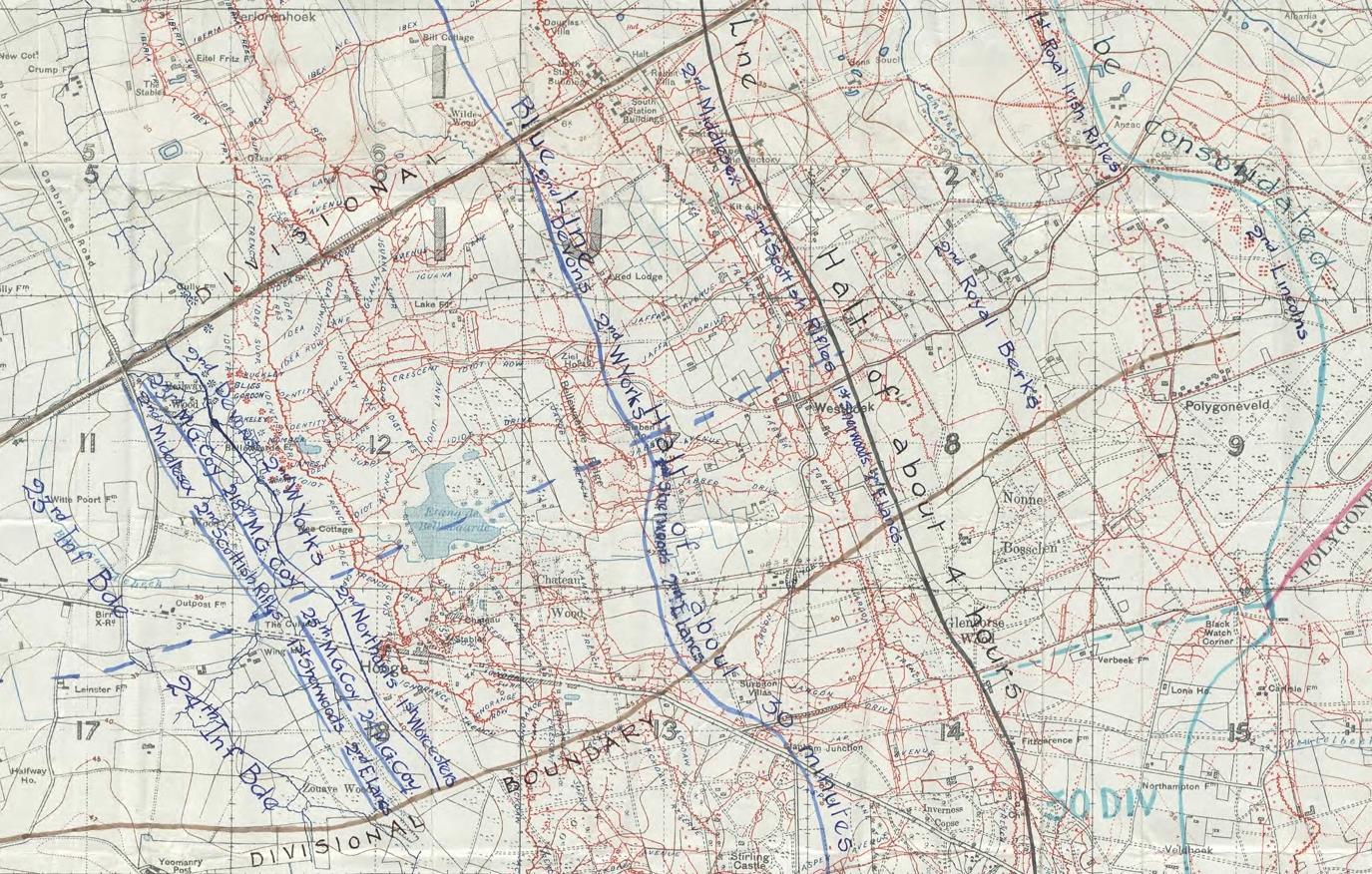
At 5.41 am two Companies of 2nd battalion Middlesex had successfully captured the Black Line and at 5.45 am they advanced to a line 100 yards east of the Black Line. Up until this point no real opposition had manifested itself. However:
Some ¼ hour [i.e. 6.00 am on 31 July] after … consolidation had been begun on the Black Line, the enemy stopped running away and then opened fire with machine guns … and
17. the ‘93’ and their stories 236
gradually odd snipers came forward. … [And] the late arrival of the tanks was a great disappointment.497
And:
On 1 August heavy shelling from all directions lasted all day causing heavy casualties. The Blue and Black Lines, with the intervening ground between them, being extremely unhealthy.498
The German counter attack meant that by mid afternoon the disposition of units on the Black Line had evolved so that the 2nd Middlesex moved to occupy the centre.499
The available evidence does not allow the location at which Vonny fell to be identified with precision. His commanding officer reported that:
After having consolidated the positions won, [Vonny] beat off most successfully the German counter attack, and only a few hours before his Company was relieved, he was shot by a sniper.500
This suggests that Vonny, acting in command of his Company at the time, was on the dangerously exposed forward slope of the Westhoek Ridge when he fell, some 100 yards beyond the Black Line. This area was reported as being the target of such ‘very heavy hostile shelling’ that relief (by 8th battalion South Lancashire Regiment see Solomon E J, kia 2 August 1917 and 11th battalion Cheshire Regiment) had to be delayed until after dark on 1 August.501 Vonny’s body was lost and he is commemorated on the Ypres (Menin Gate) Memorial.
497
TNA WO 95 1713 1 2, 23rd Infantry Bde. Your G.19/92, dated 3 August 1917, Lieut Col commanding 2nd battalion Middlesex Regiment 498
TNA WO 95 1710 1 3, Report On Offensive Operations Carried Out By 23rd Infantry Brigade on the 31 July and 1 August 1917
499 The section of line taken over ran from J.1.d.7.8 J.1.b.5.4. See TNA WO 95 1710 1 3, Report On Offensive Operations Carried Out By 23rd Infantry Brigade on the 31 July and 1 August 1917
500 Published in the Ealing Gazette and West Middlesex Observer, 29 September 1917 501 TNA WO 95 1710 1 3
17. the ‘93’ and their stories 237
Solomon, 2nd Lt Edmund John 2 August 1917, nr. Westhoek502 SPS 1906 1912
1st Bn. Prince of Wales’s Volunteers (South Lancashire Regiment), attd. 8th (Service) Bn. Belgian Battery Corner Cemetery I.J.14 Age 23
Edmund was the son of Joseph Maurice Solomon and his wife, Kate. Edmund’s obituary published in The Pauline provides the following details:
[Edmund] was a foundation scholar of St. Paul's, from which he gained an open classical scholarship at Exeter College, Oxford. He had obtained honours in Moderations, and was reading for “Greats” when the war broke out. He enlisted in the West Kent Territorials in 1914, and obtained a commission in the Royal Marine Light Infantry in 1915. For reasons of physique he was obliged to resign his commission, and he returned to Oxford in the autumn of 1915. Almost immediately, however, he enlisted again, in the Public School Battalion of the Royal Fusiliers, with which he saw four months' service in France. Recommended a second time for a commission, he came back to an officers' training camp, and returned to the front in October, 1916, as second lieutenant in the South Lancashire Regiment. There he saw nine months' service. … One who knew him well writes : “At school and at college he showed great promise, and had strong literary tastes and ambitions that often led him into paths that ran counter to those of the orthodox academic study. But he was not in the least priggish, and was quite ready to laugh at his literary ambitions, while at the same time he still pursued them eagerly, and looked eagerly forward to the time when he might be able to give them adequate expression. He had a most pleasant sense of humour and a gentleness of character that made him generally liked. He worked manfully to make himself the good officer he became, and his military duties became, as they were bound to become, his chief preoccupation. But he kept to the end his love of ideas and books, and cultivated them when he could. I have as a memorial of him, returned to me from the trenches, two battered volumes of Monro's Iliad, which he and a fellow Oxonian had, as he told me in his last leave, read again with all the old enthusiasm as they worked out together an essay on the Homeric view of death. Only a few days after that leave 'the end of death' came to him.”503
At the time of Edmund’s death 8th (Service) battalion South Lancashire Regiment (75th Brigade, 25 Division) had just relieved 2nd battalion Middlesex, in which unit fellow Old Pauline von Winckler had been killed on 1 August. The 8th (Service) battalion South Lancs had moved up to the Ypres area from Beaumetz (west of Doullens, France) on 8 July,
502 For maps showing locations of key places mentioned, please refer to the entry on Myles William von Winckler, kia 1 August 1917
503 The Pauline, 35 234 Nov 1917 pp 144 45
17. the ‘93’ and their stories 238
billeting at Steenbecque. The following day the battalion had moved by bus to Poperinghe, from where it marched to its new accommodation at Dominion Camp in the Busseboom area. Over the course of the next fortnight it provided working parties for employment on work in the trenches, moving to Reninghelst on 22 July. After several days of training and lectures, it moved on 30 July to its assembly position at Belgian Chateau, about a mile to the south west of Ypres.
Edmund’s unit was tasked with exploiting the expected success of the units in 8th Division in the great assault of 31 July. However, when it became clear that the success of 8th Division was less than had been hoped, 75th Brigade was ordered not to move up into line on 31 July as had been intended; instead it was to relieve the front line units of 23rd Brigade on 1 August.
The battalion diary records that on 1 August the unit moved up to the section of the Black Line that extended south from the Ypres Roulers railway and in which von Winckler (SPS 1907 1912) had fallen earlier that day:
At 2 pm D and A Companies moved up into support line. During relief the enemy counter attacked on the immediate north of the Ypres Roulers railway, driving out the 2nd Middlesex Regiment [see von Winckler, kia 1 August]. D Coy of the 8th South Lancs Regiment … repulsed the enemy and moved up so as to occupy the approximate position held by the [2nd battalion] Middlesex [on the forward slope at the northern end of the Black Line]… At 8 pm the remainder of the battalion moved up to complete the relief of the sector then held by the 2nd Devons [i.e. on the immediate left of 2nd Middlesex Regiment] and Capt Chambers took command of the battalion temporarily.504
The entry for the following day records the death of Edmund:
2 August. Major Prior arrived at 6 am this morning to take command of the battalion. During the day nothing unusual occurred but the enemy shelled heavily. 2nd Lt Solomon died this morning from machine gun bullets in the stomach. Casualties amongst ORs: 8 killed; 26 wounded.
Edmund is buried in Belgian Battery Corner Cemetery. This cemetery was begun by the 8th Division in June 1917 after the Battle of Messines and it was used until October 1918, largely for burials from a dressing station in a cottage nearby. This suggests that Edmund was wounded, perhaps on 1 August, extracted from the location where he fell no great
17. the ‘93’ and their stories 239
distance from the torn and cratered ground that was already consuming von Winckler’s shattered remains and died at the dressing station at Belgian Battery Corner.505
Edmund’s grave at Belgian Battery Cemetery. The cross has been replaced by the Star of David. (The memorial note has been laid by Edmund’s old college, Exeter, Oxford).506
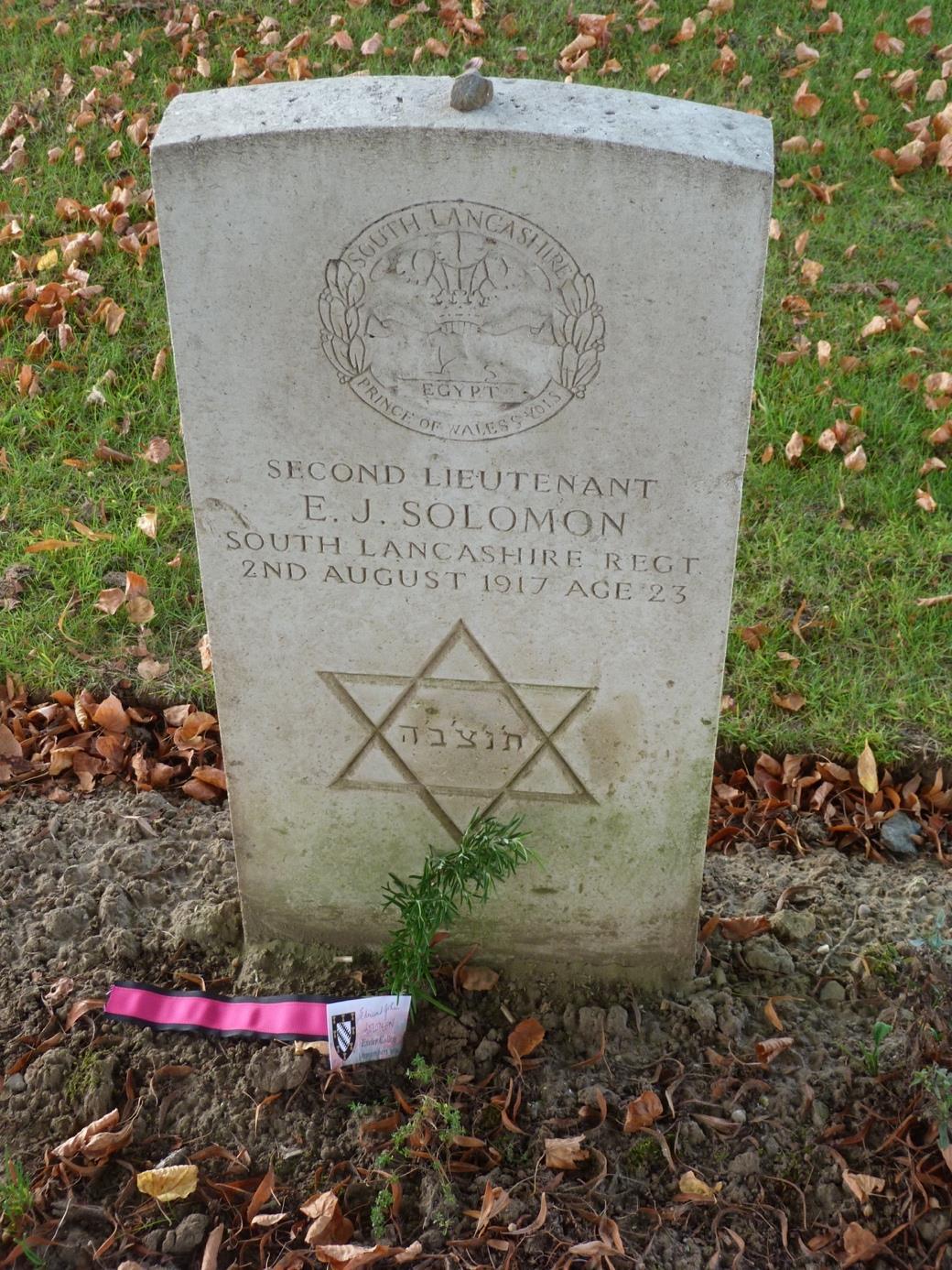
505 The anonymous author of Edmund’s obituary in The Pauline states that Edmund ‘died of wounds received in action on 2 August’. The Pauline, 234 Nov 1917 pp 144 45 506 Courtesy of Exeter College, Oxford.
17. the ‘93’ and their stories 240
Johnson, 2nd Lt Harold George 7 August 1917, Langemarck SPS 1912 1915
1st Bn. Grenadier Guards Artillery Wood Cemetery VI. A.12
Grave epitaph: I Have Fought A Good Fight I Have Finished My Course I Have Kept The Faith 2. Tim. IV.7 Age 20
Harold was the son of Henry T. and Ethel Johnson (nee Mason), of 8, Malbrook Rd. Putney Park, London. Prior to his time at St Paul’s School, he was educated at Rokeby, Wimbledon and in Neuchatel, Switzerland. Harold rose to the rank of sergeant in the St Paul’s O T C. From St Paul’s he passed into A Company of the 8th Cadet Battalion, a unit formed and stationed at Whittington, Staffordshire. He was gazetted to the Grenadier Guards on 5 August 1916 and fell on 7 August 1917, near Langemarck.
Harold was killed as 1st battalion Grenadier Guards (3rd Guards Brigade, Guards Division) was in the process of being relieved in the front line trenches on 7 8 August. The battalion diary provides the following terse record:
7 August. Battalion was relieved by 2nd Bn Royal Fusiliers and entrained from Elveedinghe for Proven and marched to Putney Camp [at] X.27.a.2.3. 2nd Lt H G Johnson was killed on the night of 7 8th August.507
Harold fell a week after his unit had participated successfully in the great assault of 31 July, assisted in that attack by the vigorous specialist training that it had undergone from as early as June:
18 June Brigade marched into the Herzeele area, where it dug an exact replica of the German trench system to be captured (including the [Yeser] Canal and British assembly trenches) as far as the second objective [i.e Black Line]. Practice attacks.508
Alongside training, great energy was expended through much of July on such endeavours as ‘pushing up ammunition’ and ‘carrying sandbags’ to the trenches. These were dangerous activities, as reported by the 3rd Guards Brigade diarist:
507
TNA WO 95 1223 1 1 2
508
TNA WO 95 1222 1 7, Narrative of Operations of 3rd Guards Brigade in the Attack from Boesinghe on 31 July 1917
17. the ‘93’ and their stories 241
Casualties to carrying parties and to troops holding the line had been severe about 600 in three weeks. One of the greatest sources of discomfort and fatigue, as well as of loss, was the enemy’s continual gas bombardments, which necessitated the wearing of gas masks by carrying parties and by troops moving in and out of the line.509
The section of line serviced by these carrying parties ran along the west of the Yser Canal extending from, on its right, the junction of the Canal and the Ypres Staden railway to just north of Boesinghe on its left. On the night of 29 30 July 1st battalion Grenadier Guards had crossed the Canal and, with the railway immediately on their right, had occupied the trenches immediately in front of the Canal, ready to proceed to their first objective the Blue Line consisting of Cariboo Trench. This first objective was taken with practically no opposition; other units then proceeded to the Black and Green Lines, though by the time the latter was reached German resistance was becoming ever greater. Having been relieved on 1 August, Harold’s unit was back in the support line (in the vicinity of the Black Line) on 5 August and, on 6 August, moved up to inhabit the right sector front line trenches in the vicinity of the Green Line in front of the River Steenbeek.
Map showing the Divisional boundaries (yellow lines) of Guards Division in July and August. 1st battalion Grenadier Guards was in the right of the line i.e. south of the horizontal red line in the front line trenches (in the vicinity of the Green Line), in front of the River Steenbeek when Harold was killed. He body was discovered in 1919 in the vicinity of the second ‘o’ in ‘Zouave Ho’ in the area of map labelled ‘7’ in the bottom left.510
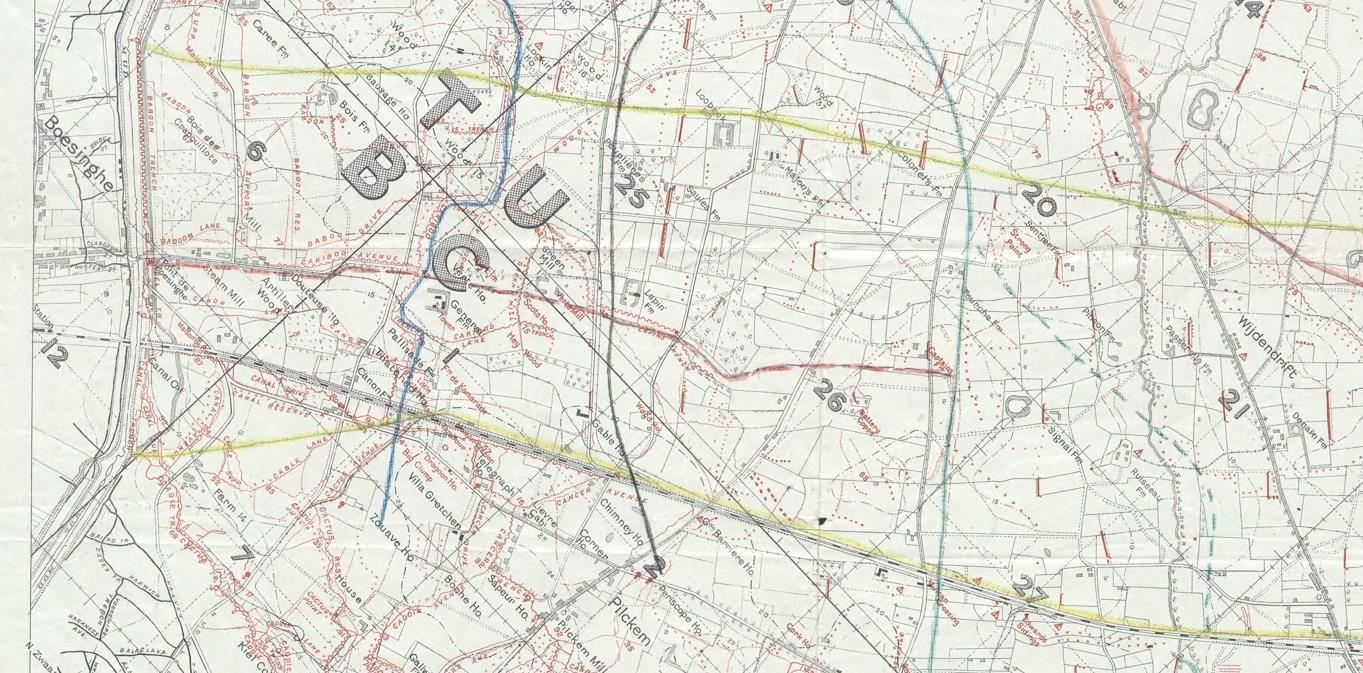
509
TNA WO 95 1222 1 7, Narrative of Operations of 3rd Guards Brigade in the Attack from Boesinghe on 31 July 1917 510 TNA WO 95 1193 17
17. the ‘93’ and their stories 242
Unrelenting rain for four days and four nights from 31st July meant that the terrain became a muddy quaqmire, the River Steenbeek a normally small stream directly in front of the trenches occupied by 1st battalion Grenadier Guards on 6 7 August swelling in volume and velocity so that it overflowed its banks and poured its excess into the numerous shell holes, many of which had been recently formed by the protective barrage.
[In the trenches] men were standing up to their knees in water. Every shell hole was a pond and the going had become terrible. It was found that the only way to keep the men going was to dig a new trench at dusk and dawn each day; the trench remained dry for a short time and the digging of it gave the men exercise. … The difficulties were intensified owing to the fact that that all the trenches were on a forward slope which, in spite of the rain and mist, the enemy could observe, and shelled continuously day and night.511
Harold was a victim of one of these shells, as reported by a fellow officer:
Standing in the front line trench that we were holding, a shell burst on the parapet and killed him instantaneously.512
The evidence thus suggests that Harold was killed in the section of line as far as it existed on the ground immediately north of the Ypres Staden railway, a short distance west of the River Steenbeek. In what must have been intensely challenging conditions, his body was brought back with the scheduled relief and was initially buried at 28.C.7.b.9.8, directly adjacent to Dragoon Camp Cemetery, developed by 13th battalion Royal Welsh Fusiliers on 9 August 1917. As part of the concentration of graves process in 1919, Harold was exhumed and re buried in Artillery Wood Cemetery, a location through which he will have passed on his final journey to the front. It is curious that he was in the first instance buried near what became Dragoon Camp Cemetery since this part of the line was held at the time by 38 Division. It is not implausible to suggest that Harold may have been wounded in the front line and that Dragoon Camp, an established position held by the Germans until 31 July, was thereafter used as a first aid station by 38 Division. The fact that Harold’s fellow officer states that Harold was killed ‘instantaneously’ may have been a corruption of the truth, an attempt to soften the grim news for those receiving it: in this instance, Harold’s parents.
Aerial view of the section of line held by the Guards Division. ‘1’ shows the location in which Johnson fell; ‘2’ shows the location at which he was initially buried; ‘3’ shows the location of his grave in Artillery Wood Cemetery.
511 TNA WO 95 1193 1 7, Guards Division, Report of the 1st Guards Brigade, August 1917 512 The Pauline, 35 234 Nov 1917 p 140
17. the ‘93’ and their stories 243
Martin, Corporal Stephen Staffurth 11 August 1917, Langemarck SPS 1907 1912
16th (Service) Bn. The Duke of Cambridge’s Own, (Middlesex Regiment,) D Company Ypres (Menin Gate) Memorial Panel 49 and 51 Age 24
Stephen was the son of Charles Gill Martin and his wife Elinor. As related by The Pauline, Stephen was a talented musician:
He was an exceptionally sound and scholarly musician, and, like his brother, whom he so closely resembled, was for years one of the chief supports of the School Musical Society.513 He was one of the committee, and his share in the management was far more mature and effective than is usually to be expected. At times he played the pianoforte solo at concerts; but he was most distinguished by his tactful accompaniments, which to the judicious ear often formed the best part of a song. At King's, Cambridge, though not a choral scholar, he attached himself as a volunteer to the famous choir, in whose work he took great delight. He was one of the most grateful and devoted of Paulines, and after he left the School [he was] always ready for its service. Simply upright and transparent in character, he was of a loyal and affectionate nature, and his friendship was something to cherish and keep in abiding recollection.514
The 16th (Service) battalion Middlesex Regiment (86th Brigade, 29th Division) was in the northern sector of the Salient when Stephen was killed, directly on the right of the front held by the French. In the first week of August, the 29th Division received instructions to undertake a minor action designed to move the front line closer to Langemarck by establishing posts to the east of the river Steenbeek:
The 29th Division has been ordered by the Corps to secure the passage of the Steenbeek on the morning of 11 August … by establishing a line of posts on the eastern bank and at an approximate distance of 100 yards from the river. The capture of Passerelle Farm will be included in the objectives. …. The operation will be carried out under the cover of a Field Artillery barrage. The barrage will open 100 yards east of the river Steenbeek and will begin to creep at Zero [hour i.e. 4.20 am] plus 9 minutes, and advance at the rate of 100 yards in 5
513 Stephen’s elder brother was Thomas Lytte Martin (SPS 1906 1912). Thomas became a Captain in the Cheshire Regiment. He returned to join the staff at SPS in 1920 and remained at the school until 1957. Latterly, he held the post of Director of Music.
514 The Pauline, 35 234 Nov 1917 p 142. The obituary mistakenly asserts that Stephen was killed on 13 September.
17. the ‘93’ and their stories 244
minutes [until it reaches the agreed final line.] Under cover of this barrage posts will be pushed forward to the general line U.21.d.8.1 Passerelle Farm Farm at U.20.b.75.60.515
Barrage map showing the progressive advance of the barrage from left to right on the 29th Divisional front. The River Steenbeek runs north to south and is shown middle left. (The blue horizontal line is the battalion boundary. Stephen’s battalion was on the left i.e. in the northern sector, above the line.)
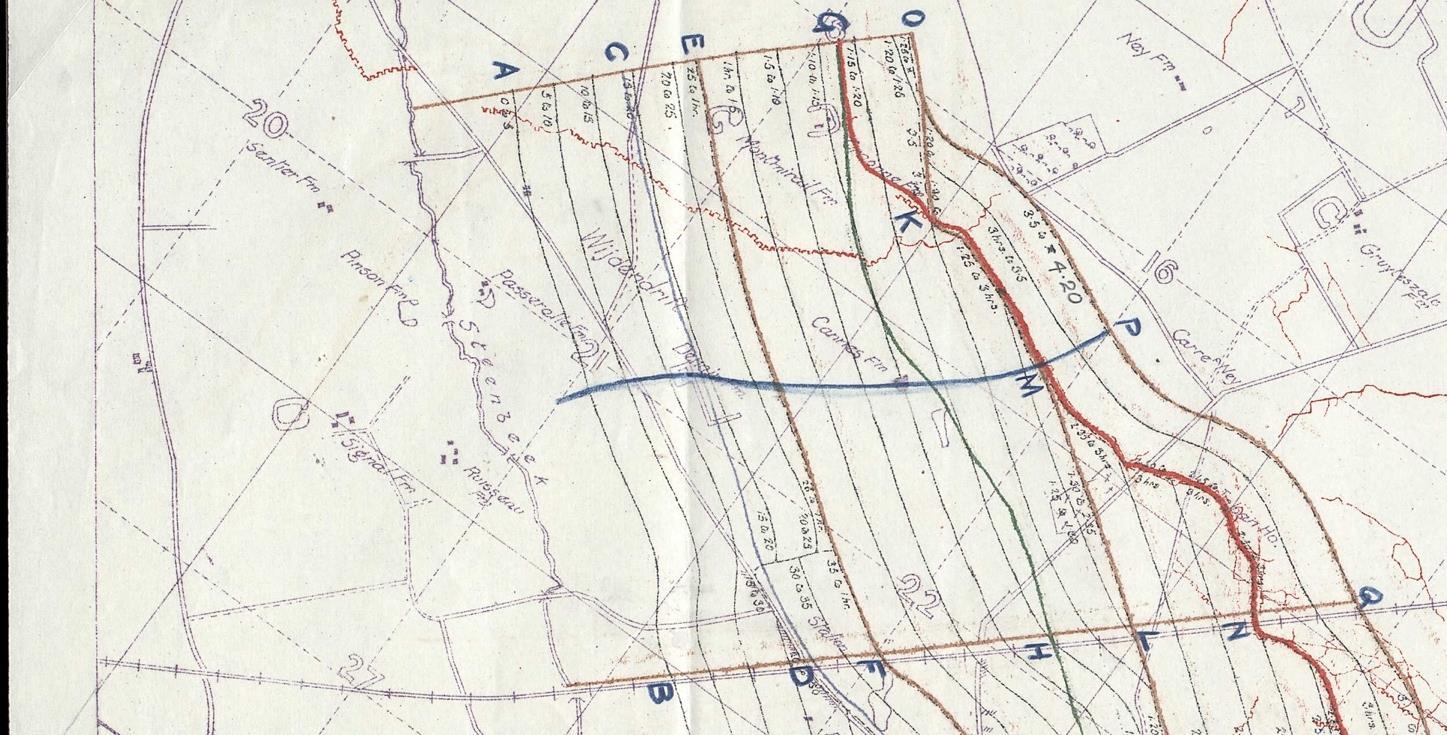
On 7 August the 16th (Service) battalion Middlesex moved up to Saules Farm, behind the front line; at 1.30 am on 9 August they took up position in the front line, just west of the River Steenbeek.
The battalion diary asserts a successful action on 11 August:
10 11 August B and D Companies push out posts across the Steenbeek (between U.20.b.8.6 and U.21.c.5.7). In touch with French on left and 1st Lancashire Fusiliers on right. Prisoners taken: 22 unwounded; 3 wounded. [Then] A Company (3 platoons) under Capt J A W Wilson …. moved up from Support Line and lined up in three lines west of the River Steenbeek and at 4.20 am under a pocket barrage attacked Passerelle Farm (U.21.c.3.9). Attack successful position consolidated and held. Two machine guns and one Howitzer captured. Total casualties: 6 officers (2 killed; 4 wounded); ORs, 30 killed; 83 wounded. 12 13 Aug. Battalion is relieved by 1st Border Regt and marches back to camp at 28.B.7. c and d.516
515 TNA WO 95 2282 1 4, Operation Order 145, 9 Aug; App VI 516 TNA WO 95 2302 1
17. the ‘93’ and their stories 245
In fact, the judgement of the diarist was premature, the post established at Passerelle Farm having later to be withdrawn.
Stephen did not hold a rank of officer status and he is therefore not named in the battalion diary. It must be assumed that he is one of the thirty Other Ranks who were killed in the attack. His obituary in The Pauline states that:
[Stephen] was killed leading a section of bombers in an attack, and was one of very few to reach his objective; while calling on some Germans to surrender he was shot dead by one of them.517
His body was lost in the mud and he is commemorated on the Ypres (Menin Gate) Memorial.
517 The Pauline, 35 234 Nov 1917 p 142
17. the ‘93’ and their stories 246
Bowman, 2nd Lt Claude Herbert 16 August 1917, St Julien SPS 1910 - 1916

1/4th battalion Oxford and Buckinghamshire Light Infantry Tyne Cot Memorial Panel 96 to 98 Age 20
Claude Herbert Bowman518
Claude was the only son of Mr. L. G. Bowman (Headmaster of the Jews’ Free School, London) and Mrs. Bowman, of 39, Ashbourne Avenue, Golders Green, London. During his time at SPS where he was a foundation scholar Claude was a member of the O.T.C. Upon leaving school in 1916 he proceeded to Exeter College, Oxford, having won an open classical scholarship. In the same year he joined the Artists Rifles. Early in 1917 he was gazetted to the 1/4th battalion Oxford and Buckinghamshire Light Infantry, with whom he crossed to France on 21 February 1917. At the time of Claude’s death the 1/4th battalion Ox and Bucks was a unit in 145th Brigade, 48th (South Midland) Division.
Even though the early August weather was consistently wretched, the Fifth Army’s aim remained as it had been on 31 July: namely, to push the enemy off the higher ground, break the line and henceforth advance in a north easterly direction towards the coast. The assault that occurred on 16 August (delayed from 13 August because of the weather) was to be effected in the same way as that of 31 July that is, with units detailed to advance to nominated coloured lines protected by a creeping artillery barrage.
518 © Image reproduced by courtesy of the Trustees of the Honourable Artillery Company, Armoury House, City Road, London EC1Y 2BQ
17. the ‘93’ and their stories 247
With rehearsals for the forthcoming attack completed, the 1/4th battalion Ox and Bucks moved from Dambre Camp on 15 August to Reigersberg Camp, to the north west of Ypres.519 After spending the day at the latter place (during which an allied aeroplane crashed into the camp) the battalion moved off at 10.15 pm. It crossed the Yser Canal at Bridge No.3 and proceeded along Infantry Route No. 4 towards to its assembly position in a line of shell holes to the west of the River Steenbeek where that watercourse entered St Julien from the north west. Zero Hour was set for 4.45 am. At 4 am all Companies reported that they were in position and that white direction tapes had been laid out to aid direction. Four objectives had been assigned (see map below):
First strong points (shown as blue stars on the map located between the assembly line and the Green Line) west of St Julien Langemarck road;

Second Langemarck Winnipeg road between C.6.d.2.1 and C.6.c.4.9 i.e the Green Line
Third Langemarck trench system between C.6.d.9.4 and C.6.b.9.8 i.e. the Red Dotted Line Fourth outpost line from latter point to Hubner Farm i.e. the Blue Dotted Line
Map showing the 145th Brigade boundaries and objectives. The 1/4th battalion Ox and Bucks were assigned 600 yards on the left.520
519 Reigersburg Camp was located at 28.H.6.a 520 TNA WO 95 276 1 4
17. the ‘93’ and their stories 248
Barrage map showing the incremental advance of the artillery shelling, designed to protect the infantry as it moved forward. The first lift of the barrage was at Zero hour (i.e. 4.45 am+ 5 minutes i.e. 4.50 am. It then advanced at the rate of 100 yards in 5 minutes, lifting off the Green Line at Zero plus 35 minutes.521 (The River Steenbeek is shown at the bottom.)
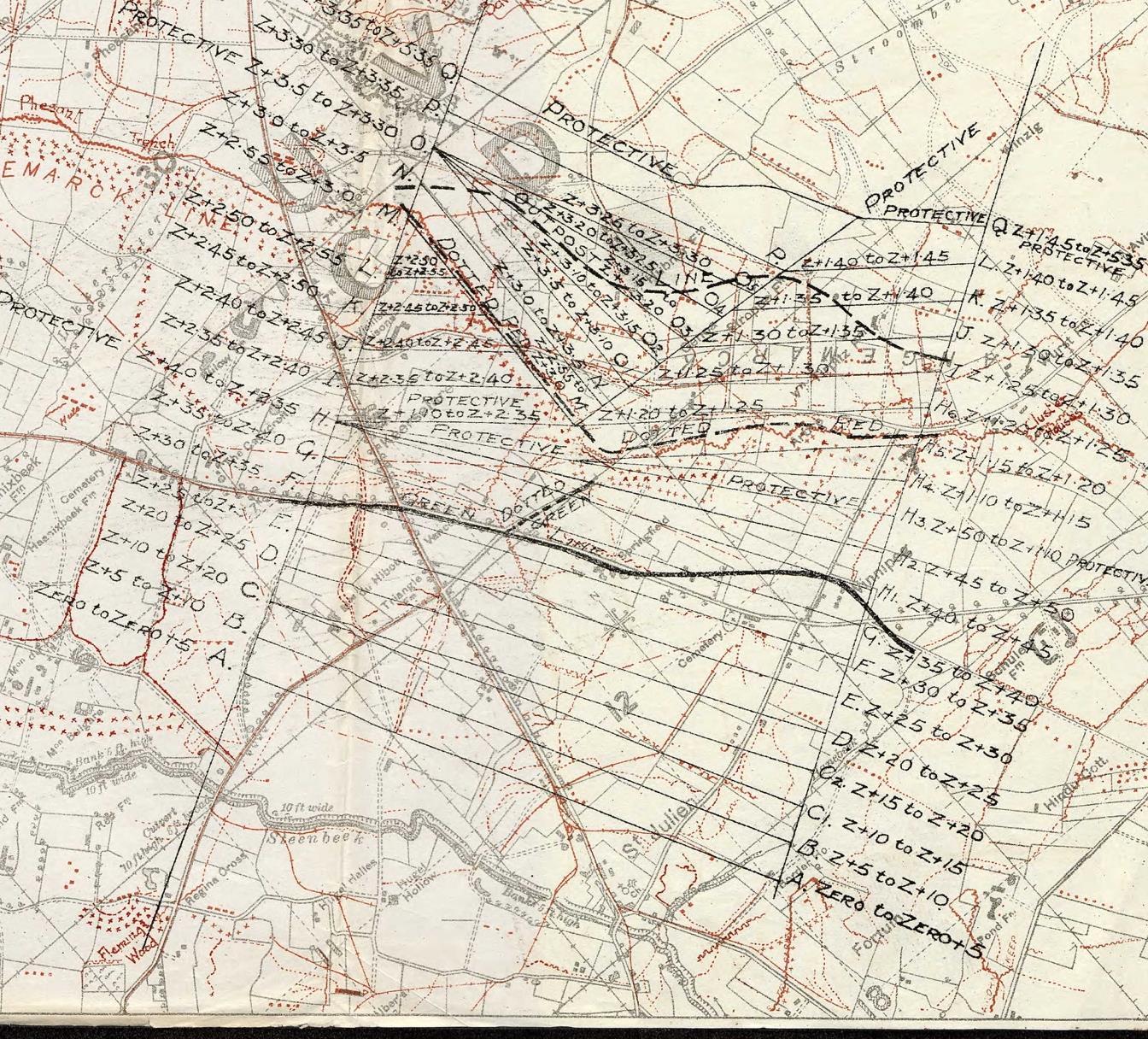
The battalion diary provides a narrative of the action during which Claude was killed:
The attack started promptly at 4.45 am, our men advancing behind a steady artillery barrage. Little opposition [was encountered], beyond slight rifle fire on our assembly positions until the first wave had advanced 200 yards east of [the River] Steenbeek when it came under effective machine gun fire from Mon du Hibou and the right flank. Reinforced by [our] rear waves, [our] advance continued until stopped about 100 yards south of a line through Mon du Hibou and Triangle Farm by deadly machine gun and rifle fire. Protected by strong concrete shelters the enemy maintained their fire while our barrage passed over
17. the ‘93’ and their stories 249
them. Most of the twelve Company officers became casualties in attempts to get forward. We settled down to hold the ground gained on a line C.5.d.9.1 to C.12.a.4.9 [i.e. from a position immediately south west of Mon du Hibou to directly south of Triangle Farm.] Our attacks on our right and immediate left [were] equally held up. … The enemy barrage fell after the attacking waves crossed [the River] Steenbeek. It was directed with particular severity against Alberta Farm, cutting communication for several hours.522
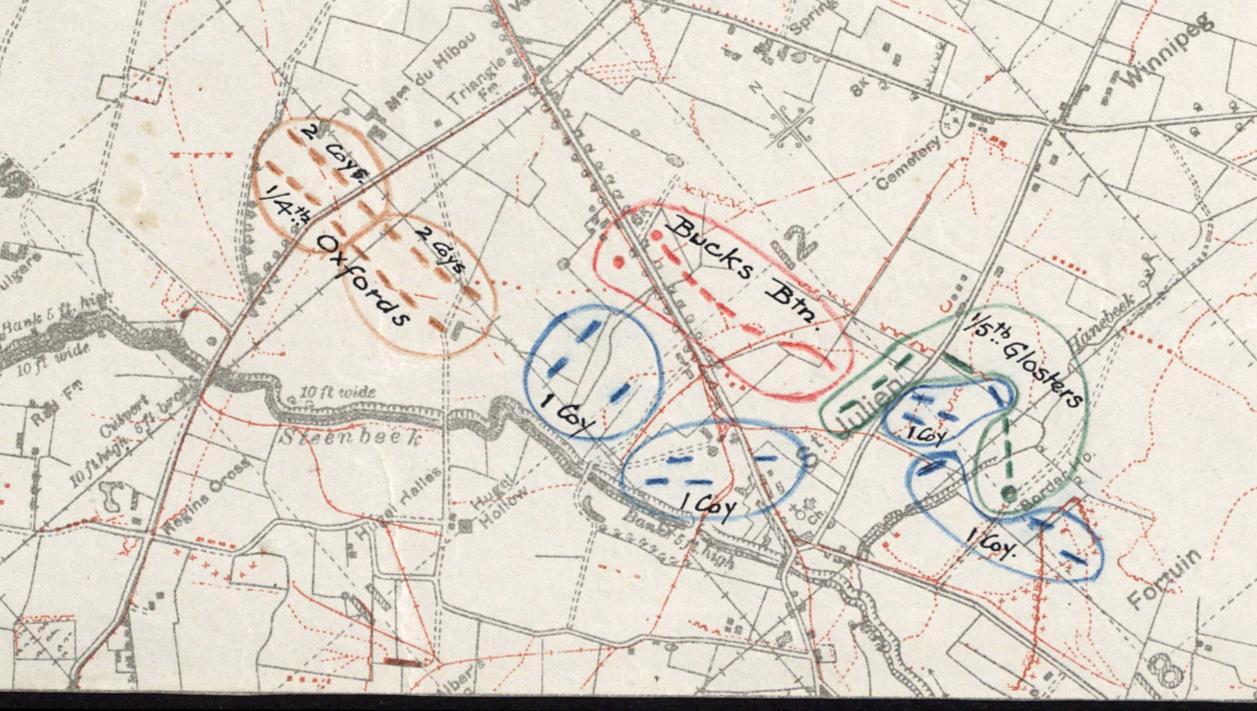
By the evening of 16 August, no further progress had been made, the battalion diarist adopting a rather forlorn tone:
17 August. We remained as on 16 August holding a line of shell holes. [There were] fresh losses from enemy sniping. Shelling was light east of [the River] Steenbeek but heavy at times on the stream west of it and on Alberta Farm and the track to it. The relieving battalion 1/7th Worcesters was in position shortly after midnight. … [Our battalion, having been relieved], assembled at Reigersberg Camp and moved at sunrise to Dambre Camp. Casualties [included] … 2nd Lieut C H Bowman.523
Map showing the positions of 145th Brigade by the early morning of 17 August. Claude’s unit is shown on the left. His body was lost, and most likely lies in the vicinity of the brown circles shown here.
522 TNA WO 95 2674 1. The attack was made less effective because the tanks were not able to operate, the ground proving impassable.
523 TNA WO 95 2674 1
17. the ‘93’ and their stories 250
The outcome of the attack was that the line had been advanced by Claude’s unit no more than 500 yards. Upon learning this, the 48th Division pronounced:
It is not intended at present to advance our line beyond the Outpost Line (dotted Blue Line)524 . 524 TNA WO 95 2746 1 3. 49th Division Order No. 20
17. the ‘93’ and their stories 251
Buckworth, 2nd Lt Alan Benjamin 16 August 1917, Zonnebeke SPS 1913 1915
3rd Bn. Royal Inniskilling Fusiliers, attached 8th (Service) Bn. Royal Inniskilling Fusiliers Tyne Cot Cemetery IX.F.1
Grave epitaph: Sleep On Beloved Until The Day Breaks And Shadows Flee Away Age 19
Alan was the only son of Ernest Buckworth and his wife, Bertha. He attended SPS from 1913 to 1915, during which time The Pauline records that he represented the school in cricket and rugby, though without any elucidation as to the extent of his prowess.525 It seems as though Alan joined up immediately upon leaving school, and at some point in 1915 he was gazetted as a 2nd Lieutenant in the Royal Inniskilling Fusiliers. His details recorded by the Commonwealth War Graves Commission present him as a soldier in 3rd (Reserve) Battalion Royal Inniskilling Fusiliers, but since this battalion did not leave England it follows that Alan was at some point transferred to another unit. Although it seems that no formal record exists as to which unit Alan was transferred, his burial in Tyne Cot Cemetery was part of the concentration of graves process in the aftermath of the war and the location of his original grave is thus recorded with some precision a short distance to the east of Frezenburg.526 On 16 August the sector in which Alan fell was held by 8th (Service) battalion Royal Inniskilling Fusiliers (48th Brigade, 16 Division). His death is recorded by in the diary of that unit, confirming that he was attached to the 8th (Service) battalion at that time.
Casualty numbers for August, listed in the 8th (Service) battalion Royal Inniskilling Fusiliers’ diary. Note that in that month alone the unit lost roughly 50 percent of its soldiers, including 2nd Lieutenant Buckworth.527
525 See The Pauline, respectively 1914 32 210 July 1914 p 115; 33 216 March 1915 p 39 526 Map reference 28.D.25.d.8.9, Concentration of Graves Exhumation and Reburials documentation. Tyne Cot British Cemetery 527 TNA WO 95 1977 3. The battalion was so reduced in size that from 23 August 1917 it ceased to exist and joined with 7th (Service) battalion Royal Inniskilling Fusiliers.
17. the ‘93’ and their stories 252
The 8th (Service) battalion Inniskilling Fusiliers had moved into the sector of line near Frezenburg on 4 August and endured a challenging time before their relief on 8 August, as recorded by the battalion diarist:
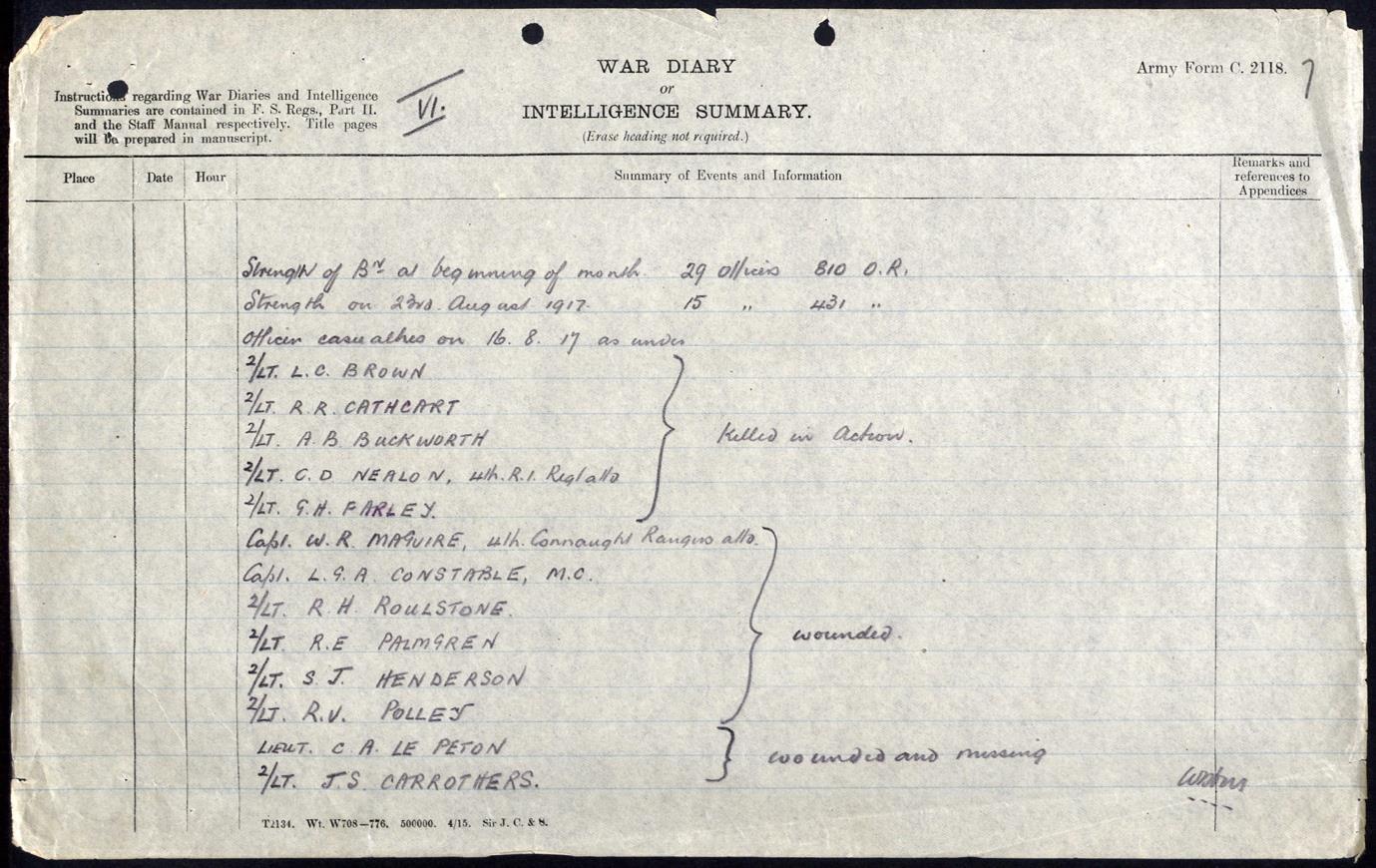
6 Aug. Enemy shelled our positions continuously throughout the day. Square Farm particularly receiving much attention. Enemy snipers were very active and all movement by daylight was impossible. Line consisted of linked shell holes and was in very wet condition. Enemy aircraft active ours very inactive.
7 August. Holding front line enemy shelled our positions heavily during the day with 4.2s, 5.9s and larger calibres. Weather conditions still very bad. … The troops were in a much exhausted condition on arrival [in the early hours of 8 August in bivouacs at Vlamertinge no. 3 area 28. H.17.a.0.9] due to the strain of holding a rough and very wet line where shelters did not exist for two days under very severe weather conditions and under continuous enemy shellfire.528
On 14 August the battalion received their Operation Orders for the forthcoming attack: The attack will be made in two bounds first bound to the Green Line, second to the dotted Red Line. 49th Bde (plus one battalion) will attack on the left left; 48th on the right [of 16th Divisional sector.] The Divisional Artillery will form a creeping barrage covering the advance of the infantry. At Zero Hour [i.e. 4.45 am] the barrage will be put down 300 yards in
17. the ‘93’ and their stories 253
advance of our present line. … The first lift will take place as Zero plus 5 minutes, and it will then proceed forward at the rate of 100 yards in 5 minutes. During the 20 minutes pause on the Green Line a protective barrage will be maintained 200 yards in advance of the infantry. After the capture of the Dotted Red Line a standing barrage will be established 300 yards in advance of it for a period of one hour, after which it will cease unless recalled by the SOS signal.529
The battalion thus moved back up into the front line in the vicinity of Frezenburg.
Map showing the disposition of units in 16th Division, 16 18 August.530
529
TNA WO 95 1977 3 Operation Orders No. 4, 14 August 1917 by Lieut Col K C Weldon Commanding Royal Irish Fusiliers
530 TNA WO 95 1973 1 6
17. the ‘93’ and their stories 254
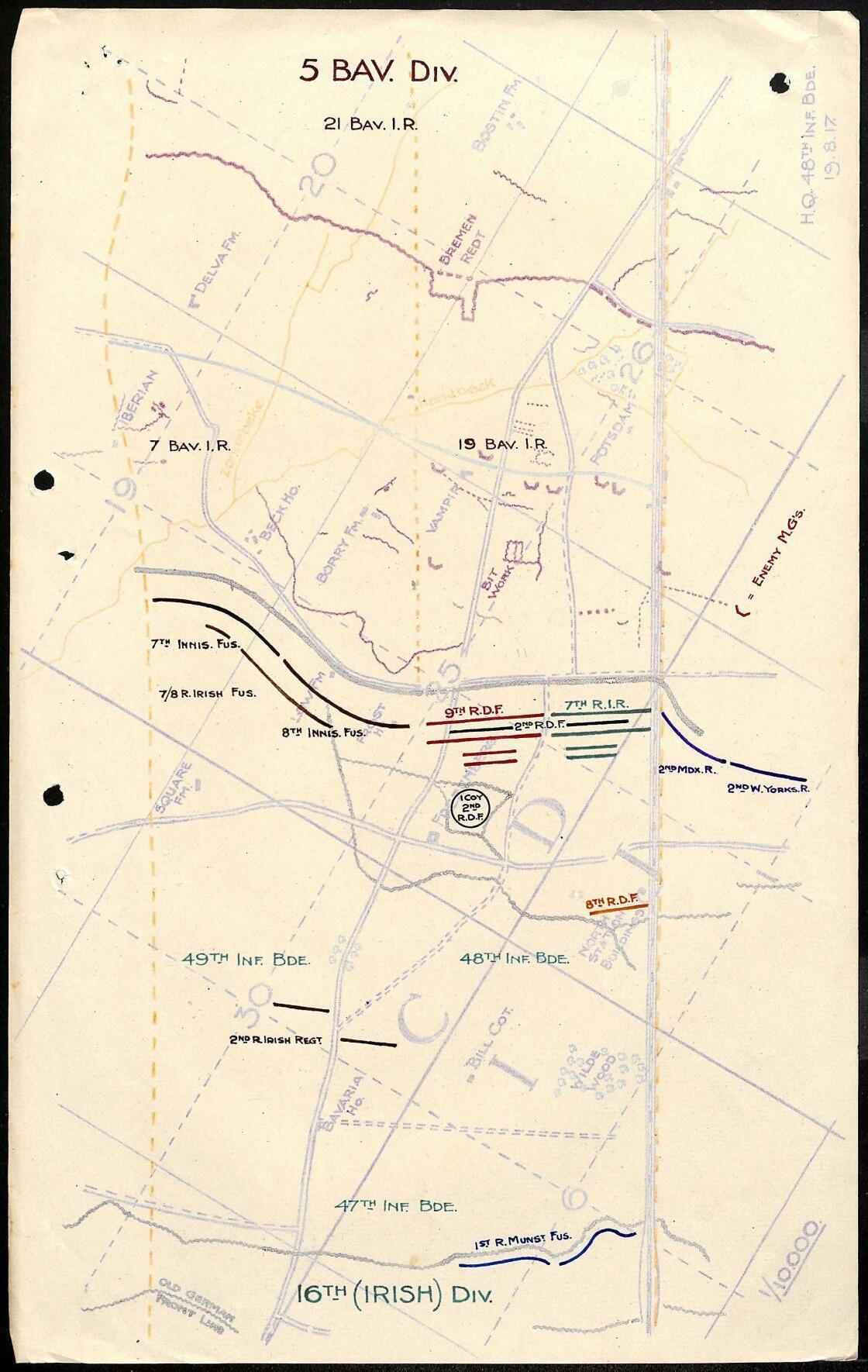
6.17 am: Just heard from 16th Division ‘G’ that Green Line is completely in our hands infantry advancing in good order enemy barrage light our barrage very good.532
© Crown Copyright
There are indications that the Green Line was reached in places but by 10 am all units in 49th Brigade were back in the line from which they had started. As the XIX Corps diarist forlornly recorded: 531 TNA WO 95 960 2 532 TNA 19 WO 95 960 3, Operations Report 16 August 1917 G851/9
17. the ‘93’ and their stories 256
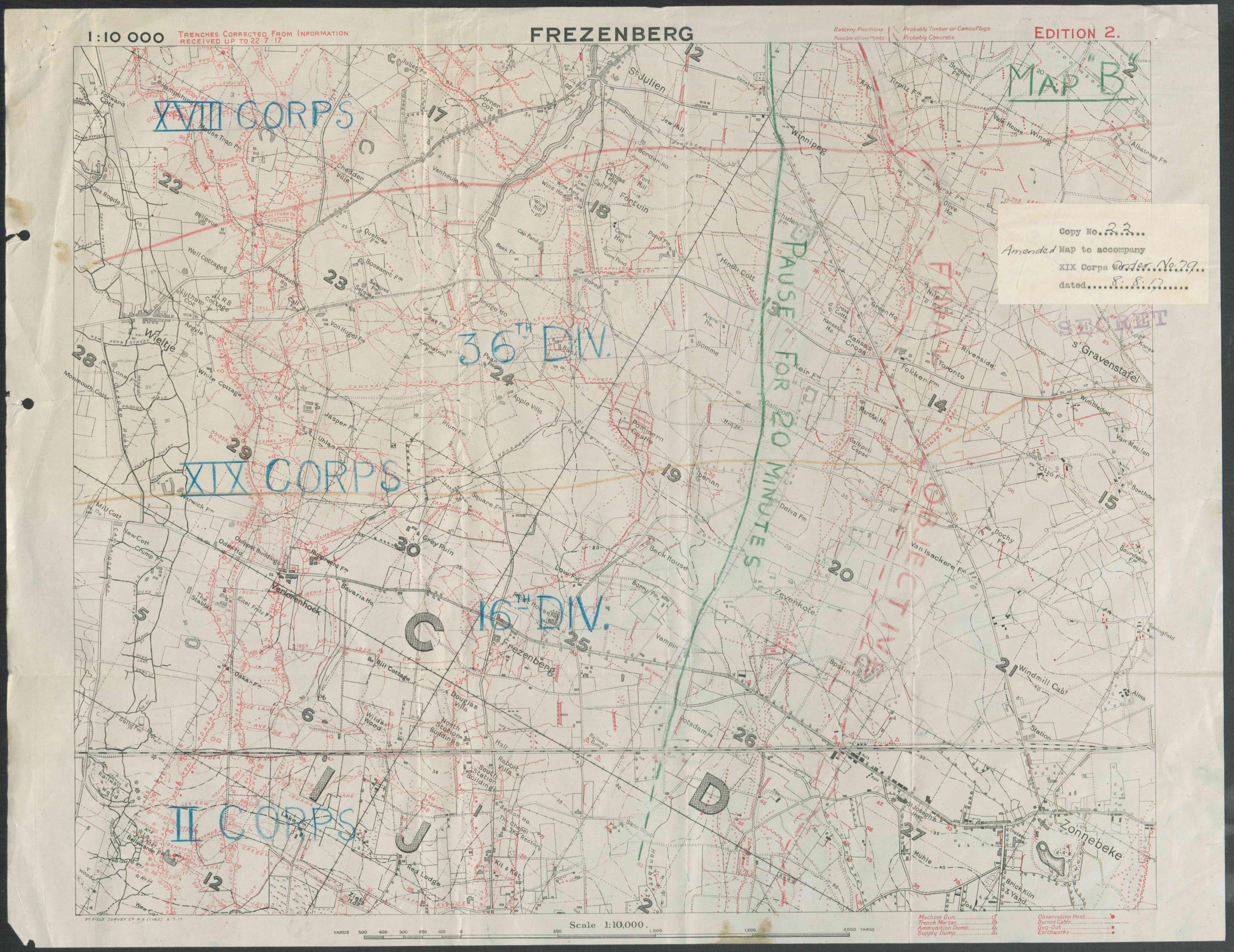
18 August. 8.35 pm … our line follows the Black Line as held before operations on 16 August.533
The location of Alan’s original grave is some 200 yards short of the Green Line. Whether he had advanced as far as the Green Line and was killed while retreating or whether he was killed before reaching that objective, it is impossible to know. Having succumbed to either machine gun fire or shell fire, it seems that his body was hastily buried in either a shell hole or otherwise disturbed ground as the retreat took place and that a hastily fashioned cross was erected above it.534 His body was discovered during the clearing of the battlefields after the war and reburied in Tyne Cot Cemetery. 533 TNA WO 95 960 1 534 Concentration of Graves (Exhumation and Reburials), Tyne Cot British Cemetery
17. the ‘93’ and their stories 257

Rinder, 2nd Lt Charles Henry Bonner 16 August 1917, Hollebeke SPS 1911 1913
1/7th Bn. London Regiment Ypres (Menin Gate) Memorial Panes 52 to 54 Age 20
Charles was born on 17 September 1876. He was the son of Mrs Rinder of Earls Court. After leaving St Paul’s in December 1913 he went into the offices of the British Oil and Cake Mills Ltd. He joined the army in January 1915.
At the time of his death Charles was serving in 1/7th (City of London) battalion (140th Brigade in (2nd London) Division. The battalion had spent 1 8 August 1917 based at Kenora Camp, near Westoutre, undertaking training. On 8 August it moved to Ridgewood, southwest of Voormezeele, resident in bivouvacs and tents. On 11 August the unit diary recorded that:
[An] enemy plane again [flew] over [Ridgewood] during the night but caused no damage. Enemy also fired a few shells from long range gun in vicinity of camp one actually falling and exploding between two tents but doing no damage. Working parties at night under OC 518th Field Company RE.535
The following day ‘the battalion provided the usual working parties at night’.536 On 13 August the unit was relieved and proceeded back to Kenora Camp, the men enjoying baths at Westoutre on 14 August before moving on 15 August to Longueness, near St Omer. On the day that Charles is recorded by the Commonwealth War Graves material as having been killed the battalion is described as experiencing ‘training under Company arrangements’. 537 No casualties are recorded. The record of events as described in 1/7th battalion diary thus throws no light on the circumstances of Charles’ death.
The most likely scenario is that Charles was attached to 518th Field Company at the time of his death, and that his death occurred in the period 12 13 August, it only being reported at a later time. This Company was undertaking work in the Forward Area now occupied by 41st Division (i.e. that section of front that ran from Klein Zillebeke in the north to the vicinity of Hollebeke in the south) and it seems that Charles must have been killed while employed in this activity. The fact that his body was not found suggests that he was perhaps hit by a shell
535
536
TNA WO 95 2730 4 1
TNA WO 95 2730 4 1. An entry for 12 August in 140th Brigade diary states that on that day ‘1/7th bn London Regt remained at Ridge Wood for work under C. E. [i.e. Chief Engineer] Xth Corps.’ TNA WO 95 2728 537 TNA WO 95 2730 4 1
17. the ‘93’ and their stories 258
or was otherwise wounded and separated from the Company. He is commemorated on the Ypres (Menin Gate) Memorial.
Maps showing the Divisional sector in which 518th Field Company was working at the time of Charles’ death.538 Ridgewood is shown on the far left in the top map.

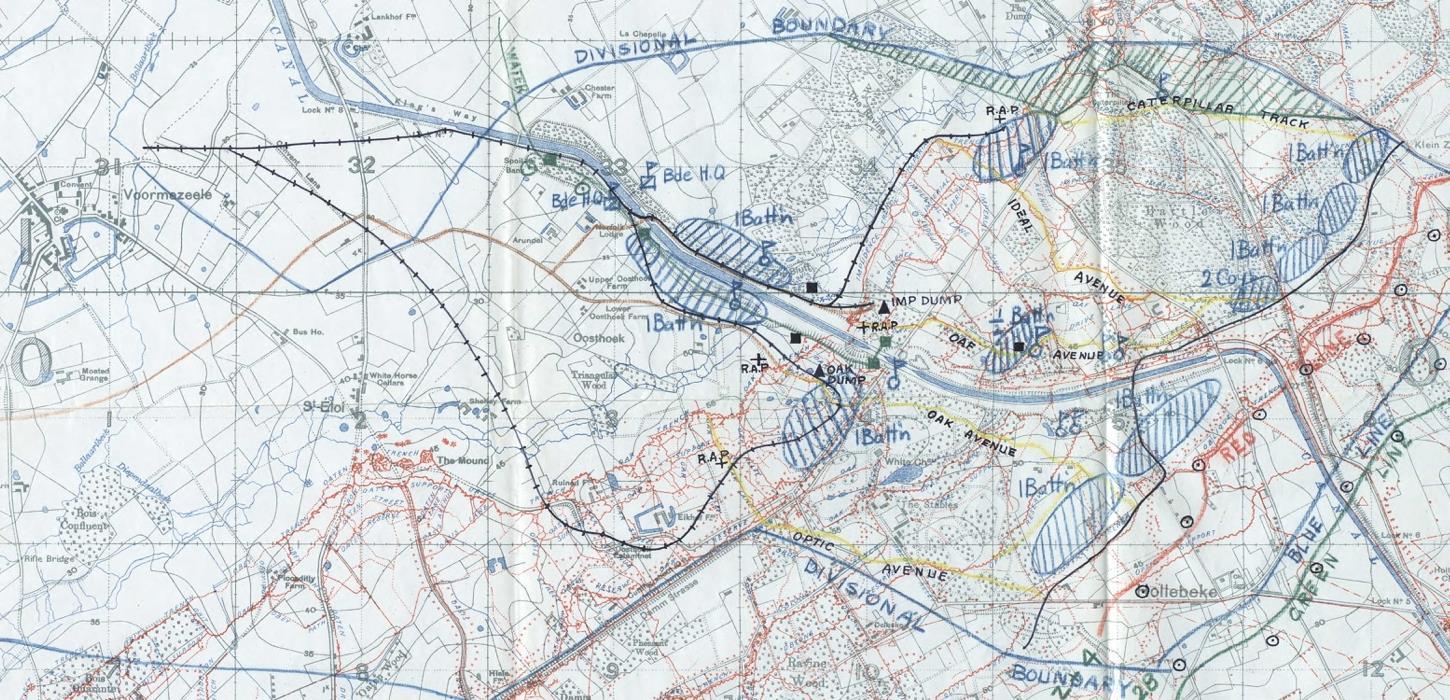
538 The first is in TNA WO 95 2703 1 6; the second is in TNA WO 95 2617 1 2
17. the ‘93’ and their stories 259
White, Captain Arthur Brian 17 August 1917, Polygon Wood SPS 1901 1904
1/5th Bn. London Regiment (London Rifle Brigade), C Company Ypres (Menin Gate) Memorial Panel 52 and 54 Age 29
Arthur was the son of William White and his wife Fanny. Upon leaving SPS in 1904 Arthur proceeded to the International College, Geneva. He served his articles with a firm of chartered accountants, and after passing the final examination first in the London list, he went into the office of Messrs. Price, Waterhouse & Co. Arthur joined the London Rifle Brigade in 1906, and took a great interest in rifle shooting and the battalion school of arms, winning many prizes for shooting at Bisley and in the battalion. On the outbreak of war he went into training with, a battalion of the London Regiment, and went out to France as sergeant on 4 November 1914. He received his commission on 7 February, 1915, was wounded twice, and was mentioned in dispatches in April 1917.539
In August 1917 1/5th battalion London Rifle Brigade was a unit in 169th Brigade, 56th (London) Division, detailed to play a part in a renewed attempt to fulfil General Gough’s unflinching ambition to secure those objectives that had eluded him on 31 July.540 On 12 August 56th Division received orders that it was to capture part of the Green Line, a specified objective shown by that means on the operation maps.541 The section of Green Line that 1/5th battalion LRB was expected to take ran north south through the centre of Polygon Wood, about a mile distant from the British frontline trenches close to the west of Glencourse Wood from which the 1/5th LRB would begin their attack at 4.45 am on 16 August.
The consolidation and defence of the Posts at Black Watch Cormer and those along the Green Line to the north are of the utmost importance as the enemy is known to keep 2
539 One of these wounds is described as a ‘gun shot wound to the left wrist’ for which Arthur was treated in hospital 8 12 May 1915. TNA MH 106/1658; the other is listed as a ‘sprained ankle’, treatment for which lasted nine days 20 29 November, 1915. TNA MH 106/1661. On both occasions Arthur was hospitalised in Queen Alexandra’s Military Hospital at Millbank, London.
540 Gough was Commanding Officer of Fifth Army. 541 TNA WO 95 2958 2 56th Division Order. Units in 169th Bde were given the following task: a) the capture and consolidation of the Green Line b) to strengthen the defence of the easterly portion of the defensive flank by constructing strong points at: J.15.a.4.at No. 14; J.15.a.9..7 No 15; J.15.b.0.9 No 16 ( Black Watch Corner)
17. the ‘93’ and their stories 260
companies ready for immediate counter attack in the Polygone de Zonnebeke. In view of the above, on reaching the Green Line between Black Watch Corner and our Left Boundary, the 2nd Londons and LRB will push forward patrols to establish small Posts 300 yards beyond the Green Line to cover consolidation.542
On 11 August 1/5th battalion LRB moved by train from Abeele to Ouderdom, where they billeted in Palace Camp. The following evening the battalion moved up to their forward billets, A and B Companies going to the substantial dugout complex at Halfway House, some 700 yards north of Zillebeke, and C (Arthur’s unit) and D Companies to Chateau Segard Area, Camp No. 1, north east of Dickebusch Lake. During the night of 13 August Arthur will have gained little sleep, the battalion diaries recording that ‘the Germans put over a number of gas shells which interfered with our rest.’543 The following evening the battalion moved up into the front line to the west of Glencourse Wood. At 1.45 am on 16 August the battalion formed up in its position of assembly for attack at Zero Hour, 4.45 am.
Diagram of the extensive dugout system at Halfway House.544
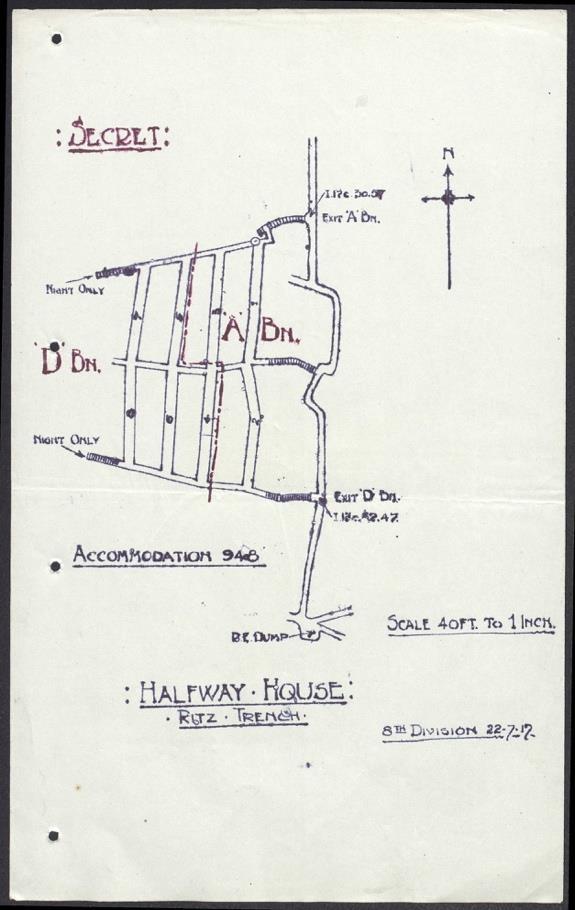
542
TNA WO 95 2958 2 169th Infantry Brigade Order No. 111, 14 August 543 TNA WO 95 2962 4 6 544 TNA WO 95 1677 1 4
17. the ‘93’ and their stories 261
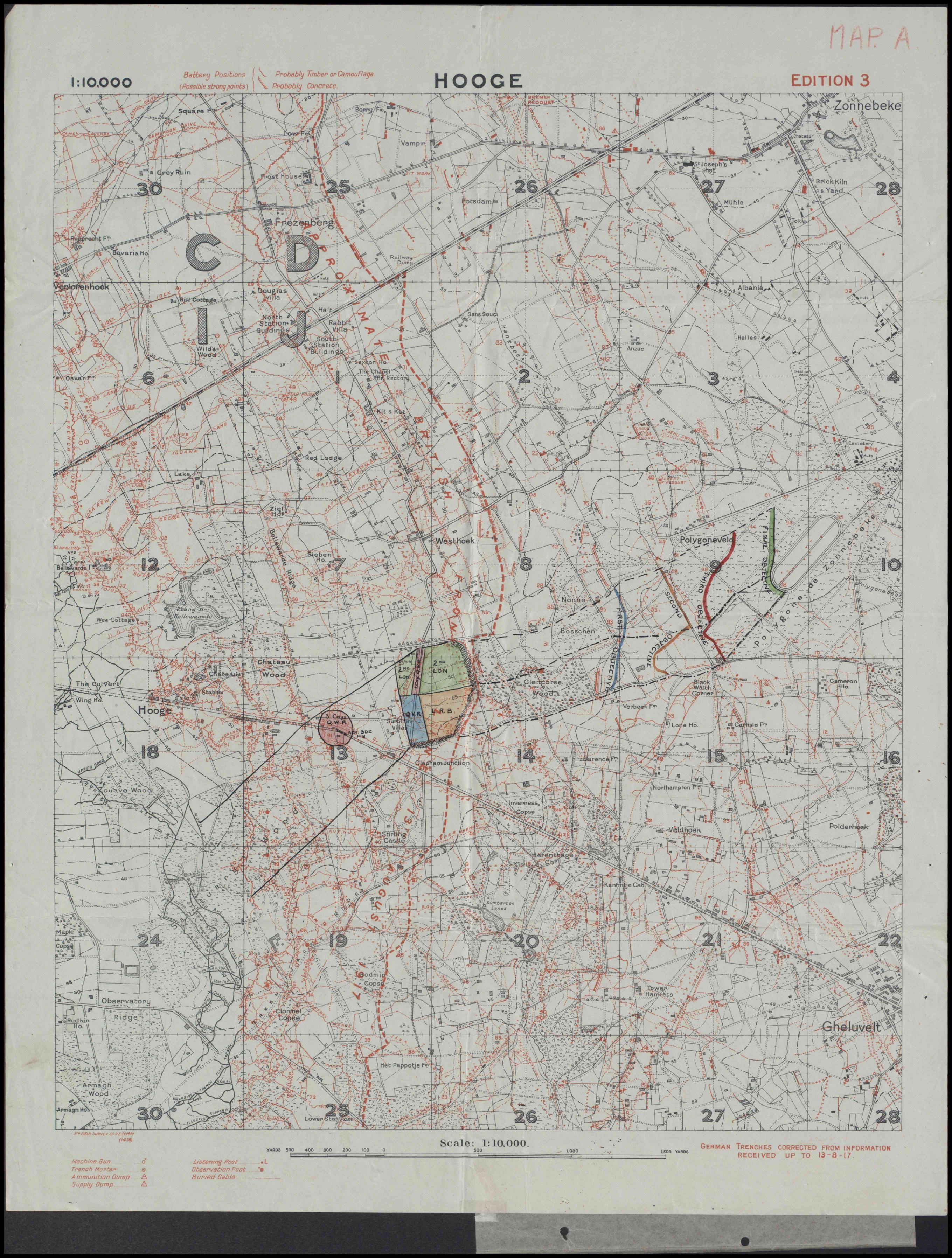
As was now usual in the British attacks in the summer of 1917, the infantry assault was accompanied by a creeping barrage:
The attack will be covered by an intense creeping Artillery barrage …. The creeping barrage will start about 200 yards in front of our present line and move forward at the rate of 100 yards in 5 minutes. It is most important that the barrage be very closely followed by the leading wave. …..547
In the first instance the advance appears to have proceeded well, though the battalion diary records in some detail an increasingly bloody, and ultimately seemingly fruitless, assault:

At 4.45 am the battalion assaulted the German positions, meeting with very little opposition until the eastern edge of Glencourse Wood (J.8.d.6.0 J.14.b.8.6) was reached. Part of A Company succeeded in reaching the final objective, the edge of the race course in the Polygon de Zonnebeke (J.9.d.7.9 to J.9.d.80.75) as contact aeroplanes reported flares lit and men digging in, but none of this party rejoined the battalion. The remainder of the battalion after being held up by machine guns firing from the dugouts on the eastern edge of Nonne Boshcen (J.8.d.8.5 to J.8.d.95.15) and the neighbourhood of J.9.c.2.4 was counterattacked from the Polygon and the open ground to the south and driven back owing to the battalion (1/4th battalion London Regiment) which had been ordered to advance on our right and
17. the ‘93’ and their stories 263
secure our right flank failing to do so.548 The battalion mixed up with other units of the brigade fell back to a line a short distance inside the western edge of Glencourse Wood but finally German counterattacks drove the brigade back into the original English front line. … During the night the front line was taken over by the 1st Queen Victoria Rifles and 1st Queens Westminster Rifles and the battalion withdrew to Halfway House.
In Appendix 1 the diary also recorded:
A B White wounded and missing; believed killed, 16 August.549
Alternative evidence indicates that the passage through Glencourse Wood met with rather more resistance that the 1/5th battalion diary suggests, especially because of a line of concrete dugouts established in the vicinity by the enemy:
[The hour of] 4.45 am was an ideal time: just dark enough to conceal our troops while ‘going over the top’ and then lightening in time to allow them to see their way through the wood. … The fallen trees in Glencourse Wood gave little trouble, these being easily stepped over. … Our barrage was most excellent. The creep of 100 yards in 5 minutes was perfectly suitable for the first 300 yards, owing to very little opposition being met with. After this, several detached posts were encountered which delayed our progress and thus caused the barrage rather to run away from the troops. … For the first 300 yards [our advance met with practically no opposition.] At J.14.b.15.80, along a sunken road, is a system of concrete dug outs containing machine guns. Some of these fire up and down the road, and others towards the west. This is a strong and troublesome position and should be especially dealt with. At least 100 men garrisoned it … About a dozen small shelters were encountered chiefly along the south side of Glencourse Wood these were probably covered shell holes. The enemy in these showed fight when approached, but were all killed. … At J.14.b.4.6 there is a double concrete dugout, camouflaged with undergrowth. … [This was overcome], but a more formidable obstacle was encountered at J.14.b.8.7 where the enemy work has the appearance of a high embankment 20 to 30 feet hight. An intense fire was opened from it with machine guns, rifles and bombs. After being engaged by our troops, the enemy took to mined shafts and held out strongly, causing several casualties. But they eventually came out and were all killed (said to be at least 40.) In spite of these few episodes, the advance was not seriously delayed …. [but] when our troops reached the enclosure (surrounded by a hedge) at J.15.a.5.9 bullets came very thick from Black Watch Corner and from the direction of Northampton Farm and caused many casualties. The enemy now appeared advancing in waves from the southern portion of Polygone Wood, their advance being covered by
548 Many men of this unit were cut down by a German machine gun positioned in the north west corner of Inverness Copse.
549 TNA WO 95 2962 4 6
17. the ‘93’ and their stories 264
machine guns firing from the flanks. Our leading wave was caught and demolished by this attack in the Polygone Wood itself and I am unable to make any report on its action during the day as no survivor has returned.550
Close study of the disposition maps show that Arthur’s unit was probably able to pass successfully just to the south of the line of German concrete shelters referenced above and it is thus not improbable that he advanced as far as the western edge of Polygon Wood and that this is the area in which he fell.
A Report by the C.O 169th Brigade states that:
The second wave was checked on the line of the west face of Polygoneveld by heavy fire from both flanks and from the front, and a counter attack developed about 10 minutes later. This was made in very considerable strength and succeeded in forcing back our waves, which had had no opportunity of reorganising or consolidating. The enemy’s progress was checked at J.14.b.1.4 and J.14.b.1.6 by supporting troops, but a further hostile attack from Inverness Copse finally drove back our posts from these positions and by 6 pm the Brigade was back in its original. [The two leading battalions] had suffered very heavy casualties and were not capable of further effort.551
550
TNA WO 95 2958 2 Information Obtained by 169th Infantry Brigade After the Fighting of 16 August, by E. S. Coke, Brig. Gen Commanding 169th Infantry Brigade, 18 August 1917 551
TNA WO 2958 2 2 Account of Operations of 16 August by Brigadier General Commanding 169th Infantry Bde, 20 August. A key reason why the attack failed was because it encountered the new German system of defence Defence in Depth. A fascinating captured German document revealing details of how this system worked is hosted in TNA WO 95 2958 2.
17. the ‘93’ and their stories 265
Hyman, 2nd Lt Robert Leslie 22 August 1917, Fitzclarence Farm

6th (Service) battalion Duke of Cornwall’s Light Infantry Tyne Cot Memorial Panel 80 to 82 SPS 1906 1906 Age 25
Robert Leslie Hyman552
Robert was the second son of Mr and Mrs Aubrey Hyman. The Pauline is silent as to his SPS career, no doubt because he was a member of the school community for only one year. As to Robert’s career upon leaving SPS and signing up for service with the 6th battalion Duke of Cornwall’s Light Infantry, the sources are similarly silent. Robert arrived in France with 6th (Service) Bn. Duke of Cornwall’s Light Infantry on 22 September 1916. He had thus served with that unit for almost a year at the time of his death. In August 1917 the 6th (Service) Bn. D.C.L.I was a unit in 43rd Brigade, 14th (Light) Division.
Having spent the month of July training at Bus Le Artois and latterly at Corunna Camp near Westoutre, the battalion moved to billets in and around Hazewinde where it continued training for the first two weeks of August. On 14th August:
A large carrying party comprising of 16 officers and 500 Other Ranks under the command of Major C F Miller paraded at 12 noon in Marching Order and proceeded to Castre Station, where they embussed at 1 pm and proceeded to the Infantry Barracks, Ypres.553
On 17 August orders were received for the remainder of the battalion to proceed to Ouderdom via Reninghelst, from where it moved to camp near Dickebusch (H.33.a.6.4),
552 © Image reproduced by courtesy of the Trustees of the Honourable Artillery Company, Armoury House, City Road, London EC1Y 2BQ 553 TNA WO 95 1902 2
17. the ‘93’ and their stories 266
arriving in that place at 5pm. At this point the carrying party had rejoined and the battalion awaited its orders. These were received on 20 August and detailed that 6th D.C.L.I:
Will attack on the left [of 43rd Brigade sector on 22 August] with the object of capturing Jargon Trench, the trench system between Jargon [Trench] and Fitzclarence Farm and establishing a line taking in Fitzclarence Farm.554
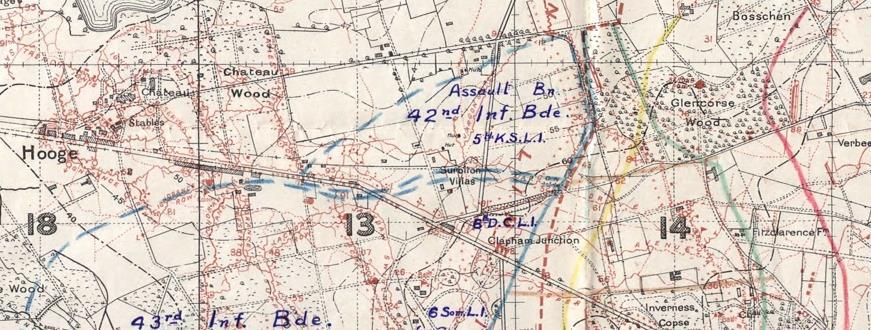
As usual, the attack was to take place under a creeping artillery barrage beginning at Zero Hour (7 am). The objectives described in the attack Order were manifested as coloured lines on the attack maps: the Blue Line shows the general line from which the attack started; the Yellow Line shows the line upon which the barrage would first come down before creeping forward in lifts of 100 yards every four minutes; the Green Line shows the final objective; the Red Line shows the line upon which the protective barrage was delivered.
Map showing the starting position (Blue Line near Clapham Junction) of 6th D.C.L.I and its final objective (Green Line running between Glencourse Wood and Fitzclarence Farm.)
Jargon Trench is shown in brown running from south of Glencourse Wood, skirting to the east of the ‘14’ and then running south to the north of Inverness Copse.555
Map showing the stages of the creeping barrage.556 (Note that Jargon Trench is relatively clearly shown on this map.)
554
TNA WO 95 1904 1 4 555 TNA WO 95 1871 1 556 TNA WO 95 1871 1
17. the ‘93’ and their stories 267
Trench Operation Map of 10 August 1917 showing details of the area attacked by 6th (Service) battalion D.C.L.I. Dugouts are shown as solid red squares; wire is shown as a red cross. Elements shown in blue are taken from a captured German map.557
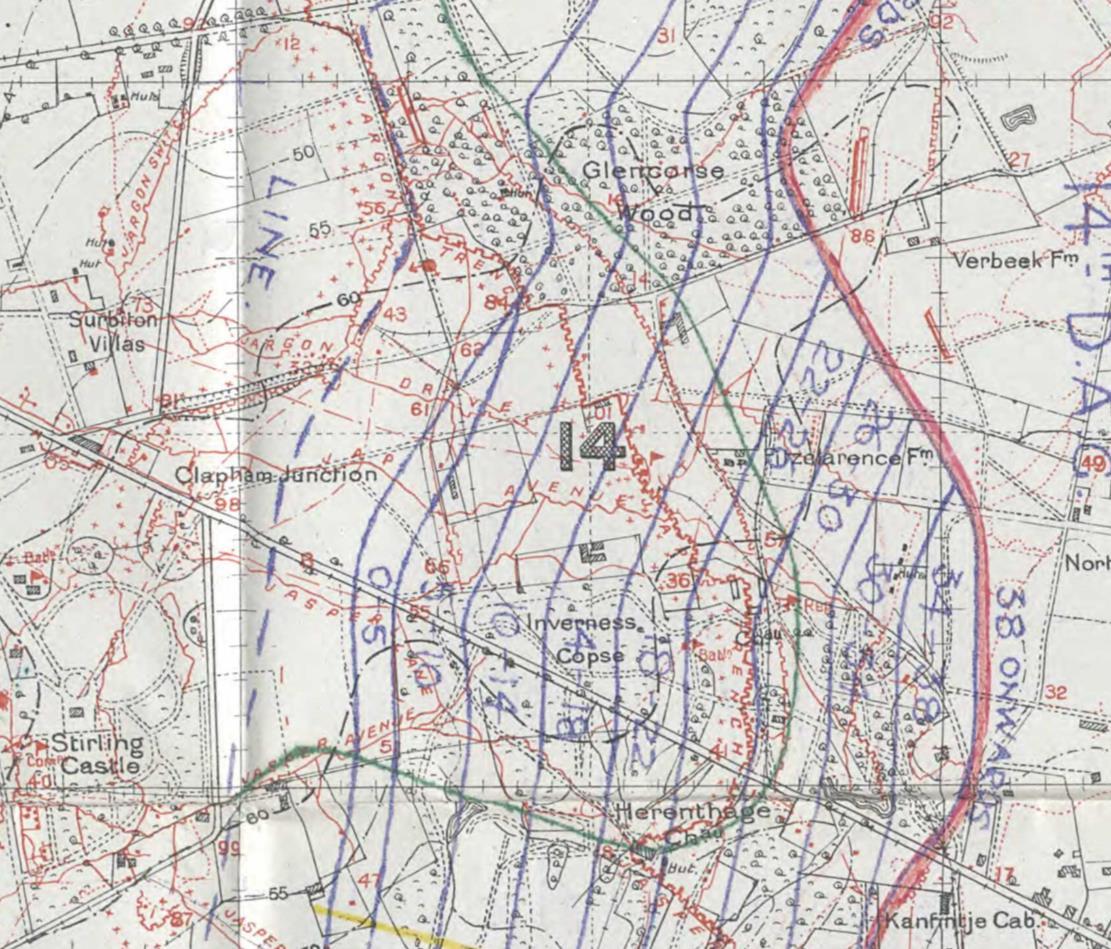
In the morning of 20 August the 6th D.C.L.I battalion paraded at 9 am in fighting order and practiced the forthcoming attack over some open ground where the different objectives had been flagged out. It departed camp at 4 pm and proceeded to the front line via the Menin Road, completing its relief of 7th battalion King’s Royal Royal Corps at 1 am on 21 August. Robert had little opportunity for any rest before the attack of the following morning, the battalion diarist noting that:
The enemy shelled our trenches and back area along the Menin Road and Sanctuary Wood very heavily with all calibre from 12 noon and through the hours of darkness. He also sent over gas shells.558

As the Companies in the unit assumed their attacking dispositions in the early hours of 22 August:
An enemy aeroplane appeared low over our line and observed the whole battalion lining up in the open behind the ridge. A certain amount of machine gun fire from the enemy aeroplane and from enemy machine guns on our left opened fire and caused some
17. the ‘93’ and their stories
confusion, but the battalion was in position by 5.30 am and men sent along singly with water to fill men’s waterbottles as far as possible.559
The appearance of the enemy aeroplane proved something of an ill omen:
At Zero Hour [7 am] the attack commenced and, when only about 50 yards from our front line, the leading wave was held up by heavy machine gun fire from both flanks J.14.a.8.4 Gun pits J.14.c.55.98 J.14.c.55.75 and Glencourse Wood from the centre. The result being that touch with the barrage was completely lost and the advance of the battalion stopped. … A tank then came out of Inverness Copse and went along the trench J.14.c.6.6 and then across to the strong point at about J.14.b.0.4. This tank performed most valuable service, and the advance was continued and the trench J.14.c.6.6 to J.14.a.6.5 occupied.560
By the end of 22 August, though some ground had been gained, the Green Line had not been reached.
Map showing the objectives and dispositions of 14th Division, as well as the line held at the end of 22 August i.e. the Black Line.561
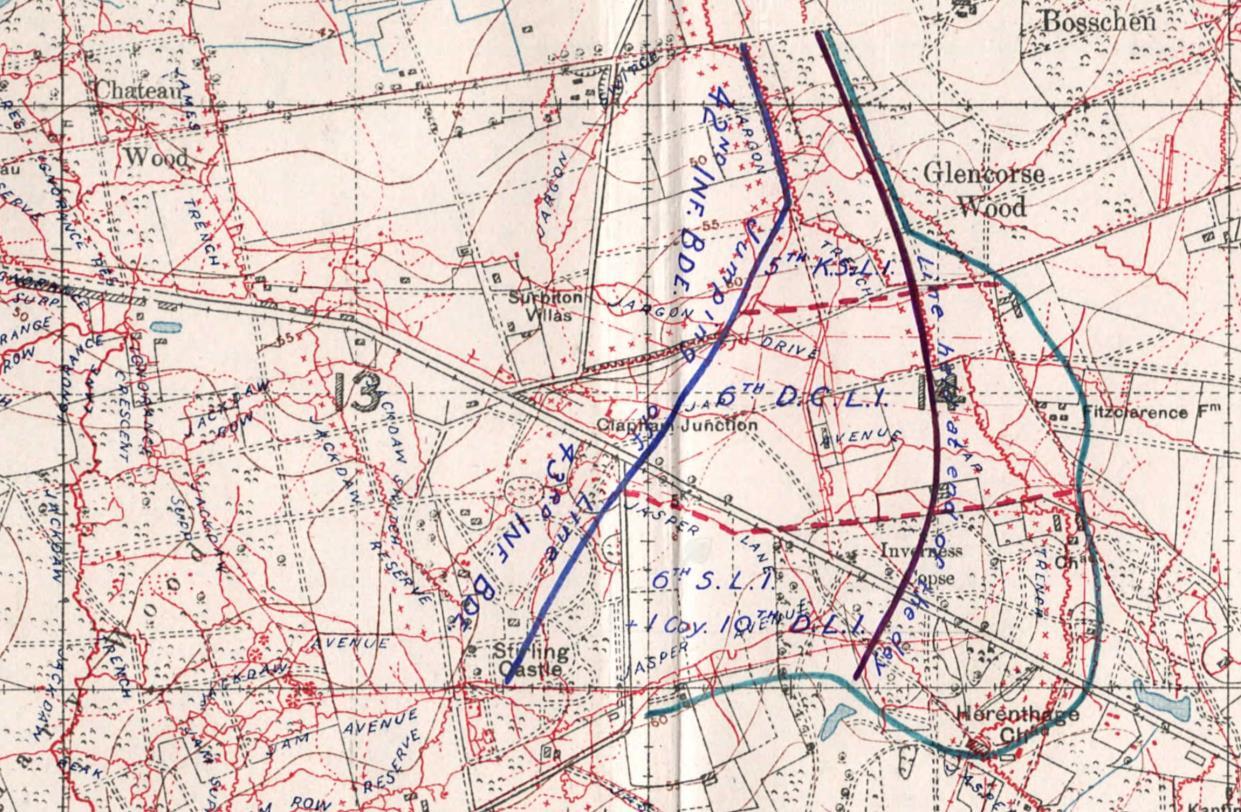
559
TNA WO 95 1908 2 Narrative of the Operations on 22 and 24 August, C O 6th DCLI, 26 August
560
TNA WO 95 1908 2 Narrative of the Operations on 22 and 24 August, C O 6th DCLI, 26 August
561
TNA WO 95 871 1
17. the ‘93’ and their stories 270
Although 6th D.C.L.I diarist gives details of the disposition of the Companies during the attack it is not known in which Company Robert was an officer. It is thus not possible to identify where he fell beyond stating that it in all probability it was in the area some five hundred yards west of Fitzclarence Farm and since Robert’s body was lost during the attack it can be assumed that that is where he lies today.
17. the ‘93’ and their stories 271
Manson, Captain Gerald Patrick MC 24 August 1917, Inverness Copse 6th (Service) Bn. Somerset Light Infantry (Adjutant) Tyne Cot Memorial Panel 41 to 42 SPS 1912 1913 Age 20
Gerald Patrick Manson562
Gerald was the second son of Mr J. Manson, Indian Public Works Department. (Gerald’s elder brother, also a Pauline, 2nd Lieutenant Charles Claude Edmonstoune Manson MC, Gurka Rifles, was killed in action in the Dardanelles on 4 December 1915.) He was educated at Clifton College and SPS. Gerald appears to have been a keen golfer, his name featuring on the First World War Roll of Honour Memorial at Fulwell Golf Club in west London. He obtained his commission in September 1914 and went to the front with the 6th (Service) battalion Somerset Light Infantry on 21 May 1915. He was wounded by heavy enemy shell fire while in the vicinity of Bellewarde Farm, near Hooge on 19 July 1915. In September he was gazetted captain. Gerald was mentioned in dispatches on 30 April and was awarded the Military Cross for an act of gallantry during fighting in Delville Wood in the Somme sector on 18 August 1916, when he was severely wounded. The citation reads:
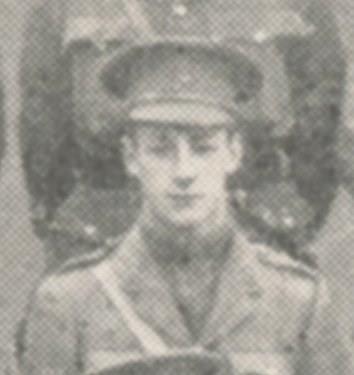
He carried out a difficult attack, capturing a strongly held trench and two machine guns. He displayed great coolness and courage and was severely wounded.563 562
© I.W.M. Lives of the First World War 563 The Pauline, 34 227 Nov 1916 p 132
17. the ‘93’ and their stories 272
Thereafter, Gerald was in England on sick leave until he rejoined his battalion at the front in March 1917, fulfilling the role of Adjutant from April (in which he assumed responsibility for composing and signing off the battalion diary each month.)
At the time of Gerald’s death 6th (Service) battalion Somerset Light Infantry was a unit in 43rd Brigade, 14th (Light) Division. In the period 6 15 August the battalion had participated in various training exercise, including bayonet fighting. In a drive to fitness, it had also undertaken a number of route marches. On 15 August the battalion marched to the Abeele area and two days later proceeded to Ouderdom, west of Ypres. In his role as Adjutant, Patrick recorded in the unit diary that the ‘accommodation [was] bad’.564 At 4.20 pm on 17 August the battalion marched to huts at Dickebusch, upon their arrival discovering that the huts allocated to their unit were already occupied. Eventually, ‘after considerable discussion the battalion finally settled into very close quarters at 7.30 pm.’565 On 20 August the unit moved up to the front line trenches south of the Menin Road, preparatory to assaulting Inverness Copse in accordance with the attack to be undertaken by the 14th (Light) Division. The 43rd Brigade Order received on that day detailed the objections of 6th battalion Somerset Light Infantry:
The 14th Division has been ordered to capture the general line Jasper Avenue Inverness Copse Herenthage Chateau Fitzclarence Wood and the western portion of Glencourse Wood. …. The 43rd Infantry Brigade have been allotted the task of capturing that portion of the Green Line from J.14.b.15.40 to and inclusive of Harenthage Chateau and to form a defensive flank facing south with its western extremity at J.19.b.9.9. …The infantry attack on Inverness Copse will be followed by four tanks for the purpose of dealing with strong points still holding out. … The 6th Somerset Light Infantry and ½ Section 43rd Machine Gun Company will attack on the right with the object of taking Herenthage Chateua and Inverness Copse and occupying the Green Line respectively south east and east of these objectives … with approximately 2 to 2&1/2 Companies. … Zero Hour will be 7 am on 22 August.566
Map showing the ‘general line’ referred to in the 43rd Brigade Order, above.567 (The Blue Line shows the general line from which the attack started; the Yellow Line shows the line on which the creeping barrage commenced; the Green Line shows the final objective; and the Red Line shows the line on which the protective barrage was put down. The brown, horizontal lines show the dividing line between battalions.)
564
565
566
567
TNA WO 95 1909 1 4
TNA WO 95 1909 1 4
TNA WO 95 1909 1 4, Appendix, 43rd Light Infantry Brigade Order No 126, 20 August
TNA WO 95 1871 1
17. the ‘93’ and their stories 273
Extracted section of the above map showing the location of 6th battalion Somerset Light Infantry on 22 August (and attached on their right 1 Company of 10th battalion Durham Light Infantry), and their objective the Green Line. Inverness Copse, Herenthage Chateau and the Menin Road are clearly shown.568

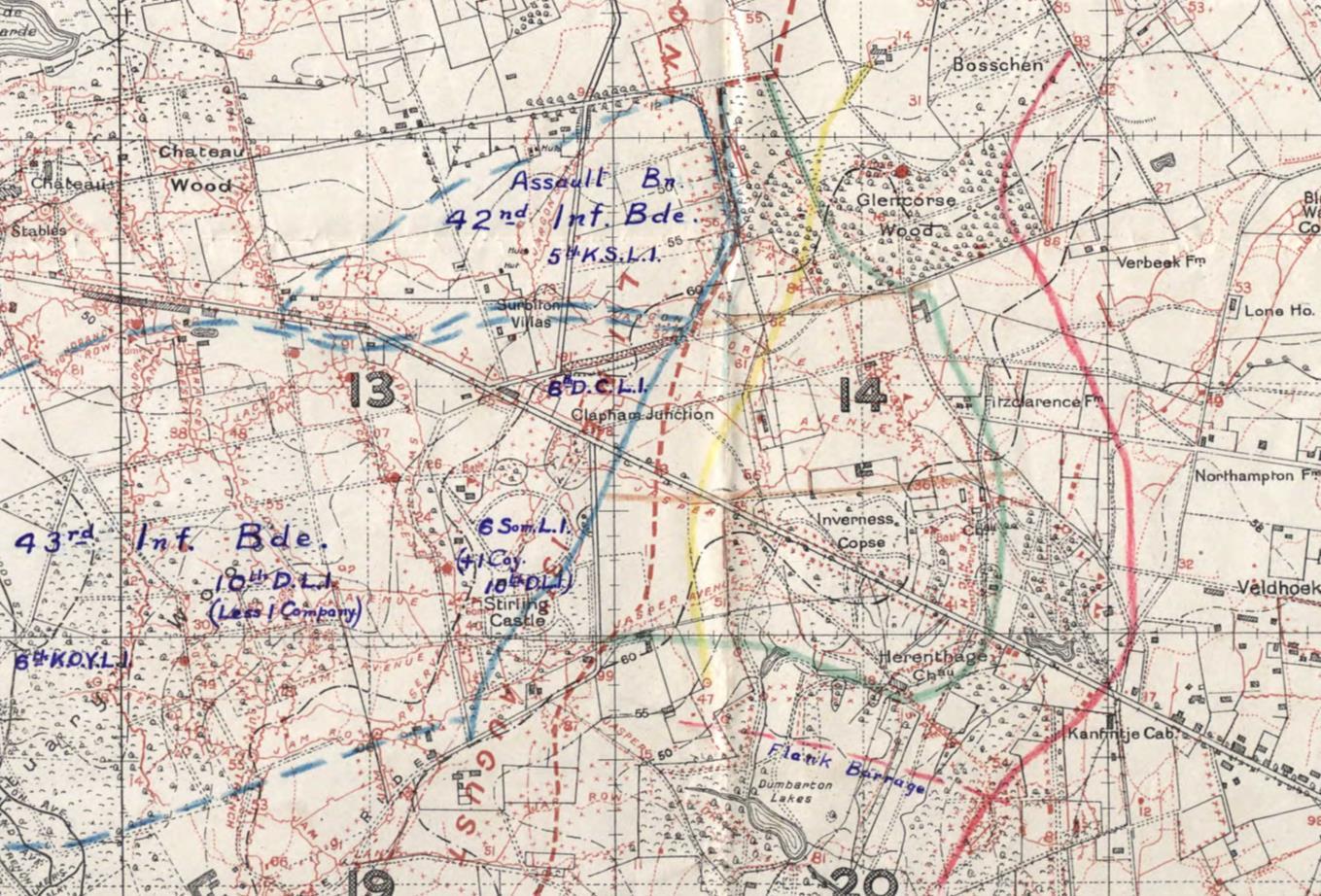
Zero Hour was 7am on 22 August. At this time a creeping artillery barrage came down on the Yellow Line. Upon leaving their position in the Blue Line, Patrick’s unit was ordered to:
17. the ‘93’ and their stories 274
Get as near to the barrage as possible, ready to follow it closely as the barrage advances. … The whole creeping barrage will move forward in lifts of 100 yards every 4 minutes, each gun on arrival at the Red Line remaining there and forming the protective barrage. … The pace of the infantry [advance] will be regulated entirely by the creeping barrage. [Infantry] will be warned to keep as close to it as possible, and on no account to delay their advance for any other factors, such as tanks.569
Barrage map, showing the incremental ‘lifts’ of the barrage as it progressed towards the Red Line, at which point a protective i.e. sustained and static barrage was to be effected.570
At 7 am on 22 August Gerald advanced from his position in front of Stirling Castle towards Inverness Copse. Despite the fact that the tanks proved ineffectual the battalion enjoyed success. Gerald’s unit: quickly reached the western edge of Inverness Copse … [and] continued to push on through Inverness Copse. After a considerable amount of fighting, and harassed by machine gun fire from the high ground in the direction of Glencourse Wood, the battalion succeeded in reaching its objective about 8 am. A considerable amount of fighting took place for the possession of Harenthage Chateau.571
569
TNA WO 95 1909 1 4 Addenda to 43rd Light Infantry Brigade Order No. 126 570
571
TNA WO 95 1909 1 4
TNA WO 95 1871 1 14th (Light) Division, Report on Operations, 18 28 August
17. the ‘93’ and their stories 275
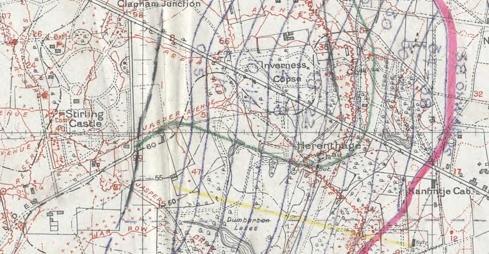
However, this success was to prove short lived. Throughout the morning of 23 August considerable hostile aerial activity was reported, particularly over the front line and Inverness Copse ‘hostile aircraft flying low over the trenches harassed our troops with machine gun fire.’572 About 4 am on 24 August an intense enemy barrage fell on Inverness Copse. These attacks meant that the relief of the 43rd Brigade (originally planned for the night of 23 24 August) had to be delayed and must have meant that Gerald was exhausted and ill prepared to deal with a full blown enemy counter attack that now materialised at 4.30 am on 24 August. The 14th (Light) Divisional Report on Operations records that at this time:
The enemy launched a strong counter attack, assisted by Flammenwerfer on the front from the south edge of Inverness Copse to the south edge of Glencourse Wood. … The enemy made fresh attacks at 7.50 am, 12.21 pm and 2 pm. [There was] a lot of confused and still fighting, [especially in Inverness Copse.] … Between 12.30 and 1 pm messages from the front were received indicating that our troops in Inverness Copse were losing ground.573
By 2 pm the 6th (Service) battalion Somerset Light Infantry, weary after three days and nights of great strain, had withdrawn from Inverness Copse towards their original line, allowing the Germans to re occupy the western edge of the Copse.
Unusually, the battalion diary does not record the names of individual officers who fell in this operation, stating only the total number of casualties (19 officers and 325 Other Ranks) over the period 21 24 August.574 The only clear referencing of the death of Gerald, whose role was that of Adjutant, appears in a note in the 43rd Light Infantry Brigade Tactical Report on Operations 22 25 August stating that on:
24 August, 10 am. O. C 6th Somerset Light Infantry reported that his Adjutant had been killed.575
Gerald’s signature at the end of the entries for in the battalion diary for July 1917, the last month he would sign off.576
572
TNA WO 95 1871 1, 43rd Light Infantry Brigade Tactical Report on Operations, 22 25 August 1917
573
574
TNA HQ WO 95 1871 1, 14th (Light) Division, Report on Operations, 18 28 August
TNA WO 95 1909 1 4
575
TNA WO 95 1904 1 4 43rd Light Infantry Brigade Tactical Report on Operations, 22 25 August.
576 TNA WO 95 1909 1 4
17. the ‘93’ and their stories 276
The fact that the Officer Commanding 6th Somersets (Major F. D. Bellew) intimates that he witnessed the death of his Adjutant suggests that Gerald was at battalion HQ when he was killed. Unfortunately the battalion Narrative of Events does not describe events of 24 August. However, pertinent details are provided in the official Regimental History, authored by Everard Wyrall. He reports that, following an intense enemy bombardment 23 24 August, the Germans attacked with:

A fresh German Division led by ‘Sturm’ troops. The two leading waves were lightly equipped, the four succeeding waves carried full arms, tools and equipment. … ‘Sturm Truppen’ infiltrated round the north of [Inverness] Copse and actually crossed the Menin Road west of the Copse. Here fortunately they bumped into Battalion HQ 6th Somersets, now situated in Jasper Avenue 70 yards west of [Inverness Copse] and were repulsed. Captain Manson, the Adjutant, fell at the junction of the Menin Road and Inverness Copse, though not till the enemy had been driven back and his comrades in the wood made safe from being surrounded. As a result of these operations the C O was able to report that though heavily attacked he was still holding the N W end of [Inverness] Copse.577
Gerald’s body was never recovered, the evidence suggesting that he lies today in the location described.
Map showing Jasper Avenue and the location where Manson fell, in the vicinity of the ‘R’ in Jasper Lane trench.578
577 Wyrall, E The History of the Somerset Light Infantry, Chapter 25, (Methuen, 1927.) Wyrall composed his account by utilising the unit diaries and the accounts of survivors.
578 TNA WO 95 1904 1 4
17. the ‘93’ and their stories 277
Photograph of the vicinity in which Gerald fell.579
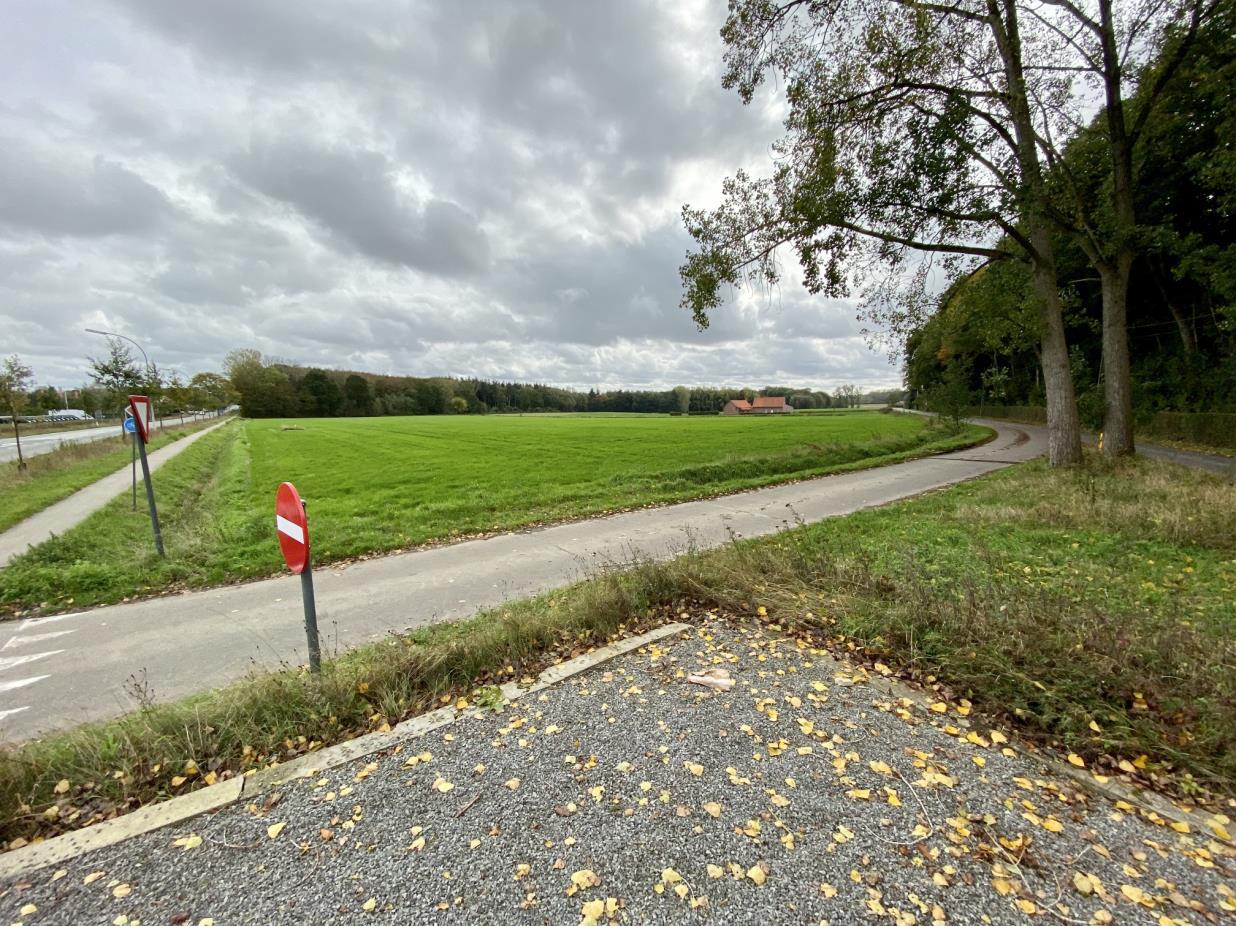
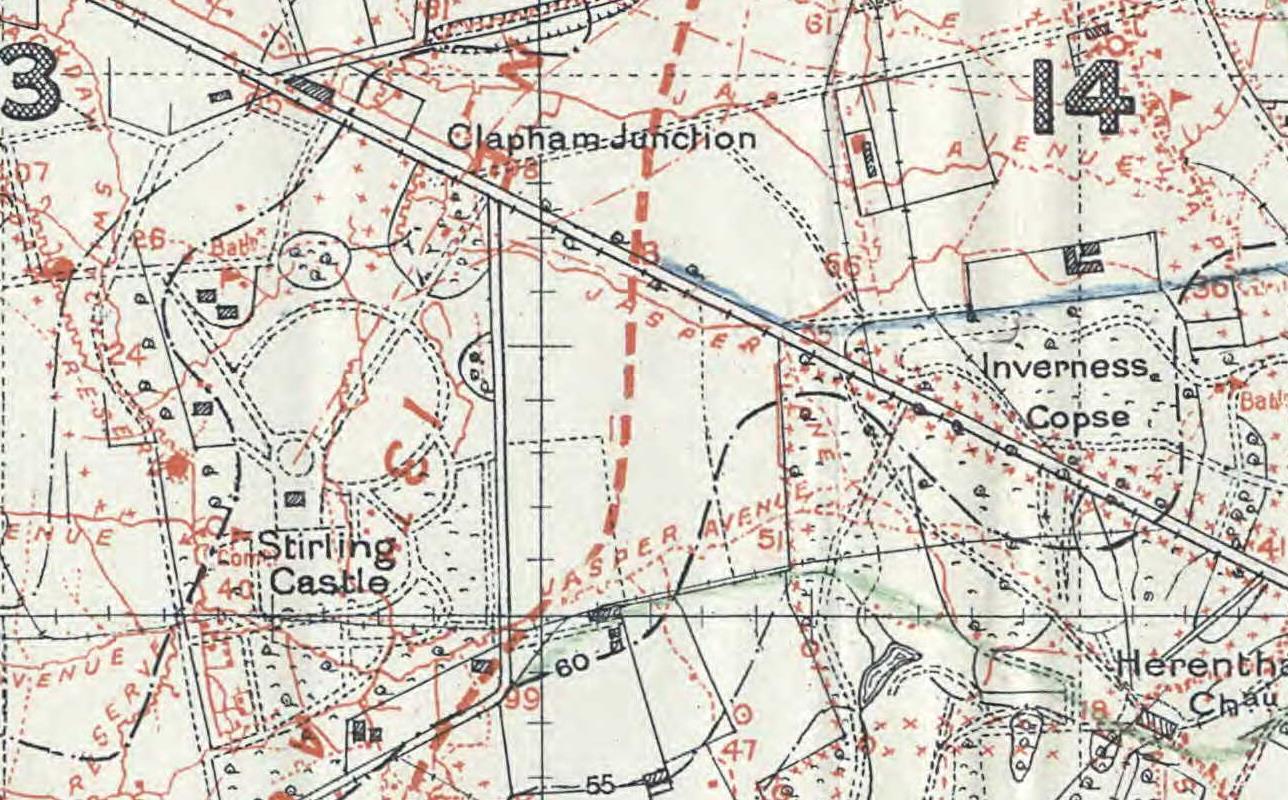
Royal-Dawson, Captain Oswald Sidney 25 August 1917, Glencourse Wood SPS 1896 - 1903
5th (Service) Bn. Oxford and Buckinghamshire Light Infantry, D Company Lijssenthoek Military Cemetery XVI.A.19 Age 32
Oswald was the second son of Charles Royal Dawson, a coffee planter, and his wife, Mrs Edith Rosalie Royal Dawson. (Oswald’s elder brother, Vernon, as well as his younger brother, Frederick, also attended St Paul’s leaving in 1900 and 1905 respectively though there is no record that either fought in the War.)580 Upon leaving St Paul’s Oswald, following in the footsteps of his elder brother, proceeded to Corpus Christi, Oxford, where he took his B.A. degree with honours in Classics and Philosophy. His profession is listed as that of ‘journalist’ in the 1911 census. He was first editor of the Oxford and Cambridge Review (now the British Review), and was at one time on the staff of the Morning Pest and the Daily News. As a playwright and writer he had had some success, was manager of the Glasgow Repertory Theatre in 1914, and up to the time of receiving his commission was literary adviser to Mr (later, Sir) Martin Harvey, a celebrated stage actor. Oswald’s tendency to journalism was early developed. Already at Colet Court he ran a magazine, and at St. Paul's he was a leading spirit in that witty unofficial journal, The Octavian. Typical of Oswald’s contributions is this:
Let me stretch my members listless, ‘Neath this kind acacia tree, Others vaunt of strength resistless, So they may, this pleases me.
Others ply the sportive willow
580 Frederick was prevented from going to university by the death of his father. Nonetheless, he became a renowned gentleman scholar. He undertook serious amateur study of Egyptian hieroglyphs, publishing inter alia a Who Was Who in Egyptology in 1951. He also catalogued the manuscripts of the Medical Society of London (1932), the Linnean Society (1936) and the Huxley Papers in the Imperial College of Science (1946). He was honorary librarian to Lloyds of London 1927 to 1936. Of Vernon, The Pauline is brimful of his youthful musical prowess. An entry under the Musical Society (1895 Vol 13, Issue No. 75, p 83) asserted that the solo part of ‘Hear My Prayer’ by Vernon Royal Dawson ‘was, like his second piece, finer than anything we can hope to hear in the school for a long time.’ Vernon won a Scholarship at Corpus Christi, Oxford and, as reported by The Pauline, appears to have been an all round high achiever.
17. the ‘93’ and their stories 279
Every day from two to three. Other’s tempt the bath’s green billow, So they may. It tempts not me.
Others optionally labour
Every day from two to three: But what satisfies my neighbour Does not quite appeal to me.
Others feel the cane that masters Every day from two to three: Others plod with planks or plasters, So they may. It recks not me.
Let me dream in meditation ‘Neath this kind acacia tree. If you will seek occupation Do so but don’t trouble me.581
Oswald’s first commission was dated 5 November 1914. On 5 April 1915 he was gazetted Temporary Lieutenant in 7th (Service) battalion Oxford and Buckingham Light Infantry, and on 11 June that year promoted to Temporary Captain in the same battalion. After serving at Salonika he was invalided home in 1916, but continued military duty in England until April 1917. He was sent to France on 9 June 1917, joining 5th (Service) battalion Oxford and Buckinghamshire Light Infantry.
At the time of his death Oswald was Captain of D Company in 5th (Service) battalion Oxford and Buckinghamshire Light Infantry. This unit was attached to 42nd Brigade, 14th (Light) Division. On 18 August this Division was detailed to capture the Green Line running north south through Glencourse Wood and Inverness Copse. The 42nd Brigade were responsible for the capture of the line running through Glencourse Wood. The attack was to take place under a creeping artillery barrage, coming down in the first instance on the Yellow Line before lifting 100 yards every four minutes until it reached the Red Line. Zero Hour for the attack was fixed for 7 am on 22 August.
Map showing the sector of line to the west of Glencourse Wood held by 42nd infantry Brigade (the Blue Line). The Yellow Line is the line on which the creeping barrage commenced; the Green Line shows the Final Objective and the Red Line shows where the protective barrage fell. The Blue dotted lines show the routes taken by the infantry to get to 581 St Paul’s Archive. The Octavian No. IV, published in 1902
17. the ‘93’ and their stories 280
their positions of deployment. The faint Brown line, just discernible running to the west from the south west corner of Glencourse Wood is the line delineating the southern extent of the section held by 42nd Brigade.582
On 17 August 5th (Service) battalion Oxford and Buckinghamshire Light Infantry had moved forward by lorry from Ouderdom to Café Belge on the Dickebusch Ypres road, where it had bivouvacked in a field. By 3 am on 18 August it had taken up position in the Blue Line, with D Company on the right.

The whole area had been the scene of severe fighting and was greatly broken up with shell fire all shell holes full of water. The trenches were all exceedingly bad.583
Upon their arrival in the front line, D Company were ordered to establish a series of posts in front of the Blue Line but owing to the difficult ground was not able to do so. An order was received that this must be undertaken the following night. Unfortunately, upon completion it was discovered that the line of posts was not quite located as intended and so D Company was ordered to establish the posts as ordered on the night of 20 August.
During personnel reconnaissance that day Captain Royal Dawson D Company found, and had brought in, a Sergeant of the Queen Victoria Rifles who had been out [in No Man’s Land] for six days, wounded. That night the line [of posts] was established as ordered.584
Oswald’s unit was relieved by 5th (Service) battalion King’s Shropshire Light Infantry during the night of 20 21 August and thus Oswald did not take place in the attack of 22 August. However, the scale of casualties endured during that assault meant that Oswald’s time out of the front line was short lived. During the night of 23 – 24 August his unit resumed their position at the front and suffered a German counter attack of 25 August. At 4.45 am on that day the Germans, assisted by Flammenwerfer, successfully advanced into the sector of line
582
583
TNA WO 95 1871 1
TNA WO 95 1900 4 Narrative of Operations
584 TNA WO 95 1900 4 Narrative of Operations
17. the ‘93’ and their stories 281
held by 43rd Brigade. This in turn meant that Oswald’s unit, on the right of the line held by 42nd Brigade, north of 43rd Brigade, found that their flank was exposed.
Directly Captain Royal Dawson knew what had happened, he himself with the support platoon went forward to restore the line [that had been lost by the unit on his right, the 6th battalion Duke of Cornwall’s Light Infantry] and succeeded in doing so in the face of heavy machine gun fire. … At 7.30 am D Company were reinforced by bombing squads of A and C Companies.585
It was during this close quarters fighting that Oswald was wounded. He was successfully extracted from the line and taken to a Casualty Clearing Station at Remy Siding. He died of his wounds on 25 August and is buried in Lijssenthoek Military Cemetery, adjacent to Remy Siding.
17. the ‘93’ and their stories 282
Sandys, Lt William Edwin 5 September 1917, Ypres (nr.) SPS 1908 1909
32nd Squadron, Royal Flying Corps Lijssenthoek Military Cemetery XVIII.H.8
Grave epitaph: Greater Love Hath No Man Than This Chapt. 15. Vrs. 13.St.John Age 24
William was the only son of son of Francis Edwin and Mary Llewellyn Sandys. He was born on 20 December 1892 in Calcutta, India. At some point he came to England and, having attended a school in Bath, proceeded to St Paul’s in the Spring of 1908. The Pauline bears silent witness to any of his schoolboy achievements, though an obituary published in The Telegraph asserts that while at SPS ‘he won colours for rowing and swimming’; and his obituary in The Pauline agrees that ‘he was a fine all round sportsman, [as well as] very musical, and a great traveller.’586 It appears that Edwin did not attend university after leaving SPS. The census of 1911 records him living at 5 Inverness Place, Paddington, employed as a ‘Sales Manager for the 727 manufacture of Electrical Aids for Deafness’. On 2 June 1911 he arrived in Quebec, Canada. On 21 September 1914 William enlisted with the first Canadian Contingent in Lord Strathcona’s Horse, at which time he listed his profession as that of a ‘Life Insurance Agent’. His Service File has survived and shows that he left Canada on 3 October 1914. (Before he departed he was presented with a gold watch in recognition of his fine recruiting work. ) William gained a commission in the BEF, Army Service Corps on 26 January 1915, at which time he was described as ‘a well educated, trustworthy man.’587 He departed for Egypt in the capacity of Adjutant, along with his brother in law, 2nd Lieutenant R J Grandin who later fell in action. It was perhaps this experience that promoted William to transfer in June 1916 to the Royal Flying Corps in which he soon became an instructor. He acted as Flight Commander in Scotland and England, and passed his technical examination at Oxford first in all subjects.
At the time of his death William was a Lieutenant in 32nd Squadron, R F C, flying a De Havilland 5, no. A9374. In September 1917 his Squadron was undertaking patrols over enemy territory in the north eastern sector of the Salient. In what appears a fairly typical encounter, on 4 September William’s patrol had:
Encountered 4 Enemy Aircraft in the locality of Passchendaele and Zonnebeke. The patrol dived on the EA which were flying at 3,000 ft over Passchendaele …. The attack … was followed up by Lt Sandys … attacking from the flank. Bullets were seen to strike the [enemy] machine, which then made East at great speed. At 1.15 pm the patrol observed 2 EA over
586
The Telegraph, 10 September 1917; The Pauline, 34 Nov 1917 p 143 587 The Pauline, 34 Nov 1917 p 143; Service File B8642 S005
17. the ‘93’ and their stories 283
Zonnebeke at 1,000ft. Lts Pearson, Cornish and Sandys dived, attacking EA from the south, whereupon the EA separated, one being lost to sight. … Lt Sandys followed up the attack, getting in several good bursts at very close range. The enemy machine then made East very low down, and was lost to view.588
A posed photograph of de Havilland 5 plane, the type of aircraft that William was flying on the day he was killed. The aircraft was equipped with one Vickers gun. (The image is of an Australian Flying Corps from 19 January 1918 at an aerodrome in Lincolnshire, England. The legend painted down the right side of the DH5 scout indicates it was a presentation aircraft, paid for by subscriptions and fund raising in Australia.)589
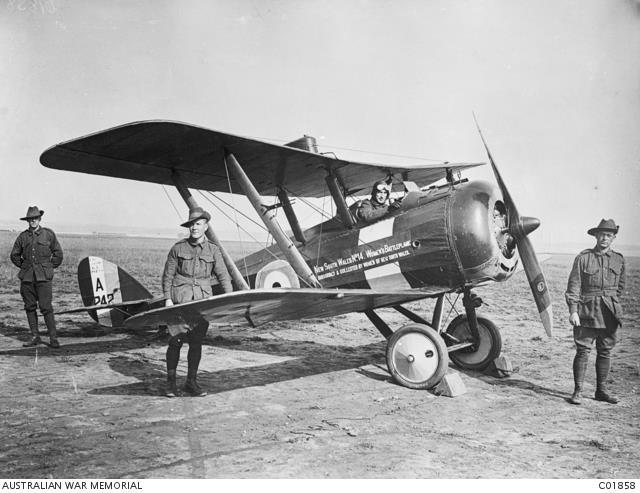
On the day that William was killed the unit diary records that he participated in a dog fight at 6.20 am against three two seater enemy aircraft over Westroosebeke, but is less clear as to his fate. The other three pilots in this patrol were Lt W R C Pearson and 2 Lts W C Cornish; and F C Andrews.
At 6.20 am [on 5 September] the patrol dived on Enemy Aircraft which were flying over Westroosebeke at 3,000 feet. Lts Pearson and Cornish attacked on … Lt Andrews attacked another, firing about 100 rounds at close range, when the EA spun down. Pilot followed EA down, and saw him flatten out near the ground. He then fired a further 50 rounds when his
588
TNA AIR 1/1222/204/5/2634/16, Report by Captain D Joy, CO No. 32 Sqdn RFC 589 Courtesy Australian War Memorial CO1858
17. the ‘93’ and their stories 284
gun stopped (no.3). Lts Pearson and Cornish each fired about 200 rounds into the EA, when it went down very steeply into the mist; pilots followed it down, firing all the time, when both guns stopped (Lt Pearson No.3; Lt Cornish No.1). The whole patrol then waited for about 5 minutes to see if EA reappeared, but no further sign of him was seen. Lt. W E Sandys was not seen again after this combat590 .
William is buried in Lijssenthoek Military Cemetery, suggesting that he was likely wounded in the dog fight but was nevertheless able to return his aircraft to the British side of the line where it most likely crashed. Indeed, according to T Henshaw’s The Sky Their Battlefield, William was shot down by an enemy aircraft and crashed in the Ypres Canal; and his obituary published in The Pauline states that:
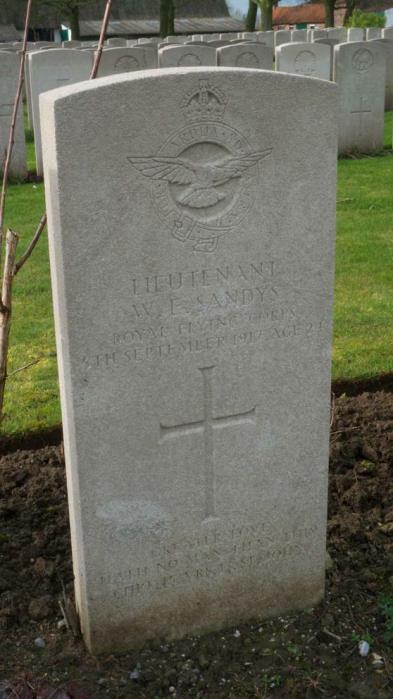
he was killed in action on 5 September. He was with a formation of four machines which encountered eight [sic] German machines, and was shot through the back of the head and in several other places.591
William left effects to the value of £120 to his widow, Elsie Constance Violet Sandys, to whom he had married almost exactly twelve months to the day.592
William’s grave at Lijssenthoek Military Cemetery XVIII.H.8
590 TNA AIR 1/1222/204/5/2634/16, Report by Captain D Joy, CO No. 32 Sqdn RFC 591 Henshaw, T, The Sky Their Battlefield; The Pauline 234 Nov 1917 p 143 592 In 2017 this sum was worth about £3,500.
17. the ‘93’ and their stories 285
Williams, 2nd Lt Maxwell Henry 19 September 1917, Ypres (nr.) SPS 1914 1915

1/17th (County of London) Bn. London Regiment, attd. 2/2nd (City of London) Bn. Vlamertinghe New Military Cemetery V.G.6 Grave epitaph: R.I.P Age 19 Maxwell Henry Williams593
Maxwell was the third son of W Seccombe Williams, a sheep farmer on Weddell Island, one of the Falkland Islands.594 Born in the Falklands, Maxwell at some point came to England where in the first instance he attended Mount St Mary’s followed by St Edmund’s College, Ware before proceeding to St Paul’s at the start of the Spring Term 1914. (The Pauline asserts that Maxwell proceeded from St Paul’s to St Edmund’s College, Ware. However, it is more likely that he travelled in the opposite direction. St Edmund’s was apparently struggling in the pre war years and at the time of the 1911 census Maxwell is described as 13 years of age and resident at the College.)595 Maxwell joined the O.T.C at St Paul’s. The record is silent as to his career directly following his time at SPS, though it is known that at some point he was gazetted 2nd Lieutenant in the Artist’s Rifles and then transferred to 1/17th (County of London) battalion (Poplar and Stepney Rifles) in May 1917.
At the time of his death, Maxwell was attached to 2/2nd (City of London) battalion (Royal Fusiliers), a unit in 173rd Brigade, 58th Division. Between 31 August and 10 September Maxwell’s battalion was resident in Dambre Camp, a mile north of Vlamertinghe (west of
593 Image courtesy of St Edmund’s College 594 Maxwell’s brother, Stuart, also fought and was killed on 3 May 1917. 595 The Pauline, 35 234 Nov 1917 p 146
17. the ‘93’ and their stories 286
Ypres), undergoing training in preparation for the assault planned to begin at 5.40 am on 20 September (later known as the Battle of Menin Road). During the night of 12 13 September, 2/2nd (City of London) battalion moved from Dambre Camp, via Canal Bank, into the front line sector north east of St Julien. Maxwell’s unit held this line until the evening of 18 19 September, during which time there occurred a number of small scale enemy attacks.
The National Archives' reference WO 95/3001/4
Map from 2/2 of the battalion in front of the Steenbeek, directly to the west of St Julien (shown midway on the right) 12
Maxwell became a casualty a September. The diarist recorded that during that night the battalion was ‘relieved by 2/7 battalion London Regiment, which completed at 1.30 am. Casualties: 3 officers and 47 ORs.
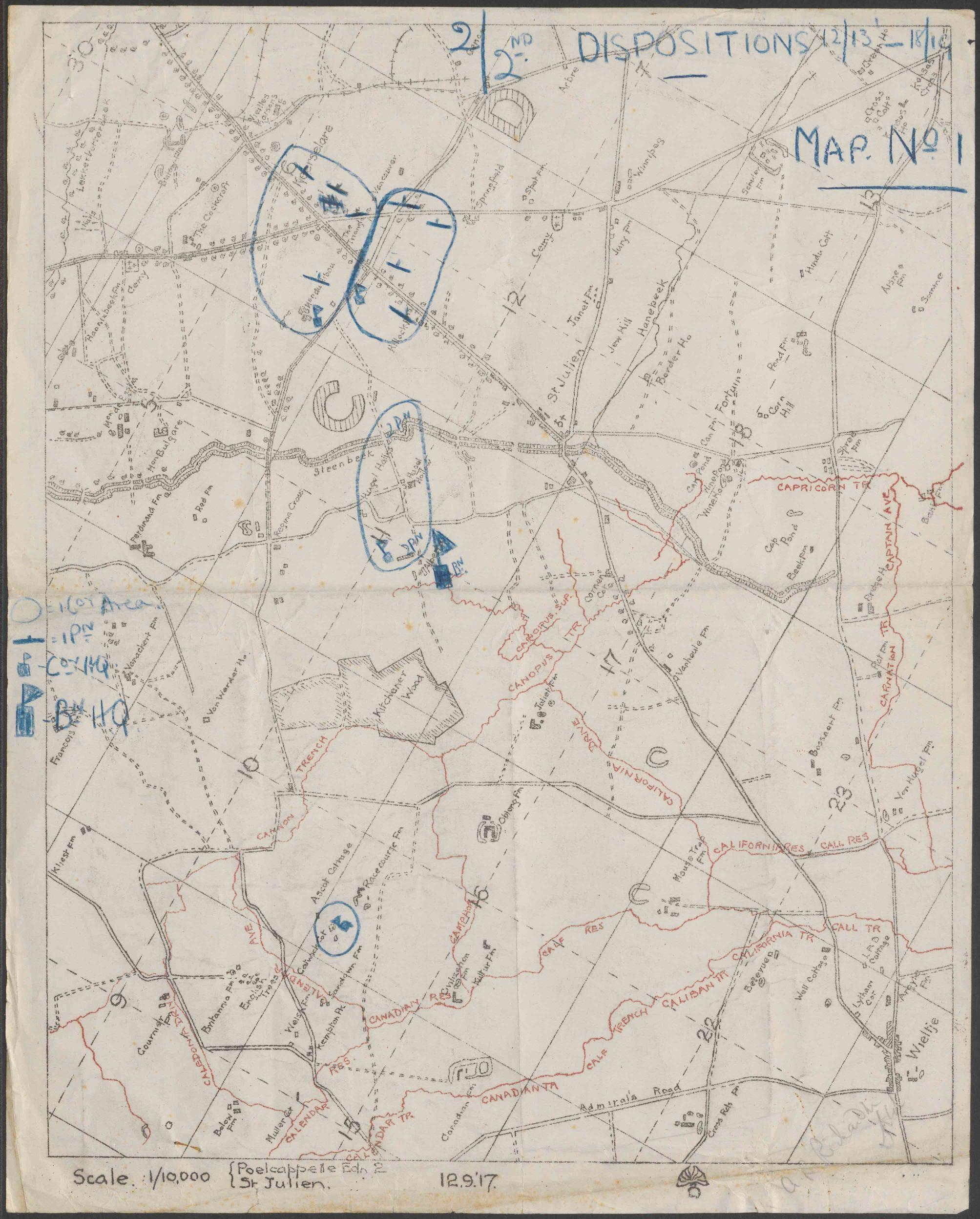
Moved to Canal Bank in Reserve.’597 It is possible that Maxwell’s death was tragic collateral damage suffered by his unit from an attack which the enemy had just then launched against the battalion holding the right of the line. (The 173rd Brigade diary records that ‘during the relief the right [battalion] was heavily shelled from the direction of Passchendaele Group [artillery] and neutralising fire was obtained from [our] Corps Heavies with good effect.’)598 However, Maxwell’s obituary published in The Edmundian states that ‘he was killed instantaneously by a shell that struck his tent.’599 The reference to ‘tent’ suggests that he was perhaps more likely to have been killed upon having arrived at Canal Bank, a camp adjacent to the Ypres Yser Canal the unlucky victim of the regular shelling endured by Ypres and its environs and that his body was then removed for burial to Vlamertinghe New Military Cemetery, not far south from Dambre Camp, and where the battalion returned on 20 September.
597
TNA WO 95 3001 4 1 598
TNA WO 95 2999 2 3 173rd Infantry Brigade, Summary of Intelligence 19 September 1917 599 The Edmundian, 16 October 1917. Courtesy of St Edmund’s College
17. the ‘93’ and their stories 288
Chown, 2nd Lt Francis Jack 20 September 1917, Hooge SPS 1912 1916 1st Squadron RFC Hooge Crater Cemetery XVI.H.15 Age 19
Francis Jack Chown600
Francis was the only son of Francis Chown, M.B. and his wife, Annie, of Townshend, Hayle, Cornwall. The 1911 census reveals that Francis (Jack) was at that time resident in Townshend, though no doubt plans had already been formed to send him to SPS where he arrived as a boarder the following year.
Francis’ obituary published in The Pauline provides an interesting overview of his time at SPS from the start of the war:
For the last three years of his school life, Chown was a member of Mr. Armitage's House, and it was here that the power of his personality was most fully recognized. As House prefect he insisted on a sane and manly discipline, and had everybody's respect and affection. Though far from being a scholar, he did his work in a persistent, methodical manner which brought him always where he wanted to get. His efforts were always wholehearted, but he wasted none of them. He was a fair all round athlete, boxer, cricketer, and [rugby] footballer; he was a sergeant in the 0.T.C, and as such found work which attracted him greatly … He had a
600 Copyright © Bonhams 2001 2020. Portrait study of Second Lieutenant Jack Chown in his RFC uniform signed with initials 'L.K.' (lower right) by Dame Laura Knight RA, RWS (British, 1877 1970)
17. the ‘93’ and their stories 289

strong sense of orderliness, “his work was always well finished”. Chown's character was built on strong lines. He was thoughtful, manly, straightforward, a hater of shams, loyal to his word, his friends, his school. He had a shrewd sense for all that was sound, and a rare tenacity in following its guidance.601
By 1916 the O.T.C had instituted a London Brighton march, described by The Pauline in an edition from that year:
The Brighton March Sergeants in the party were: Sergeants Lambert, Jackson, Moses, Chown, St. Aubyn, Sclater. All [members of the party] arrived safely [in Brighton], with the exception of Denniss, who was forced by a bad ankle to train back, all returned in equally good form. The catering was admirably done by the Victoria, near Sutton, the Railway Hotel, Reigate, the Queen's Head, Bolney, the New Ship, Brighton, and the Black Swan, Peaspottage. We also owe sincere thanks to the Quartermaster at Reigate for blankets, and to Mr. Huth, J.P. etc., for hospitality in the now famous barn at Bolney. The stages of our march were: first day, Putney to Reigate, 20 miles; second day, Reigate to Bolney, 22 miles; third day, Bolney to Brighton, 13 miles, and Brighton to Bolney by night, 13 miles 26 miles in the 24 hours; fourth day, Bolney to Reigate; fifth day, Reigate to Wimbledon. Lambert as M.O. was largely responsible for our sound feet and robust health.602
Francis’ obituary also describes how:
Chown was intensely anxious to do his bit in the war; he intended to go to Sandhurst, but before the results of the entrance examination were published a commission in the Flying Corps was offered him. This was just what he wanted; it seemed certain to him now that he would get out to France before war was over.”603
In 1916 Francis proceeded to the School of Aeronautics at Wantage Hall, Reading. Following five weeks of intensive training he joined 14 Reserve Squadron, in which he gained his pilot’s licence in May 1917 and was appointed an assistant instructor.
601
602
The Pauline, 35 234 Nov 1917 pp 138 39
The Pauline, 34 225 June 1916 pp 94 95. Of the other sergeants listed here at least two others fell in the war: Lambert was mortally wounded near Hooge in 1915; Moses was killed in action near Vierstraat in 1917; three OPs named Jackson fought in the war, at least two of whom fell but it is not clear from The Pauline account which of these three accompanied Chown on the Brighton march; Sclater and St Aubyn fought and survived.
603
The Pauline, 35 234 Nov 1917 pp 138 39
17. the ‘93’ and their stories 290
After two months, tired of the monotony of aerodrome circuits, and because, too, “he preferred flying alone to having another man's life on his hands”, he volunteered for training as a scout. On 18 August he was sent to a scout school in France, and was later appointed to No. 1 squadron “to the very best squadron in the R.F.C.”, Francis writes on 15 September, “they have more Huns to their credit than any other squadron, so a lot is expected of us.”604
Francis was killed when his plane crashed in the afternoon of 20 September, most likely because he had been incapacitated by enemy fire from the ground. At 12:55 pm on that day he took off from Bailleul Aerodrome flying a Nieuport Scout 27, No. B6675. His mission was to provide aerial support for the attack that had been launched at 5.40 am that day, later to be called the Battle of Menin Road. The infantry on the ground in the area in which Francis crashed were 2nd Division Australian, holding by midday the section of line running north from the halfway along the northern edge of Polygon Wood to roughly Garter Point, about ¾ mile south west of Zonnebeke. By 10.45 am 2nd Division had reported that all objectives had been achieved but also that enemy aerial activity remained lively:
Aerial activity. During the morning a patrol of 8 enemy planes flew over our battery positions; one of them was shot down … During the latter part of yesterday’s attack enemy Albatross and Aviatik machines were exceedingly active. 15 machines patrolled our lines at a low altitude for over an hour. … During the afternoon hostile machines were also active flying over our lines firing at parties of our men with machine guns.605
A Report from General Headquarters Second Army stated that:
On the 20th September, during the first two hours of our attack, low clouds and a drizzling rain made flying almost impossible…. As soon as the weather had slightly improved aerial activity became great. … In the middle of the day German aircraft became very active, attempting to interfere with our artillery, bombing, and low flying machines. In the evening, when the weather improved, they kept well east of the lines and were disinclined to fight. Ten hostile machines were destroyed and six driven down out of control. Ten of our aeroplanes are missing.606
604 The Pauline, 35 234 Nov 1917 pp 138 39 605 AMW4 1/44; RCDIG1010897; Second Australian Division Intelligence Summary from 6 am 20 to 6 am 21 September 1917 606 General Headquarters, 22 September published in Flight Magazine, 27 September 1917, Aircraft Work at the Front. Official Information p 1009
17. the ‘93’ and their stories 291
Francis was thus despatched to combat the on going threat from hostile aircraft. Reproduced from an anonymous account probably provided by his commanding officer Francis’ obituary in The Pauline provides the following details:
About midday [this timing would seem to be inaccurate] on the 20th a “plane was observed between the lines being attacked by four German 'planes. After some minutes the British 'plane began to descend, and at about 400 feet caught fire, remaining nevertheless under control. The landing was amongst the shell holes near our [old] front line trenches. There was a slight crash, and the pilot was thrown clear; but when reached he had just expired, shot through the head and back. The pilot was Chown, who, with others, had been detailed to strafe the German trenches. Though mortally wounded, though his machine was aflame, he retained control of it and brought it back to our line”.607
Francis lies today in Hooge Crater Cemetery, though his body was only latterly placed there by the Exhumation and Reburials process that took place after the war. The relevant Burial Return shows that Francis’ body was originally buried at the southern end of Bellewaarde Ridge, in front of Chateau Wood.608 This location was the starting point for those units of 2nd Division Australian who had participated in the attack on 20 September and is thus commensurate with the obituary reference above that Francis returned his aircraft ‘back to our line.’
A Nieuport Scout ready to take off in the snow at Bailleul Aerodrome, 27 December 1917. It is possibly No. 1 Squadron RFC.609
607 The Pauline, 35 234 Nov 1917 pp 138 139 608 Concentration of Graves (Exhumation and Re burials). Zillebeke 177/244E. The exact location is given as 28.J.7.c.7.2. 609 © IWM Q 11955
17. the ‘93’ and their stories 292
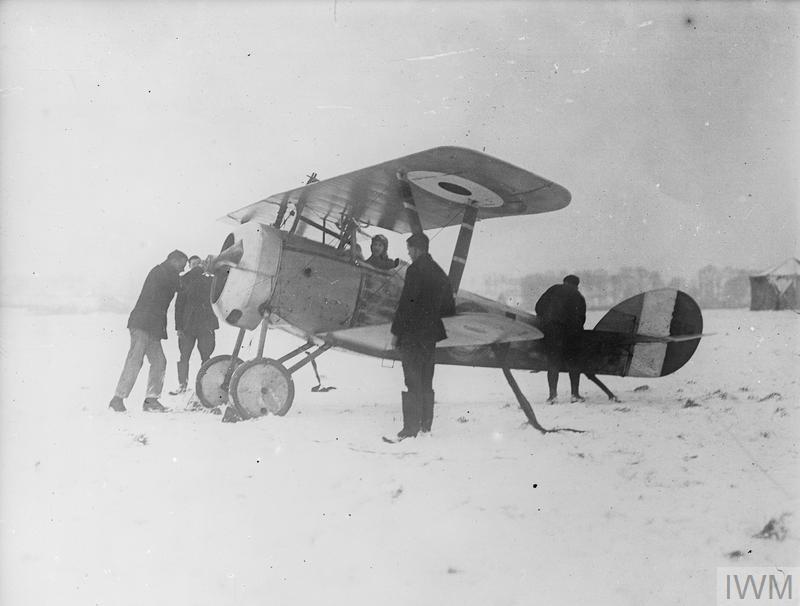
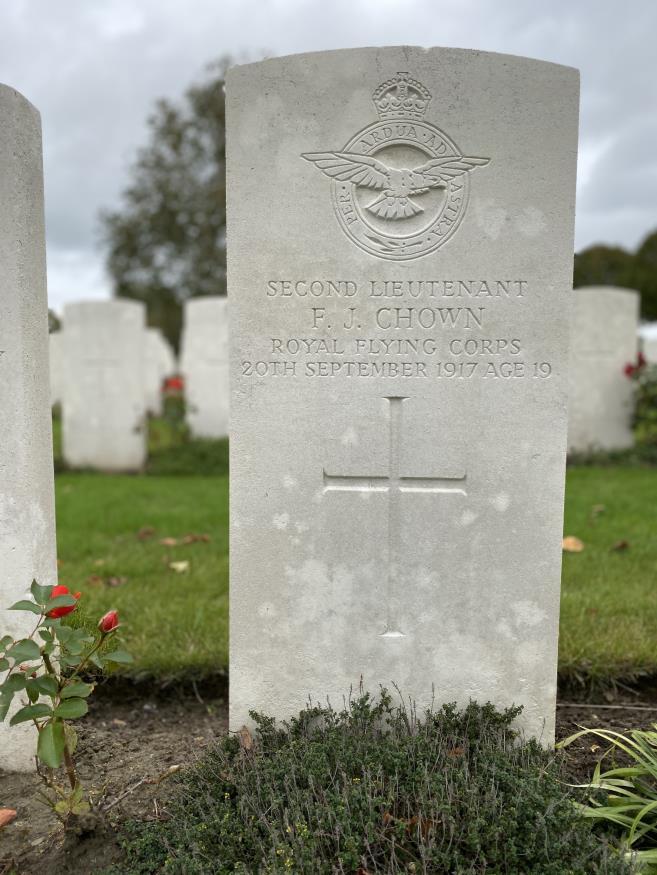
Gulbenkian, 2nd Lt Krikor 20 September 1917, Bitter Wood SPS 1905 1908
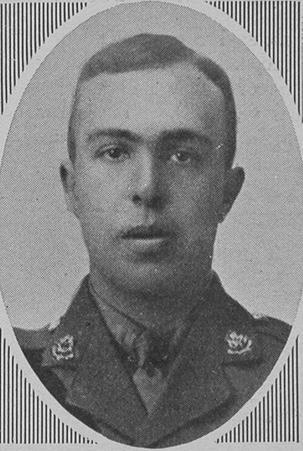
23rd (Service) Bn. The Duke of Cambridge’s Own (Middlesex Regiment), (2nd Football)611 Tyne Cot Memorial Panel 113 to 115 Age 26
Krikor Gulbenkian612
Kirikor was the son of Garabed and Marie Gulbenkian of 2, Holland Park Avenue, Notting Hill, London. (Krikor’s father’s naturalisation certificate of 1903 states that he was of ‘the Ottoman Empire, having been born at Talas in Kaissar the province of Angora.’) Little is known of Krikor’s schoolboy career at SPS. The 1911 census states that he was at that time a ‘merchant’s clerk’ working for his farther, whose profession is described as that of a ‘commission merchant’. In 1914 Krikor enlisted in the British Army, joining the Middlesex Regiment as a first class Signaller. After being recommended for a commission in February 1917, Krikor returned to England to train as an officer at the Officers’ Training Corps at Pirbright. He was gazetted 2nd Lieutenant in the 23rd (Service) battalion, Middlesex Regiment and returned to France on 1 September 1917 to join his new unit.
In early September 1917 23rd (Service) battalion Middlesex (123rd Brigade, 41st Division) was undergoing training in preparation for the next stage of Third Ypres that was to begin at 5.40 am on 20 September and conclude on 26 September, later known as the Battle of the
611 The battalion was formed in June 1915 and, like the 17th (Service) battalion Middlesex, had a number of footballers enlisted. Former Tottenham Hotspur and Clapton Orient footballer Alan Haig Brown was appointed commanding officer in September 1916.
612 Image in The Sphere 29 December, 1917
17. the ‘93’ and their stories 294
Menin Road. The training took place at Tilques near St Omer and lasted from 1 September until 9 September. Activities included observing a ‘demonstration on liaison aeroplane contact’, ‘practicing [the] method of attack’, as well as ‘battalion sports’, ‘Brigade Sports’ and a ‘Divisional Field Day’.613 At 2 pm on 9 September the battalion left by buses for Ridge Wood near Voormezeele, arriving in that place at 8 pm when they took over shelters and tents. Between 10 18 September the battalion provided working parties for a number of Field Company and Pioneer units preparing trenches at Larch Wood just to the west of Hill 60. On 19 September the battalion proceeded to Larch Wood and took up position in reserve ready for the attack scheduled for 5.40 am the following morning. As had become usual during the course of 1917, the attack began with a creeping barrage.
Barrage map showing the creeping barrage that took place from 5.40 am on 20 September. Notice the sector held by 41st Division and the Red, Blue and Green Line objectives.614 613 TNA WO 95 2639 2 614 TNA WO 95 2566 1 6
17. the ‘93’ and their stories 295
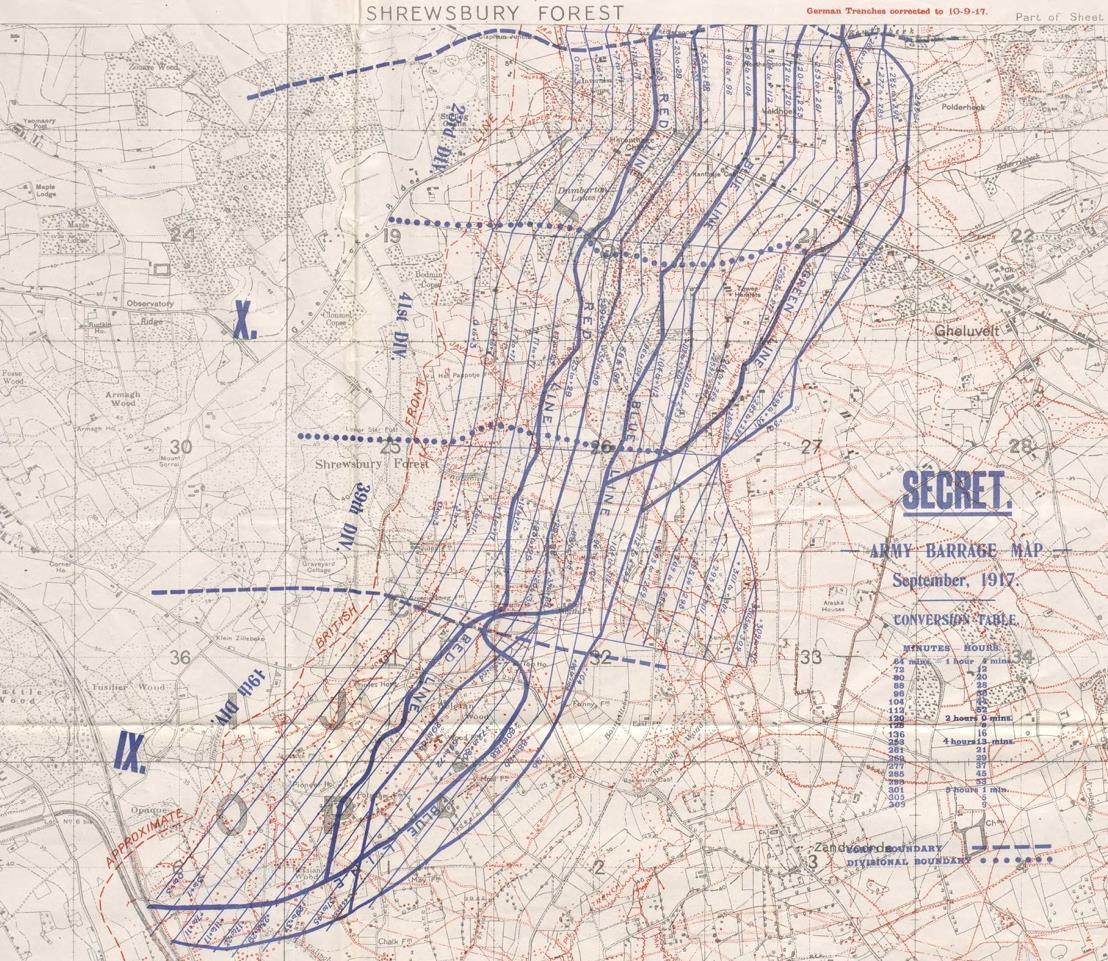
The attacking units were detailed to follow the barrage and take clearly delineated objectives, shown on attack maps as Red, Blue and Green Lines. The map below shows the 41st Division boundaries and the section of front they were detailed to attack. Larch Wood is shown in the bottom left hand corner.615
At 1 pm the 23rd (Service) battalion Middlesex was ordered to advance from its reserve position at Larch Wood, reinforce the firing line, pass through units of the attacking Brigade (124th) and take the final objective i.e. the Green Line. The battalion was disposed on the right flank, on the northern edge of Shrewsbury Forrest. In order to attain the Green Line it faced the dauting prospect of having to cross the deep sided valley running south from the Menin Road, along which ran the Bassevillebeek, a watercourse described on trench maps as having ‘steep banks, marshy bottom [and is] 2 feet deep.’ (Notwithstanding the presence of well established enemy dugouts and strong points, in geographical terms alone this sector presented perhaps the most challenging territory in the Salient.)


Map showing the disposi (Service) battalion Middlesex is shown on the right; 10 in the centre and 20 from ‘SP’. The Green Line was the ultimate objective of the Brigade.
17. the ‘93’ and their stories 296
2 pm. Battalion arrives at Canada Tunnels [in the vicinity of Mount Sorrel].
4.30 pm. Advance towards firing line near Lower Star Post in artillery formation.
5.30 pm. Arrive at Java Trench. Encounter hostile machine gun fire from front and right flank.
6.30 pm. Our [second] barrage opened on ridge and dugouts in front, strongly held by snipers and machine guns. [We] advanced in extended formation by short rushes to Blue Line but owing to heavy fire were unable to hold in strength. The ground here was very soft and cut up by shell fire. This, and the amount of wire encountered, made further progress impossible. The fighting here assumed a very close nature, until the dug outs on the immediate front were cleared, these we held as our advance line, the remainder of the battalion consolidating in depth. The rear company being on the western bank of the Bassevillebeek, and with orders to hold all positions until daybreak.
8 pm. Enemy concentrated on ridge in front, dispersed by Lewis Gun and rifle fire. ORs, 10 killed; 71 wounded; 21 missing; 1 officer wounded.
10 pm. Patrols sent as far as Blue Line, reported all clear. Shelling and sniping continued all night.
5 am. Scouts despatched to ascertain exact position of RWKs [10th battalion Royal West Kent] on our left flank.
5.30 am. B Coy sent on to ridge on left flank with orders to attack on enemy flank in conjunction with our frontal attack.
9.30 am. C and A Coys advanced in short rushes taking cover in shell holes until the copse [i.e. Bitter Wood] on the Bassevillebeek was reached. Hostile machine gun fire was very intense and casualties numerous. The ground from here forward was found to be practically a quaqmire and further advance was impossible without entailing enormous casualties. An advanced line was then pushed forward and the battalion dug in. 1 officer killed; 3 wounded. 7 pm. Enemy attempted to counterattack but were held in check by Lewis Gun and rifle fire until the barrage opened up [again] and annihilated them. ORs: 4 killed; 47 wounded; 2 missing.
617
22 24 September. [The battalion stayed in line until relieved at 4 am on 24 September.]
Unfortunately, and rather unusually, the diarist does not provide the names of officers who were killed, nor is it known in which Company Krikor served. Nevertheless, since only one officer is identified as having been killed during the fighting of 20 21 September (see the
17. the ‘93’ and their stories 297
The battalion diarist provides the following description of the experience of battle on 20 21 September:above entry for 9.30 am on 21 September) this is most probably a reference to Krikor. This suggests that Krikor was killed in the vicinity of Bitter Wood, most likely the victim of machine gun fire from the enemy strong point on the brow of the steep slope running east from the Bassevillebeek, referenced by the 41st Division diarist:
21 September
11.25 am … 23rd Middlesex held up by machine gun fire at J.26.b.8.3 12.10 pm 23rd battalion Middlesex have been held up by [a strong post] which has now been destroyed by the Royal Artillery, and are now moving up.618
Krikor’s obituary published in The Pauline includes an anonymously authored description stating that ‘he died very gallantly leading his men against a strong position, which we captured.’619 Krikor’s body was lost in the confusion of the attack and lies to this day in the vicinity of Bitter Wood.620
The Report on Operations concluded that:
Twice the Green Line on the whole front of the Division appeared to be in our grasp if we could only close our fingers on it. That we failed can be attributed to indifferent leadership by junior commanders, and to the absence of the determination to get forward no matter the cost. Both these defects can be remedied by training, but time is needed to get that training.621
618
TNA WO 95 2617 1 2
619 The Pauline, 234 Nov 1917 p 140
620 The vast majority of Bitter Wood is no longer existent.
621
TNA WO 95 2637 1 2 Report on Operations Commencing 19 September 1917
17. the ‘93’ and their stories 298
Reynolds, Rifleman Gilbert Gales 301041 20 September 1917, St Julien SPS 1910 1913
2nd/5th (City of London) Bn. London Regiment Ypres (Menin Gate) Memorial Panel 52 and 54 Age 21
Gilbert was the son of Bernard and Isabella Reynolds of 18, Maxilla Gardens, London, W.10. The Pauline is silent as to any of his schoolboy achievements. After leaving SPS in 1913 he worked for the Prudential Company in London.622 Gilbert enlisted with the London Rifle Brigade in 1914 and crossed to France on 2nd September 1915. Gilbert was not an officer and the battalion diary thus does not mention him by name, though it does contain a particularly rich narrative of the action in which Gilbert died and is thus replicated in full below.
At the time of Gilbert’s death 2/5th battalion London Rifle Brigade was a unit in 174th Brigade, 58th Division. During the period 14 18 September the battalion was in Dambre Camp north of Vlamertinghe, undergoing training for the forthcoming attack in which it was detailed to attack a section of the German line north east of St Julien. Zero Hour was set for 5.40 am on 20 September, at which time a creeping barrage was to open about 150 yards in front of the leading infantry and lift every 50 yards, the first lift being at Zero Hour plus 3 minutes. When the creeping barrage reached the objectives i.e. the Blue Dotted and Brown Lines it was to become static for a period and thus provide a protective barrage, the final protective barrage detailed to last for two hours.
At 5.40 am punctually the creeping barrage came down and the advance began. Leading troops kept very close to the barrage. One Company reports that it kept up to a distance of twenty yards from the barrage, the shells bursting a little behind [in front of?] them and that though the ground was very broken they were able to keep within thirty yards of the barrage up to their final objective the Blue Dotted Line. A few casualties were inevitably suffered from our barrage.623
Barrage map showing the incremental advance of the creeping barrage. At Zero Hour Gilbert was in the vicinity of The Triangle, shown in the bottom left hand corner.624
622 Gilbert’s name features on the extraordinary Prudential Assurance Buildings war memorial in Waterhouse Square, High Holburn,London. It was designed by Ferdinand Victor Blundstone.
623 TNA WO 95 3003 1 3 174th Brigade Report on the capture of the Langemarck Ridge north and north east of St Julien 20 22 September 1917
624 TNA 2987 1 3
17. the ‘93’ and their stories 299
The 2nd/5th battalion London Rifle Brigade was not detailed to attack in the first wave, but was to ‘pass through’ the leading battalion 1/8th (City of London), London Regiment once the first objective (the Blue Dotted Line) had been secured. The 174th Infantry Brigade Order No. 47 stipulated that:
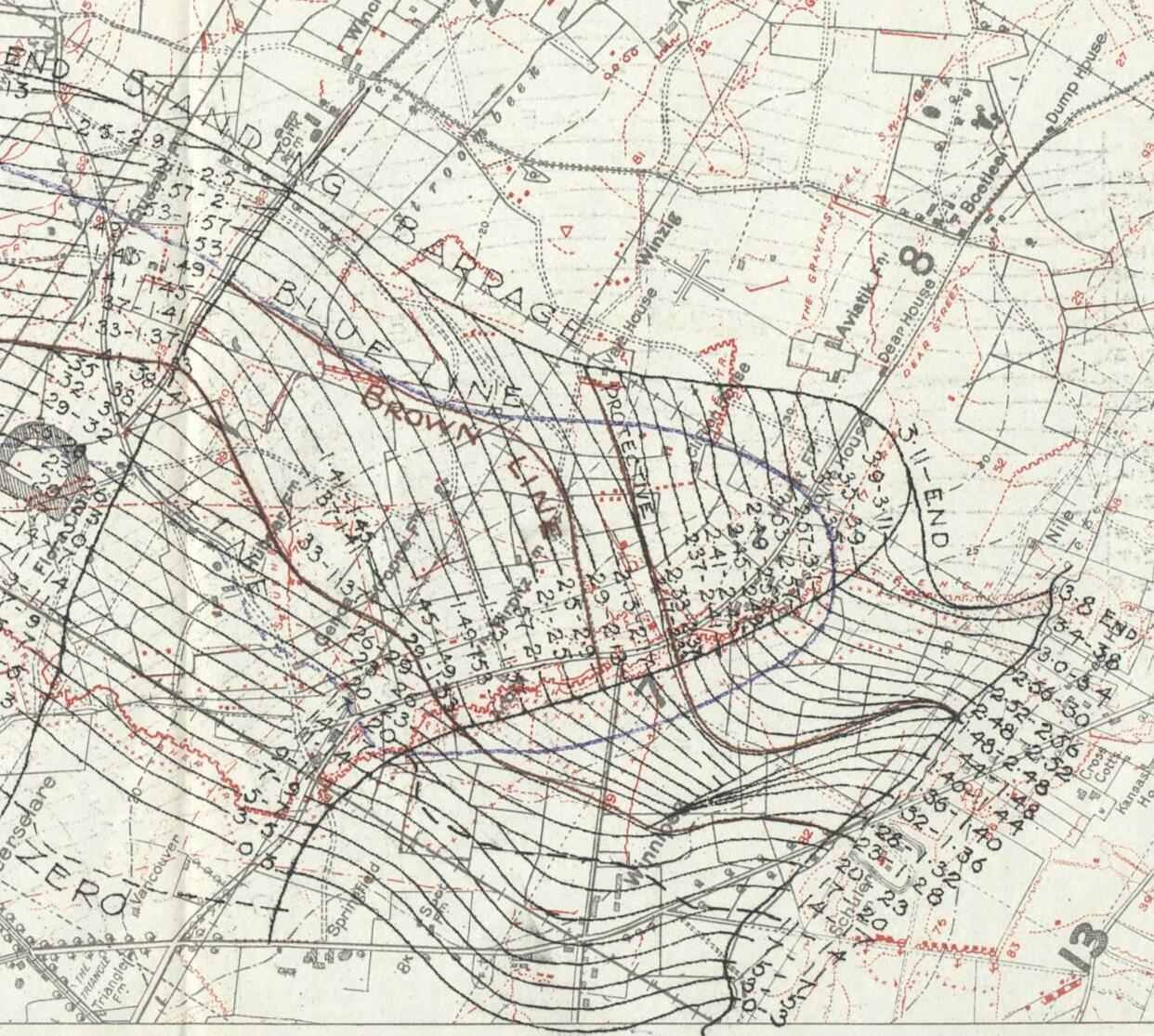
174th Brigade will attack on a frontage of one battalion. … The leading battalion will be the 8th London Regiment. This battalion will capture and consolidate all the ground up to and including the Blue Dotted Line. … 2/5th battalion London Regiment will [then ‘pass through’ and] capture and consolidate all the ground from the Blue Dotted Line up to and including the Brown Line. Leading troops of this battalion will leave the Blue Dotted Line at Zero [Hour i.e 5.40 am] plus 1 hour and 25 minutes, working close up to the protective barrage.
625
An attack map showing the objectives and dispositions of units in 174th Brigade during the action of 20 September. The 2/5th (City of London) battalion (portrayed on the map as 5th
625 TNA WO 95 3003 1 3 174th Infantry Brigade Order No. 47, 19 September 1917
17. the ‘93’ and their stories 300
London Regiment) are shown in their assembly position to the west of The Triangle, south of Keerselare, before ‘passing through’ 1/8th battalion London Regiment. (Unfortunately it is not known to which Company Gilbert belonged.)626
Contained within the battalion diary is the following narrative of events: March to position of assembly: battalion paraded ready to march off at 10.45 am on 19 September 1917, at Reigersburg Camp, strength 16 officers and 452 Other Ranks. The night was very dark, and heavy rain fell from 10. pm till about 1 am, making the going difficult and slippery. The Northern duckboard track which ends close to Kitchener’s Wood was followed as ordered, and from this point a line across country the road being obliterated to Borchcastel, Adams Farm, Regina Cross Roads, to Hibou. This last mile or so was very hard on the men, the leading Company arriving there at 3.40 am, and at once formed up on the tape.627
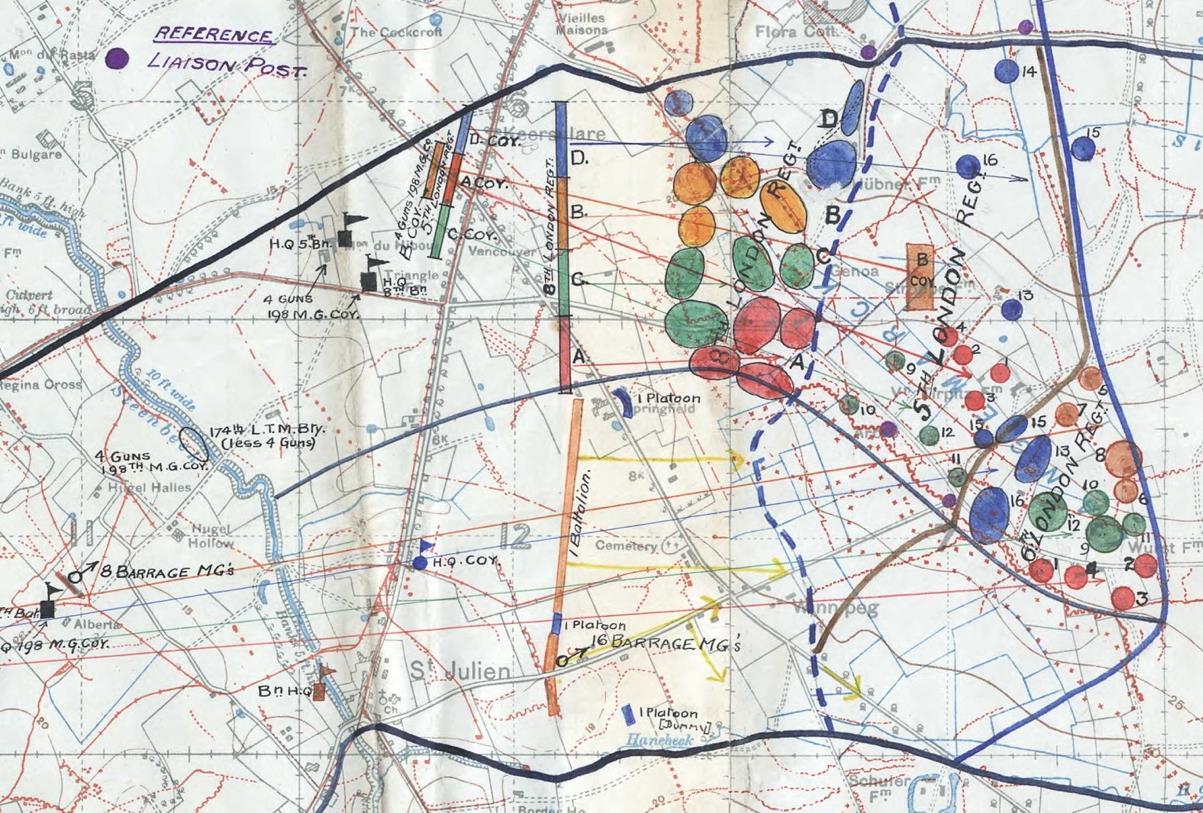
626 TNA WO 95 2987 1 3
627 While there is no doubt that the approach to the front line was difficult for Gilbert, it was seemingly yet more challenging for others. Units moving [from Reigersburg to Assembly Positions at night on 19 September] by Alberta Avenue were seriously hampered by the fact that an ammunition train on the light railway had been drawn up and left right across the duckboard track at about C.22.a.central and a dump of 4.5” howitzer ammunition formed at the same point, while further up the track at about C.16.d.central efforts to “unditch” a derelict tank had deposited it across the track. There were serious obstacles in view of the
17. the ‘93’ and their stories 301
Maps from 58th Division HQ showing the route to the front taken by 2/5th (City of London) battalion.628 Reigersburg is in the bottom left hand corner. Gilbert will have crossed the Canal at Bridge three and thereafter followed the ‘Trench Board Track’. (The black lines show the Divisional boundaries).629
The eastern section of the above map. Gilbert followed the blue line to its termination in front of Kitchener’s Wood, before proceeding from there to Hibou (shown in the top right hand corner) via the places described in the Report, reproduced here:
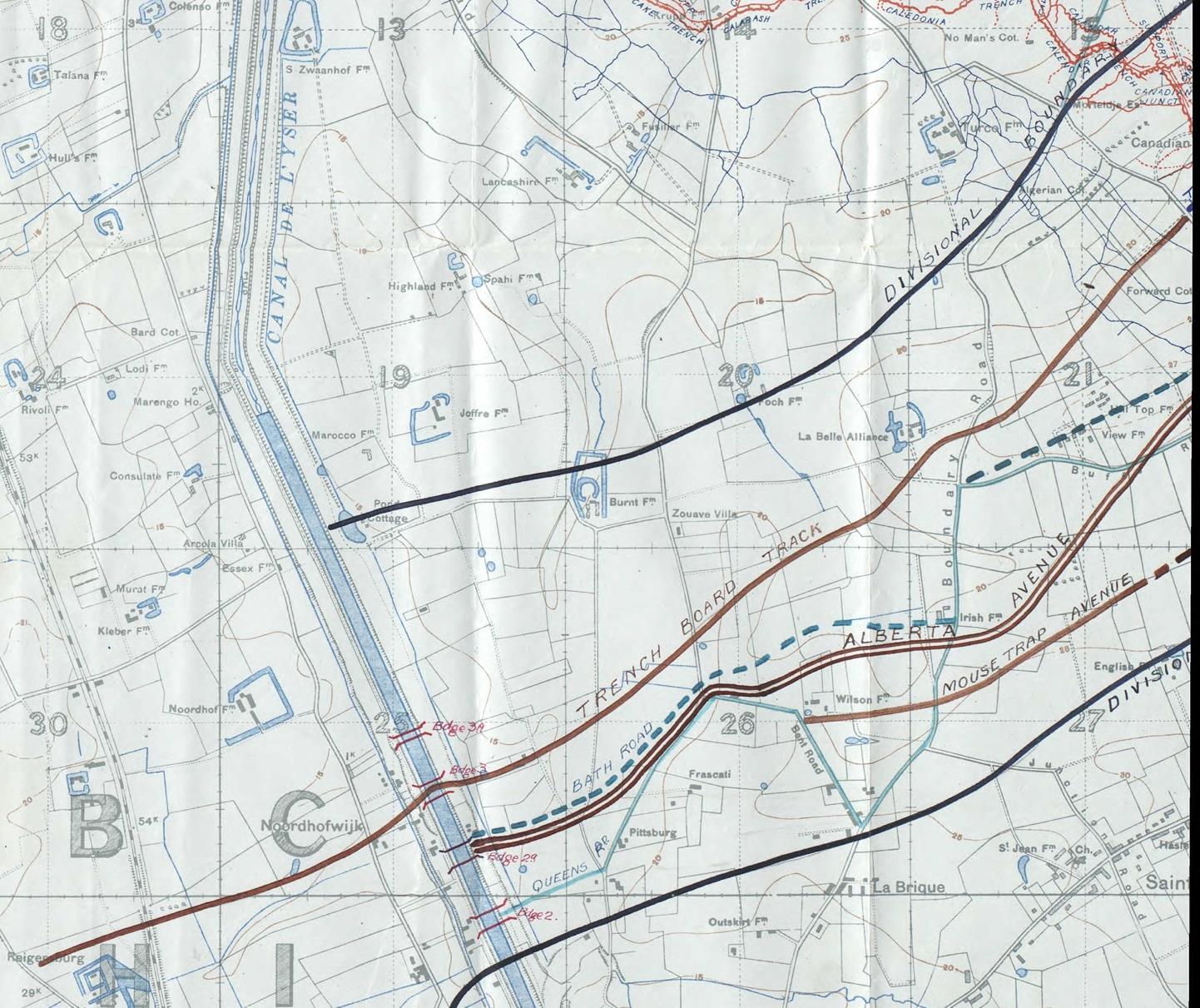
darkness of the night and slippery going caused by the heavy showers which had fallen and delayed the march considerably. TNA WO 95 3003 1 3 174th Infantry Brigade, Report on the capture of the Langemarck Ridge north and north east of St Julien 20 22 September 1917. 628 TNA WO 95 2987 1 3 629 TNA WO 95 2987 1 3
17. the ‘93’ and their stories 302
Position of assembly: the whole battalion was in position at about 4.05 am, men very tired, fell asleep immediately and were not roused until about 5.20 am, when they ate a sandwich ration, with which each man was provided. There were four casualties on the march up, and two wounded on the tape, otherwise the enemy shelling was rather below normal.
Zero Hour: at Zero Hour, 5.40 am, the whole [battalion] rose up and advanced in good formation, the flanks of each Company marching on a compass bearing.

Enemy barrage: the enemy barrage came down on the usual lines about 4 or 5 minutes after Zero but was not particularly heavy; it kept on thickening, however, until about 6.45 am, when it seemed to reach its greatest intensity. This was maintained until after 11 am and at this hour it was concentrated approximately along the line Arbre Marine View Promenade Hubner Farm with a good sprinkling all over the area between this and Tirpitz Stroppe Farms.
Direction: much difficulty was experience in keeping direction owing to the losses among officers, and the confusing nature of the country. There appeared to be Mebus [German concrete blockhouse / pillbox] in every direction Tirpitz Farm was only distinguishable by the hedges and ditches around it, and in the same way Stroppe and Genoa could only guessed at. It appears that [our] direction generally was rather too much to the left, but this was recognised and the right Company of the battalion swung round and struck Dimple Trench and Arbre.
An image of a Mebus in 58th Division diary. This Mebus had been raided prior to the attack on 20 September. It was reported located at ‘point C.6.d.76.18, but some doubt exists as to whether its position is in front or behind the main Hubner Trench.630
Casualties: A and B Companies casualties occurred chiefly before reaching Hubner Trench, A Company losing all 3 officers and B Company, 2 officers. More casualties were suffered around Hubner Farm and the Mebus just west of it. Here the leading troops were held up and D and A Companies came under heavy machine gun fire. (Some of the 51st Division participated in the attack on Hubner Farm, believing it to be Quebec Farm.)
Barrage: our own barrage was very intense and all agree that very heavy casualties were inflicted on the enemy during his counter attacks. As was to be expected, a few casualties were suffered by our men, but the number was small.

630 WO 95 2987 1 3 Report on raid of Mebus by A G Foord, Lieut Col, CO 6th London Regiment. Dated 10 September 1917.
17. the ‘93’ and their stories 304
Machine guns: [the] enemy’s machine guns were very active from our right in Hubner Trench and later from positions in shell holes and shelters at Hubner Farm and in Dimple Trench. Our machine guns were up with the front line throughout, and the Section Officer on our left actually took charge of his portion of the line. Our overhead machine gun barrage could be heard throughout, but there is no means of telling how effective it proved.
Communications: after the Objective was reached, the approximate position f the front line was reported back by means of ‘message maps’. The fact that so many officers and Company runners became casualties in the early stages made it very difficult to get information back from the front line.
Consolidation: all the men available at the finish of the advance consolidated a shell hole position running in an irregular line roughly through D.1.Central D.1.d.1.4 D.7.a.6.8 with forward posts in Stropped and Tirpitz Farms [and] a small party being kept in support in the neighbourhoold of D.1.c.6.2. The posts at Stroppe and Tirpitz Farms were then relieved by platoons of B Company of 2/7th battalion London Regiment, who consolidate strong posts at each place.
Counter attacks: during the afternoon of the 20th, small parties of the enemy were observed moving about in the neighbourhood of Winchester Farm and on the ridge in the distance. At about 6 pm it became evident that the enemy were going to make a counter attack. The advanced in small bodies, but when the leading bodies had approached to within about 1,000 yards of our line our Artillery put down a very heavy barrage and our machine guns opened fire with the result that the enemy were cut to pieces and could be seen running away.631
Attack map of 174th infantry Brigade showing most of the places and trenches mentioned in the above Report. Mon du Hibou and The Triangle are shown in the bottom left hand corner.632
631 TNA WO 95 3005 2 Report on Operation 20 September 1917 by 2/5th battalion London Regiment (L.R.B) 632 TNA WO 95 3003 1 3
17. the ‘93’ and their stories 305
The battalion diary pronounced in his entry for 20 September that ‘All objectives were taken and consolidated. Many Germans killed and captured.’633 Success had been achieved at a high price, the battalion suffering the loss of 12 officers (9 killed; 3 wounded) and 273 Other Ranks (50 killed; 192 wounded; 31 missing.) The strength of the battalion before the attack was 16 officers and 452 Other Ranks, meaning that its rate of loss was 56% and 60% respectively.634 It amounted to the death of a unit and it was duly disbanded on 6 February 1918.
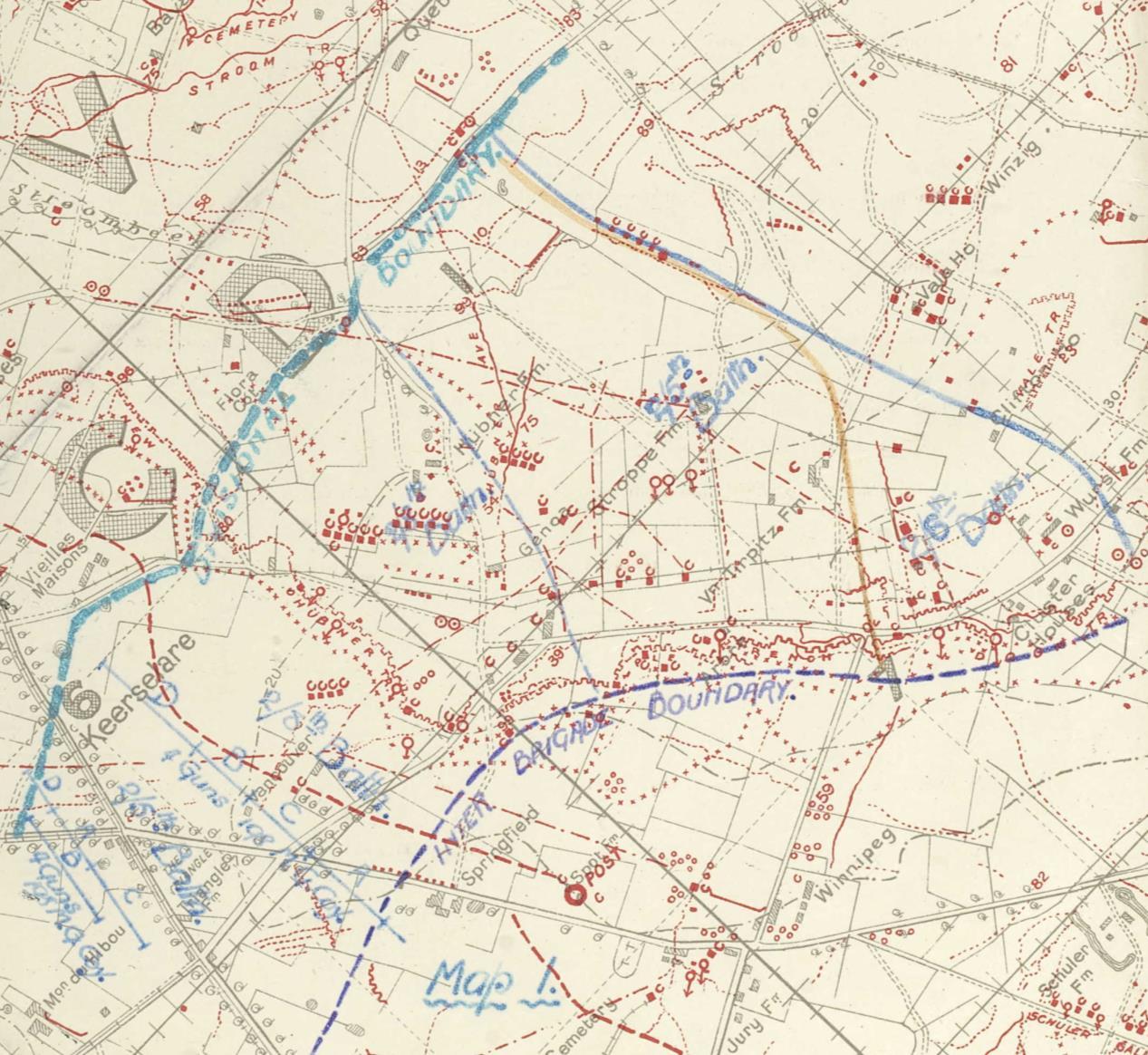
Gilbert is listed as one of the ‘missing’. His body was never retrieved and in all likelihood he lies today in the vicinity of Hubner Farm, the place where the battalion met with the greatest resistance. Gilbert is commemorated on the Ypres (Menin Gate) Memorial.
633 TNA WO 95 3005 2 634 Figures from TNA WO 95 3003 1 3
17. the ‘93’ and their stories 306
Manning, Lt George Alfred MC 26 September 1917, Potijze SPS 1904 1908
438th (Cheshire) Field Company, Royal Engineers Tyne Cot Memorial Panel 8 Age 26
George was born on 29 May 1891 in Calcutta, the only son of James Manning and his wife Louisa. (James was the proprietor of Spencer’s Hotel in Calcutta; by the time of the 1911 census the family was resident at Wilmington Lodge, Hassocks, Sussex and James is described as ‘retired’, aged 47.) During his time at SPS, George was a member of the O.T.C. and a boarder in Mr Armitage’s and Loane’s House. One who knew him at SPS reflected that:
Manning was one of those cheerful, helpful boys whom everyone likes. He took his full share in games and work, and was a thoroughly good influence. In his case, as in many others, the stern stress of war called out the splendid qualities underlying his gentle demeanour; and it is no surprise to those who knew him well to hear of his heroic conduct in the field.635
After leaving SPS in 1908 George proceeded to Birmingham University for Mining (1908 1909) followed by a period of study at the Technical College of South Kensington (1909 1911). In 1912 he entered as a pupil of the London, Brighton and South Coast Railway. In October 1915 he obtained a commission in the Royal Engineers as a 2nd Lieutenant in 438th (Cheshire) Field Company. George departed for France and Belgium on 21st November 1916. He was wounded in April 1917. The nature of his injury is not recorded, though he had recovered sufficiently to participate in operations in the Arras sector for which he was awarded the Military Cross on 15 June 1917. The award recognised George’s:
Conspicuous gallantry and devotion to duty under very heavy shell fire. He reorganised and collected his men, who had been scattered by heavy barrage on their way to wire the defences of a position, and his fearlessness and splendid example enabled that work to be carried out successfully, though constantly interrupted by shell fire.
On 26 September 1917 the 438th (Cheshire) Field Company was attached to 8th Brigade, 3rd Division. The 438th Field Company was located at Littlewood Camp, Ypres between 6 17 September, undergoing training in preparation for the offensive action planned for 26 September. (The 3rd Division was to participate in an attack on Zonnebeke with two Brigades, one the 8th Brigade in the sector immediately north of the Ypres Roulers
17. the ‘93’ and their stories 307
railway, and the other the 76th Brigade in the sector immediately south of the Ypres Roulers railway line.)
Map showing the objectives of 3rd Division. The 8th Brigade was detailed to take the Blue Line (visible on the right), running some 850 yards north east from the Railway Station at Zonnebeke, along which length was the important Hill 40.636 (Mill Cott see text below is shown in the top left hand corner.)

The unit diary records the various activities in which the Company participated 6 17 September:
Musketry; two days pontooning and use of [?] Trestle; two days rapid wiring; two days knotting and lashings and use of spars; two days erection of [?] Shelter and close order drill / handling of arms. Use of explosion one day.637
Having moved to billets in Vlamertinghe on 19 September the Company laboured on erecting Nissen Huts in Hutted Camp No. 2 Area before moving to billets in Ypres on 23 September, from which place three Sections were employed in work on a crossing for tanks at D.26.a.5.3 (i.e. the watercourse known as the Hanebeek, running diagonally across this sector south east to north east from just north of the Ypres Zonnebeke road) and one Section was improving the road at C.30.b., halfway along the Ypres Zonnebeke road. The Company continued in these activities during the next two days in readiness for the forthcoming offensive, scheduled to begin at 5.50 am on 26 September. On that day the Company diarist recorded that:
Two Sections and one Company of Pioneers were attached to the 8th Infantry Brigade for operations and to construct three Strong Points. One of these was unfinished. Two Sections 636
TNA WO 95 1418 1 4 637 TNA WO 95 1403 3
17. the ‘93’ and their stories 308
under the orders of the CRE 3rd Division were employed on continuing construction of H and K tracks to the front line.638
The diary records that George was killed at Mill Cott, the victim of an ‘enemy rifle bullet’.639
On 26 September Mill Cott was about two and a half miles distant from the front line. For this reason it was used as rear Brigade Headquarters and, at the time that George was killed, it was also being used by 8th Trench Mortar Battery, then in reserve. This explains why Mill Cott attracted enemy fire the ‘enemy rifle bullet’ was most likely an element of a German machine gun barrage counter attack. The fact that George was killed at Mill Cott also suggests that he was working on improving communication tracks to the front rather than the construction of Strong Points. His body was lost in the mired ground and he is thus commemorated on the Tyne Cot Memorial.
17. the ‘93’ and their stories 309
Chester, Private George Frederick Grove 228088 29 September 1917, Tower Hamlets SPS 1887 1893
1/1st battalion (City of London) Regiment, attd 10th (Service) Bn. Royal Fusiliers Tyne Cot Memorial Panel 148 150 Age 40
George was the son of George Frederick Chester and his wife and Catherine Constance Chester. Nothing is known about George’s career at SPS. In 1911 he is described in the census of that year as a ‘bank clerk’, married to Elizabeth and resident at 43 Stanton Road, Wimbledon. At that the couple had two children, George Frederick Chester and Mary Isobel Chester, aged 4 and 2 respectively. In the first instance George served as a Private (205429) in 1/24th battalion London Regiment, at some point transferring to 1/1st battalion (City of London), in which he also served as a Private.
At the time of his death George was attached to 10th (Service) battalion, Royal Fusiliers, a unit in 111th Brigade, 37th Division. On 27 September 37th Division relieved the 39th Division in the sector of line running south from the Ypres Menin Road in front of Bass Wood Stout Wood Bitter Wood. At 4.30 pm on that day 10th (Service) battalion Royal Fusiliers, at that moment in Dranoutre, received instructions to move by bus at 5 pm into the Front Line [in front of Tower Hamlets] and to relieve the 13th battalion Royal Sussex. By 2.15 am on 28 September and the battalion was in line in an:
Outpost Line: posts at J.21.c.25.05; J.21.c.43.25; J.21.c.57.30; J.21.c.57.50. [i.e. about 200 yards south west of Tower Hamlets.] Posts 14 men and 1 Lewis Gun. 63rd Bde (4th Middlesex) on our right; 13th Royal Fusiliers on our left. Communication difficult no wires back. The employment of Runners forward was almost impossible during the day pigeons were used. Patrol investigated Tower Trench and found it unoccupied by the enemy.640
George’s status as a Private means that he is not mentioned by name in the battalion diary. Nonetheless, George’s obituary in The Pauline indicates that he was in the Lewis Gun Section and is thus perhaps the ‘1 Lewis Gun’ referenced in the diary entry above.641 Although the 37th Division diary pronounces ‘nothing to report’ on the day that George died, the unit to which he was attached was at work developing the posts in front of Tower Hamlets, a dangerous business by any standards.642
640
TNA WO 95 2532 1 3 641 The Pauline 239 June 1918 p 67 642 TNA WO 95 2514 1 6
17. the ‘93’ and their stories 310
29 September. New Posts dug at J.21.c.40.55 and J.21.c.42.45. Also at J.21.c.35.15. Old German wire used as obstacles for posts. Connection with 4th Middlesex by post at J.27.a.12.97. Also advanced post at J.21.c.57.13. Thus making 10 posts. Patrols discovered enemy at J.27.a.3.8; J.21.c.8.2; J.21.d.15.60. Enemy and machine guns and snipers active. Bright moonlight nights made work difficult. Shelling heavy in neighbourhood of Bn HQ [J.20.d.20.65], which was on enemy barrage line. … Lewis Guns in posts, 2, 3, 4, 5, 6, 7; remainder at Company HQ.643
Map showing the section of line held by 111th Brigade at 6 am on 4 October, at which time there had been no appreciable change from 29 September. The round dots represent outposts. Tower Trench is shown running along the Red Line (the purported front line). The Menin Road is shown running across the top right hand corner.644

George was most likely killed while manning a Lewis Gun from one of the outposts south west of Tower Hamlets. He was probably a victim of either machine gun or sniper fire, both of which were described by the battalion diary as ‘active’ on 29 September. His body was lost and he is commemorated on the Tyne Cot Memorial.
17. the ‘93’ and their stories 311
Chetham-Strode, Captain Edward Randall 1 October 1917, Polygon Wood SPS 1906 1909
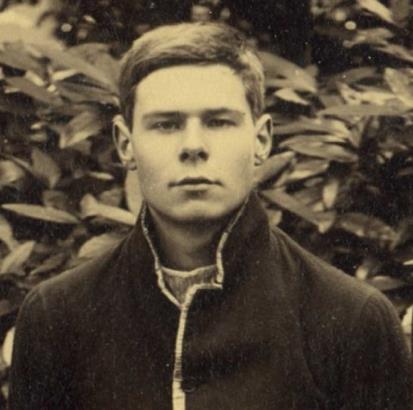
3rd (Reserve) Bn. Border Regiment, attached 2nd Bn. Border Regiment Tyne Cot Memorial Panel 85 to 86 Age 26
Edward Randall Chetham Strode645
Edward was the elder son of Dr. Reginald Chetham Strode and his wife, Fanny Antonetta.646 During his time at SPS (1906 1909) Edward was a member of the 1st XI in 1909, being a good wicketkeeper and a fine left handed bat with an average of 17.647 He is described in the 1911 census as a ‘Fruit farm student’, resident at 12 Harold Terrace, Battle, Sussex. At some point he went to Australia to be a stockbreeder but returned in April 1914. At the outbreak of war he was gazetted to the 3rd (Reserve) battalion, the Border Regiment; and on 13 January 1915 left for the front, attached to the Duke of Cornwall’s Light Infantry. After three months he returned to England, hospitalised at No. 2 General Hospital for ten days for treatment of tonsillitis.648 By 1916 Edward was attached to 2nd battalion Border Regiment. Promoted to Captain by July 1916, he was wounded on 28 June and admitted on 1 July to No. 34 Casualty Clearing Station, the admission record stating that he suffered a gunshot wound to the face.649 Edward had recovered sufficiently to be able to return to service with 2nd battalion Border Regiment in January 1917.
645
646
Edward’s younger brother, Warren, also fought in the war, in the same regiment as Edward. Warren died in 1974, having become a famous author and playwright; his most well known work was The Guinea Pig (1946). Warren did not attend SPS.
647 Renshaw, A Wisden on the Great War: The Lives of Cricket’s Fallen 1914 1918 p 315 648 MH 106/1023
649 MH 106/749
17. the ‘93’ and their stories 312
At the time of Edward’s death, recorded as 1 October by Commonwealth War Graves Commission materials, 2nd battalion Border Regiment was a unit in 20th Brigade, 7th Division. The battalion diary for this date states that:
1 October. The Battalion marched from camp near Reninghelst to camp near Dickebusch, arriving about 7.30pm.650
In a detailed and thorough battalion diary that frequently references by name officers killed, it is highly surprising that Edward is not similarly recorded perhaps especially so since he seems to have acted as Adjutant in May 1917, his signature signing off the diary for that month. The entries before and after 1 October are similarly brief and provide no clue as to Edward’s fate:
30 September. The battalion detrained at Abeele at 4 am and marched to camp near Reninghelst, arriving at 6 am.
2 October. The battalion marched to dugouts on Western side of Zillebeke Lake.651
As an officer in 2nd battalion Border Regiment, if Edward had been killed on any one of these three days, perhaps a victim of random shelling of rear areas, not only is it expected that he would have been named by the diarist but also, in light of the fact that the entries on those days are brief to the point of curtness, it is not unreasonable to suggest that the diarist had time and opportunity to reference Edward’s death. Moreover, if Edward had been killed on 1 October (the battalion then being in camp and a significant distance from the front line) it is peculiar that he is commemorated only on the Tyne Cot Memorial Panel there surely would have been a body; and he surely would have been buried in a location local to the camp before the battalion moved off to the front at 10.30 pm on 3 October. This, then, begs the question as to whether Edward was perhaps killed on a date other than 1 October. Indeed, Edward’s British Army World War I Medal Rolls Index Card records his death as having occurred on 10 October.652 Yet the battalion diary entry for this day too provides no evidence to support any such suggestion, simply stating that:
The battalion marched to Canora camp in the Westourtre area, arriving about 7.30pm.653
650
TNA WO 95 1655 1
651
652
TNA WO 95 1655 1
Medal Rolls Index Card. Ancestry.com. UK, British Army World War I Medal Rolls Index Cards, 1914 1920
653
TNA WO 95 1655 1
17. the ‘93’ and their stories 313
All in all, it seems probable that Edward was killed on a date other than either 1 October or 10 October, most likely at some point between 4 October (when the battalion went into line) and 7 8th October, when the battalion was relieved. Moreover, the fact that Edward’s obituary was published in the Middlesex County Times on Saturday on 13 October presumably upon the sponsorship of his family narrows the date his death to within the first two weeks of October.
At 6 am on 4 October the battalion took part in the renewal of the offensive that had begun on 31 July. On 29 September 7th Division issued instructions detailing that the role of 7th Division in this attack was ‘to seize the high ground in the vicinity of Noordemhoek and Molenaarelsthoek’.654
Map from 7th Division diary showing the sector of front held by 2nd battalion Border Regiment on 4 5 October.655

The 2nd battalion Borders diarist records that on 3 October: 654
TNA WO 95 1633 1 4 655 TNA WO 95 1633 1
17. the ‘93’ and their stories 314
The Battalion remained at Zillebeke Lake till 10.30pm when it moved up to assemble for the attack. The role of the battalion was to leapfrog the 8th Devon Regt on the Red Line and to take the blue line from J.13.a.35.95. to J.6.c.2.6 and to mop up the ground between the Red and the Blue lines covered by the front companies. A and B were the attacking companies. C Coy "moppers up" and D Coy in reserve.656
The outcome of this assault was successful but, as related by the relevant unit diaries, it was achieved in the context of some considerable chaos. The bogginess of the ground, combined with the impediment posed by enemy wire, meant that even before the assault had opened on 4 October ‘the troops [were] much disorganised before the start of the attack’.657
It thus seems probable that Edward’s body lies somewhere in the vicinity of Noordenhoek, about half a mile from the northwestern edge of Polygon Wood, a casualty of the fighting that took place in this area, as well as a casualty of the difficulties of recording accurately the deaths of combatants. Nonetheless, it is highly unusual for war diaries to fail to record accurately soldiers killed. Thus, another explanation presents itself for the absence of detail relating to Edward in 2nd battalion Border Regiment diary: that is, that he was temporarily attached to another unit, and it is this detail which had not been recorded. 656 TNA WO 95 1655 1 657 TNA WO 95 1655 1
17. the ‘93’ and their stories 315
Langworthy, Lt William Southmead 4 October 1917, nr. Polderhoek SPS 1910 1912
1/7th Bn. (Cyclist) Devonshire Regiment, attached 1st Bn. Devonshire Regiment658 Tyne Cot Memorial Panel 38 to 40 Age 22
William was the elder son of Captain William Southmead Langworthy, M.R.C.S., L.R.C.P., and Ethelind Marian Langworthy of Brock's Holt, Galmpton, Brixham, Devon. Prior to joining SPS in 1910, William was educated at Plymouth College. After leaving SPS William became a mining student at Camborne, Cornwall. He joined the Honourable Artillery Company on 8 March 1915 and obtained a commission on 2 July 1915 in the 1/7th battalion (Cyclist) Devonshire Regiment. He was promoted Lieutenant in December 1916. William served in France from 2 May 1917.
At the time of his death William was attached to 1st battalion Devonshire Regiment, a unit in 95th Brigade, 5th Division. The overall objective of the 5th Division was to advance the front on 4 October in the sector east and south east of Polygon Wood. It was detailed:
To capture of the spur south west of Reutel and the eastern slopes of the Polderhoek Spur; to cover the communications of 21st Division on our left across Polygon Beek; and to assist that Division in the capture of Reutel.659
Two days earlier the battalion had moved from Meteren to Canal Bank, Ypres. It had departed from Meteren at 7 am on 2 October and travelled by bus to Ridgewood. After revictualling at Ridgewood, at 2 pm it marched, via Bellegoed Farm and Bedford House, to Canal Bank (I.26.c), north of Ypres, arriving about 4 pm, where it relieved the 10th battalion West Riding Regiment, 69th Brigade, 23rd Division. The battalion remained at Canal Bank until 2 pm on 3 October, when it moved forward to Brigade Headquarters at Sanctuary Wood, arriving about 5 pm. It remained in this location until about 8 pm, when it moved forward to assembly positions in J.15.b and d, in the vicinity north and south of the head of the Reutelbeek. The effective disposition of units was eased by planning and strict discipline insisted on in a Brigade Order of 2 October:
658 William’s Medal Rolls Index Card suggests that he was with 1/7th battalion Devons at the time of his death, but a plaque erected by his parents in Modbury Church Devon makes it clear that he was attached to 1st battalion Devons, confirmed by the WO 95 diary of that unit.
659 TNA WO 95 1576 1 2 95th Brigade Operation Order no. 277, 2 October 1917
17. the ‘93’ and their stories 316
A very careful reconnaissance of assembly positions must be made by Company Officers, and the assembly must be carried out in absolute silence, special precautions being taken that the assembly of troops is not detected in the moonlight. Care will be taken that helmets are dulled or covered and bayonets will not be fixed until just before Zero [House], when they will be fixed silently.660
All Companies were in position in the front line by about 12 midnight 3 4 October, some 550 yards south of Polygon Wood, in the sector of line facing Polderhoek Chateau. Battalion HQ was in located at Fitzclarence Farm. The unit was thus disposed as detailed, ready for Zero Hour 6 am on 4 October, despite a dramatic incident as it made its way into position:
On the way up from Sanctuary Wood to battalion HQ it is regretted that the Commanding Officer, Lt Colonel D H Blunt and the Adjutant, Captain Sir B. R. Williams Bt, were killed. Captain F Wells assumed temporary command of battalion pending the arrival of Major R H Anderson Morshead who arrived about 7 am, 4 October.661
At 6 am the artillery opened up their creeping barrage, starting 150 yards ahead of the jumping off line and at Zero plus 3 minutes moved forward 200 yards, at 100 yards in 4 minutes, eventually forming a protective barrage in front of the objective. This was accompanied by a creeping machine gun barrage, conforming with the artillery creeping barrage.
The 95th Brigade diary recorded events thus:
At 6 am the barrage which our guns put up made the enemy’s fire appear slight by comparison. The assaulting troops went over in splendid order. The ground was very badly cut up by shell fire and very boggy, but the men negotiated it and kept well under our barrage.662
In fact, men in 1st battalion Devonshire Regiment do not seen to have been entirely successful in ‘negotiating’ the challenges of the terrain, as is made clear by a Summary of Operations report:
The 1st Devonshire Regiment, the right assaulting battalion of the left Brigade, advanced with one Company north and 3 Companies south of the Reutelbeek. [Unfortunately it is not known to which Company William belonged.] The Companies moving south of the
660
TNA WO 95 1576 1 2 95th Brigade Operation Order no. 277, 2 October 1917
661
662
TNA WO 95 1579 3 2
TNA WO 95 1576 1 2
17. the ‘93’ and their stories 317
Reutelbeek found the ground between it and the swamp in J.16.c so sodden as to be impassable and were forced to swing to the right in order to pass round the southern end of the swamp. In so doing some of them became mixed up [with the battalion on the right] … The Company which advanced north of the Reutelbeek was unable to pass the bog at the southern edge of Cameron Covert.663
The 5th Divisional History provides a harrowing description of the ground which:
[Was] at best wet and low lying, and intersected by many streams and ditches, was now a morass. The intensity of the shell fire had destroyed everything, and the whole country was a vast wilderness of mud, water logged shell holes, and lakes, with here and there the shattered stumps of trees marking where once had been woods. No vestige of a building remained anywhere. The roads had been destroyed, and in place of them plank roads had been made across country ... once off these roads vehicles sank up to the axles in mud ... For the movement of dismounted troops "duck board" tracks had been laid for miles across country. These tracks were narrow, and movement among them in the dark was difficult, especially as, when two bodies of troops met, one had to leave the track and flounder in the mud at the side. Enormous water filled craters were everywhere, and into these many men fell. At best this meant a ducking in filthy water, but in some case, men, weighed down by their equipment, were drowned.664
Actuality thus laid lie to some intelligence notes published ahead of the attack, in which it was stated that:
The ground presents no formidable natural obstacles. [The] going should be extremely good on the high ground, and though the low ground is wet in places, and the the Reutelbeek is broken up by shell fire, it should not be difficult to make headway.665
Despite these difficulties, the left Company, and a portion of the right, of 1st battalion Devonshire reached their objectives on the morning of 4 October but:
Owing to heavy rifle and Machine Gun fire from a strong point to the right (Polderhoek Chateau) were forced to fall back on a line J.16.a.5.1 J.16.c.7.5 [roughly along the western edge of Chateau Wood], which line was consolidated during the afternoon and evening.666
The battalion suffered a total of 302 casualties:
663
TNA WO 95 1515 1 3 Summary of operations of 5th Division 4 11 October 1917 664 Hussey, A H, The Fifth Division in the Great War (London, 1921), pp. 175 176 665 TNA WO 95 1515 1 3 Preliminary intelligence notes compiled from recent summaries 666 TNA WO 95 1579 3 2
17. the ‘93’ and their stories 318
Killed: 4 officers; 52 ORs Wounded: 5 officers; 189 ORs Missing: 2 officers and 50 ORs667
Willliam is one of the 4 officers listed. His body was never found. An anonymous source contributed this description of William’s fate in his obituary published in The Pauline: He was leading his platoon during the attack, and was carrying on in a very cool and collected manner, and quite regardless of hostile shell fire, which at times was very heavy, when he fell mortally wounded.668
In all probability William lies today in the vicinity of the western edge of Juniper Wood. He is remembered on the Tyne Cot Memorial.
Image showing the advance of the 1st battalion Devons and their final objective the Purple Line which ran in Juniper Wood, to the east of the road. William’s body most likely lies in this area.669 667 Figures from TNA WO 95 1579 3 2 668 The Pauline, 236 Dec 1917 p 182 669 Author’s photo
17. the ‘93’ and their stories 319
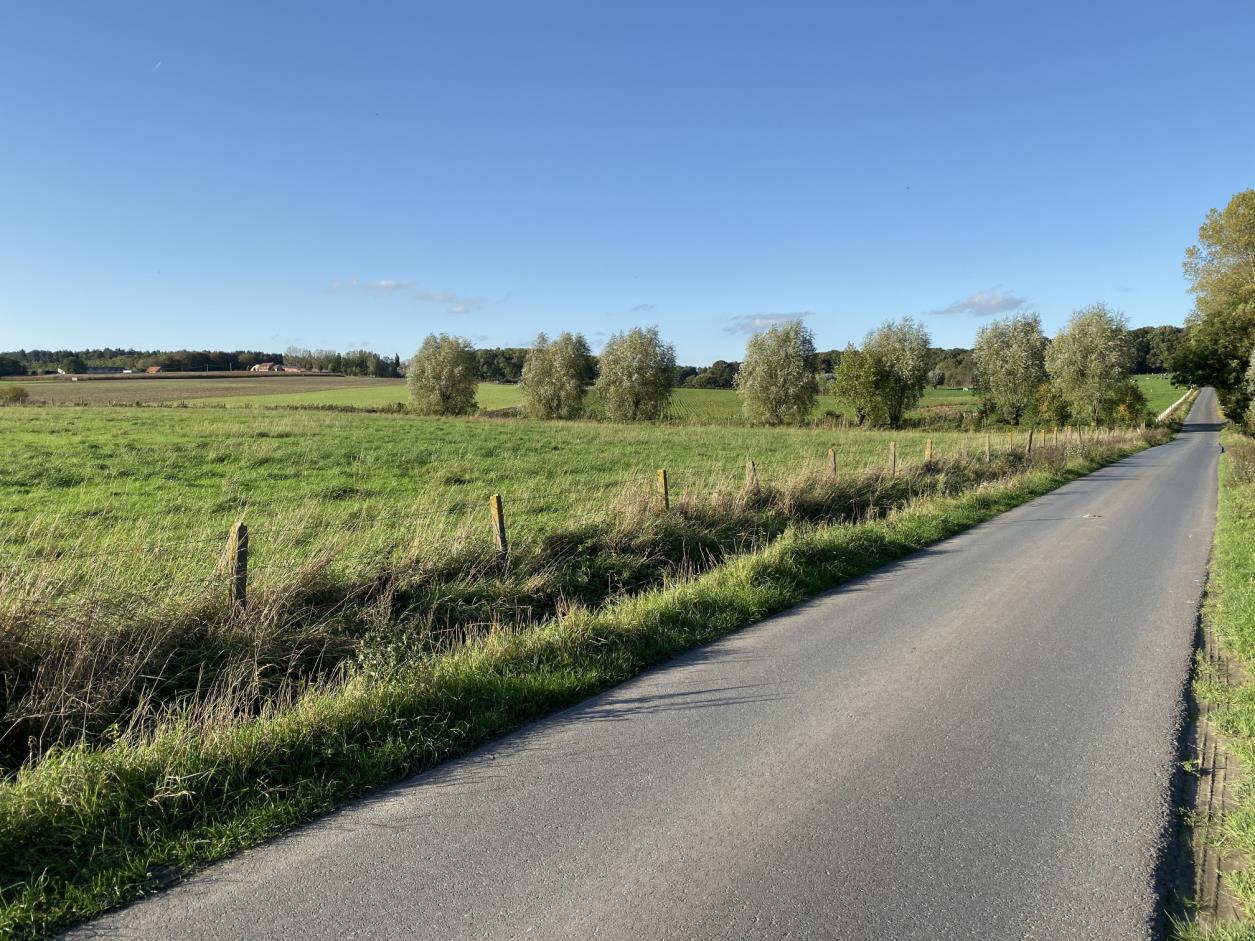 Reutelbeek
Juniper Wood
Line of advance 1st Devons
© GES
Reutelbeek
Juniper Wood
Line of advance 1st Devons
© GES
Image taken looking north from the base of the dip in the road, visible in the image above.670

William is remembered on the Tyne Cot Memorial.671
670
Author’s photo 671
Author’s photo
17. the ‘93’ and their stories 320
Reutelbeek Juniper Wood Polygonbeek © GES
Samuel, 2nd Lt Cecil Valentine 4 October 1917, St Julien SPS 1903 - 1905
1/8th Bn. Royal Warwickshire Regiment Duhallow A. D. S Cemetery I.D.30
Grave epitaph: Dearly Loved Son Of The Late J. Samuel And Lilla Samuel Age 28
Samuel was the son of Lilla Samuel of 14, Neville Court, Grove End Rd, St. John's Wood, London, and the late Jack Samuel. After leaving SPS he went to McGill University, Montreal. Samuel enlisted on 5 August 1914, transferred to the Universities and Public Schools Brigade, and went to the front in 1915. After serving in Flanders for six months he was sent home to take up a commission, and was gazetted to the Royal Warwick Regiment on 5 August, 1915.
At the time of his death, Samuel was serving in 1/8 battalion Royal Warwickshire Regiment (143rd Brigade, 48th Division.) On 30 September 48th Division received orders that it was to participate in a continuation of the offensive that had been initiated on 31 July.672 The 143rd Brigade was detailed to attack the enemy front north east of St Julien. The objectives were shown on the attack map as a Dotted Red Line and solid Red Line. Zero Hour was set for 6 am on 4 October.
Map showing the Red Dotted Line and Red Line that 143rd Brigade were detailed to take. The solid green lines show the Brigade boundaries; the dotted green lines show the battalion boundaries. The disposition of the 1/6th, 1/7th and 1/8th battalions Royal Warwicks are shown albeit in very faint hand in their starting positions. Practically all the places named in the 1/8th battalion diary narrative of events (see below) are visible. By the mid afternoon a heavy storm of rain and darkness made further operations impossible and the position held at dusk on 4 October is shown by the blue dotted line.673
672 TNA WO 95 2746 1 3, 48th Division Order No. 219 673 TNA WO 95 2754 1 5
17. the ‘93’ and their stories 322
The 1/8th battalion Royal Warwicks was to be in reserve with 1/5th, 1/6th and 1/7th battalions Royal Warwicks to be in the frontline on the right, centre and left respectively. As was now usual in the offensives of 1917, Zero Hour was to herald the start of creeping artillery and machine gun barrages.
Barrage map showing the incremental ‘lifts’ of the creeping barrage in 143rd Brigade sector.674
17. the ‘93’ and their stories 323

The role of the 1/8th Royal Warwicks was detailed in Operation Order No. 168:
[The] 1/8th Royal Warwicks will be in Brigade Reserve. Two Companies will move forward after Zero Hour, from positions in the rear of Arbre to previously reconnoitred positions about D.1.central and Von Tirpitz Farm. These two Companies will be used to counter big enemy counter attacks only and on no account to reinforce the line. The moment to act will be left to the discretion of the Officer in charge.675
There are particularly detailed accounts of the actions of 1/8th battalion Royal Warwicks in the battalion and Brigade diaries, the former of which is presented here:
4 October. The battalion moved forward to assembly positions in support of 143rd Brigade. At Zero Hour 6 am D Company moved forward to a position east of Von Tirpitz Farm. Battalion HQ and all Companies were under heavy shelling during the time they occupied these positions. At 1 pm C Company moved to the neighbourhood of Hubner Farm, and together with A Company, with Captain Arneel commanding both, was placed under the command of the OC 1/6th Royal Warwick Regiment. During the afternoon these two Companies attacked Burns House and Yacker Farm, but were held up by heavy Machine Gun 675 TNA WO 95 2754 1 5, 143rd Infantry Brigade Operation Order No 168, 2 October
17. the ‘93’ and their stories 324

fire. At 2 pm D Company moved up to Hubner Farm area. At 3.30 pm the battalion received orders to collect as many men as possible from the 1/6th, 1/7th and 1/8th Royal Warwickshire Regiment and push forward under a barrage commencing at 5 pm with the object of taking Burns, Yacker, Oxford and Berks Houses held by the enemy, [but] our men came under heavy fire and were unable to advance further than our present front line. A heavy rainstorm during the attack and darkness setting in made further operations impossible.
5 October. The battalion relieved the 1/6th battalion [Royal Warwickshire] at dusk. Also many of the 1/5th Gloucesters who were in our area, taking over the dispositions of both.
6 October. The battalion reorganised and found a number of men still unaccounted for. D Company holding front line; C Company support near Winchester Farm and A and B Companies in reserve just west of York Farm.
7 October. Support and reserve Companies heavily shelled all day long. The front line escaped lightly. The battalion was relieved at midnight by two Companies of the Bucks battalion, and marked to Irish Farm Camp.
8 October. Battalion moved by bus to Siege Camp. During the operations 2nd Lieut C V Samuel, Cheshire and Biston were killed. Captain Cornell and 2nd Lieuts Plag, Hand and Chadwick were wounded. Casualties in ORS were 140.676
Unfortunately it is not known in which Company Samuel served and so it is not possible to track his movements precisely, nor is it possible from the narrative as presented to determine on which day Samuel died. In all probability he was mortally wounded in the action on 4 October, extracted from the field of battle and taken to the Advanced Dressing Station at Duhallow on the Canal Bank, where he died at some point before midnight on 8 October. Samuel is buried in the cemetery at that site.
In Samuel’s obituary published in The Pauline, his Colonel wrote: ‘He was one of the most popular officers in the battalion. He never shirked any dangerous work, and was always very cool under shell fire. As you probably know, he was my signalling officer.’677
17. the ‘93’ and their stories 325
Fink, Captain Lawrence Alexander Lewis MC 5 October 1917, Hollebeke SPS 1905 1906
2nd Bn. Bedfordshire Regiment Kemmel Chateau Military Cemetery M. 17
Grave epitaph: In The Sight Of The Unwise They Seemed To Die But They Are In Place Age 26
Born on 10 August 1891 in Lucknow, India, Lawrence was the son of Major George Herbert Fink (a Surgeon Captain in the Indian Medical Service) and Edith Louisa Fink.678 At the time of his death, Lawrence’s parents lived at 38 Onslow Gardens, Muswell Hill, London. After schooling at St Paul's School in West Kensington, Lawrence became a Rubber Planter in Java. At the start of the war he relinquished his position and obtained a commission in the Bedfordshire Regiment early in 1915. In the first instance he was appointed to the Special Reserve of Officers on 26 April 1915. Then, promoted to 2nd Lieutenant, he was posted to the 3rd battalion Bedfordshire Regiment for training. Lawrence arrived in France on 23 March 1916, attached to the 2nd battalion Bedfordshires (89th Brigade, 30th Division). Surviving several phases of the Battle of the Somme, Lawrence won the Military Cross for bravery for actions on 12 October 1916.679 His citation reads:
For conspicuous gallantry in action. He led his company forward with great courage and determination under intense fire, and succeeded in capturing about 200 yards of the enemy's trench680 .
On 24 June 1917 Lawrence took over command of C Company. He was killed on 5 October while the battalion was in line in front of Hollebeke. C Company was the disposed in the centre of the line, holding about 450 yards of trench running north east south west, with its left touching Hollebeke Church and its right on Forret Farm.681 The unit diary lists no
678 Lawrence’s twin brother (SPS 1905 1906) also fought. Ralph Havelock Lewis Fink served as a Captain in the West India Regiment and was awarded an MC. He survived the war. Ralph gets several detailed mentions in Cundall F, Jamaica’s Part in the Great War (1925) 679 Lawrence is not mentioned by name in the battalion diary entry for 12 13 October 1916. The unit was involved in an assault near Bazentin le Grand. The battalion suffered 252 casualties. The award was presented on 21 January 1917.
680 The Pauline Vol 34 No. 230 March 1917 p 2 681 TNA WO 95 2333 1 4. The battalion diary gives the exact coordinates thus: 1 Oct bn relieved 17th bn Manchester Regt less one Company, one Coy 16th Manchester Reft in the front line Hollebeke Sector about being relieved in Support Area by 19th bn Kings Liverpool Regiment. The bn took over the line from the Ypres Comines Canal to about O.6.c.70.40 to the Military Road O.11.d.45.13. DISPOSITIONS "B" Coy. (LEFT) took over from "C" Coy. 17th
17. the ‘93’ and their stories 326
other casualties on 5 October, suggesting that Lawrence was the victim of a sniper or perhaps random shelling. His body was removed to Kemmel for burial and he lies today in Kemmel Chateau Military Cemetery.
MANCHESTER REGT. CANAL O.6.c.70.40 to O.12.a.00.70 HOLLEBEKE CHURCH. "C" Coy. (CENTRE) took over from "A" Coy. 17th MANCHESTER REGT O.12.a.00.70. to O.11.b.20.10 and "A" Coy. (RIGHT) took over from "D" Coy. 16th MANCHESTER REGT O.11.b.20.10. FORRET FARM to O.11.c.45.13. "D" Coy. (SUPPORT) took over from "D" Coy 17th MANCHESTER REGT Coy. Headquarters at O.5.c.75.20. Relief complete at 11 p.m. Casualties 1 Other Rank Wounded.
17. the ‘93’ and their stories 327
Beamish, Private Earl Douglas, 594 11 October 1917, Broodseinde Ridge SPS 1902 1903
8th Australian Machine Gun Company Ypres (Menin Gate) Memorial Panel 31 Age 30
Earl Douglas Beamish was born on 12 March 1888 in Marylebone, London, the son of Henry and his wife Janet. Earl was a pupil at SPS 1902 1903. In 1912 he emigrated to Australia, where he was a horticulturist. He attested for service in Adelaide on 25 September 1916. Earl left Melbourne on 17 January 1917, travelling on R.M.S Ormah, arriving in England on 28 March 1917. After a period of training, Earl was assigned for service with the 10th reinforcement of the 8th Australian Machine Gun Company. He had been at the front for only a few days before his death.
During the first ten days of October 1917 the 8th Australian Machine Gun Company (8th Australian Brigade, 5th Australian Division) was in the Chateau Segard area near Ypres, resting, cleaning and overhauling equipment in preparation for 5th Division’s provision of defensive assistance to units detailed to participate in the attack later known as the First Battle of Passchendaele (12 October). On the evening of 10 October 8th Australian Machine Gun Company moved into the forward system of the Divisional Front, its 12 guns distributed along a line just to the east of the road running north south along the Broodseinde Ridge. (The gun positions were located in a line running north for about 1,000 yards from the crossroads at Molenaarelst. Left sector HQ was at D.29.c.60.97; right sector HQ at J.5.a.7.9 and Company HQ at Retaliation Farm, D28.d.6.7.)
Map of in 8th Australian Machine Gun Company machine gun positions on 11 October 1917.682
17. the ‘93’ and their stories 328
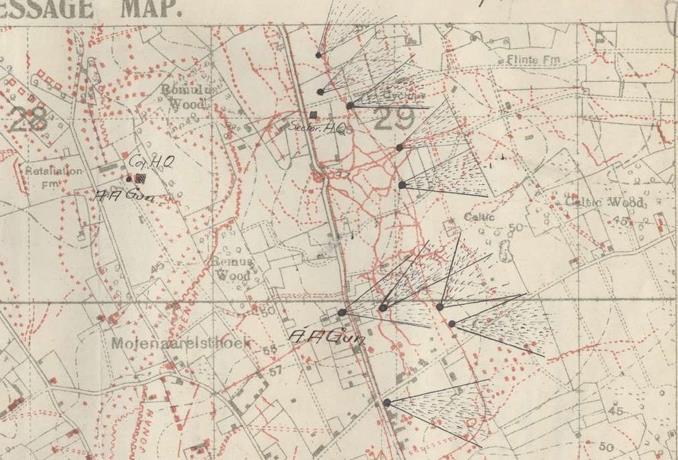

Between 7 and 9 am on 11 October two of the gun positions were blown in, wounding four Other Ranks and killing four others, one of whom was Earl.
Descriptions of Earl’s death are found in records gathered by Red Cross Commissioners, acting in response to an enquiry by Earl’s wife, Ethel Maud. One correspondent, Pte. A. Hill, 598, reported that:
I was told by Private Joe Buchan of No. 3 Section [8th AMGC] who know Beamish, that he was close by him when a shell burst and killed Beamish … This was about the 11th October. Beamish was buried by the shell and when he was dug out there were only portions of him found.683
Pte J Buchan, 3rd Section 8th A.M.G.C, had tried to dig out Earl but had to give it up. Buchan reported directly that:
[Earl] was buried on the battle field and a cross was placed to mark the spot where he was buried. … I can assure you that the report that No. 594 Pte. E. D. Beamish having been killed in action on the 11 October 1917 is absolutely correct and I am very sorry to be able to say so.684
A further witness, Sgt Rushworth, reported that:
Concerning Pte E. D. Beamish, 594, 8th Aust. M. G. Coy, killed in action on 11 October 1917 I have obtained the following information from No. 231 Pte. L. L. Barnett, 8th M. G. Coy, who was present at the time. Pte. Beamish and a Cpl of his section were killed instantaneously about 5 am by a shell close to their gun position and buried there. (In the field, not a soldiers’ cemetery.) A wooden cross with particulars of Pte. Beamish was erected. The position where he was killed and buried would be approximately about 200 yards behind the front line at that time and on the right edge of Passchendaele Ridge and about ¼ (or a little more) mile to the left [right?] of Zonnebeke Village (facing the German line.)685
It thus seems clear that Earl was killed by a shell and that he was buried in the place where he fell, somewhere in the line populated by 8th Australian Machine Gun Company just to the east of the road running north south along the Broodseinde Ridge. (Rushworth’s reference
683 South Australian Red Cross Information Bureau SLSA 76/1/4733 Private A. Hill. 598. 4 Section, 10 January 1918.
684 South Australian Red Cross Information Bureau SLSA 76/1/4733 Letter from Private J.S. Buchan, 24 January 1918
685 South Australian Red Cross Information Bureau SLSA 76/1/4733. Sgt Rushworth, C. W, C Coy, Orderly Room, A.N.G.T.D, Belton Park, Grantham, 5 July 1918
17. the ‘93’ and their stories 330
to the ‘left’ of Zonnebeke Village would seem to be erroneous it is inconsistent with his description referencing ‘the right edge of Passchendaele Ridge’ and it would seem he most likely meant to reference ‘right’.) Earl’s grave was likely destroyed in later fighting and the body lost.
An undated note authored by the C.O 8th Australian M.C.Coy in Earl’s service papers confirms that he was killed by a shell but provides a map reference for his grave that is inconsistent with all the other available evidence.
On 11 October 1917 No. 594 Pte Beamish E. B. was asleep in a dugout in Chateau Wood near Ypres when a shell hit the dugout and killed him instantly. His grave is at Chateaux Wood. The only Map Ref available is part of sheet 28 Ypres, vicinity Westhoek J.13.a.45.95, 2,300 yards to [the] south west of St Gravenstafel, Belgium.686
The assertion that Earl’s grave ‘is at Chateaux Wood’ must be judged erroneous; and it should be noted also that this location is some 5,300 yards from Gravenstafel rather than the 2,300 stated. Sadly, this documentation seems to have led to the post war searches for Earl’s body by the Imperial War Graves Commission to have been undertaken in the wrong location.
An unsigned letter from the officer i/c Base records was sent to Earl’s wife confirming that the grave had been lost:
Adverting to my communication of 20 March 1919 in which you were advised that your husband, the late No. 594 Private E. D. Beamish, 8th Machine Gun Company, was buried in Chateau Wood, I very much regret to advise you that the London office now state that although searches and investigations have been made [by the Imperial War Graves Commission] it has not been possible to locate the soldier’s grave. Failing the recovery and identification of the actual remains it is the intention of the authorities to perpetuate the memory of these fallen by means of collective memorials on which the soldier’s name and regimental particulars will be inscribed.’687
Earl is commemorated on the Ypres (Menin Gate) Memorial.
686
687
NAA: B2455, BEAMISH E D, p 15
NAA: B2455, BEAMISH E D p 18. Unsigned letter dated 11 May 1922.
17. the ‘93’ and their stories 331
Marshall, Lt Kenneth Edward Dix 12 October 1917, Passchendaele SPS 1905 1907
38th Bn. Australian Infantry Force, C Company Ypres (Menin Gate) Memorial Panel 7-17-23-25-27-29-31 Age 26
Kenneth was born on 11 September 1891in Chirbury, Shropshire. He was the son of J D Marshall and his wife, Norah. During his time at SPS he was a border in Mr Watkin’s House. After leaving St Paul’s Kenneth appears to have travelled to New Zealand, but by 1911 if not before he was back in England. In 1911 the Census of that year records his profession as that of ‘Articled Pupil (Auctioneer)’, at that time serving a prison sentence in His Majesty’s Prison in Shrewsbury. Kenneth’s crime appears to have been widely reported in the newspapers.
The remarkable story of an auctioneer’s pupil’s theft of £268 from his father’s firm’s safe came before Mr. Justice Lawrence at Shropshire Assizes on Wednesday last when the prisoner, Kenneth Edward Dix Marshall (19), pleaded guilty to breaking open the safe of Messrs. Morris, Marshall and Poole, at Chirbury, of which firm his father is a partner, and stealing the sum named.688 When arrested by the police at Gloucester, where he was a pupil, Marshall was wearing a belt with a pouch containing a fully loaded revolver, and two other revolvers were found at his rooms. He admitted the robbery, saying “I did do it, and I had the week of my life. I went to Newmarket races and busted the notes. They will be turning up all over the country.” I enjoyed myself and must face the penalty. … Mr Disturnal, for the defence, said that Marshall acquired the habit of carrying revolvers in New Zealand. He was of an adventurous spirit, and took a fancy to read the sort of literature which suggested burglaries and crime as being desirable occupations for gentlemen. His Lord said he was there to correct the effect of that literature.689
Having served his sentence of six months it seems probable that Kenneth sought a fresh start in Australia, especially since he seems to have been already acquainted with antipodean ways. At some point he joined the 38th battalion (10th Brigade, 3rd Division, Australian Imperial Force.) This unit embarked on 20 June 1916 from Melbourne for England on board S. S. Runic.690 The battalion arrived at Plymouth on 10 August and entrained for Lark Hill Camp on Salisbury Plain. The unit arrived in France on 28 November 1916. In early
688 £268 has a value of about £10,000 in 2021. 689 Tenbury Wells Advertiser, 15 November 1910 690 Commissioned by the Australian government as a transport ship, this vessel was given the designation HMAT (His Majesty’s Australian Transport) ‘A’ 54.
17. the ‘93’ and their stories 332
October 1917 it was in the vicinity of Ypres, about to be deployed on a disastrous attack upon the village of Passchendaele, atop the ridge to the north east of Ypres.
The 38th battalion was detailed to capture Passchendaele in an attack scheduled for 12 October. After a period of rest 6 10 October in huts in the neighbourhood of Vlamertinghe, west of Ypres, on 10 October the battalion marched to Hussar Farm, on the south eastern edge of Potijze. It appears that tents were not provided and that consequently the men had to bivouac in the open.

Map showing the three objectives Red, Blue and Green. The jumping off line for 38th battalion is in the bottom left of the image.691
Barrage map. The barrage began at 5.25 am on 12 October and then proceeded forward at intervals.692
691 AWM4 23/57/19 Part 2 40th battalion diary 692 AWM4 1/46/12 Part 4 RCDIG1010927
17. the ‘93’ and their stories 333
The capture of Passchendaele was to be achieved in three phases: the first objective the Red Line 1,200 yards from the jumping off point; the second objective the Blue Line half a mile further on; and the final objectives the Green Dotted Line and Green Line some 400 yards beyond the village. Zero Hour was 5.25 am on 12 October, at which time a creeping barrage was to begin. The 10th Brigade was to attack on the left, bordering a small stream, the Ravebeek; the 38th battalion was allotted the final objective. The dismal effect of the barrage, the horrendous state of the ground and the fact the New Zealand Division on the left had failed to advance (ensuring that the 10th Brigade suffered devastating enemy enfilading fire), meant that by the late morning of 12 October the 38th battalion had retreated from roughly the Red Line back to its jumping off point. The unit had thus advanced at its greatest extent perhaps no more than 300 yards towards its objective, detailed at 3,000 yards remove.

The 38th battalion diary gives sharp details about the experience of the unit on that day: 12 October. The 38th battalion commenced the approach march at 10.45pm on night of 11 12 October. Soon after entering ‘K’ track we came under enemy shell fire which continued intermittently until assembly lines were reached. Our casualties during this time were considerable, particularly in the neighbourhood of the junction of ‘K’ track with [the] sunken road (running north through D.16.b).693 A fair amount of gas shell was used by the enemy in the low lying ground NE of Judah House but owing to high wind the effect was not very marked. The battalion formed up on its tapes about 3am in full order. … While waiting for Zero Hour the enemy shelling was severe and many casualties resulted. When our barrage came down we advanced in [the] rear of 40th battalion but soon came under heavy machine gun fire, particularly from the sector on our left about Bellevue. One party under Lt Munday
693 This track now forms the western edge to Tyne Cot Cemetery
17. the ‘93’ and their stories 334
worked its way across the Ravebeek and cleared three pill boxes but was stopped by heavy rifle and MG fire and during the next night had to rejoin [the] main body, which in the meantime had advanced to the Red Line, where 38th [battalion] joined remnants of 37th and 40th [battalions]. Casualties had been so severe that further advance was impossible, especially as the New Zealand troops on our left had failed to get forward. Consequently the senior officer present, Major Giblin (40th battalion), ordered a retirement to approximately [the] jumping off line and consolidated there at about 3 pm. In conjunction with the remainder of [the] Brigade, 38th battalion held this line until relieved on the night of 13 14 October by 41st battalion A.I.F, when 38th battalion moved back to bivouac at Hussar Farm. Total casualties were 14 officers and 368 ORs.694
Although the unit diary does not mention Kenneth by name he is referenced in the Australian Official History. This work states that after the units of 37th, 38th and 40th had become intermingled, Kenneth participated in the clearing of Augustus Wood in a mixed party led by Lieutenant Garrard of 40th battalion. If this is the action in which Kenneth fell then his body most likely lies in that place today, some 250 yards north of Tyne Cot Cemetery.695
The 40th battalion diary describes the operation against Augustus Wood:
A lot of machine gun fire and sniping came from Augustus Wood and nearly all D Company were used in mopping up this wood and the left flank, which were in the 37th battalion’s mopping up area. … In this mopping up all wave formation was lost. It the position of these strong points had been known beforehand they could have been taken with much fewer casualties.696
Kenneth’s body was never retrieved. He is commemorated on the Ypres (Menin Gate) Memorial.
The minute by minute timetable according to which the operation against Passchendaele was expected to adhere.697
694 AWM4 23/55/17, RCDIG1017877
695 Bean, C. E. W, Australian Official History, Vol IV, The Australian Imperial Force in France, 1917 p 914. Kenneth is mentioned in footnote no. 29, perhaps the result of some oral testimony received by Bean as he compiled the volume.
696 See entry for 12 October 1917, AMW4 23/57/19 Part 1, RCDIG1004009
697 AWM4 1/46/12 Part 4 RCDIG1010927
17. the ‘93’ and their stories 335

Davies, Captain Frederick Charles 17 October 1917, Pilckem
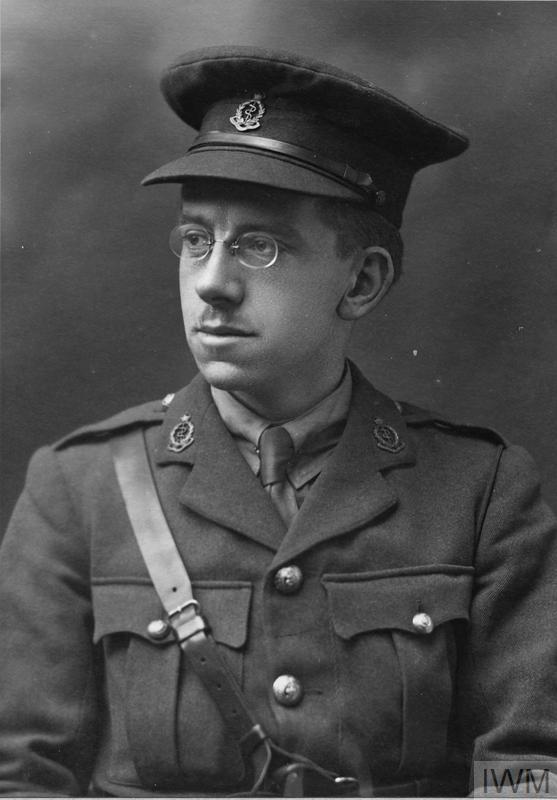
SPS 1898 - 1903
Royal Army Medical Corps, attached 9th (Service) Bn. Northumberland Fusiliers Talana Farm Cemetery III.K.3
Grave epitaph: El Gartref Yw Tangnefedd Duw Age 33
Frederick Charles Davies698
Frederick was the son of William and Ellen Davies. From St Paul’s he won a scholarship in 1903 to Downing College, Cambridge where he was a member of the College’s rugby team. Frederick studied the Natural Sciences Tripos, taking his degree in 1906. From Downing College, he proceeded to Charing Cross Hospital where he became House Surgeon (1909), House physician (1910), and Medical registrar (1912). Frederick went on to become Resident Medical Officer at Plaistow Fever Hospital, bacteriologist of West Ham County Borough in 1910, and Medical Officer of Battersea Tuberculosis Dispensary in 1912. When war broke out Frederick was tuberculosis inspector for Cambridgeshire and medical officer to the Insurance Committee for that county, in addition to carrying on his profession as a consulting physician at Welbeck Street. Frederick offered his services to the War Office and was commissioned on 10 August 1914 as Lieutenant in the Royal Army Medical Corps. Within a week he was at the front and promoted to Captain in 1915. He had published a number of works, and at the time of his death he was engaged on a very important treatise on trench fever. Latterly he was attached as medical officer to 9th (Service) battalion
17. the ‘93’ and their stories 337
Northumberland Fusiliers (103rd Brigade, 34th Division), with whom he was serving when he was killed near Pilckem on 17 October 1917.
The 9th battalion Northumberland Fusiliers had arrived at Putney Camp near Proven on 9 October 1917. For the following three days it carried out training for the forthcoming attack in the vicinity of Poelcappelle. At about 3.30pm on 12 October the battalion moved by train from Proven Station, arriving at Boesinghe one hour later. From this latter place it marched to bivouacs at Stray Farm, about half a mile east of Pilckem.
Map showing the locations of Boesinghe (top left hand corner) and Stray Farm (bottom right hand corner.)699
About 4 pm on 13 October the battalion departed Stray Farm to relieve 1st battalion The Rifle Brigade about half a mile to the north west of Langemarck. The battalion was deployed in support in Eagle Trench and Louis Farm. The terrain was wretched, as reported
17. the ‘93’ and their stories 338

in the war diary of 26th battalion Northumberland Fusiliers ‘conditions were very bad, country half flooded with water whole … area one sea of mud’.700 Nonetheless, at least the relief was ‘quiet’, and was completed at 7.30 pm. Over the next few days the battalion remained in support, located in Eagle Trench and the nearby Louis Farm.701
Map showing the locations of Eagle Trench and Louis Farm. (The Black Line shows the position of the front line on 2 September; by the time Frederick was in Eagle Trench / Louis Farm the line had advanced to just outside Poelcappelle.)702
Aerial view looking north west from Langemarck. Eagle Trench is shown bottom left; Louis Farm is in the centre. The white looking terrain is damage done to the landscape by heavy shelling.703
700
TNA WO 95 2467 2
701 Louis Farm is not mentioned in the 9th battalion NF diary but is mentioned in the 103rd Brigade HQ diary TNA WO 95 2465 1 35.
702 TNA WO 95 2097 1. Eagle Trench was taken on 23 September by 12th battalion King’s Royal Rifle Corps and 10th battalion Rifle Brigade, 59th Brigade and 60th Brigade, 20th Division.
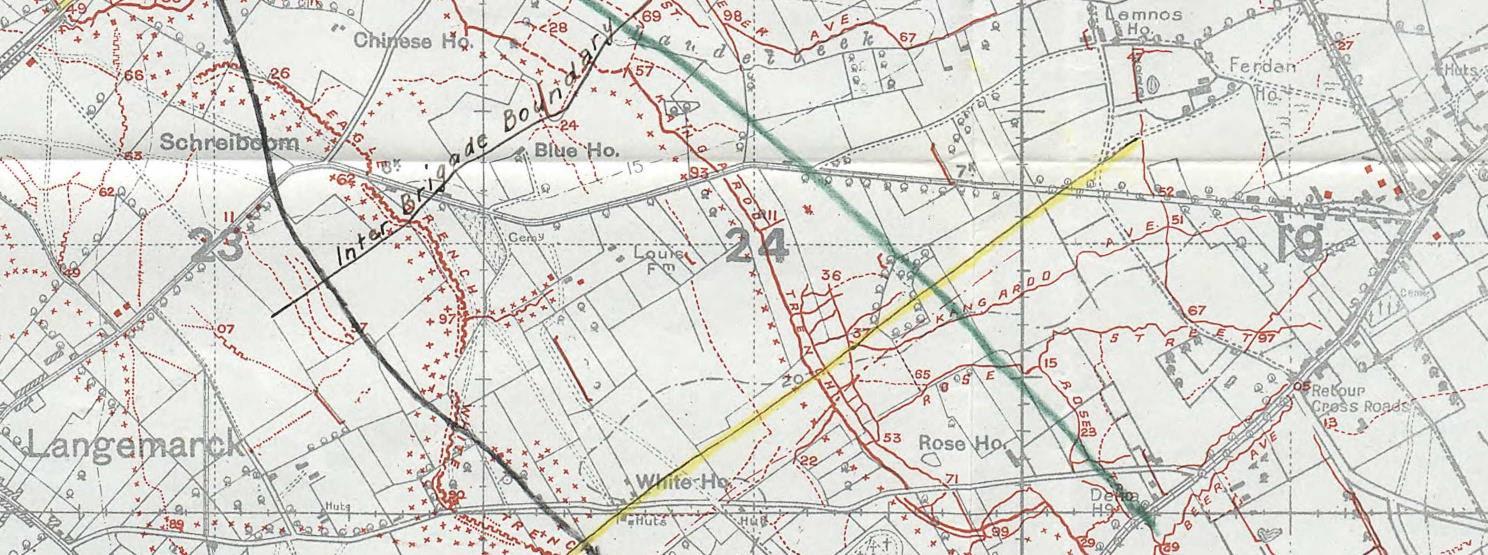
703 TNA WO 95 1496 5 1
17. the ‘93’ and their stories 339
©CrownCopyright
numbering in total 4 officers and 36 Other Ranks. On 16 October the unit was relieved and returned to Stray Farm, where it once again bivouacked. In contrast to the relief of a few days earlier, on this occasion conditions were rather more taxing. A total of 45 bombs were dropped by enemy aeroplanes on the Louis Farm area at 7 am.704 The diary of the relieving battalion recorded that: This relief was conducted under exceptionally trying circumstances owing to the lack of opportunities for reconnaissance of the positions to be taken over and also to guides losing their way through the total absence of landmarks and the extremely heavy shelling which the battalion went through on the way forward. There were many casualties and also a good deal of straggling.705
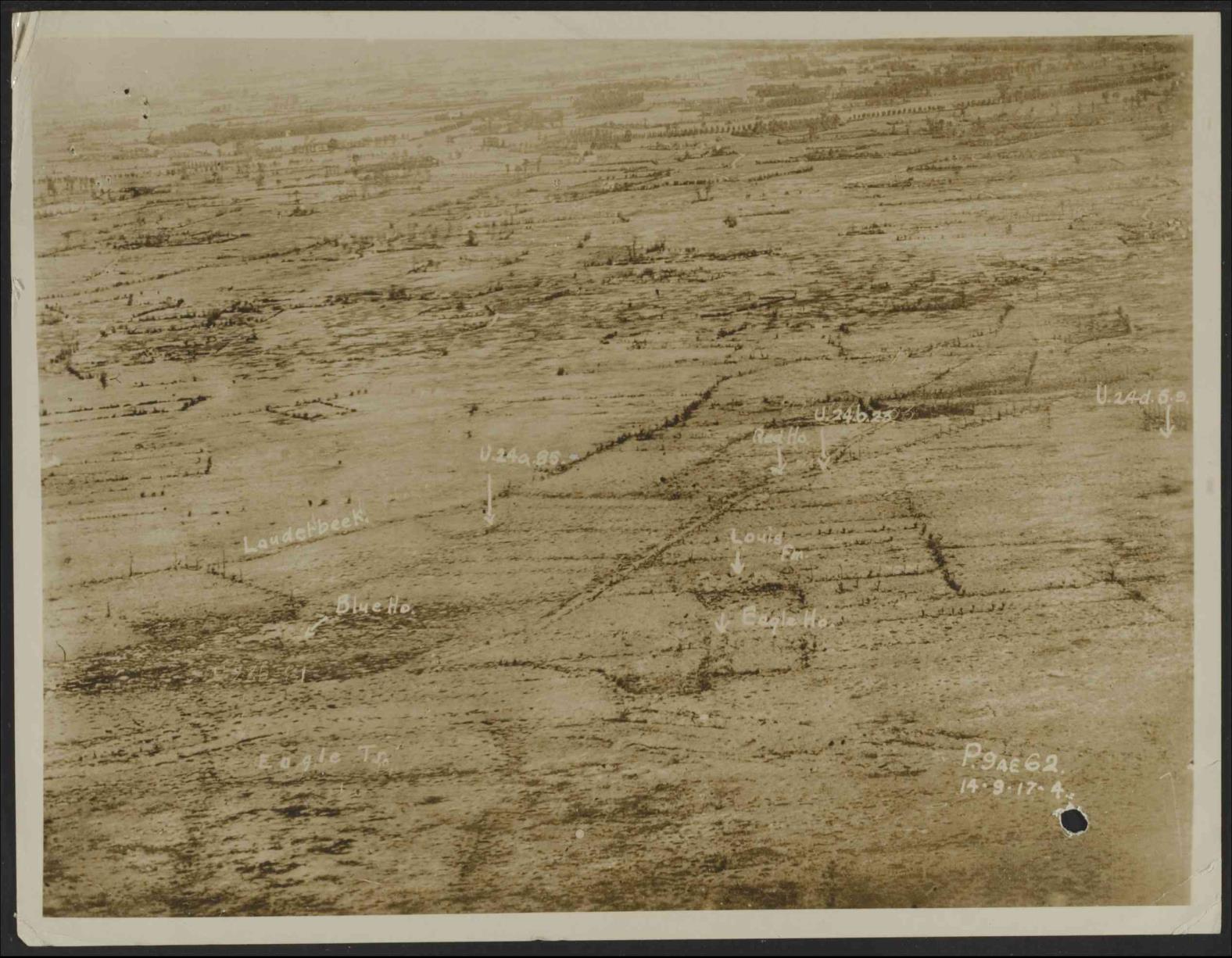
The battalion diary records Frederick’s death the following day:
17 October. Stray Farm. About 9 am the enemy shelled Stray Farm and unfortunately a shell struck Battalion Headquarters, the inmates of which were killed instantaneously. Casualties: Lt Col A Bryant, DSO; Capt and Adjt W F Robertson; Lt R Rodham (Intelligence Office); Capt F
704
TNA WO 95 2435 2 1 705 TNA WO 95 2462 4 3 (20th (Service) battalion, Northumberland Fusiliers)
17. the ‘93’ and their stories 340
C Davies, RAMC (attd). At 11 am the battalion moved off in charge of Capt Brady and arrived at Boesinghe at 12.30 pm.706
Frederick and the other casualties of the shell were extracted from the field of battle and buried side by side in Talana Farm Cemetery, south of Boesinghe.707
Frederick’s cross, likely retrieved from his original grave in at Talana Farm Cemetery and placed on the family grave in Capel y Garn Cemetery.708
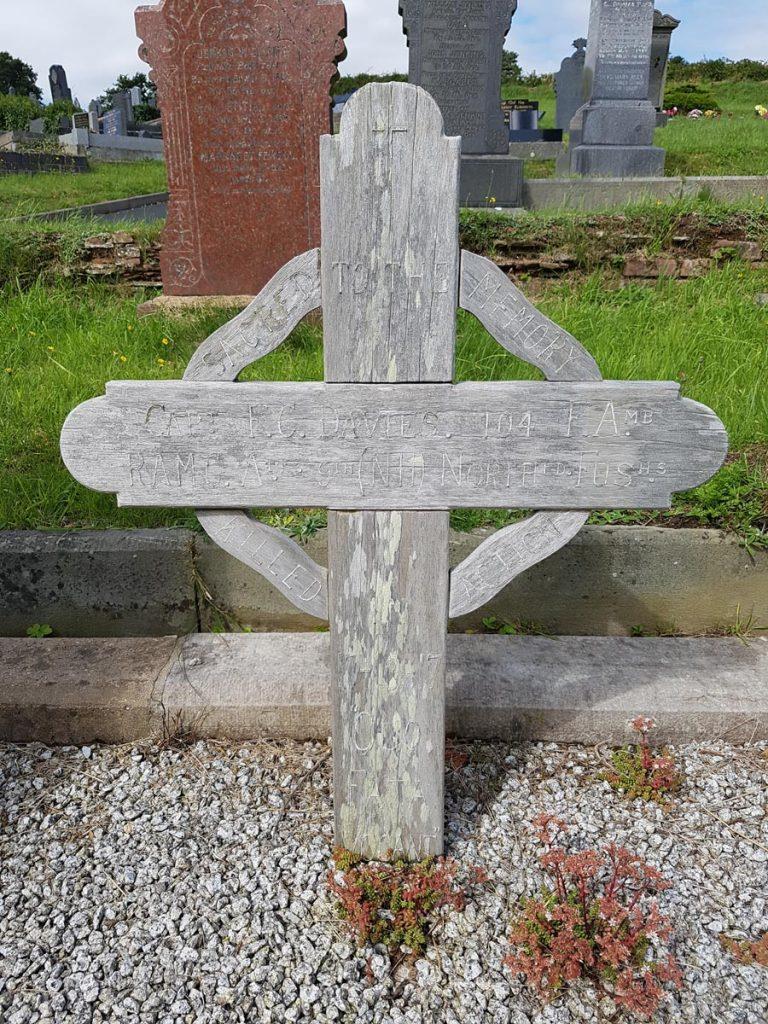
706
TNA WO 95 2466 3 1 707 ‘The family version [of the death of Frederick], passed down from then, is that he was taking cover under an armoured vehicle of some kind to protect himself from shells but that the vehicle itself was hit. When the telegram arrived, the family was having lunch. My great grandfather opened it no doubt with dread and my great grandmother asked: is it Fred? He said yes and she collapsed. He was her youngest and she had already lost three of her nine children, albeit naturally.’ Email correspondence with John Melville Smith, grandnephew of Frederick. 14 March 2021. The likelihood that Frederick had indeed sought some protection under ‘an armoured vehicle’ is commensurate with the fact that the battalion was bivouacking.
708 Returned from the Front. http://thereturned.co.uk/crosses/capel y garn/ The details on the cross read: Sacred to the memory of / Capt F. C. Davies, 104 FA, MB / RAMC, att 9th (NH) Northld Fus H S / Killed in action / 17 10 17
17. the ‘93’ and their stories 341
Aldridge, Lt Douglas John 26 October, 1917 Passchendaele nr. SPS 1899-1901
1st Bn. Royal Marines Light Infantry Poelcappelle British Cemetery XIV.F.12
Grave epitaph: In Loving Memory Younger Son of Thomas & Fannie Aldridge Gone Before Age 33
Douglas was the son of Thomas and Fannie Aldridge, 51 Circus Road Mansions, St John’s Wood, London. On the outbreak of war he obtained a commission in the 63rd Royal Naval Division and fought in Gallipoli, where, during the evacuation, he was attached to the Divisional Ammunition Column. Thereafter, he saw service in Salonika. Invalided home with jaundice, Douglas transferred on his recovery on 16 September 1917 to the 1st battalion Royal Marine Light Infantry (188th Brigade; 63rd (Royal Naval) Division).709
On 3 October 1917 the 1st battalion Royal Marine Light Infantry arrived in Dirty Bucket Camp near Poperinghe. On 5 October it proceeded to Le Nouveau Monde, near Wormhoudt, where it undertook ‘Attack Practice’. On 23 October the unit moved to billets on Canal Bank, 1,000 yards north of Ypres. The following day the battalion moved off to take over the front line sector from the 11th (Service) battalion Royal Scots, mid way between Passchendaele and Poelcappelle. The line consisted of shell holes and ran from Inch Houses (on the right) to Oxford Houses on the left, a distance of about 900 yards. Battalion HQ was in Burns House. Douglas was in command of D Company. A remarkably detailed entry in the battalion diary narrates the events of 25 26th October:
25 October. The battalion commenced to line up on the tape at 8 pm; 2 platoons of D Company moved up to Oxford Houses. Frontage of battalion approximately 900 yards. Depth of objective 900 yards. Furthest limit of battalion objective V.21.c.85.20 through [the letter] A of Banff House to V.28.c.8.9 to V.28.d.1.3. … The intention was for the 188th Infantry Brigade to attack, the Anson Bn and the 1st R.M.L.I attacking the 1st objective [i.e. the dotted red line], the Howe Bn and the 2nd Bn R.M.L.I passing through to the 2nd objective [i.e. the solid red line]. The total Divisional frontage occupied by the battalion in [the] front line was 1,500 yards. The boundaries of 1st objective, 1st Bn R.M.L.I were on right, from [the letter] S of Inch Houses to V.28.a.2.3 to V.21.c.5.1, through [the letter] E of Moray House to V.21.d.8.8. … Strength of battalion in the line to carry out the attack: 16 officers and 597 Other Ranks. …
17. the ‘93’ and their stories 342
plus 116 minutes. TNA WO 95 3095 1 5 711 TNA WO 95 3110 1 1 712 TNA WO 95 952 4
17. the ‘93’ and their stories 343
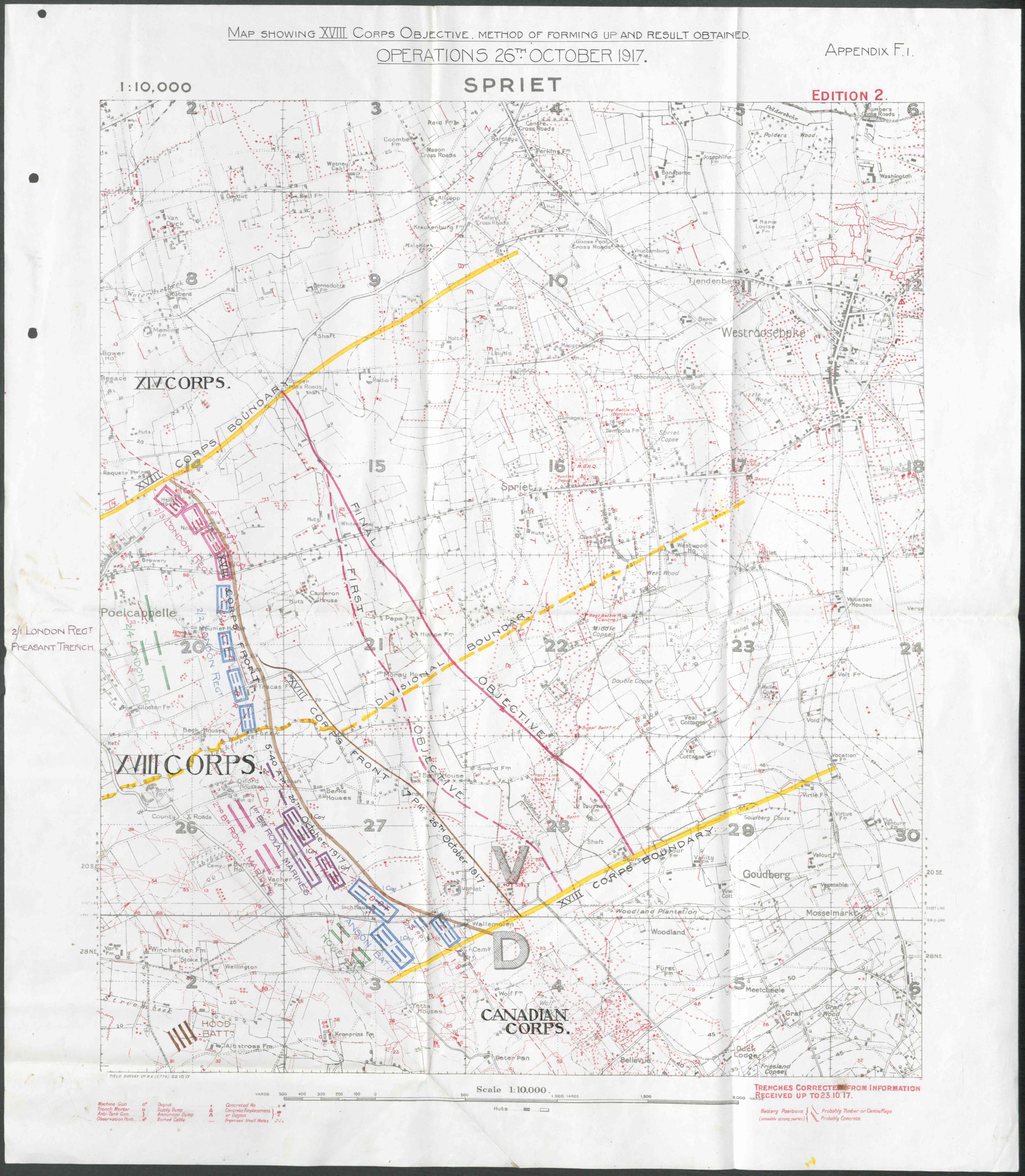
The Field Artillery barrage will come down at Zero [hour], 150 yards in front of our leading infantry. It will lift at Zero plus 8 minutes. The barrage will move at the rate of 100 yards in 8 minutes. All lifts will be 50 yards. The protective barrage will lift off the first objective at Zero plus 116 minutes.713
All accounts agree that the terrain was very challenging, the mud impeding progress and choking rifles. The Report on Operations stated that:
[Para] 25. The 25 October and night of 25 26 were brilliantly fine, but at 3.30 am the weather suddenly broke and rain was continuous throughout the day. The already heavy going was thereby made considerably worse and the difficulties of the attack proportionately increased.714
The record does not reveal the precise location of D Company and it is thus not possible to locate the position at which Douglas fell, though it seems likely that it was no great distance from Bray Farm. He was extracted from the field and is buried in Poelcappelle cemetery. This cemetery was made after the Armistice when graves were brought in from the surrounding battlefields and a number of smaller cemeteries. No record seems to exist to reveal the original location of Douglas’ grave.
713 Appendix 22, 63rd (RN) Divisional Order No. 172: TNA WO 95 3095 1 5
714 TNA WO 95 3095 1 5, Report on the Operations of 63rd (Royal Naval) Division East of Ypres 24 October 5 November 1917
17. the ‘93’ and their stories 344
Harding, Rev Wilfrid John MC 31 October 1917, Passchendaele SPS 1899 1900

RAMC attd. Drake Battalion Royal Naval Volunteer Reserve Tyne Cot Memorial Panel 160 Age 31
Wilfrid John Harding715
Wilfrid was born in Battersea on 2 December 1885. He was the son of Richmond Arthur Harding, described as a ‘traveller and collector’ and his wife Alice Emily (nee Tucker). After a year a St Paul’s, Wilfrid completed his education at St John’s Foundation Schol, Leatherhead and Christ’s College, Cambridge.716 Wilfred was a curate in Luddenham, West Yorkshire from 1912 1914. When war was declared, he enlisted into the Royal Army Medical Corps on 17th October 1914 as Private 43130, later attached to the Drake Battalion. He was sent to France on 20th January 1915 and was stationed at a hospital base in Boulogne. He was discharged from the RAMC in May 1917 in Blackpool and married Mary Riley on 10th May, 1917. He was awarded a chaplaincy in St Annes on Sea and again sailed for France on 29th May, 1917.
In early October Wilfrid’s unit, Drake battalion (189th Brigade, 63 (Royal Naval) Division) was brought into the Ypres area to help with an offensive that became known as the Second
715 De Ruvigny
716 Wilfrid’s youger brother, Captain Reginald William Fowler Harding (SPS 1900 1903), also died in action under a month later on 7 November 1917. Reginald served in 2/18th battalion London Regiment and is buried at the Jerusalem Memorial.
17. the ‘93’ and their stories 345
Battle of Passchendaele (26 October 10 November).717 On 6 October the battalion departed from Dirty Bucket Camp near Elverdinghe for Reigersburg Camp near Ypres, arriving on that day at 5.15 pm. Until 28 October the battalion undertook various works in the forward area, including ‘the construction of roads, railways, and duck board tracks. The majority of the work was carried out under shell fire.718 Wilfrid’s unit was thus not detailed to participated in the first stages of the operation that began at 5.40 am on 26 October. Instead, it was instructed to supply men to act as stretcher bearers in the long carry between regimental aid posts and the advanced dressing station, as recorded in the battalion diary:
29 October. Supplied a party of 1 officer and 50 other ranks as stretcher bearers. 30 October. Supplied a party of 6 officers and 250 other ranks as stretcher bearers on account of 190th Brigade operations. Casualties. 31 October. Battalion moved forward to Cheddar Villa and Irish Farm, in support. Killed: 3 other ranks; Wounded, 8 other ranks; Missing, 1 officer.719
Wilfrid is not named in the battalion diary, though he is perhaps the officer referenced as ‘missing’ in the entry for 31 October. It is nonetheless clear from corroborating evidence that Wilfrid was killed in the vicinity of the front line held by 190th Brigade (63rd (Royal Naval) Division), about one mile in length roughly midway between Poelcappelle and Passchendaele. This section of line was opposed by the German strong point known as Banff House. A Report in 63rd (Royal Navy) Division diary describes the difficulties that the units of 190th Brigade encountered:
[On 30 October] at Zero Hour (5.50 am) our barrage was put down on the required line and the infantry began to close up to it. Almost immediately afterwards (the time is variously described as between 1 and 2 minutes) an intense enemy barrage was put down not more than 100 yards in rear of our own, and right in the middle of the attacking troops. Severe casualties were inflicted on the attacking units by this fire, especially on the right, and the leading companies of the Artists Rifles appear to have been practically wiped out within 5 minutes of Zero. In the centre and on the left the Bedfords and Royal Fusiliers tried to press forward, but the going was too heavy for them, and after traversing a distance of 250 300 yards they lost the barrage and literally stuck in the mud. Despite all precautions their rifles
717 The odd one out of all the British divisions of the 1914 18 War, the Royal Naval Division was formed in September 1914 from Royal Marines and surplus naval reservists, organized in battalions named after distinguished sailors in naval history Hood, Nelson, Howe, Drake etc
718
TNA WO 95 3095 1 5 Report on the Operation of the 63rd (Royal Naval) Division East of Ypres During the Period 24 Oct to 5 November p 2
719
TNA WO 95 3114 1 1
17. the ‘93’ and their stories 346
and Lewis guns had now become choked with mud, and as soon as [our] barrage passed over the enemy’s strong points the men found themselves finally checked by heavy machine gun and rifle fire, to which they were unable to reply. … Towards midday it became apparent that at no point had we advanced more than 250 300 yards and that the enemy barrage, added to the bad going, had brought the attack to a standstill almost at the start. … The 190th Brigade was relieved by the 189th Brigade on the night of 31 October 1 November and was withdrawn to Poperinghe. The losses of the Brigade had been severe and the result of their efforts small, but on the greater part of the front the heavy going had made their task almost impossible.720
Map showing the line held by 63rd (Royal Naval) Division on 30 October and the very little progress made towards its objectives.721

The Lieutenant Commander of the Drake Battalion was Walter Sterndale Bennett, another O.P (SPS 1907 1908; kia 7 November 1917). Sterndale Bennett wrote to Walter’s family, detailing Walter’s actions as a stretcher bearer:
720 TNA WO 95 3095 1 5 Report on the Operation of the 63rd (Royal Naval) Division East of Ypres During the Period 24 Oct to 5 November p. 10 and p. 12. (The 63rd (Royal Naval) Division suffered 3,126 casualties during the period 26 31 October.)
721 TNA WO 95 952 4
17. the ‘93’ and their stories 347
The work for which your husband was awarded the MC was as follows: stretcher bearers had each case to carry over two miles over the most impossible ground before reaching a road or ambulance. Your husband insisted on going out into ‘No Man’s Land’ with the stretcher bearers in search of wounded men under the most intense fire and in broad daylight, when he was exposed without cover of any kind, regardless of his own safety so long as he could be a comfort or of use to any of the wounded. Everyone was loud in his praises. It was just behind the line, while returning, that he was killed.722
Another account described how:
When the [189th] Brigade moved, and sections of the men were set apart as stretcher bearers, during a ‘push’ he immediately joined one of the squads and whilst engaged in this work a shell pitched amidst his squad and killed him. … His body is buried near the spot where he laid down his life whilst serving comrades.723
An anonymous letter of 1920 by another O.P. who served in the Drake battalion recorded that:
Our Padre was killed … bringing in wounded. Mr. Harding couldn't preach to save his life, but he captained our football team, won several events in our sports, and every working party he went on he insisted on going everywhere with us was better than a sermon for the lads. We company commanders used to toss up for having him with our company in the line or in a show. Every night during our stay in the line at Arras he spent the whole night in the worst bit of the line or in No Man's Land. I remember a Communion Service he held in our company dug out once, twenty five of the company (nearly all Yorkshire miners) were there.724
The citation for Wilfrid’s MC reads thus:
For conspicuous gallantry and devotion to duty; continually tending the wounded during four days’ operations and repeatedly crossing No Man’s Land under heavy fire to carry them in to the front line.725
Wilfrid lies today somewhere along the mile length of front described above. He is commemorated on the Tyne Cot Memorial Panel.
722 De Ruvigny 723 De Ruvigny 724 The Pauline 239 June 1918 p 60 725 London Gazette, 18 Jan 1918
17. the ‘93’ and their stories 348
Riddle, Private Galfrid Julian 850347 6 November 1917, Passchendaele (nr.) SPS 1907 - 1910
3rd Bn. (Toronto Regiment), C Company, Poelcapelle British Cemetery XI.D.5
Grave epitaph: Requiescat In Pace Jesus Saith ‘Thy Son Liveth’ Age 25
Galfrid was the eldest son of the Rev. A. J. Riddle and Mary, his wife, of Arncot, Alexandra Rd, Watford, Herts. During his time at SPS, he appears to have been a talented Fives player, as intimated by a report in The Pauline:
On Saturday, 12 November [1910], Wainwright's beat Tristram's by 120 points to 50. Wainwright's was much the better side, and the only game about which there was ever any doubt was the single between Riddle and von Winckler. Wainwright was easily the best player of Wainwright's IV, and Cumming of Tristram's IV, while Riddle played a very plucky game in his singles. Scores: F. L. Wainwright and M. von Winckler beat R. C. Cumming and J. T. Riddle (15 8) (15 2).726
After leaving SPS, Galfrid worked as ‘merchant’s clerk’, and lived in St Leonards on Sea, Sussex.727 At some point thereafter he emigrated to Canada where he worked as an insurance agent. He joined the 176th battalion (C.E.F) on 23 June 1916, before transferring first to the 12th Reserve battalion and secondly to the 3rd battalion (1st infantry brigade, 1st Canadian Division.) Galfrid crossed to England in the SS Olympic, arriving on 7 May 1917 and joined his unit in France on 27 June. On 5 November at 1.25 am, Galfrid was in the front line in the Passchendaele sector, disposed for the attack planned to begin at Zero Hour (6 am) on 6 November.
Composite map showing the section of line in which Galfrid fought and fell. (The blue dotted line shows the position of the Allied front in December 1917. Passchendaele is bottom right.)728
726 The Pauline 1910 Vol 28 Issue no 185 p 222. John Terrance Ashley Riddle (SPS 1907 1913) was Galfrid’s younger brother. John survived the war. (See Vol 1, Chapter 8) 727 1911 Census
728 Reproduced with the permission of the National Library of Scotland. https://maps.nls.uk/index.html
17. the ‘93’ and their stories 349
In light of where Galfrid’s body was found in 1919 a short distance to the west of Groudberg Copse it seems that C Company was disposed in the front line at Vanity Farm, about a mile north west of Passchendaele.729 By 7.14 am on 6 November, following the artillery barrage that had begun at 6 am, reports were stating that Passchendaele had fallen to the Canadians. While this was taking place Galfrid’s Company appears to have been involved in a defensive flanking operation, as detailed in the 3rd battalion diary:
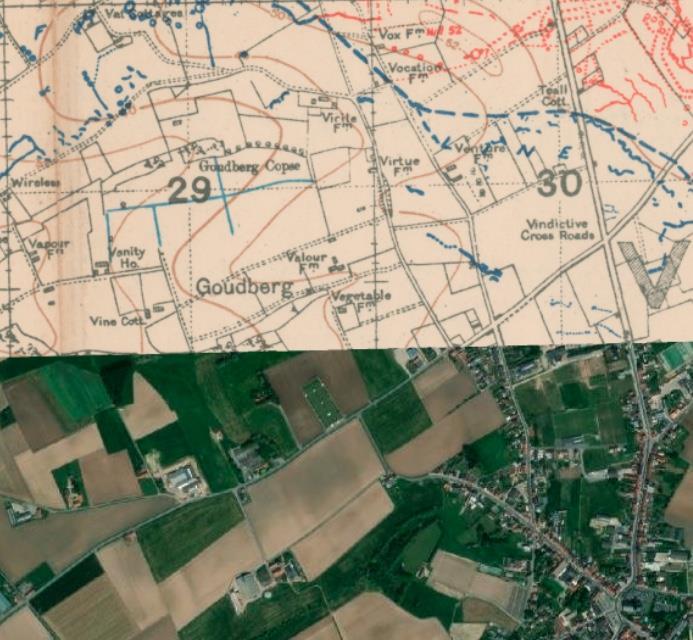
6 Nov
7.14 am [Canadian forces were reported in Passchendaele …] 10.32 a.m. Received wire from Major Mason that he is unable as yet to get through to “C” Company and he believes they had heavy casualties from Machine Guns firing from Vine Cottages …
729 CWGC Burial Return 31 October 1919, B.257/73. Galfrid’s body was found along with four others at V.29.a.6.6
17. the ‘93’ and their stories
11.06 a.m. Col Thompson phoned and stated that 6 prisoners had come past his Headquarters and stated that they had come from Vine Cottage, so it appears that “C” Company have captured Vine Cottage. ….
12.45 p.m. Message received from Major Mason to the effect that our line now runs from Vanity House to V.29.d.3.6., and that we are in touch with the 2nd Battalion on our right. 3.10 p.m. Orders issued to “D” company that they must clear “C” Company’s area of all wounded men tonight, also carry up 10,000 rounds of S.A.A to “C” Company, and any water they may require. …
6.52 p.m. Message arrived from Major Mason , that “C” Company continue to hold objectives at 2.00 p.m., and are digging along a line from Vanity House to V.29.c.9.5., with two posts between V.29.c.9.5 and V.29.d.3.6., where we touch up with Lieut. [unreadable] Company of 2nd Battalion. Company Headquarters is at Vine Cottage. Estimated strength of “C” Company 150. 2 platoons of “D” Company will be sent up tonight from Yetta Cottages as reinforcements, whilst the other 2 platoons will be used to carry supplies forward. 40 prisoners taken and are being held at Vine Cottages until dusk, so they can carry stretcher Cases out. …
By 2 am on 8 Nov the relief was complete; 6.00 a.m. Battalion reported in at Wieltje Camp. 1.30 p.m. Battalion formed up and marched to Ypres Station.730
In the first instance after the attack on 6 November, Galfrid was reported as ‘missing in action’, subsequently confirmed killed in action. The Circumstances of Death Register states that ‘Information is available that [Galfrid] was killed by a machine gun bullet whilst taking part in the attack on Passchendaele Ridge’.731 Galfrid’s grave in Poelcapelle Cemetery is a concentration burial.
730 Narrative ‘B’. RG9 III D 3, Volume number: 4915, Microfilm reel number: T 10707, T 10707, File number: 358, File part: 1=1917/06/01 1918/04/30;2=1918/05/01 1919/02/28
731 Circumstances of Death Registers, First World War, 31829_B016704
17. the ‘93’ and their stories 351
Bennett, Commander Walter Sterndale DSO and Bar 7 November 1917, Passchendaele (nr.)
SPS 1907 1908
Drake Battalion, 63rd Royal Naval Division Dozinghem Military Cemetery VI.I.1
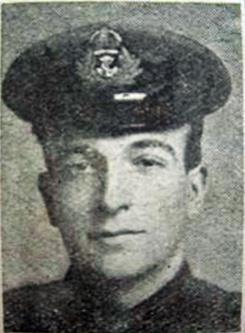
Grave epitaph: Dearly Loved Youngest Son of J. R and M. A Sterndale Bennett Age 24
Walter Sterndale Bennett732
Walter was born at Derby, Derbyshire on 15 July 1883. He was the son of James Robert Sterndale Bennett, one time Lecturer in Mathematics at King’s College, London and latterly headmaster of Derby School from 1889, and his wife Mabel Gaskell. Walter was the grandson of Sir William Sterndale Bennett (1816 1875), one of the most celebrated British composers of the nineteenth century, Professor of Music at Cambridge and latterly Principal of the Royal Academy of Music.733 After St Paul’s Walter proceeded to Worcester Nautical Training College. From 13 September 1910 he went to sea as an apprentice, sailing on the 732 Hosted here http://www.smaaawwi.org.uk/wwi/people/database page/cmdr w sterndale bennett/ 733 The second son there were six in total Robert (1880 1963), inherited his grandfather’s skills, becoming the Director of Music at Uppingham School in 1909. He is mentioned by Vera Brittain in Testament of Youth, having taught her brother Edward there. Walter appears to have inherited the musical bent. At an event on 14 February 1963, Walter’s brother, Robert stated that ‘My brother had great faith in the value of Music for toning up morale. He would arrange for 2 Buglers in each Company to sound "The Advance" before going over the top at Zero hour.’ (Printed in the magazine Royal Naval Division, Antwerp, Gallipoli and the Western Front 1914 1918, Issue Number 7, December 1998, p. 587). In the 1911 Census another son, Thomas Case Sterndale Bennett, aged 28, is recorded as ‘Musician (vocalist, pianist and composer.)’ None of Walter’s siblings appear to have attended SPS.
17. the ‘93’ and their stories 352
barque ‘Inverarie’ to Monte Video, Australia and other destinations. After several years, Walter gave up the Merchant Marine to take up painting. On 14 January 1914 he entered John Hassall’s West London Art School, though his potential career as an artist was cut short by the outbreak of war.734 In the first instance he joined 1/28th (County of London) battalion the Artists Rifles but on 24 February 1915 took a commission in the Royal Naval Volunteer Reserve. He joined a draft for service with the Mediterranean Expeditionary Force on 1 August 1915, serving in the Drake Battalion, 63rd (Royal Naval) Division) as Sub Lieutenant and, rather surprisingly for one of low officer rank but indicative of his potential as a soldier, Adjutant. He fought at Gallipoli, and thereafter was promoted Lieutenant after being mentioned in Despatches for gallant and distinguished services in the field. In November 1916 the Drake battalion was in France, in line in front of Beaucourt near the Somme. After all the senior officers had been either killed or wounded, Walter took command of the battalion, an action for which he received the Distinguished Service Order. The citation states:
For conspicuous gallantry… He assumed command of and handled his Battalion with marked courage and ability. He personally collected a party and bombed the enemy out of part of their second line, where they might have held up the attack.735
Walter returned to England on 6 January 1917 to attend a Senior Officers course at Aldershot, Hampshire. Upon completion he rejoined the Drake battalion on 4 April 1917, at which time he assumed command of the Drake Battalion at the age of twenty three, he was the youngest officer commanding a battalion in France at the time and until his death. On 12 June 1917 he was awarded a Bar to his D.S.O for his actions in line at Gavrelle Oppy near Arras:
For conspicuous gallantry and devotion to duty. On discovering the wire uncut except in a few places he went forward himself and led his battalion through the partially cut gaps. He finally gained his objective, and held on against very strong resistance. The success of the operation was almost entirely due to his personal example.736
734 Artistic wherewithal was a family characteristic. In the 1901 and 1911 Census, Walter’s sister, Anne (b. 1879) is described respectively as an ‘Art Student’ and ‘Artist (Painter)’.
735 See London Gazette, 26 January 1917 p 1016
736 2nd Supplement London Gazetter, 18 July 1917, p 7211. In his report on the ‘Operations Against Gavrelle Opply line and Gavrelle Village’ dated 27 April 1917 Walter wrote ‘I feel that I am not exaggerating when I estimate the enemy’s casualties at two thousand. We were firing at them continually all the time we were up there the fire was well controlled and splendid effects were seen The artillery was magnificent. The enemy was thoroughly butchered and we enjoyed every moment of it all.’ Army Book 152. Correspondence Book
17. the ‘93’ and their stories 353
The experience at Gavrelle appears to have altered Walter, as noticed by a fellow officer:
I was unfortunately away from the Battalion when the action at Gavrelle was fought, which stamped [Walter] as a resourceful Commander of the finest type and destined to go very much further, and earned for him a bar to his D.S.O; but on rejoining the Battalion I was tremendously struck by the change in him. As Adjutant, he had always appeared to many of us to take life too seriously he seemed to make work for himself. He was rarely to be seen without a preoccupied, almost worried expression, bustling about as if the cares of the whole army rested on his shoulders; and even when he allowed himself the relaxation of a game of cards or a chat in the evenings once in a while, it seemed to be with a semi guilty conscience, as if he considered he was playing truant from school. To my surprise, on my return, instead of finding that the added sense of responsibility was almost too much to bear, I found a different being, fit as a king, without apparently a care on his mind and a general atmosphere of one who had come into his own, and loved his work, was thoroughly happy at it, and felt and showed by results that he had it thoroughly in hand and plenty of time to spare for a game of football, a ride, a game of cards, or a general rag; or if none of these presented itself, to sit and make the most delightful and clever sketches of peeps as seen through the opening of his tent. And all this while under his care the Battalion was improving daily making a name for itself for fighting, for work and smartness, with an absolute lack of all traces of grievance or friction, and growing more and more like the happy family it always seemed to be.737
Walter returned to England on 6 January 1917 to attend a Senior Officers course at Aldershot, Hampshire. Upon completion he rejoined the Drake battalion on 4 April 1917, at which time he assumed command of the Drake Battalion at the age of twenty three, he was the youngest officer commanding a battalion in France at the time and until his death. On 12 June 1917 he was awarded a Bar to his D.S.O for his actions in line at Gavrelle Oppy near Arras:
For conspicuous gallantry and devotion to duty. On discovering the wire uncut except in a few places he went forward himself and led his battalion through the partially cut gaps. He
(Field Service) dated 27 April 1917. (Printed in the magazine Royal Naval Division, Antwerp, Gallipoli and the Western Front 1914 1918, Issue Number 7, December 1998, p 587).
737 An Appreciation by H. B. Pollock, D.S.O., R.N.V.R. Endorsed in ink copied from Drake Battalion Magazine April Sept 1917. (Printed in the magazine Royal Naval Division, Antwerp, Gallipoli and the Western Front 1914 1918, Issue Number 7, December 1998, p 592 593).
17. the ‘93’ and their stories 354
finally gained his objective, and held on against very strong resistance. The success of the operation was almost entirely due to his personal example.738
At the time Walter received his mortal wound on 4th November he was in the front line with Drake battalion, midway between Poelcapelle and Passchendaele .739 The 189th Brigade had been detailed to achieve three objectives:
a) capture Source Trench b) Clear up the situation from the existing front line as far as the Paddebeek c) capture Tournant Farm and [to form the establishment of a line from V.29.a.0.0 to Sourd Farm740
Map showing the lines held by 189th Brigade 31 October 5 November. The red dotted line shows the front on 23 October; the red solid line shows the front on 31 October; the blue line shows the front resulting from minor operations carried out by the Nelson battalion on 2 November; the yellow line shows the front resulting from minor operations carried out by the Drake battalion on 4 November; the variously red blue line shows the line resulting from minor operations carried out by the Hood battalion. The solid black lines show the Brigade boundaries.741
738 2nd Supplement London Gazette, 18 July 1917 p 7211. In his report on the ‘Operations Against Gavrelle Opply line and Gavrelle Village’ dated 27 April 1917 Walter wrote ‘I feel that I am not exaggerating when I estimate the enemy’s casualties at two thousand. We were firing at them continually all the time we were up there the fire was well controlled and splendid effects were seen The artillery was magnificent. The enemy was thoroughly butchered and we enjoyed every moment of it all.’ Army Book 152. Correspondence Book (Field Service) dated 27 April 1917. (Printed in the magazine Royal Naval Division, Antwerp, Gallipoli and the Western Front 1914 1918, Issue Number 7, December 1998, p 587).
739 See TNA ADM 339 for Walter’s detailed service record.
740 TNA WO 95 3112 13 189th Infantry Brigade. Report on Operations 31 October to 6 November p 3
741 TNA WO 95 3095 1 5
17. the ‘93’ and their stories 355
The Drake battalion diary recorded thus the unit’s progress towards their objectives and the death and funeral of Walter:
1 Nov in support to Hawke and Nelson bns at Cheddar Villa. Left Cheddar Villa for Irish Farm
2 Nov left Irish Farm for left subsector of Divisional front.
3 Nov. In front line. Heavy barrage on Banff House about 2 pm today, lasting until 4.30 pm. At 9 pm on this date C and D Coys carried out a minor operation and captured Sourd Farm, advancing our line about 200 yards.

4 Nov. In front line. Our own artillery active, best part of day. Burns House was heavily shelled during the day. Commander W Sterndale Bennett DSO severely wounded. Sub Liet H Haney wounded. B Coy carried out a minor operation against enemy posts in conjunction with one platoon of Hood Bn, advancing our line about 100 yards towards Tournant Farm. Line now runs V.28.a.6.2 Sourd Farm V.27.b.4.9 V.27.a.30.95 (Spriet Map)
5 Nov In front line. Heavy Bosche barrage behind Banff House about 5.30 pm. Relieved by composite Coys of 188th Bde. After relief proceeded to Irish Farm.
6 Nov. Left Irish Farm about 10 am for Road Camp (F.25.d.1.4), arriving about 6pm
7 Nov. Clearning up and reorganisation. Commander W Sterndale Bennett DSO died of wounds at 61st C.C.S.
8 Nov Training
9 Nov Training. The funeral of Commander W Sterndale Bennett DSO took place from 61st C.C.S to Dozinghen Cemetery. It was attended by the Divisional General, members of
17. the ‘93’ and their stories 356
Divisional Brigade Staffs, battalion commanders of 189th Brigade and 15 officers and 120 men representing Drake battalion. He was buried with full military honours.742
The 189th Brigade diary provides some corroborative details:
The line to be taken over included Vapour Farm, which was separated by the marshy valley of the Paddebeek from the remainder of our line and had to be approached along the left bank of the [Paddebeek]. Despite these difficulties, however, the relief was successfully carried out and completed by 5.30 pm. The enemy was decidedly active with his artillery during the day, and brought down three barrages at intervals. The most serious lasted from 4.30 to 5 pm and its nucleus was about Banff House. It was during this barrage that Commander Sterndale Bennett was mortally wounded by a shell while visiting his forward posts.743
These forward posts were in the process of being established along the line Sourd Farm to roughly Vapour Farm, to enable the capture of Tournant Farm. This, then, is the vicinity in which Walter received his mortal wound, no great distance from where Wilfrid Harding, another OP serving in Drake battalion, had fallen on 30 October. An eye witness account of the event is provided by Frank Andrews of Drake Battalion in a letter composed in 1963:
Commander Bennett was badly wounded at about 4:30 p.m. on November 4th 1917. I was attached to H.Q. at the time and we were caught right in the middle of very fierce bombardment which the enemy had a nasty habit of putting over every evening at the same time… I was about fifty yards away when that particular shell dropped but was fortunately not hit myself although several of my mates were killed.744
A fellow officer investigated the nature of Walter’s wound:
[Upon] making enquiries I was informed at Headquarters that a shell had struck him in the legs, severing one between the knee and ankle and I believe shattering the other foot.
742
TNA WO 95 3114 1 1
743
TNA WO 95 3112 13 189th Infantry Brigade. Report on Operations 31 October to 6 November p 10
744 Letter by Frank Andrews of Drake Battalion dated 1963. (Printed in the magazine Royal Naval Division, Antwerp, Gallipoli and the Western Front 1914 1918, Issue Number 7, December 1998, p 589).
17. the ‘93’ and their stories 357
Although he received prompt treatment he sank very rapidly. He was interred in a very large burial ground in [the] rear of Ypres.745
Walter’s successor as Commander of the battalion, H. B. Pollock wrote the following letter to Walter’s parents:
It was with full hearts that we laid your son to rest. It was a lovely mild day and he is lying in a little cemetery behind the 61st Clearing Station, but clear of roads and hospitals and surrounded by trees and as peaceful a spot and little like a scene close to the front as it would be possible to find. I made arrangements for almost all the officers of the Battalion to be present and as many of the men as there was room for and a firing party of 50 and buglers of the Battalion. We could get no real flowers in time, but we managed to get five really beautiful intimation wreaths, one for each Company and one from HQ., not the dreadful white imitation dead and classic things, but wonderfully good intimation coloured flowers arranged as loose sprays made into wreaths. Our Divisional General and two Brigadiers attended and most of the staff officers and many from the other battalions. All who could get away came, he was such a favourite, and everyone who came across him had such a tremendously high appreciation of his work. As to a cross. I am writing to the Divisional Engineers who I am sure would like to be allowed to put one of their own making, as a token from them.746
It seems likely that the Divisional Engineers were thus responsible for the remarkably shaped commemorative shield, originally attached to the cross of Walter’s grave and dedicated to his memory.747
745 Letter from Charles Hayfair, Lieut Commander Hawke battalion, dated November 1917. (Printed in the magazine Royal Naval Division, Antwerp, Gallipoli and the Western Front 1914 1918, Issue Number 7, December 1998, p. 588).
746 Letter from Commander H. B. Pollock, Drake battalion. (Printed in the magazine Royal Naval Division, Antwerp, Gallipoli and the Western Front 1914 1918, Issue Number 7, December 1998, pp. 591 592.)
747 WMO/260250. https://www.warmemorialsonline.org.uk/memorial/260250
17. the ‘93’ and their stories 358
The 61st Casualty Clearing Station was located two miles north west of Poperinghe, in a location that was called Dozinghem by the troops and Dozinghem Military Cemetery today. Walter lies in the grave located at VI.I.1.
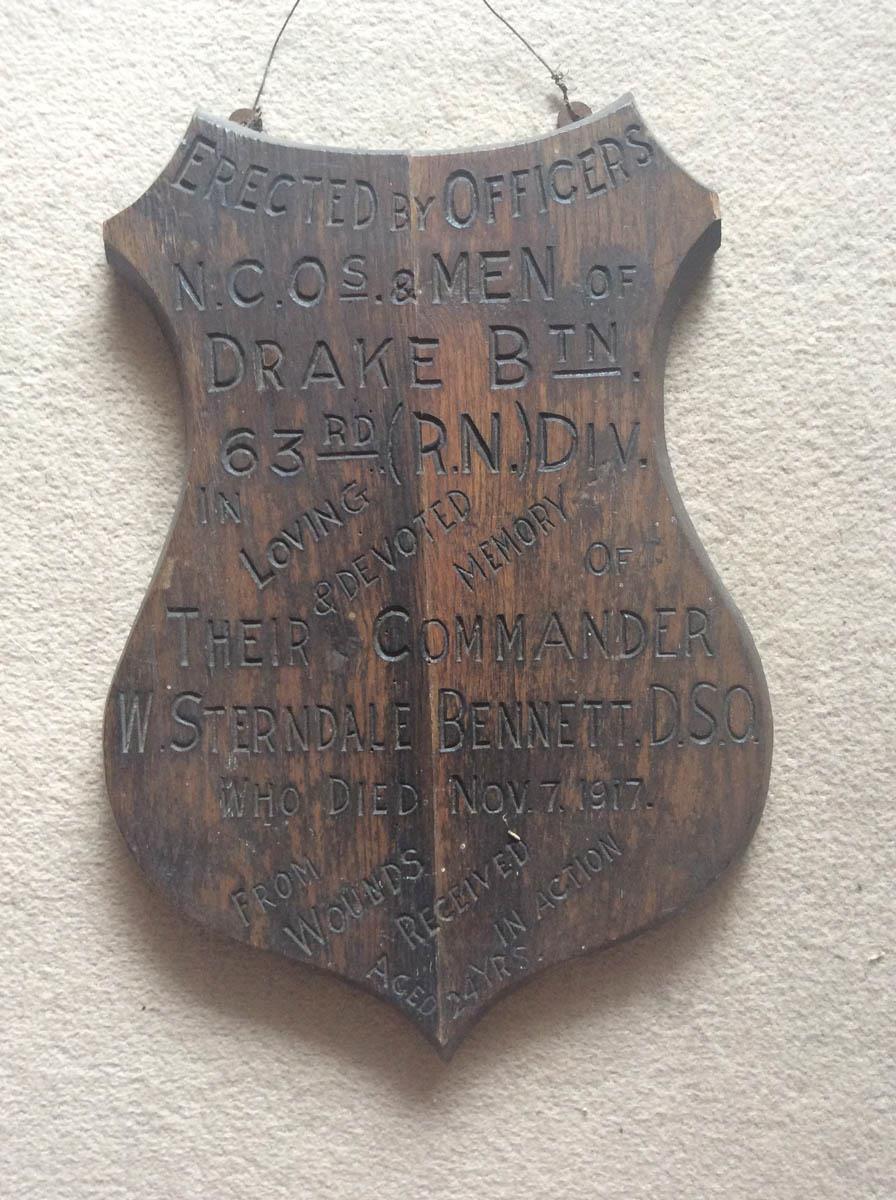
Whiteman, Captain Ormonde Charles 22 November 1917, Houthulst Forest (nr.) SPS 1899 1903
11th (Service) Bn. Royal Fusiliers (City of London Regiment) Bluet Farm Cemetery II.B.14 Age 31
Ormonde Charles Whiteman748
Ormonde was the son of Charles and Ada Whiteman and the husband of Eleanor Whiteman,of 109, Blenheim Crescent, Notting Hill, London. After leaving St. Paul’s he devoted all his leisure time to the Surrey Yeomanry, and there gained the Territorial Long Service Medal. With the Surrey Yeomanry he went to Flanders as Divisional Cavalry, arriving 22 December 1914. He returned to England three months later to take up a commission in the 11th battalion Royal Fusiliers; in September 1915 he returned to the front, where he remained with the regiment in Flanders and France until his death. During part of that period he acted as Brigade Bombing Officer, and afterwards as Adjutant. He was married in 1915 and left a son, born in August 1917.
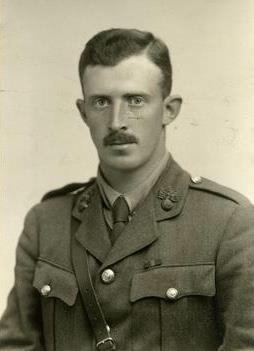
Ormonde’s signature appended to the unit diary for October 1917 the last that he would sign off before his death.749
17. the ‘93’ and their stories 360
During the first ten days of November the 11th (Service) battalion Royal Fusiliers (54th Brigade, 18th (Eastern) Division) was in camp undertaking training northwest of Ypres, first at Piccadilly Camp and then at De Wippe Camp. The battalion diary narrates the following details from the 10 November and records the death of Ormonde on 22 November:

10 13 November. Proceeded by train from Ondank [Ondank was a large rail siding, half way between De Wippe and Woesten] to Boesinghe and relieved the 10th Essex Regiment in the line south of Houthulst Forest (sheet 20 U.5 and 6; Bn HQ at U.6.c.3.3) 750 During their tour in the line the battalion carried out a good deal of work on the outposts and other positions, the work however being hindered by the waterlogged condition of the ground and the extreme darkness at night. No movement was possible during the daytime. Hostile artillery and machine guns were fairly active and the enemy used a large number of gas shells. … A large number of men suffered with ‘Trench Feet’, 85 other ranks being evacuated for that reason 14 16 November. The battalion was relieved in the line on the night of 13 14 instance by the 7th Bedfordshire Regiment. Owing to shelling the relief could not be completed until 4 am. The battalion returned to Baboon Camp where it remained in support for 3 days. On the 16 November the battalion returned to De Wippe Camp, entraining from Boesinghe to Ondank.751
After several days of cleaning up and training, the battalion went back into line on 22 November:
22 25 November. On the 22 November the battalion proceeded by train from Ondank to Boesinghe and relieved the 10th Essex Regiment in the line, south of Houthulst Forest, taking over the same sector as on 10th November. Whilst on the way to the line the Adjutant (Captain O.C. Whiteman) was killed and one other rank wounded. During this tour in the line
750 The front held by the battalion ran from Faidherbe Cross Roads to Les 5 Chemins, facing the southwest corner of Houthulst Forest. 751 TNA WO 95 2045 1
17. the ‘93’ and their stories 361
much work was done, partly under R. E [i.e. Royal Engineer] supervision, in improving and consolidating the positions and in putting out wire. [The] enemy’s artillery and machine gun fire was normal. The following casualties were also sustained: 2 other ranks wounded. 25 26 Nov. The battalion was relieved by the 7th Bedfordshire Regiment and returned to Canal Bank Camp, where it remained in reserved for three days.752
The route to the front that the battalion was detailed to take from Boesinghe was Hunter Street Langemarck Bikschoote Road Clarges Street. Unfortunately it is not possible to determine at which point along this route Ormonde was killed, but some details gleaned from the Regimental history describe the circumstances of his death. Along with Major Ford, Ormonde seems to have been ahead of the battalion as it made its way along the track up to the front. The two men were no doubt reconnoitring the route. Upon encountering a section of the track that was being persistently shelled they took cover behind a pill box, waiting for a lull in the shelling before they advanced. Unluckily the next shell landed where they were sheltering, killing Ormonde at once.753
Ormonde’s body was removed behind the lines and he is buried at Bluet Farm Cemetery, a dressing station located to the north west of Ypres near the village of Elverdinge.
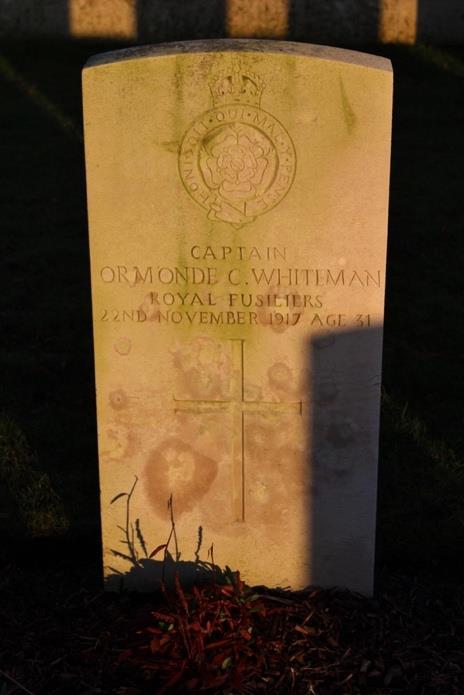
Ormonde’s gravestone at Bluet Farm Cemetery754 752 TNA WO 95 2045 1 753 These details are provided in O’Neill, H C, The Royal Fusiliers in the Great War (1922) p 204 754 Image at http://thebignote.com/wp content/uploads/2020/02/IMG_4457 1000x1500 1.jpg
17. the ‘93’ and their stories 362
Sowinski, Lt Joseph Ladislas MC 28 November 1917, St Julien SPS 1905 1906
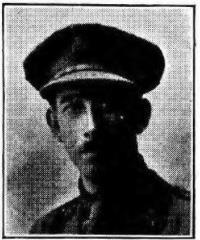
49th Divisional Trench Mortar Battery, Royal Field Artillery, attd. 245th Brigade, B Battery Royal Field Artillery
Vlamertinghe New Military Cemetery XI.A.7 Age 27
Joseph Ladislas Sowinski755
Joseph was born in London on 13 September 1890, the only son of John Ladislas Sowinski and his wife Eva. After leaving St Paul’s he went to the Argentine in February 1912, settling there as the manager of a cattle ranch. He returned to England in March 1915 and joined the Inns of Court O.T.C. In July he was gazetted 2nd Lieutenant in the 49th Division Trench Mortar Battery. He crossed to France in 8 November 1915. He was awarded the M.C posthumously, the citation describing:
Conspicuous gallantry and devotion to duty as Forward Observation Officer following the infantry in an attack. Although his leg was injured he remained with the front line, reconnoitring the front and ascertained the difficulties and intentions of the attacking troops, and under a heavy barrage also visited the supporting troops. He was thus able to furnish most valuable information at a critical time.756 755 De Ruvigny 756 London Gazette, 23 April 1918
17. the ‘93’ and their stories 363
At the time of Joseph’s death the personnel of 49th Trench Mortar Battery were attached to 234 Brigade Royal Field Artillery, B Battery, an artillery unit in 49th Division. These personnel were employed as working parties at the 49th Division R.F.A Battery positions, engaged in the offensive operations on the Passchendaele front. This was in fact the second month in which the 49th Division Trench Mortar personnel had been employed in this way, and although the 49th Division Trench Mortar diary references their location as ‘in the vicinity of [28].C.18.d’, this is in fact about one and a half miles from Gravenstafel.757 Their location is perhaps better described as 1,000 yards south east of St Julien.
The 245th Brigade R.F.A diary describes a torrid time endured in this place: 28 November. Enemy artillery shows no signs of slackening and whole area is almost continuously bombarded. B/245 Battery, owing to be out of range, came out of action and move to Wagon Lines. All guns except one hopelessly bogged down and three exchanged at II Anzac Gun Post.758 Lieut J. L. Sowinkski killed.
This has been perhaps the most severe time the 245th Brigade R.F.A has had to go through. Enemy [?] fighting has been continuous and what is practically one great battle has been going on unceasingly. If statements of former prisoners are to be believed the enemy has brought a great number of guns to the Ypres front from the Eastern front and the activity of his artillery certainly encourages this view. Fighting was carried on under deplorable conditions and the weather has been very bad during the whole period. Rounds fired: 45,000 rds, 18 pounds; 11,000 rds 4.5 Hwts.759
Joseph ‘was killed in action by enemy shell and buried on 29th in cemetary [sic] in Vlamertinghe.’760 His Captain wrote: ‘During the two years it has been my delight to work with him we have always found him a real chum and an excellent soldier. He was known through the Division as dear old Solly.’761 Joseph’s body was brought out of line and he is buried in Vlamertinghe New Military Cemetery.
757
TNA WO 95 2782 3 2. See October 1917 entry for the map reference.
758 When the Batteries moved out of line on 2 December, B/245 had to abandon all its guns. TNA WO 95 2781 3 2
759 TNA WO 95 2781 3 2
760 TNA WO 95 2782 3 2
761 Published in The Pauline 237 Feb 1918 p 10
17. the ‘93’ and their stories 364
Troup, Lt Stewart Houghton 2 December 1917, Passchendaele SPS 1906 1911
7th (Service) Bn. Royal Berkshire Regiment (Princess Charlotte of Wales’s), attached 2nd Bn. Royal Berkshire Regiment (Princess Charlotte of Wales’s)
Tyne Cot Memorial Panel 105 to 106 Age 25
Stewart was born on 31 July 1892, a son of William Branston Troup and his wife Alice. In the Census of 1911 he is registered as living with his family at 2 Gledstanes Road, West Kensington, Fulham, London.762 He went first to Colet Court, where he was in the 1st XI, and came to St. Paul’s in 1906. He was on the Classical side, and left from the special VIII. According to The Pauline:
At school [Stewart] was best known as an athlete. He was left wing three quarter in Middleton’s strong team, 1910 11, with his oldest and closest friend, F. L. Wainwright, as his centre. They had played together for years, and knew one another's play perfectly. Fast and clever, they were as good a wing as we have ever had. Between them they scored 30 tries that season. Troup was a strong and fast runner who got up speed at once and made straight for the line. He was a good kick and a fearless tackler who never missed his man. He kept up his [rugby] football at Oxford, and played regularly for the strong Richmond team. In 1911 he lost the Shepard Cup by 1 point to John Norman, winning the Quarter in 55 seconds and the Half, and being second in the Hundred and the High Jump. ln the previous year he had been mainly instrumental in winning the 0.T.C. Relay Race for D Club. Three weeks before his death he ran fourth out of 110 competitors in a three mile cross country race in Flanders.763
Stewart proceeded from St Paul’s to Merton College, Oxford, where he read law, taking a third class in Honours Jurisprudence in 1914. Thereafter he had intended to be called to the Bar, but war broke out while he was on a tour in Brittany and he came home immediately on a Welsh collier. Having been in the Oxford 0.T.C. for two years, he received a commission at once in the Royal Berkshire Regiment and went to France in August, 1915. He saw two months service at Fricourt and La Boisselle, and then the battalion was sent to Salonica. All the next year was spent near Lake Dorian in continual fighting with the Bulgars. Stewart was specially recommended by his Brigadier General for the way he rallied and brought back his men after his company commander had been killed. In January 1917, he was invalided to
762 Stewart’s younger brother Howard Branston Troup (SPS 1908 1913) also fought. He served in the Royal Army Medical Corps, attached Royal Air Force. Howard survived the war and died on 30 March 1951.
763 The Pauline 237 Feb 1918 pp 11
17. the ‘93’ and their stories 365
Malta with malaria and septic poisoning and later returned to England, where he remained until September, then going out to the Flanders front.764
Stewart was attached to the 2nd battalion Royal Berkshire Regiment (Princess Charlotte of Wales’s) (25th Brigade, 8th Division) when he was killed in action. At 1.55 am (Zero Hour) on 2nd December this unit was holding a line of about 300 yards, on the right of 25th Brigade front, a short distance to the north of Passchendaele. It was detailed to undertake an assault across a shell torn landscape made more so by the creeping barrage that preceded the infantry of about 250 yards and overwhelm a German Strong Point shown on trench maps as the Southern Redoubt.
Diagram showing the disposition of units of 25th Brigade in line at Zero Hour on 2 December.765
Map showing the front held north of Passchendale on 2nd December by 25th Brigade. The disposition of B, D and C Companies, 2nd battalion Royal Berkshire is clearly shown. The Green Line is the objective; the solid Blue Arrow is the battalion boundary; the Red Line is the jumping off line; the Red Blue dotted line is the northern Divisional boundary. The two Blue Dots show the location in which Strong Points were to be constructed by the second wave of the attack. The Southern Redoubt is shown adjacent to the left of the ‘W’; the Northern Redoubt is visible to the left of where ‘Venison Tr’ is written. The hatched line was 764 The Pauline 237 Feb 1918 p 11 765 TNA WO 95 1677 1 4
17. the ‘93’ and their stories 366

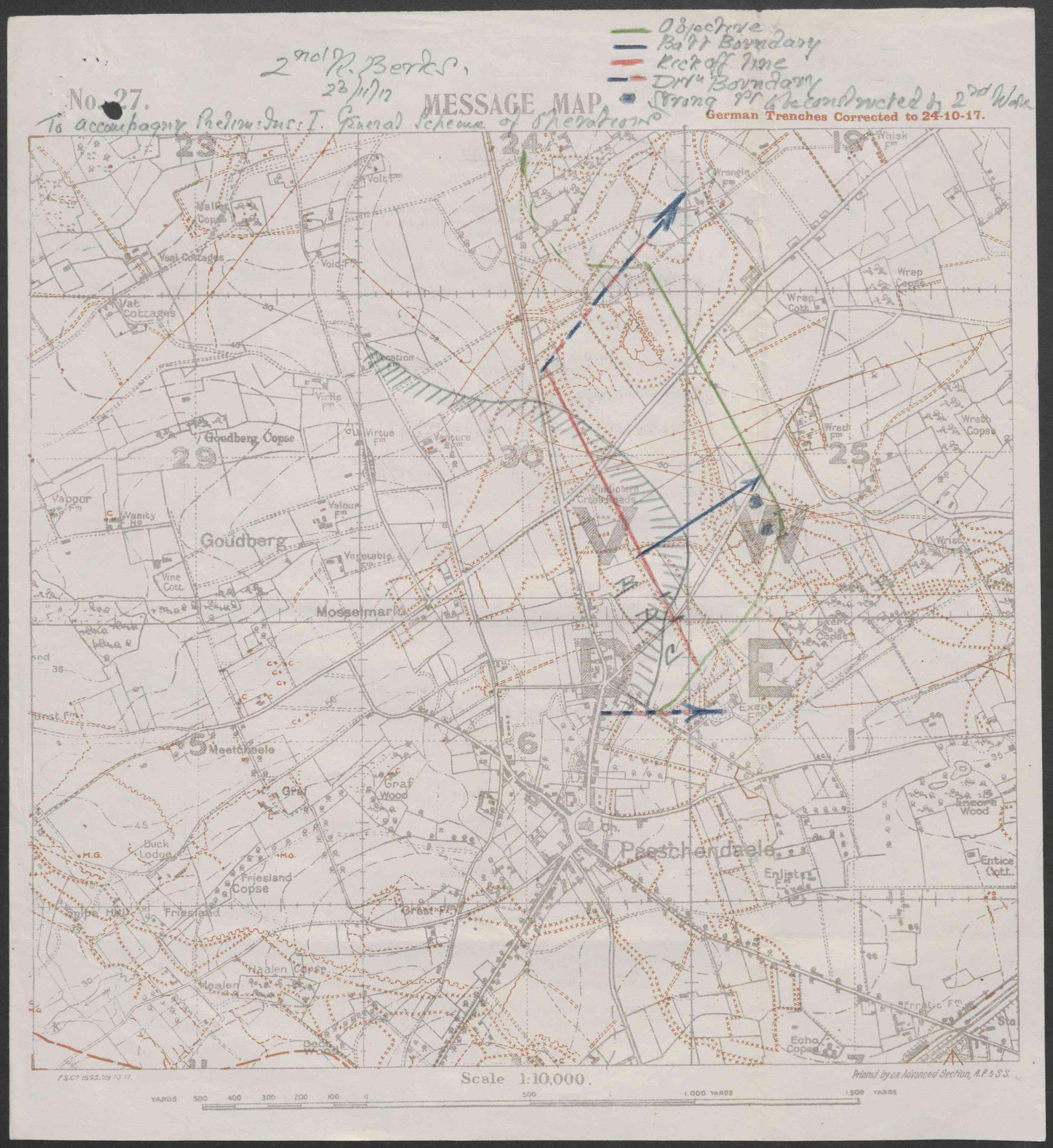
Unfortunately Stewart is not mentioned in the unit diary, but the survival of relevant maps and a detailed report of the attack in the Brigade diary throws light on his fate:
The night was fine and clear and the moon was particularly bright. Individual figures could be distinguished at 100 yards. The ground had been severely torn up by artillery fire, but was on the whole unusually dry and the going was good. … Forming up [of the units along the Brigade front, with 2nd battalion Royal Berkshire on the right] was carried out on a single tape laid from 150 yards S.E of Teal Cottage to E.1.a.15.50. This tape was laid on iron pickets, each bearing a sign painted white denoting the frontage of the various battalions. Direction tapes 50 yards long leading from the forming up tape in the direction of the advance had also been laid. … At Zero Hour [i.e. 1.55 am] our attacking troops advanced. On the left the enemy’s machine guns opened fire immediately. … On the right and centre the enemy’s machine guns did not open fire until Zero plus 3 minutes. … By Zero plus 5 [minutes], intense rifle and machine gun fire had been opened along the whole front of attack. … On the right the enemy’s fire was found to be mostly inaccurate. … The enemy’s artillery barrage came down … one minute after our guns opened fire, namely at Zero plus 9 [minutes]. On the left our troops were well clear of the line of the enemy’s barrage, but unfortunately on the right the support platoons of the attacking Companies [i.e. Companies B and D of 2nd battalion Royal Berkshire] were caught in the barrage and suffered heavily. … The centre battalion [i.e.2nd battalion Lincoln Regiment] and the right of the left battalion [i.e. 2nd battalion Rifle Brigade] were unable to proceed further owing to the number of casualties they had sustained and owing to the strength in which the enemy were holding Venison Trench and the trench connecting it with the Southern Redoubt. … On the right fewer casualties were suffered by the enemy’s fire and the leading waves of the attacking Company [i.e. B Company 2nd battalion Royal Berkshire] reached the Southern Redoubt where heavy fighting took place. … Heavy fighting [with bayonet and bomb] continued in the Southern Redoubt, many casualties, including the Platoon Commander, being suffered and the Platoon was eventually forced out [and dug in nearby.] … Meanwhile, the left Platoon of the right battalion [i.e. a Platoon from B Company, 2nd battalion Royal Berkshire] had strayed to the left [of the battalion boundary] … and had captured a portion of the trench connecting the two redoubts [i.e. Venison Trench]. … They succeeded in establishing themselves in this trench on the frontage of the 2nd [battalion] Lincoln Regiment. … Several minor attempts were made by the enemy to dislodge our troops from the position they held immediately in front of the Southern Redoubt these however were all repulsed. … At about 8 am [on 2 December] stretcher parties of both sides were at work and the shelling, which had up to that time been heavy, slackened down somewhat. Orders were issued by the right battalion [i.e. 2nd battalion Royal Berkshire] to fire on the enemy’s stretcher bearers, as these
17. the ‘93’ and their stories 368
appeared to be taking advantage of their freedom to approach our position. This was done and several of them were hit.767
Stewart’s obituary published in The Pauline states that:
He met his death at Passchendaele in a night attack. He reached his objective, and apparently went beyond it, but the position could not be held, and he was killed before supports could come up. His Colonel writes: “He was at the time of his death most gallantly leading a night attack. He was one of our best and bravest officers, and it is a terrible loss to us all.” Another correspondent says: “He took his men into the attack like a hero. I have never seen a braver man in my life.”768
Thus, it seems certain that Stewart fell in the vicinity of the Southern Redoubt. His body was lost and he is commemorated on the Tyne Cot Memorial Panel. The Pauline states that:
He was in all respects a fine character. He made friends slowly, for he was reserved and sensitive and “took knowing”, but he kept them to the end, and all who knew him, at school, at Oxford, and in the army, were the better for his friendship, and to some of them his death has made a blank that cannot be filled. Perfectly straightforward and direct, absolutely straight in every way, he set himself a high standard, and attained it. As one who had known him well at school and at Merton well said: “Stuart [sic] always wanted what was best: he aimed at the big things! He could not do a mean act or say an unkind word, but was unflinchingly true to what he knew to be right. The School he loved has lost no better. I have lost more than a brother,” writes the one who knew him best, “and shall never have such another friend.”769
An aerial view showing the front allotted to 2nd battalion Berkshire Regiment along with some of the detail transposed from the above map.
767
TNA WO 95 1727 1 5 Report on Operations [of 2 Dec] by Brig General C.O 25 Brigade, dated 7 December 1917
768
The Pauline 237 Feb 1918 p 11 769
The Pauline 237 Feb 1918 pp 11 12
17. the ‘93’ and their stories 369
Chambers, Captain Robert Seymour Bennet 24 December 1917, Passchendaele (nr.) SPS 1898 1902
8th (Service) Bn. King’s Royal Rifle Corps Poelcapelle British Cemetery IX.F.13 Age 31
Robert was born on 31 May 1886. He was the only son of George Nicholson Chambers and his wife, Margaret. The 1911 Census reveals that he was resident at that time at the family home at 69 Clarendon Road, Notting Hill, West Kensington, London. His profession is described as ‘Clerk in the Stock Exchange’.
At the start of the war Robert joined the Artists Rifles and at some point transferred to the King’s Corps Royal Rifle Corps. At the time of his death he was serving in the 8th (Service) battalion K.R.R.C (41st Brigade, 14th (Light) Division). Over the period 20 22 December this unit moved up from California and Junction Camps to the front line north of Goudberg Copse, roughly two miles northwest of Passchendaele.770 The unit diary describes the time in the line thus, including references to the death and burial of Robert:
22 December. Battalion moved up to take up line north of Goudberg Copse. Move put off an hour on account of SOS on left. A fairly quiet relief. … Battalion HQ at Virile Farm. 700 yards of front. Battalion strength: 270 Other Ranks.771
23 December. Heavy hostile barrage before dawn causing no casualties. Great sniping activity on both sides; dispersed parties of enemy advancing and returning from shell hole positions with Lewis Gun fire. Our font line positions worried by hostile machine guns these were taken on by [our] Lewis Guns.
24 December. Heavy barrage again before dawn causing no casualties. Captain Chambers killed by machine gun fire while visiting his posts. The enemy allows our stretcher parties to collect wounded under Red Cross flag; we extend privilege to him.
25 December. Captain Brownsword hit by machine gun fire while visiting posts at 1 am. Carried down at daybreak under Red Cross flag. He died before reaching dressing station. A shell landed in B Coy HQ killing the sentry and wounding 2nd Lieut Simpson who went down with Brownsword. Captain Chambers buried just behind the front line.772 26 December. Bn relieved by 2nd Northamptons, 8th Div.773
770 California Camp was some 1,000 yards east of Wieljte; Junction Camp was located at St Jean.
771 A remarkably low number.
772 The weather was bitterly cold with snow on the ground.
773 TNA WO 95 1895 2
17. the ‘93’ and their stories 370
Robert’s grave is in Poelcapelle British Cemetery, a concentration burial of November 1919. His body was found 400 yards north of Tournant Farm during the exhumation and re burial process after the war, strongly suggesting that this was also the vicinity in which he fell.774 A few days later the battalion was out of the line in camp at Quelmes. The battalion diary records that on 31 December the unit indulged in a:
Great Christmas Dinner in the evening. All ranks thoroughly enjoyed themselves and were in great form to usher in the New Year.775
774 CWGC Langemarck 337/99. The precise location is 28.V.22.d.2.2 775 TNA WO 95 1895 2
17. the ‘93’ and their stories 371
Smalley, Lt Robert Francis 14 April 1918, Neuve Eglise SPS 1890 – 1895
4th Bn. South Staffordshire Ploegsteert Memorial Panel 6 Age 41
Robert was born in London on 18 September 1876, the younger son of Henry Smalley, Captain Royal Madras Engineers, and his wife Emmeline Matilda Davidson. He was baptised at St. Mathew’s Church, Bayswater on 1 November 1876. After leaving SPS in 1895 he attended Christ Church, Oxford. Robert’s obituary in The Pauline states that he was ‘at one time assistant master at Storeygate School, Leicester.’776 In May 1915 he commenced service in the 4th battalion South Staffordshire Regiment in May 1915.
At the time of Robert’s death 4th battalion South Staffordshire was a unit in 7th Brigade, 25th Division. On 10 April this Division was holding the front on the western side of the River Lys, directly to the east of Ploegsteert Wood. (The German front line lay more or less along the Lys, just to the east of that river.) This was low lying, marshy ground with few defined sets of trenches. The 4th battalion South Staffs was holding the left of the line, in the front running south from the River Douve, just to the west of Warneton about one mile north east of Ploegsteert Wood. In terse style, the battalion diarist records that on 10 April: [The] enemy attack opened about 3.30 am by heavy shelling of back areas with gas shell. At 5.30 am he opened his barrage on front and support lines lasted about an hour then lengthened to Reserve on about line of Grey Farm. B Coy in front line wiped out.777
An entry in the 25th Division diary all but admits that the British had been taken by surprise:
Up to now [i.e. 10 April] there had been no sign to indicate that the enemy was likely to attack on the Divisional front. Aerial observation on 9 April reported nothing unusual and the patrols during the night of 9 10th April reported only a certain amount of extra wagon movement around Pont Rouge. The night and morning were thick and misty and gave ample opportunity to the enemy both to assemble his men and also to bring up such things as pontoons close to the river [Lys] without being seen. A good deal of gas shelling took place during the early hours of the morning from about 12 to 3 am. The barrage then died down 776 The Pauline, 36 240 July 1918 p 97
17. the ‘93’ and their stories 372
and did not really start again till 5.05 am, when heavy artillery fire was opened all along the front with H E and gas.778
The ferocity of the German attack meant that the British withdrew, the 4th battalion South Staffs initially to Hill 63 and then to the vicinity of Aux Trois Rois crossroads, about 100 yards south west of Neuve Eglise.779
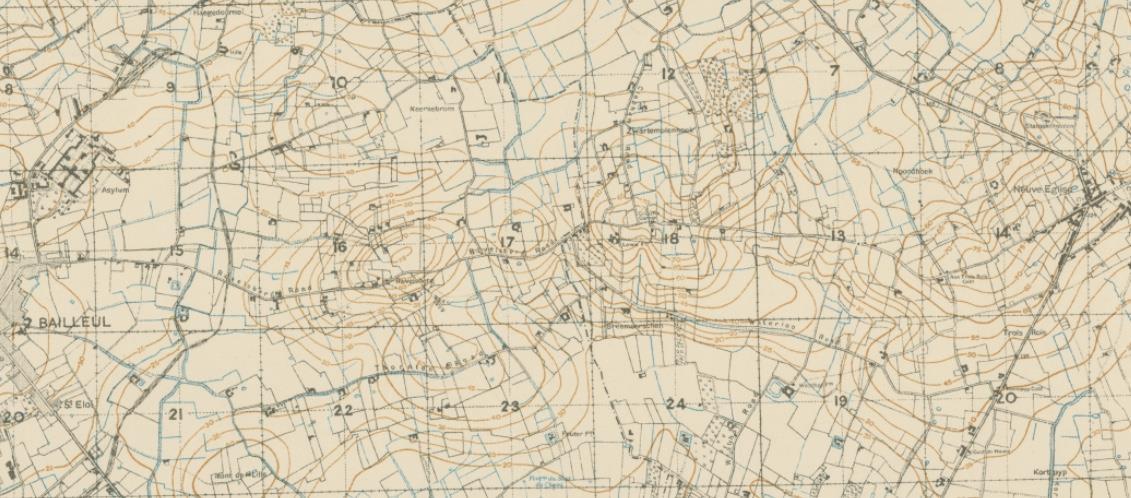
In consequence of a report that the enemy were advancing on Bailleul, Robert’s unit was ordered to move to the Asylum on the north eastern edge of that city but by 5am on 12 April it was once again in position to the west of Neuve Eglise. By this time the units in 7th Brigade appear to have been so reduced that they were reorganised into a single unit, the ‘7th Brigade Battalion’. This perhaps explains the lack of detail in the 4th battalion South Staffordshire diary, in particular the failure to record the names of officer casualties. Nonetheless, it seems possible to conclude with a good deal of certainty that Robert fell in the line to the west of Neuve Eglise. His unit was relieved at 4.30 am on 14 April, suggesting that he was perhaps either a casualty during the relief or, more likely, that he was a casualty of the sustained fighting during the course of the previous day.780 By 15 April the Germans had taken Neuve Eglise and Robert’s body was lost as the fighting continued to move westward. He is commemorated on the Ploegsteert Memorial.
778 TNA WO 95 2226 1
779 Many men were captured in the tunnels under Hill 63 the ‘Catacombs’ including all three battalion commanders of 7th Brigade. (See Rawson, A The Lys Offensive (2018))
780 On 13 April the battalion diarist recorded: ‘The Bosch attacked 5.30 am until dusk. Slight advance.’ TNA WO 95 2244 2
17. the ‘93’ and their stories 373
Tovey, Captain Henry Turner 22 April 1918, Kemmel SPS 1892 1896
88th Brigade Royal Field Artillery, C Battery Mendinghem Military Cemetery X.B.44
Grave epitaph: In Thy Presence Is Fulness of Joy and Life for Evermore Age 37
Henry was one of eleven children of Mrs Tovey of 39 Nevern Square, London, and the late Colonel Hamilton Tovey, Royal Engineers. He was the husband of Gwendoline, of Heatherleigh, Church Cookham, Hants. Two of Henry’s elder brothers, Arthur and George, also attended SPS. All three fought in the war and Arthur and George survived.781 During his time at SPS Henry emerged as an athlete and a boxer. In 1883 he was recorded as running the 200 yards in 31 and 2/5th seconds.782 During the competition for the Eight The Pauline insisted on ‘A word of praise is due to the squad of small boys who performed dumb bell exercises by way of interlude, capitally led by H. Tovey.’783 In the boxing ring Henry won the Bantam weights medal in 1896. His career choice directly upon leaving SPS is not entirely clear, but it seems likely that he went directly into the army. He joined the Royal Field Artillery and served with them in the South African war.
In 1918, as the northern phase of the Ludendorff Offensive started to unfold, the British Army began to move up Divisions from the south. Many of these had suffered considerable casualties and a highly complex and confusing policy of ‘puttying up’ was now adopted that is, alongside the usual rotation, infantry units were frequently moved in the line and attached to a Division other than its home Division. During this period artillery units, always slower to move in any case, were equally frequently attached to Divisions other than its home Division. It is thus especially challenging to track an artillery man during this period.
Henry served in 88th Brigade Royal Field Artillery, a unit in 19th Division. Three of the batteries in the Brigade – A, B, and C (Henry served in C) – were composed of six 18 pounder artillery pieces; D battery was composed of six howitzers. It seems that at some point Henry was detached from 88th Brigade, evidenced by an entry in the unit diary of the Commander of the Royal Artillery 19th Division who records that on the night of 9 10 April ‘Tovey’s Group (11th Bde RFA and 2nd Bde New Zealand FA) were covering 25th Divisional
781 George both served in the Royal Field Artillery, George rising to the rank of Lieutenant Colonel and earning a C.M.G and D.S.O. Another brother John, who did not attend SPS served as Admiral of the Fleet 1943 1946
782 The Pauline, 11 61 May 1893 p 118
783 The Pauline, 13 73 March 1895 p 6
17. the ‘93’ and their stories 374
Front.’784 An entry dated 12 April describes a reorganisation of the 19th Divisional Artillery on that day into ‘Peel’s Group, Russel’s Group and Skinner’s Group’ no mention of Tovey and states that these covered the 19th Divisional front.785 Although the sources are obscure, it seems likely that Tovey’s artillery group covered successively the 25th Division and those units that relieved it in line, namely the 49th Division on 14 April and the French on 18 19 April. Unfortunately none of the unit diaries mentions Tovey by name other than when referencing ‘Tovey’s Group’, nor do they permit accurate tracking of the location of batteries, though these were likely placed in the vicinity of Kemmel.
When 19th and 25th Divisions were relieved on 19 April and 21 April respectively, they went into reserve in the Poperinghe Proven area. Henry is buried in Mendinghem Military Cemetery, a short distance to the northwest of Proven. It appears that having been wounded he was taken by medics serving in either 19th or 25th Division to one of the three Casualty Clearing stations at Proven (46th, 12th or 64th ), in which place he died.
784
TNA WO 95 2062 3. At this date the 25th Divisional Front was of about one mile in line, running north east to south west just to the south of Neuve Eglise.
785 At this date the 19th Divisional front ran south west from Wytschaete to close to Neuve Eglise, where it joined with the 25th Divisional front.
17. the ‘93’ and their stories 375
Symons, 2nd Lt Charles Leslie 23 April 1918, Vierstraat Sector SPS 1912 1917
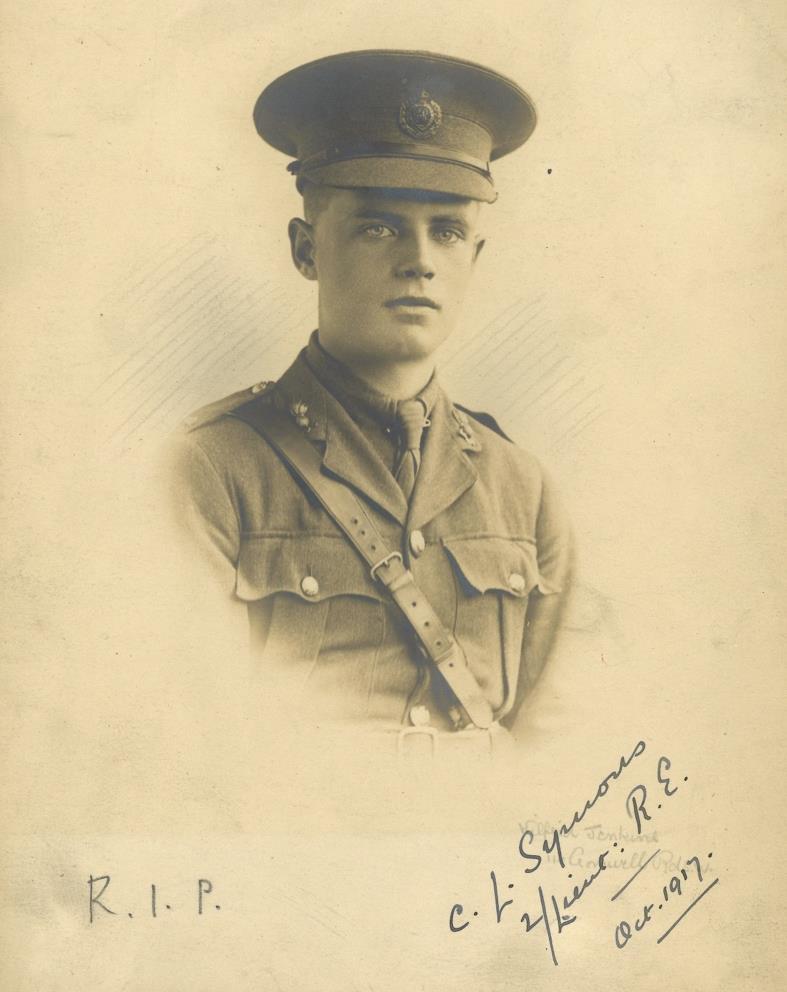
63rd Field Company, Royal Engineers Tyne Cot Memorial Panel 8 Age 19
Charles Leslie Symons786
Charles known as Leslie in his family was the younger son of William and Amy Symons.787 His father was an insurance clerk. The census of 1911 records the family residence as 35 Dryburgh Road, Putney, London. The Pauline makes frequent mention of his out of class schoolboy achievements. Toward the end of his time at SPS, Leslie was a Prefect, sat on the committee of The Pauline and was Captain of A Club. He was a keen and committed cricketer and played for the 1st IV in Fives and was equally accomplished on the rugby field and in the boxing ring. Always slight in build, Leslie played forward in the 1st XV. After an away match against Bedford Grammar School in 1915 The Pauline recorded that ‘Our
786 Courtesy of St Paul’s School Archive, Digby La Motte Collection
787 Alfred Castell Symons fought in the Tank Corps. He did not attend SPS. He died on 26 February 1919, perhaps from one of the illnesses that had hospitalised him on more than one occasion during the war. He is buried in Putney Vale Cemetery.
17. the ‘93’ and their stories 376
forwards all played pluckily, Symons often brilliantly, but they were never dangerous.’788 (SPS lost: 32 0). In 1914 The Pauline offered the view that in the boxing ring ‘Symons is too slow on his feet, and should not attempt to wear his man down by strength alone.’789 Leslie must have heeded the advice: fighting in 1916 in the Welters category (i.e. under 10 st 7 lb), he advanced to the semi final where he lost to L. H. C. Rutter. An observer declared the encounter ‘A good bout. Rutter hit hard and clean, and had much the better of the first two rounds. Symons was plucky, and in the third round scored a little, Rutter being content to maintain his advantage. Rutter had a very effective right.790 The following year, though suffering defeat in the Welters final, Leslie nevertheless obtained approving commentary from The Pauline: ‘We admire the spirit in which Symons boxes for the good of his club, and wish other club captains would follow his example.’791 Leslie’s commanding officer declared that ‘he was a sportsman through and through. The depot will always remember him as the pluckiest boxing officer who has ever been here.’792 In 1917 Leslie was elected to an open Mathematical Scholarship at Sidney Sussex College, Cambridge and in the following April he entered a Royal Engineering O.T.C. at Newark, where he was made Cadet Officer of his class. At Newark he was appointed sports officer of his company, and won the officers' welter weight boxing competition. He was gazetted in the following August. Leslie does not seem to have ‘gone up’ to Cambridge, taking his place in the army instead.
Leslie was an officer in 63rd Field Company, a unit in 9th Division. He arrived in France on 20 March 1918, less than a month before he was killed. During April, in response to the sustained German offensive that had begun on 21 March the Kaiserschlacht, also known as the Ludendorff Offensive there were successive voluntary withdrawals in three stages from the Ypres Salient. In what was perhaps the crisis of the war, the frequency with which units were moved around the line imbues a study of this period with enormous complexity.
From 11 April Leslie’s unit was involved in improving the rear defences along the line roughly Kemmel Vierstraat and beyond, towards Voormezeele. This work involved, inter alia, improving existing trenches and digging new ones, establishing strong points, installing new wiring and undertaking reconnaissance of key features of the landscape for demolition prior to withdrawal. In the entry in the unit diary date 17 April, Leslie is mentioned by name in the unit diary:
No. 2 section detailed for demolition work if necessary divided into two parties one under 2nd Lieut Symons RE and [the] other under the section? HQs of demolition party X roads
788
The Pauline, 33 216 March 1915 p 61 789
The Pauline, 33 207 Feb 1914 p 26 790
The Pauline, 34 225 June 1916 p 93 791
The Pauline, 35 230 March 1917 p 24 792 The Pauline, 37 247 July 1919 pp 86 87
17. the ‘93’ and their stories 377
Kemmel were selected sites for demolition. [The two other] sections [worked] on [the] line parallel to Kemmel Vierstraat road and 1000 yards in rear of it.
On 20 April the unit diary records that three sections were ‘working by night on wiring the front line’, one of which appears to have been no. 2 section i.e. that in which Leslie served. On 22 April no. 2 section is described as ‘out at night wiring as yesterday’; and on 23 April the day on which Leslie fell his section is described as undertaking ‘wiring’. 793 The 63rd Field Company was responsible for work in the right Brigade area of 9th Division, and thus the ‘front line’ in which this work was taking place appears to have been just to the west of Wytschaete. It seems likely that Leslie was a wounded by sniper or other random fire and that, under the cover of darkness, he either became separated from the rest of his section or perhaps lost his way as he sought for a dressing station. Leslie’s body was never found and he is commemorated on Tyne Cot Memorial.
A map in 9th Division General Staff diary showing the respective lines of withdrawal in the Vierstraat sector. It seems likely that Leslie was working on wiring the line labelled ‘17th to 24th April’ when he fell.794
17. the ‘93’ and their stories 378

Lane, Lance-Corporal Samuel Boaden 20 September 1918, Messines (nr.) SPS 1896 1897
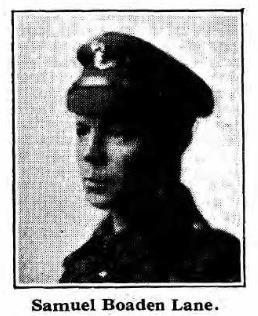
7th (South Irish Horse) Bn. Royal Irish Regiment, B Company Westoutre British Cemetery O.3
Grave epitaph: The Memory Of The Just Is Blessed By All Age 35
Samuel Boaden Lane795
Samuel was the son of Samuel Henry and Annie Lane, of Worton Manor, Isleworth, Middlesex. Upon leaving SPS he appears to have worked in his father’s business, Barrow, Lane and Ballard Ltd. Samuel volunteered for active serve in June 1916, at which time he was a Managing Director of Barrow, Lane and Ballard Ltd. He arrived in France in November 1916, serving in 10th (Service) battalion Royal Dublin Fusiliers. On 16 April 1917 he was wounded and admitted to 18th General Hospital. Samuel was probably one of the casualties of an operation undertaken on 15 April and reported thus in the 10th battalion diary:
[The battalion] made an attack on the village of Gavrelle [in France] without any artillery preparations. Owing to the very heavy hostile artillery and machine gun fire, the attempt was unsuccessful. Our casualties were estimated at about 5 officers and 80 other ranks.796
Samuel returned to England, where he was sent to York Hospital. He was back in France in April 1918, having been transferred to the 7th (South Irish Horse) battalion Royal Irish Regiment. 797
795 De Ruvigny’s Roll of Honour
796 TNA WO 95 3118 4
797 As a soldier who fought in more than one regiment, Samuel has two service numbers: 43409 (RDF) and 26616 (RIR.)
17. the ‘93’ and their stories 379
On 20 September 1918 the 7th battalion Royal Irish Regiment (21th Brigade, 30th Division) was holding a front of about 1,000 yards running northwest southeast in orientation, directly south of the Wulverghem Messines Road and about one mile in front of Wulverghem. The unit had held this line since 15 September.
The battalion diary describes thus the events of the following few days:
16 18 September. Battalion holding line, right sub sector. During this time the battalion was engaged in digging defensive lines and communication trenches and organising the front into an outpost line. On the afternoon of the 18th orders were received from [21st] Brigade to secure identifications [of the German unit in the opposite line].
18 19 September. Two fighting patrols were sent out: one patrol composed of 2nd Lt Trueman and no 9 platoon, C Company left our lines at 03.00 hrs and penetrated into the enemy lines, capturing two prisoners and one machine gun and killing several of the enemy. The other patrol from D Coy composed of 2nd Lt McMeight[?] and 12 Other Ranks left our line at 01.30 hrs and endeavoured to rush an enemy post but were heavily bombarded. This patrol succeeded in inflicting casualties on the enemy but was unable to secure identification.
19 22 September. D Company relieved A Company in the right front line A Company moving to reserve. Battalion holding line. Patrols sent out each night [i.e. into No Man’s Land]. We were in command of No Man’s Land. [During the night] 20 21 the 6th Cheshire Regiment on our left carried out a minor operation capturing 15 prisoners. Our font line Company assisted with a smoke barrage, with Lewis Gun and rifle fire.
22 23 September. The battalion was relieved by the 7/8th Royal Inniskilling Fusiliers and moved to Mont Vidaigne M.21.a.5.4. The [21st] Brigade being now in Divisional Reserve.798
Samuel served in Company B. Although the role of that Company is not mentioned in the above narrative, it is reasonable to assume that Samuel participated in the ‘patrols sent out each night’ and that he received his fatal injury in this circumstance. Most likely wounded, he was extracted out of the line, probably by 97th Field Ambulance, whose headquarters were located at this time in Westoutre, the place in which Samuel is buried.799
798 TNA WO 95 2330 3
799 The line of evacuation of wounded of 30th Division was established on 4 September as Dranoutre Locre Bailleul Meteren. TNA WO 95 2319 6 Appendix 592
17. the ‘93’ and their stories 380
Beaty-Pownall, Lieutenant-Colonel George Ernest D.S.O 10 October 1918, Ypres SPS 1890 1895
2nd Bn. Border Regiment, attd. 1st Bn. King’s Own Scottish Borderers Lijssenthoek Military Cemetery XXX.B.14
Grave epitaph: Greater Love Have No Man Age 41
800
George was the son of Major George Albert Beaty Pownall, Royal Artillery, retired with the honorary rank of Lieutenant Colonel and his wife, Susan. His address while he was at school was 37 Gwendwr Road, West Kensington. During his time at St Paul’s, George emerged as a cricketer, athlete, rugby and lacrosse player. In 1894 The Pauline awarded space to a description of each of the characters of the First XII. George was described thus:

[He] plays a very plucky game. Improved considerably in checking, but is rather slow on his man, and is a weak throw; has a useful knack of intercepting passes.801
George also found time to tread the boards, taking on the role of ‘Sneer’ in Act II of Sheridan’s Critic, presented to the Apposition audience in 1895.
800
St Paul’s School Archive. Cricket photograph, 1895 801 The Pauline, 12 68 May 1894 p 113
17. the ‘93’ and their stories 381
George Ernest Beaty PownallUpon leaving SPS George proceeded directly into the army, via the Royal Military College, Sandhurst. He joined the Border Regiment in 1897, was commissioned 2nd Lieutenant in the same year and promoted to Lieutenant in 1900. He was in service in Malta from 10 November 1897 to 26 September 1899, following which he served with the 1st battalion in the Boer War. He took part in the relief of Ladysmith and Wepener, and engagements at Willow Grange, Colenso and ‘was knocked down at Spion Kop without injury by a bursting shell.’802 He was promoted to the position of Captain in 1908. In 1911 the census records that George was resident at the Border Regiment barracks in Carlisle, a period in which he found time to play golf at Silloth Golf Club.803
George served in 2nd battalion Border Regiment (20th Brigade, 7th Division) for the first three years of the war. He was promoted to Major in 1915 and appears to have acted as Lieutenant Colonel from September to December 1916. George’s brother, Thomas (SPS 1896 1899) served in the same battalion. Thomas was killed in action at Croisilles on 24 March 1917.804 On 9th May 1917, when the battalion was at Gommecourt, a shell landed on battalion headquarters, wounding George and killing three others. Injured, George was taken out of line but rejoined the unit on 19 May.805 In June, July and August 1917, he was fulfilling the role of Adjutant and was thus responsible for signing off the battalion diary. In September he assumed the rank of Lieutenant Colonel.
George transferred to the 1st battalion King’s Own Scottish Borders (87th Brigade, 29th Division), taking command of that unit on 9 May 1918. After a short period of leave (15 September 30 September), during which time he returned to England, George rejoined the battalion when it was in the line Tower Hamlets Veldhoek, about half a mile to the west of Gheluvlet.806 On 3rd October the battalion was relieved, as described in the unit diary:
3 October. Battalion relieved by the 20th Durham Light Infantry and marched to a former enemy rest camp at Kruiseecke, nr. Gheluvelt. Camp heavily shelled as battalion was marching in and orders were issued for Companies to carry on to the old camping area the Tower Hamlets Veldhoek Line. Battalion in camp by 5am 4 Oct.
4 October. Battalion paraded at 2 pm and marched to the Westhoek area. Battalion accommodated in pillboxes and dugouts. 5 October. Battalion resting and cleaning up.
802 The Pauline, 18 110 June 1900 p 64
803 George is listed on the Roll of Honour in the Club House.
804 Thomas Trelawny Beaty Pownall. Age 35. Captain of D Company, 2nd battalion Border Regiment. He is buried in St Leger British Cemetery, A.4.
805 TNA WO 95 1655 12
806 Before rejoining, on 1 October George visited his old unit, the 1st battalion Border Regiment (87th Brigade, 29th Division.)
17. the ‘93’ and their stories 382
6 October. Divine service.
7 October. Battalion paraded at 2pm and marched to billets in Ypres ramparts and vicinity.
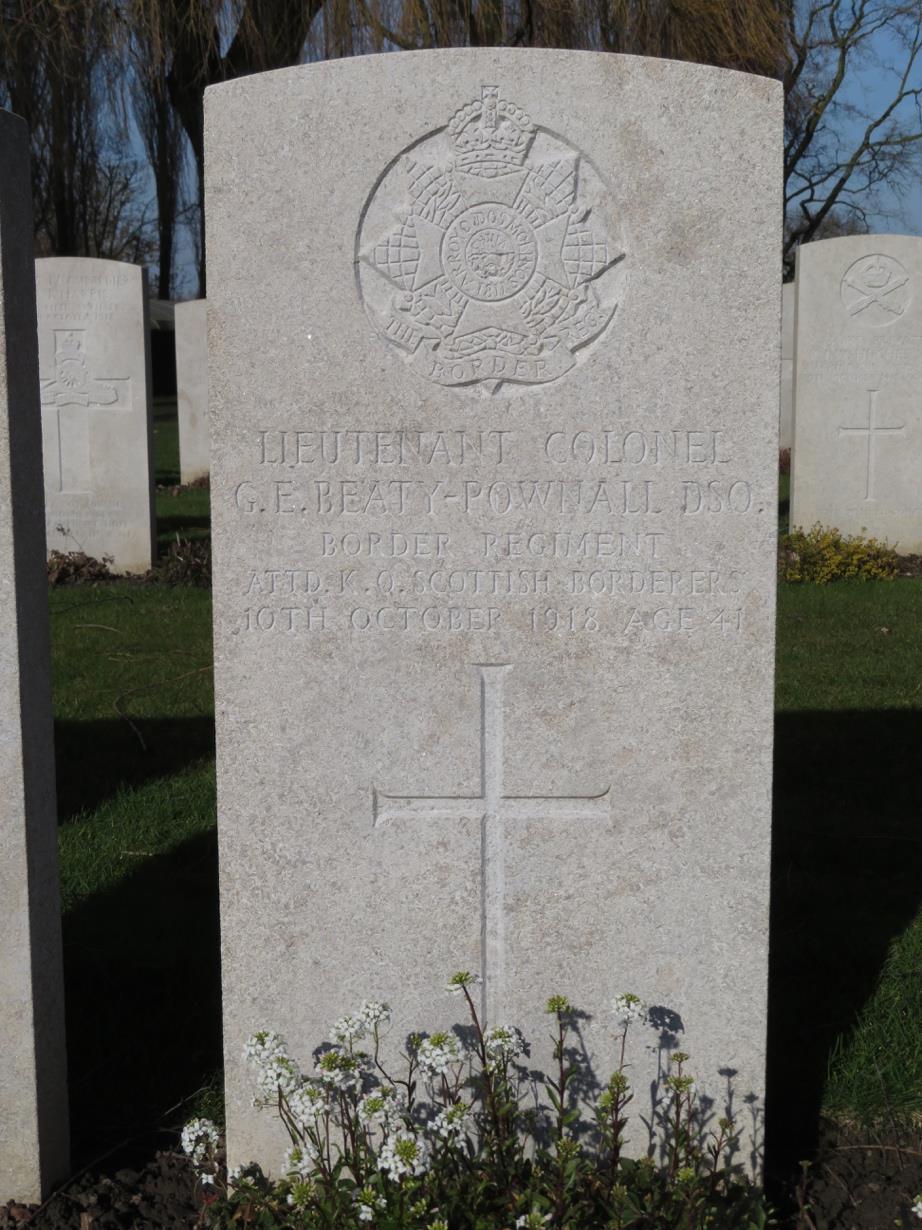
8 October. Battalion paraded in Battle Order for inspection by the Commanding Officers.
9 October. Brigade Ceremonial Parade for inspection by II Corps Commander.807 10 October. Battalion preparing to move. Lieut Colonel G E Beaty Pownall D.S.O wounded in the head by H. E [i.e. high explosive] about 11.30 and died in 10th C.C.S [i.e. Casualty Clearing Station] 4 hours later. Major C. H. Crawshaw M.C assumed command of the battalion.808
Casualty Clearing Station no. 10 was at Remy Siding, Lijssenthoek. This is therefore the location in which George is buried.809
807 This was Lt General Sir C. Jacobs. The parade took place near Goldfish Chateau (H.10.c.central).
808 TNA WO 95 2304 1 3
809 Author’s photo
17. the ‘93’ and their stories 383